http://scholar.google.com/citations?hl=en&user=95SvbM8AAAAJ
Malviya, Kirtman D; Oliveira, Eliezer F; Autreto, Pedro A S; Ajayan, Pulickel M; Galvao, D S; Tiwary, Candra S; Chattopadhyay, Kumanio
Mixing the immiscible through high-velocity mechanical impacts: an experimental and theoretical study Journal Article
Em: Journal of Physics D: Applied Physics, vol. 52, não 44, pp. 445304, 2019.
@article{Malviya2019,
title = {Mixing the immiscible through high-velocity mechanical impacts: an experimental and theoretical study},
author = {Malviya, Kirtman D and Oliveira, Eliezer F and Autreto, Pedro A S and Ajayan, Pulickel M and Galvao, D S and Tiwary, Candra S and Chattopadhyay, Kumanio},
url = {https://iopscience.iop.org/article/10.1088/1361-6463/ab36d1/meta},
doi = {10.1088/1361-6463/ab36d1},
year = {2019},
date = {2019-08-20},
journal = {Journal of Physics D: Applied Physics},
volume = {52},
number = {44},
pages = {445304},
abstract = {In two-component metallic systems, thermodynamic immiscibility leads to phase separation
such as in two-phase eutectic compositional alloys. The limit of the immiscibility of
component elements under non-equilibrium conditions have been explored, but achieving
complete miscibility and formation of single phase microstructures in eutectic alloys would
be unprecedented. Here we report that during low-temperature ball milling that provides high
energy impact, complete mixing of phases can occur in immiscible Ag-Cu eutectic alloys.
From combined theoretical and experimental studies, we show that impact can produce solid
solutions of Ag-Cu nanoparticles of eutectic composition. Our results show that phase
diagrams of low dimensional materials under non-equilibrium conditions remain unexplored
and could lead to new alloy microstructures drastically different from their bulk counterparts.},
keywords = {},
pubstate = {published},
tppubtype = {article}
}
such as in two-phase eutectic compositional alloys. The limit of the immiscibility of
component elements under non-equilibrium conditions have been explored, but achieving
complete miscibility and formation of single phase microstructures in eutectic alloys would
be unprecedented. Here we report that during low-temperature ball milling that provides high
energy impact, complete mixing of phases can occur in immiscible Ag-Cu eutectic alloys.
From combined theoretical and experimental studies, we show that impact can produce solid
solutions of Ag-Cu nanoparticles of eutectic composition. Our results show that phase
diagrams of low dimensional materials under non-equilibrium conditions remain unexplored
and could lead to new alloy microstructures drastically different from their bulk counterparts.
de Sousa, Jose Moreira; Autreto, Pedro da Silva; Galvao, Douglas Soares
Hydrogenation Dynamics Process of Single-wall Carbon Nanotube Twisted (under review) Journal Article
Em: 2019.
@article{deSousa2019d,
title = {Hydrogenation Dynamics Process of Single-wall Carbon Nanotube Twisted (under review)},
author = {de Sousa, Jose Moreira and Autreto, Pedro da Silva and Galvao, Douglas Soares},
year = {2019},
date = {2019-07-15},
keywords = {},
pubstate = {published},
tppubtype = {article}
}
JM; Sousa, Bizao
Elastic Properties of Graphyne-based Nanotubes Online
2019, (ArXiv preprint.).
@online{deSousa2019b,
title = {Elastic Properties of Graphyne-based Nanotubes},
author = {de Sousa, JM; , Bizao, RA; Sousa Filho, VP; Aguiar, AL; Coluci, VR; Pugno, NM; Girao, EC; Souza Filho, AG; Galvao, DS},
url = {https://arxiv.org/pdf/1905.02104.pdf},
year = {2019},
date = {2019-04-07},
abstract = {Graphyne nanotubes (GNTs) are nanostructures obtained from rolled up graphyne sheets,
in the same way carbon nanotubes (CNTs) are obtained from graphene ones. Graphynes
are 2D carbon-allotropes composed of atoms in sp and sp2 hybridized states. Similarly to
conventional CNTs, GNTs can present different chiralities and electronic properties. Because
of the acetylenic groups (triple bonds), GNTs exhibit large sidewall pores that influence their
mechanical properties. In this work, we studied the mechanical response of GNTs under
tensile stress using fully atomistic molecular dynamics simulations and density functional
theory (DFT) calculations. Our results show that GNTs mechanical failure (fracture) occurs
at larger strain values in comparison to corresponding CNTs, but paradoxically with smaller
ultimate strength and Young’s modulus values. This is a consequence of the combined
effects of the existence of triple bonds and increased porosity/flexibility due to the presence
of acetylenic groups.},
note = {ArXiv preprint.},
keywords = {},
pubstate = {published},
tppubtype = {online}
}
in the same way carbon nanotubes (CNTs) are obtained from graphene ones. Graphynes
are 2D carbon-allotropes composed of atoms in sp and sp2 hybridized states. Similarly to
conventional CNTs, GNTs can present different chiralities and electronic properties. Because
of the acetylenic groups (triple bonds), GNTs exhibit large sidewall pores that influence their
mechanical properties. In this work, we studied the mechanical response of GNTs under
tensile stress using fully atomistic molecular dynamics simulations and density functional
theory (DFT) calculations. Our results show that GNTs mechanical failure (fracture) occurs
at larger strain values in comparison to corresponding CNTs, but paradoxically with smaller
ultimate strength and Young’s modulus values. This is a consequence of the combined
effects of the existence of triple bonds and increased porosity/flexibility due to the presence
of acetylenic groups.
Fonseca, AF; Dantas, SO; Galvao, DS; Zhang, D; Sinnott, SB
The Structure of Graphene on Graphene/C60/Cu Interfaces: A Molecular Dynamics Study (under review) Journal Article
Em: 2019.
@article{Fonseca2019d,
title = {The Structure of Graphene on Graphene/C60/Cu Interfaces: A Molecular Dynamics Study (under review)},
author = {Fonseca, AF and Dantas, SO and Galvao, DS and Zhang, D and Sinnott, SB},
year = {2019},
date = {2019-04-03},
keywords = {},
pubstate = {published},
tppubtype = {article}
}
JM; Sousa, Bizao
Elastic Properties of Graphyne-Based Nanotubes Journal Article
Em: Computational Materials Science, vol. 170, pp. 109153, 2019.
@article{deSousa2019c,
title = {Elastic Properties of Graphyne-Based Nanotubes},
author = {de Sousa, JM; , Bizao, RA; Sousa Filho, VP; Aguiar, AL; Coluci, VR; Pugno, NM; Girao, EC; Souza Filho, AG; Galvao, DS},
url = {https://www.sciencedirect.com/science/article/pii/S0927025619304525?dgcid=coauthor#s0040},
doi = {10.1016/j.commatsci.2019.109153},
year = {2019},
date = {2019-04-03},
journal = {Computational Materials Science},
volume = {170},
pages = {109153},
abstract = {Graphyne nanotubes (GNTs) are nanostructures obtained from rolled up graphyne sheets, in the same way carbon nanotubes (CNTs) are obtained from graphene ones. Graphynes are 2D carbon-allotropes composed of atoms in sp and sp2 hybridized states. Similarly to conventional CNTs, GNTs can present different chiralities and electronic properties. Because of the acetylenic groups (triple bonds), GNTs exhibit large sidewall pores that influence their mechanical properties. In this work, we studied the mechanical response of GNTs under tensile stress using fully atomistic molecular dynamics simulations and density functional theory (DFT) calculations. Our results show that GNTs mechanical failure (fracture) occurs at larger strain values in comparison to corresponding CNTs, but paradoxically with smaller ultimate strength and Young’s modulus values. This is a consequence of the combined effects of the existence of triple bonds and increased porosity/flexibility due to the presence of acetylenic groups.},
keywords = {},
pubstate = {published},
tppubtype = {article}
}
Arpan; Gumaste Rout, Anurag; Pandey
Bio-inspired Aluminum Composite reinforced with Soft polymer with enhanced strength and plasticity (under review) Journal Article
Em: 2019.
@article{Rout2019,
title = {Bio-inspired Aluminum Composite reinforced with Soft polymer with enhanced strength and plasticity (under review)},
author = {Rout, Arpan; Gumaste, Anurag; Pandey, Praful; Oliveira, Eliezer; Demiss,
Solomon; P., Mahesh; Bhatt, Chintan; Raphael, Kiran; Ayyagari, Ravi; Autreto, Pedro;
Palit, Mithun; Femi, Olu Emmanuel; Galvao, Douglas; Arora, Amit; Tiwary, Chandra},
year = {2019},
date = {2019-03-30},
keywords = {},
pubstate = {published},
tppubtype = {article}
}
AF; Dantas Fonseca, SO; Galvao
The Structure of Graphene on Graphene/C60/Cu Interfaces: A Molecular Dynamics Study Online
2019, (ArXiv preprint).
@online{Fonseca2019b,
title = {The Structure of Graphene on Graphene/C60/Cu Interfaces: A Molecular Dynamics Study},
author = {Fonseca, AF; Dantas, SO; Galvao, DS; Zhang, D; Sinnott SB},
url = {https://arxiv.org/pdf/1904.09871.pdf},
year = {2019},
date = {2019-03-22},
abstract = {Two experimental studies reported the spontaneous formation of amorphous and crystalline
structures of C60 intercalated between graphene and a substrate. They observed interesting
phenomena ranging from reaction between C60 molecules under graphene to graphene
sagging between the molecules and control of strain in graphene. Motivated by these works,
we performed fully atomistic reactive molecular dynamics simulations to study the formation
and thermal stability of graphene wrinkles as well as graphene attachment to and detachment
from the substrate when graphene is laid over a previously distributed array of C60 molecules
on a copper substrate at different values of temperature. As graphene compresses the C60
molecules against the substrate, and graphene attachment to the substrate between C60s
(“C60S” stands for plural of C60) depends on the height of graphene wrinkles, configurations
with both frozen and non-frozen C60s structures were investigated in order to verify the
experimental result of stable sagged graphene when the distance between C60s is about 4 nm
and height of graphene wrinkles is about 0.8 nm. Below the distance of 4 nm between C60s,
graphene becomes locally suspended and less strained. We show that this happens when C60s
are allowed to deform under the compressive action of graphene. If we keep the C60s frozen,
spontaneous “blanketing” of graphene happens only when the distance between them are
equal or above 7 nm. Both above results for the existence of stable sagged graphene for C60
distances of 4 or 7 nm are shown to agree with a mechanical model relating the rigidity of
graphene to the energy of graphene-substrate adhesion. Although the studies of intercalation
of molecules on interfaces formed by graphene-substrate are motivated by finding out ways to
control wrinkling and strain in graphene, our work reveals the shape and structure of
intercalated molecules and the role of stability and wrinkling on final structure of graphene.
In particular, this study might help the development of 2D confined nanoreactors that are
considered in literature to be the next advanced step on chemical reactions.},
note = {ArXiv preprint},
keywords = {},
pubstate = {published},
tppubtype = {online}
}
structures of C60 intercalated between graphene and a substrate. They observed interesting
phenomena ranging from reaction between C60 molecules under graphene to graphene
sagging between the molecules and control of strain in graphene. Motivated by these works,
we performed fully atomistic reactive molecular dynamics simulations to study the formation
and thermal stability of graphene wrinkles as well as graphene attachment to and detachment
from the substrate when graphene is laid over a previously distributed array of C60 molecules
on a copper substrate at different values of temperature. As graphene compresses the C60
molecules against the substrate, and graphene attachment to the substrate between C60s
(“C60S” stands for plural of C60) depends on the height of graphene wrinkles, configurations
with both frozen and non-frozen C60s structures were investigated in order to verify the
experimental result of stable sagged graphene when the distance between C60s is about 4 nm
and height of graphene wrinkles is about 0.8 nm. Below the distance of 4 nm between C60s,
graphene becomes locally suspended and less strained. We show that this happens when C60s
are allowed to deform under the compressive action of graphene. If we keep the C60s frozen,
spontaneous “blanketing” of graphene happens only when the distance between them are
equal or above 7 nm. Both above results for the existence of stable sagged graphene for C60
distances of 4 or 7 nm are shown to agree with a mechanical model relating the rigidity of
graphene to the energy of graphene-substrate adhesion. Although the studies of intercalation
of molecules on interfaces formed by graphene-substrate are motivated by finding out ways to
control wrinkling and strain in graphene, our work reveals the shape and structure of
intercalated molecules and the role of stability and wrinkling on final structure of graphene.
In particular, this study might help the development of 2D confined nanoreactors that are
considered in literature to be the next advanced step on chemical reactions.
AF; Dantas Fonseca, SO; Galvao
The Structure of Graphene on Graphene/C60/Cu Interfaces: A Molecular Dynamics Study (under review) Journal Article
Em: 2019.
@article{Fonseca2019c,
title = {The Structure of Graphene on Graphene/C60/Cu Interfaces: A Molecular Dynamics Study (under review)},
author = {Fonseca, AF; Dantas, SO; Galvao, DS; Zhang, D; Sinnott SB},
year = {2019},
date = {2019-03-15},
keywords = {},
pubstate = {published},
tppubtype = {article}
}
Routa, Arpan; Pandeyb, Praful; Oliveira, Eliezer Fernando; da Silva Autreto, Pedro Alves; Gumastea, Anurag; Singha, Amit; Galvao, Douglas Soares; Aroraa, Amit; Tiwary, Chandra Sekhar
Atomically locked interfaces of metal (Aluminum) and Polymer (Polypropylene) using mechanical friction Journal Article
Em: Polymer, vol. 169, pp. 148-153, 2019.
@article{Routa2019,
title = {Atomically locked interfaces of metal (Aluminum) and Polymer (Polypropylene) using mechanical friction},
author = {Arpan Routa and Praful Pandeyb and Eliezer Fernando Oliveira and Pedro Alves da Silva Autreto and Anurag Gumastea and Amit Singha and Douglas Soares Galvao and Amit Aroraa and Chandra Sekhar Tiwary},
year = {2019},
date = {2019-02-23},
journal = {Polymer},
volume = {169},
pages = {148-153},
abstract = {Joining different parts is one of a crucial component of designing/engineering of materials. The current energy, low efficiency weight automotive and aerospace components commonly consist of different class of materials, such as metal, polymer, and ceramics, etc. Joining these components remains a challenge. Here, we demonstrate joining of metal (aluminum) and polymer (PP) using mechanical friction. The detailed characterisation demonstrates that atomically locked interfaces are formed in such joining without the presence of any chemical bond at the interfaces. The waterproof and strong interface is formed in such process. Fully atomistic molecular dynamics simulations were also carried out to provide further insights on these mechanisms.},
keywords = {},
pubstate = {published},
tppubtype = {article}
}
Eliezer F; Autreto Oliveira, Pedro AS; Woellner
On the mechanical properties of protomene: A theoretical investigation Journal Article
Em: Computational Materials Science, vol. 161, pp. 190-198, 2019.
@article{Oliveira2019c,
title = {On the mechanical properties of protomene: A theoretical investigation},
author = {Oliveira, Eliezer F; Autreto, Pedro AS; Woellner, Cristiano F; Galvao, Douglas S},
year = {2019},
date = {2019-02-07},
journal = {Computational Materials Science},
volume = {161},
pages = {190-198},
abstract = {We report a detailed study through fully atomistic molecular dynamics simulations and DFT calculations on the mechanical properties of protomene. Protomene is a new carbon allotrope composed of a mixture of sp2 and sp3 hybridized states. Our results indicate that protomene presents an anisotropic behavior about tensile deformations. At room temperature, protomene presents an ultimate strength of ~100 GPa and Young's modulus of ~600 GPa, lower than the same for other carbon allotropes. Despite that, protomente presents the highest ultimate strain along the z-direction (~ 24.7%). Our results also show that stretching the protomene along the z-direction or heating it can induce a semiconductor-metallic phase transition, due to a high amount of sp3 bonds that are converted to sp2 ones.},
keywords = {},
pubstate = {published},
tppubtype = {article}
}
Jaques, Ygor M.; Galvao, Douglas S.
Structural Properties of Nanodroplets Impacting Graphene at High Velocities (accepted) Journal Article
Em: Journal of Molecular Liquids, 2019.
@article{Jaques2019b,
title = {Structural Properties of Nanodroplets Impacting Graphene at High Velocities (accepted)},
author = {Ygor M. Jaques and Douglas S. Galvao},
year = {2019},
date = {2019-02-05},
journal = {Journal of Molecular Liquids},
abstract = {The determination of the wettability of 2D materials is an area of intensive research, as it is decisive on the applications of these systems in nanofluidics. One important part of the wetting characterization is how the spreading of droplets impacting on the surfaces occurs. However, few works address this problem for layered materials. Here, we report a fully atomistic molecular dynamics study on the dynamics of impact of water nanodroplets (100 ̊A of diameter) at high velocities (from 1 up to 15 ̊A/ps) against graphene targets. Our results show that tuning graphene wettability (through parameter changes) significantly affects the structural and dynamical aspects of the nanodroplets. We identified three ranges of velocities with distinct characteristics, from simple deposition of the droplet to spreading with rebound, and finally droplet frag- mentation. We also identify that in an intermediary velocity of 7 ̊A/ps, the pattern of spreading critically changes, due to formation of voids on droplet structure. These voids affect in a detrimental way the droplet spreading on the less hydrophilic surface, as it takes more time to the droplet recover from the spreading and to return to a semi-spherical configuration. When the velocity is increased to values larger than 11 ̊A/ps, the droplet fragments, which reveals the maximum possible spreading.},
keywords = {},
pubstate = {published},
tppubtype = {article}
}
Sanjit; Ozden Bhowmick, Sehmus; Bizão
High temperature quasistatic and dynamic mechanical behavior of interconnected 3D carbon nanotube structures Journal Article
Em: Carbon, vol. 142, pp. 291-299, 2019.
@article{Bhowmick2019,
title = {High temperature quasistatic and dynamic mechanical behavior of interconnected 3D carbon nanotube structures},
author = {Bhowmick, Sanjit; Ozden, Sehmus; Bizão, Rafael A; Machado, Leonardo Dantas; Asif, SA Syed; Pugno, Nicola M; Galvao, Douglas S; Tiwary, Chandra Sekhar; Ajayan, PM},
url = {https://www.sciencedirect.com/science/article/pii/S0008622318308911},
doi = {10.1016/j.carbon.2018.09.075},
year = {2019},
date = {2019-02-01},
journal = {Carbon},
volume = {142},
pages = {291-299},
abstract = {Carbon nanotubes (CNTs) are one of the most appealing materials in recent history for both research and commercial interest because of their outstanding physical, chemical, and electrical properties. This is particularly true for 3D arrangements of CNTs which enable their use in larger scale devices and structures. In this paper, the effect of temperature on the quasistatic and dynamic deformation behavior of 3D CNT structures is presented for the first time. An in situ high-temperature nanomechanical instrument was used inside an SEM at high vacuum to investigate mechanical properties of covalently interconnected CNT porous structures in a wide range of temperature. An irreversible bucking at the base of pillar samples was found as a major mode of deformation at room and elevated temperatures. It has been observed that elastic modulus and critical load to first buckle formation decrease progressively with increasing temperature from 25 °C to 750 °C. To understand fatigue resistance, pillars made from this unique structure were compressed to 100 cycles at room temperature and 750 °C. While the structure showed remarkable resistance to fatigue at room temperature, high temperature significantly lowers fatigue resistance. Molecular dynamics (MD) simulation of compression highlights the critical role played by covalent interconnections which prevent localized bending and improve mechanical properties.},
keywords = {},
pubstate = {published},
tppubtype = {article}
}
Solis, Daniel; Damasceno Borges, Daiane; Woellner, Cristiano; Galvao, Douglas
Structural and Thermal Stability of Graphyne and Graphdiyne Nanoscroll Structures (invited paper) Journal Article
Em: ACS Applied Materials and Interfaces, vol. 11, pp. 2670−2676, 2019.
@article{Solis2019,
title = {Structural and Thermal Stability of Graphyne and Graphdiyne Nanoscroll Structures (invited paper)},
author = {Solis, Daniel and Damasceno Borges, Daiane and Woellner, Cristiano and Galvao,
Douglas},
url = {https://pubs.acs.org/doi/10.1021/acsami.8b03481},
doi = {10.1021/acsami.8b03481},
year = {2019},
date = {2019-01-23},
journal = {ACS Applied Materials and Interfaces},
volume = {11},
pages = {2670−2676},
abstract = {Graphynes and graphdiynes are generic names for families of two-dimensional carbon allotropes, where acetylenic groups connect benzenoid-like hexagonal rings, with the coexistence of sp and sp2 hybridized carbon atoms. The main differences between graphynes and graphdiynes are the number of acetylenic groups (one and two for graphynes and graphdiynes, respectively). Similarly to graphene nanoscrolls, graphyne and graphdiynes nanoscrolls are nanosized membranes rolled into papyrus-like structures. In this work we studied through molecular dynamics simulations, using reactive potentials, the structural and thermal (up to 1000 K) stability of α,β,γ-graphyne and α,β,γ-graphdiyne scrolls. Our results demonstrate that stable nanoscrolls can be created for all the structures studied here, although they are less stable than corresponding graphene scrolls. This can be elucidated as a result of the higher graphyne/graphdiyne structural porosity in relation to graphene, and as a consequence, the π–π stacking interactions decrease.},
keywords = {},
pubstate = {published},
tppubtype = {article}
}
Eliezer F; Autreto Oliveira, Pedro AS; Woellner
Mechanical Properties of Protomene: A Molecular Dynamics Investigation Journal Article
Em: MRS Advances, 2019.
@article{Oliveira2019,
title = {Mechanical Properties of Protomene: A Molecular Dynamics Investigation},
author = {Oliveira, Eliezer F; Autreto, Pedro AS; Woellner, Cristiano F; Galvao, Douglas S},
url = {www.cambridge.org/core/journals/mrs-advances/article/mechanical-properties-of-protomene-a-molecular-dynamics-investigation/CBAC89BDB5942E3353A5C00BD5D0D9CA},
doi = {10.1557/adv.2018.670},
year = {2019},
date = {2019-01-05},
journal = {MRS Advances},
abstract = {Recently, a new class of carbon allotrope called protomene was proposed. This new structure is composed of sp2 and sp3 carbon-bonds. Topologically, protomene can be considered as an sp3 carbon structure (~80% of this bond type) doped by sp2 carbons. First-principles simulations have shown that protomene presents an electronic bandgap of ~3.4 eV. However, up to now, its mechanical properties have not been investigated. In this work, we have investigated protomene mechanical behavior under tensile strain through fully atomistic reactive molecular dynamics simulations using the ReaxFF force field, as available in the LAMMPS code. At room temperature, our results show that the protomene is very stable and the obtained ultimate strength and ultimate stress indicates an anisotropic behavior. The highest ultimate strength was obtained for the x-direction, with a value of ~110 GPa. As for the ultimate strain, the highest one was for the z-direction (~25% of strain) before protomene mechanical fracture.
},
keywords = {},
pubstate = {published},
tppubtype = {article}
}
Sean P; Perim Collins, Eric; Daff
Idealized Carbon-Based Materials Exhibiting Record Deliverable Capacities for Vehicular Methane Storage Journal Article
Em: The Journal of Physical Chemistry C, vol. 123, pp. 1050-1058, 2019.
@article{Collins2019,
title = {Idealized Carbon-Based Materials Exhibiting Record Deliverable Capacities for Vehicular Methane Storage},
author = {Collins, Sean P; Perim, Eric; Daff, Thomas D; Skaf, Munir S; Galvao, Douglas Soares; Woo, Tom K},
url = {https://pubs.acs.org/doi/abs/10.1021/acs.jpcc.8b09447},
doi = {10.1021/acs.jpcc.8b09447},
year = {2019},
date = {2019-01-05},
journal = {The Journal of Physical Chemistry C},
volume = {123},
pages = {1050-1058},
abstract = {Materials for vehicular methane storage have been extensively studied, although no suitable material has been found. In this work, we use molecular simulation to investigate three types of carbon-based materials, Schwarzites, layered graphenes, and carbon nanoscrolls, for use in vehicular methane storage under adsorption conditions of 65 bar and 298 K and desorption conditions of 5.8 bar and 358 K. Ten different Schwarzites were tested and found to have high adsorption with maximums at 273 VSTP/V, but middling deliverable capacities of no more than 131 VSTP/V. Layered graphene and graphene nanoscrolls were found to have extremely high CH4 adsorption capacities of 355 and 339 VSTP/V, respectively, when the interlayer distance was optimized to 11 Å. The deliverable capacities of perfectly layered graphene and graphene nanoscrolls were also found to be exceptional with values of 266 and 252 VSTP/V, respectively, with optimized interlayer distances. These values make idealized graphene and nanoscrolls the record holders for adsorption and deliverable capacities under vehicular methane storage conditions.},
keywords = {},
pubstate = {published},
tppubtype = {article}
}
Fonseca, Alexandre F.; Galvao, Douglas S.
Self-tearing and self-peeling of folded graphene nanoribbons Journal Article
Em: Carbon, vol. 143, pp. 230-239, 2019.
@article{Fonseca2019,
title = {Self-tearing and self-peeling of folded graphene nanoribbons},
author = {Alexandre F. Fonseca and Douglas S. Galvao},
url = {https://www.sciencedirect.com/science/article/pii/S0008622318310431},
doi = {10.1016/j.carbon.2018.11.020},
year = {2019},
date = {2019-01-05},
journal = {Carbon},
volume = {143},
pages = {230-239},
abstract = {A recent experimental study showed that an induced folded flap of graphene can spontaneously drive itself its tearing and peeling off a substrate, thus producing long, micrometer sized, regular trapezoidal-shaped folded graphene nanoribbons. As long as the size of the graphene flaps is above a threshold value, the “tug of war” between the forces of adhesion of graphene-graphene and graphene-substrate, flexural strain of folded region and carbon-carbon (C-C) covalent bonds favor the self-tearing and self-peeling off process. As the detailed information regarding the atomic scale mechanism involved in the process remains not fully understood, we carried out atomistic reactive molecular dynamics simulations to address some features of the process. We show that large thermal fluctuations can prevent the process by increasing the probability of chemical reactions between carbon dangling bonds of adjacent graphene layers. The effects of the strength of attraction between graphene and the substrate on the ribbon growth velocities at the early stages of the phenomenon were also investigated. Structures with initial armchair crack-edges were observed to form more uniform cuts than those having initial zigzag ones. Our results are of importance to help set up new experiments on this phenomenon, especially with samples with nanoscale sized cuts. },
keywords = {},
pubstate = {published},
tppubtype = {article}
}
Susarla, Sandhya; Manimunda, Praveena; Jaques, Ygor M.; Hachtel, Jordan A.; Idrobo, Juan C.; Asif, S. A. Syed; Galvao, Douglas S.; Tiwary, Chandrasekhar; Ajayan, Pulickel M.
Strain induced structural deformation study of two dimensional MoxW(1-x)S2 Journal Article
Em: Advanced Materials Interfaces (accepted), 2019.
@article{Susarla2019,
title = {Strain induced structural deformation study of two dimensional MoxW(1-x)S2},
author = {Sandhya Susarla and Praveena Manimunda and Ygor M. Jaques and Jordan A. Hachtel and Juan C. Idrobo and S. A. Syed Asif and Douglas S. Galvao and Chandrasekhar Tiwary and Pulickel M. Ajayan},
year = {2019},
date = {2019-01-05},
journal = {Advanced Materials Interfaces (accepted)},
abstract = {The possibility of tuning properties and its potential applications in the fields of optoelectronics and/or flexible electronics, has increased the demand for 2D alloys in recent times. Understanding the mechanical performance of 2D materials under extreme conditions, such as strain, stress and fracture is essential for the reliable electronic devices based on these structures. In this study, combined molecular dynamics (MD) simulations and in situ Raman spectroscopic techniques were used to study the mechanical performance of a 2D alloy system, MoxW(1-x) S2. It was observed that W substitution in MoS2 causes solid-solution strengthening and increase in the Young’s modulus values. Higher W content decreased failure strain for MoS2. Based on spatially resolved Raman spectroscopy and MD simulations results, we propose a detailed model to explain failure mechanisms in MoxW(1-x)S2 alloys. },
keywords = {},
pubstate = {published},
tppubtype = {article}
}
Ok-Kyung; Owuor Park, Peter; Morais Jaques
Novel Method to Fabricate Multi-Functional Boron Nitride-Iron-Carbon Nanotube Hybrid Materials for Fabrication of High- Performance Polyimide Composites (under review) Journal Article
Em: 2019.
@article{Park2019,
title = {Novel Method to Fabricate Multi-Functional Boron Nitride-Iron-Carbon Nanotube Hybrid Materials for Fabrication of High- Performance Polyimide Composites (under review)},
author = {Park, Ok-Kyung; Owuor, Peter; Morais Jaques, Ygor; Lee, Joong Hee; Kim, Nam
Hoon; Galvao, Douglas; Lou, Jun; Tiwary, Chandra; Ajayan, Pulickel},
year = {2019},
date = {2019-01-05},
keywords = {},
pubstate = {published},
tppubtype = {article}
}
de Sousa, JM; Aguiar, AL; Girao, EC; Fonseca, Alexandre F; AG Filho, Souza; Galvao, Douglas S
Mechanical Properties and Fracture Patterns of Pentagraphene Membranes (under review) Journal Article
Em: 2019.
@article{deSousa2019,
title = {Mechanical Properties and Fracture Patterns of Pentagraphene Membranes (under review)},
author = {de Sousa, JM and Aguiar, AL and Girao, EC and Fonseca, Alexandre F and AG Filho, Souza and Galvao, Douglas S},
year = {2019},
date = {2019-01-05},
keywords = {},
pubstate = {published},
tppubtype = {article}
}
Owuor, Peter Samora; Inthong, Suchittra; Sajadi, Seyed Mohammad; Intawin, Pratthana; Chipara, Alin C.; Woellner, Cristiano F.; Sayed, Farheen N.; Tsang, Harvey H.; Stender, Anthony; Vajtai, Robert; Pengpat, Kamonpan; Eitssayeam, Sukum; Galvao, Douglas S.; Lou, Jun; Tiwary, Chandra Sekhar; Ajayan, Pulickel M.
Elastic and ‘transparent bone’ as an electrochemical separator Journal Article
Em: Materials Chemistry Today, vol. 12, pp. 132-138, 2019.
@article{Owuor2019,
title = {Elastic and ‘transparent bone’ as an electrochemical separator},
author = {Peter Samora Owuor and Suchittra Inthong and Seyed Mohammad Sajadi and Pratthana Intawin and Alin C. Chipara and Cristiano F. Woellner and Farheen N. Sayed and Harvey H. Tsang and Anthony Stender and Robert Vajtai and Kamonpan Pengpat and Sukum Eitssayeam and Douglas S. Galvao and Jun Lou and Chandra Sekhar Tiwary and Pulickel M. Ajayan},
url = {https://reader.elsevier.com/reader/sd/pii/S246851941830291X?token=B3C1F35B7DCEA8636EFB32B8D1D71EEC9852E58D0729A622DAFDF86C3EE65DF2A33E77CE7534A5D66D3854C396F69D1A},
doi = {10.1016/j.mtchem.2018.12.009},
year = {2019},
date = {2019-01-05},
journal = {Materials Chemistry Today},
volume = {12},
pages = {132-138},
abstract = {Organic matrix of bone mainly composed of collagen matrix serve as a crucial component for remarkable toughness and strength in bones. The porous collagen matrix can also serve as efficient template for various applications such as nanoparticles synthetic, catalysis or catalysis supports, electrochemical separator, filtration membrane and tissue engineering. However, fabricating collagen matrix from bones without degrading its morphological structure still remain a challenge. Here we present evidence of how ceramic crystals from a bone can be removed to fabricate a complete ‘transparent bone’ structure with improved porous and elasticity. We show that demineralization or selective etching using dilute acid (citric) can remove ceramics mineral nanoparticles without degrading the collagen matrix. The transparent bone collagen matrix is investigated as the separator in electrochemical supercapacitor with aqueous electrolyte where it shows better performance compared to conventional separators.},
keywords = {},
pubstate = {published},
tppubtype = {article}
}
2019
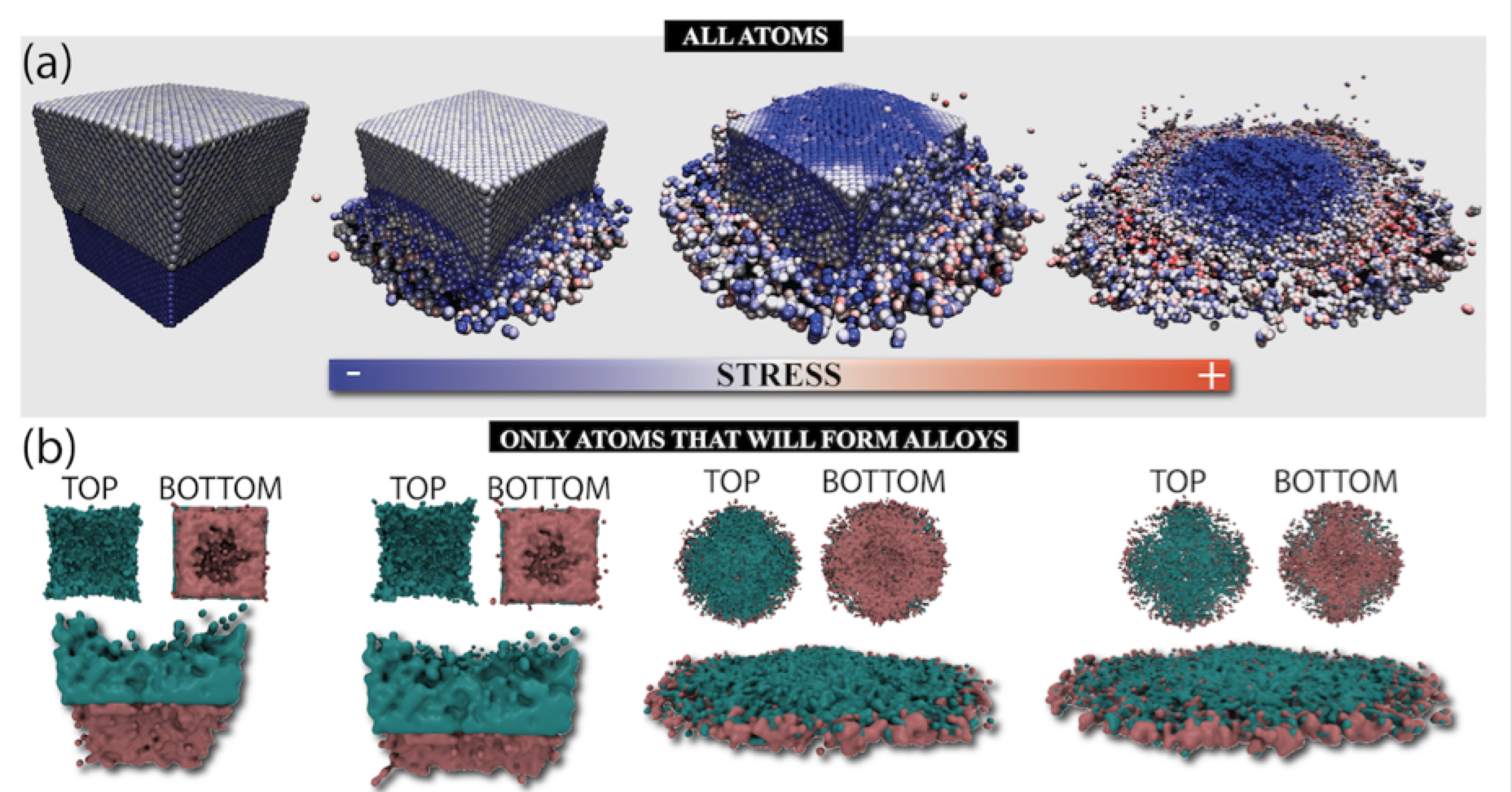
Malviya, Kirtman D; Oliveira, Eliezer F; Autreto, Pedro A S; Ajayan, Pulickel M; Galvao, D S; Tiwary, Candra S; Chattopadhyay, Kumanio
Mixing the immiscible through high-velocity mechanical impacts: an experimental and theoretical study Journal Article
Em: Journal of Physics D: Applied Physics, vol. 52, não 44, pp. 445304, 2019.
Resumo | Links | BibTeX | Tags: Mechanical Properties, Metal, Molecular Dynamics
@article{Malviya2019,
title = {Mixing the immiscible through high-velocity mechanical impacts: an experimental and theoretical study},
author = {Malviya, Kirtman D and Oliveira, Eliezer F and Autreto, Pedro A S and Ajayan, Pulickel M and Galvao, D S and Tiwary, Candra S and Chattopadhyay, Kumanio},
url = {https://iopscience.iop.org/article/10.1088/1361-6463/ab36d1/meta},
doi = {10.1088/1361-6463/ab36d1},
year = {2019},
date = {2019-08-20},
journal = {Journal of Physics D: Applied Physics},
volume = {52},
number = {44},
pages = {445304},
abstract = {In two-component metallic systems, thermodynamic immiscibility leads to phase separation
such as in two-phase eutectic compositional alloys. The limit of the immiscibility of
component elements under non-equilibrium conditions have been explored, but achieving
complete miscibility and formation of single phase microstructures in eutectic alloys would
be unprecedented. Here we report that during low-temperature ball milling that provides high
energy impact, complete mixing of phases can occur in immiscible Ag-Cu eutectic alloys.
From combined theoretical and experimental studies, we show that impact can produce solid
solutions of Ag-Cu nanoparticles of eutectic composition. Our results show that phase
diagrams of low dimensional materials under non-equilibrium conditions remain unexplored
and could lead to new alloy microstructures drastically different from their bulk counterparts.},
keywords = {Mechanical Properties, Metal, Molecular Dynamics},
pubstate = {published},
tppubtype = {article}
}
such as in two-phase eutectic compositional alloys. The limit of the immiscibility of
component elements under non-equilibrium conditions have been explored, but achieving
complete miscibility and formation of single phase microstructures in eutectic alloys would
be unprecedented. Here we report that during low-temperature ball milling that provides high
energy impact, complete mixing of phases can occur in immiscible Ag-Cu eutectic alloys.
From combined theoretical and experimental studies, we show that impact can produce solid
solutions of Ag-Cu nanoparticles of eutectic composition. Our results show that phase
diagrams of low dimensional materials under non-equilibrium conditions remain unexplored
and could lead to new alloy microstructures drastically different from their bulk counterparts.
de Sousa, Jose Moreira; Autreto, Pedro da Silva; Galvao, Douglas Soares
Hydrogenation Dynamics Process of Single-wall Carbon Nanotube Twisted (under review) Journal Article
Em: 2019.
BibTeX | Tags: Carbon Nanotubes, Hydrogenation, Mechanical Properties, Molecular Dynamics
@article{deSousa2019d,
title = {Hydrogenation Dynamics Process of Single-wall Carbon Nanotube Twisted (under review)},
author = {de Sousa, Jose Moreira and Autreto, Pedro da Silva and Galvao, Douglas Soares},
year = {2019},
date = {2019-07-15},
keywords = {Carbon Nanotubes, Hydrogenation, Mechanical Properties, Molecular Dynamics},
pubstate = {published},
tppubtype = {article}
}
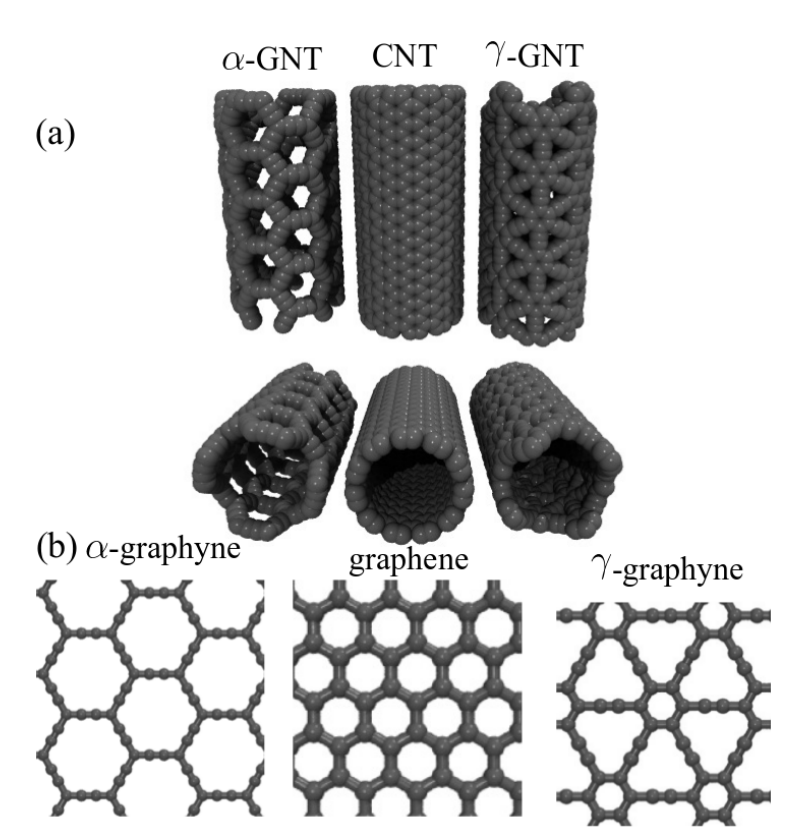
JM; Sousa, Bizao
Elastic Properties of Graphyne-based Nanotubes Online
2019, (ArXiv preprint.).
Resumo | Links | BibTeX | Tags: DFT, Graphynes, Molecular Dynamics, Nanotubes
@online{deSousa2019b,
title = {Elastic Properties of Graphyne-based Nanotubes},
author = {de Sousa, JM; , Bizao, RA; Sousa Filho, VP; Aguiar, AL; Coluci, VR; Pugno, NM; Girao, EC; Souza Filho, AG; Galvao, DS},
url = {https://arxiv.org/pdf/1905.02104.pdf},
year = {2019},
date = {2019-04-07},
abstract = {Graphyne nanotubes (GNTs) are nanostructures obtained from rolled up graphyne sheets,
in the same way carbon nanotubes (CNTs) are obtained from graphene ones. Graphynes
are 2D carbon-allotropes composed of atoms in sp and sp2 hybridized states. Similarly to
conventional CNTs, GNTs can present different chiralities and electronic properties. Because
of the acetylenic groups (triple bonds), GNTs exhibit large sidewall pores that influence their
mechanical properties. In this work, we studied the mechanical response of GNTs under
tensile stress using fully atomistic molecular dynamics simulations and density functional
theory (DFT) calculations. Our results show that GNTs mechanical failure (fracture) occurs
at larger strain values in comparison to corresponding CNTs, but paradoxically with smaller
ultimate strength and Young’s modulus values. This is a consequence of the combined
effects of the existence of triple bonds and increased porosity/flexibility due to the presence
of acetylenic groups.},
note = {ArXiv preprint.},
keywords = {DFT, Graphynes, Molecular Dynamics, Nanotubes},
pubstate = {published},
tppubtype = {online}
}
in the same way carbon nanotubes (CNTs) are obtained from graphene ones. Graphynes
are 2D carbon-allotropes composed of atoms in sp and sp2 hybridized states. Similarly to
conventional CNTs, GNTs can present different chiralities and electronic properties. Because
of the acetylenic groups (triple bonds), GNTs exhibit large sidewall pores that influence their
mechanical properties. In this work, we studied the mechanical response of GNTs under
tensile stress using fully atomistic molecular dynamics simulations and density functional
theory (DFT) calculations. Our results show that GNTs mechanical failure (fracture) occurs
at larger strain values in comparison to corresponding CNTs, but paradoxically with smaller
ultimate strength and Young’s modulus values. This is a consequence of the combined
effects of the existence of triple bonds and increased porosity/flexibility due to the presence
of acetylenic groups.
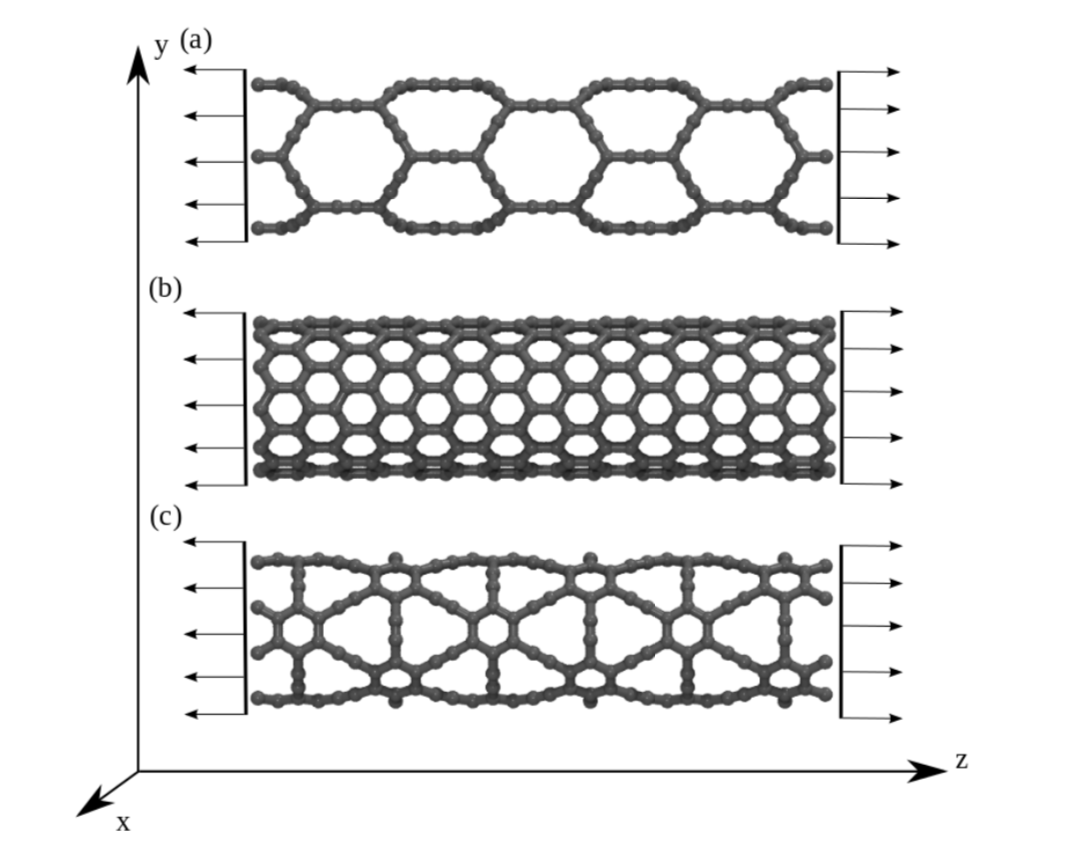
JM; Sousa, Bizao
Elastic Properties of Graphyne-Based Nanotubes Journal Article
Em: Computational Materials Science, vol. 170, pp. 109153, 2019.
Resumo | Links | BibTeX | Tags: DFT, Graphynes, Molecular Dynamics, Nanotubes
@article{deSousa2019c,
title = {Elastic Properties of Graphyne-Based Nanotubes},
author = {de Sousa, JM; , Bizao, RA; Sousa Filho, VP; Aguiar, AL; Coluci, VR; Pugno, NM; Girao, EC; Souza Filho, AG; Galvao, DS},
url = {https://www.sciencedirect.com/science/article/pii/S0927025619304525?dgcid=coauthor#s0040},
doi = {10.1016/j.commatsci.2019.109153},
year = {2019},
date = {2019-04-03},
journal = {Computational Materials Science},
volume = {170},
pages = {109153},
abstract = {Graphyne nanotubes (GNTs) are nanostructures obtained from rolled up graphyne sheets, in the same way carbon nanotubes (CNTs) are obtained from graphene ones. Graphynes are 2D carbon-allotropes composed of atoms in sp and sp2 hybridized states. Similarly to conventional CNTs, GNTs can present different chiralities and electronic properties. Because of the acetylenic groups (triple bonds), GNTs exhibit large sidewall pores that influence their mechanical properties. In this work, we studied the mechanical response of GNTs under tensile stress using fully atomistic molecular dynamics simulations and density functional theory (DFT) calculations. Our results show that GNTs mechanical failure (fracture) occurs at larger strain values in comparison to corresponding CNTs, but paradoxically with smaller ultimate strength and Young’s modulus values. This is a consequence of the combined effects of the existence of triple bonds and increased porosity/flexibility due to the presence of acetylenic groups.},
keywords = {DFT, Graphynes, Molecular Dynamics, Nanotubes},
pubstate = {published},
tppubtype = {article}
}
Fonseca, AF; Dantas, SO; Galvao, DS; Zhang, D; Sinnott, SB
The Structure of Graphene on Graphene/C60/Cu Interfaces: A Molecular Dynamics Study (under review) Journal Article
Em: 2019.
BibTeX | Tags: C60, Graphene, Molecular Dynamics
@article{Fonseca2019d,
title = {The Structure of Graphene on Graphene/C60/Cu Interfaces: A Molecular Dynamics Study (under review)},
author = {Fonseca, AF and Dantas, SO and Galvao, DS and Zhang, D and Sinnott, SB},
year = {2019},
date = {2019-04-03},
keywords = {C60, Graphene, Molecular Dynamics},
pubstate = {published},
tppubtype = {article}
}
Arpan; Gumaste Rout, Anurag; Pandey
Bio-inspired Aluminum Composite reinforced with Soft polymer with enhanced strength and plasticity (under review) Journal Article
Em: 2019.
BibTeX | Tags: Metal, Molecular Dynamics, Polymers
@article{Rout2019,
title = {Bio-inspired Aluminum Composite reinforced with Soft polymer with enhanced strength and plasticity (under review)},
author = {Rout, Arpan; Gumaste, Anurag; Pandey, Praful; Oliveira, Eliezer; Demiss,
Solomon; P., Mahesh; Bhatt, Chintan; Raphael, Kiran; Ayyagari, Ravi; Autreto, Pedro;
Palit, Mithun; Femi, Olu Emmanuel; Galvao, Douglas; Arora, Amit; Tiwary, Chandra},
year = {2019},
date = {2019-03-30},
keywords = {Metal, Molecular Dynamics, Polymers},
pubstate = {published},
tppubtype = {article}
}
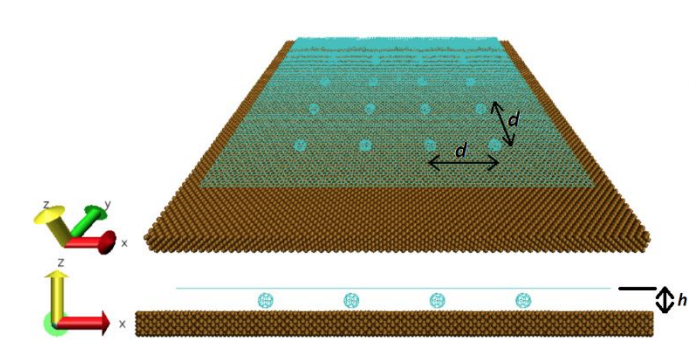
AF; Dantas Fonseca, SO; Galvao
The Structure of Graphene on Graphene/C60/Cu Interfaces: A Molecular Dynamics Study Online
2019, (ArXiv preprint).
Resumo | Links | BibTeX | Tags: C60, Graphene, Molecular Dynamics
@online{Fonseca2019b,
title = {The Structure of Graphene on Graphene/C60/Cu Interfaces: A Molecular Dynamics Study},
author = {Fonseca, AF; Dantas, SO; Galvao, DS; Zhang, D; Sinnott SB},
url = {https://arxiv.org/pdf/1904.09871.pdf},
year = {2019},
date = {2019-03-22},
abstract = {Two experimental studies reported the spontaneous formation of amorphous and crystalline
structures of C60 intercalated between graphene and a substrate. They observed interesting
phenomena ranging from reaction between C60 molecules under graphene to graphene
sagging between the molecules and control of strain in graphene. Motivated by these works,
we performed fully atomistic reactive molecular dynamics simulations to study the formation
and thermal stability of graphene wrinkles as well as graphene attachment to and detachment
from the substrate when graphene is laid over a previously distributed array of C60 molecules
on a copper substrate at different values of temperature. As graphene compresses the C60
molecules against the substrate, and graphene attachment to the substrate between C60s
(“C60S” stands for plural of C60) depends on the height of graphene wrinkles, configurations
with both frozen and non-frozen C60s structures were investigated in order to verify the
experimental result of stable sagged graphene when the distance between C60s is about 4 nm
and height of graphene wrinkles is about 0.8 nm. Below the distance of 4 nm between C60s,
graphene becomes locally suspended and less strained. We show that this happens when C60s
are allowed to deform under the compressive action of graphene. If we keep the C60s frozen,
spontaneous “blanketing” of graphene happens only when the distance between them are
equal or above 7 nm. Both above results for the existence of stable sagged graphene for C60
distances of 4 or 7 nm are shown to agree with a mechanical model relating the rigidity of
graphene to the energy of graphene-substrate adhesion. Although the studies of intercalation
of molecules on interfaces formed by graphene-substrate are motivated by finding out ways to
control wrinkling and strain in graphene, our work reveals the shape and structure of
intercalated molecules and the role of stability and wrinkling on final structure of graphene.
In particular, this study might help the development of 2D confined nanoreactors that are
considered in literature to be the next advanced step on chemical reactions.},
note = {ArXiv preprint},
keywords = {C60, Graphene, Molecular Dynamics},
pubstate = {published},
tppubtype = {online}
}
structures of C60 intercalated between graphene and a substrate. They observed interesting
phenomena ranging from reaction between C60 molecules under graphene to graphene
sagging between the molecules and control of strain in graphene. Motivated by these works,
we performed fully atomistic reactive molecular dynamics simulations to study the formation
and thermal stability of graphene wrinkles as well as graphene attachment to and detachment
from the substrate when graphene is laid over a previously distributed array of C60 molecules
on a copper substrate at different values of temperature. As graphene compresses the C60
molecules against the substrate, and graphene attachment to the substrate between C60s
(“C60S” stands for plural of C60) depends on the height of graphene wrinkles, configurations
with both frozen and non-frozen C60s structures were investigated in order to verify the
experimental result of stable sagged graphene when the distance between C60s is about 4 nm
and height of graphene wrinkles is about 0.8 nm. Below the distance of 4 nm between C60s,
graphene becomes locally suspended and less strained. We show that this happens when C60s
are allowed to deform under the compressive action of graphene. If we keep the C60s frozen,
spontaneous “blanketing” of graphene happens only when the distance between them are
equal or above 7 nm. Both above results for the existence of stable sagged graphene for C60
distances of 4 or 7 nm are shown to agree with a mechanical model relating the rigidity of
graphene to the energy of graphene-substrate adhesion. Although the studies of intercalation
of molecules on interfaces formed by graphene-substrate are motivated by finding out ways to
control wrinkling and strain in graphene, our work reveals the shape and structure of
intercalated molecules and the role of stability and wrinkling on final structure of graphene.
In particular, this study might help the development of 2D confined nanoreactors that are
considered in literature to be the next advanced step on chemical reactions.
AF; Dantas Fonseca, SO; Galvao
The Structure of Graphene on Graphene/C60/Cu Interfaces: A Molecular Dynamics Study (under review) Journal Article
Em: 2019.
BibTeX | Tags: C60, Graphene, Molecular Dynamics
@article{Fonseca2019c,
title = {The Structure of Graphene on Graphene/C60/Cu Interfaces: A Molecular Dynamics Study (under review)},
author = {Fonseca, AF; Dantas, SO; Galvao, DS; Zhang, D; Sinnott SB},
year = {2019},
date = {2019-03-15},
keywords = {C60, Graphene, Molecular Dynamics},
pubstate = {published},
tppubtype = {article}
}
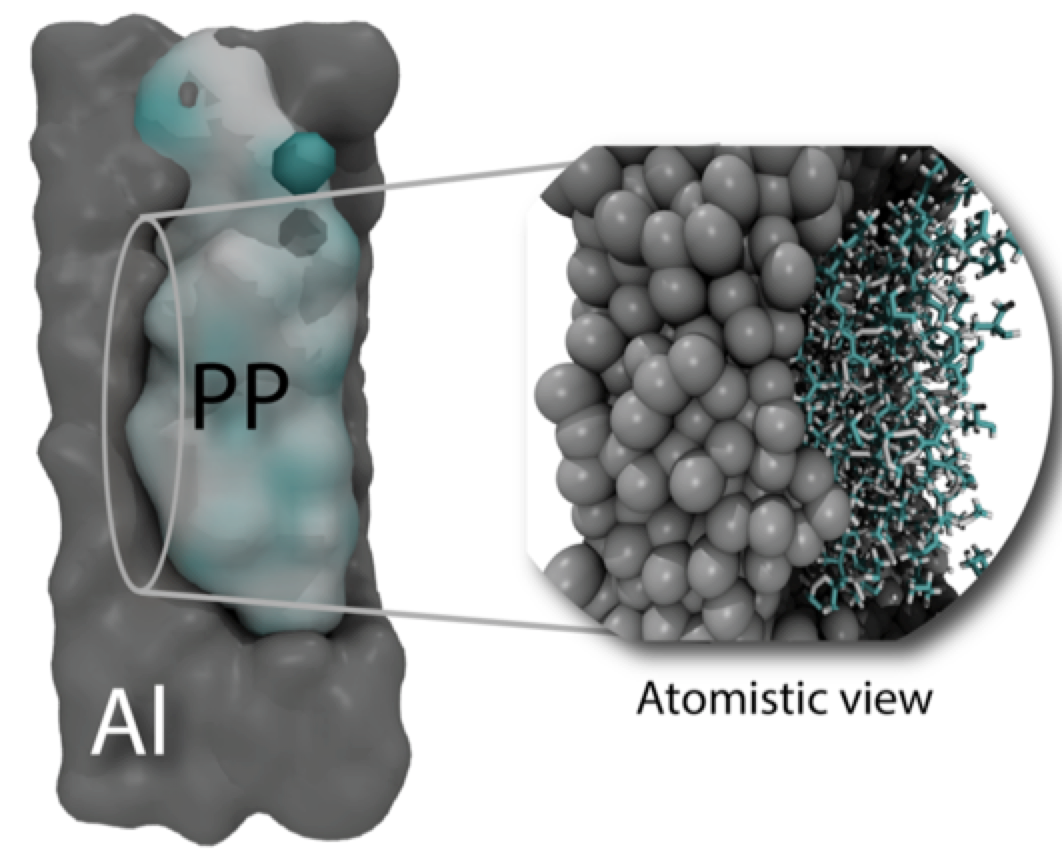
Routa, Arpan; Pandeyb, Praful; Oliveira, Eliezer Fernando; da Silva Autreto, Pedro Alves; Gumastea, Anurag; Singha, Amit; Galvao, Douglas Soares; Aroraa, Amit; Tiwary, Chandra Sekhar
Atomically locked interfaces of metal (Aluminum) and Polymer (Polypropylene) using mechanical friction Journal Article
Em: Polymer, vol. 169, pp. 148-153, 2019.
Resumo | BibTeX | Tags: Composites, Metal, Molecular Dynamics, Polymers
@article{Routa2019,
title = {Atomically locked interfaces of metal (Aluminum) and Polymer (Polypropylene) using mechanical friction},
author = {Arpan Routa and Praful Pandeyb and Eliezer Fernando Oliveira and Pedro Alves da Silva Autreto and Anurag Gumastea and Amit Singha and Douglas Soares Galvao and Amit Aroraa and Chandra Sekhar Tiwary},
year = {2019},
date = {2019-02-23},
journal = {Polymer},
volume = {169},
pages = {148-153},
abstract = {Joining different parts is one of a crucial component of designing/engineering of materials. The current energy, low efficiency weight automotive and aerospace components commonly consist of different class of materials, such as metal, polymer, and ceramics, etc. Joining these components remains a challenge. Here, we demonstrate joining of metal (aluminum) and polymer (PP) using mechanical friction. The detailed characterisation demonstrates that atomically locked interfaces are formed in such joining without the presence of any chemical bond at the interfaces. The waterproof and strong interface is formed in such process. Fully atomistic molecular dynamics simulations were also carried out to provide further insights on these mechanisms.},
keywords = {Composites, Metal, Molecular Dynamics, Polymers},
pubstate = {published},
tppubtype = {article}
}
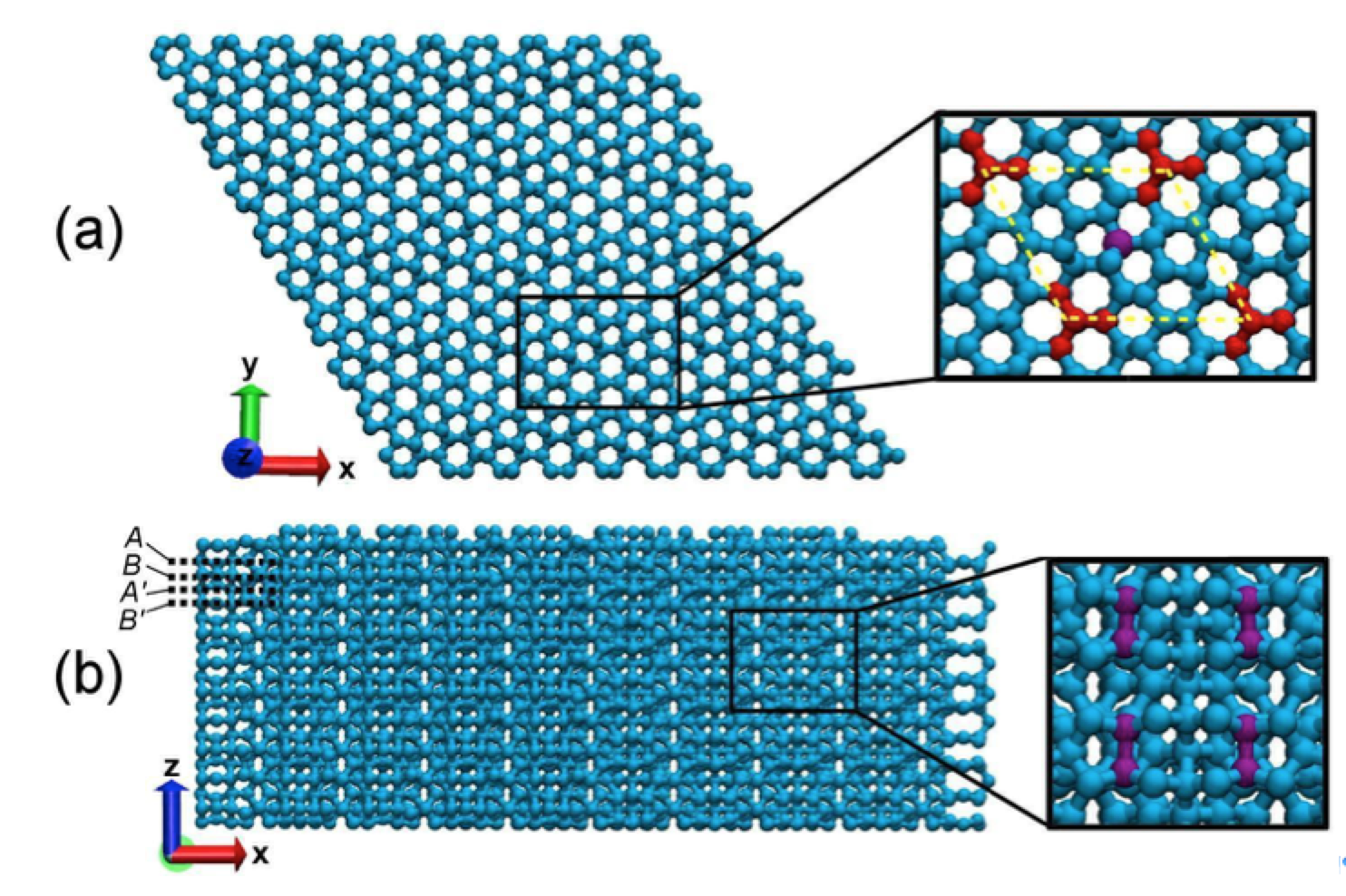
Eliezer F; Autreto Oliveira, Pedro AS; Woellner
On the mechanical properties of protomene: A theoretical investigation Journal Article
Em: Computational Materials Science, vol. 161, pp. 190-198, 2019.
Resumo | BibTeX | Tags: Fracture, Mechanical Properties, Molecular Dynamics, protomene
@article{Oliveira2019c,
title = {On the mechanical properties of protomene: A theoretical investigation},
author = {Oliveira, Eliezer F; Autreto, Pedro AS; Woellner, Cristiano F; Galvao, Douglas S},
year = {2019},
date = {2019-02-07},
journal = {Computational Materials Science},
volume = {161},
pages = {190-198},
abstract = {We report a detailed study through fully atomistic molecular dynamics simulations and DFT calculations on the mechanical properties of protomene. Protomene is a new carbon allotrope composed of a mixture of sp2 and sp3 hybridized states. Our results indicate that protomene presents an anisotropic behavior about tensile deformations. At room temperature, protomene presents an ultimate strength of ~100 GPa and Young's modulus of ~600 GPa, lower than the same for other carbon allotropes. Despite that, protomente presents the highest ultimate strain along the z-direction (~ 24.7%). Our results also show that stretching the protomene along the z-direction or heating it can induce a semiconductor-metallic phase transition, due to a high amount of sp3 bonds that are converted to sp2 ones.},
keywords = {Fracture, Mechanical Properties, Molecular Dynamics, protomene},
pubstate = {published},
tppubtype = {article}
}
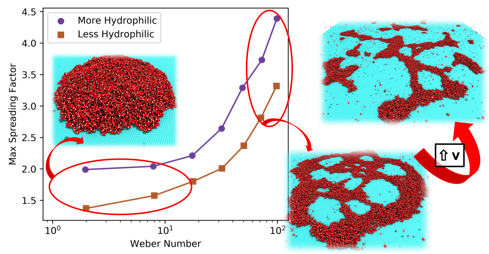
Jaques, Ygor M.; Galvao, Douglas S.
Structural Properties of Nanodroplets Impacting Graphene at High Velocities (accepted) Journal Article
Em: Journal of Molecular Liquids, 2019.
Resumo | BibTeX | Tags: droplets, Graphene, Impact Molecular Dynamics, water
@article{Jaques2019b,
title = {Structural Properties of Nanodroplets Impacting Graphene at High Velocities (accepted)},
author = {Ygor M. Jaques and Douglas S. Galvao},
year = {2019},
date = {2019-02-05},
journal = {Journal of Molecular Liquids},
abstract = {The determination of the wettability of 2D materials is an area of intensive research, as it is decisive on the applications of these systems in nanofluidics. One important part of the wetting characterization is how the spreading of droplets impacting on the surfaces occurs. However, few works address this problem for layered materials. Here, we report a fully atomistic molecular dynamics study on the dynamics of impact of water nanodroplets (100 ̊A of diameter) at high velocities (from 1 up to 15 ̊A/ps) against graphene targets. Our results show that tuning graphene wettability (through parameter changes) significantly affects the structural and dynamical aspects of the nanodroplets. We identified three ranges of velocities with distinct characteristics, from simple deposition of the droplet to spreading with rebound, and finally droplet frag- mentation. We also identify that in an intermediary velocity of 7 ̊A/ps, the pattern of spreading critically changes, due to formation of voids on droplet structure. These voids affect in a detrimental way the droplet spreading on the less hydrophilic surface, as it takes more time to the droplet recover from the spreading and to return to a semi-spherical configuration. When the velocity is increased to values larger than 11 ̊A/ps, the droplet fragments, which reveals the maximum possible spreading.},
keywords = {droplets, Graphene, Impact Molecular Dynamics, water},
pubstate = {published},
tppubtype = {article}
}
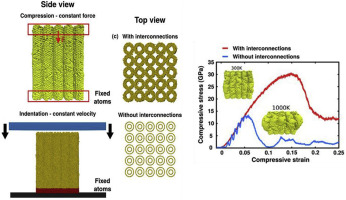
Sanjit; Ozden Bhowmick, Sehmus; Bizão
High temperature quasistatic and dynamic mechanical behavior of interconnected 3D carbon nanotube structures Journal Article
Em: Carbon, vol. 142, pp. 291-299, 2019.
Resumo | Links | BibTeX | Tags: CNT, Fracture, Mechanical Properties, Molecular Dynamics
@article{Bhowmick2019,
title = {High temperature quasistatic and dynamic mechanical behavior of interconnected 3D carbon nanotube structures},
author = {Bhowmick, Sanjit; Ozden, Sehmus; Bizão, Rafael A; Machado, Leonardo Dantas; Asif, SA Syed; Pugno, Nicola M; Galvao, Douglas S; Tiwary, Chandra Sekhar; Ajayan, PM},
url = {https://www.sciencedirect.com/science/article/pii/S0008622318308911},
doi = {10.1016/j.carbon.2018.09.075},
year = {2019},
date = {2019-02-01},
journal = {Carbon},
volume = {142},
pages = {291-299},
abstract = {Carbon nanotubes (CNTs) are one of the most appealing materials in recent history for both research and commercial interest because of their outstanding physical, chemical, and electrical properties. This is particularly true for 3D arrangements of CNTs which enable their use in larger scale devices and structures. In this paper, the effect of temperature on the quasistatic and dynamic deformation behavior of 3D CNT structures is presented for the first time. An in situ high-temperature nanomechanical instrument was used inside an SEM at high vacuum to investigate mechanical properties of covalently interconnected CNT porous structures in a wide range of temperature. An irreversible bucking at the base of pillar samples was found as a major mode of deformation at room and elevated temperatures. It has been observed that elastic modulus and critical load to first buckle formation decrease progressively with increasing temperature from 25 °C to 750 °C. To understand fatigue resistance, pillars made from this unique structure were compressed to 100 cycles at room temperature and 750 °C. While the structure showed remarkable resistance to fatigue at room temperature, high temperature significantly lowers fatigue resistance. Molecular dynamics (MD) simulation of compression highlights the critical role played by covalent interconnections which prevent localized bending and improve mechanical properties.},
keywords = {CNT, Fracture, Mechanical Properties, Molecular Dynamics},
pubstate = {published},
tppubtype = {article}
}
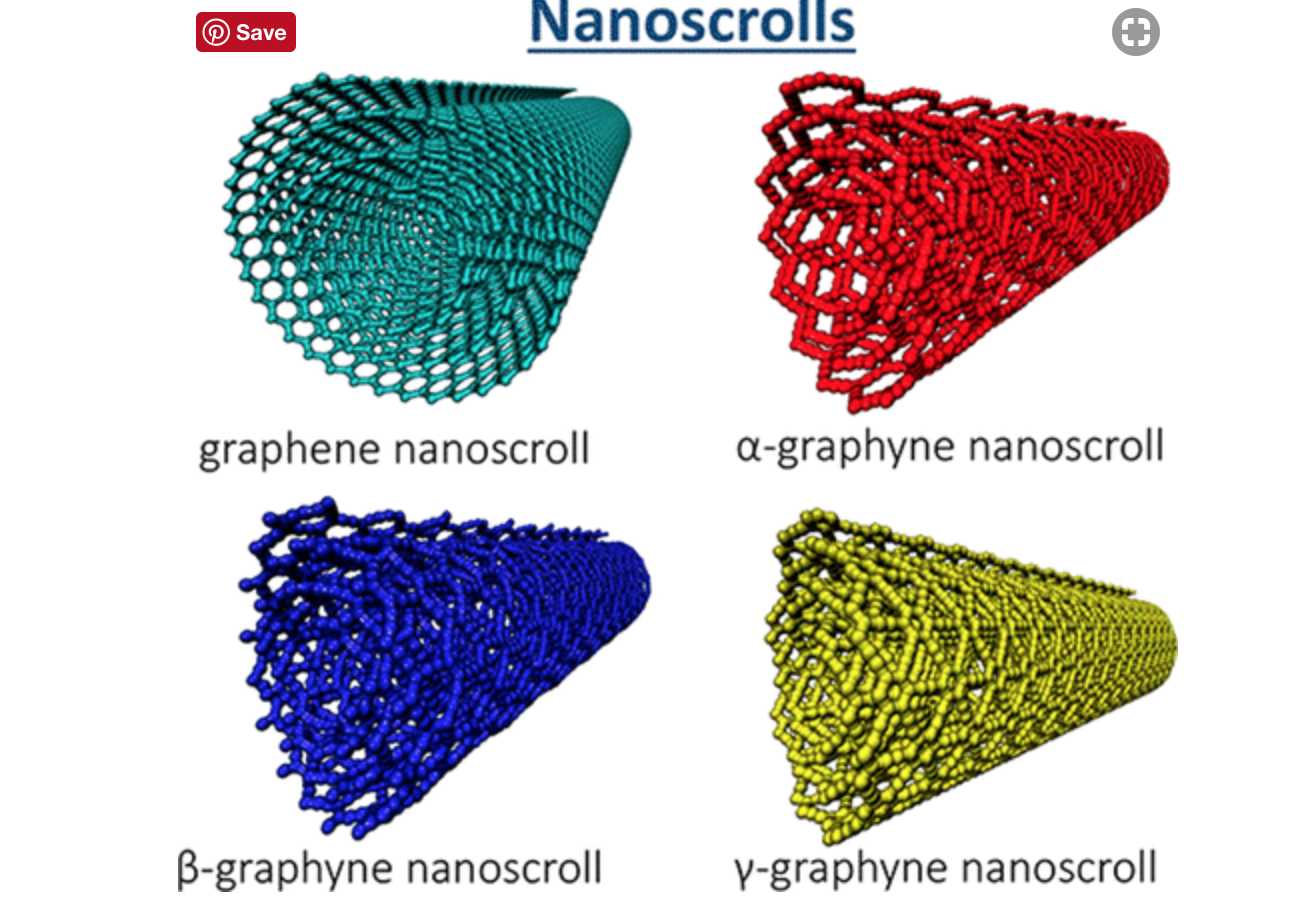
Solis, Daniel; Damasceno Borges, Daiane; Woellner, Cristiano; Galvao, Douglas
Structural and Thermal Stability of Graphyne and Graphdiyne Nanoscroll Structures (invited paper) Journal Article
Em: ACS Applied Materials and Interfaces, vol. 11, pp. 2670−2676, 2019.
Resumo | Links | BibTeX | Tags: graphdiynes, Graphynes, Molecular Dynamics, Scrolls
@article{Solis2019,
title = {Structural and Thermal Stability of Graphyne and Graphdiyne Nanoscroll Structures (invited paper)},
author = {Solis, Daniel and Damasceno Borges, Daiane and Woellner, Cristiano and Galvao,
Douglas},
url = {https://pubs.acs.org/doi/10.1021/acsami.8b03481},
doi = {10.1021/acsami.8b03481},
year = {2019},
date = {2019-01-23},
journal = {ACS Applied Materials and Interfaces},
volume = {11},
pages = {2670−2676},
abstract = {Graphynes and graphdiynes are generic names for families of two-dimensional carbon allotropes, where acetylenic groups connect benzenoid-like hexagonal rings, with the coexistence of sp and sp2 hybridized carbon atoms. The main differences between graphynes and graphdiynes are the number of acetylenic groups (one and two for graphynes and graphdiynes, respectively). Similarly to graphene nanoscrolls, graphyne and graphdiynes nanoscrolls are nanosized membranes rolled into papyrus-like structures. In this work we studied through molecular dynamics simulations, using reactive potentials, the structural and thermal (up to 1000 K) stability of α,β,γ-graphyne and α,β,γ-graphdiyne scrolls. Our results demonstrate that stable nanoscrolls can be created for all the structures studied here, although they are less stable than corresponding graphene scrolls. This can be elucidated as a result of the higher graphyne/graphdiyne structural porosity in relation to graphene, and as a consequence, the π–π stacking interactions decrease.},
keywords = {graphdiynes, Graphynes, Molecular Dynamics, Scrolls},
pubstate = {published},
tppubtype = {article}
}
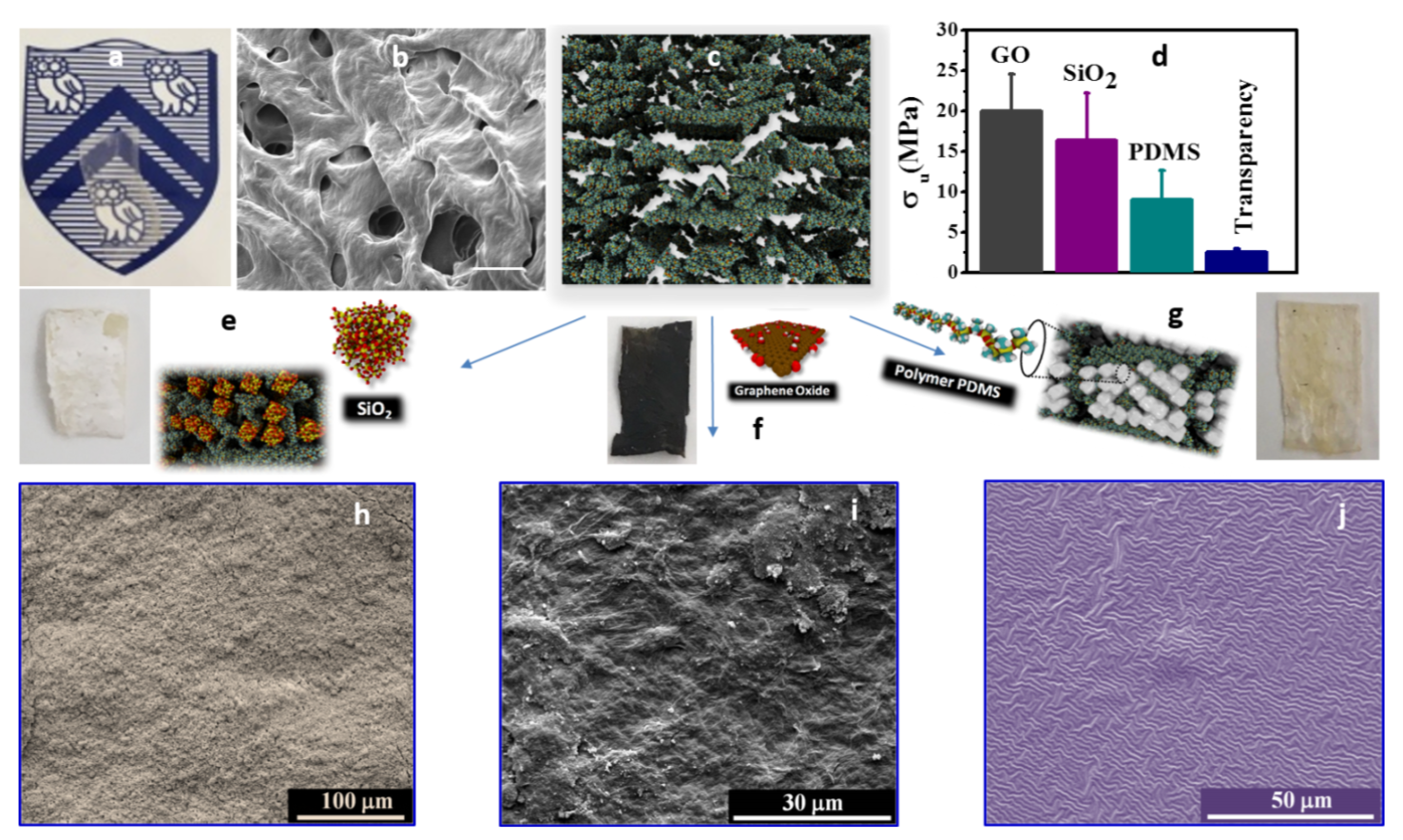
Owuor, Peter Samora; Inthong, Suchittra; Sajadi, Seyed Mohammad; Intawin, Pratthana; Chipara, Alin C.; Woellner, Cristiano F.; Sayed, Farheen N.; Tsang, Harvey H.; Stender, Anthony; Vajtai, Robert; Pengpat, Kamonpan; Eitssayeam, Sukum; Galvao, Douglas S.; Lou, Jun; Tiwary, Chandra Sekhar; Ajayan, Pulickel M.
Elastic and ‘transparent bone’ as an electrochemical separator Journal Article
Em: Materials Chemistry Today, vol. 12, pp. 132-138, 2019.
Resumo | Links | BibTeX | Tags: biomaterials, Bone, Characterization, electrodes, Modeling, Molecular Dynamics
@article{Owuor2019,
title = {Elastic and ‘transparent bone’ as an electrochemical separator},
author = {Peter Samora Owuor and Suchittra Inthong and Seyed Mohammad Sajadi and Pratthana Intawin and Alin C. Chipara and Cristiano F. Woellner and Farheen N. Sayed and Harvey H. Tsang and Anthony Stender and Robert Vajtai and Kamonpan Pengpat and Sukum Eitssayeam and Douglas S. Galvao and Jun Lou and Chandra Sekhar Tiwary and Pulickel M. Ajayan},
url = {https://reader.elsevier.com/reader/sd/pii/S246851941830291X?token=B3C1F35B7DCEA8636EFB32B8D1D71EEC9852E58D0729A622DAFDF86C3EE65DF2A33E77CE7534A5D66D3854C396F69D1A},
doi = {10.1016/j.mtchem.2018.12.009},
year = {2019},
date = {2019-01-05},
journal = {Materials Chemistry Today},
volume = {12},
pages = {132-138},
abstract = {Organic matrix of bone mainly composed of collagen matrix serve as a crucial component for remarkable toughness and strength in bones. The porous collagen matrix can also serve as efficient template for various applications such as nanoparticles synthetic, catalysis or catalysis supports, electrochemical separator, filtration membrane and tissue engineering. However, fabricating collagen matrix from bones without degrading its morphological structure still remain a challenge. Here we present evidence of how ceramic crystals from a bone can be removed to fabricate a complete ‘transparent bone’ structure with improved porous and elasticity. We show that demineralization or selective etching using dilute acid (citric) can remove ceramics mineral nanoparticles without degrading the collagen matrix. The transparent bone collagen matrix is investigated as the separator in electrochemical supercapacitor with aqueous electrolyte where it shows better performance compared to conventional separators.},
keywords = {biomaterials, Bone, Characterization, electrodes, Modeling, Molecular Dynamics},
pubstate = {published},
tppubtype = {article}
}
de Sousa, JM; Aguiar, AL; Girao, EC; Fonseca, Alexandre F; AG Filho, Souza; Galvao, Douglas S
Mechanical Properties and Fracture Patterns of Pentagraphene Membranes (under review) Journal Article
Em: 2019.
BibTeX | Tags: Fracture, Molecular Dynamics, pentagraphene
@article{deSousa2019,
title = {Mechanical Properties and Fracture Patterns of Pentagraphene Membranes (under review)},
author = {de Sousa, JM and Aguiar, AL and Girao, EC and Fonseca, Alexandre F and AG Filho, Souza and Galvao, Douglas S},
year = {2019},
date = {2019-01-05},
keywords = {Fracture, Molecular Dynamics, pentagraphene},
pubstate = {published},
tppubtype = {article}
}
Ok-Kyung; Owuor Park, Peter; Morais Jaques
Novel Method to Fabricate Multi-Functional Boron Nitride-Iron-Carbon Nanotube Hybrid Materials for Fabrication of High- Performance Polyimide Composites (under review) Journal Article
Em: 2019.
BibTeX | Tags: Boron Nitride, carbon nanotube, Modeling
@article{Park2019,
title = {Novel Method to Fabricate Multi-Functional Boron Nitride-Iron-Carbon Nanotube Hybrid Materials for Fabrication of High- Performance Polyimide Composites (under review)},
author = {Park, Ok-Kyung; Owuor, Peter; Morais Jaques, Ygor; Lee, Joong Hee; Kim, Nam
Hoon; Galvao, Douglas; Lou, Jun; Tiwary, Chandra; Ajayan, Pulickel},
year = {2019},
date = {2019-01-05},
keywords = {Boron Nitride, carbon nanotube, Modeling},
pubstate = {published},
tppubtype = {article}
}
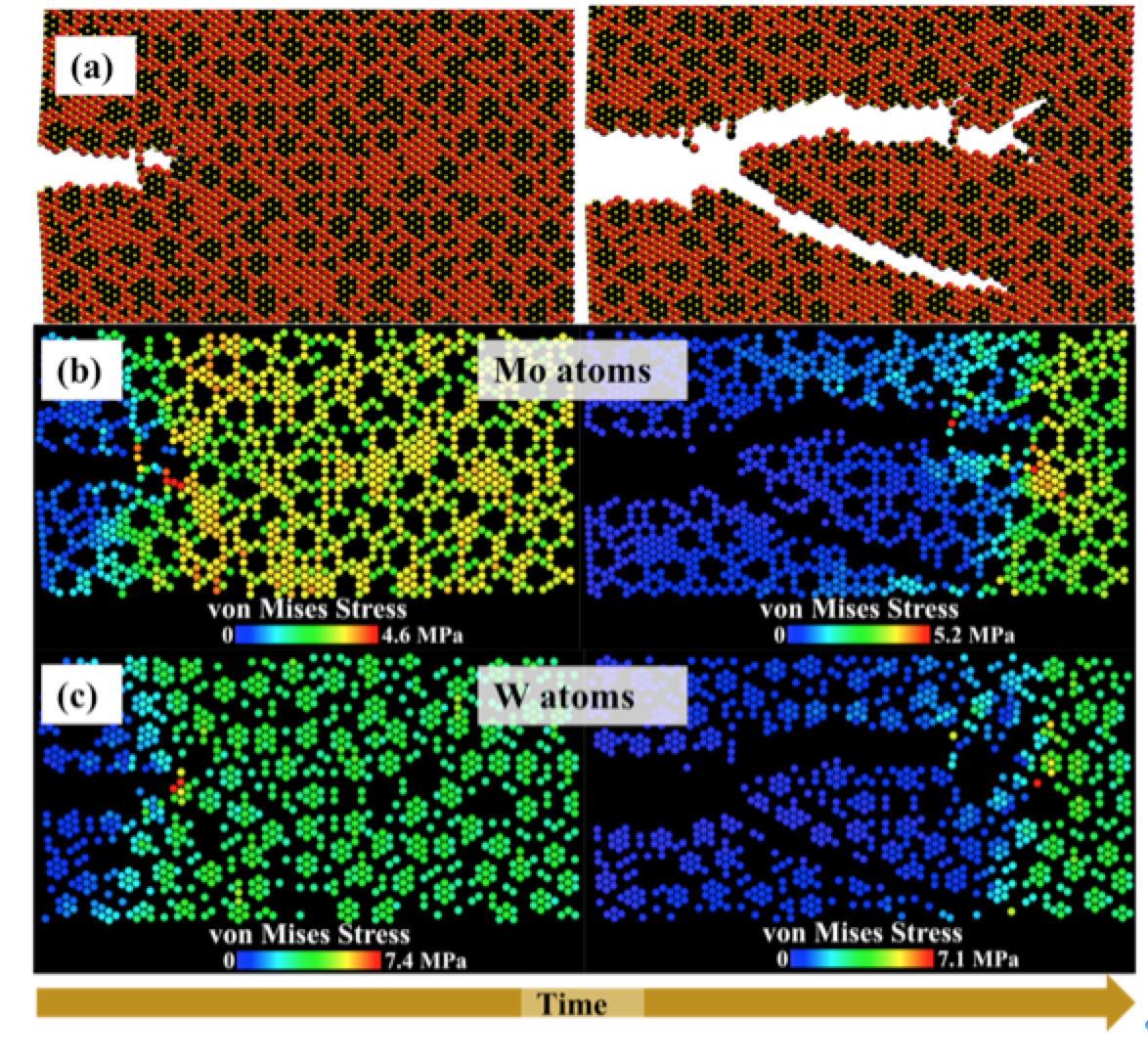
Susarla, Sandhya; Manimunda, Praveena; Jaques, Ygor M.; Hachtel, Jordan A.; Idrobo, Juan C.; Asif, S. A. Syed; Galvao, Douglas S.; Tiwary, Chandrasekhar; Ajayan, Pulickel M.
Strain induced structural deformation study of two dimensional MoxW(1-x)S2 Journal Article
Em: Advanced Materials Interfaces (accepted), 2019.
@article{Susarla2019,
title = {Strain induced structural deformation study of two dimensional MoxW(1-x)S2},
author = {Sandhya Susarla and Praveena Manimunda and Ygor M. Jaques and Jordan A. Hachtel and Juan C. Idrobo and S. A. Syed Asif and Douglas S. Galvao and Chandrasekhar Tiwary and Pulickel M. Ajayan},
year = {2019},
date = {2019-01-05},
journal = {Advanced Materials Interfaces (accepted)},
abstract = {The possibility of tuning properties and its potential applications in the fields of optoelectronics and/or flexible electronics, has increased the demand for 2D alloys in recent times. Understanding the mechanical performance of 2D materials under extreme conditions, such as strain, stress and fracture is essential for the reliable electronic devices based on these structures. In this study, combined molecular dynamics (MD) simulations and in situ Raman spectroscopic techniques were used to study the mechanical performance of a 2D alloy system, MoxW(1-x) S2. It was observed that W substitution in MoS2 causes solid-solution strengthening and increase in the Young’s modulus values. Higher W content decreased failure strain for MoS2. Based on spatially resolved Raman spectroscopy and MD simulations results, we propose a detailed model to explain failure mechanisms in MoxW(1-x)S2 alloys. },
keywords = {},
pubstate = {published},
tppubtype = {article}
}

Fonseca, Alexandre F.; Galvao, Douglas S.
Self-tearing and self-peeling of folded graphene nanoribbons Journal Article
Em: Carbon, vol. 143, pp. 230-239, 2019.
Resumo | Links | BibTeX | Tags: Fracture, Graphene, Mechanical Properties, Molecular Dynamics
@article{Fonseca2019,
title = {Self-tearing and self-peeling of folded graphene nanoribbons},
author = {Alexandre F. Fonseca and Douglas S. Galvao},
url = {https://www.sciencedirect.com/science/article/pii/S0008622318310431},
doi = {10.1016/j.carbon.2018.11.020},
year = {2019},
date = {2019-01-05},
journal = {Carbon},
volume = {143},
pages = {230-239},
abstract = {A recent experimental study showed that an induced folded flap of graphene can spontaneously drive itself its tearing and peeling off a substrate, thus producing long, micrometer sized, regular trapezoidal-shaped folded graphene nanoribbons. As long as the size of the graphene flaps is above a threshold value, the “tug of war” between the forces of adhesion of graphene-graphene and graphene-substrate, flexural strain of folded region and carbon-carbon (C-C) covalent bonds favor the self-tearing and self-peeling off process. As the detailed information regarding the atomic scale mechanism involved in the process remains not fully understood, we carried out atomistic reactive molecular dynamics simulations to address some features of the process. We show that large thermal fluctuations can prevent the process by increasing the probability of chemical reactions between carbon dangling bonds of adjacent graphene layers. The effects of the strength of attraction between graphene and the substrate on the ribbon growth velocities at the early stages of the phenomenon were also investigated. Structures with initial armchair crack-edges were observed to form more uniform cuts than those having initial zigzag ones. Our results are of importance to help set up new experiments on this phenomenon, especially with samples with nanoscale sized cuts. },
keywords = {Fracture, Graphene, Mechanical Properties, Molecular Dynamics},
pubstate = {published},
tppubtype = {article}
}
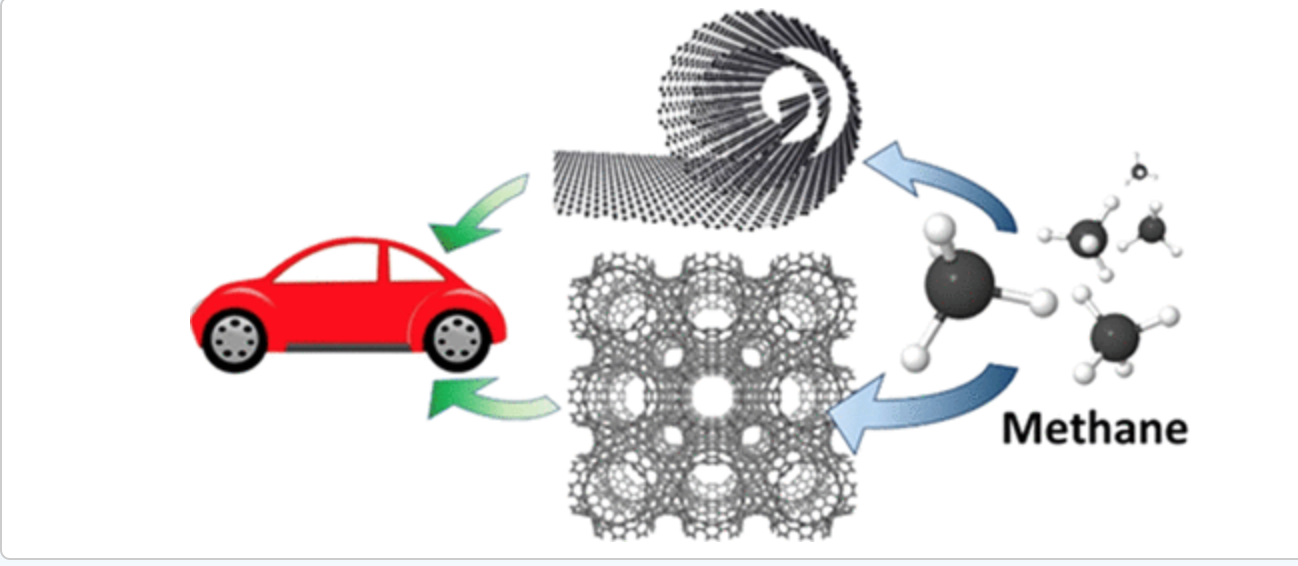
Sean P; Perim Collins, Eric; Daff
Idealized Carbon-Based Materials Exhibiting Record Deliverable Capacities for Vehicular Methane Storage Journal Article
Em: The Journal of Physical Chemistry C, vol. 123, pp. 1050-1058, 2019.
Resumo | Links | BibTeX | Tags: Gas Storage, Molecular Dynamics, Monte Carlo, Schwarzites, Scrolls
@article{Collins2019,
title = {Idealized Carbon-Based Materials Exhibiting Record Deliverable Capacities for Vehicular Methane Storage},
author = {Collins, Sean P; Perim, Eric; Daff, Thomas D; Skaf, Munir S; Galvao, Douglas Soares; Woo, Tom K},
url = {https://pubs.acs.org/doi/abs/10.1021/acs.jpcc.8b09447},
doi = {10.1021/acs.jpcc.8b09447},
year = {2019},
date = {2019-01-05},
journal = {The Journal of Physical Chemistry C},
volume = {123},
pages = {1050-1058},
abstract = {Materials for vehicular methane storage have been extensively studied, although no suitable material has been found. In this work, we use molecular simulation to investigate three types of carbon-based materials, Schwarzites, layered graphenes, and carbon nanoscrolls, for use in vehicular methane storage under adsorption conditions of 65 bar and 298 K and desorption conditions of 5.8 bar and 358 K. Ten different Schwarzites were tested and found to have high adsorption with maximums at 273 VSTP/V, but middling deliverable capacities of no more than 131 VSTP/V. Layered graphene and graphene nanoscrolls were found to have extremely high CH4 adsorption capacities of 355 and 339 VSTP/V, respectively, when the interlayer distance was optimized to 11 Å. The deliverable capacities of perfectly layered graphene and graphene nanoscrolls were also found to be exceptional with values of 266 and 252 VSTP/V, respectively, with optimized interlayer distances. These values make idealized graphene and nanoscrolls the record holders for adsorption and deliverable capacities under vehicular methane storage conditions.},
keywords = {Gas Storage, Molecular Dynamics, Monte Carlo, Schwarzites, Scrolls},
pubstate = {published},
tppubtype = {article}
}
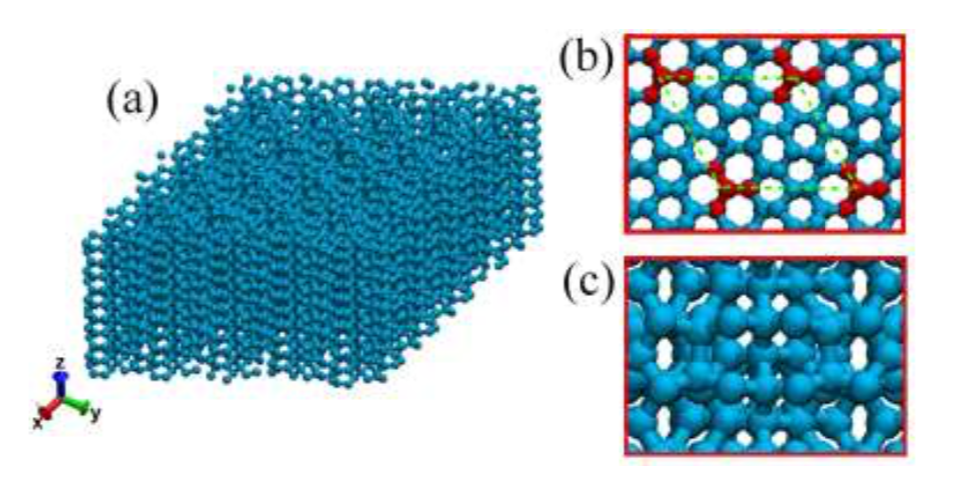
Eliezer F; Autreto Oliveira, Pedro AS; Woellner
Mechanical Properties of Protomene: A Molecular Dynamics Investigation Journal Article
Em: MRS Advances, 2019.
Resumo | Links | BibTeX | Tags: Fracture, Mechanical Properties, Molecular Dynamics, protomene
@article{Oliveira2019,
title = {Mechanical Properties of Protomene: A Molecular Dynamics Investigation},
author = {Oliveira, Eliezer F; Autreto, Pedro AS; Woellner, Cristiano F; Galvao, Douglas S},
url = {www.cambridge.org/core/journals/mrs-advances/article/mechanical-properties-of-protomene-a-molecular-dynamics-investigation/CBAC89BDB5942E3353A5C00BD5D0D9CA},
doi = {10.1557/adv.2018.670},
year = {2019},
date = {2019-01-05},
journal = {MRS Advances},
abstract = {Recently, a new class of carbon allotrope called protomene was proposed. This new structure is composed of sp2 and sp3 carbon-bonds. Topologically, protomene can be considered as an sp3 carbon structure (~80% of this bond type) doped by sp2 carbons. First-principles simulations have shown that protomene presents an electronic bandgap of ~3.4 eV. However, up to now, its mechanical properties have not been investigated. In this work, we have investigated protomene mechanical behavior under tensile strain through fully atomistic reactive molecular dynamics simulations using the ReaxFF force field, as available in the LAMMPS code. At room temperature, our results show that the protomene is very stable and the obtained ultimate strength and ultimate stress indicates an anisotropic behavior. The highest ultimate strength was obtained for the x-direction, with a value of ~110 GPa. As for the ultimate strain, the highest one was for the z-direction (~25% of strain) before protomene mechanical fracture.
},
keywords = {Fracture, Mechanical Properties, Molecular Dynamics, protomene},
pubstate = {published},
tppubtype = {article}
}
Nakar, Dekel; Gordeev, Georgy; Machado, Leonardo D.; Popovitz-Biro, Ronit; Rechav, Katya; Oliveira, Eliezer F.; Kusch, Patryk; Jorio, Ado; Galvao, Douglas S.; Reich, Stephanie; Joselevich, Ernesto
Few-Wall Carbon Nanotube Coils (under review) Journal Article
Em: 2019.
BibTeX | Tags: Carbon Nanotubes, Molecular Dynamics, Nanocoils, Raman
@article{Nakar2019,
title = {Few-Wall Carbon Nanotube Coils (under review)},
author = {Dekel Nakar and Georgy Gordeev and Leonardo D. Machado and Ronit Popovitz-Biro and Katya Rechav and Eliezer F. Oliveira and Patryk Kusch and Ado Jorio and Douglas S. Galvao and Stephanie Reich and Ernesto Joselevich},
year = {2019},
date = {2019-01-01},
keywords = {Carbon Nanotubes, Molecular Dynamics, Nanocoils, Raman},
pubstate = {published},
tppubtype = {article}
}
2018
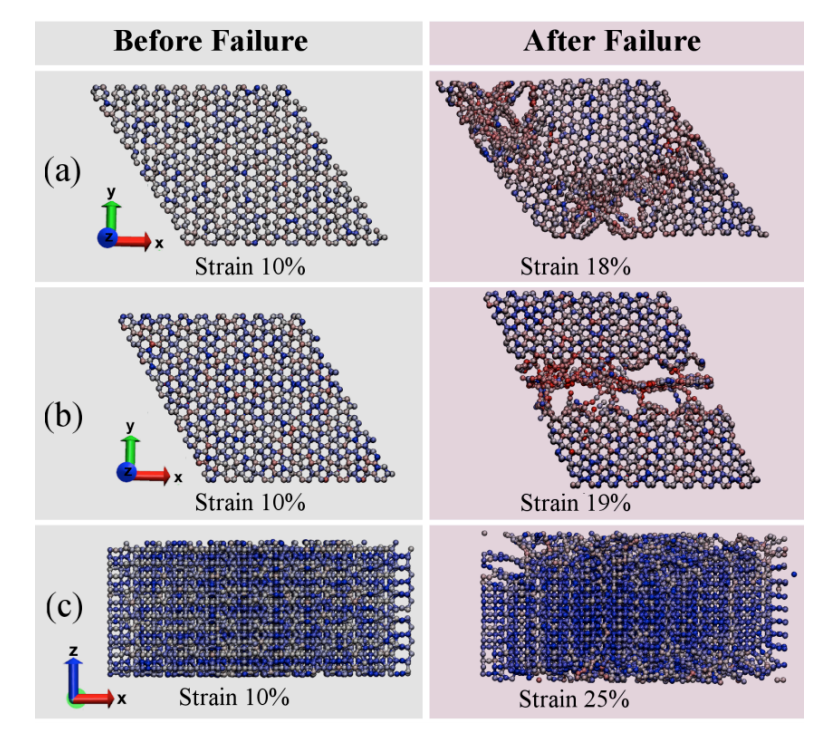
Pedro AS Autreto Eliezer F Oliveira, Cristiano F Woellner
Mechanical Properties of Protomene: A Molecular Dynamics Investigation Online
2018, (preprint arXiv:1810.09924v1 ).
Resumo | Links | BibTeX | Tags: Fracture, Mechanical Properties, Molecular Dynamics, protomene
@online{Oliveira2018g,
title = {Mechanical Properties of Protomene: A Molecular Dynamics Investigation},
author = {Eliezer F Oliveira, Pedro AS Autreto, Cristiano F Woellner, Douglas S Galvao},
url = {https://arxiv.org/abs/1810.09924},
year = {2018},
date = {2018-10-23},
abstract = {Recently, a new class of carbon allotrope called protomene was proposed. This new structure is
composed of sp2 and sp3 carbon-bonds. Topologically, protomene can be considered as an sp3
carbon structure (~80% of this bond type) doped by sp2 carbons. First-principles simulations
have shown that protomene presents an electronic bandgap of ~3.4 eV. However, up to now,
its mechanical properties have not been investigated. In this work, we have investigated
protomene mechanical behavior under tensile strain through fully atomistic reactive
molecular dynamics simulations using the ReaxFF force field, as available in the LAMMPS
code. At room temperature, our results show that the protomene is very stable and the
obtained ultimate strength and ultimate stress indicates an anisotropic behavior. The highest
ultimate strength was obtained for the x-direction, with a value of ~110 GPa. As for the ultimate
strain, the highest one was for the z-direction (~25% of strain) before protomene mechanical
fracture.},
note = {preprint arXiv:1810.09924v1 },
keywords = {Fracture, Mechanical Properties, Molecular Dynamics, protomene},
pubstate = {published},
tppubtype = {online}
}
composed of sp2 and sp3 carbon-bonds. Topologically, protomene can be considered as an sp3
carbon structure (~80% of this bond type) doped by sp2 carbons. First-principles simulations
have shown that protomene presents an electronic bandgap of ~3.4 eV. However, up to now,
its mechanical properties have not been investigated. In this work, we have investigated
protomene mechanical behavior under tensile strain through fully atomistic reactive
molecular dynamics simulations using the ReaxFF force field, as available in the LAMMPS
code. At room temperature, our results show that the protomene is very stable and the
obtained ultimate strength and ultimate stress indicates an anisotropic behavior. The highest
ultimate strength was obtained for the x-direction, with a value of ~110 GPa. As for the ultimate
strain, the highest one was for the z-direction (~25% of strain) before protomene mechanical
fracture.
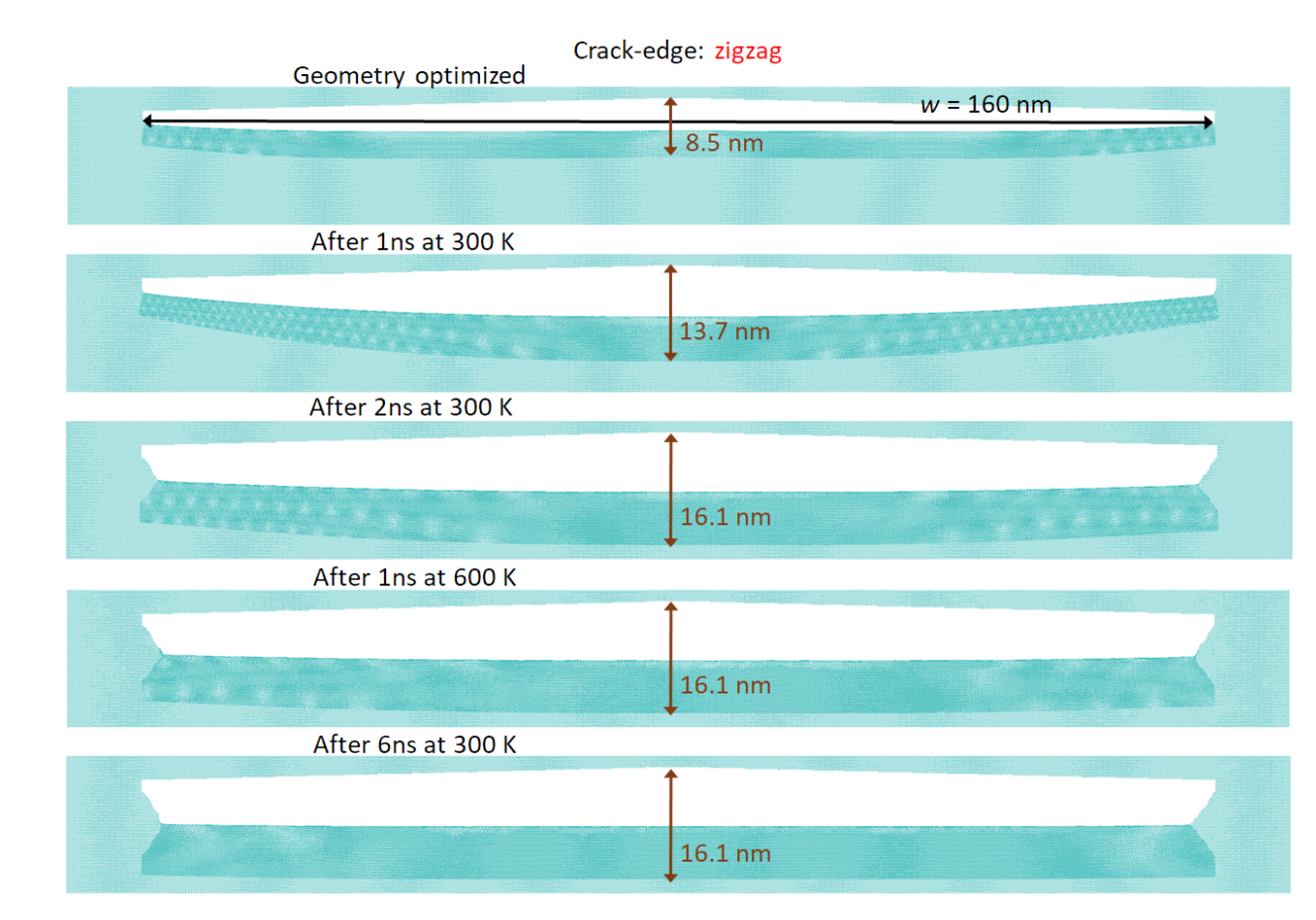
Alexandre F. Fonseca, Douglas S. Galvao
Self-tearing and self-peeling of folded graphene nanoribbons Online
2018, (preprint arXiv:1808.08872).
Resumo | Links | BibTeX | Tags: Fracture, graphene nanoribbons, Mechanical Properties, Molecular Dynamics
@online{Fonseca2018d,
title = { Self-tearing and self-peeling of folded graphene nanoribbons},
author = {Alexandre F. Fonseca, Douglas S. Galvao
},
url = {https://arxiv.org/abs/1808.08872},
year = {2018},
date = {2018-08-27},
abstract = {A recent experimental study showed that an induced folded flap of graphene can spontaneously drive itself its tearing and peeling off a substrate, thus producing long, micrometer sized, regular trapezoidal-shaped folded graphene nanoribbons. As long as the size of the graphene flaps is above a threshold value, the 'tug of war' between the forces of adhesion of graphene-graphene and graphene-substrate, flexural strain of folded region and carbon-carbon (C-C) covalent bonds favor the self-tearing and self-peeling off process. As the detailed information regarding the atomic scale mechanism involved in the process remains not fully understood, we carried out atomistic reactive molecular dynamics simulations to address some features of the process. We show that large thermal fluctuations can prevent the process by increasing the probability of chemical reactions between carbon dangling bonds of adjacent graphene layers. The effects of the strength of attraction between graphene and the substrate on the ribbon growth velocities at the early stages of the phenomenon were also investigated. Structures with initial armchair crack-edges were observed to form more uniform cuts than those having initial zigzag ones. Our results are of importance to help set up new experiments on this phenomenon, especially with samples with nanoscale sized cuts.},
note = {preprint arXiv:1808.08872},
keywords = {Fracture, graphene nanoribbons, Mechanical Properties, Molecular Dynamics},
pubstate = {published},
tppubtype = {online}
}
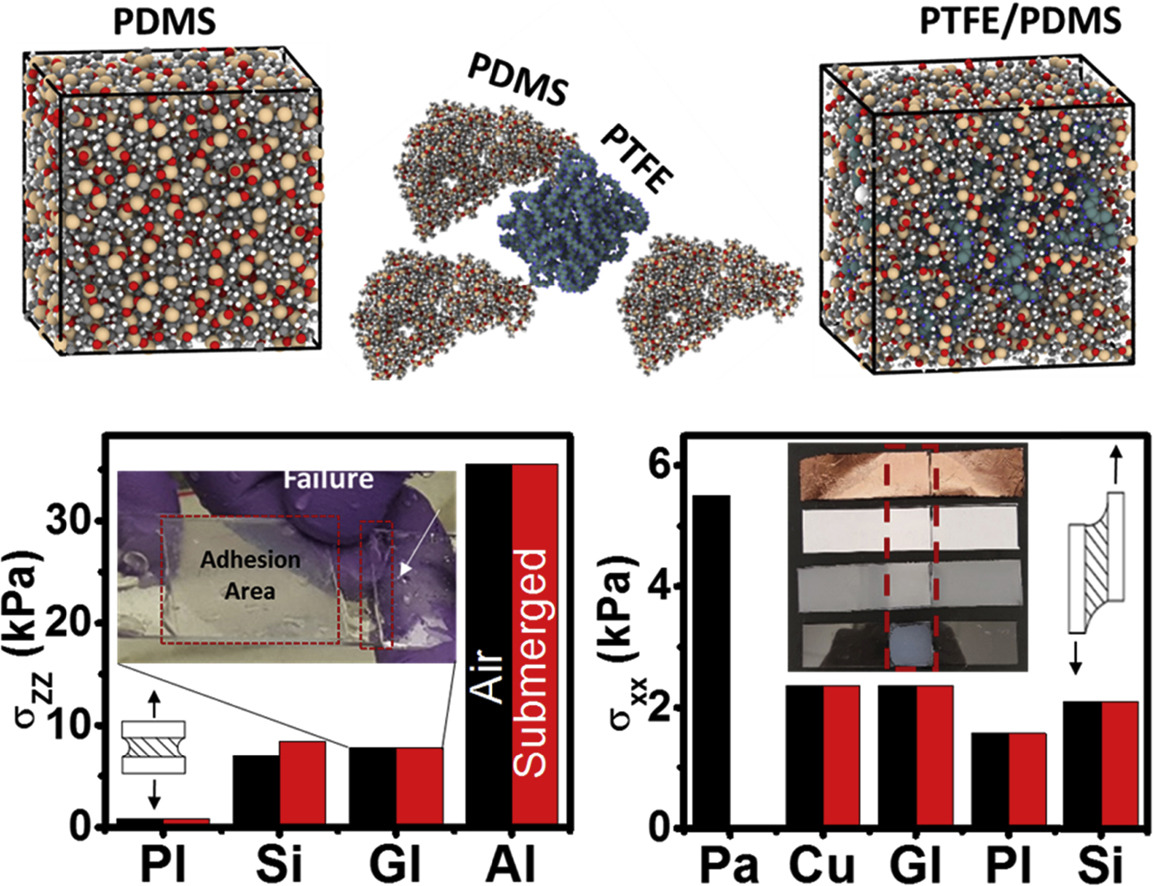
Chipara, A. C.; Tsafack, T.; Owuor, P. S.; Yeon, J.; Junkermeier, C. E.; van Duin, A. C. T.; Bhowmick, S.; Asif, S. A. S.; Radhakrishnan, S.; Park, J. H.; Brunetto, G.; Kaipparettu, B. A.; Galvão, D. S.; Chipara, M.; Lou, J.; Tsang, H. H.; Dubey, M.; Vajtai, R.; Tiwary, C. S.; Ajayan, P. M.
Underwater Adhesive using Solid–liquid Polymer Mixes Journal Article
Em: Materials Today Chemistry, vol. 9, pp. 149-157, 2018.
Resumo | Links | BibTeX | Tags: Adhesives, DFT, Molecular Dynamics, Polymer
@article{Chipara2018,
title = {Underwater Adhesive using Solid–liquid Polymer Mixes},
author = {A.C. Chipara and T. Tsafack and P.S. Owuor and J. Yeon and C.E. Junkermeier and A.C.T. van Duin and S. Bhowmick and S.A.S. Asif and S. Radhakrishnan and J.H. Park and G. Brunetto and B.A. Kaipparettu and D.S. Galvão and M. Chipara and J. Lou and H.H. Tsang and M. Dubey and R. Vajtai and C.S. Tiwary and P.M. Ajayan},
url = {https://www.sciencedirect.com/science/article/pii/S2468519418301423#appsec1},
doi = {10.1016/j.mtchem.2018.07.002},
year = {2018},
date = {2018-08-08},
journal = {Materials Today Chemistry},
volume = {9},
pages = {149-157},
abstract = {Instantaneous adhesion between different materials is a requirement for several applications ranging from electronics to biomedicine. Approaches such as surface patterning, chemical cross-linking, surface modification, and chemical synthesis have been adopted to generate temporary adhesion between various materials and surfaces. Because of the lack of curing times, temporary adhesives are instantaneous, a useful property for specific applications that need quick bonding. However, to this day, temporary adhesives have been mainly demonstrated under dry conditions and do not work well in submerged or humid environments. Furthermore, most rely on chemical bonds resulting from strong interactions with the substrate such as acrylate based. This work demonstrates the synthesis of a universal amphibious adhesive solely by combining solid polytetrafluoroethylene (PTFE) and liquid polydimethylsiloxane (PDMS) polymers. While the dipole-dipole interactions are induced by a large electronegativity difference between fluorine atoms in PTFE and hydrogen atoms in PDMS, strong surface wetting allows the proposed adhesive to fully coat both substrates and PTFE particles, thereby maximizing the interfacial chemistry. The two-phase solid–liquid polymer system displays adhesive characteristics applicable both in air and water, and enables joining of a wide range of similar and dissimilar materials (glasses, metals, ceramics, papers, and biomaterials). The adhesive exhibits excellent mechanical properties for the joints between various surfaces as observed in lap shear testing, T-peel testing, and tensile testing. The proposed biocompatible adhesive can also be reused multiple times in different dry and wet environments. Additionally, we have developed a new reactive force field parameterization and used it in our molecular dynamics simulations to validate the adhesive nature of the mixed polymer system with different surfaces. This simple amphibious adhesive could meet the need for a universal glue that performs well with a number of materials for a wide range of conditions.},
keywords = {Adhesives, DFT, Molecular Dynamics, Polymer},
pubstate = {published},
tppubtype = {article}
}
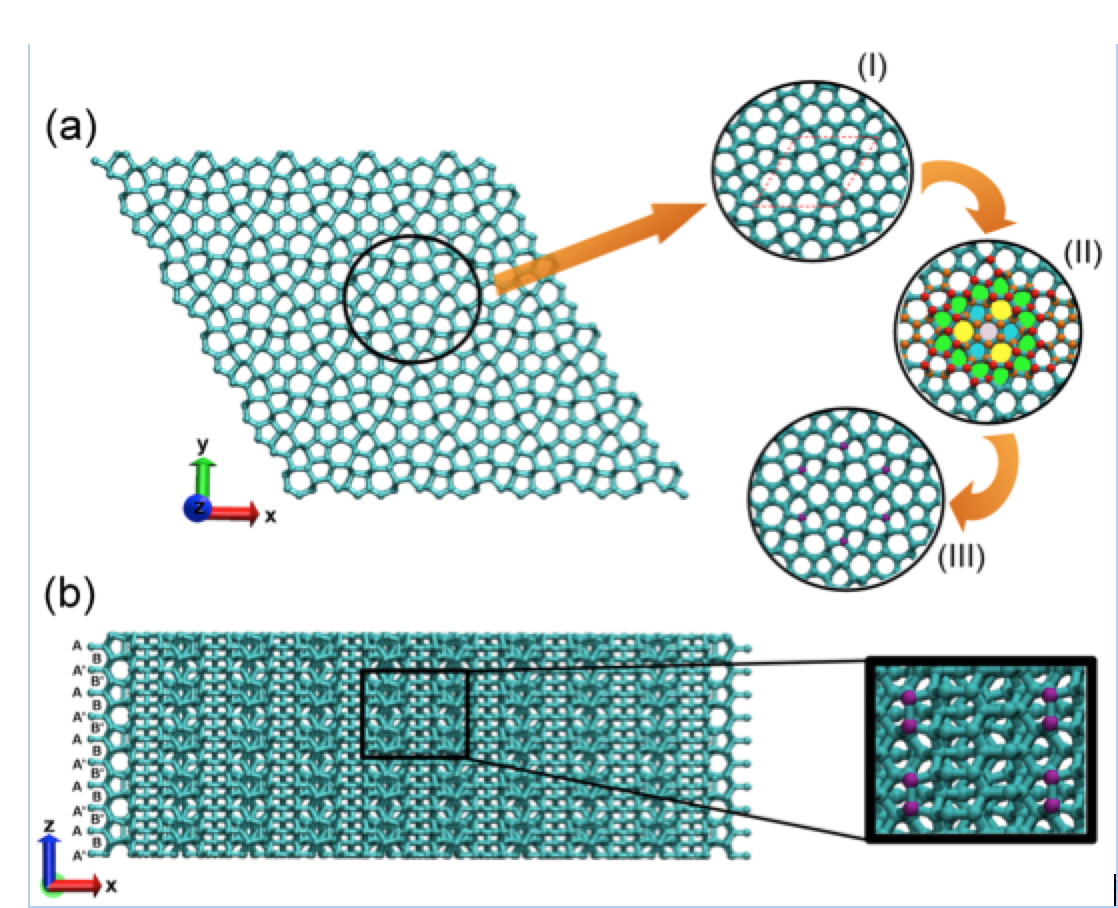
Oliveira, Eliezer F.; Autreto, Pedro A. S.; Woellner, Cristiano F.; Galvao, Douglas S.
On the mechanical properties of novamene: a fully atomistic molecular dynamics and DFT investigation Journal Article
Em: Carbon, vol. 139, pp. 782-788, 2018.
Resumo | Links | BibTeX | Tags: carbon allotropes, DFT, Molecular Dynamics, novamenes
@article{Oliveira2018e,
title = {On the mechanical properties of novamene: a fully atomistic molecular dynamics and DFT investigation},
author = {Eliezer F. Oliveira and Pedro A. S. Autreto and Cristiano F. Woellner and Douglas S. Galvao},
url = {https://www.sciencedirect.com/science/article/pii/S0008622318306882?via%3Dihub#appsec1},
doi = {10.1016/j.carbon.2018.07.038},
year = {2018},
date = {2018-07-19},
journal = {Carbon},
volume = {139},
pages = {782-788},
abstract = {We have investigated through fully atomistic reactive molecular dynamics and density functional theory simulations, the mechanical properties and fracture dynamics of single-ringed novamene (1R-novamene), a new 3D carbon allotrope structure recently proposed. Our results showed that 1R-novamene is an anisotropic structure with relation to tensile deformation. Although 1R-novamente shares some mechanical features with other carbon allotropes, it also exhibits distinct ones, such as, extensive structural reconstructions. 1R-novamene presents ultimate strength (∼100 GPa) values lower than other carbon allotropes, but it has the highest ultimate strain along the z-direction (∼22.5%). Although the Young's modulus (∼600 GPa) and ultimate strength values are smaller than for other carbon allotropes, they still outperform other materials, such as for example silicon, steel or titanium alloys. With relation to the fracture dynamics, 1R-novamene is again anisotropic with the fracture/crack propagation originating from deformed heptagons and pentagons for x and y directions and broken sp3 bonds connecting structural planes. Another interesting feature is the formation of multiple and long carbon linear chains in the final fracture stages.},
keywords = {carbon allotropes, DFT, Molecular Dynamics, novamenes},
pubstate = {published},
tppubtype = {article}
}
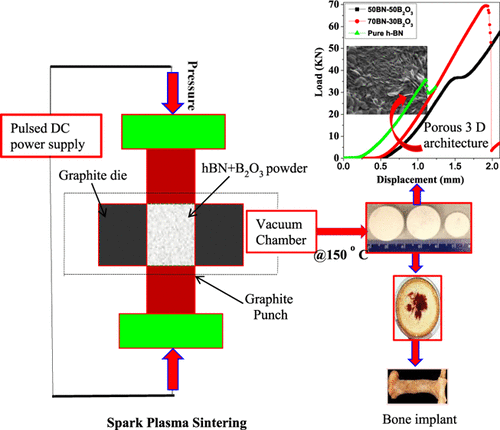
Gautam, Chandkiram; Chakravarty, Dibyendu; Woellner, Cristiano F.; Mishra, Vijay Kumar; Ahamad, Naseer; Gautam, Amarendra; Ozden, Sehmus; Jose, Sujin; Biradar, Santosh Kumar; Vajtai, Robert; Trivedi, Ritu; Tiwary, Chandra Sekhar; Galvao, Douglas S.; Ajayan, P. M.
Synthesis and 3D Interconnected Nanostructured h-BN-Based Biocomposites by Low-Temperature Plasma Sintering: Bone Regeneration Applications Journal Article
Em: ACS Omega, vol. 3, não 6, pp. 6013–6021, 2018.
Resumo | Links | BibTeX | Tags: BN, Composites, Molecular Dynamics, sintering
@article{Gautam2018,
title = {Synthesis and 3D Interconnected Nanostructured h-BN-Based Biocomposites by Low-Temperature Plasma Sintering: Bone Regeneration Applications},
author = {Chandkiram Gautam and Dibyendu Chakravarty and Cristiano F. Woellner and Vijay Kumar Mishra and Naseer Ahamad and Amarendra Gautam and Sehmus Ozden and Sujin Jose and Santosh Kumar Biradar and Robert Vajtai and Ritu Trivedi and Chandra Sekhar Tiwary and Douglas S. Galvao and P.M. Ajayan},
url = {https://pubs.acs.org/doi/abs/10.1021/acsomega.8b00707},
doi = {10.1021/acsomega.8b00707},
year = {2018},
date = {2018-06-05},
journal = {ACS Omega},
volume = {3},
number = {6},
pages = {6013–6021},
abstract = {Recent advances and demands in biomedical applications drive a large amount of research to synthesize easily scalable low-density, high-strength, and wear-resistant biomaterials. The chemical inertness with low density combined with high strength makes h-BN one of the promising materials for such application. In this work, three-dimensional hexagonal boron nitride (h-BN) interconnected with boron trioxide (B2O3) was prepared by easily scalable and energy efficient spark plasma sintering (SPS) process. The composite structure shows significant densification (1.6–1.9 g/cm3) and high surface area (0.97–14.5 m2/g) at an extremely low SPS temperature of 250 °C. A high compressive strength of 291 MPa with a reasonably good wear resistance was obtained for the composite structure. The formation of strong covalent bonds between h-BN and B2O3 was formulated and established by molecular dynamics simulation. The composite showed significant effect on cell viability/proliferation. It shows a high mineralized nodule formation over the control, which suggests its use as a possible osteogenic agent in bone formation.},
keywords = {BN, Composites, Molecular Dynamics, sintering},
pubstate = {published},
tppubtype = {article}
}
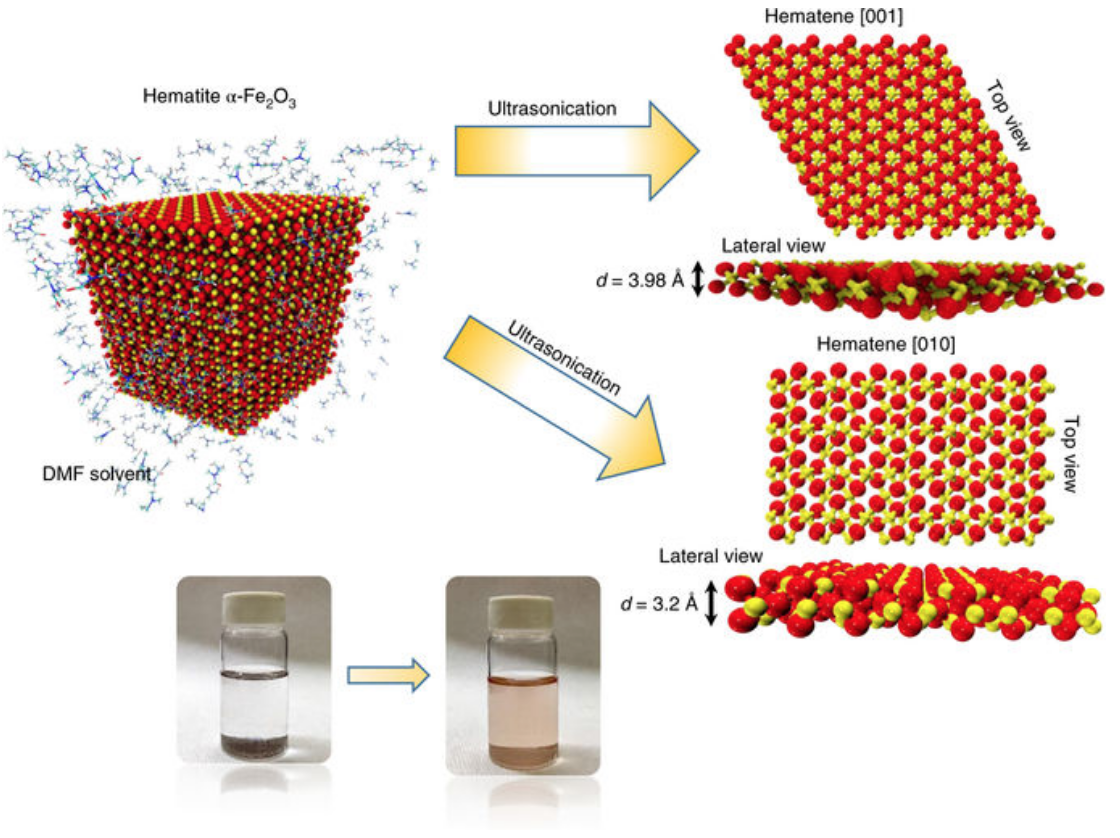
Balan, Aravind Puthirath; Radhakrishnan, Sruthi; Woellner, Cristiano F.; Sinha, Shyam K.; Deng, Liangzi; de los Reyes, Carlos; Rao, Manmadha; Paulose, Maggie; Neupane, Ram; Vajtai, Robert; Chu, Ching-Wu; Costin, Gelu; Galvao, Douglas S.; Marti, Angel A.; van Aken, Peter; Varghese, Oomman K; Tiwary, Chandra Sekhar; Anantharaman, M R; Ajayan, Pulickel M
Exfoliation of a non-van der Waals material from iron ore hematite Journal Article
Em: Nature Nanotechnology, vol. 13, pp. 602–610, 2018.
Resumo | Links | BibTeX | Tags: DFT, Hematene, Molecular Dynamics, van der Waals solids
@article{Balan2018,
title = {Exfoliation of a non-van der Waals material from iron ore hematite},
author = {Aravind Puthirath Balan and Sruthi Radhakrishnan and Cristiano F. Woellner and Shyam K. Sinha and Liangzi Deng and Carlos de los Reyes and Manmadha Rao and Maggie Paulose and Ram Neupane and Robert Vajtai and Ching-Wu Chu and Gelu Costin and Douglas S. Galvao and Angel A. Marti and Peter van Aken and Oomman K Varghese and Chandra Sekhar Tiwary and M R Anantharaman and Pulickel M Ajayan
},
url = {https://www.nature.com/articles/s41565-018-0134-y},
year = {2018},
date = {2018-05-07},
journal = {Nature Nanotechnology},
volume = {13},
pages = {602--610},
abstract = {With the advent of graphene, the most studied of all two-dimensional materials, many inorganic analogues have been synthesized and are being exploited for novel applications. Several approaches have been used to obtain large-grain, high-quality materials. Naturally occurring ores, for example, are the best precursors for obtaining highly ordered and large-grain atomic layers by exfoliation. Here, we demonstrate a new two-dimensional material ‘hematene’ obtained from natural iron ore hematite (α-Fe2O3), which is isolated by means of liquid exfoliation. The two-dimensional morphology of hematene is confirmed by transmission electron microscopy. Magnetic measurements together with density functional theory calculations confirm the ferromagnetic order in hematene while its parent form exhibits antiferromagnetic order. When loaded on titania nanotube arrays, hematene exhibits enhanced visible light photocatalytic activity. Our study indicates that photogenerated electrons can be transferred from hematene to titania despite a band alignment unfavourable for charge transfer.},
keywords = {DFT, Hematene, Molecular Dynamics, van der Waals solids},
pubstate = {published},
tppubtype = {article}
}
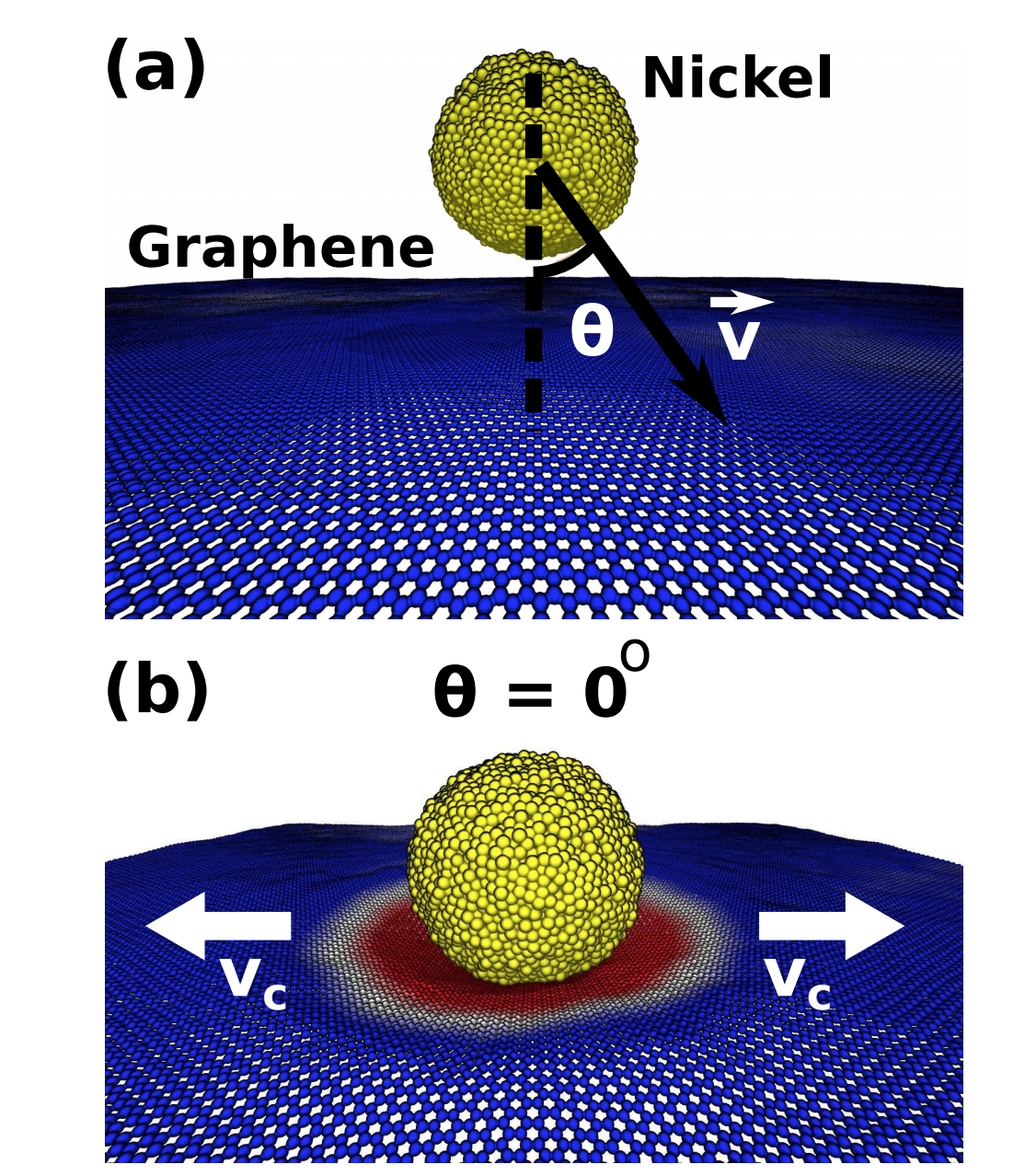
Bizao, Rafael A; Machado, Leonardo D; de Sousa, Jose M; Pugno, Nicola M; Galvao, Douglas S
Scale Effects on the Ballistic Penetration of Graphene Sheets Journal Article
Em: Nature Scientific Reports, vol. 8, pp. 6750, 2018.
Resumo | Links | BibTeX | Tags: Fracture, Graphene, impact, Molecular Dynamics
@article{Bizao2018,
title = {Scale Effects on the Ballistic Penetration of Graphene Sheets},
author = {Bizao, Rafael A and Machado, Leonardo D and de Sousa, Jose M and Pugno, Nicola M and Galvao, Douglas S},
url = {https://www.nature.com/articles/s41598-018-25050-2},
doi = {doi:10.1038/s41598-018-25050-2},
year = {2018},
date = {2018-04-30},
journal = {Nature Scientific Reports},
volume = {8},
pages = {6750},
abstract = {Carbon nanostructures are promising ballistic protection materials, due to their low density and excellent mechanical properties. Recent experimental and computational investigations on the behavior of graphene under impact conditions revealed exceptional energy absorption properties as well. However, the reported numerical and experimental values differ by an order of magnitude. In this work, we combined numerical and analytical modeling to address this issue. In the numerical part, we employed reactive molecular dynamics to carry out ballistic tests on single, double, and triple-layered graphene sheets. We used velocity values within the range tested in experiments. Our numerical and the experimental results were used to determine parameters for a scaling law. We find that the specific penetration energy decreases as the number of layers (N) increases, from ∼15 MJ/kg for N = 1 to ∼0.9 MJ/kg for N = 350, for an impact velocity of 900 m/s. These values are in good agreement with simulations and experiments, within the entire range of N values for which data is presently available. Scale effects explain the apparent discrepancy between simulations and experiments.},
keywords = {Fracture, Graphene, impact, Molecular Dynamics},
pubstate = {published},
tppubtype = {article}
}
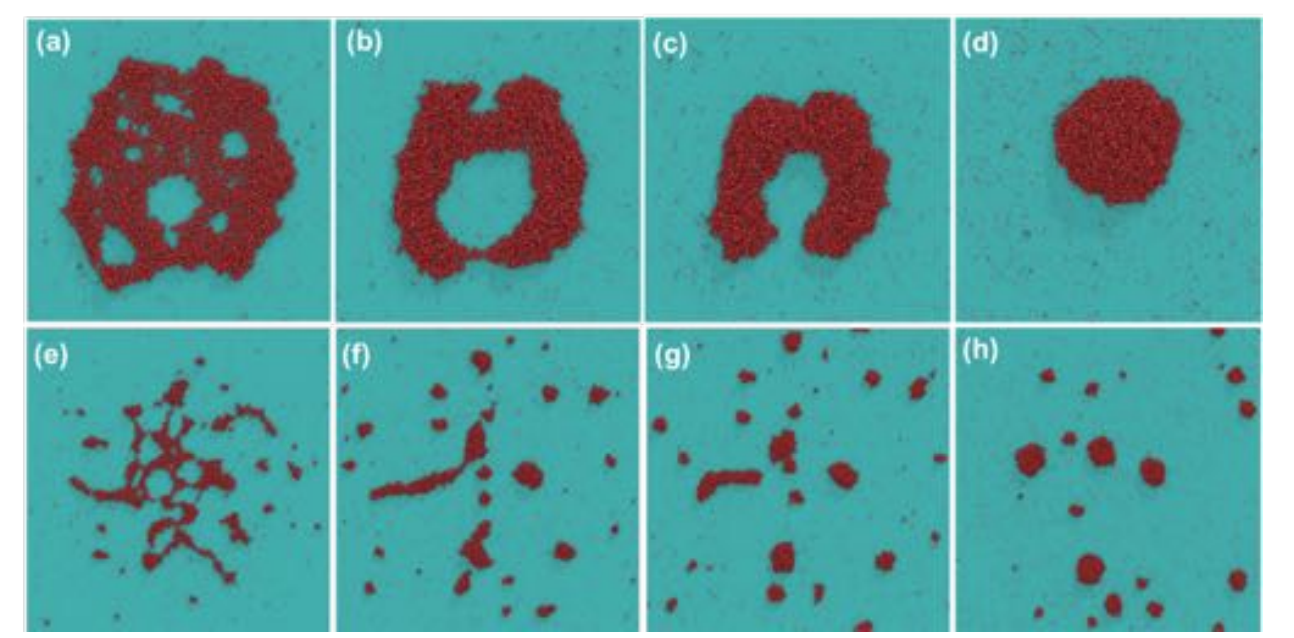
Ygor M.; Galvao Jaques, Douglas S.
Structural Properties of Nanodroplets Impacting Graphene at High Velocities Online
2018, (Preprint ArXiv:1804.07784).
Resumo | Links | BibTeX | Tags: droplets, Graphene, Impact Molecular Dynamics, water
@online{Jaques2018d,
title = {Structural Properties of Nanodroplets Impacting Graphene at High Velocities},
author = {Jaques, Ygor M.; Galvao, Douglas S.},
url = {https://arxiv.org/abs/1804.07784},
year = {2018},
date = {2018-04-24},
abstract = {We report here a fully atomistic molecular dynamics study on the dynamics of impact of water
nanodroplets (50, 100 and 120 Å of diameter) at high velocity (from 100 up to 1000 m/s) against
graphene targets. Our results show that tuning graphene wettability (through parameter changes)
significantly affects the structural and dynamical aspects of the nanodroplets. We identified three
ranges of velocities with distinct characteristics, from simple deposition of the droplet to
spreading with rebound and finally fragmentation. At Weber numbers lower than 10, the droplets
maintain a steady spreading factor independent of size. After this threshold value, the spread
rapidly grows with increasing Weber numbers. A more hydrophilic graphene surface increases
the spreading values, due to stronger solid-liquid interactions. Nevertheless, droplet size also
influences the fragmentation threshold, as an increased number of molecules make it easier for
the whole droplet overcomes the surface repulsion. },
note = {Preprint ArXiv:1804.07784},
keywords = {droplets, Graphene, Impact Molecular Dynamics, water},
pubstate = {published},
tppubtype = {online}
}
nanodroplets (50, 100 and 120 Å of diameter) at high velocity (from 100 up to 1000 m/s) against
graphene targets. Our results show that tuning graphene wettability (through parameter changes)
significantly affects the structural and dynamical aspects of the nanodroplets. We identified three
ranges of velocities with distinct characteristics, from simple deposition of the droplet to
spreading with rebound and finally fragmentation. At Weber numbers lower than 10, the droplets
maintain a steady spreading factor independent of size. After this threshold value, the spread
rapidly grows with increasing Weber numbers. A more hydrophilic graphene surface increases
the spreading values, due to stronger solid-liquid interactions. Nevertheless, droplet size also
influences the fragmentation threshold, as an increased number of molecules make it easier for
the whole droplet overcomes the surface repulsion.
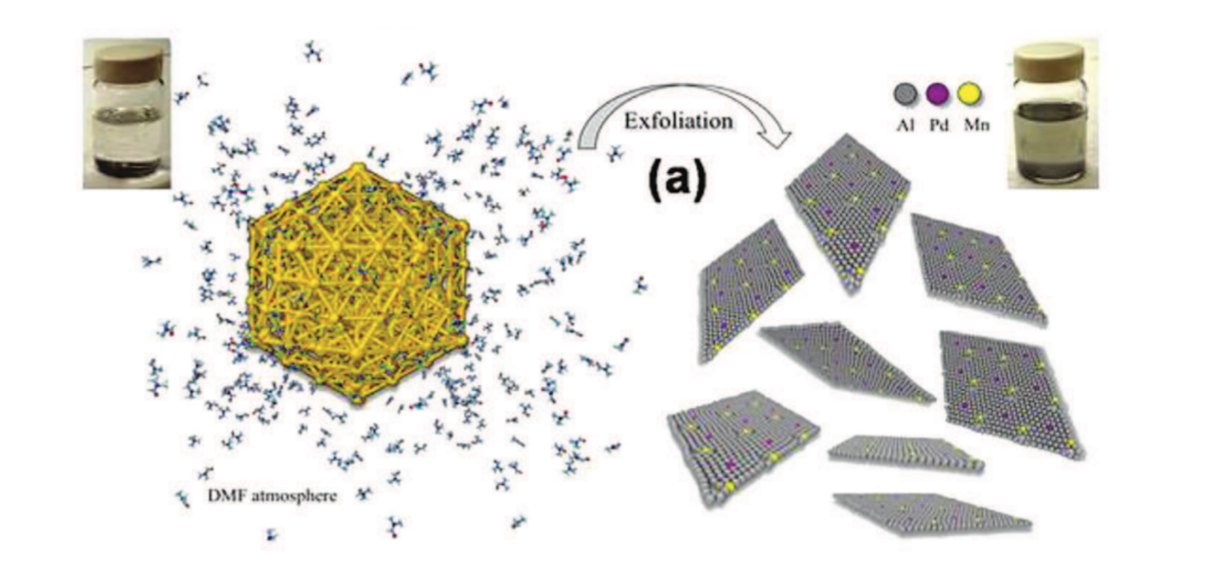
Thakur P.; Woellner Yadav, Cristiano F. ; Sinha
Liquid Exfoliation of Icosahedral Quasicrystals Journal Article
Em: Advanced Functional Materials, vol. 2018, pp. 1801181, 2018.
Resumo | Links | BibTeX | Tags: catalysis, Modeling, quasi-crystals
@article{Yadav2018b,
title = {Liquid Exfoliation of Icosahedral Quasicrystals},
author = {Yadav, Thakur P.; Woellner, Cristiano F.; Sinha, Shyam K.; Sharifi, Tiva; Apte, Amey; Mukhopadhyay, Nilay K.; Srivastava, Onkar N.; Vajtai, Robert; Galvao, Douglas S.; Tiwary, Chandra S.; Ajayan, Pulickel M.},
url = {https://onlinelibrary.wiley.com/doi/abs/10.1002/adfm.201801181?campaign=wolearlyview},
doi = {DOI: 10.1002/adfm.201801181},
year = {2018},
date = {2018-04-24},
journal = {Advanced Functional Materials},
volume = {2018},
pages = {1801181},
abstract = {The realization of quasicrystals has attracted a considerable attention due to their unusual structures and properties. The concept of quasicrystals in the atomically thin materials is even more appealing due to the in-plane cova-lent bonds and weak interlayer interactions. Here, it is demonstrated that 2D quasicrystals can be created/isolated from bulk phases because of long-range interlayer ordered aperiodic arrangements. An ultrasonication-assisted exfolia-tion of polygrained icosahedral Al–Pd–Mn quasicrystals at room temperature shows the formation of a large area of mono- and few layers in threefold qua-sicrystalline plane. The formation of these layers from random grain orientation consistently indicates that the threefold plane is most stable in comparison to the twofold and fivefold planes in icosahedral clusters. The above experimental observations are further supported with help of theoretical simulations. The mono- and few-layered aperiodic planes render plentiful active sites for the catalysis of hydrogen evolution reaction. The threefold 2D quasicrystalline plane exhibits a hydrogen evolution reaction overpotential of ≈100 mV (160 times less than bulk counterpart) and long-term durability. These systems constitute the first demonstration of quasicrystalline monolayer ordering in a free-standing thin layer without requiring the support of periodic or aperiodic substrate.},
keywords = {catalysis, Modeling, quasi-crystals},
pubstate = {published},
tppubtype = {article}
}
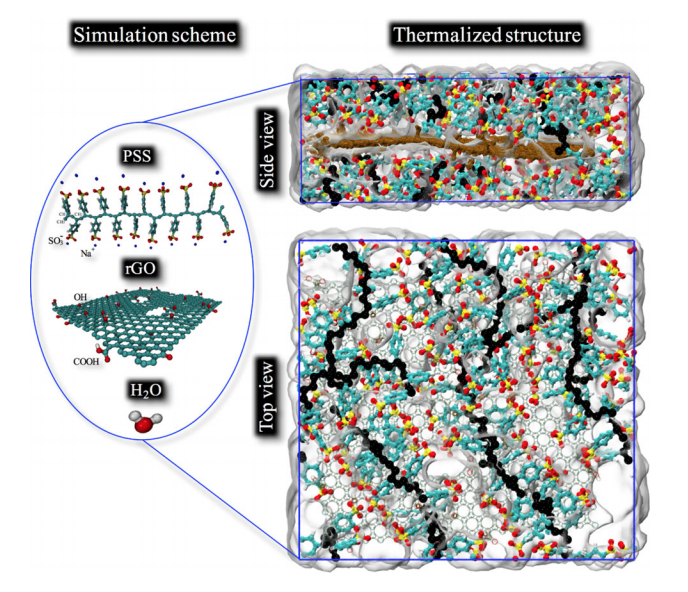
Marco AE Maria Celina M Miyazaki, Daiane Damasceno Borges
Experimental and computational investigation of reduced graphene oxide nanoplatelets stabilized in poly(styrene sulfonate) sodium salt Journal Article
Em: Journal of Materials Science, vol. 53, não 14, pp. 10049-10056, 2018.
Resumo | Links | BibTeX | Tags: Molecular Dynamics, Polymers
@article{Miyazaki2018,
title = {Experimental and computational investigation of reduced graphene oxide nanoplatelets stabilized in poly(styrene sulfonate) sodium salt},
author = {Celina M Miyazaki, Marco AE Maria, Daiane Damasceno Borges, Cristiano F Woellner, Gustavo Brunetto, Alexandre F Fonseca, Carlos JL Constantino, Marcelo A Pereira-da-Silva, Abner de Siervo, Douglas S Galvao, Antonio Riul Jr},
url = {https://link.springer.com/article/10.1007/s10853-018-2325-1},
doi = {https://link.springer.com/article/10.1007/s10853-018-2325-1},
year = {2018},
date = {2018-04-19},
journal = {Journal of Materials Science},
volume = {53},
number = {14},
pages = {10049-10056},
abstract = {The production of large-area interfaces and the use of scalable methods to build up
designed nanostructures generating advanced functional properties are of high
interest for many materials science applications. Nevertheless, large-area coverage
remains a major problem even for pristine graphene, and here we present a hybrid,
composite graphene-like material soluble in water that can be exploited in many
areas such as energy storage, electrodes fabrication, selective membranes and
biosensing. Graphene oxide (GO) was produced by the traditional Hummers’
method being further reduced in the presence of poly(styrene sulfonate) sodium salt
(PSS), thus creating stable reduced graphene oxide (rGO) nanoplatelets wrapped by
PSS (GPSS). Molecular dynamics simulations were carried out to further clarify the
interactions between PSS molecules and rGO nanoplatelets, with calculations
supported by Fourier transform infrared spectroscopy analysis. The intermolecular
forces between rGO nanoplatelets and PSS lead to the formation of a hybrid material
(GPSS) stabilized by van der Waals forces, allowing the fabrication of high-quality
layer-by-layer (LbL) films with poly(allylamine hydrochloride) (PAH). Raman and
electrical characterizations corroborated the successful modifications in the electronic
structures from GO to GPSS after the chemical treatment, resulting in (PAH/
GPSS) LbL films four orders of magnitude more conductive than (PAH/GO).},
keywords = {Molecular Dynamics, Polymers},
pubstate = {published},
tppubtype = {article}
}
designed nanostructures generating advanced functional properties are of high
interest for many materials science applications. Nevertheless, large-area coverage
remains a major problem even for pristine graphene, and here we present a hybrid,
composite graphene-like material soluble in water that can be exploited in many
areas such as energy storage, electrodes fabrication, selective membranes and
biosensing. Graphene oxide (GO) was produced by the traditional Hummers’
method being further reduced in the presence of poly(styrene sulfonate) sodium salt
(PSS), thus creating stable reduced graphene oxide (rGO) nanoplatelets wrapped by
PSS (GPSS). Molecular dynamics simulations were carried out to further clarify the
interactions between PSS molecules and rGO nanoplatelets, with calculations
supported by Fourier transform infrared spectroscopy analysis. The intermolecular
forces between rGO nanoplatelets and PSS lead to the formation of a hybrid material
(GPSS) stabilized by van der Waals forces, allowing the fabrication of high-quality
layer-by-layer (LbL) films with poly(allylamine hydrochloride) (PAH). Raman and
electrical characterizations corroborated the successful modifications in the electronic
structures from GO to GPSS after the chemical treatment, resulting in (PAH/
GPSS) LbL films four orders of magnitude more conductive than (PAH/GO).
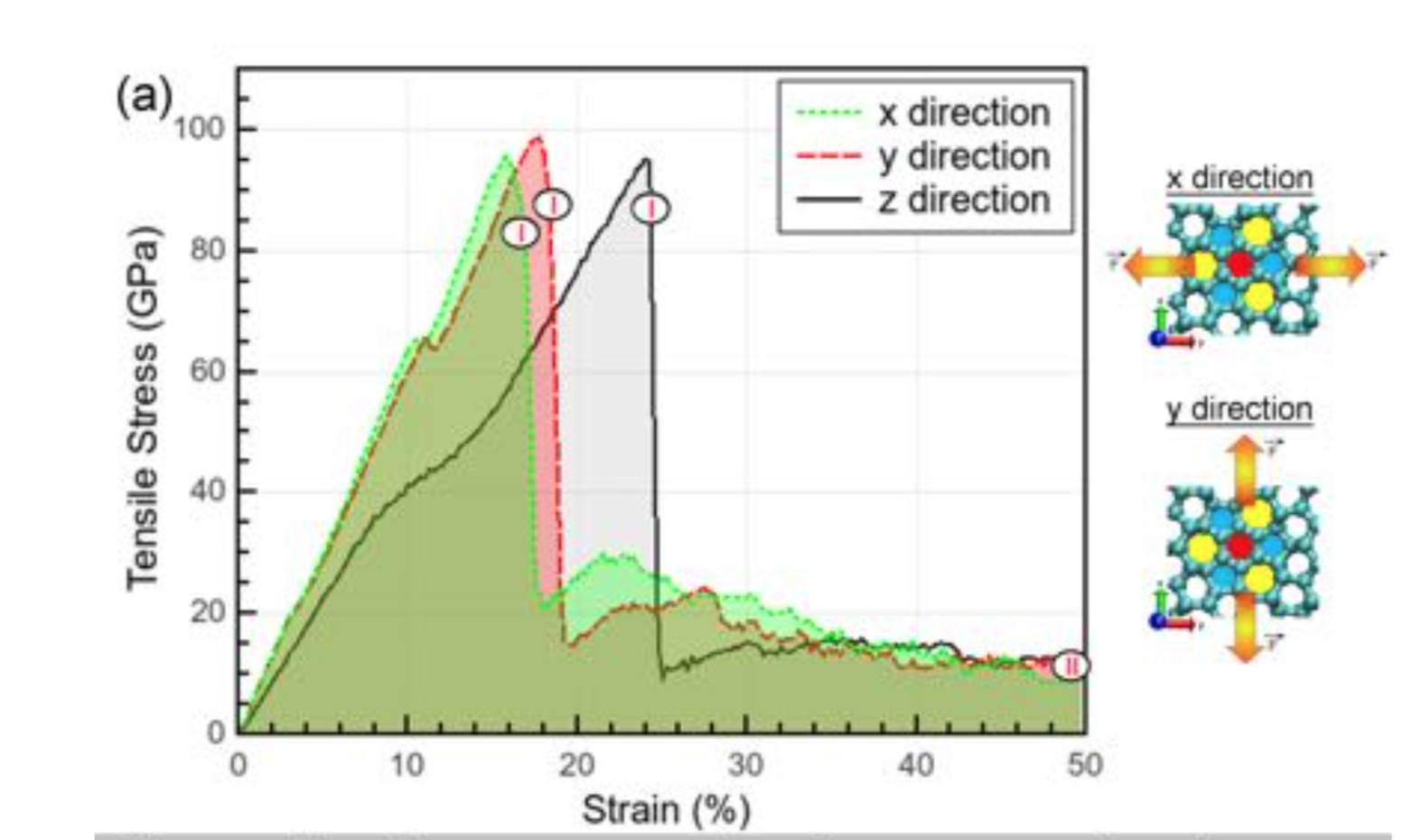
Eliezer F.; Autreto Oliveira, Pedro A. S. ; Woellner
On the mechanical properties of novamene: a fully atomistic molecular dynamics and DFT investigation Online
2018, (preprint ArXiv:1804.07215).
Resumo | Links | BibTeX | Tags: carbon allotropes, DFT, Molecular Dynamics, novamenes
@online{Oliveira2018f,
title = {On the mechanical properties of novamene: a fully atomistic molecular dynamics and DFT investigation},
author = {Oliveira, Eliezer F.; Autreto, Pedro A. S.; Woellner, Cristiano F.; Galvao, Douglas S.},
url = {https://arxiv.org/abs/1804.07215},
year = {2018},
date = {2018-04-19},
abstract = {We have investigated through fully atomistic reactive molecular dynamics and DFT simulations, the mechanical properties and fracture dynamics of novamene, a new 3D carbon allotrope structure recently proposed. Our results showed that novamene is an anisotropic structure with relation to tensile deformation. Although novamente shares some mechanical features with other carbon allotropes, it also exhibits distinct ones, such as, extensive structural reconstructions (self-healing effect). Novamene presents ultimate strength (~ 100 GPa) values lower than other carbon allotropes, but it has the highest ultimate strain along the z-direction (~ 22.5%). Although the Young's modulus (~ 600 GPa) and ultimate strength values are smaller than for other carbon allotropes, they still outperform other materials, such as for example silicon, steel or titanium alloys. With relation to the fracture dynamics, novamene is again anisotropic with the fracture/crack propagation originating from deformed heptagons and pentagons for x and y directions and broken sp3 bonds connecting structural planes. Another interesting feature is the formation of multiple and long carbon linear chains in the final fracture stages.},
note = {preprint ArXiv:1804.07215},
keywords = {carbon allotropes, DFT, Molecular Dynamics, novamenes},
pubstate = {published},
tppubtype = {online}
}
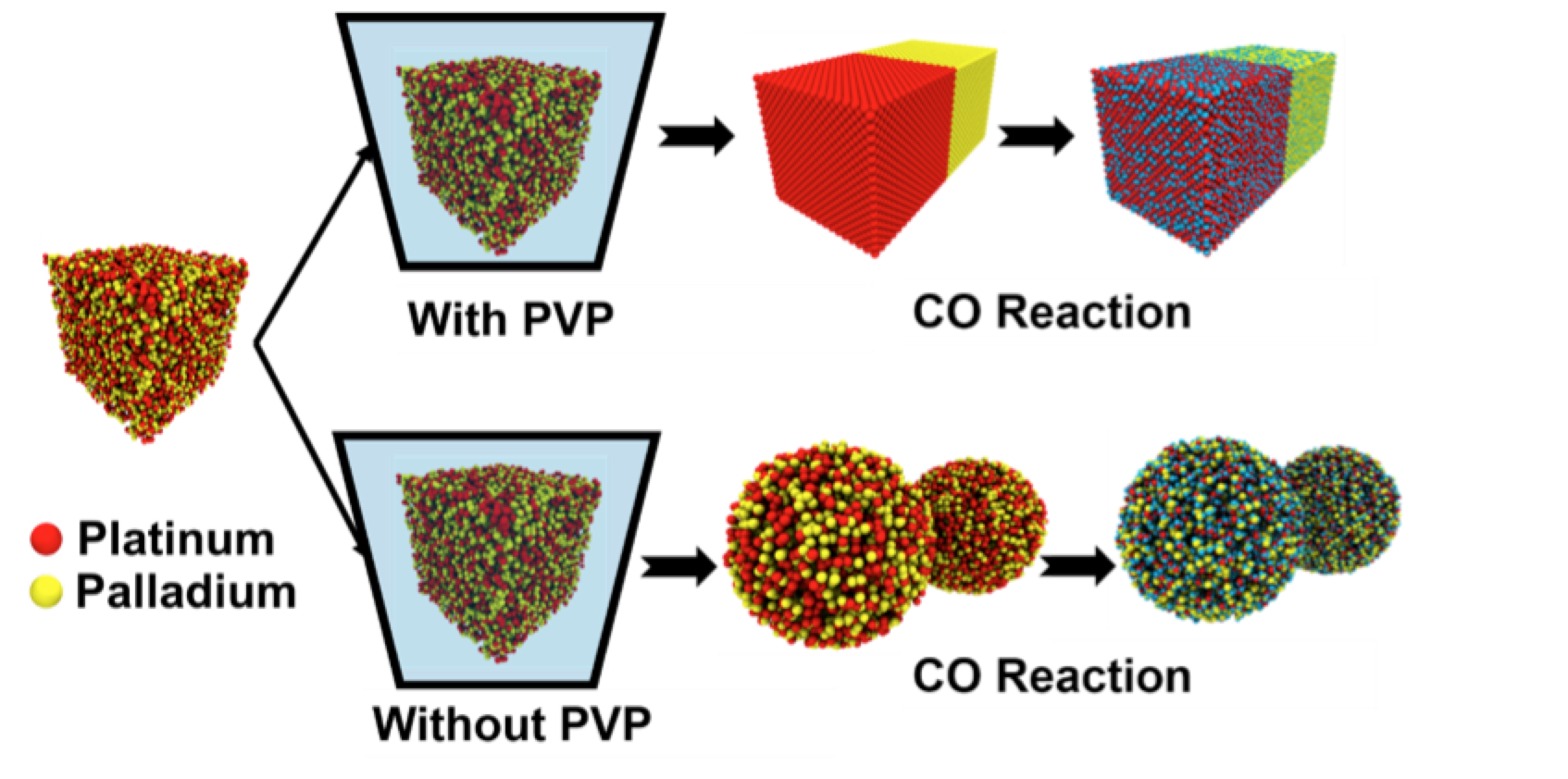
Devi, M. Manolata; Dolai, N.; S, S. Sreehala; Jaques, Y. M.; Galvao, Douglas S.; C.S.Tiwary,; Sharma, Sudhanshu; Biswas, Krishanu
Morphology Controlled Graphene-Alloy Nanoparticles Hybrids with Tunable Catalytic Activity Journal Article
Em: Nanoscale, vol. 10, pp. 8840-8850, 2018.
Resumo | Links | BibTeX | Tags: alloys, Graphene, Modeling, Nanoparticles
@article{Devi2018b,
title = {Morphology Controlled Graphene-Alloy Nanoparticles Hybrids with Tunable Catalytic Activity},
author = {M. Manolata Devi and N. Dolai and S. Sreehala S and Y. M. Jaques and Douglas S. Galvao and C.S.Tiwary and Sudhanshu Sharma and Krishanu Biswas},
url = {pubs.rsc.org/en/content/articlehtml/2018/nr/c7nr09688g},
doi = {10.1039/C7NR09688G},
year = {2018},
date = {2018-04-07},
journal = {Nanoscale},
volume = {10},
pages = {8840-8850},
abstract = {Selective oxidation of CO to CO2 using metallic or alloy nanoparticles as catalysts can solve two major problems of energy requirements and environmental pollution. Achieving 100% conversion efficiency at a lower temperature is a very important goal. This requires sustained efforts to design and develop novel supported catalysts containing alloy nanoparticles. In this regard, the decoration of nanoalloys with graphene, as a support for the catalyst, can provide a novel structure due to the synergic effect of the nanoalloys and graphene. Here, we demonstrate the effect of nano-PdPt (Palladium–Platinum) alloys having different morphologies on the catalytic efficiency for the selective oxidation of CO. Efforts were made to prepare different morphologies of PdPt alloy nanoparticles with the advantage of tuning the capping agent (PVP – polyvinyl pyrollidone) and decorating them on graphene sheets via the wet-chemical route. The catalytic activity of the G-PdPt hybrids with an urchin-like morphology has been found to be superior (higher % conversion at 135 °C lower) to that with a nanoflower morphology. The above experimental observations are further supported by molecular dynamics (MD) simulations.},
keywords = {alloys, Graphene, Modeling, Nanoparticles},
pubstate = {published},
tppubtype = {article}
}

Sandhya; Manimunda Susarla, Praveena; Morais Jaques
Deformation Mechanisms of Vertically Stacked WS2 /MoS2 Heterostructures: The Role of Interfaces Journal Article
Em: ACS Nano, vol. 12, não 4, pp. 4036−4044, 2018.
Resumo | Links | BibTeX | Tags: Chalcogenides, Modeling
@article{Susarla2018,
title = {Deformation Mechanisms of Vertically Stacked WS2 /MoS2 Heterostructures: The Role of Interfaces},
author = {Susarla, Sandhya; Manimunda, Praveena; Morais Jaques, Ygor; Hachtel, Jordan; Idrobo, Juan Carlos; Syed Amanulla, Syed Asif; Galvao, Douglas; Tiwary, Chandra; Ajayan, Pulickel},
url = {https://pubs.acs.org/doi/10.1021/acsnano.8b01786},
doi = {DOI: 10.1021/acsnano.8b01786},
year = {2018},
date = {2018-04-05},
journal = {ACS Nano},
volume = {12},
number = {4},
pages = {4036−4044},
abstract = {The mechanical and optical properties generated due to the stacking of different atomically thin materials
have made it possible to tune and engineer these materials for next-generation electronics. The understanding of the
interlayer interactions in such stacked structures is of fundamental interest for structure and property correlation. Here, a
combined approach of in situ Raman spectroscopy and mechanical straining along with molecular dynamics (MD)
simulations has been used to probe one such interface, namely, the WS2/MoS2 heterostructure. Vertical heterostructures on
poly(methyl methacrylate), when flexed, showed signs of decoupling at 1.2% strain. Theoretical calculations showed straininduced
stacking changes at 1.75% strain. The sliding characteristics of layers were also investigated using scanning probe
microscopy based nanoscratch testing, and the results are further supported by MD simulations. The present study could
be used to design future optoelectronic devices based on WS2/MoS2 heterostructures.},
keywords = {Chalcogenides, Modeling},
pubstate = {published},
tppubtype = {article}
}
have made it possible to tune and engineer these materials for next-generation electronics. The understanding of the
interlayer interactions in such stacked structures is of fundamental interest for structure and property correlation. Here, a
combined approach of in situ Raman spectroscopy and mechanical straining along with molecular dynamics (MD)
simulations has been used to probe one such interface, namely, the WS2/MoS2 heterostructure. Vertical heterostructures on
poly(methyl methacrylate), when flexed, showed signs of decoupling at 1.2% strain. Theoretical calculations showed straininduced
stacking changes at 1.75% strain. The sliding characteristics of layers were also investigated using scanning probe
microscopy based nanoscratch testing, and the results are further supported by MD simulations. The present study could
be used to design future optoelectronic devices based on WS2/MoS2 heterostructures.
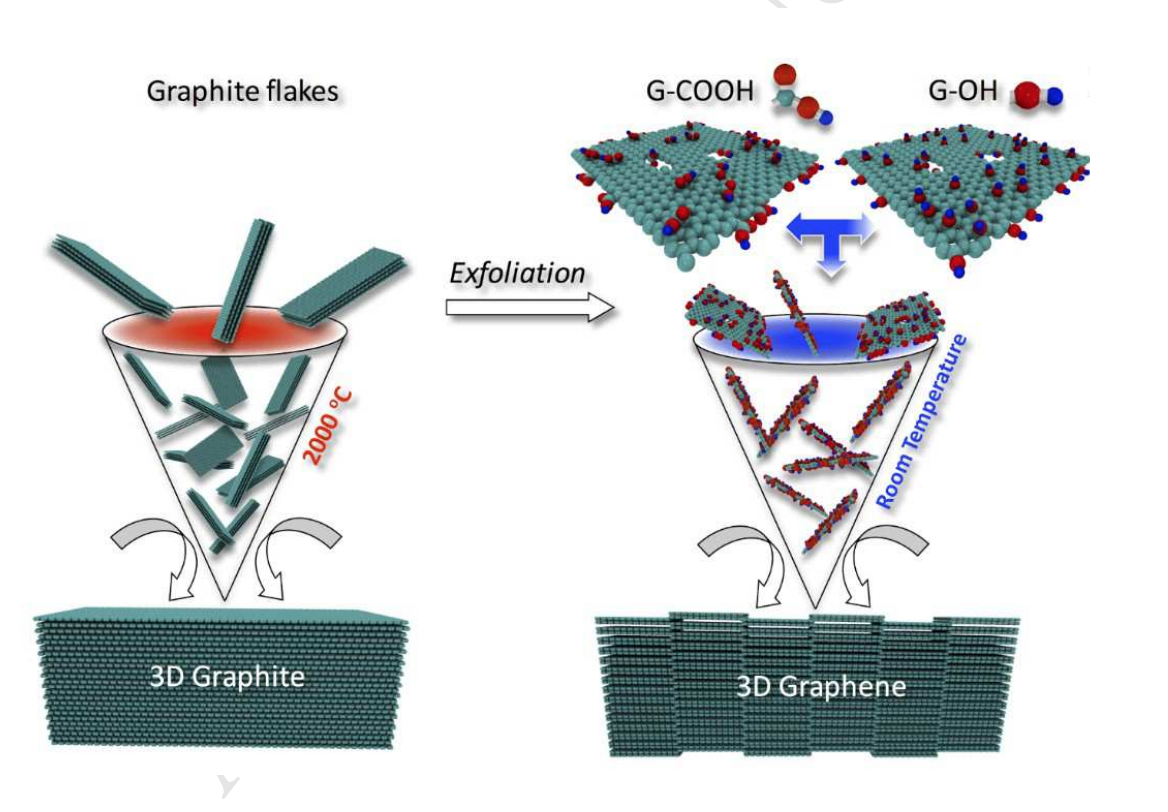
Kabbani, Mohamad A.; Kochat, Vidya; Bhowmick, Sanjit; Soto, Matias; Som, Anirban; Krishnadas, K. R.; Woellner, Cristiano F.; Jaques, Ygor M.; Barrera, Enrique V.; Asif, Syed; Vajtai, Robert; Pradeep, Thalappil; Galvão, Douglas S.; Kabbani, Ahmad T.; Tiwary, Chandra Sekhar; Ajayan, Pulickel M.
Consolidation of Functionalized Graphene at Ambient Temperature via Mechano-chemistry Journal Article
Em: Carbon, vol. 134, não 8, pp. 491-499, 2018.
Resumo | Links | BibTeX | Tags: DFT, Graphene, Mechanochemistry, Molecular Dynamics
@article{Kabbani2018,
title = {Consolidation of Functionalized Graphene at Ambient Temperature via Mechano-chemistry},
author = {Mohamad A. Kabbani and Vidya Kochat and Sanjit Bhowmick and Matias Soto and Anirban Som and K.R. Krishnadas and Cristiano F. Woellner and Ygor M. Jaques and Enrique V. Barrera and Syed Asif and Robert Vajtai and Thalappil Pradeep and Douglas S. Galvão and Ahmad T. Kabbani and Chandra Sekhar Tiwary and Pulickel M. Ajayan},
url = {https://www.sciencedirect.com/science/article/pii/S0008622318302987?dgcid=raven_sd_aip_email},
doi = {DOI:10.1016/j.carbon.2018.03.049},
year = {2018},
date = {2018-03-22},
journal = {Carbon},
volume = {134},
number = {8},
pages = {491-499},
abstract = {Graphitic solids are typically produced via high temperature and energy consuming
processing (e.g. sintering) of carbon particles. Here, we demonstrate the mechano-chemical
assembly of functionalized graphene layers into 3D graphitic solids via room temperature and
low energy consuming processing. The chemical functional groups on graphene layers are
interconnected at room temperature under pressure leading to porous three-dimensional
structures with tunable mechanical and electrical properties. The formation of mechanochemistry
induced atomic scale junctions and their impact on mechanical properties of
graphene assembled carbon materials are demonstrated through nano-indentation experiments
and confirmed using DFT and molecular dynamics simulations. The results show room
temperature consolidation routes of graphene layers into bulk carbon solids.},
keywords = {DFT, Graphene, Mechanochemistry, Molecular Dynamics},
pubstate = {published},
tppubtype = {article}
}
processing (e.g. sintering) of carbon particles. Here, we demonstrate the mechano-chemical
assembly of functionalized graphene layers into 3D graphitic solids via room temperature and
low energy consuming processing. The chemical functional groups on graphene layers are
interconnected at room temperature under pressure leading to porous three-dimensional
structures with tunable mechanical and electrical properties. The formation of mechanochemistry
induced atomic scale junctions and their impact on mechanical properties of
graphene assembled carbon materials are demonstrated through nano-indentation experiments
and confirmed using DFT and molecular dynamics simulations. The results show room
temperature consolidation routes of graphene layers into bulk carbon solids.
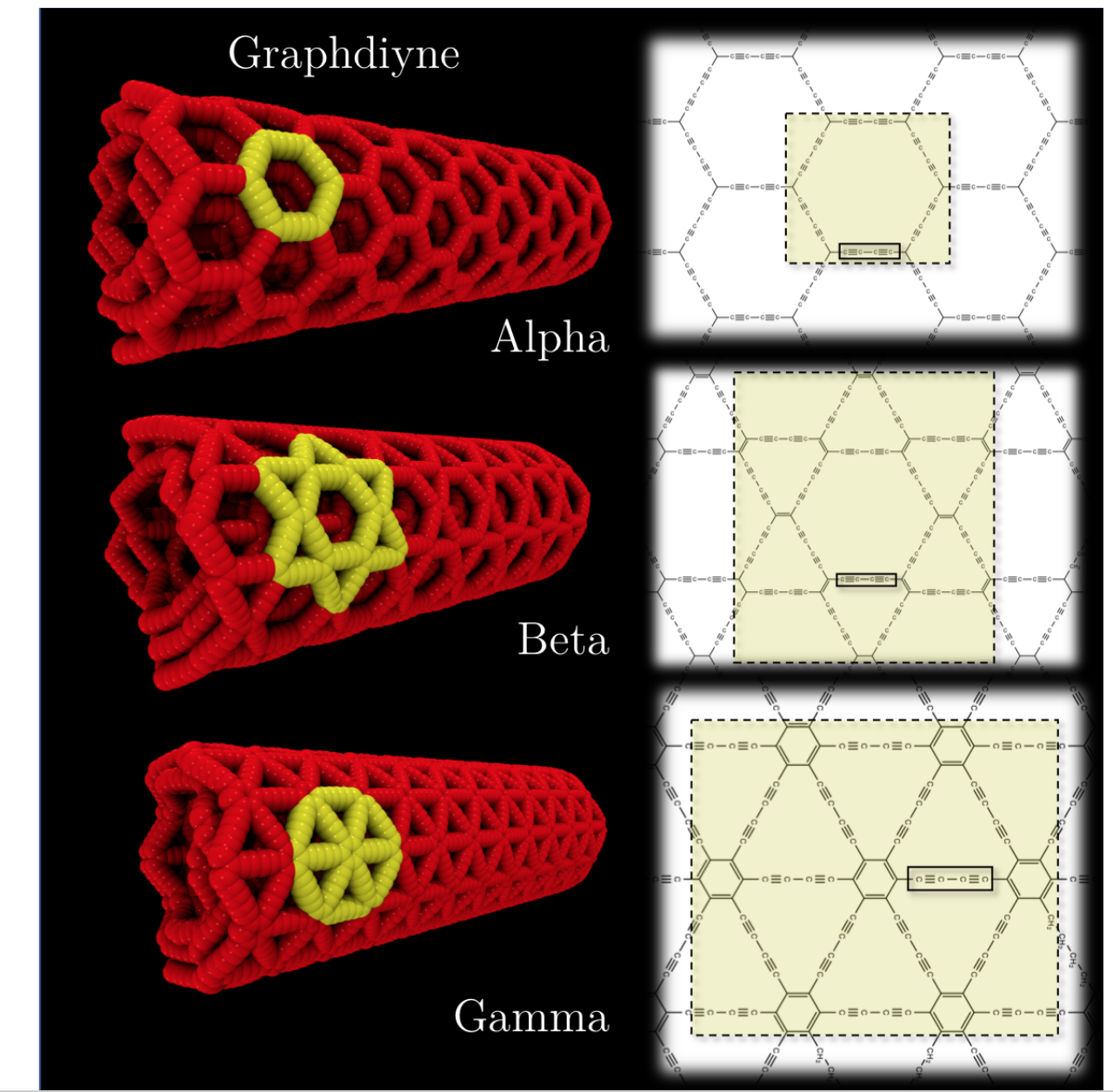
Solis, Daniel; Borges, Daiane D.; Woellner, Cristiano F.; Galvao, Douglas S.
Structural and Thermal Stability of Graphyne and Graphdiyne Nanoscroll Structures Online
2018, visited: 02.03.2018, (preprint ArXiv: 1803.00154).
Resumo | Links | BibTeX | Tags: graphdiynes, Graphynes, molcular dynamics, Scrolls
@online{Solis2018b,
title = {Structural and Thermal Stability of Graphyne and Graphdiyne Nanoscroll Structures},
author = {Daniel Solis and Daiane D. Borges and Cristiano F. Woellner and Douglas S. Galvao},
url = {https://arxiv.org/abs/1803.00154},
year = {2018},
date = {2018-03-02},
urldate = {2018-03-02},
abstract = {Graphynes and graphdiynes are generic names for families of two-dimensional carbon allotropes,
where acetylenic groups connect benzenoid-like hexagonal rings, with the co-existence of sp and
sp
2 hybridized carbon atoms. The main differences between graphynes and graphdiynes are the
number of acetylenic groups (one and two for graphynes and graphdiynes, respectively).
Similarly to graphene nanoscrolls, graphyne and graphdiynes nanoscrolls are nanosized
membranes rolled up into papyrus-like structures. In this work we investigated through fully
atomistic reactive molecular dynamics simulations the structural and thermal (up to 1000K)
stability of α,β,γ-graphyne and α,β,γ-graphdiyne scrolls. Our results show that stable nanoscrolls
can be formed for all the structures investigated here, although they are less stable than
corresponding graphene scrolls. This can be explained as a consequence of the higher
graphyne/graphdiyne structural porosity in relation to graphene, which results in decreased π-π
stacking interactions. },
note = {preprint ArXiv: 1803.00154},
keywords = {graphdiynes, Graphynes, molcular dynamics, Scrolls},
pubstate = {published},
tppubtype = {online}
}
where acetylenic groups connect benzenoid-like hexagonal rings, with the co-existence of sp and
sp
2 hybridized carbon atoms. The main differences between graphynes and graphdiynes are the
number of acetylenic groups (one and two for graphynes and graphdiynes, respectively).
Similarly to graphene nanoscrolls, graphyne and graphdiynes nanoscrolls are nanosized
membranes rolled up into papyrus-like structures. In this work we investigated through fully
atomistic reactive molecular dynamics simulations the structural and thermal (up to 1000K)
stability of α,β,γ-graphyne and α,β,γ-graphdiyne scrolls. Our results show that stable nanoscrolls
can be formed for all the structures investigated here, although they are less stable than
corresponding graphene scrolls. This can be explained as a consequence of the higher
graphyne/graphdiyne structural porosity in relation to graphene, which results in decreased π-π
stacking interactions.
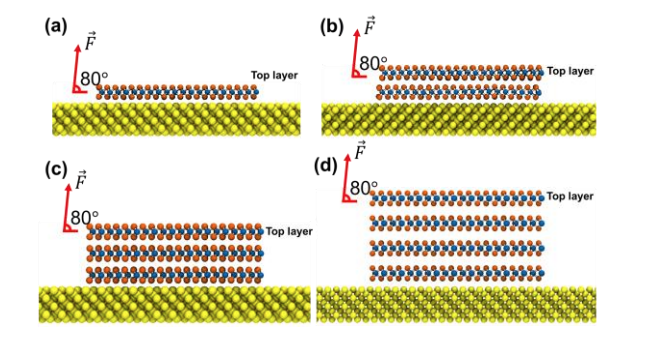
Jaques, Y. M.; Manimunda, P.; Nakanishi, Y.; Susarla, S.; Woellner, C. F.; Bhowmick, S.; Asif, S. A. S.; Galvao, D. S.; Tiwary, C. S.; Ajayan, P. M.
Differences in the Mechanical Properties of Monolayer and Multilayer WSe2/MoSe2 Journal Article
Em: MRS Advances, vol. 3, não 6-7, pp. 373-378, 2018.
Resumo | Links | BibTeX | Tags: Chalcogenides, Modeling
@article{Jaques2018,
title = {Differences in the Mechanical Properties of Monolayer and Multilayer WSe2/MoSe2},
author = {Y. M. Jaques and P. Manimunda and Y. Nakanishi and S. Susarla and C. F. Woellner and S. Bhowmick and S. A. S. Asif and D. S. Galvao and C. S. Tiwary and P. M. Ajayan},
url = {https://www.cambridge.org/core/journals/mrs-advances/article/differences-in-the-mechanical-properties-of-monolayer-and-multilayer-wse2mose2/4F6AFF52BCE7DFFF87E35AC424A8F0BE},
doi = { https://doi.org/10.1557/adv.2018.246},
year = {2018},
date = {2018-03-01},
journal = {MRS Advances},
volume = {3},
number = {6-7},
pages = {373-378},
abstract = {Transition metal dichalcogenides are 2D structures with remarkable electronic, chemical, optical and mechanical properties. Monolayer and crystal properties of these structures have been extensively investigated, but a detailed understanding of the properties of their few-layer structures are still missing. In this work we investigated the mechanical differences between monolayer and multilayer WSe2 and MoSe2, through fully atomistic molecular dynamics simulations (MD). It was observed that single layer WSe2/MoSe2 deposited on silicon substrates have larger friction coefficients than 2, 3 and 4 layered structures. For all considered cases it is always easier to peel off and/or to fracture MoSe2 structures. These results suggest that the interactions between first layer and substrate are stronger than interlayer interactions themselves. Similar findings have been reported for other nanomaterials and it has been speculated whether this is a universal-like behavior for 2D layered materials. We have also analyzed fracture patterns. Our results show that fracture is chirality dependent with crack propagation preferentially perpendicular to W(Mo)-Se bonds and faster for zig-zag-like defects.},
keywords = {Chalcogenides, Modeling},
pubstate = {published},
tppubtype = {article}
}
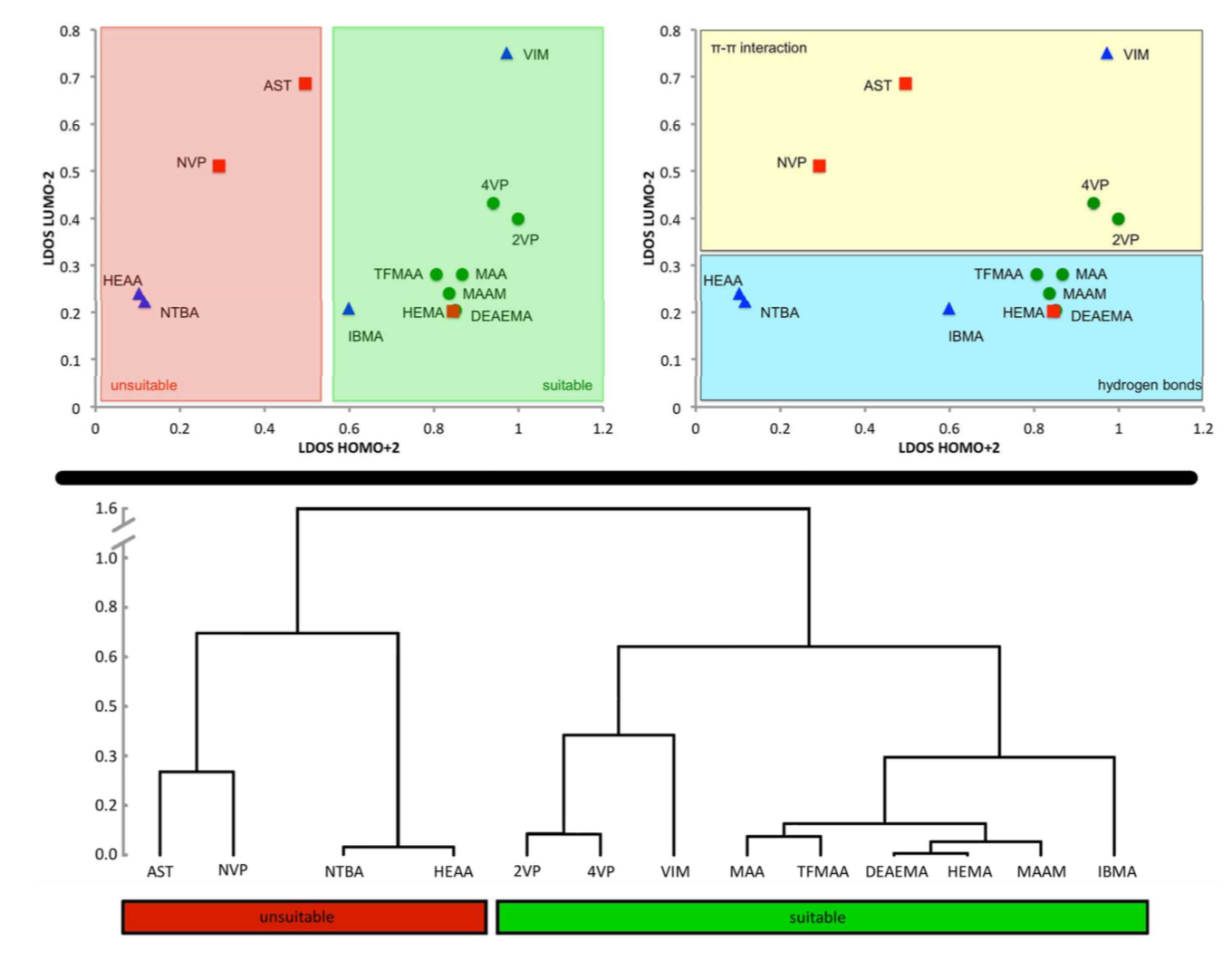
Zink, Stefan; Moura, Francisco Alirio; da Silva Autreto, Pedro Alves; Galvão, Douglas Soares; Mizaikoff, Boris
Efficient prediction of suitable functional monomers for molecular imprinting via local density of states calculations Journal Article
Em: Physical Chemistry Chemical Physics, vol. 20, pp. 13153–13158, 2018.
Resumo | Links | BibTeX | Tags: MIPs, Polymer, TIE
@article{Zink2018,
title = {Efficient prediction of suitable functional monomers for molecular imprinting via local density of states calculations},
author = {Stefan Zink and Francisco Alirio Moura and Pedro Alves da Silva Autreto and Douglas Soares Galvão and Boris Mizaikoff},
url = {http://pubs.rsc.org/en/content/articlelanding/2018/cp/c7cp08283e/unauth#!divAbstract},
doi = {10.1039/C7CP08283E},
year = {2018},
date = {2018-02-15},
journal = {Physical Chemistry Chemical Physics},
volume = {20},
pages = {13153--13158},
abstract = {Synthetic molecular recognition materials, such as molecularly imprinted polymers (MIPs) are of increasing importance in biotechnology and analytical chemistry, as they are able to selectively bind their respective template. However, due to their specificity, each MIP has to be individually designed for the desired target leading to a molecularly tailored synthesis strategy. While trial-and-error remains the common approach for selecting suitable functional monomers (FM), the study herein introduces a radical new approach towards rationally designing MIPs by rapidly screening suitable functional monomers based on local density of states (LDOS) calculations in a technique known as Electronic Indices Methodology (EIM). An EIM-based method of classification of FMs according to their suitability for imprinting was developed. Starting from a training set of nine different functional monomers, the prediction of suitability of four functional monomers was possible. These predictions were subsequently experimentally confirmed.},
keywords = {MIPs, Polymer, TIE},
pubstate = {published},
tppubtype = {article}
}
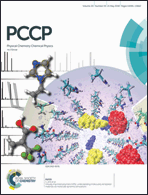
Zink, Stefan; Moura, Francisco Alirio; da Silva Autreto, Pedro Alves; Galvao, Douglas Soares; Mizaikoff, Boris
Virtually Imprinted Polymers (VIPs): Understanding Molecularly Templated Materials via Molecular Dynamics Simulations Journal Article
Em: Physical Chemistry Chemical Physics, vol. 20, pp. 13145-13152, 2018.
Resumo | Links | BibTeX | Tags: MIPs, Molecular Dynamics
@article{Zink2018b,
title = {Virtually Imprinted Polymers (VIPs): Understanding Molecularly Templated Materials via Molecular Dynamics Simulations},
author = {Stefan Zink and Francisco Alirio Moura and Pedro Alves da Silva Autreto and Douglas Soares Galvao and Boris Mizaikoff},
url = {http://pubs.rsc.org/en/content/articlelanding/2018/cp/c7cp08284c/unauth#!divAbstract},
doi = {10.1039/C7CP08284C},
year = {2018},
date = {2018-02-15},
journal = {Physical Chemistry Chemical Physics},
volume = {20},
pages = {13145-13152},
abstract = {Molecularly imprinted polymers are advanced recognition materials selectively rebinding a target molecule present during synthesis of the polymer matrix. It is commonly understood that the templating process is based on embedding the complex formed between a template and functional monomers into a co-polymer matrix via polymerization with a cross-linker while maintaining their spatial arrangement forming a molecular imprint. Template removal then leads to synthetic recognition sites ready to selectively rebind their targets, which are complementary in functionality, size and shape to the target. In this study, an innovative theoretical concept using fully atomistic molecular dynamics simulations for modeling molecular templating processes is introduced yielding virtually imprinted polymers (VIPs). VIPs created for the template of 17-beta-estradiol and applied in modeled chromatography experiments demonstrated selectivity for their template evidencing the creation of virtual imprints as a result of a template synthesis protocol, which represents a theoretical confirmation of the governing imprinting theory.},
keywords = {MIPs, Molecular Dynamics},
pubstate = {published},
tppubtype = {article}
}
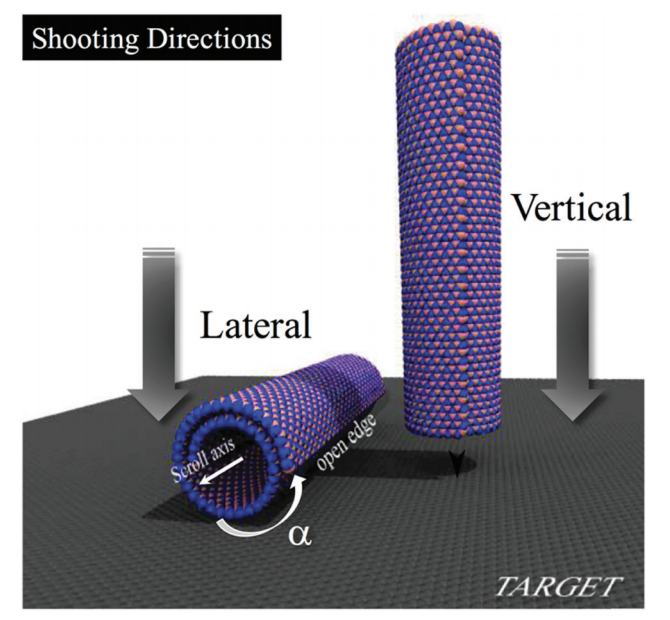
Leonardo D Machado Cristiano F Woellner, Pedro AS Autreto; Galvao, Douglas S
Structural Transformations of Carbon and Boron Nitride Nanoscrolls at High Impact Collisions Journal Article
Em: Physical Chemistry Chemical Physics, vol. 20, pp. 4911-4916, 2018.
Resumo | Links | BibTeX | Tags: Fracture, impact, Molecular Dynamics, scroll
@article{Woellner2018,
title = {Structural Transformations of Carbon and Boron Nitride Nanoscrolls at High Impact Collisions},
author = {Cristiano F Woellner, Leonardo D Machado, Pedro AS Autreto, Jose M de Sousa, and Douglas S Galvao},
url = {http://pubs.rsc.org/en/content/articlelanding/2018/cp/c7cp07402f#!divAbstract},
doi = {DOI:10.1039/C7CP07402F},
year = {2018},
date = {2018-02-14},
journal = {Physical Chemistry Chemical Physics},
volume = {20},
pages = {4911-4916},
abstract = {The behavior of nanostructures under high strain-rate conditions has been the object of theoretical and
experimental investigations in recent years. For instance, it has been shown that carbon and boron
nitride nanotubes can be unzipped into nanoribbons at high-velocity impacts. However, the response of
many nanostructures to high strain-rate conditions is still unknown. In this work, we have investigated
the mechanical behavior of carbon (CNS) and boron nitride nanoscrolls (BNS) colliding against solid
targets at high velocities, using fully atomistic reactive (ReaxFF) molecular dynamics (MD) simulations.
CNS (BNS) are graphene (boron nitride) membranes rolled up into papyrus-like structures. Their openended
topology leads to unique properties not found in their close-ended analogs, such as nanotubes.
Our results show that collision products are mainly determined by impact velocities and by two
orientation angles, which define the position of the scroll (i) axis and (ii) open edge relative to the target.
Our MD results showed that for appropriate velocities and orientations, large-scale deformations and
nanoscroll fractures could occur. We also observed unscrolling (scrolls going back to quasi-planar
membranes), scroll unzipping into nanoribbons, and significant reconstruction due to breaking and/or
formation of new chemical bonds. For particular edge orientations and velocities, conversion from open
to close-ended topology is also possible, due to the fusion of nanoscroll walls.},
keywords = {Fracture, impact, Molecular Dynamics, scroll},
pubstate = {published},
tppubtype = {article}
}
experimental investigations in recent years. For instance, it has been shown that carbon and boron
nitride nanotubes can be unzipped into nanoribbons at high-velocity impacts. However, the response of
many nanostructures to high strain-rate conditions is still unknown. In this work, we have investigated
the mechanical behavior of carbon (CNS) and boron nitride nanoscrolls (BNS) colliding against solid
targets at high velocities, using fully atomistic reactive (ReaxFF) molecular dynamics (MD) simulations.
CNS (BNS) are graphene (boron nitride) membranes rolled up into papyrus-like structures. Their openended
topology leads to unique properties not found in their close-ended analogs, such as nanotubes.
Our results show that collision products are mainly determined by impact velocities and by two
orientation angles, which define the position of the scroll (i) axis and (ii) open edge relative to the target.
Our MD results showed that for appropriate velocities and orientations, large-scale deformations and
nanoscroll fractures could occur. We also observed unscrolling (scrolls going back to quasi-planar
membranes), scroll unzipping into nanoribbons, and significant reconstruction due to breaking and/or
formation of new chemical bonds. For particular edge orientations and velocities, conversion from open
to close-ended topology is also possible, due to the fusion of nanoscroll walls.
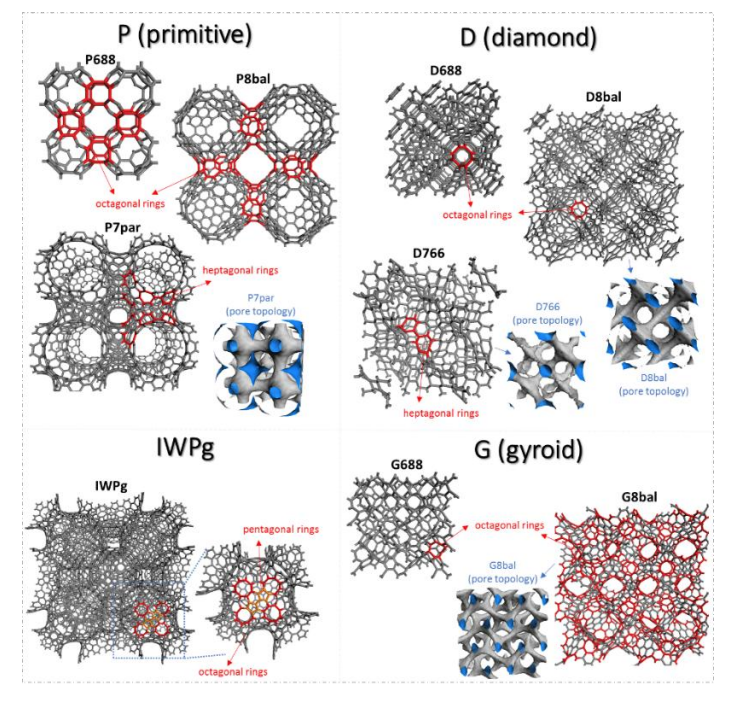
Borges, Daiane Damasceno; Galvao, Douglas S.
Schwarzites for Natural Gas Storage: A Grand-Canonical Monte Carlo Study Journal Article
Em: MRS Advances, vol. 3, não 1-2, pp. 115-120, 2018.
Resumo | Links | BibTeX | Tags: Gas Storage, Mechanical Properties, Molecular Dynamics, Monte Carlo, Schwarzites
@article{Borges2018d,
title = {Schwarzites for Natural Gas Storage: A Grand-Canonical Monte Carlo Study },
author = {Daiane Damasceno Borges and Douglas S. Galvao},
url = {https://www.cambridge.org/core/journals/mrs-advances/article/schwarzites-for-natural-gas-storage-a-grandcanonical-monte-carlo-study/2DF8D601AF8EF04BBAC5CCCBEFA8339E},
doi = {https://doi.org/10.1557/adv.2018.190},
year = {2018},
date = {2018-02-13},
journal = {MRS Advances},
volume = {3},
number = {1-2},
pages = {115-120},
abstract = {he 3D porous carbon-based structures called Schwarzites have been recently a subject of renewed interest due to the possibility of being synthesized in the near future. These structures exhibit negatively curvature topologies with tuneable porous sizes and shapes, which make them natural candidates for applications such as CO2 capture, gas storage and separation. Nevertheless, the adsorption properties of these materials have not been fully investigated. Following this motivation, we have carried out Grand-Canonical Monte Carlo simulations to study the adsorption of small molecules such as CO2, CO, CH4, N2 and H2, in a series of Schwarzites structures. Here, we present our preliminary results on natural gas adsorptive capacity in association with analyses of the guest-host interaction strengths. Our results show that Schwarzites P7par, P8bal and IWPg are the most promising structures with very high CO2 and CH4 adsorption capacity and low saturation pressure (<1bar) at ambient temperature. The P688 is interesting for H2 storage due to its exceptional high H2 adsorption enthalpy value of -19kJ/mol.},
keywords = {Gas Storage, Mechanical Properties, Molecular Dynamics, Monte Carlo, Schwarzites},
pubstate = {published},
tppubtype = {article}
}

Borges, Daiane Damasceno; Woellner, Cristiano F.; Autreto, Pedro A. S.; Galvao, Douglas S.
Water/alcohol separation via layered oxide graphene membranes Journal Article
Em: MRS Advances, vol. 3, não 1-2, pp. 109-114, 2018.
Resumo | Links | BibTeX | Tags: Filtration, Graphene, Molecular Dynamics
@article{Borges2018d,
title = {Water/alcohol separation via layered oxide graphene membranes},
author = {Daiane Damasceno Borges and Cristiano F. Woellner and Pedro A. S. Autreto and Douglas S. Galvao},
url = {https://www.cambridge.org/core/journals/mrs-advances/article/wateralcohol-separation-in-graphene-oxide-membranes-insights-from-molecular-dynamics-and-monte-carlo-simulations/C61C66FF48D35EB2DB3408ACCE96C41A},
doi = { https://doi.org/10.1557/adv.2018.192},
year = {2018},
date = {2018-02-13},
journal = {MRS Advances},
volume = {3},
number = {1-2},
pages = {109-114},
abstract = {Graphene-based membranes have been investigated as promising candidates for water filtration and gas separation applications. Experimental evidences have shown that graphene oxide can be impermeable to liquids, vapors and gases, while allowing a fast permeation of water molecules. This phenomenon has been attributed to the formation of a network of nano capillaries that allow nearly frictionless water flow while blocking other molecules by steric hindrance effects. It is supposed that water molecules are transported through the percolated two-dimensional channels formed between graphene-based sheets. Although these channels allow fast water permeation in such materials, the flow rates are strongly dependent on how the membranes are fabricated. Also, some fundamental issues regarding the nanoscale mechanisms of water permeation are still not fully understood and their interpretation remains controversial. In this work, we have investigated the dynamics of water permeation through pristine graphene and graphene oxide model membranes that have strong impact on water/alcohol separation. We have carried out fully atomistic classical molecular dynamics simulations of systems composed of multiple layered graphene-based sheets into contact with a pure water reservoir under controlled thermodynamics conditions (e. g., by varying temperature and pressure values). We have systematically analysed how the transport dynamics of the confined nanofluids depend on the interlayer distances and the role of the oxide functional groups. Our results show the water flux is much more effective for graphene than for graphene oxide membranes. These results can be attributed to the H-bonds formation between oxide functional groups and water, which traps the water molecules and precludes ultrafast water transport through the nanochannels.},
keywords = {Filtration, Graphene, Molecular Dynamics},
pubstate = {published},
tppubtype = {article}
}
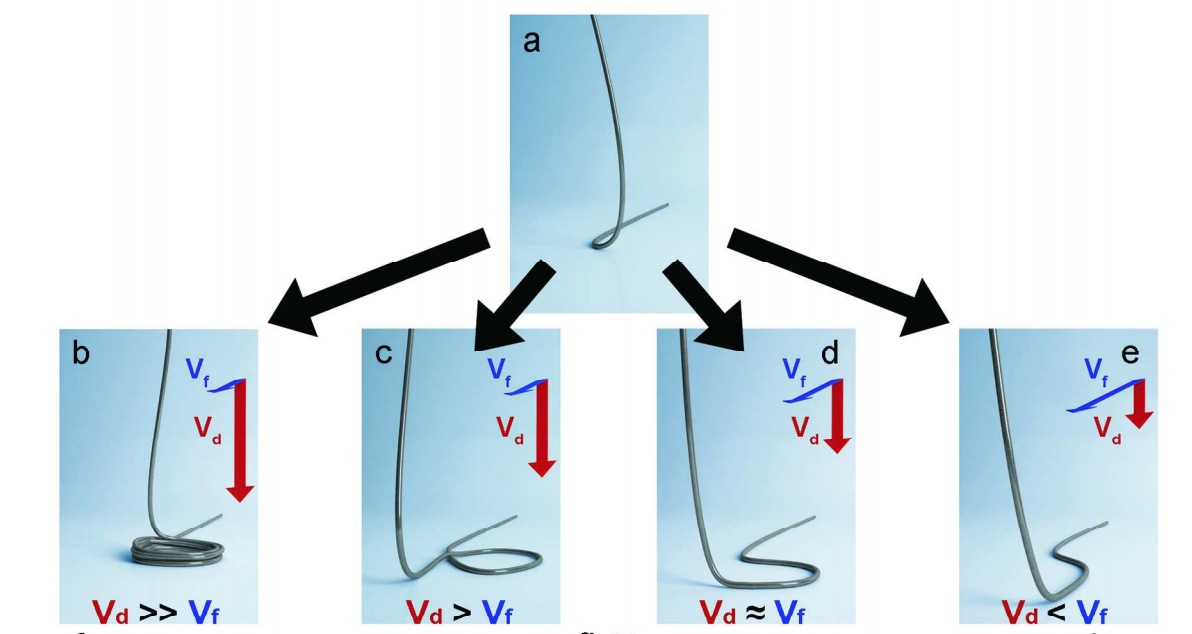
Shadmi, Nitzan; Kremen, Anna; Frenkel, Yiftach; Lapin, Zachary J.; Machado, Leonardo D.; Legoas, Sergio B.; Bitton, Ora; Rechav, Katya; Popovitz-Biro, Ronit; Galvão, Douglas S.; Jorio, Ado; Novotny, Lukas; Kalisky, Beena; Joselevich, Ernesto
Defect-Free Carbon Nanotube Coils Online
2018, (reprint Nano Letters v16, 2152 (2016)).
Resumo | Links | BibTeX | Tags: Carbon Nanotubes, Modeling, Nanocoils
@online{Shadmi2018,
title = {Defect-Free Carbon Nanotube Coils },
author = {Nitzan Shadmi and Anna Kremen and Yiftach Frenkel and Zachary J. Lapin and Leonardo D. Machado and Sergio B. Legoas and Ora Bitton and Katya Rechav and Ronit Popovitz-Biro and Douglas S. Galvão and Ado Jorio and Lukas Novotny and Beena Kalisky and Ernesto Joselevich},
url = {https://arxiv.org/abs/1802.03715},
year = {2018},
date = {2018-02-13},
abstract = {Carbon nanotubes are promising building blocks for various nanoelectronic components. A
highly desirable geometry for such applications is a coil. However, coiled nanotube structures
reported so far were inherently defective or had no free ends accessible for contacting. Here we
demonstrate the spontaneous self-coiling of single-wall carbon nanotubes into defect-free coils
of up to more than 70 turns with identical diameter and chirality, and free ends. We characterize
the structure, formation mechanism and electrical properties of these coils by different
microscopies, molecular dynamics simulations, Raman spectroscopy, and electrical and magnetic
measurements. The coils are highly conductive, as expected for defect-free carbon nanotubes,
but adjacent nanotube segments in the coil are more highly coupled than in regular bundles of
single-wall carbon nanotubes, owing to their perfect crystal momentum matching, which enables
tunneling between the turns. Although this behavior does not yet enable the performance of these
nanotube coils as inductive devices, it does point a clear path for their realization. Hence, this
study represents a major step toward the production of many different nanotube coil devices,
including inductors, electromagnets, transformers and dynamos.},
note = {reprint Nano Letters v16, 2152 (2016)},
keywords = {Carbon Nanotubes, Modeling, Nanocoils},
pubstate = {published},
tppubtype = {online}
}
highly desirable geometry for such applications is a coil. However, coiled nanotube structures
reported so far were inherently defective or had no free ends accessible for contacting. Here we
demonstrate the spontaneous self-coiling of single-wall carbon nanotubes into defect-free coils
of up to more than 70 turns with identical diameter and chirality, and free ends. We characterize
the structure, formation mechanism and electrical properties of these coils by different
microscopies, molecular dynamics simulations, Raman spectroscopy, and electrical and magnetic
measurements. The coils are highly conductive, as expected for defect-free carbon nanotubes,
but adjacent nanotube segments in the coil are more highly coupled than in regular bundles of
single-wall carbon nanotubes, owing to their perfect crystal momentum matching, which enables
tunneling between the turns. Although this behavior does not yet enable the performance of these
nanotube coils as inductive devices, it does point a clear path for their realization. Hence, this
study represents a major step toward the production of many different nanotube coil devices,
including inductors, electromagnets, transformers and dynamos.
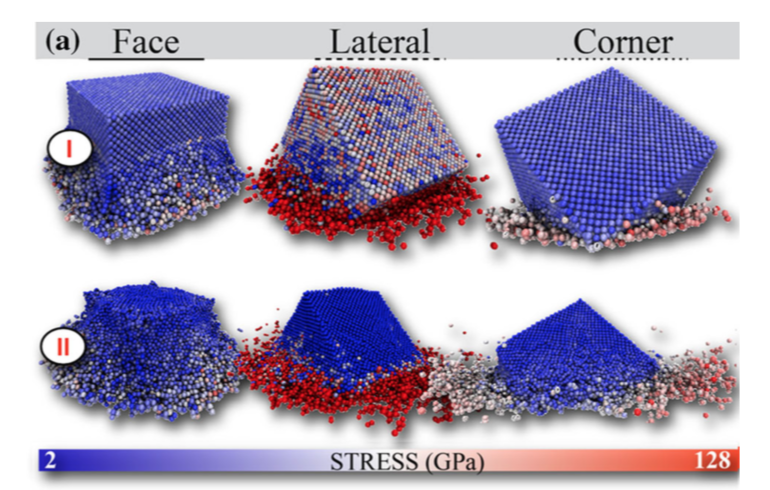
Oliveira, Eliezer Fernando; Autreto, Pedro Alves da Silva; Galvao, Douglas Soares
On hardening silver nanocubes by high velocity impacts: a fully atomistic molecular dynamics investigation Journal Article
Em: Journal of Materials Science, vol. 53, não 10, pp. 7486–7492, 2018.
Resumo | Links | BibTeX | Tags: Fracture, impact, Molecular Dynamics, silver
@article{Oliveira2018,
title = {On hardening silver nanocubes by high velocity impacts: a fully atomistic molecular dynamics investigation},
author = {Oliveira, Eliezer Fernando and Autreto, Pedro Alves da Silva and Galvao, Douglas Soares},
url = {https://link.springer.com/article/10.1007/s10853-018-2104-z},
doi = {10.1007/s10853-018-2104-z},
year = {2018},
date = {2018-02-09},
journal = {Journal of Materials Science},
volume = {53},
number = {10},
pages = {7486–7492},
abstract = {Gradient nanograins (GNG) creation in metals has been a promising approach to obtain ultra-strong materials. Recently, R. Thevamaran et al. (Science 354:312 in 2016) proposed a single-step method based on high-velocity impacts of silver nanocubes (SNC) to produce almost perfect GNG. However, after certain time, these grains spontaneously coalesce, which compromises the induced hardening and other mechanical properties. To better understand these processes, a detailed investigation at the atomic scale of the deformation/hardening mechanisms are needed, which is one of the objectives of the present work. We carried out fully atomistic molecular dynamics (MD) simulations of silver nanocubes at high impact velocity values using realistic structural models. Our MD results suggest that besides the GNG mechanisms, the observed SNC hardening could be also the result of the existence of polycrystalline arrangements formed by HCP domains encapsulated by FCC ones in the smashed SNC. This can be a new way to design ultra-strong materials, even in the absence of GNG domains.},
keywords = {Fracture, impact, Molecular Dynamics, silver},
pubstate = {published},
tppubtype = {article}
}
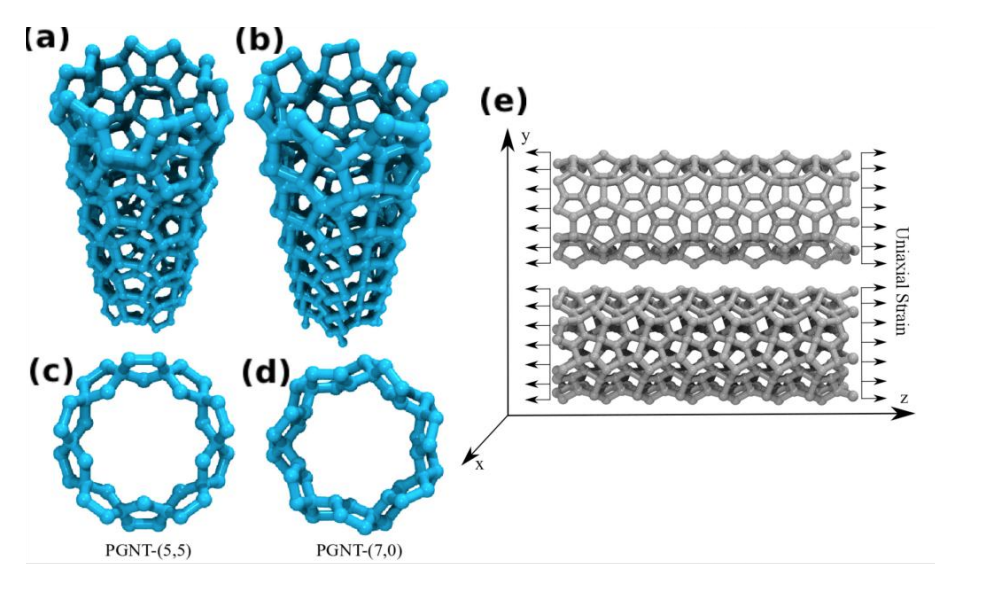
de Sousa, J. M.; Aguiar, A. L.; Girao, E. C.; Fonseca, Alexandre F.; Filho, A. G. Souza; Galvao, Douglas S.
Mechanical Properties of Pentagraphene-based Nanotubes: A Molecular Dynamics Study Journal Article
Em: MRS Advances, vol. 3, não 1-2, pp. 97-102, 2018.
Resumo | Links | BibTeX | Tags: Fracture, Molecular Dynamics, pentagraphene
@article{deSousa2018b,
title = {Mechanical Properties of Pentagraphene-based Nanotubes: A Molecular Dynamics Study},
author = {J. M. de Sousa and A. L. Aguiar and E. C. Girao and Alexandre F. Fonseca and A. G. Souza Filho and Douglas S. Galvao},
url = {https://www.cambridge.org/core/journals/mrs-advances/article/mechanical-properties-of-pentagraphenebased-nanotubes-a-molecular-dynamics-study/289AB70DADF20059BB8FCC9EF07B97AB},
doi = { https://doi.org/10.1557/adv.2018.160},
year = {2018},
date = {2018-02-06},
journal = {MRS Advances},
volume = {3},
number = {1-2},
pages = {97-102},
abstract = {The study of the mechanical properties of nanostructured systems has gained importance in theoretical and experimental research in recent years. Carbon nanotubes (CNTs) are one of the strongest nanomaterials found in nature, with Young’s Modulus (EY) in the order 1.25 TPa. One interesting question is about the possibility of generating new nanostructures with 1D symmetry and with similar and/or superior CNT properties. In this work, we present a study on the dynamical, structural, mechanical properties, fracture patterns and EY values for one class of these structures, the so-called pentagraphene nanotubes (PGNTs). These tubes are formed rolling up pentagraphene membranes (which are quasi-bidimensional structures formed by densely compacted pentagons of carbon atoms in sp3 and sp2 hybridized states) in the same form that CNTs are formed from rolling up graphene membranes. We carried out fully atomistic molecular dynamics simulations using the ReaxFF force field. We have considered zigzag-like and armchair-like PGNTs of different diameters. Our results show that PGNTs present EY ∼ 800 GPa with distinct elastic behavior in relation to CNTs, mainly associated with mechanical failure, chirality dependent fracture patterns and extensive structural reconstructions.},
keywords = {Fracture, Molecular Dynamics, pentagraphene},
pubstate = {published},
tppubtype = {article}
}
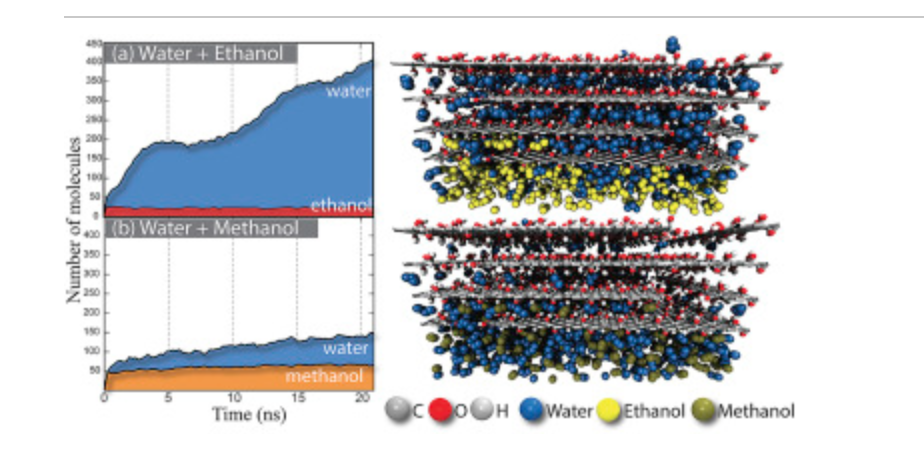
Cristiano F Woellner Daiane Damasceno Borges, Pedro AS Autreto
Insights on the mechanism of water-alcohol separation in multilayer graphene oxide membranes: entropic versus enthalpic factors Journal Article
Em: Carbon, vol. 127, pp. 280-286, 2018.
Resumo | Links | BibTeX | Tags: Filtration, Graphene, Molecular Dynamics
@article{Borges2018,
title = {Insights on the mechanism of water-alcohol separation in multilayer graphene oxide membranes: entropic versus enthalpic factors},
author = {Daiane Damasceno Borges, Cristiano F Woellner, Pedro AS Autreto, Douglas S Galvao},
url = {https://www.sciencedirect.com/science/article/pii/S000862231731134X},
doi = {https://doi.org/10.1016/j.carbon.2017.11.020},
year = {2018},
date = {2018-02-01},
journal = {Carbon},
volume = {127},
pages = {280-286},
abstract = {xperimental evidence has shown that graphene oxide (GO) can be impermeable to liquids, vapors and gases, while it allows a fast permeation of water molecules. Theoretical studies to understand the filtration mechanisms come mostly from water desalination, while very few works have been dedicated to alcohol dehydration. In this work, we have investigated the molecular level mechanism underlying the alcohol/water separation inside GO membranes. A series of Molecular Dynamics and Grand-Canonical Monte Carlo simulations were carried out to probe the ethanol/water and methanol/water separation through GO membranes composed of multiple layered graphene-based films with different interlayer distance values and number of oxygen-containing functional groups. Our results show that the size exclusion and membrane affinities are not sufficient to explain the selectivity. Besides that, the favorable water molecular arrangement inside GO 2D-channels forming a robust H-bond network and the fast water permeation are crucial for an effective separation mechanism. In other words, the separation phenomenon is not only governed by membrane affinities (enthalpic mechanisms) but mainly by the geometry and size factors (entropic mechanisms). Our findings are consistent with the available experimental data and contribute to clarify important aspects of the separation behavior of confined alcohol/water in GO membranes.},
keywords = {Filtration, Graphene, Molecular Dynamics},
pubstate = {published},
tppubtype = {article}
}

Fonseca, Alexandre F.; Galvao, Douglas S.
Self-Driven Graphene Tearing and Peeling: A Fully Atomistic Molecular Dynamics Investigation Journal Article
Em: MRS Advances, vol. 3, não 8-9, pp. 460-465, 2018.
Resumo | Links | BibTeX | Tags: Fracture, Graphene, Molecular Dynamics
@article{Fonseca2018,
title = {Self-Driven Graphene Tearing and Peeling: A Fully Atomistic Molecular Dynamics Investigation},
author = {Alexandre F. Fonseca and Douglas S. Galvao},
url = {https://www.cambridge.org/core/journals/mrs-advances/article/selfdriven-graphene-tearing-and-peeling-a-fully-atomistic-molecular-dynamics-investigation/BFC76FC4479AA617E16FA6AC7AB4D487},
doi = {https://doi.org/10.1557/adv.2018.120},
year = {2018},
date = {2018-01-30},
journal = {MRS Advances},
volume = {3},
number = {8-9},
pages = {460-465},
abstract = {In spite of years of intense research, graphene continues to produce surprising results. Recently, it was experimentally observed that under certain conditions graphene can self-drive its tearing and peeling from substrates. This process can generate long, micrometer sized, folded nanoribbons without the action of any external forces. Also, during this cracking-like propagation process, the width of the graphene folded ribbon continuously decreases and the process only stops when the width reaches about few hundreds nanometers in size. It is believed that interplay between the strain energy of folded regions, breaking of carbon-carbon covalent bonds, and adhesion of graphene-graphene and graphene-substrate are the most fundamental features of this process, although the detailed mechanisms at atomic scale remain unclear. In order to gain further insights on these processes we carried out fully atomistic reactive molecular dynamics simulations using the AIREBO potential as available in the LAMMPS computational package. Although the reported tearing/peeling experimental observations were only to micrometer sized structures, our results showed that they could also occur at nanometer scale. Our preliminary results suggest that the graphene tearing/peeling process originates from thermal energy fluctuations that results in broken bonds, followed by strain release that creates a local elastic wave that can either reinforce the process, similar to a whip cracking propagation, or undermine it by producing carbon dangling bonds that evolve to the formation of bonds between the two layers of graphene. As the process continues in time and the folded graphene decreases in width, the carbon-carbon bonds at the ribbon edge and interlayer bonds get less stressed, thermal fluctuations become unable to break them and the process stops.},
keywords = {Fracture, Graphene, Molecular Dynamics},
pubstate = {published},
tppubtype = {article}
}
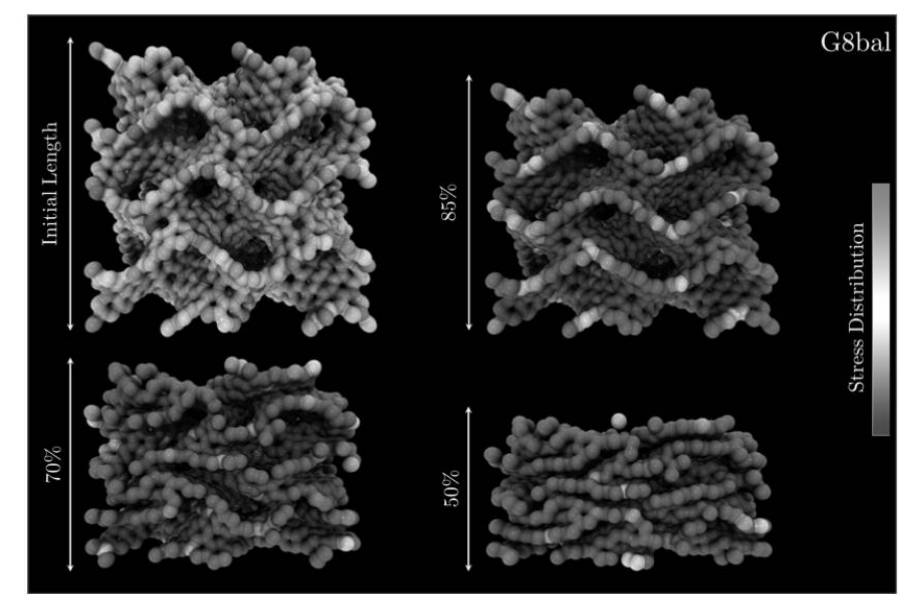
Woellner, Cristiano F.; Botari, Tiago; Perim, Eric; Galvao, Douglas S.
Mechanical Properties of Schwarzites - A Fully Atomistic Reactive Molecular Dynamics Investigation Journal Article
Em: MRS Advances, pp. 1-6, 2018.
Resumo | Links | BibTeX | Tags: Mechanical Properties, Molecular Dynamics, Schwarzites
@article{Woellner2018b,
title = {Mechanical Properties of Schwarzites - A Fully Atomistic Reactive Molecular Dynamics Investigation},
author = {Cristiano F. Woellner and Tiago Botari and Eric Perim and Douglas S. Galvao},
url = {https://www.cambridge.org/core/journals/mrs-advances/article/mechanical-properties-of-schwarzites-a-fully-atomistic-reactive-molecular-dynamics-investigation/012AF477491A46541A052C944E4E4834},
doi = { https://doi.org/10.1557/adv.2018.124},
year = {2018},
date = {2018-01-29},
journal = {MRS Advances},
pages = {1-6},
abstract = {Schwarzites are crystalline, 3D porous structures with a stable negative curvature formed of sp2-hybridized carbon atoms. These structures present topologies with tunable porous size and shape and unusual mechanical properties. In this work, we have investigated the mechanical behavior under compressive strain and energy absorption of four different Schwarzites. We considered two Schwarzites families, the so-called Gyroid and Primitive and two structures from each family. We carried out reactive molecular dynamics simulations, using the ReaxFF force field as available in the LAMMPS code. Our results also show they exhibit remarkable resilience under mechanical compression. They can be reduced to half of their original size before structural failure (fracture) occurs.},
keywords = {Mechanical Properties, Molecular Dynamics, Schwarzites},
pubstate = {published},
tppubtype = {article}
}
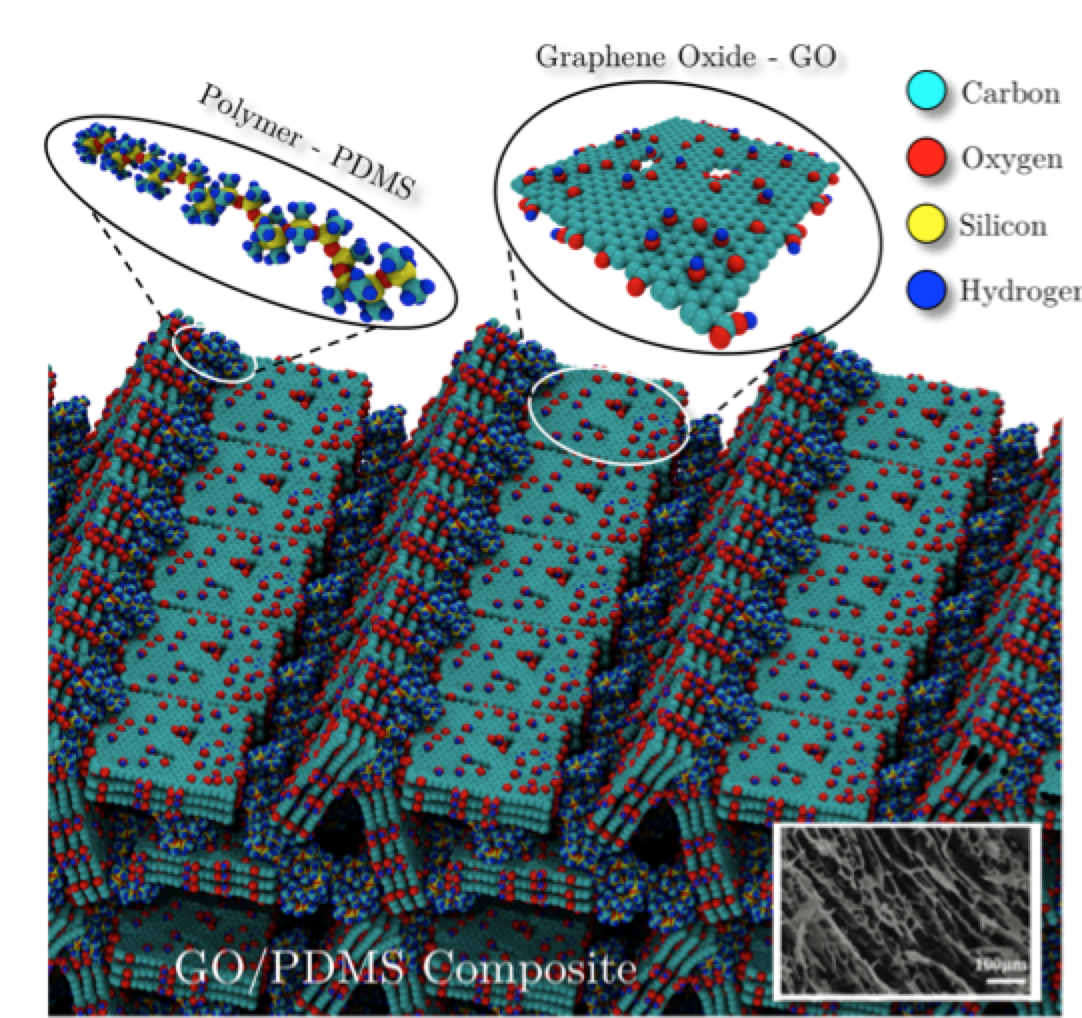
Woellner, Cristiano F.; Owuor, Peter S.; Li, Tong; Vinod, Soumya; Ozden, Sehmus; Kosolwattana, Suppanat; Bhowmick, Sanjit; Duy, Luong X.; Salvatierra, Rodrigo V.; Wei, Bingqing; Asif, Syed A. S.; Tour, James M.; Vajtai, Robert; Lou, Jun; Galvão, Douglas S.; Tiwary, Chandra S.; Ajayan, Pulickel. M.
Mechanical Properties of Ultralow Density Graphene Oxide/Polydimethylsiloxane Foams Journal Article
Em: MRS Advances, vol. 3, não 1-2, pp. 61-66, 2018.
Resumo | Links | BibTeX | Tags: foams, Mechanical Properties, Molecular Dynamics
@article{Woellner2018c,
title = {Mechanical Properties of Ultralow Density Graphene Oxide/Polydimethylsiloxane Foams},
author = {Cristiano F. Woellner and Peter S. Owuor and Tong Li and Soumya Vinod and Sehmus Ozden and Suppanat Kosolwattana and Sanjit Bhowmick and Luong X. Duy and Rodrigo V. Salvatierra and Bingqing Wei and Syed A. S. Asif and James M. Tour and Robert Vajtai and Jun Lou and Douglas S. Galvão and Chandra S. Tiwary and Pulickel. M. Ajayan},
url = {https://www.cambridge.org/core/journals/mrs-advances/article/mechanical-properties-of-ultralow-density-graphene-oxidepolydimethylsiloxane-foams/BC2DC24B3DB5714759FC1EDC71BD9D05},
doi = {DOI: 10.1557/adv.2018. 49},
year = {2018},
date = {2018-01-18},
journal = {MRS Advances},
volume = {3},
number = {1-2},
pages = { 61-66},
abstract = {Low-density, highly porous graphene/graphene oxide (GO) based-foams have shown high performance in energy absorption applications, even under high compressive deformations. In general, foams are very effective as energy dissipative materials and have been widely used in many areas such as automotive, aerospace and biomedical industries. In the case of graphene-based foams, the good mechanical properties are mainly attributed to the intrinsic graphene and/or GO electronic and mechanical properties. Despite the attractive physical properties of graphene/GO based-foams, their structural and thermal stabilities are still a problem for some applications. For instance, they are easily degraded when placed in flowing solutions, either by the collapsing of their layers or just by structural disintegration into small pieces. Recently, a new and scalable synthetic approach to produce low-density 3D macroscopic GO structure interconnected with polydimethylsiloxane (PDMS) polymeric chains (pGO) was proposed. A controlled amount of PDMS is infused into the freeze-dried foam resulting into a very rigid structure with improved mechanical properties, such as tensile plasticity and toughness. The PDMS wets the graphene oxide sheets and acts like a glue bonding PDMS and GO sheets. In order to obtain further insights on mechanisms behind the enhanced mechanical pGO response we carried out fully atomistic molecular dynamics (MD) simulations. Based on MD results, we build up a structural model that can explain the experimentally observed mechanical behavior.},
keywords = {foams, Mechanical Properties, Molecular Dynamics},
pubstate = {published},
tppubtype = {article}
}
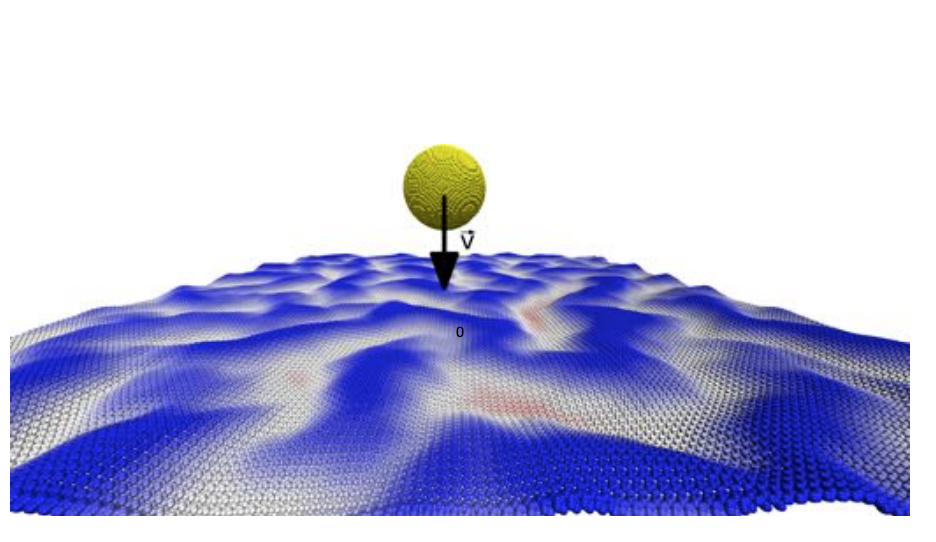
Azevedo, David L.; Bizao, Rafael A.; Galvao, Douglas S.
Molecular Dynamics Simulations of Ballistic Penetration of Pentagraphene Sheets Online
2018, (preprint arXiv:1801.05346).
Resumo | Links | BibTeX | Tags: Fracture, Molecular Dynamics, pentagraphene
@online{Azevedo2018b,
title = {Molecular Dynamics Simulations of Ballistic Penetration of Pentagraphene Sheets},
author = {David L. Azevedo and Rafael A. Bizao and Douglas S. Galvao},
url = {https://arxiv.org/abs/1801.05346},
year = {2018},
date = {2018-01-18},
abstract = {The superior mechanical properties and low density of carbon nanostructures make them promising ballistic protection materials, stimulating investigations on their high-strain-rate behavior. Recent experiments and simulations revealed graphene possesses exceptional energy absorption properties. In this work, we analyzed through fully atomistic molecular dynamics simulations the ballistic performance of a carbon-based material recently proposed named penta-graphene. Our results show that the fracture pattern is more spherical (no petals formation like observed for graphene). The estimated penetration energy for pentagraphene structures considered here was of 37.69 MJ/Kg, far superior to graphene (29.8 MJ/Kg) under same conditions. These preliminary results are suggestive that pentagraphene could be an excellent material for ballistic applications.},
note = {preprint arXiv:1801.05346},
keywords = {Fracture, Molecular Dynamics, pentagraphene},
pubstate = {published},
tppubtype = {online}
}
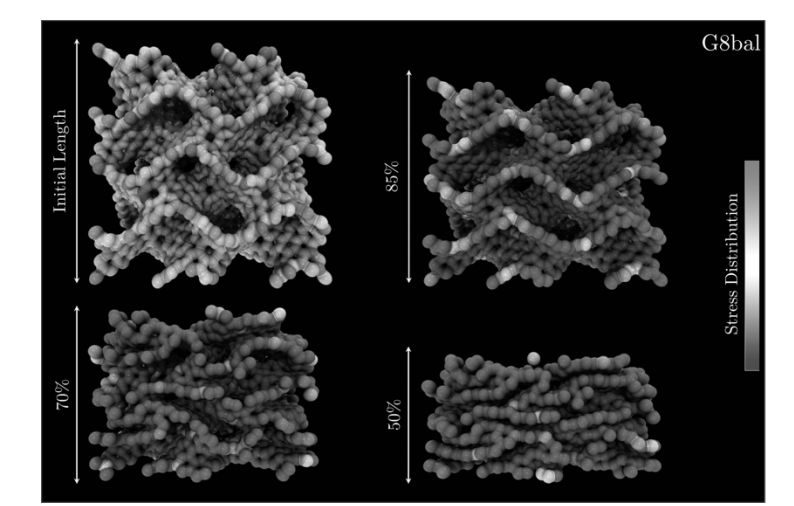
Woellner, Cristiano F.; Botari, Tiago; Perim, Eric; Galvao, Douglas S.
Mechanical Properties of Schwarzites - A Fully Atomistic Reactive Molecular Dynamics Investigation Online
2018, (preprint arXiv:1801.05639).
Resumo | Links | BibTeX | Tags: Mechanical Properties, Molecular Dynamics, Schwarzites
@online{Woellner2018d,
title = {Mechanical Properties of Schwarzites - A Fully Atomistic Reactive Molecular Dynamics Investigation},
author = {Cristiano F. Woellner and Tiago Botari and Eric Perim and Douglas S. Galvao},
url = {https://arxiv.org/abs/1801.05639},
year = {2018},
date = {2018-01-18},
abstract = {Schwarzites are crystalline, 3D porous structures with stable negative curvature formed of sp2-hybridized carbon atoms. These structures present topologies with tunable porous size and shape and unusual mechanical properties. In this work, we have investigated the mechanical behavior under compressive strains and energy absorption of four different Schwarzites, through reactive molecular dynamics simulations, using the ReaxFF force field as available in the LAMMPS code. We considered two Schwarzites families, the so-called Gyroid and Primitive and two structures from each family. Our results also show they exhibit remarkable resilience under mechanical compression. They can be reduced to half of their original size before structural failure (fracture) occurs.},
note = {preprint arXiv:1801.05639},
keywords = {Mechanical Properties, Molecular Dynamics, Schwarzites},
pubstate = {published},
tppubtype = {online}
}
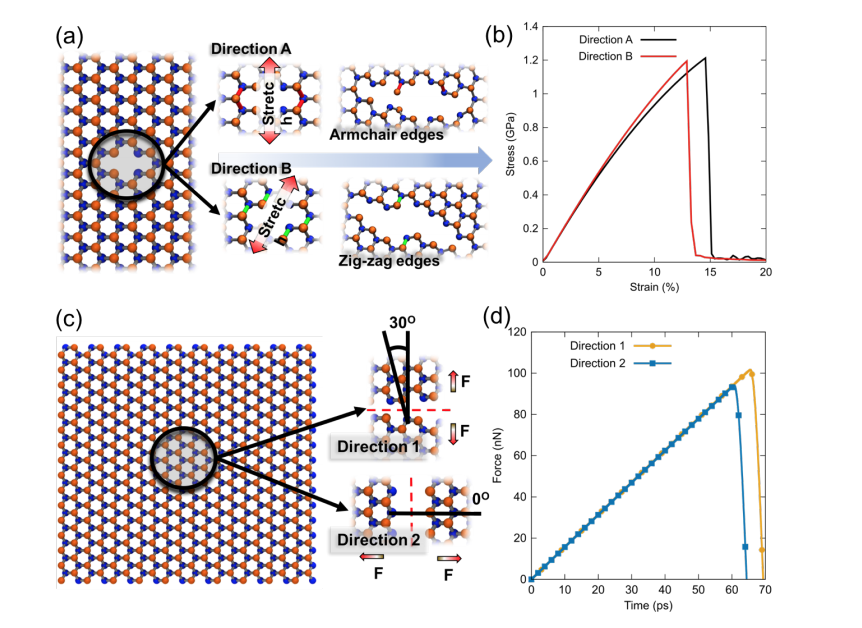
Jaques, Y. M.; Manimunda, P.; Nakanishi, Y.; Susarla, S.; Woellner, C. F.; Bhowmick, S.; Asif, S. A. S.; Galvao, D. S.; C. S. Tiwary,; Ajayan, P. M.
Differences in the Mechanical Properties of Monolayer and Multilayer WSe2/MoSe2 Online
2018, (preprint arXiv:1801.05641).
Resumo | Links | BibTeX | Tags: Chalcogenides, Mechanical Properties, Modeling
@online{Jaques2018b,
title = {Differences in the Mechanical Properties of Monolayer and Multilayer WSe2/MoSe2},
author = {Y. M. Jaques and P. Manimunda and Y. Nakanishi and S. Susarla and C. F. Woellner and S. Bhowmick and S. A. S. Asif and D. S. Galvao and C. S. Tiwary, and P. M. Ajayan},
url = {https://arxiv.org/abs/1801.05641},
year = {2018},
date = {2018-01-18},
abstract = {Transition metal dichalcogenides are 2D structures with remarkable electronic, chemical, optical and mechanical properties. Monolayer and crystal properties of these structures have been extensively investigated, but a detailed understanding of the properties of their few-layer structures are still missing. In this work we investigated the mechanical differences between monolayer and multilayer WSe2 and MoSe2, through fully atomistic molecular dynamics simulations (MD). It was observed that single layer WSe2/MoSe2 deposited on silicon substrates have larger friction coefficients than 2, 3 and 4 layered structures. For all considered cases it is always easier to peel off and/or to fracture MoSe2 structures. These results suggest that the interactions between first layer and substrate are stronger than interlayer interactions themselves. Similar findings have been reported for other nanomaterials and it has been speculated whether this is a universal-like behavior for 2D layered materials. We have also analyzed fracture patterns. Our results show that fracture is chirality dependent with crack propagation preferentially perpendicular to W(Mo)-Se bonds and faster for zig-zag-like defects.},
note = {preprint arXiv:1801.05641},
keywords = {Chalcogenides, Mechanical Properties, Modeling},
pubstate = {published},
tppubtype = {online}
}
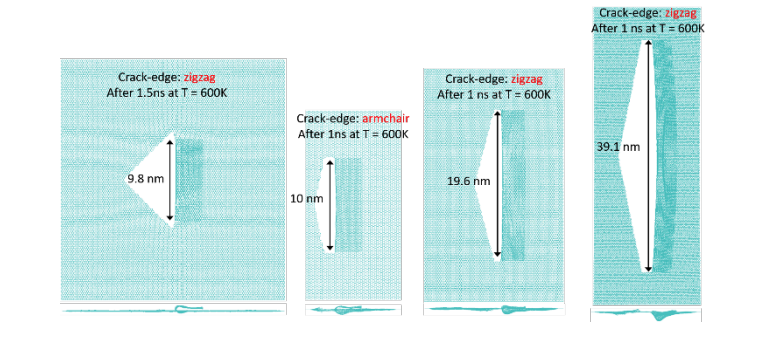
Fonseca, Alexandre F.; Galvao, Douglas S.
Self-Driven Graphene Tearing and Peeling: A Fully Atomistic Molecular Dynamics Investigation Online
2018, (preprint arXiv:1801.05354).
Resumo | Links | BibTeX | Tags: Fracture, Graphene, Molecular Dynamics
@online{Fonseca2018b,
title = {Self-Driven Graphene Tearing and Peeling: A Fully Atomistic Molecular Dynamics Investigation},
author = {Alexandre F. Fonseca and Douglas S. Galvao
},
url = {https://arxiv.org/abs/1801.05354},
year = {2018},
date = {2018-01-17},
abstract = {In spite of years of intense research, graphene continues to produce surprising results. Recently, it was experimentally observed that under certain conditions graphene can self-drive its tearing and peeling from substrates. This process can generate long, micrometer sized, folded nanoribbons without the action of any external forces. Also, during this cracking-like propagation process, the width of the graphene folded ribbon continuously decreases and the process only stops when the width reaches about few hundreds nanometers in size. It is believed that interplay between the strain energy of folded regions, breaking of carbon-carbon covalent bonds, and adhesion of graphene-graphene and graphene-substrate are the most fundamental features of this process, although the detailed mechanisms at atomic scale remain unclear. In order to gain further insights on these processes we carried out fully atomistic reactive molecular dynamics simulations using the AIREBO potential as available in the LAMMPS computational package. Although the reported tearing/peeling experimental observations were only to micrometer sized structures, our results showed that they could also occur at nanometer scale. Our preliminary results suggest that the graphene tearing/peeling process originates from thermal energy fluctuations that results in broken bonds, followed by strain release that creates a local elastic wave that can either reinforce the process, similar to a whip cracking propagation, or undermine it by producing carbon dangling bonds that evolve to the formation of bonds between the two layers of graphene. As the process continues in time and the folded graphene decreases in width, the carbon-carbon bonds at the ribbon edge and interlayer bonds get less stressed, thermal fluctuations become unable to break them and the process stops.},
note = {preprint arXiv:1801.05354},
keywords = {Fracture, Graphene, Molecular Dynamics},
pubstate = {published},
tppubtype = {online}
}
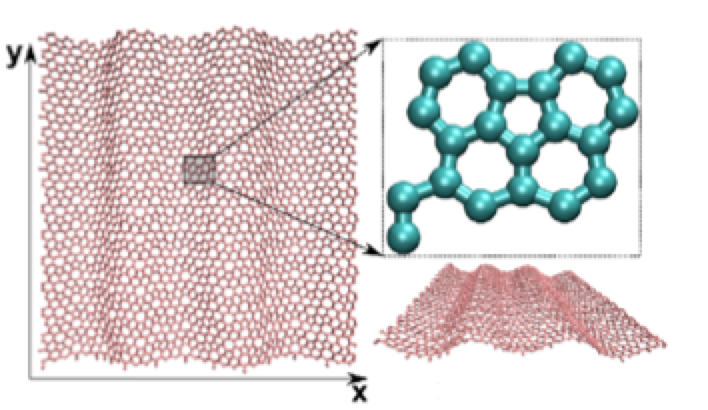
de Sousa, J. M.; Aguiar, A. L.; Girao, E. C.; Fonseca, Alexandre F.; Filho, A. G. Souza; Galvao, Douglas S.
Mechanical Properties of Phagraphene Membranes: A Fully Atomistic Molecular Dynamics Investigation Journal Article
Em: MRS Advances, vol. 3, não 1-2, pp. 67-72, 2018.
Resumo | Links | BibTeX | Tags: Fracture, Molecular Dynamics, phagraphene
@article{deSousa2018c,
title = {Mechanical Properties of Phagraphene Membranes: A Fully Atomistic Molecular Dynamics Investigation},
author = {J. M. de Sousa and A. L. Aguiar and E. C. Girao and Alexandre F. Fonseca and A. G. Souza Filho and Douglas S. Galvao},
url = {https://www.cambridge.org/core/journals/mrs-advances/article/mechanical-properties-of-phagraphene-membranes-a-fully-atomistic-molecular-dynamics-investigation/3ADC3F3B0052AB6632E8681404948E7B},
doi = {DOI: 10.1557/adv.2018. 54},
year = {2018},
date = {2018-01-15},
journal = {MRS Advances},
volume = {3},
number = {1-2},
pages = {67-72},
abstract = {Recently, a new 2D carbon allotrope structure, named phagraphene (PG), was proposed. PG has a densely array of penta-hexa-hepta-graphene carbon rings. PG was shown to present low and anisotropic thermal conductivity and it is believed that this anisotropy should be also reflected in its mechanical properties. Although PG mechanical properties have been investigated, a detailed and comprehensive study is still lacking. In the present work we have carried out fully atomistic reactive molecular dynamics simulations using the ReaxFF force field, to investigate the mechanical properties and fracture patterns of PG membranes. The Young's modulus values of the PG membranes were estimated from the stress-strain curves. Our results show that these curves present three distinct regimes: one regime where ripples dominate the structure and mechanical properties of the PG membranes; an elastic regime where the membranes exhibit fully planar configurations; and finally am inelastic regime where permanent deformations happened to the PG membrane up to the mechanical failure or fracture.},
keywords = {Fracture, Molecular Dynamics, phagraphene},
pubstate = {published},
tppubtype = {article}
}
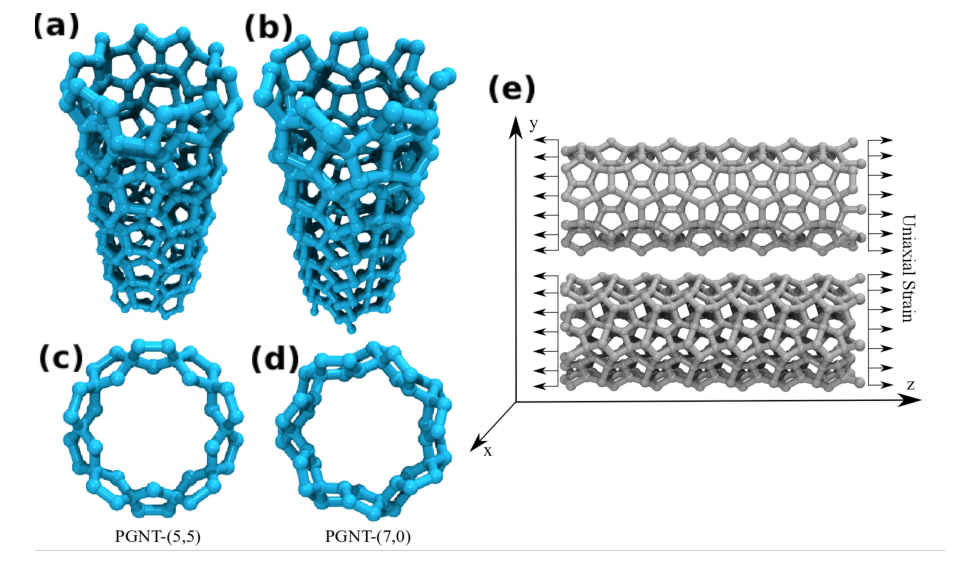
de Sousa, J. M.; Aguiar, A. L.; Girao, E. C.; Fonseca, Alexandre F.; Filho, A. G. Sousa; Galvao, Douglas S.
Mechanical Properties of Pentagraphene-based Nanotubes: A Molecular Dynamics Study Online
2018, (preprint arXiv:1801.04269).
Resumo | Links | BibTeX | Tags: Fracture, Molecular Dynamics, Nanotubes, pentagraphene
@online{deSousa2018d,
title = {Mechanical Properties of Pentagraphene-based Nanotubes: A Molecular Dynamics Study},
author = {J. M. de Sousa and A. L. Aguiar and E. C. Girao and Alexandre F. Fonseca and A. G. Sousa Filho and Douglas S. Galvao},
url = {https://arxiv.org/abs/1801.04269},
year = {2018},
date = {2018-01-15},
abstract = {The study of the mechanical properties of nanostructured systems has gained importance in
theoretical and experimental research in recent years. Carbon nanotubes (CNTs) are one of
the strongest nanomaterials found in nature, with Young's Modulus (YM) in the order 1.25
TPa. One interesting question is about the possibility of generating new nanostructures with
1D symmetry and with similar and/or superior CNT properties. In this work, we present a
study on the dynamical, structural, mechanical properties, fracture patterns and YM values
for one class of these structures, the so-called pentagraphene nanotubes (PGNTs). These
tubes are formed rolling up pentagraphene membranes (which are quasi-bidimensional
structures formed by densely compacted pentagons of carbon atoms in sp3 and sp2 hybridized
states) in the same form that CNTs are formed from rolling up graphene membranes. We
carried out fully atomistic molecular dynamics simulations using the ReaxFF force field. We
have considered zigzag-like and armchair-like PGNTs of different diameters. Our results
show that PGNTs present YM ~ 800 GPa with distinct elastic behavior in relation to CNTs,
mainly associated with mechanical failure, chirality dependent fracture patterns and extensive
structural reconstructions},
note = {preprint arXiv:1801.04269},
keywords = {Fracture, Molecular Dynamics, Nanotubes, pentagraphene},
pubstate = {published},
tppubtype = {online}
}
theoretical and experimental research in recent years. Carbon nanotubes (CNTs) are one of
the strongest nanomaterials found in nature, with Young's Modulus (YM) in the order 1.25
TPa. One interesting question is about the possibility of generating new nanostructures with
1D symmetry and with similar and/or superior CNT properties. In this work, we present a
study on the dynamical, structural, mechanical properties, fracture patterns and YM values
for one class of these structures, the so-called pentagraphene nanotubes (PGNTs). These
tubes are formed rolling up pentagraphene membranes (which are quasi-bidimensional
structures formed by densely compacted pentagons of carbon atoms in sp3 and sp2 hybridized
states) in the same form that CNTs are formed from rolling up graphene membranes. We
carried out fully atomistic molecular dynamics simulations using the ReaxFF force field. We
have considered zigzag-like and armchair-like PGNTs of different diameters. Our results
show that PGNTs present YM ~ 800 GPa with distinct elastic behavior in relation to CNTs,
mainly associated with mechanical failure, chirality dependent fracture patterns and extensive
structural reconstructions

Oliveira, Eliezer Fernando; Santos, Ricardo Paupitz; da Silva Autreto, Pedro Alves; Stanislav Moshkalev,; Galvao, Douglas Soares
Improving Graphene-metal Contacts: Thermal Induced Polishing Online
2018, (preprint ArXiv:1801.04785).
Resumo | Links | BibTeX | Tags: contacts, Graphene, Molecular Dynamics, thermal properties
@online{Oliveira2018d,
title = {Improving Graphene-metal Contacts: Thermal Induced Polishing},
author = {Eliezer Fernando Oliveira and Ricardo Paupitz Santos and Pedro Alves da Silva Autreto and Stanislav Moshkalev, and Douglas Soares Galvao},
url = {https://arxiv.org/abs/1801.04785},
year = {2018},
date = {2018-01-15},
abstract = {Graphene is a very promising material for nanoelectronics applications due to its unique and remarkable electronic and thermal properties. However, when deposited on metallic electrodes the overall thermal conductivity is significantly decreased. This phenomenon has been attributed to the mismatch between the interfaces and contact thermal resistance. Experimentally, one way to improve the graphene/metal contact is thorough high-temperature annealing, but the detailed mechanisms behind these processes remain unclear. In order to address these questions, we carried out fully atomistic reactive molecular dynamics simulations using the ReaxFF force field to investigate the interactions between multi-layer graphene and metallic electrodes (nickel) under (thermal) annealing. Our results show that the annealing induces an upward-downward movement of the graphene layers, causing a pile- driver-like effect over the metallic surface. This graphene induced movements cause a planarization (thermal polishing-like effect) of the metallic surface, which results in the increase of the effective graphene/metal contact area. This can also explain the experimentally observed improvements of the thermal and electric conductivities.},
note = {preprint ArXiv:1801.04785},
keywords = {contacts, Graphene, Molecular Dynamics, thermal properties},
pubstate = {published},
tppubtype = {online}
}
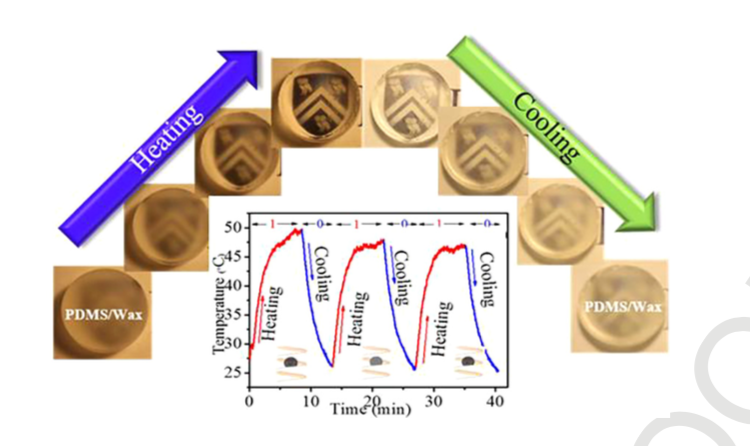
Owuor, Peter; Chaudhary, Varun; Woellner, Cristiano F; Ramanujan, R V; Stender, Anthony S; Soto, Matias; Ozden, Sehmus; Barrera, Enrique; Vajtai, Robert; Galvao, Douglas; Lou, Jun; Sharma, V; Ajayan, Pulickel M
High Stiffness Polymer Composite with Tunable Transparency Journal Article
Em: Materials Today, vol. 21, não 5, pp. 475-482, 2018.
Resumo | Links | BibTeX | Tags: Composites, Polymer
@article{Owuor2018,
title = {High Stiffness Polymer Composite with Tunable Transparency},
author = {Peter Owuor and Varun Chaudhary and Cristiano F Woellner and R V Ramanujan and Anthony S Stender and Matias Soto and Sehmus Ozden and Enrique Barrera and Robert Vajtai and Douglas Galvao and Jun Lou and V Sharma and Pulickel M Ajayan
},
url = {https://www.sciencedirect.com/science/article/pii/S1369702117306867},
doi = {10.1016/j.mattod.2017.12.004},
year = {2018},
date = {2018-01-12},
journal = {Materials Today},
volume = {21},
number = {5},
pages = {475-482},
abstract = {Biological materials are multifunctional performing more than one function in a perfect synergy. These materials are built from fairly simple and limited components at ambient conditions. Such judicious designs have proven elusive for synthetic materials. Here, we demonstrate a multifunctional phase change (pc) composite from simple building blocks, which exhibits high stiffness and optical transmittance control. We show an increase of more than one order of magnitude in stiffness when we embed paraffin wax spheres into an elastomer matrix, polydimethylsiloxane (PDMS) in a dynamic compression test. High stiffness is mainly influenced by presence of microcrystals within the wax. We further show fast temperature-controlled optical switching of the composite for an unlimited number of cycles without any noticeable mechanical degradation. Through experimental and finite element method, we show high energy absorption capability of pc-composite. Based on these properties, the pc- composite could be used as an effective coating on glasses for cars and windows. This simple approach to multi-functionality is exciting and could pave way for designs of other multifunctional materials at the macro-scale.},
keywords = {Composites, Polymer},
pubstate = {published},
tppubtype = {article}
}

de Sousa, Jose M.; Aguiar, Acrisio L.; Girao, Eduardo C.; Fonseca, Alexandre F.; Antonio G. Sousa Filho,; Galvao, Douglas S.
Mechanical Properties of Phagraphene Membranes: A Fully Atomistic Molecular Dynamics Investigation Online
2018, (preprint arXiv:1801.04292).
Resumo | Links | BibTeX | Tags: Fracture, Mechanical Properties, Molecular Dynamics, phagraphene
@online{deSousa2018e,
title = {Mechanical Properties of Phagraphene Membranes: A Fully Atomistic Molecular Dynamics Investigation},
author = {Jose M. de Sousa and Acrisio L. Aguiar and Eduardo C. Girao and Alexandre F. Fonseca and Antonio G. Sousa Filho, and Douglas S. Galvao
},
url = {https://arxiv.org/abs/1801.04292},
year = {2018},
date = {2018-01-12},
abstract = {Recently, a new 2D carbon allotrope structure, named phagraphene (PG), was proposed. PG has a densely array of penta-hexa-hepta-graphene carbon rings. PG was shown to present low and anisotropic thermal conductivity and it is believed that this anisotropy should be also reflected in its mechanical properties. Although PG mechanical properties have been investigated, a detailed and comprehensive study is still lacking. In the present work we have carried out fully atomistic reactive molecular dynamics simulations using the ReaxFF force field, to investigate the mechanical properties and fracture patterns of PG membranes. The Young's modulus values of the PG membranes were estimated from the stress-strain curves. Our results show that these curves present three distinct regimes: one regime where ripples dominate the structure and mechanical properties of the PG membranes; an elastic regime where the membranes exhibit fully planar configurations; and finally a plastic regime where permanent deformations happened to the PG membrane up to the mechanical failure or fracture.},
note = {preprint arXiv:1801.04292},
keywords = {Fracture, Mechanical Properties, Molecular Dynamics, phagraphene},
pubstate = {published},
tppubtype = {online}
}
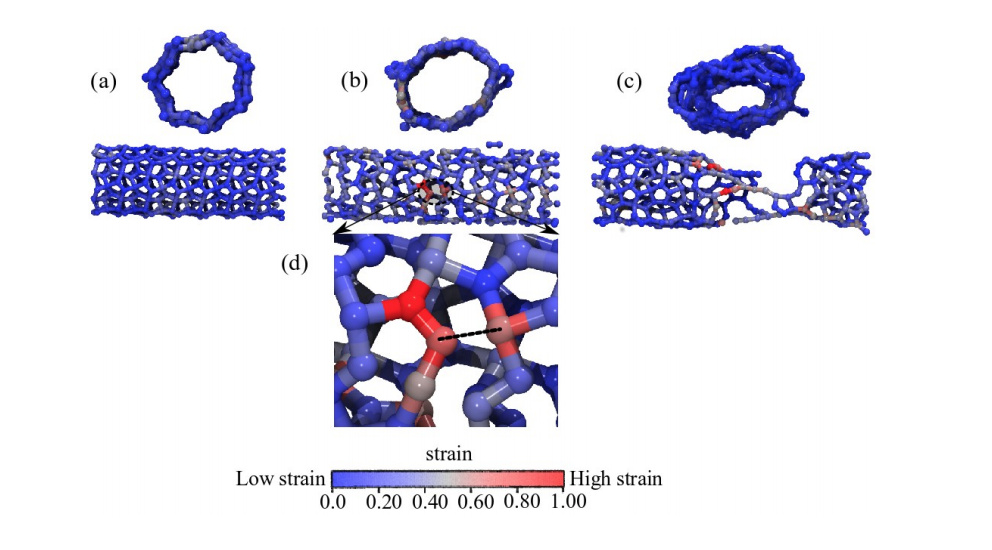
de Sousa, Jose M.; Aguiar, Acrisio L.; Girao, Eduardo C.; Fonseca, Alexandre F.; Antonio G. Souza Filho,; Galvao, Douglas S.
Mechanical Properties of Pentagraphene-based Nanotubes: A Molecular Dynamics Study Online
2018, (preprint arXiv:1801.04269).
Resumo | Links | BibTeX | Tags: Fracture, Molecular Dynamics, pentagraphene
@online{deSousa2018f,
title = {Mechanical Properties of Pentagraphene-based Nanotubes: A Molecular Dynamics Study},
author = {Jose M. de Sousa and Acrisio L. Aguiar and Eduardo C. Girao and Alexandre F. Fonseca and Antonio G. Souza Filho, and Douglas S. Galvao},
url = {https://arxiv.org/abs/1801.04269},
year = {2018},
date = {2018-01-12},
abstract = {The study of the mechanical properties of nanostructured systems has gained importance in theoretical and experimental research in recent years. Carbon nanotubes (CNTs) are one of the strongest nanomaterials found in nature, with Young's Modulus (YM) in the order 1.25 TPa. One interesting question is about the possibility of generating new nanostructures with 1D symmetry and with similar and/or superior CNT properties. In this work, we present a study on the dynamical, structural, mechanical properties, fracture patterns and YM values for one class of these structures, the so-called pentagraphene nanotubes (PGNTs). These tubes are formed rolling up pentagraphene membranes (which are quasi-bidimensional structures formed by densely compacted pentagons of carbon atoms in sp3 and sp2 hybridized states) in the same form that CNTs are formed from rolling up graphene membranes. We carried out fully atomistic molecular dynamics simulations using the ReaxFF force field. We have considered zigzag-like and armchair-like PGNTs of different diameters. Our results show that PGNTs present YM ~ 800 GPa with distinct elastic behavior in relation to CNTs, mainly associated with mechanical failure, chirality dependent fracture patterns and extensive structural reconstructions.},
note = {preprint arXiv:1801.04269},
keywords = {Fracture, Molecular Dynamics, pentagraphene},
pubstate = {published},
tppubtype = {online}
}
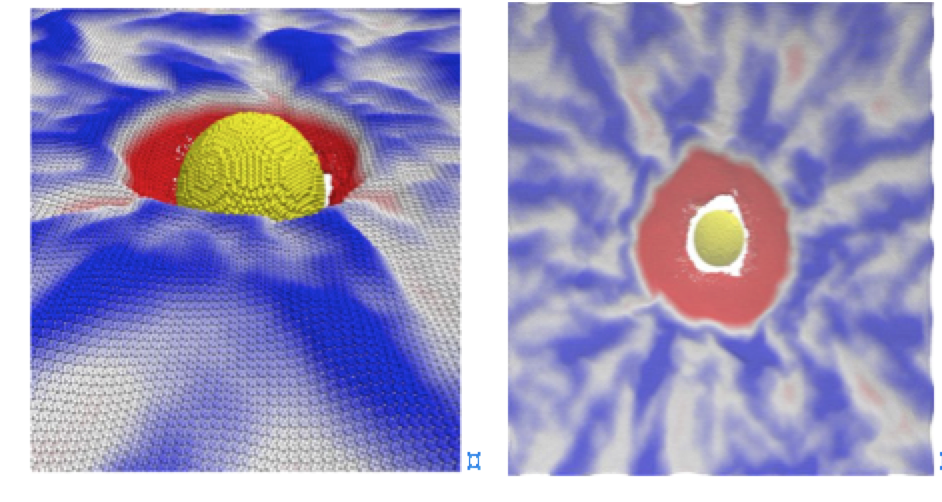
Azevedo, David L.; Bizao, Rafael A.; Galvao, Douglas S.
Molecular Dynamics Simulations of Ballistic Penetration of Pentagraphene Sheets Journal Article
Em: MRS Advances, vol. 3, não 8-9, pp. 431-435, 2018.
Resumo | Links | BibTeX | Tags: Fracture, Molecular Dynamics, pentagraphene
@article{Azevedo2018,
title = {Molecular Dynamics Simulations of Ballistic Penetration of Pentagraphene Sheets},
author = {David L. Azevedo and Rafael A. Bizao and Douglas S. Galvao},
url = {https://www.cambridge.org/core/journals/mrs-advances/article/molecular-dynamics-simulations-of-ballistic-penetration-of-pentagraphene-sheets/8759C0815840EDE83896EF4A17278228},
doi = {https://doi.org/10.1557/adv.2018.61},
year = {2018},
date = {2018-01-06},
journal = {MRS Advances},
volume = {3},
number = {8-9},
pages = {431-435},
abstract = {The search for new materials with low density and superior mechanical properties is a very intense and stimulating investigation area. These new materials could provide potential application for ballistic protection. Recent experiments and simulations revealed graphene possesses exceptional energy absorption properties. In this work, we analysed through fully atomistic molecular dynamics simulations the ballistic performance of a carbon-based material recently proposed named penta-graphene. Our results show that the fracture pattern is more spherical (no petals formation like observed for graphene). The estimated penetration energy for single-layer penta-graphene structures obtained here was d_1penta∼37.7 MJ/kg, and is comparable with recently results obtained for graphene: d_(1graphene)∼29.0 MJ/kg and d_(1graphene)∼40.8 MJ/kg under similar conditions. These preliminary results are suggestive that penta-graphene could be an excellent material for ballistic applications.},
keywords = {Fracture, Molecular Dynamics, pentagraphene},
pubstate = {published},
tppubtype = {article}
}
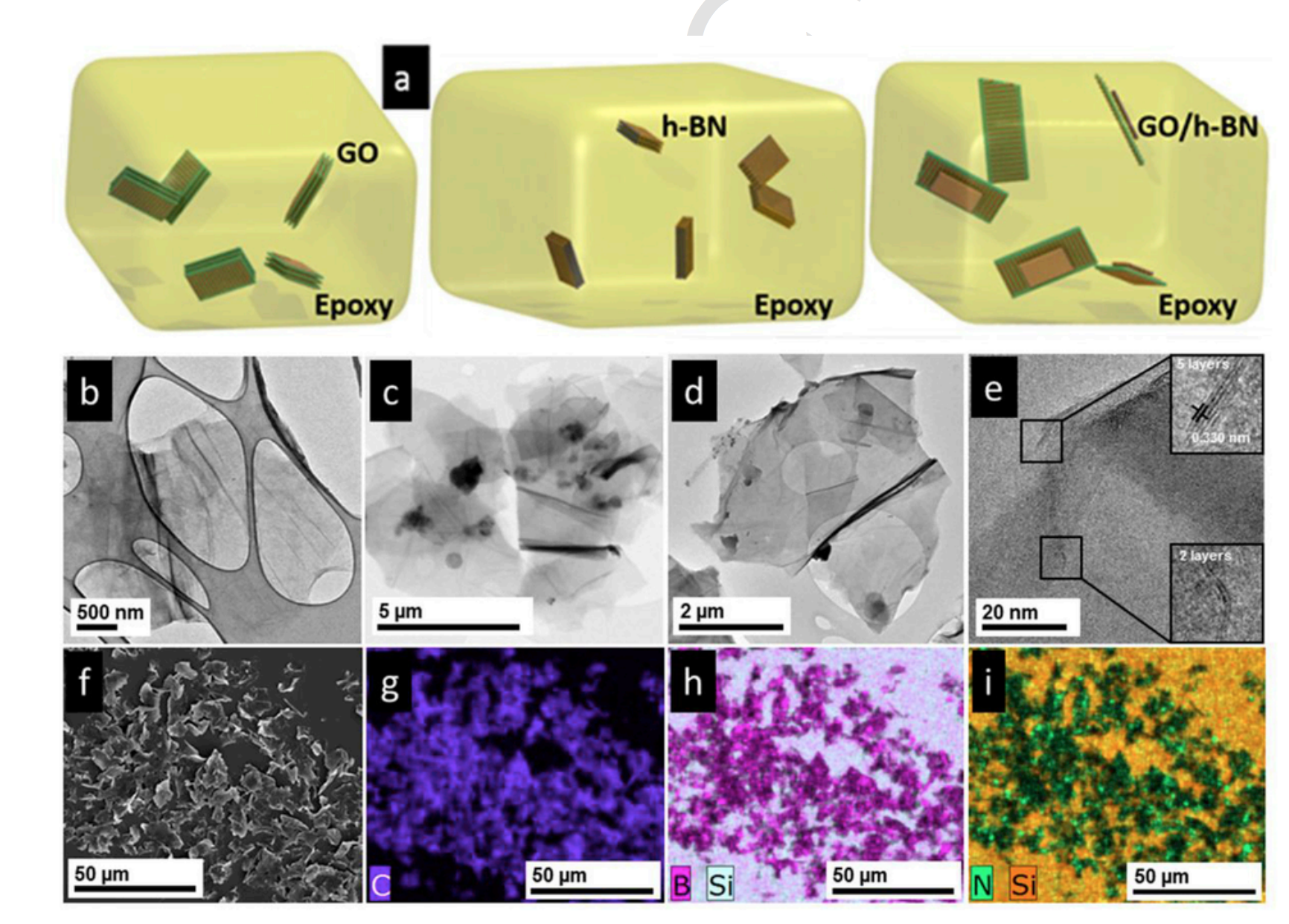
M, Ajayan Pulickel; Woellner, Cristiano F; Owuor, Peter S; Trigueiro, Joao P C; Machado, Leonardo D; Silva, Wellington M; Kosolwattana, Suppanat; Jaques, Ygor M; Silva, Carlos J R; Pedrotti, Jairo; Tiwary, Chandra S; Chipara, Alin C; Galvao, Douglas; Chopra, Nitin; Odeh, Ihab N; Silva, Glaura G.
Hybrid 2D Nanostructures for Mechanical Reinforcement and Thermal Conductivity Enhancement in Polymer Composite Journal Article
Em: Composites Science and Technology, vol. 159, não 5, pp. 103-110, 2018.
Resumo | Links | BibTeX | Tags: Composites, Molecular Dynamics
@article{M2018,
title = {Hybrid 2D Nanostructures for Mechanical Reinforcement and Thermal Conductivity Enhancement in Polymer Composite},
author = {Ajayan Pulickel M and Cristiano F Woellner and Peter S Owuor and Joao P C Trigueiro and Leonardo D Machado and Wellington M Silva and Suppanat Kosolwattana and Ygor M Jaques and Carlos J R Silva and Jairo Pedrotti and Chandra S Tiwary and Alin C Chipara and Douglas Galvao and Nitin Chopra and Ihab N Odeh and Glaura G. Silva
},
doi = {https://doi.org/10.1016/j.compscitech.2018.01.032},
year = {2018},
date = {2018-01-01},
journal = {Composites Science and Technology},
volume = {159},
number = {5},
pages = {103-110},
abstract = {Hexagonal boron nitride (h-BN), graphene oxide (GO) and hybrid (GO/h-BN) nanosheets were employed as fillers in order to enhance the physical properties of the polymer matrix. Composites based in epoxy and these two-dimensional (2D) nanofillers were produced with different wt% and their microstructure, mechanical and thermal properties were investigated. Increases up to 140% in tensile strength, 177% in ultimate strain and 32% in elastic modulus were observed for the hybrid GO/h-BN composite with 0.5 wt% content. The hybrid nanofiller also contributed to the increase up to 142% on thermal conductivity with respect to the pure epoxy for GO/h-BN composite with 2.0 wt% content. Molecular dynamic simulation was used to predict the behavior of possible stacking arrangements between h-BN and GO nanosheets tensioned by normal and shear forces. The results showed that the hybrid GO/h-BN combination can prevent the re-stacking process of exfoliated layers, demonstrating the synergism between these nanostructures with the final effect of better dispersion in the composite material. The excellent thermal and mechanical performance of these hybrid composites en- gineered by the combination of different types of the 2D inorganic nanoparticles make them multifunctional candidates for advanced materials applications.},
keywords = {Composites, Molecular Dynamics},
pubstate = {published},
tppubtype = {article}
}
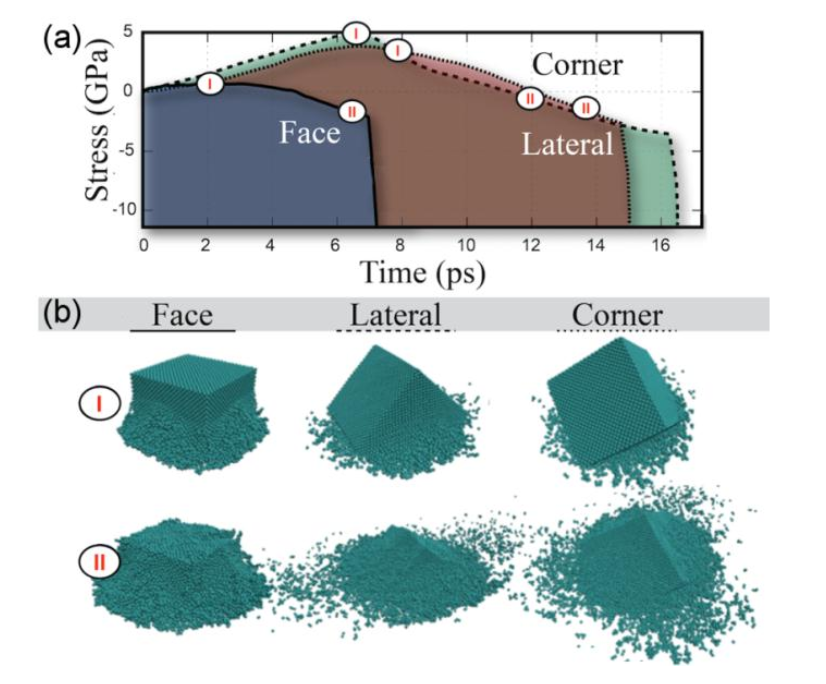
Oliveira, Eliezer Fernando; da Silva Autreto, Pedro Alves; Galvao, Douglas Soares
Silver Hardening via Hypersonic Impacts Journal Article
Em: MRS Advances, vol. 3, não 8-9, pp. 489-494, 2018.
Resumo | Links | BibTeX | Tags: Fracture, impact, Molecular Dynamics, silver
@article{Oliveira2018b,
title = {Silver Hardening via Hypersonic Impacts},
author = {Eliezer Fernando Oliveira and Pedro Alves da Silva Autreto and Douglas Soares Galvao},
url = {https://www.cambridge.org/core/journals/mrs-advances/article/silver-hardening-via-hypersonic-impacts/6A35FAB117B4FD244BBD11A64CD25160},
doi = {DOI: 10.1557/adv.2018. 173},
year = {2018},
date = {2018-01-01},
journal = {MRS Advances},
volume = {3},
number = {8-9},
pages = {489-494},
abstract = {The search for new ultra strong materials has been a very active research area. With relation to metals, a successful way to improve their strength is by the creation of a gradient of nanograins (GNG) inside the material. Recently, R. Thevamaran et al. [Science v354, 312- 316 (2016)] propose a single step method based on high velocity impact of silver nanocubes to produce high-quality GNG. This method consists of producing high impact collisions of silver cubes at hypersonic velocity (~400 m/s) against a rigid wall. Although they observed an improvement in the mechanical properties of the silver after the impact, the GNG creation and the strengthening mechanism at nanoscale remain unclear. In order to gain further insights about these mechanisms, we carried out fully atomistic molecular dynamics simulations (MD) to investigate the atomic conformations/rearrangements during and after high impact collisions of silver nanocubes at ultrasonic velocity. Our results indicate the co- existence of polycrystalline arrangements after the impact formed by core HCP domains surrounded by FCC ones, which could also contribute to explain the structural hardening.},
keywords = {Fracture, impact, Molecular Dynamics, silver},
pubstate = {published},
tppubtype = {article}
}

Oliveira, Eliezer Fernando; Paupitz, Ricardo; da Silva Autreto, Pedro Alves; Moshkalev, Stanislav; Galvao, Douglas Soares
Improving Graphene-metal Contacts: Thermal Induced Polishing Journal Article
Em: MRS Advances, vol. 3, não 1-2, pp. 73-78, 2018.
Resumo | Links | BibTeX | Tags: contacts, Graphene, Molecular Dynamics, thermal properties
@article{Oliveira2018c,
title = {Improving Graphene-metal Contacts: Thermal Induced Polishing },
author = {Eliezer Fernando Oliveira and Ricardo Paupitz and Pedro Alves da Silva Autreto and Stanislav Moshkalev and Douglas Soares Galvao},
url = {https://www.cambridge.org/core/journals/mrs-advances/article/improving-graphenemetal-contacts-thermal-induced-polishing/AC01C4996B90B0EE5E03220604071D12},
doi = {https://doi.org/10.1557/adv.2018.66},
year = {2018},
date = {2018-01-01},
journal = {MRS Advances},
volume = {3},
number = {1-2},
pages = {73-78},
abstract = {Graphene is a very promising material for nanoelectronics applications due to its unique and remarkable electronic and thermal properties. However, when deposited on metallic electrodes the overall thermal conductivity is significantly decreased. This phenomenon has been attributed to the mismatch between the interfaces and contact thermal resistance. Experimentally, one way to improve the graphene/metal contact is thorough high-temperature annealing, but the detailed mechanisms behind these processes remain unclear. In order to address these questions, we carried out fully atomistic reactive molecular dynamics simulations using the ReaxFF force field to investigate the interactions between multi-layer graphene and metallic electrodes (nickel) under (thermal) annealing. Our results show that the annealing induces an upward-downward movement of the graphene layers, causing a pile-driver-like effect over the metallic surface. This graphene induced movements cause a planarization (thermal polishing-like effect) of the metallic surface, which results in the increase of the effective graphene/metal contact area. This can also explain the experimentally observed improvements of the thermal and electric conductivities.},
keywords = {contacts, Graphene, Molecular Dynamics, thermal properties},
pubstate = {published},
tppubtype = {article}
}
2017
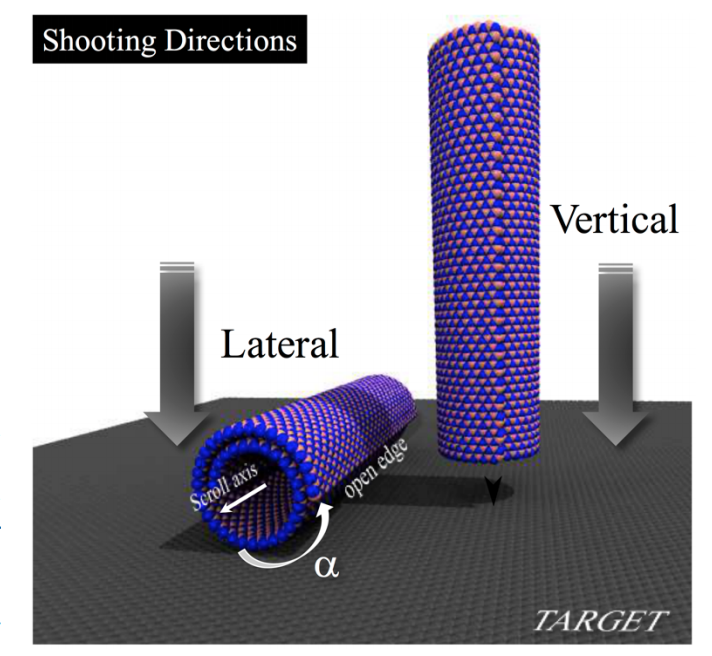
Leonardo D Machado Cristiano F Woellner, Pedro AS Autreto; Galvao, Douglas S
Structural Transformations of Carbon and Boron Nitride Nanoscrolls at High Impact Collisions Online
2017, (preprint ArXiv:1711.00378).
Resumo | Links | BibTeX | Tags: Fracture, impacts, Molecular Dynamics, Scrolls
@online{Woellner2017,
title = {Structural Transformations of Carbon and Boron Nitride Nanoscrolls at High Impact Collisions},
author = {Cristiano F Woellner, Leonardo D Machado, Pedro AS Autreto, Jose M de Sousa, and Douglas S Galvao},
url = {https://arxiv.org/pdf/1711.00378.pdf},
year = {2017},
date = {2017-11-01},
abstract = {The behavior of nanostructures under high strain-rate conditions has been object of theoretical and experimental investigations in recent years. For instance, it has been shown that carbon and boron nitride nanotubes can be unzipped into nanoribbons at high velocity impacts. However, the response of many nanostructures to high strain-rate conditions is still not completely understood. In this work we have investigated through fully atomistic reactive (ReaxFF) molecular dynamics (MD) simulations the mechanical behavior of carbon (CNS) and boron nitride nanoscrolls (BNS) colliding against solid targets at high velocities,. CNS (BNS) nanoscrolls are graphene (boron nitride) membranes rolled up into papyrus-like
structures. Their open-ended topology leads to unique properties not found in close-ended analogues, such as nanotubes.Our results show that the collision products are mainly determined by impact velocities and by two impact angles, which
define the position of the scroll (i) axis and (ii) open edge relative to the target. Our MD results showed that for appropriate velocities and orientations large-scale deformations and nanoscroll fracture can occur. We also observed unscrolling (scrolls going back to quasi-planar membranes), scroll unzipping into nanoribbons, and significant
reconstruction due to breaking and/or formation of new chemical bonds. For particular edge orientations and velocities, conversion from open to close-ended topology is also possible, due to the fusion of nanoscroll walls.},
note = {preprint ArXiv:1711.00378},
keywords = {Fracture, impacts, Molecular Dynamics, Scrolls},
pubstate = {published},
tppubtype = {online}
}
structures. Their open-ended topology leads to unique properties not found in close-ended analogues, such as nanotubes.Our results show that the collision products are mainly determined by impact velocities and by two impact angles, which
define the position of the scroll (i) axis and (ii) open edge relative to the target. Our MD results showed that for appropriate velocities and orientations large-scale deformations and nanoscroll fracture can occur. We also observed unscrolling (scrolls going back to quasi-planar membranes), scroll unzipping into nanoribbons, and significant
reconstruction due to breaking and/or formation of new chemical bonds. For particular edge orientations and velocities, conversion from open to close-ended topology is also possible, due to the fusion of nanoscroll walls.
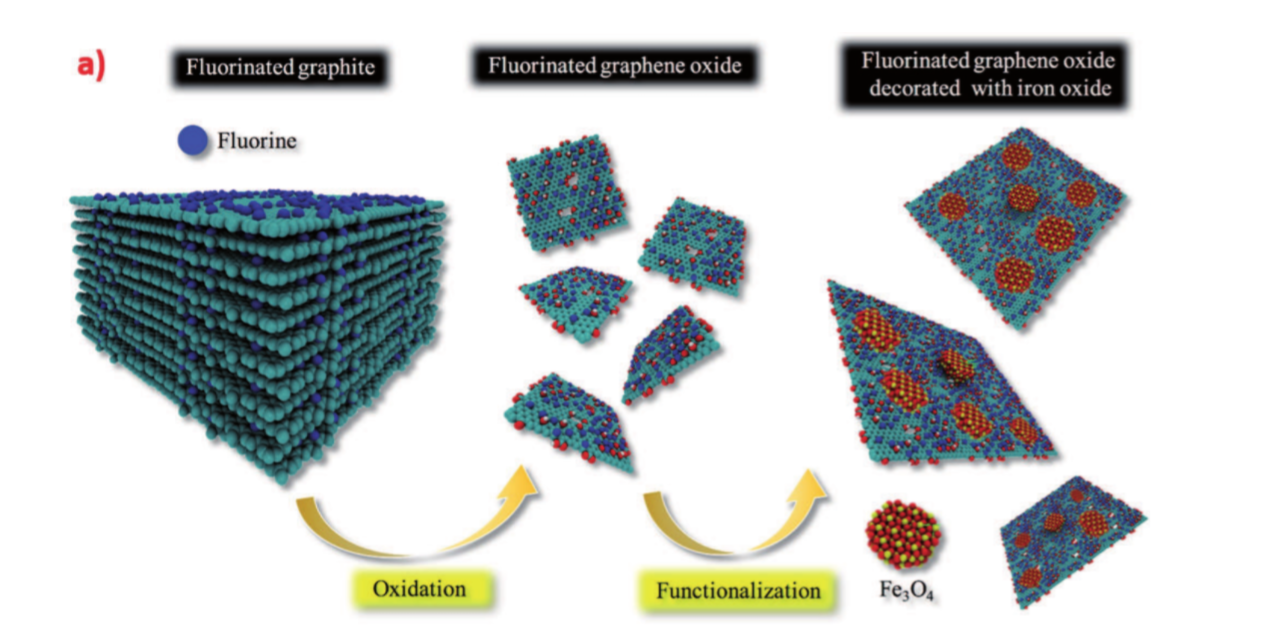
Parambath M Sudeep Sruthi Radhakrishnan, Jun Hyoung Park; Ajayan, Pulickel M
Multifunctional Hybrids Based on 2D Fluorinated Graphene Oxide and Superparamagnetic Iron Oxide Nanoparticles Journal Article
Em: Particle & Particle Systems Characterization, vol. 34, não 11, pp. 1700245, 2017.
Resumo | Links | BibTeX | Tags: Modeling, Nanoparticles
@article{Radhakrishnan2017,
title = {Multifunctional Hybrids Based on 2D Fluorinated Graphene Oxide and Superparamagnetic Iron Oxide Nanoparticles},
author = {Sruthi Radhakrishnan, Parambath M Sudeep, Jun Hyoung Park, Cristiano F Woellner, Kierstein Maladonado, Douglas S Galvao, Benny Abraham Kaipparettu, Chandra Sekhar Tiwary, and Pulickel M Ajayan},
url = {http://onlinelibrary.wiley.com/doi/10.1002/ppsc.201700245/full},
doi = {DOI: 10.1002/ppsc.201700245},
year = {2017},
date = {2017-11-01},
journal = {Particle & Particle Systems Characterization},
volume = {34},
number = {11},
pages = {1700245},
abstract = {Carbon-based nanomaterials have garnered a lot of attention in the research of yesteryear. Here this study reports a composite based on fluorinated graphene oxide—a multifunctional subsidiary of graphene; and iron oxide nanoparticles as a contrast agent for magnetic resonance imaging (MRI). Extensive structural and functional characterization is carried out to understand composite behavior toward biotoxicity and its performance as a contrast agent. The electron withdrawing fluorine group decreases the charge transfer to iron oxide increasing the magnetic saturation of the composite thus enhancing the contrast. The interaction of paramagnetic and superparamagnetic systems yields a superior contrast agent for MRI and fluorescent imaging.},
keywords = {Modeling, Nanoparticles},
pubstate = {published},
tppubtype = {article}
}
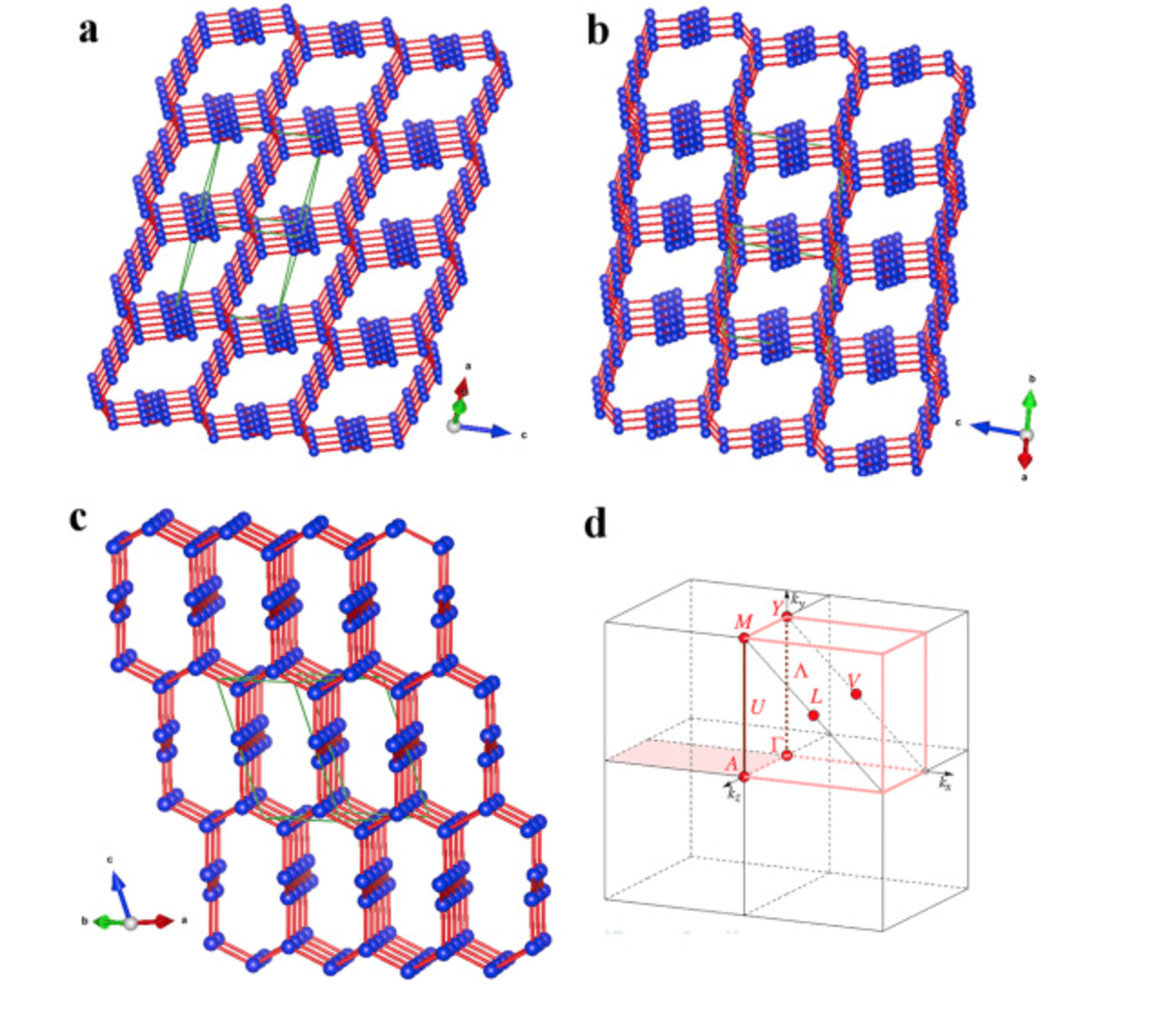
Han, Yang; Zhou, Yanguang; Qin, Guangzhao; Dong, Jinming; Galvao, Douglas S; Hu, Ming
Unprecedented mechanical response of the lattice thermal conductivity of auxetic carbon crystals Journal Article
Em: Carbon, vol. 122, pp. 374-380, 2017.
Resumo | Links | BibTeX | Tags: Auxetics, DFT, Thermal, Tubulanes
@article{Han2017,
title = {Unprecedented mechanical response of the lattice thermal conductivity of auxetic carbon crystals},
author = {Han, Yang and Zhou, Yanguang and Qin, Guangzhao and Dong, Jinming and Galvao, Douglas S and Hu, Ming},
url = {http://www.sciencedirect.com/science/article/pii/S0008622317306760},
doi = {10.1016/j.carbon.2017.06.100},
year = {2017},
date = {2017-10-01},
journal = {Carbon},
volume = {122},
pages = {374-380},
abstract = {Lattice thermal conductivity (κ) of bulk materials usually increases under compression and decreases under tension, while there are still some unusual systems, exhibiting reduced κ when compressed. However, to date it has never been reported for a bulk material, whose κ is substantially enhanced under tensile strain. In this paper, we have studied thermal transport of three auxetic carbon crystals: cis-C, trans-C and hin-C for short, and their strain responses by performing first-principles calculations. It is intriguing to find that their κ are much lower than those of their allotropes, and further decrease abnormally under compression. More strikingly, κ of trans-C (cis-C) anomalously increases with tensile strain up to 7% (6%) with maximum κ of almost 7 (5) times larger than the unstrained value. The abnormal strain dependent κ are attributed to the dominant role of the enhancement of phonon lifetime under stretching, which can be further explained from the unique atomic structure of the main chain of polydiacetylene in trans-C and cis-C. The weakening of phonon anharmonicity is reflected by the enhancement of root mean-square displacement values. The reported giant augmentation of κ may inspire intensive research on auxetic carbon crystals as potential materials for emerging nanoelectronic devices.},
keywords = {Auxetics, DFT, Thermal, Tubulanes},
pubstate = {published},
tppubtype = {article}
}
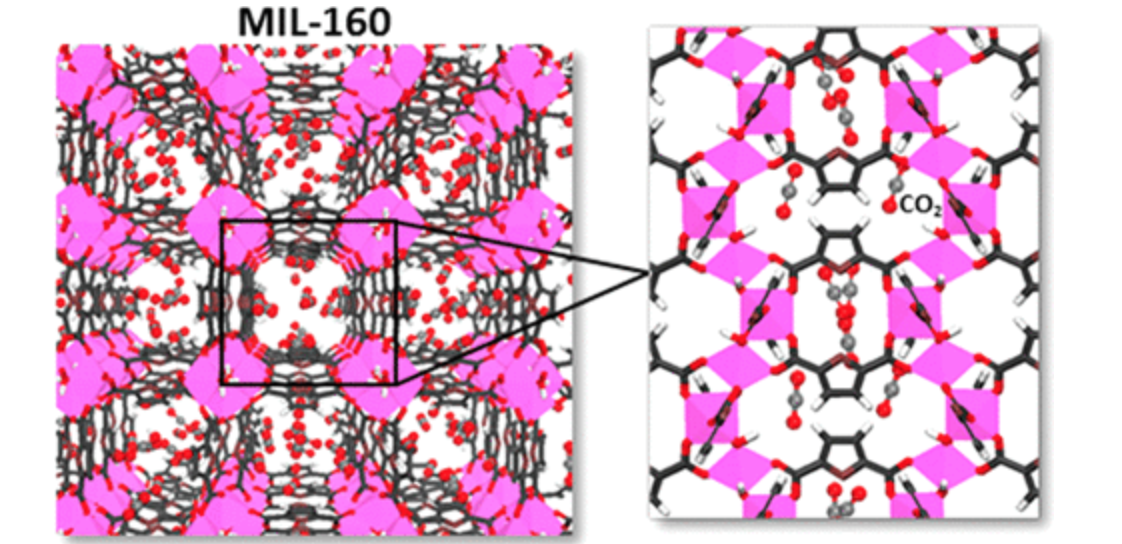
BORGES, Daiane DAMASCENO; NORMAND, Perine; PERMIAKOVA, Anastasia; BABARAO, Ravichandar; HEYMANS, Nicolas; GALVAO, Douglas S.; SERRE, Christian; WEIRELD, Guy DE; MAURIN, Guillaume
Gas Adsorption and Separation by the Al-based Metal-Organic Framework MIL-160 Journal Article
Em: Journal of Physical Chemistry C, vol. 121, não 48, pp. 26822–26832, 2017.
Resumo | Links | BibTeX | Tags: MOFs, Simulation
@article{BORGES2017b,
title = {Gas Adsorption and Separation by the Al-based Metal-Organic Framework MIL-160},
author = {Daiane DAMASCENO BORGES and Perine NORMAND and Anastasia PERMIAKOVA and Ravichandar BABARAO and Nicolas HEYMANS and Douglas S. GALVAO and Christian SERRE and Guy DE WEIRELD and Guillaume MAURIN},
url = {http://pubs.acs.org/doi/abs/10.1021/acs.jpcc.7b08856},
doi = {DOI: 10.1021/acs.jpcc.7b08856},
year = {2017},
date = {2017-09-14},
journal = {Journal of Physical Chemistry C},
volume = {121},
number = {48},
pages = {26822–26832},
abstract = {One of the most promising technologies, with a low energy penalty, for CO2 capture from diverse gas mixtures is based on the adsorption process using adsorbents. Many efforts are still currently deployed to search for water stable porous metal–organic frameworks (MOFs) with high CO2 affinity combined with large CO2 uptake. In this context, we have selected the water stable and easily scalable Al-based MOF MIL-160 showing an ultramicroporosity and potential interacting sites (hydroxyl and furan), both features being a priori relevant to favor the selective adsorption of CO2 over other gases including H2, N2, CH4, and CO. Density functional theory (DFT) and force-field-based grand-canonical Monte Carlo (GCMC) simulations were first coupled to predict the strength of host/guest interactions and the adsorption isotherms for all guests as single components and binary mixtures. This computational approach reveals the promises of this solid for the selective adsorption of CO2 with respect to these other investigated gases, controlled by a combination of thermodynamics and confinement effects. These predicted performances were further supported by real-coadsorption measurements performed on shaped samples which indicated that MIL-160(Al) shows promising performance for the selective CO2 capture in post- and pre-combustion conditions.},
keywords = {MOFs, Simulation},
pubstate = {published},
tppubtype = {article}
}
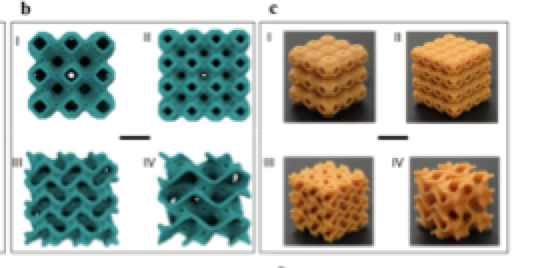
Sajadi, Seyed Mohammad; Owuor, Peter Samora; Schara, Steven; Woellner, Cristiano F.; Rodrigues, Varlei; Vajtai, Robert; Lou, Jun; Galvao, Douglas S.; Tiwary, Chandra Sekhar; Ajayan, Pulickel M.
Multi-scale Geometric Design Principles Applied to 3D Printed Schwartizes Journal Article
Em: Advanced Materials, vol. 2017, pp. 1704820, 2017.
Resumo | Links | BibTeX | Tags: 3D printing, Mechanical Properties, Molecular Dynamics, Schwarzites
@article{Sajadi2017,
title = {Multi-scale Geometric Design Principles Applied to 3D Printed Schwartizes},
author = {Seyed Mohammad Sajadi and Peter Samora Owuor and Steven Schara and Cristiano F. Woellner and Varlei Rodrigues and Robert Vajtai and Jun Lou and Douglas S. Galvao and Chandra Sekhar Tiwary and Pulickel M. Ajayan},
url = {http://onlinelibrary.wiley.com/doi/10.1002/adma.201704820/full},
doi = {10.1002/adma.201704820},
year = {2017},
date = {2017-09-14},
journal = {Advanced Materials},
volume = {2017},
pages = {1704820},
abstract = {Schwartzites are 3D porous solids with periodic minimal surfaces having negative Gaussian curvatures and can possess unusual mechanical and electronic properties. The mechanical behavior of primitive and gyroid schwartzite structures across different length scales is investigated after these geometries are 3D printed at centimeter length scales based on molec- ular models. Molecular dynamics and nite elements simulations are used
to gain further understanding on responses of these complex solids under compressive loads and kinetic impact experiments. The results show that these structures hold great promise as high load bearing and impact-resistant materials due to a unique layered deformation mechanism that emerges in these architectures during loading. Easily scalable techniques such as 3D printing can be used for exploring mechanical behavior of various predicted complex geometrical shapes to build innovative engineered materials with tunable properties.},
keywords = {3D printing, Mechanical Properties, Molecular Dynamics, Schwarzites},
pubstate = {published},
tppubtype = {article}
}
to gain further understanding on responses of these complex solids under compressive loads and kinetic impact experiments. The results show that these structures hold great promise as high load bearing and impact-resistant materials due to a unique layered deformation mechanism that emerges in these architectures during loading. Easily scalable techniques such as 3D printing can be used for exploring mechanical behavior of various predicted complex geometrical shapes to build innovative engineered materials with tunable properties.
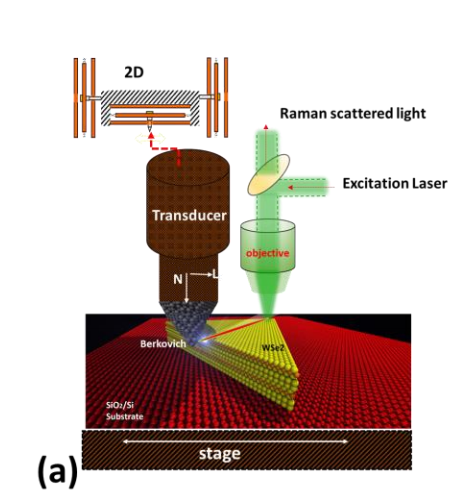
Manimunda, P; Nakanishi, Y; Jaques, YM; Susarla, S; Woellner, CF; Bhowmick, S; Asif, SAS; Galvao, DS; Tiwary, CS; Ajayan, PM
Nanoscale deformation and friction characteristics of atomically thin WSe2 and heterostructure using nanoscratch and Raman spectroscopy Journal Article
Em: 2D Materials, vol. 4, não 4, pp. 045005, 2017.
Resumo | Links | BibTeX | Tags: Chalcogenides, Heterostructures, Molecular Dynamics
@article{Manimunda2017,
title = {Nanoscale deformation and friction characteristics of atomically thin WSe2 and heterostructure using nanoscratch and Raman spectroscopy},
author = {Manimunda, P and Nakanishi, Y and Jaques, YM and Susarla, S and Woellner, CF and Bhowmick, S and Asif, SAS and Galvao, DS and Tiwary, CS and Ajayan, PM},
url = {http://iopscience.iop.org/article/10.1088/2053-1583/aa8475/meta},
doi = {10.1088/2053-1583/aa8475},
year = {2017},
date = {2017-08-23},
journal = {2D Materials},
volume = {4},
number = {4},
pages = {045005},
abstract = {2D transition metals di-selenides are attracting a lot of attention due to their interesting optical, chemical and electronics properties. Here, the deformation characteristics of monolayer, multi- layer WSe2 and its heterostructure with MoSe2 were investigated using a new technique that combines nanoscratch and Raman spectroscopy. The 2D monolayer WSe2 showed anisotropy in deformation. Effect of number of WSe2 layers on friction characteristics were explored in detail. Experimental observations were further supported by MD simulations. Raman spectra recorded from the scratched regions showed strain induced degeneracy splitting. Further nano-scale scratch tests were extended to MoSe2–WSe2 lateral heterostructures. Effect of deformation on lateral hetero junctions were further analysed using PL and Raman spectroscopy. This new technique is completely general and can be applied to study other 2D materials.},
keywords = {Chalcogenides, Heterostructures, Molecular Dynamics},
pubstate = {published},
tppubtype = {article}
}
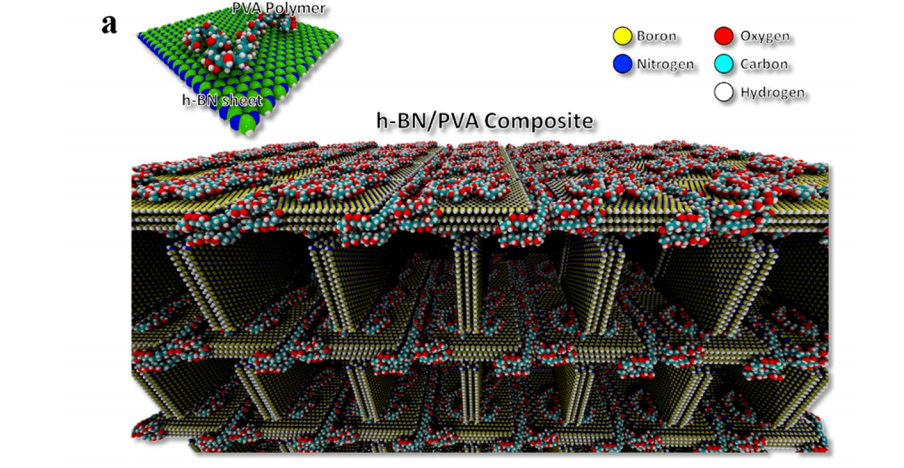
Owuor, Peter Samora; Park, Ok-Kyung; Woellner, Cristiano F; Jalilov, Almaz S; Susarla, Sandhya; Joyner, Jarin; Ozden, Sehmus; Duy, LuongXuan; Villegas Salvatierra, Rodrigo; Vajtai, Robert; Tour, James M; Lou, Jun; Galvao, Douglas S; Tiwary, Chandra S; Ajayan, P M
Lightweight Hexagonal Boron Nitride Foam for CO2 Absorption Journal Article
Em: ACS Nano, vol. 11, não 8, pp. 8944–8952, 2017.
Resumo | Links | BibTeX | Tags: foams, Mechanical Properties, Molecular Dynamics
@article{Owuor2017b,
title = {Lightweight Hexagonal Boron Nitride Foam for CO2 Absorption},
author = {Owuor, Peter Samora and Park, Ok-Kyung and Woellner, Cristiano F and Jalilov, Almaz S and Susarla, Sandhya and Joyner, Jarin and Ozden, Sehmus and Duy, LuongXuan and Villegas Salvatierra, Rodrigo and Vajtai, Robert and Tour, James M and Lou, Jun and Galvao, Douglas S and Tiwary, Chandra S and Ajayan, P M},
url = {http://pubs.acs.org/doi/abs/10.1021/acsnano.7b03291},
doi = {10.1021/acsnano.7b03291},
year = {2017},
date = {2017-08-03},
journal = {ACS Nano},
volume = {11},
number = {8},
pages = {8944–8952},
abstract = {Weak van der Waals forces between inert hexagonal boron nitride (h-BN) nanosheets make it easy for them to slide over each other, resulting in an unstable structure in macroscopic dimensions. Creating interconnections between these inert nanosheets can remarkably enhance their mechanical properties. However, controlled design of such interconnections remains a fundamental problem for many applications of h-BN foams. In this work, a scalable in situ freeze-drying synthesis of low-density, lightweight 3D macroscopic structures made of h-BN nanosheets chemically connected by poly(vinyl alcohol) (PVA) molecules via chemical cross-link is demonstrated. Unlike pristine h-BN foam which disintegrates upon handling after freeze-drying, h-BN/PVA foams exhibit stable mechanical integrity in addition to high porosity and large surface area. Fully atomistic simulations are used to understand the interactions between h-BN nanosheets and PVA molecules. In addition, the h-BN/PVA foam is investigated as a possible CO2 absorption and as laser irradiation protection material.
},
keywords = {foams, Mechanical Properties, Molecular Dynamics},
pubstate = {published},
tppubtype = {article}
}
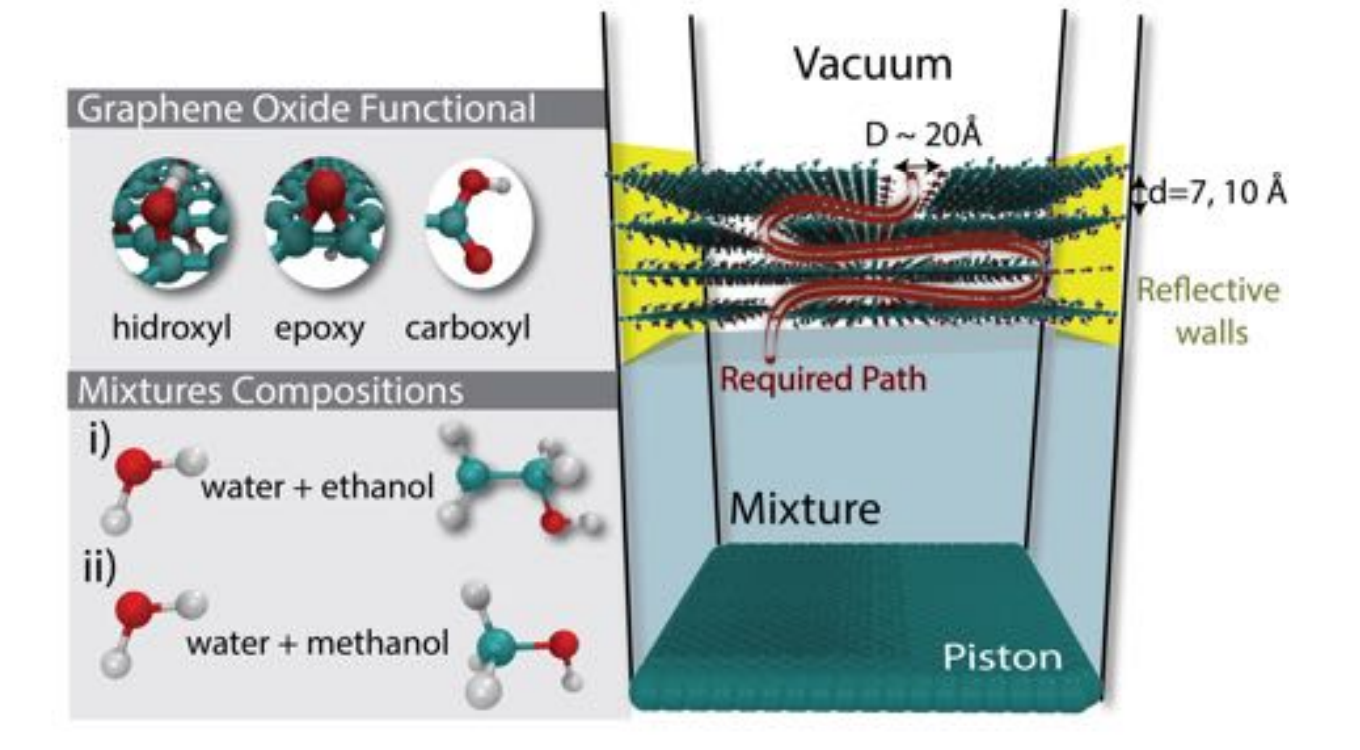
Borges, Daiane Damasceno; Woellner, Cristiano F; Autreto, Pedro AS; Galvao, Douglas S
2017, (preprint arXiv:1702.00250).
Resumo | Links | BibTeX | Tags: Filtration, Graphene Membranes, Molecular Dyanmics
@online{Borges2017b,
title = {Insights on the mechanism of water-alcohol separation in multilayer graphene oxide membranes: entropic versus enthalpic factors},
author = {Borges, Daiane Damasceno and Woellner, Cristiano F and Autreto, Pedro AS and Galvao, Douglas S},
url = {https://arxiv.org/abs/1706.06213},
year = {2017},
date = {2017-06-19},
abstract = {Experimental evidences have shown that graphene oxide (GO) can be impermeable to liquids, vapors and gases, while it allows a fast permeation of water molecules. The understanding of filtration mechanisms came mostly from studies dedicated to water desalination, while very few works have been dedicated to distilling alcohols. In this work, we have investigated the molecular level mechanism underlying the alcohol/water separation inside GO membranes. A series of molecular dynamics and Grand-Canonical Monte Carlo simulations were carried out to probe the ethanol/water and methanol/water separation through GO membranes composed of multiple layered graphene-based sheets with different interlayer distance values and number of oxygen-containing functional groups. Our results show that the size exclusion and membrane affinities are not sufficient to explain the selectivity. Besides that, the favorable water molecular arrangement inside GO 2D-channels forming a robust H-bond network and the fast water diffusion are crucial for an effective separation mechanism. In other words, the separation phenomenon is not only governed by affinities with the membrane (enthalpic mechanisms) but mainly by the geometry and size factors (entropic mechanisms). We verified that the 2D geometry channel with optimal interlayer distance are key factors for designing more efficient alcohol-water separation membranes. Our findings are consistent with the available experimental data and contribute to clarify important aspects of the separation behavior of confined alcohol/water in GO membranes.},
note = {preprint arXiv:1702.00250},
keywords = {Filtration, Graphene Membranes, Molecular Dyanmics},
pubstate = {published},
tppubtype = {online}
}

Miyazaki, Celina M; Maria, Marco AE; Borges, Daiane Damasceno; Woellner, Cristiano F; Brunetto, Gustavo; Fonseca, Alexandre F; Constantino, Carlos JL; Pereira-da-Silva, Marcelo A; de Siervo, Abner; Galvao, Douglas S; Riul Jr., Antonio
2017, (preprint arXiv:1702.00250).
Resumo | Links | BibTeX | Tags: Graphene, Molecular Dynamics, Polymers
@online{Miyazaki2017,
title = {Synthesis, characterization and computational simulation of graphene nanoplatelets stabilized in poly (styrene sulfonate) sodium salt},
author = {Miyazaki, Celina M and Maria, Marco AE and Borges, Daiane Damasceno and Woellner, Cristiano F and Brunetto, Gustavo and Fonseca, Alexandre F and Constantino, Carlos JL and Pereira-da-Silva, Marcelo A and de Siervo, Abner and Galvao, Douglas S and Riul Jr., Antonio},
url = {https://arxiv.org/abs/1705.10673},
year = {2017},
date = {2017-05-30},
abstract = {The production of large area interfaces and the use of scalable methods to build-up designed nanostructures generating advanced functional properties are of high interest for many materials science applications. Nevertheless, large area coverage remains a major problem for pristine graphene and here we present a hybrid, composite graphene-like material soluble in water, which can be exploited in many areas, such as energy storage, electrodes fabrication, selective membranes and biosensing. Graphene oxide (GO) was produced by the traditional Hummers method being further reduced in the presence of poly(styrene sulfonate) sodium salt (PSS), thus creating stable reduced graphene oxide (rGO) nanoplateles wrapped by PSS (GPSS). Molecular dynamics simulations were carried out of further clarify the interactions between PSS molecules and rGO nanoplatelets, with calculations supported by FTIR analysis. The intermolecular forces between rGO nanoplatelets and PSS lead to the formation of a hybrid material (GPSS) stabilized by van der Waals forces, allowing the fabrication of high quality layer-by-layer (LbL) films with polyalillamine hydrochloride (PAH). Raman and electrical characterizations corroborated the successful modifications in the electronic structures from GO to GPSS after the chemical treatment, resulting in (PAH/GPSS) LbL films four orders of magnitude more conductive than (PAH/GO).
},
note = {preprint arXiv:1702.00250},
keywords = {Graphene, Molecular Dynamics, Polymers},
pubstate = {published},
tppubtype = {online}
}
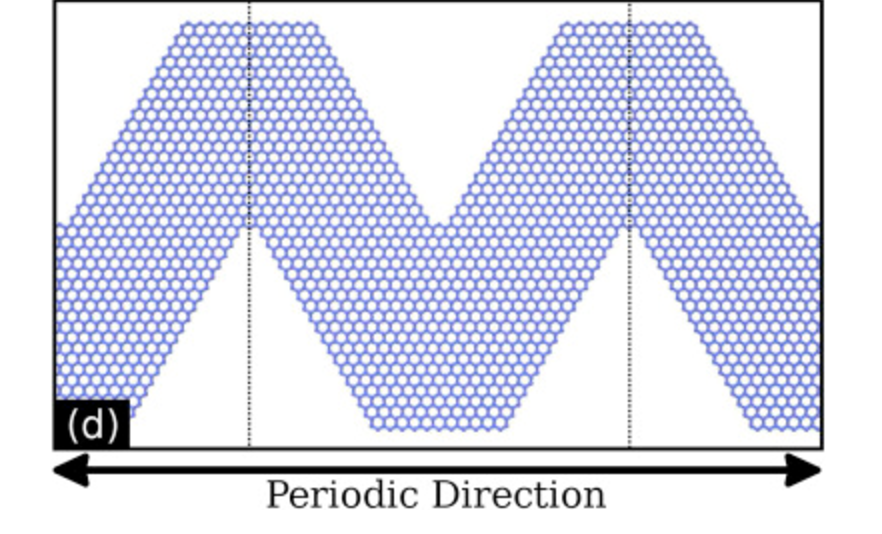
Bizao, Rafael A; Botari, Tiago; Perim, Eric; Pugno, Nicola M; Galvao, Douglas S
Mechanical properties and fracture patterns of graphene (graphitic) nanowiggles Journal Article
Em: Carbon, vol. 119, pp. 431-437, 2017, (See also ArxIv version: https://arxiv.org/abs/1702.01100).
Resumo | Links | BibTeX | Tags: Graphene, Molecular Dynamics, NanoRibbons, Nanowiggles
@article{Bizao2017b,
title = {Mechanical properties and fracture patterns of graphene (graphitic) nanowiggles},
author = {Bizao, Rafael A and Botari, Tiago and Perim, Eric and Pugno, Nicola M and Galvao, Douglas S},
url = {http://www.sciencedirect.com/science/article/pii/S0008622317303743},
doi = {10.1016/j.carbon.2017.04.018},
year = {2017},
date = {2017-04-14},
journal = {Carbon},
volume = {119},
pages = {431-437},
abstract = {Graphene nanowiggles (GNW) are graphene-based nanostructures obtained by making alternated regular cuts in pristine graphene nanoribbons. GNW were recently synthesized and it was demonstrated that they exhibit tunable electronic and magnetic properties by just varying their shape. Here, we have investigated the mechanical properties and fracture patterns of a large number of GNW of different shapes and sizes using fully atomistic reactive molecular dynamics simulations. Our results show that the GNW mechanical properties are strongly dependent on its shape and size and, as a general trend narrow sheets have larger ultimate strength and Young's modulus than wide ones. The estimated Young's modulus values were found to be in a range of ≈100−1000 GPa and the ultimate strength in a range of ≈20−110 GPa, depending on GNW shape. Also, super-ductile behavior under strain was observed for some structures.},
note = {See also ArxIv version: https://arxiv.org/abs/1702.01100},
keywords = {Graphene, Molecular Dynamics, NanoRibbons, Nanowiggles},
pubstate = {published},
tppubtype = {article}
}
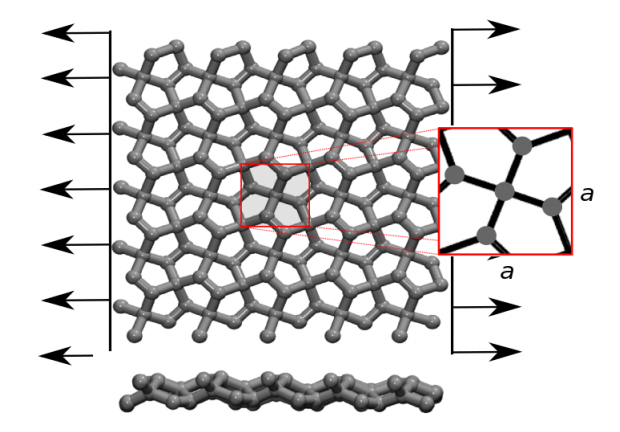
de Sousa, JM; Aguiar, AL; Girao, EC; Fonseca, Alexandre F; AG Filho, Souza; Galvao, Douglas S
Mechanical Properties and Fracture Patterns of Pentagraphene Membranes Online
2017, (preprint arXiv:1703.03789).
Resumo | Links | BibTeX | Tags: DFT, Mechanical Properties, Molecular Dynamics, pentagraphene
@online{deSousa2017,
title = {Mechanical Properties and Fracture Patterns of Pentagraphene Membranes},
author = {de Sousa, JM and Aguiar, AL and Girao, EC and Fonseca, Alexandre F and AG Filho, Souza and Galvao, Douglas S},
url = {https://arxiv.org/abs/1703.03789},
year = {2017},
date = {2017-03-10},
abstract = {Recently, a new two-dimensional carbon allotrope called pentagraphene (PG) was
proposed. PG exhibits mechanical and electronic interesting properties, including typical
band gap values of semiconducting materials. PG has a Cairo-tiling-like 2D lattice
of non coplanar pentagons and its mechanical properties have not been yet fully investigated.
In this work, we combined density functional theory (DFT) calculations and
reactive molecular dynamics (MD) simulations to investigate the mechanical properties
and fracture patterns of PG membranes under tensile strain. We show that PG
membranes can hold up to 20% of strain and that fracture occurs only after substantial
dynamical bond breaking and the formation of 7, 8 and 11 carbon rings and carbon
chains. The stress-strain behavior was observed to follow two regimes, one exhibiting linear elasticity followed by a plastic one, involving carbon atom re-hybridization with
the formation of carbon rings and chains. Our results also show that mechanically
induced structural transitions from PG to graphene is unlikely to occur, in contrast to
what was previously speculated in the literature.},
note = {preprint arXiv:1703.03789},
keywords = {DFT, Mechanical Properties, Molecular Dynamics, pentagraphene},
pubstate = {published},
tppubtype = {online}
}
proposed. PG exhibits mechanical and electronic interesting properties, including typical
band gap values of semiconducting materials. PG has a Cairo-tiling-like 2D lattice
of non coplanar pentagons and its mechanical properties have not been yet fully investigated.
In this work, we combined density functional theory (DFT) calculations and
reactive molecular dynamics (MD) simulations to investigate the mechanical properties
and fracture patterns of PG membranes under tensile strain. We show that PG
membranes can hold up to 20% of strain and that fracture occurs only after substantial
dynamical bond breaking and the formation of 7, 8 and 11 carbon rings and carbon
chains. The stress-strain behavior was observed to follow two regimes, one exhibiting linear elasticity followed by a plastic one, involving carbon atom re-hybridization with
the formation of carbon rings and chains. Our results also show that mechanically
induced structural transitions from PG to graphene is unlikely to occur, in contrast to
what was previously speculated in the literature.
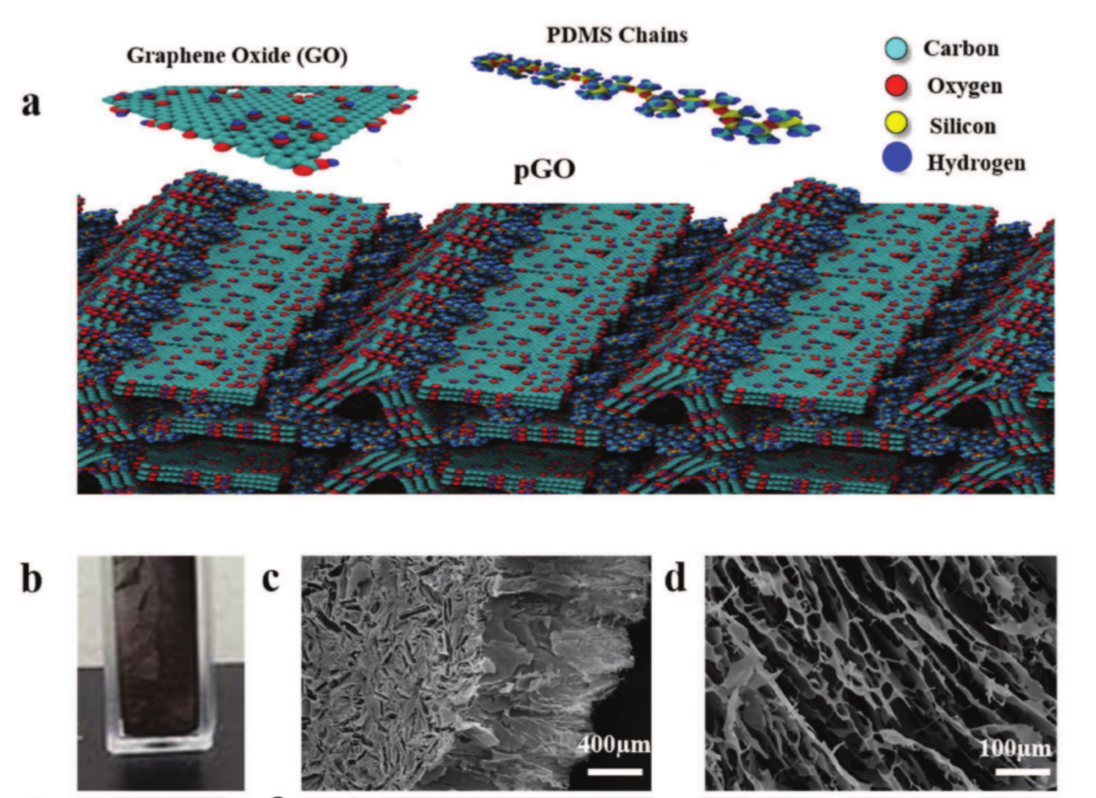
Cristiano F Woellner Peter Samora Owuor, Tong Li
High Toughness in Ultralow Density Graphene Oxide Foam Journal Article
Em: Advanced Materials Interfaces, vol. 4, não 10, pp. 1700030, 2017.
Resumo | Links | BibTeX | Tags: foams, graphene oxide, Mechanical Properties, Molecular Dynamics
@article{Owuor2017,
title = {High Toughness in Ultralow Density Graphene Oxide Foam},
author = {Peter Samora Owuor, Cristiano F Woellner, Tong Li, Soumya Vinod, Sehmus Ozden, Suppanat Kosolwattana, Sanjit Bhowmick, Luong Xuan Duy, Rodrigo V Salvatierra, Bingqing Wei, Syed AS Asif, James M Tour, Robert Vajtai, Jun Lou, Douglas S Galvão, Chandra Sekhar Tiwary, Pulickel Ajayan},
url = {http://onlinelibrary.wiley.com/doi/10.1002/admi.201700030/abstract },
doi = {10.1002/admi.201700030},
year = {2017},
date = {2017-03-01},
journal = {Advanced Materials Interfaces},
volume = {4},
number = {10},
pages = {1700030},
abstract = {Here, the scalable synthesis of low-density 3D macroscopic structure of graphene oxide (GO) interconnected with polydimethylsiloxane (PDMS) is reported. A controlled amount of PDMS is infused into the freeze-dried foam to result into a very rigid structure with improved mechanical properties, such as tensile plasticity and toughness. The PDMS wets the graphene oxide sheets and acts like glue between the 2D sheets. Molecular dynamics simulations are used to further elucidate the mechanisms of the interactions of graphene oxide layers with PDMS. The ability of using the interconnecting graphene oxide foam as an effective oil–water separator and stable insulating behavior to elevated temperatures are further demonstrated. The structural rigidity of the sample is also tested using laser impact and compared with GO foam.},
keywords = {foams, graphene oxide, Mechanical Properties, Molecular Dynamics},
pubstate = {published},
tppubtype = {article}
}
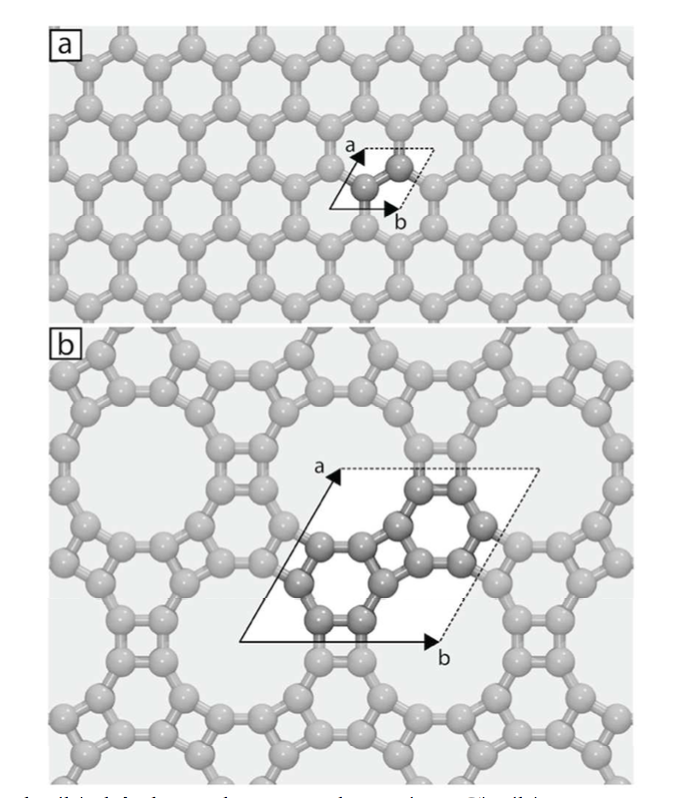
Splugues, Vinicius; da Silva Autreto, Pedro Alves; Galvao, Douglas S
Hydrogenation Dynamics of Biphenylene Carbon (Graphenylene) Membranes Journal Article
Em: MRS Advances, vol. 2017, pp. 1-6, 2017.
Resumo | Links | BibTeX | Tags: Graphene, Hydrogenation, Molecular Dynamics
@article{Splugues2017,
title = {Hydrogenation Dynamics of Biphenylene Carbon (Graphenylene) Membranes},
author = {Splugues, Vinicius and da Silva Autreto, Pedro Alves and Galvao, Douglas S},
url = {https://www.cambridge.org/core/journals/mrs-advances/article/hydrogenation-dynamics-of-biphenylene-carbon-graphenylene-membranes/139DB900D41560D64F352A31CE219D3A},
doi = {10.1557/adv.2017.239},
year = {2017},
date = {2017-02-28},
journal = {MRS Advances},
volume = {2017},
pages = {1-6},
abstract = {The advent of graphene created a revolution in materials science. Because of this there is a renewed interest in other carbon-based structures. Graphene is the ultimate (just one atom thick) membrane. It has been proposed that graphene can work as impermeable membrane to standard gases, such argon and helium. Graphene-like porous membranes, but presenting larger porosity and potential selectivity would have many technological applications. Biphenylene carbon (BPC), sometimes called graphenylene, is one of these structures. BPC is a porous two-dimensional (planar) allotrope carbon, with its pores resembling typical sieve cavities and/or some kind of zeolites. In this work, we have investigated the hydrogenation dynamics of BPC membranes under different conditions (hydrogenation plasma density, temperature, etc.). We have carried out an extensive study through fully atomistic molecular dynamics (MD) simulations using the reactive force field ReaxFF, as implemented in the well-known Large-scale Atomic/Molecular Massively Parallel Simulator (LAMMPS) code. Our results show that the BPC hydrogenation processes exhibit very complex patterns and the formation of correlated domains (hydrogenated islands) observed in the case of graphene hydrogenation was also observed here. MD results also show that under hydrogenation BPC structure undergoes a change in its topology, the pores undergoing structural transformations and extensive hydrogenation can produce significant structural damages, with the formation of large defective areas and large structural holes, leading to structural collapse.
},
keywords = {Graphene, Hydrogenation, Molecular Dynamics},
pubstate = {published},
tppubtype = {article}
}
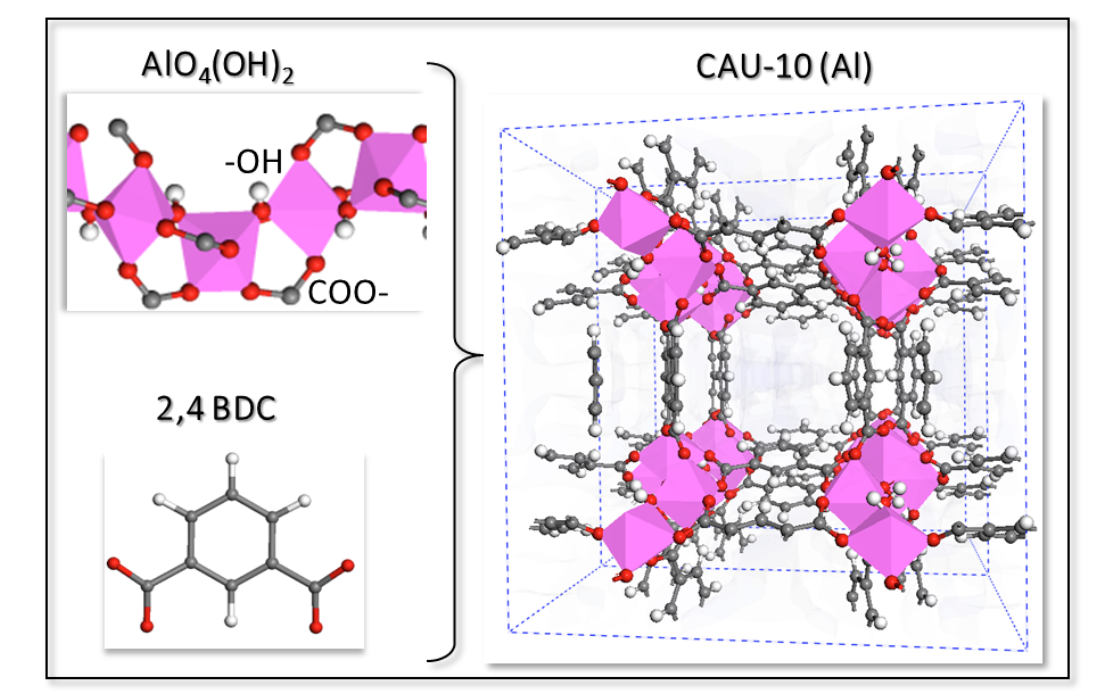
Borges, Daiane Damasceno; Maurin, Guillaume; Galvao, Douglas S
Design of Porous Metal-Organic Frameworks for Adsorption Driven Thermal Batteries Journal Article
Em: MRS Advances, vol. 2017, pp. 1-6, 2017.
Resumo | Links | BibTeX | Tags: DFT, MOFs, thermal batteries
@article{Borges2017b,
title = {Design of Porous Metal-Organic Frameworks for Adsorption Driven Thermal Batteries},
author = {Borges, Daiane Damasceno and Maurin, Guillaume and Galvao, Douglas S},
url = {https://www.cambridge.org/core/journals/mrs-advances/article/design-of-porous-metalorganic-frameworks-for-adsorption-driven-thermal-batteries/A63B92E4D7E413D7CC047E152C7F22AF},
doi = {10.1557/adv.2017.181},
year = {2017},
date = {2017-02-15},
journal = {MRS Advances},
volume = {2017},
pages = {1-6},
abstract = {Thermal batteries based on a reversible adsorption/desorption of a working fluid (water, methanol, ammonia) rather than the conventional vapor compression is a promising alternative to exploit waste thermal energy for heat reallocation. In this context, there is an increasing interest to find novel porous solids able to adsorb a high energy density of working fluid under low relative vapor pressure condition combined with an easy ability of regeneration (desorption) at low temperature, which are the major requirements for adsorption driven heat pumps and chillers. The porous crystalline hybrid materials named Metal–Organic Frameworks (MOF) represent a great source of inspiration for sorption based-applications owing to their tunable chemical and topological features associated with a large variability of pore sizes. Recently, we have designed a new MOF named MIL-160 (MIL stands for Materials of Institut Lavoisier), isostructural to CAU-10, built from the assembly of corner sharing aluminum chains octahedra AlO4(OH)2 with the 2,5-furandicarboxylic linker substituting the pristine organic linker, 1,4-benzenedicarboxylate. This ligand replacement strategy proved to enhance both the hydrophilicity of the MOF and its amount of water adsorbed at low p/p0. This designed solid was synthesized and its chemical stability/adsorption performances verified. Here, we have extended this study by incorporating other polar heterocyclic linkers and a comparative computational study of the water adsorption performances of these novel structures has been performed. To that purpose, the cell and geometry optimizations of all hypothetical frameworks were first performed at the density functional theory level and their water adsorption isotherms were further predicted by using force-field based Grand-Canonical Monte Carlo simulations. This study reveals the ease tunable water affinity of MOF for the desired application.
},
keywords = {DFT, MOFs, thermal batteries},
pubstate = {published},
tppubtype = {article}
}
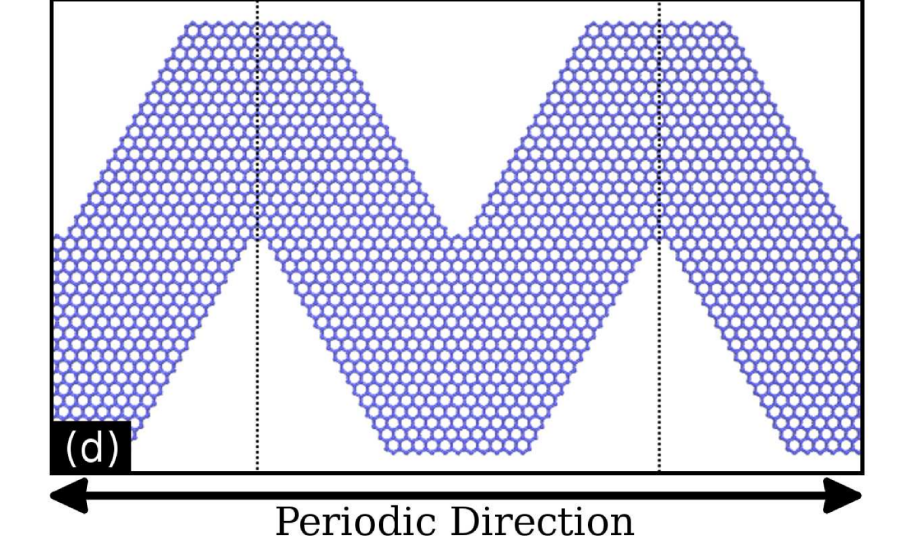
Bizao, Rafael A; Botari, Tiago; Perim, Eric; Pugno, Nicola M; Galvao, Douglas S
Mechanical Properties and Fracture Patterns of Graphene (Graphitic) Nanowiggles Online
2017, (preprint arXiv:1702.01100).
Resumo | Links | BibTeX | Tags: Graphene, Mechanical Properties, Molecular Dynamics, Nanowiggles
@online{Bizao2017,
title = {Mechanical Properties and Fracture Patterns of Graphene (Graphitic) Nanowiggles},
author = {Bizao, Rafael A and Botari, Tiago and Perim, Eric and Pugno, Nicola M and Galvao, Douglas S},
url = {https://arxiv.org/pdf/1702.01100.pdf},
year = {2017},
date = {2017-02-03},
abstract = {Graphene nanowiggles (GNW) are graphene-based nanostructures
obtained by making alternated regular cuts in pristine graphene nanoribbons.
GNW were recently synthesized and it was demonstrated that
they exhibit tunable electronic and magnetic properties by just varying
their shape. Here, we have investigated the mechanical properties and
fracture patterns of a large number of GNW of different shapes and
sizes using fully atomistic reactive molecular dynamics simulations.
Our results show that the GNW mechanical properties are strongly
dependent on its shape and size and, as a general trend narrow sheets
have larger ultimate strength and Young’s modulus than wide ones.
The estimated Young’s modulus values were found to be in a range of
≈ 100 − 1000 GPa and the ultimate strength in a range of ≈ 20 − 110
GPa, depending on GNW shape. Also, super-ductile behaviour under
strain was observed for some structures.},
note = {preprint arXiv:1702.01100},
keywords = {Graphene, Mechanical Properties, Molecular Dynamics, Nanowiggles},
pubstate = {published},
tppubtype = {online}
}
obtained by making alternated regular cuts in pristine graphene nanoribbons.
GNW were recently synthesized and it was demonstrated that
they exhibit tunable electronic and magnetic properties by just varying
their shape. Here, we have investigated the mechanical properties and
fracture patterns of a large number of GNW of different shapes and
sizes using fully atomistic reactive molecular dynamics simulations.
Our results show that the GNW mechanical properties are strongly
dependent on its shape and size and, as a general trend narrow sheets
have larger ultimate strength and Young’s modulus than wide ones.
The estimated Young’s modulus values were found to be in a range of
≈ 100 − 1000 GPa and the ultimate strength in a range of ≈ 20 − 110
GPa, depending on GNW shape. Also, super-ductile behaviour under
strain was observed for some structures.
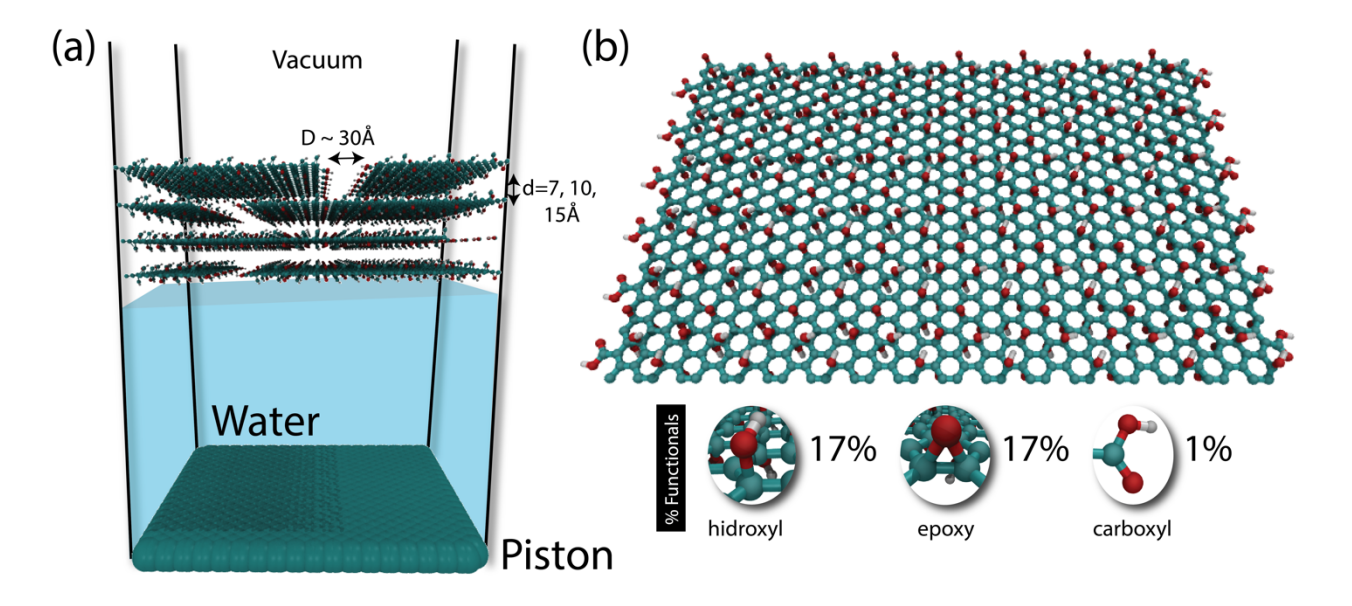
Borges, Daiane D; Woellner, Cristiano F; Autreto, Pedro AS; Galvao, Douglas S
2017, (preprint arXiv:1702.00250).
Resumo | Links | BibTeX | Tags: Graphene, Molecular Dynamics, water
@online{Borges2017,
title = {Water Permeation through Layered Graphene-based Membranes: A Fully Atomistic Molecular Dynamics Investigation},
author = {Borges, Daiane D and Woellner, Cristiano F and Autreto, Pedro AS and Galvao, Douglas S},
url = {https://arxiv.org/abs/1702.00250},
year = {2017},
date = {2017-02-01},
abstract = {Graphene-based membranes have been investigated as promising candidates for water
filtration and gas separation applications. Experimental evidences have shown that graphene
oxide can be impermeable to liquids, vapors and gases, while allowing a fast permeation of water
molecules. This phenomenon has been attributed to the formation of a network of nano
capillaries that allow nearly frictionless water flow while blocking other molecules by steric
hindrance effects. It is supposed that water molecules are transported through the percolated twodimensional
channels formed between graphene-based sheets. Although these channels allow
fast water permeation in such materials, the flow rates are strongly dependent on how the
membranes are fabricated. Also, some fundamental issues regarding the nanoscale mechanisms
of water permeation are still not fully understood and their interpretation remains controversial.
In this work, we have investigated the dynamics of water permeation through pristine graphene
and graphene oxide model membranes. We have carried out fully atomistic classical molecular
dynamics simulations of systems composed of multiple layered graphene-based sheets into
contact with a water reservoir under controlled thermodynamics conditions (e. g., by varying
temperature and pressure values). We have systematically analyzed how the transport dynamics
of the confined nanofluids depend on the interlayer distances and the role of the oxide functional
groups. Our results show the water flux is much more effective for graphene than for graphene
oxide membranes. These results are attributed to the H-bonds formation between oxide
functional groups and water, which traps the water molecules and precludes ultrafast water
transport through the nanochannels.},
note = {preprint arXiv:1702.00250},
keywords = {Graphene, Molecular Dynamics, water},
pubstate = {published},
tppubtype = {online}
}
filtration and gas separation applications. Experimental evidences have shown that graphene
oxide can be impermeable to liquids, vapors and gases, while allowing a fast permeation of water
molecules. This phenomenon has been attributed to the formation of a network of nano
capillaries that allow nearly frictionless water flow while blocking other molecules by steric
hindrance effects. It is supposed that water molecules are transported through the percolated twodimensional
channels formed between graphene-based sheets. Although these channels allow
fast water permeation in such materials, the flow rates are strongly dependent on how the
membranes are fabricated. Also, some fundamental issues regarding the nanoscale mechanisms
of water permeation are still not fully understood and their interpretation remains controversial.
In this work, we have investigated the dynamics of water permeation through pristine graphene
and graphene oxide model membranes. We have carried out fully atomistic classical molecular
dynamics simulations of systems composed of multiple layered graphene-based sheets into
contact with a water reservoir under controlled thermodynamics conditions (e. g., by varying
temperature and pressure values). We have systematically analyzed how the transport dynamics
of the confined nanofluids depend on the interlayer distances and the role of the oxide functional
groups. Our results show the water flux is much more effective for graphene than for graphene
oxide membranes. These results are attributed to the H-bonds formation between oxide
functional groups and water, which traps the water molecules and precludes ultrafast water
transport through the nanochannels.
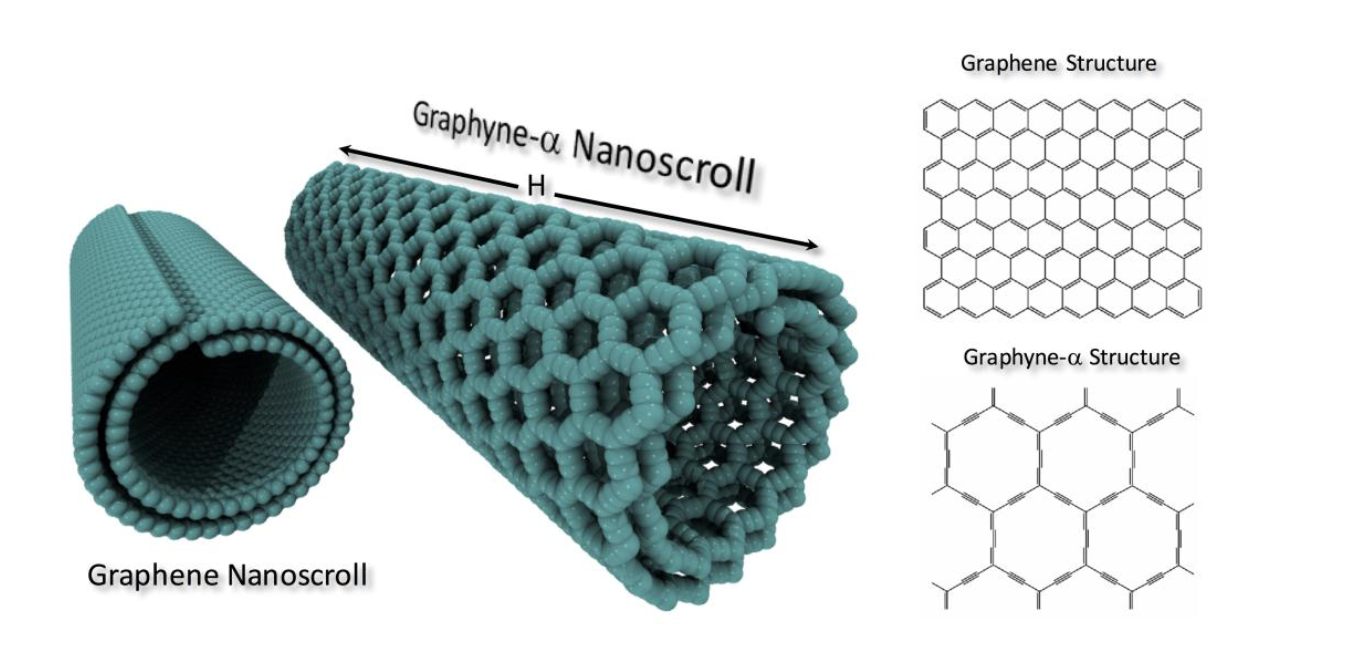
Solis, Daniel; Woellner, Cristiano F; Borges, Daiane D; Galvao, Douglas S
Mechanical and Thermal Stability of Graphyne and Graphdiyne Nanoscrolls Journal Article
Em: MRS Advances, vol. 2017, pp. 129-134, 2017.
Resumo | Links | BibTeX | Tags: graphdiyne, Graphyne, Molecular Dynamics, Scrolls
@article{Solis2017,
title = {Mechanical and Thermal Stability of Graphyne and Graphdiyne Nanoscrolls},
author = {Solis, Daniel and Woellner, Cristiano F and Borges, Daiane D and Galvao, Douglas S},
url = {https://www.cambridge.org/core/journals/mrs-advances/article/mechanical-and-thermal-stability-of-graphyne-and-graphdiyne-nanoscrolls/202E7B7C471411200DE9D05C264726B8},
doi = {10.1557/adv.2017.130},
year = {2017},
date = {2017-02-01},
journal = {MRS Advances},
volume = {2017},
pages = {129-134},
abstract = {Graphynes and graphdiynes are carbon 2D allotrope structures presenting both sp2 and sp hybridized atoms. These materials have been theoretically predicted but due to intrinsic difficulties in their synthesis, only recently some of these structures have been experimentally realized. Graphyne nanoscrolls are structures obtained by rolling up graphyne sheets into papyrus-like structures. In this work, we have investigated, through fully atomistic reactive molecular dynamics simulations, the dynamics of nanoscroll formation for a series of graphyne (α, β, and δ types) structures. We have also investigated their thermal stability for a temperature range of 200-1000K. Our results show that stable nanoscrolls can be formed for all structures considered here. Their stability depends on a critical value of the ratio between length and height of the graphyne sheets. Our findings also show that these structures are structurally less stable then graphene-based nanoscrolls. This can be explained by the graphyne higher structural porosity which results in a decreased pi-pi stacking interactions.},
keywords = {graphdiyne, Graphyne, Molecular Dynamics, Scrolls},
pubstate = {published},
tppubtype = {article}
}
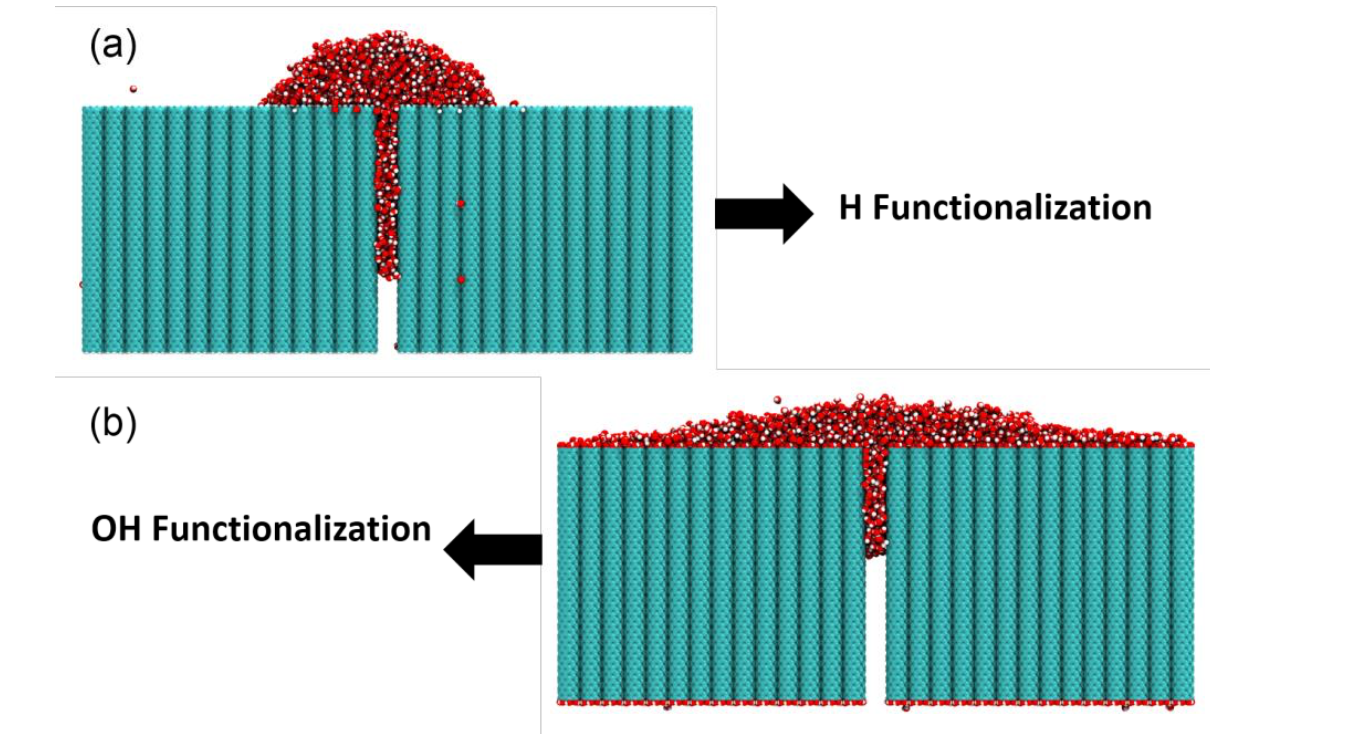
Jaques, Ygor M; Galvao, Douglas S
Permeation of Water Nanodroplets on Carbon Nanotubes Forests Journal Article
Em: MRS Advances, vol. 2017, pp. 123-128, 2017.
Resumo | Links | BibTeX | Tags: cnt forests, Droplet, Molecular Dynamics
@article{Jaques2017b,
title = {Permeation of Water Nanodroplets on Carbon Nanotubes Forests},
author = {Jaques, Ygor M and Galvao, Douglas S},
url = {https://www.cambridge.org/core/journals/mrs-advances/article/permeation-of-water-nanodroplets-on-carbon-nanotubes-forests/99C67F3DC0AD10DB1A4580CC8CEFDF58},
doi = {10.1557/adv.2017.129},
year = {2017},
date = {2017-01-31},
journal = {MRS Advances},
volume = {2017},
pages = {123-128},
abstract = {Fully atomistic molecular dynamics simulations were carried out to investigate how a liquid-like water droplet behaves when into contact with a nanopore formed by carbon nanotube arrays. We have considered different tube arrays, varying the spacing between them, as well as, different chemical functionalizations on the uncapped nanotubes. Our results show that simple functionalizations (for instance, hydrogen ones) allow tuning up the wetting surface properties increasing the permeation of liquid inside the nanopore. For functionalizations that increase the surface hydrophilicity, even when the pore size is significantly increased the droplet remains at the surface without tube permeation.
},
keywords = {cnt forests, Droplet, Molecular Dynamics},
pubstate = {published},
tppubtype = {article}
}
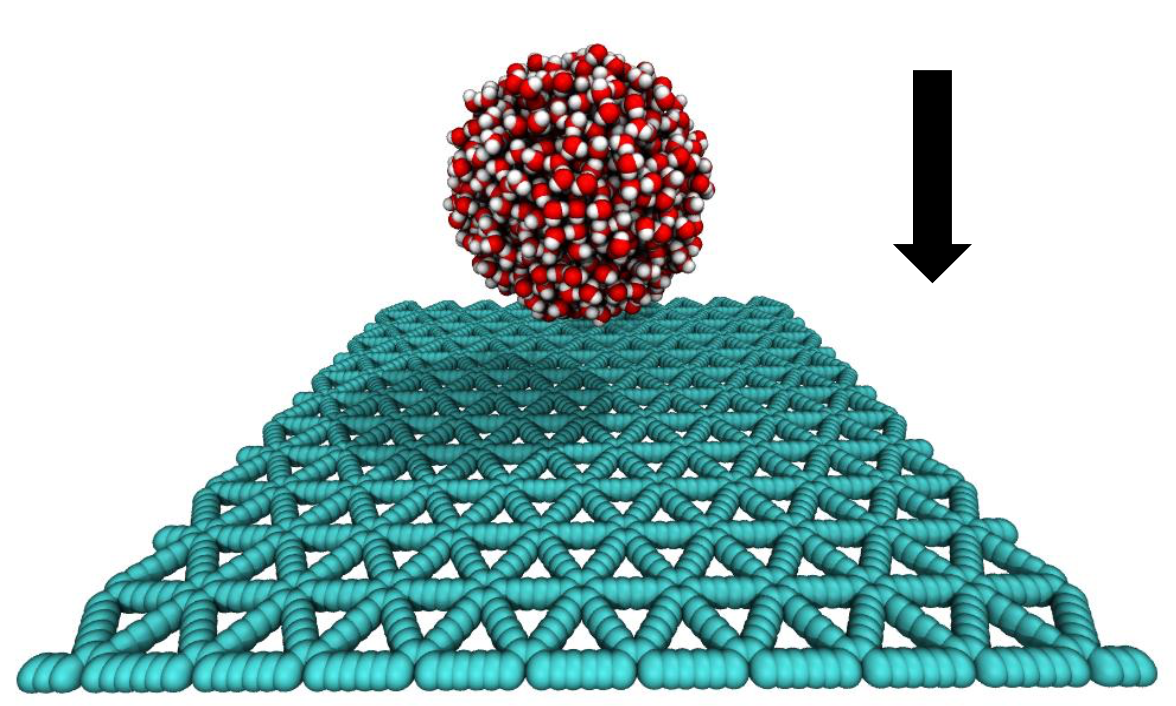
Jaques, Ygor M; Galvao, Douglas S
Nanodroplets Behavior on Graphdiyne Membranes Journal Article
Em: MRS Advances, vol. 2017, pp. 1-6, 2017.
Resumo | Links | BibTeX | Tags: Droplet, graphdiynes, Molecular Dynamics, water
@article{Jaques2017,
title = {Nanodroplets Behavior on Graphdiyne Membranes},
author = {Jaques, Ygor M and Galvao, Douglas S},
url = {https://www.cambridge.org/core/journals/mrs-advances/article/nanodroplets-behavior-on-graphdiyne-membranes/16AD56CAD07570E7F4F194A56E9680C3},
doi = {10.1557/adv.2017.128},
year = {2017},
date = {2017-01-30},
journal = {MRS Advances},
volume = {2017},
pages = {1-6},
abstract = {In this work we have investigated, by fully atomistic reactive (force field ReaxFF) molecular dynamics simulations, some aspects of impact dynamics of water nanodroplets on graphdiyne-like membranes. We simulated graphdiyne-supported membranes impacted by nanodroplets at different velocities (from 100 up to 1500 m/s). The results show that due to the graphdiyne porous and elastic structure, the droplets present an impact dynamics very complex in relation to the ones observed for graphene membranes. Under impact the droplets spread over the surface with a maximum contact radius proportional to the impact velocity. Depending on the energy impact value, a number of water molecules were able to percolate the nanopore sheets. However, even in these cases the droplet shape is preserved and the main differences between the different impact velocities cases reside on the splashing pattern at the maximum spreading.},
keywords = {Droplet, graphdiynes, Molecular Dynamics, water},
pubstate = {published},
tppubtype = {article}
}
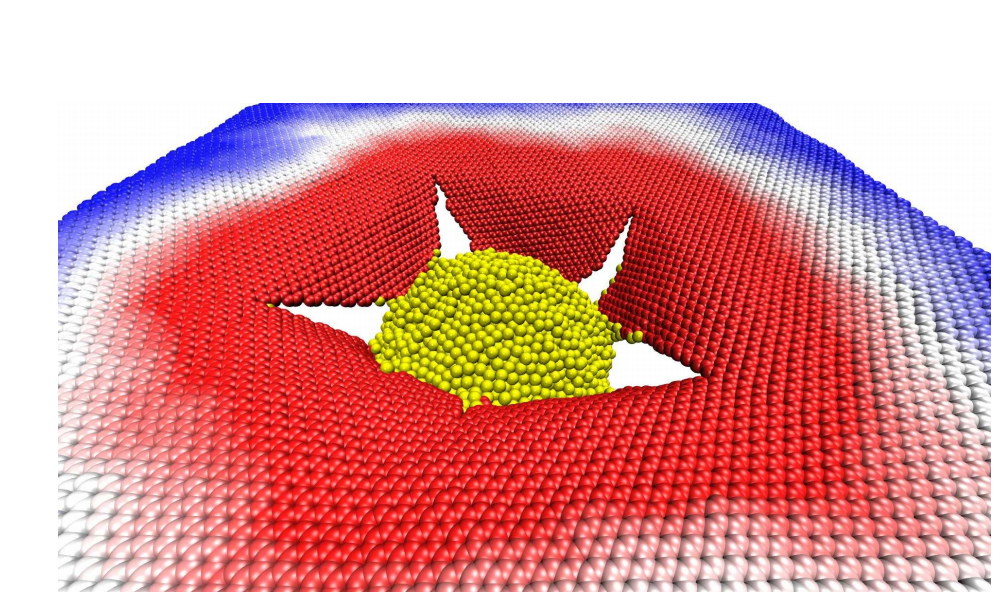
Bizao, Rafael A; Machado, Leonardo D; de Sousa, Jose M; Pugno, Nicola M; Galvao, Douglas S
Scale Effects on the Ballistic Penetration of Graphene Sheets Online
2017, (preprint arXiv:1701.07367).
Resumo | Links | BibTeX | Tags: ballistic impacts, Fracture, Graphene, Molecular Dynamics
@online{Bizao2017c,
title = {Scale Effects on the Ballistic Penetration of Graphene Sheets},
author = {Bizao, Rafael A and Machado, Leonardo D and de Sousa, Jose M and Pugno, Nicola M and Galvao, Douglas S},
url = {https://arxiv.org/pdf/1701.07367.pdf},
year = {2017},
date = {2017-01-25},
abstract = {Carbon nanostructures are promising ballistic protection materials,
due to their low density and excellent mechanical properties. Recent
experimental and computational investigations on the behavior
of graphene under impact conditions revealed exceptional energy absorption
properties as well. However, the reported numerical and experimental
values differ by an order of magnitude. In this work, we
combined numerical and analytical modeling to address this issue. In
the numerical part, we employed reactive molecular dynamics to carry
out ballistic tests on single and double-layered graphene sheets. We
used velocity values within the range tested in experiments. Our numerical
and the experimental results were used to determine parameters
for a scaling law, which is in good agreement with all experimental
and simulation results. We find that the specific penetration energy
decreases as the number of layers (N) increases, from ∼ 25 MJ/kg for
N = 1 to ∼ 0.26 MJ/kg as N → ∞. These scale effects explain the
apparent discrepancy between simulations and experiments.},
note = {preprint arXiv:1701.07367},
keywords = {ballistic impacts, Fracture, Graphene, Molecular Dynamics},
pubstate = {published},
tppubtype = {online}
}
due to their low density and excellent mechanical properties. Recent
experimental and computational investigations on the behavior
of graphene under impact conditions revealed exceptional energy absorption
properties as well. However, the reported numerical and experimental
values differ by an order of magnitude. In this work, we
combined numerical and analytical modeling to address this issue. In
the numerical part, we employed reactive molecular dynamics to carry
out ballistic tests on single and double-layered graphene sheets. We
used velocity values within the range tested in experiments. Our numerical
and the experimental results were used to determine parameters
for a scaling law, which is in good agreement with all experimental
and simulation results. We find that the specific penetration energy
decreases as the number of layers (N) increases, from ∼ 25 MJ/kg for
N = 1 to ∼ 0.26 MJ/kg as N → ∞. These scale effects explain the
apparent discrepancy between simulations and experiments.
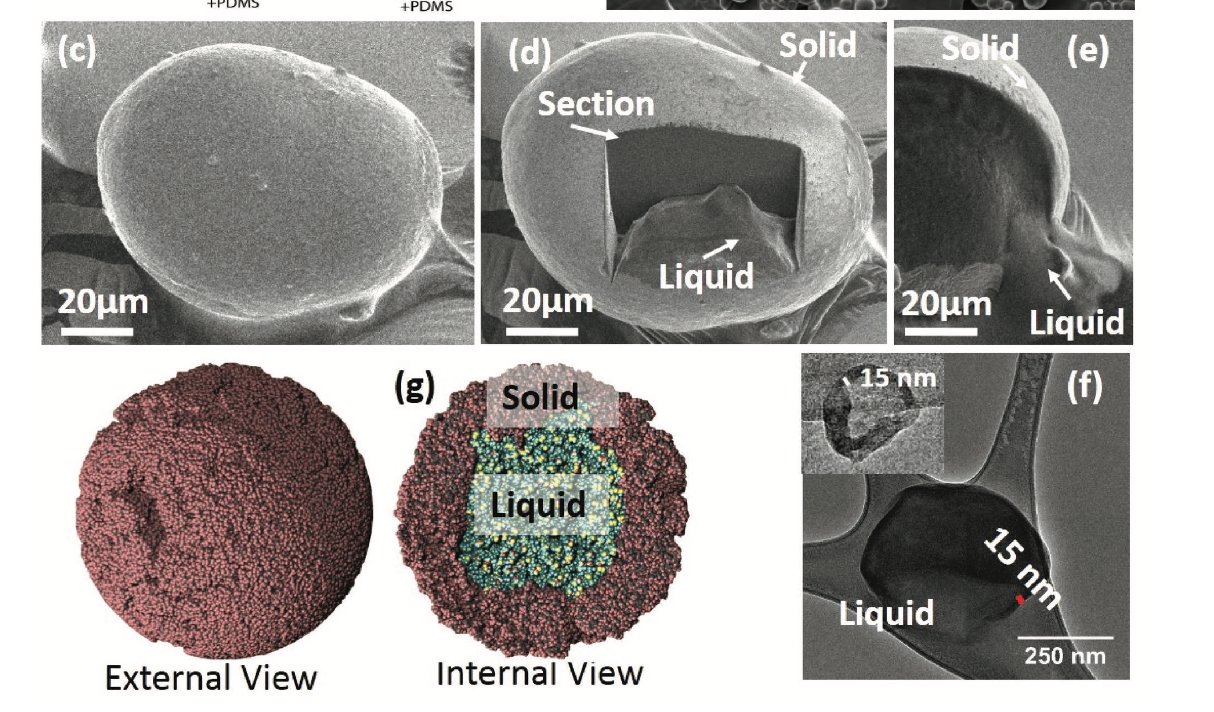
Peter Samora Owuor Alin Cristian Chipara, Sanjit Bhowmick
Structural Reinforcement through Liquid Encapsulation Journal Article
Em: Advanced Materials Interfaces, vol. 4, pp. 1600781, 2017.
Resumo | Links | BibTeX | Tags: Mechanical Properties, Molecular Dynamics, solid-liquid interfaces
@article{Chipara2017,
title = {Structural Reinforcement through Liquid Encapsulation},
author = {Alin Cristian Chipara, Peter Samora Owuor, Sanjit Bhowmick, Gustavo Brunetto, SA Asif, Mircea Chipara, Robert Vajtai, Jun Lou, Douglas S Galvao, Chandra Sekhar Tiwary, Pulickel M Ajayan},
url = {http://onlinelibrary.wiley.com/doi/10.1002/admi.201600781/full},
doi = {10.1002/admi.201600781},
year = {2017},
date = {2017-01-23},
journal = {Advanced Materials Interfaces},
volume = {4},
pages = {1600781},
abstract = {The liquid inside a solid material is one of the most common composite materials in nature. The interface between solid–liquid plays an important role in unique deformation. Here, model systems of two polymers (polydimethylsiloxane–polyvinylidenefluoride) are used to make sphere of solid with liquid inside it.},
keywords = {Mechanical Properties, Molecular Dynamics, solid-liquid interfaces},
pubstate = {published},
tppubtype = {article}
}
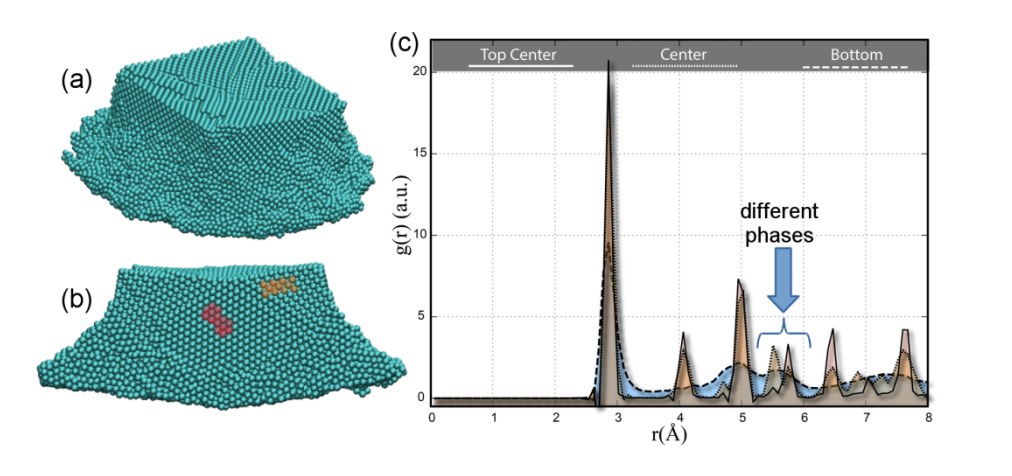
Oliveira, Eliezer Fernando; Pedro Alves da Silva Autreto,; Galvao, Douglas Soares
Silver Hardening via Hypersonic Impacts Online
2017, (preprint arXiv:1801.04780).
Resumo | Links | BibTeX | Tags: Fracture, impact, Molecular Dynamics, silver
@online{Oliveira2017,
title = {Silver Hardening via Hypersonic Impacts},
author = {Eliezer Fernando Oliveira and Pedro Alves da Silva Autreto, and Douglas Soares Galvao},
url = {https://arxiv.org/abs/1801.04780},
year = {2017},
date = {2017-01-15},
abstract = {The search for new ultra strong materials has been a very active research area. With relation
to metals, a successful way to improve their strength is by the creation of a gradient of
nanograins (GNG) inside the material. Recently, R. Thevamaran et al. [Science v354, 312-
316 (2016)] propose a single step method based on high velocity impact of silver nanocubes
to produce high-quality GNG. This method consists of producing high impact collisions of
silver cubes at hypersonic velocity (~400 m/s) against a rigid wall. Although they observed an
improvement in the mechanical properties of the silver after the impact, the GNG creation
and the strengthening mechanism at nanoscale remain unclear. In order to gain further
insights about these mechanisms, we carried out fully atomistic molecular dynamics
simulations (MD) to investigate the atomic conformations/rearrangements during and after
high impact collisions of silver nanocubes at ultrasonic velocity. Our results indicate the coexistence
of polycrystalline arrangements after the impact formed by core HCP domains
surrounded by FCC ones, which could also contribute to explain the structural hardening.},
note = {preprint arXiv:1801.04780},
keywords = {Fracture, impact, Molecular Dynamics, silver},
pubstate = {published},
tppubtype = {online}
}
to metals, a successful way to improve their strength is by the creation of a gradient of
nanograins (GNG) inside the material. Recently, R. Thevamaran et al. [Science v354, 312-
316 (2016)] propose a single step method based on high velocity impact of silver nanocubes
to produce high-quality GNG. This method consists of producing high impact collisions of
silver cubes at hypersonic velocity (~400 m/s) against a rigid wall. Although they observed an
improvement in the mechanical properties of the silver after the impact, the GNG creation
and the strengthening mechanism at nanoscale remain unclear. In order to gain further
insights about these mechanisms, we carried out fully atomistic molecular dynamics
simulations (MD) to investigate the atomic conformations/rearrangements during and after
high impact collisions of silver nanocubes at ultrasonic velocity. Our results indicate the coexistence
of polycrystalline arrangements after the impact formed by core HCP domains
surrounded by FCC ones, which could also contribute to explain the structural hardening.
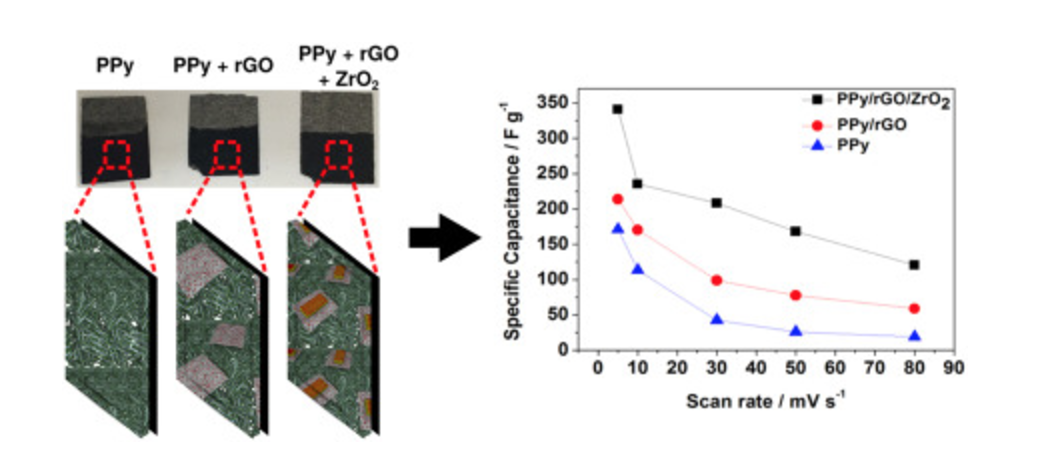
Alves, Ana Paula P; Koizumi, Ryota; Samanta, Atanu; Machado, Leonardo D; Singh, Abhisek K; Galvao, Douglas S; Silva, Glaura G; Tiwary, Chandra S; Ajayan, Pulickel M
One-step electrodeposited 3D-ternary composite of zirconia nanoparticles, rGO and polypyrrole with enhanced supercapacitor performance Journal Article
Em: Nano Energy, vol. 31, pp. 225-232, 2017.
Resumo | Links | BibTeX | Tags: Molecular Dynamics, Polymers, supercapacitors, Zirconia
@article{Alves2017,
title = {One-step electrodeposited 3D-ternary composite of zirconia nanoparticles, rGO and polypyrrole with enhanced supercapacitor performance},
author = {Alves, Ana Paula P and Koizumi, Ryota and Samanta, Atanu and Machado, Leonardo D and Singh, Abhisek K and Galvao, Douglas S and Silva, Glaura G and Tiwary, Chandra S and Ajayan, Pulickel M},
url = {http://www.sciencedirect.com/science/article/pii/S221128551630502X},
doi = {10.1016/j.nanoen.2016.11.018},
year = {2017},
date = {2017-01-01},
journal = {Nano Energy},
volume = {31},
pages = {225-232},
abstract = {Supercapacitor electrodes consisting of conjugated polymers (CP), metal oxides and graphene nanosheets have been explored as a strategy to achieve high specific capacitance, power, energy density, and stability. In this work, we synthesized a 3D structure composed of zirconia oxide nanoparticles (ZrO2), reduced graphene oxide (rGO) and polypyrrole (PPy), using a simple and easily scalable one-step chronopotentiometry method. Detailed characterization revealed that the addition of rGO and ZrO2 modified the morphology of the electrode material. The capacitance of the resulting architecture improved by up to a 100%. The ternary composite featured high stability, with an increase of 5% in capacitance after a thousand cycles. DFT and MD simulations were carried out in order to provide further insight on the role of zirconia.
},
keywords = {Molecular Dynamics, Polymers, supercapacitors, Zirconia},
pubstate = {published},
tppubtype = {article}
}
2016
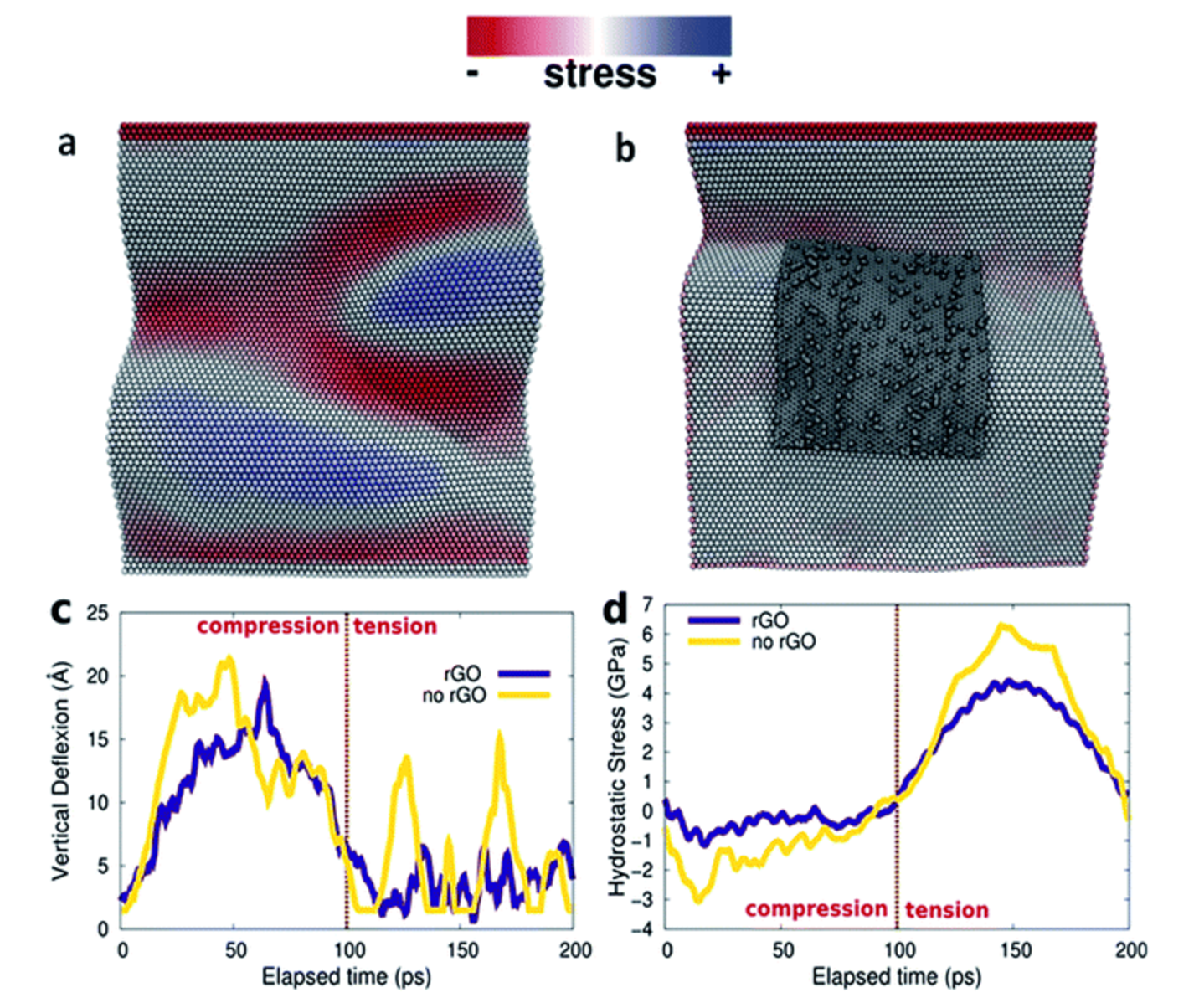
Chandra Sekhar Tiwary Sujin P Jose, Suppanat Kosolwattana
Enhanced supercapacitor performance of a 3D architecture tailored using atomically thin rGO–MoS 2 2D sheets Journal Article
Em: RSC Advances, vol. 6, pp. 93384-93393, 2016.
Resumo | Links | BibTeX | Tags: Chalcogenides, DFT, graphene oxide, Molecular Dynamics
@article{Jose2016,
title = {Enhanced supercapacitor performance of a 3D architecture tailored using atomically thin rGO–MoS 2 2D sheets},
author = {Sujin P Jose, Chandra Sekhar Tiwary, Suppanat Kosolwattana, Prasanth Raghavan, Leonardo D Machado, Chandkiram Gautam, T Prasankumar, Jarin Joyner, Sehmus Ozden, Douglas S Galvao, PM Ajayan},
url = {xlink.rsc.org/?DOI=c6ra20960b},
doi = {10.1039/C6RA20960B},
year = {2016},
date = {2016-09-19},
journal = {RSC Advances},
volume = {6},
pages = {93384-93393},
abstract = {A 3D architecture is fabricated using 2D nano-sheets of GO and MoS2 as the building blocks by a facile, one-pot chronoamperometry method to achieve a conductive additive free, binder free and scalable supercapacitor electrode. The superior electrochemical properties of the 3D PPy-rGO–MoS2 (PGMo) are due to its porous structure, thin wall, high surface area and high electrical conductivity that endow rapid transportation of electrolyte ions and electrons throughout the electrode matrix. The synergistic effect between the components in a proper ratio improves the supercapacitor performance and material stability of PGMo. The possible correlation of the structure and electrochemical performance of the 3D ternary composite is backed by a fully atomistic molecular dynamics (MD) simulation study. The high specific capacitance (387 F g−1) and impressive cycling stability (>1000 cycles) estimated for PGMo open up an opportunity to consider the 3D ternary nanostructures as cutting edge materials for energy storage solutions.
},
keywords = {Chalcogenides, DFT, graphene oxide, Molecular Dynamics},
pubstate = {published},
tppubtype = {article}
}
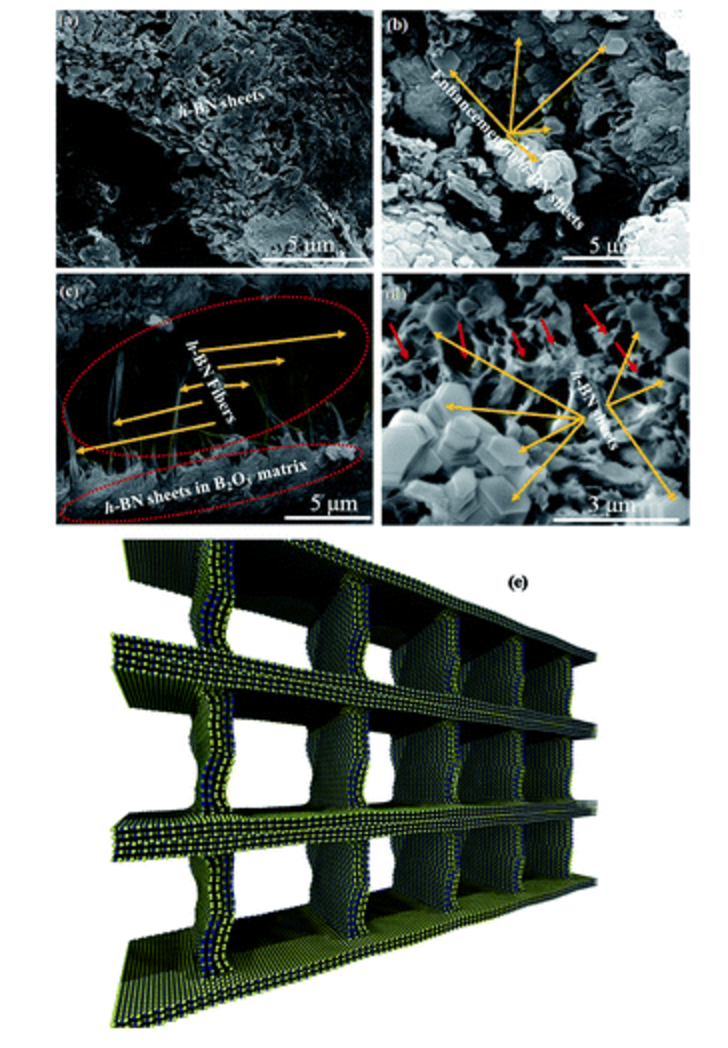
P. M. Gautam, Chandkiram; Tiwary, Chandra Sekhar; Machado, Leonardo D.; Jose, Sujin; Ozden, Sehmus; Biradar, Santoshkumar; Galvao, Douglas S.; Sonker, Rakesh K.; Yadav, B. C.; Vajtai, Robert; Ajayan,
Synthesis and porous h-BN 3D architectures for effective humidity and gas sensors Authors Journal Article
Em: RSC Advances, vol. 6, não 91, pp. 87888-87896, 2016.
Resumo | Links | BibTeX | Tags: Boron Nitride tubes, Modeling, Molecular Dynamics, Sensors
@article{Gautam2016,
title = {Synthesis and porous h-BN 3D architectures for effective humidity and gas sensors Authors},
author = {P. M. Gautam, Chandkiram and Tiwary, Chandra Sekhar and Machado, Leonardo D. and Jose, Sujin and Ozden, Sehmus and Biradar, Santoshkumar and Galvao, Douglas S. and Sonker, Rakesh K. and Yadav, B. C. and Vajtai, Robert and Ajayan},
url = {pubs.rsc.org/en/Content/ArticleHtml/2016/RA/c6ra18833h},
doi = {10.1039/C6RA18833H},
year = {2016},
date = {2016-09-09},
journal = {RSC Advances},
volume = {6},
number = {91},
pages = {87888-87896},
abstract = {3D (three dimensional) architectures synthesised using an easily scalable solid state method which results in an interconnected network of porous h-BN sheets with boron trioxide are reported in this study. The boron trioxide acts as a nucleating agent for the formation of laterally large nanosheets of h-BN with a low density and increases the specific surface area. The stable form shows improved mechanical properties (experimentally and using MD simulation) and serves as a suitable material for humidity and liquefied petroleum gas (LPG) sensor applications. The sensor shows stability for up to several months without losing its sensitivity.},
keywords = {Boron Nitride tubes, Modeling, Molecular Dynamics, Sensors},
pubstate = {published},
tppubtype = {article}
}
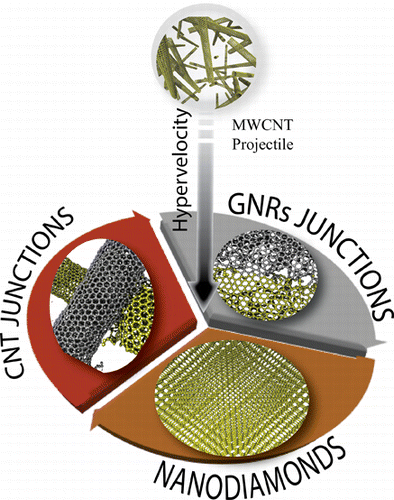
Leonardo D Machado Sehmus Ozden, ChandraSekhar Tiwary
Ballistic Fracturing of Carbon Nanotubes Journal Article
Em: ACS Applied Materials & Interfaces, vol. 8, não 37, pp. 24819-24825, 2016.
Resumo | Links | BibTeX | Tags: Ballistic Impact, Carbon Nanotubes, Molecular Dynamics
@article{Ozden2016b,
title = {Ballistic Fracturing of Carbon Nanotubes},
author = {Sehmus Ozden, Leonardo D Machado, ChandraSekhar Tiwary, Pedro AS Autreto, Robert Vajtai, Enrique V Barrera, Douglas S Galvao, Pulickel M Ajayan},
url = {pubs.acs.org/doi/abs/10.1021/acsami.6b07547},
doi = {10.1021/acsami.6b07547},
year = {2016},
date = {2016-09-08},
journal = {ACS Applied Materials & Interfaces},
volume = {8},
number = {37},
pages = {24819-24825},
abstract = {Advanced materials with multifunctional capabilities and high resistance to hypervelocity impact are of great interest to the designers of aerospace structures. Carbon nanotubes (CNTs) with their lightweight and high strength properties are alternative to metals and/or metallic alloys conventionally used in aerospace applications. Here we report a detailed study on the ballistic fracturing of CNTs for different velocity ranges. Our results show that the highly energetic impacts cause bond breakage and carbon atom rehybridizations, and sometimes extensive structural reconstructions were also observed. Experimental observations show the formation of nanoribbons, nanodiamonds, and covalently interconnected nanostructures, depending on impact conditions. Fully atomistic reactive molecular dynamics simulations were also carried out in order to gain further insights into the mechanism behind the transformation of CNTs. The simulations show that the velocity and relative orientation of the multiple colliding nanotubes are critical to determine the impact outcome.},
keywords = {Ballistic Impact, Carbon Nanotubes, Molecular Dynamics},
pubstate = {published},
tppubtype = {article}
}

Chandra Sekhar Tiwary Mohamad A Kabbani, Anirban Som
A generic approach for mechano-chemical reactions between carbon nanotubes of different functionalities Journal Article
Em: Carbon, vol. 104, pp. 196-202, 2016.
Resumo | Links | BibTeX | Tags: Carbon Nanotubes, DFT, Fracture, Mechano-chemistry, Molecular Dynamics
@article{Kabbani2016,
title = {A generic approach for mechano-chemical reactions between carbon nanotubes of different functionalities},
author = {Mohamad A Kabbani, Chandra Sekhar Tiwary, Anirban Som, KR Krishnadas, Pedro AS Autreto, Sehmus Ozden, Kunttal Keyshar, Ken Hackenberg, Alin Christian Chipara, Douglas S Galvao, Robert Vajtai, Ahmad T Kabbani, Thalappil Pradeep, Pulickel M Ajayan},
url = {www.sciencedirect.com/science/article/pii/S000862231630183X},
doi = {10.1016/j.carbon.2016.02.094},
year = {2016},
date = {2016-08-31},
journal = {Carbon},
volume = {104},
pages = {196-202},
abstract = {Abstract Here, we report similar reactions between nanotubes carrying functionalities,
namely carbon nanotubes (CNTs) with the acyl chloride/hydroxyl and amine/carboxylic
functionalities directly attached to their surfaces, resulting in the formation ofchemically
modified graphene products. The reaction is spontaneous and is facilitated by simple
grinding of the reactants. The new solid-state reactions have been confirmed using different
spectroscopic and electron microscopy techniques.},
keywords = {Carbon Nanotubes, DFT, Fracture, Mechano-chemistry, Molecular Dynamics},
pubstate = {published},
tppubtype = {article}
}
namely carbon nanotubes (CNTs) with the acyl chloride/hydroxyl and amine/carboxylic
functionalities directly attached to their surfaces, resulting in the formation ofchemically
modified graphene products. The reaction is spontaneous and is facilitated by simple
grinding of the reactants. The new solid-state reactions have been confirmed using different
spectroscopic and electron microscopy techniques.
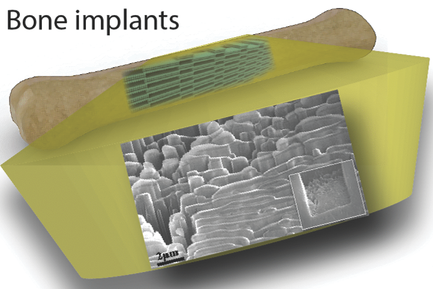
Chandra Sekhar Tiwary Dibyendu Chakravarty, Cristano F Woellner
3D Porous Graphene by Low-Temperature Plasma Welding for Bone Implants Journal Article
Em: Advanced Materials, vol. 28, não 40, pp. 8959-8967, 2016.
Resumo | Links | BibTeX | Tags: Graphene, Molecular Dynamics, Plasma Welding
@article{chakravarty20163d,
title = {3D Porous Graphene by Low-Temperature Plasma Welding for Bone Implants},
author = {Dibyendu Chakravarty, Chandra Sekhar Tiwary, Cristano F Woellner, Sruthi Radhakrishnan, Soumya Vinod, Sehmus Ozden, Pedro Alves da Silva Autreto, Sanjit Bhowmick, Syed Asif, Sendurai A Mani, Douglas S Galvao, Pulickel M},
url = {onlinelibrary.wiley.com/doi/10.1002/adma.201603146/abstract },
doi = {10.1002/adma.201603146},
year = {2016},
date = {2016-08-26},
journal = {Advanced Materials},
volume = {28},
number = {40},
pages = {8959-8967},
abstract = {3D scaffolds of graphene, possessing ultra-low density, macroporous microstructure, and high yield strength and stiffness can be developed by a novel plasma welding process. The bonding between adjacent graphene sheets is investigated by molecular dynamics simulations. The high degree of biocompatibility along with high porosity and good mechanical properties makes graphene an ideal material for use as body implants.},
keywords = {Graphene, Molecular Dynamics, Plasma Welding},
pubstate = {published},
tppubtype = {article}
}
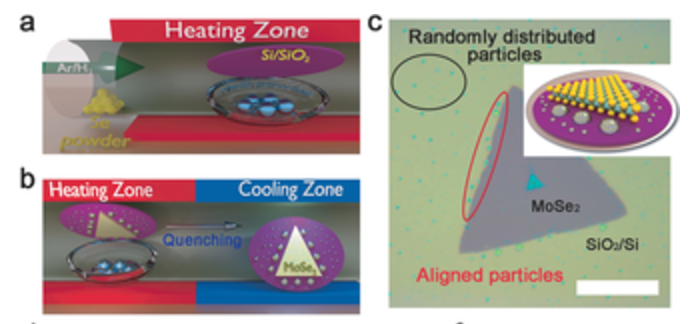
Yongji Gong Bo Li, Zhili Hu
Solid–Vapor Reaction Growth of Transition‐Metal Dichalcogenide Monolayers Journal Article
Em: Angewandte Chemie, vol. 128, não 36, pp. 10814-10819, 2016.
Resumo | Links | BibTeX | Tags: Chalcogenides, cvd, DFT
@article{Li2016,
title = {Solid–Vapor Reaction Growth of Transition‐Metal Dichalcogenide Monolayers},
author = {Bo Li, Yongji Gong, Zhili Hu, Gustavo Brunetto, Yingchao Yang, Gonglan Ye, Zhuhua Zhang, Sidong Lei, Zehua Jin, Elisabeth Bianco, Xiang Zhang, Weipeng Wang, Jun Lou, Douglas S Galvão, Ming Tang, Boris I Yakobson, Robert Vajtai, Pulickel M Ajayan},
url = {onlinelibrary.wiley.com/doi/10.1002/anie.201604445/abstract},
doi = {10.1002/ange.201604445},
year = {2016},
date = {2016-08-26},
journal = {Angewandte Chemie},
volume = {128},
number = {36},
pages = {10814-10819},
abstract = {Two-dimensional (2D) layered semiconducting transition-metal dichalcogenides (TMDCs) are promising candidates for next-generation ultrathin, flexible, and transparent electronics. Chemical vapor deposition (CVD) is a promising method for their controllable, scalable synthesis but the growth mechanism is poorly understood. Herein, we present systematic studies to understand the CVD growth mechanism of monolayer MoSe2, showing reaction pathways for growth from solid and vapor precursors. Examination of metastable nanoparticles deposited on the substrate during growth shows intermediate growth stages and conversion of non-stoichiometric nanoparticles into stoichiometric 2D MoSe2 monolayers. The growth steps involve the evaporation and reduction of MoO3 solid precursors to sub-oxides and stepwise reactions with Se vapor to finally form MoSe2. The experimental results and proposed model were corroborated by ab initio Car–Parrinello molecular dynamics studies.},
keywords = {Chalcogenides, cvd, DFT},
pubstate = {published},
tppubtype = {article}
}
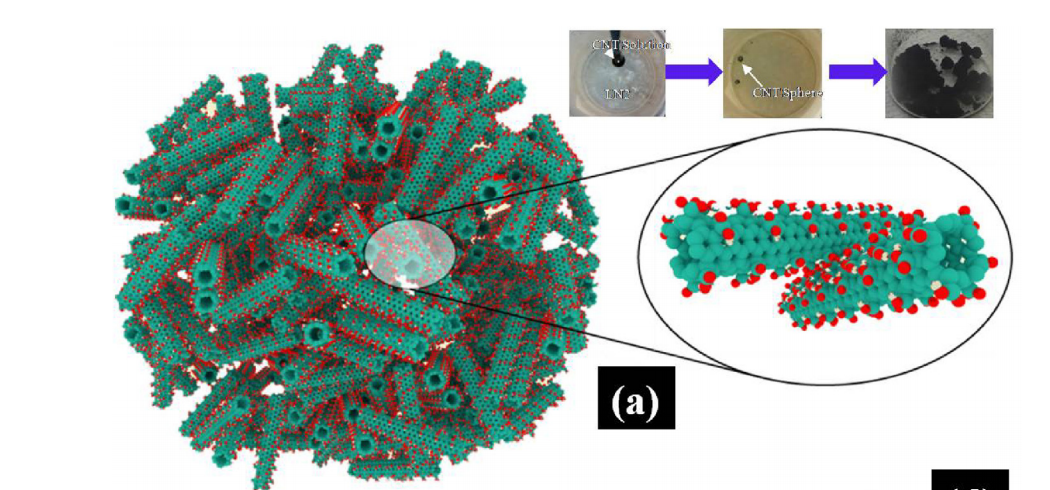
Amelia HC Hart Ryota Koizumi, Gustavo Brunetto
Mechano-chemical stabilization of three-dimensional carbon nanotube aggregates Journal Article
Em: Carbon, vol. 110, pp. 27-33, 2016.
Resumo | Links | BibTeX | Tags: Mechano-chemistry, Molecular Dynamics, Nanotubes
@article{koizumi2016mechano,
title = {Mechano-chemical stabilization of three-dimensional carbon nanotube aggregates},
author = {Ryota Koizumi, Amelia HC Hart, Gustavo Brunetto, Sanjit Bhowmick, Peter S Owuor, John T Hamel, Anieph X Gentles, Sehmus Ozden, Jun Lou, Robert Vajtai, SA Syed Asif, Douglas S Galvão, CS Tiwary, PM Ajayan},
url = {www.sciencedirect.com/science/article/pii/S0008622316307400},
doi = {10.1016/j.carbon.2016.08.085},
year = {2016},
date = {2016-08-21},
journal = {Carbon},
volume = {110},
pages = {27-33},
abstract = {Here we report a combined study of experiments and simulations to understand how chemical functional groups can mechanically stabilize aggregates of carbon nanotubes (CNTs). Ultralow density aggregates of chemically functionalized CNTs, in the form of macro-scale spheres made by freeze-drying method, show mechanical stabilization and near complete elastic recovery during deformation. Simulations of interacting functionalized carbon nanotube aggregates show better structural retention compared to non-functionalized CNTs under compression, suggesting that the atomic-level interactions between functional groups on adjoining CNTs help maintain structural rigidity and elastic response during loading. Aggregates of non-functionalized CNTs collapses under similar loading conditions. The dynamic mechanical responses of CNT macrostructures and mechano-chemical stabilization are directly observed using in-situ deformation inside a scanning electron microscope.},
keywords = {Mechano-chemistry, Molecular Dynamics, Nanotubes},
pubstate = {published},
tppubtype = {article}
}
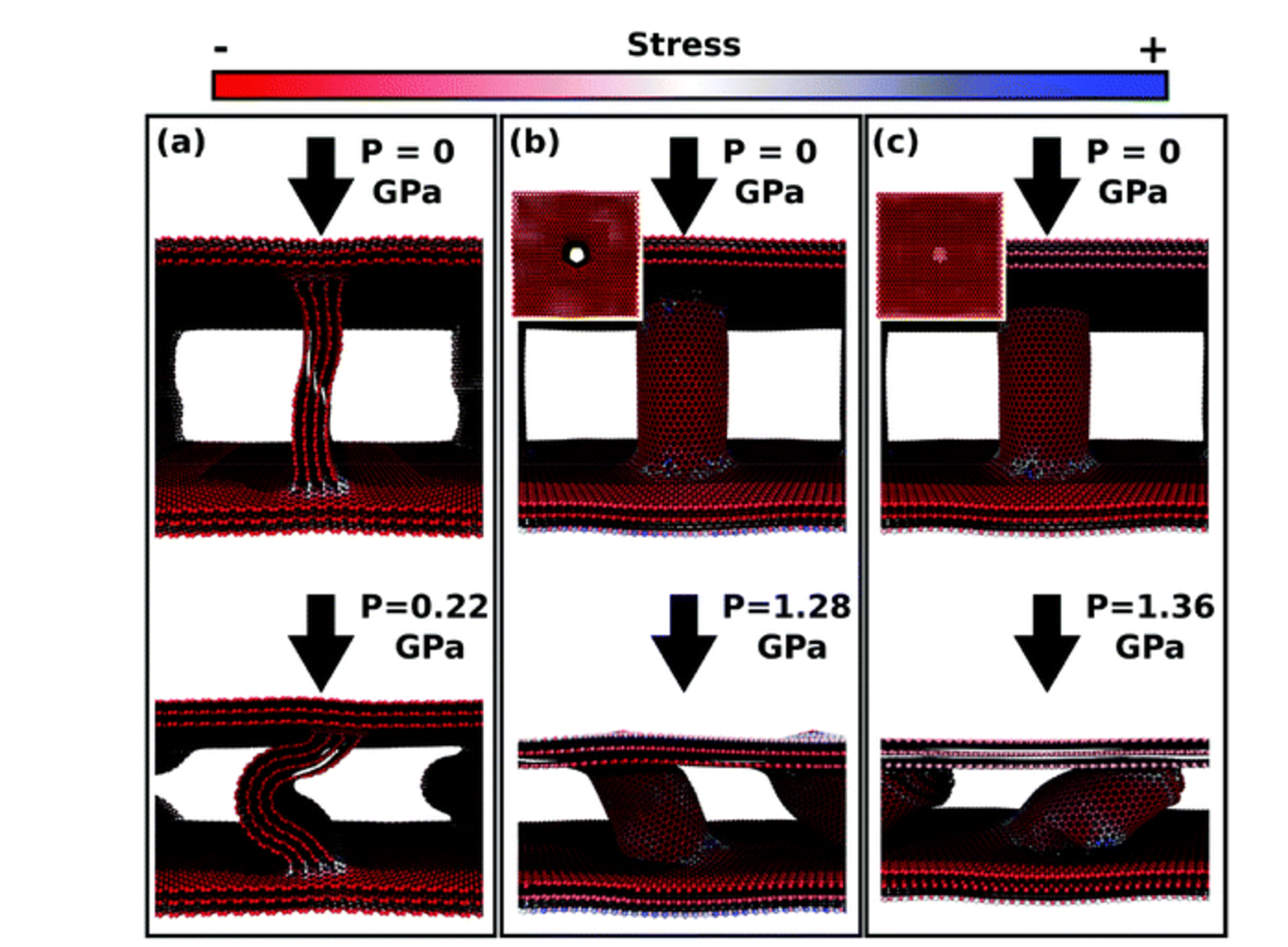
Chandra Sekhar Tiwary Soumya Vinod, Leonardo D Machado
Synthesis of ultralow density 3D graphene–CNT foams using a two-step method Journal Article
Em: Nanoscale, vol. 8, não 35, pp. 15857-15863, 2016.
Resumo | Links | BibTeX | Tags: Carbon Nanotubes, foams, Molecular Dynamics
@article{Vinod2016b,
title = {Synthesis of ultralow density 3D graphene–CNT foams using a two-step method},
author = {Soumya Vinod, Chandra Sekhar Tiwary, Leonardo D Machado, Sehmus Ozden, Robert Vajtai, Douglas S Galvao, Pulickel M Ajayan},
url = {xlink.rsc.org/?DOI=c6nr04252j},
doi = {10.1039/C6NR04252J},
year = {2016},
date = {2016-08-09},
journal = {Nanoscale},
volume = {8},
number = {35},
pages = {15857-15863},
abstract = {Here, we report a highly scalable two-step method to produce graphene foams with ordered carbon nanotube reinforcements. In our approach, we first used solution assembly methods to obtain graphene oxide foam. Next, we employed chemical vapor deposition to simultaneously grow carbon nanotubes and thermally reduce the 3D graphene oxide scaffold. The resulting structure presented increased stiffness, good mechanical stability and oil absorption properties. Molecular dynamics simulations were carried out to further elucidate failure mechanisms and to understand the enhancement of the mechanical properties. The simulations showed that mechanical failure is directly associated with bending of vertical reinforcements, and that, for similar length and contact area, much more stress is required to bend the corresponding reinforcements of carbon nanotubes, thus explaining the experimentally observed enhanced mechanical properties.
},
keywords = {Carbon Nanotubes, foams, Molecular Dynamics},
pubstate = {published},
tppubtype = {article}
}
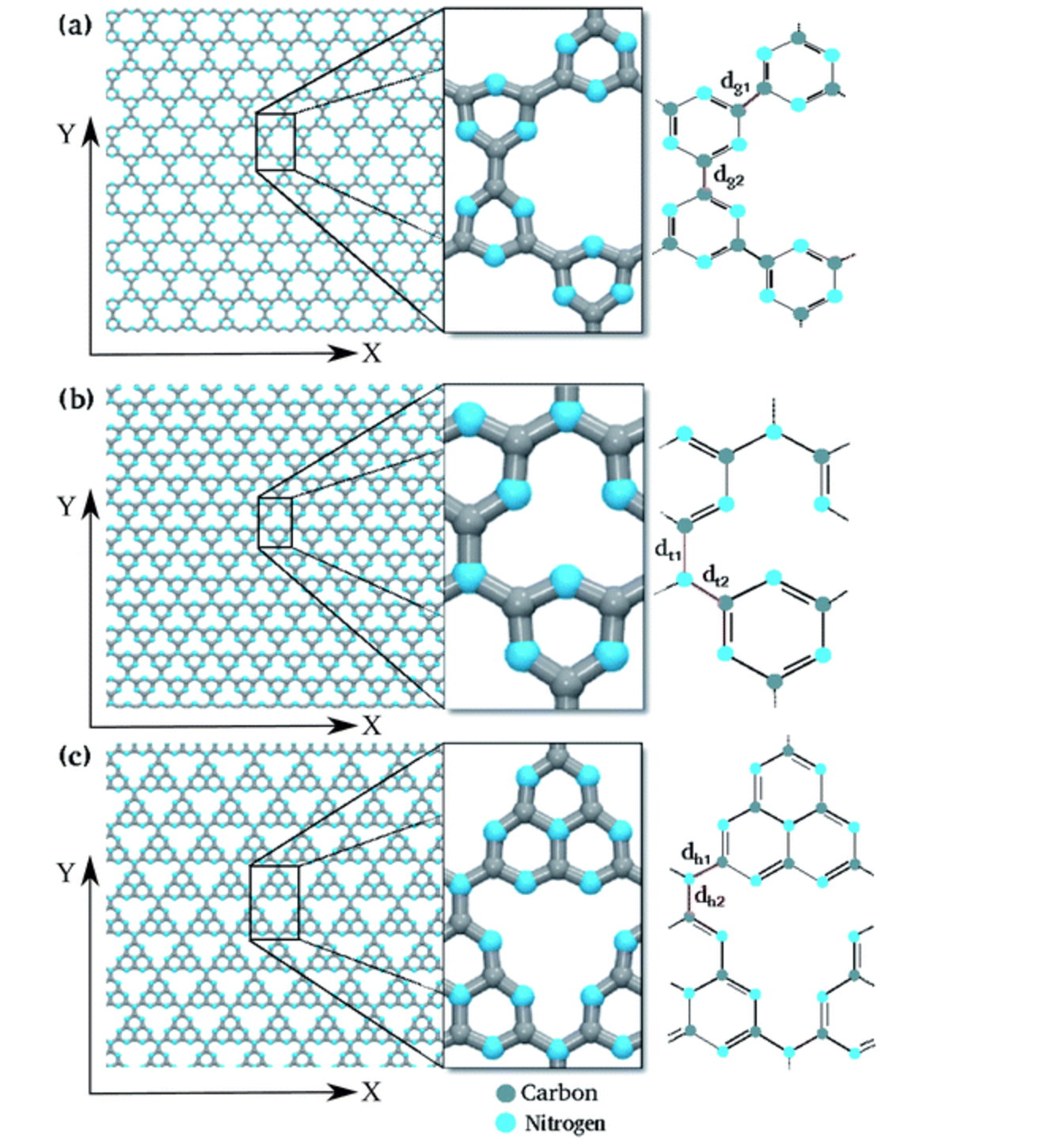
T Botari JM de Sousa, E Perim
Mechanical and structural properties of graphene-like carbon nitride sheets Journal Article
Em: RSC Advances, vol. 6, não 80, pp. 76915-76921, 2016.
Resumo | Links | BibTeX | Tags: carbon nitrides sheets, Mechanical Properties, Molecular Dynamics
@article{deSousa2016b,
title = {Mechanical and structural properties of graphene-like carbon nitride sheets},
author = {JM de Sousa, T Botari, E Perim, RA Bizao, Douglas S Galvao},
url = {pubs.rsc.org/en/content/articlehtml/2016/ra/c6ra14273g},
doi = {10.1039/C6RA14273G},
year = {2016},
date = {2016-08-08},
journal = {RSC Advances},
volume = {6},
number = {80},
pages = {76915-76921},
abstract = {Carbon nitride-based nanostructures have attracted special attention (from theory and experiments) due to their remarkable electromechanical properties. In this work we have investigated the mechanical properties of some graphene-like carbon nitride membranes through fully atomistic reactive molecular dynamics simulations. We have analyzed three different structures of these CN families, the so-called graphene-based g-CN, triazine-based g-C3N4 and heptazine-based g-C3N4. The stretching dynamics of these membranes was studied for deformations along their two main axes and at three different temperatures: 10 K, 300 K and 600 K. We show that g-CN membranes have the lowest ultimate fracture strain value, followed by heptazine-based and triazine-based ones, respectively. This behavior can be explained in terms of their differences in density values, topologies and types of chemical bonds. The dependency of the fracture patterns on the stretching directions is also discussed.},
keywords = {carbon nitrides sheets, Mechanical Properties, Molecular Dynamics},
pubstate = {published},
tppubtype = {article}
}
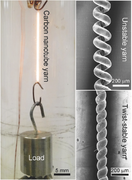
Shaoli Fang Jiangtao Di, Francisco A Moura
Strong, Twist‐Stable Carbon Nanotube Yarns and Muscles by Tension Annealing at Extreme Temperatures Journal Article
Em: Advanced Materials, vol. 28, não 31, pp. 6598-6605, 2016.
Resumo | Links | BibTeX | Tags: Artificial Muscles, Carbon Nanotubes, Modeling
@article{Di2016,
title = {Strong, Twist‐Stable Carbon Nanotube Yarns and Muscles by Tension Annealing at Extreme Temperatures},
author = {Jiangtao Di, Shaoli Fang, Francisco A Moura, Douglas S Galvão, Julia Bykova, Ali Aliev, Mônica Jung de Andrade, Xavier Lepró, Na Li, Carter Haines, Raquel Ovalle‐Robles, Dong Qian, Ray H Baughman},
url = {onlinelibrary.wiley.com/doi/10.1002/adma.201600628/full},
doi = {10.1002/adma.201600628},
year = {2016},
date = {2016-08-01},
journal = {Advanced Materials},
volume = {28},
number = {31},
pages = {6598-6605},
abstract = {A high-speed incandescent tension annealing process (ITAP) is used to increase the modulus and strength of twist-spun carbon nanotube yarns by up to 12-fold and 2.6-fold, respectively, provide remarkable resistance to oxidation and powerful protonating acids, and freeze yarn untwist. This twist stability enables torsional artificial-muscle motors having improved performance and minimizes problematic untwist during weaving nanotube yarns.},
keywords = {Artificial Muscles, Carbon Nanotubes, Modeling},
pubstate = {published},
tppubtype = {article}
}
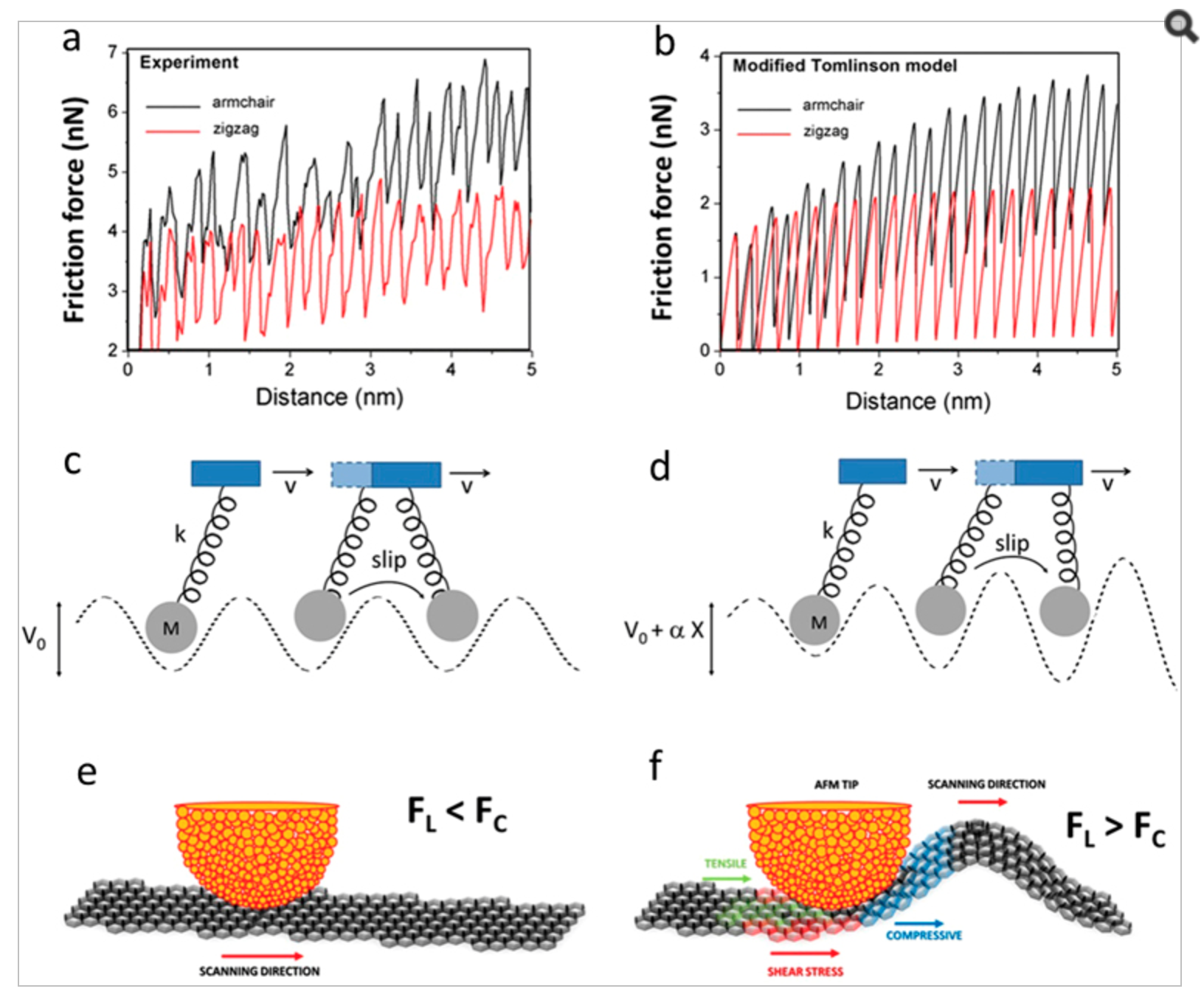
Rodrigo Prioli Clara M Almeida, Benjamin Fragneaud
Giant and Tunable Anisotropy of Nanoscale Friction in Graphene Journal Article
Em: Nature Scientific Reports, vol. 6, pp. 31569, 2016.
Resumo | Links | BibTeX | Tags: DFT, Graphene, Molecular Dynamics, Tribology
@article{Almeida2016,
title = {Giant and Tunable Anisotropy of Nanoscale Friction in Graphene},
author = {Clara M Almeida, Rodrigo Prioli, Benjamin Fragneaud, Luiz Gustavo Cançado, Ricardo Paupitz, Douglas S Galvão, Marcelo De Cicco, Marcos G Menezes, Carlos A Achete, Rodrigo B Capaz},
url = {http://www-nature-com.ez88.periodicos.capes.gov.br/articles/srep31569},
doi = {10.1038/srep31569},
year = {2016},
date = {2016-07-18},
journal = {Nature Scientific Reports},
volume = {6},
pages = {31569},
abstract = {The nanoscale friction between an atomic force microscopy tip and graphene is investigated using friction force microscopy (FFM). During the tip movement, friction forces are observed to increase and then saturate in a highly anisotropic manner. As a result, the friction forces in graphene are highly dependent on the scanning direction: under some conditions, the energy dissipated along the armchair direction can be 80% higher than along the zigzag direction. In comparison, for highly-oriented pyrolitic graphite (HOPG), the friction anisotropy between armchair and zigzag directions is only 15%. This giant friction anisotropy in graphene results from anisotropies in the amplitudes of flexural deformations of the graphene sheet driven by the tip movement, not present in HOPG. The effect can be seen as a novel manifestation of the classical phenomenon of Euler buckling at the nanoscale, which provides the non-linear ingredients that amplify friction anisotropy. Simulations based on a novel version of the 2D Tomlinson model (modified to include the effects of flexural deformations), as well as fully atomistic molecular dynamics simulations and first-principles density-functional theory (DFT) calculations, are able to reproduce and explain the experimental observations.
},
keywords = {DFT, Graphene, Molecular Dynamics, Tribology},
pubstate = {published},
tppubtype = {article}
}
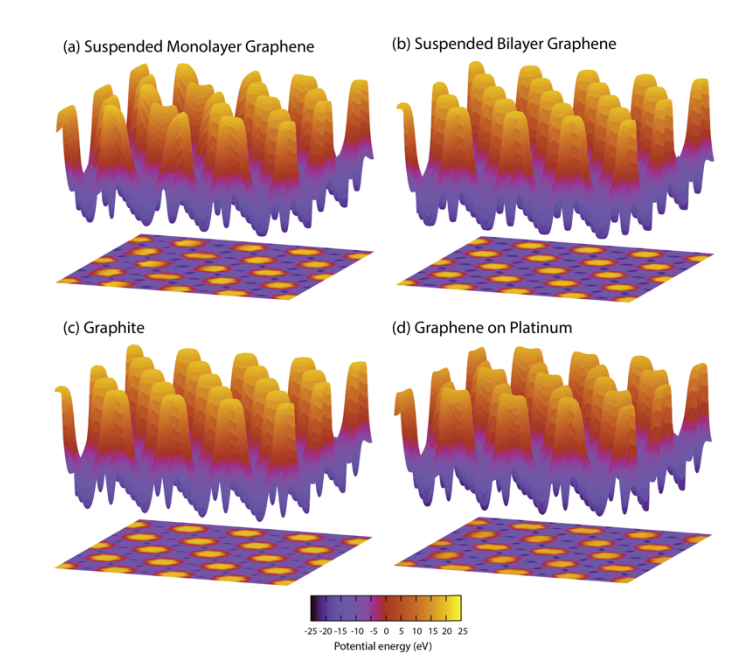
Pedro Alves da Silva Autreto Cristiano Francisco Woellner, Douglas S Galvao
Graphone (one-side hydrogenated graphene) formation on different substrates Online
2016.
Resumo | Links | BibTeX | Tags: Graphene, graphone, Molecular Dynamics
@online{Woellner2016b,
title = {Graphone (one-side hydrogenated graphene) formation on different substrates},
author = {Cristiano Francisco Woellner, Pedro Alves da Silva Autreto, Douglas S Galvao},
url = {arXiv preprint arXiv:1606.09235},
year = {2016},
date = {2016-06-29},
abstract = {In this work we present a fully atomistic reactive (ReaxFF force field) molecular dynamics study of the structural and dynamical aspects of the one-side hydrogenation of graphene membranes, leading to the formation of the so-called graphone structure. We have considered different substrates: graphene, few-layers graphene, graphite and platinum at different temperatures. Our results showed that the hydrogenation rates are very dependent on the substrate and thermal effects. Our results also showed that, similarly to graphane, large hydrogenated domains are unlikely to be formed. These hydrogenation processes occur through the formation of uncorrelated cluster domains.},
keywords = {Graphene, graphone, Molecular Dynamics},
pubstate = {published},
tppubtype = {online}
}
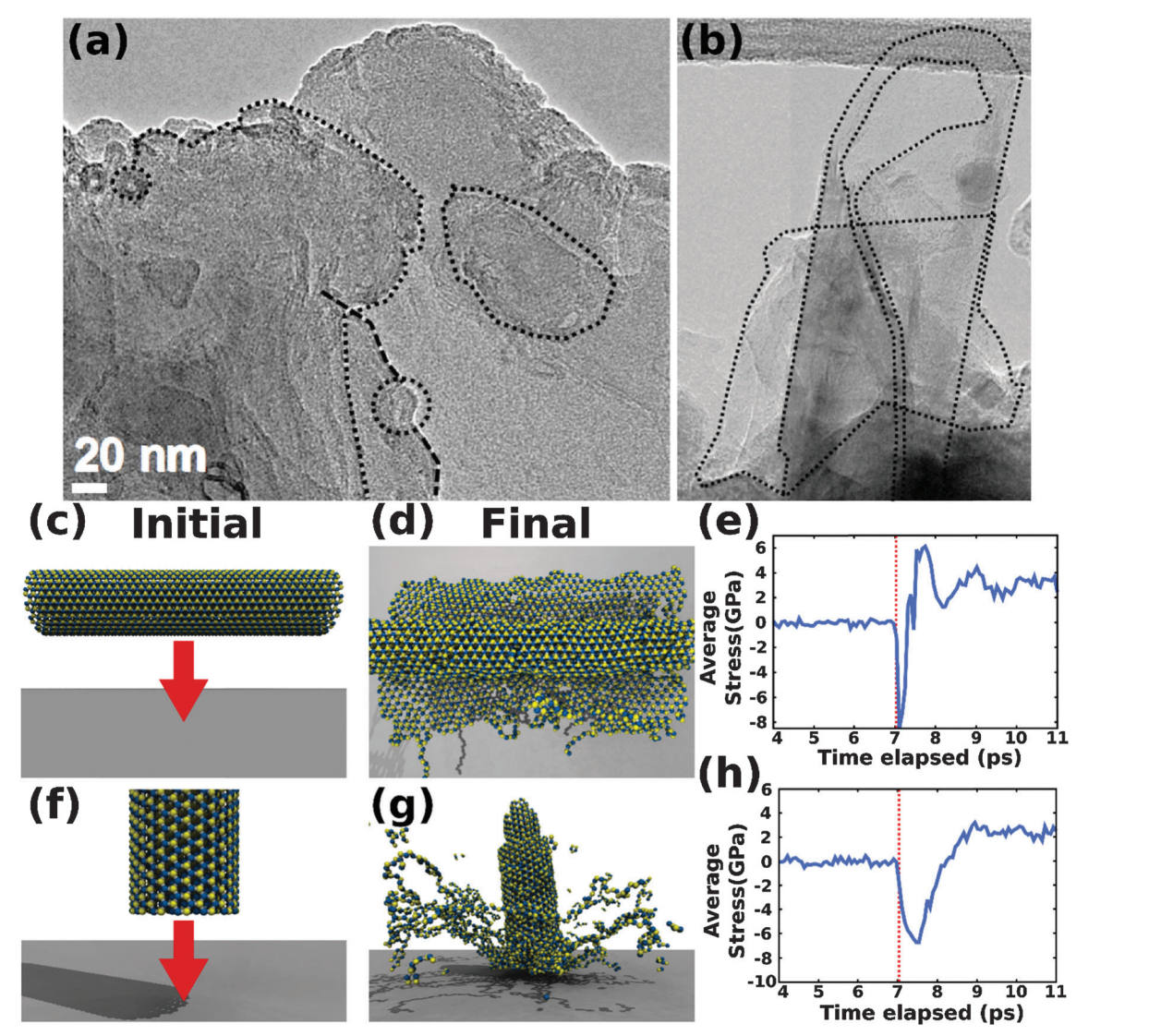
Sehmus Ozden Leonardo D Machado, ChandraSekhar Tiwary
The structural and dynamical aspects of boron nitride nanotubes under high velocity impacts Journal Article
Em: Physical Chemistry Chemical Physics, vol. 18, pp. 14776-14781, 2016.
Resumo | Links | BibTeX | Tags: Ballistic Impact, Boron Nitride tubes, CNT, Fracture, Molecular Dynamics
@article{Machado2016,
title = {The structural and dynamical aspects of boron nitride nanotubes under high velocity impacts},
author = {Leonardo D Machado, Sehmus Ozden, ChandraSekhar Tiwary, Pedro AS Autreto, Robert Vajtai, Enrique V Barrera, Douglas S Galvao, Pulickel M Ajayan},
url = {xlink.rsc.org/?DOI=c6cp01949h},
doi = {10.1039/C6CP01949H},
year = {2016},
date = {2016-05-01},
journal = {Physical Chemistry Chemical Physics},
volume = {18},
pages = {14776-14781},
abstract = {This communication report is a study on the structural and dynamical aspects of boron nitride nanotubes (BNNTs) shot at high velocities (∼5 km s−1) against solid targets. The experimental results show unzipping of BNNTs and the formation of hBN nanoribbons. Fully atomistic reactive molecular dynamics simulations were also carried out to gain insights into the BNNT fracture patterns and deformation mechanisms. Our results show that longitudinal and axial tube fractures occur, but the formation of BN nanoribbons from fractured tubes was only observed for some impact angles. Although some structural and dynamical features of the impacts are similar to the ones reported for CNTs, because BNNTs are more brittle than CNTs this results in a larger number of fractured tubes but with fewer formed nanoribbons.},
keywords = {Ballistic Impact, Boron Nitride tubes, CNT, Fracture, Molecular Dynamics},
pubstate = {published},
tppubtype = {article}
}
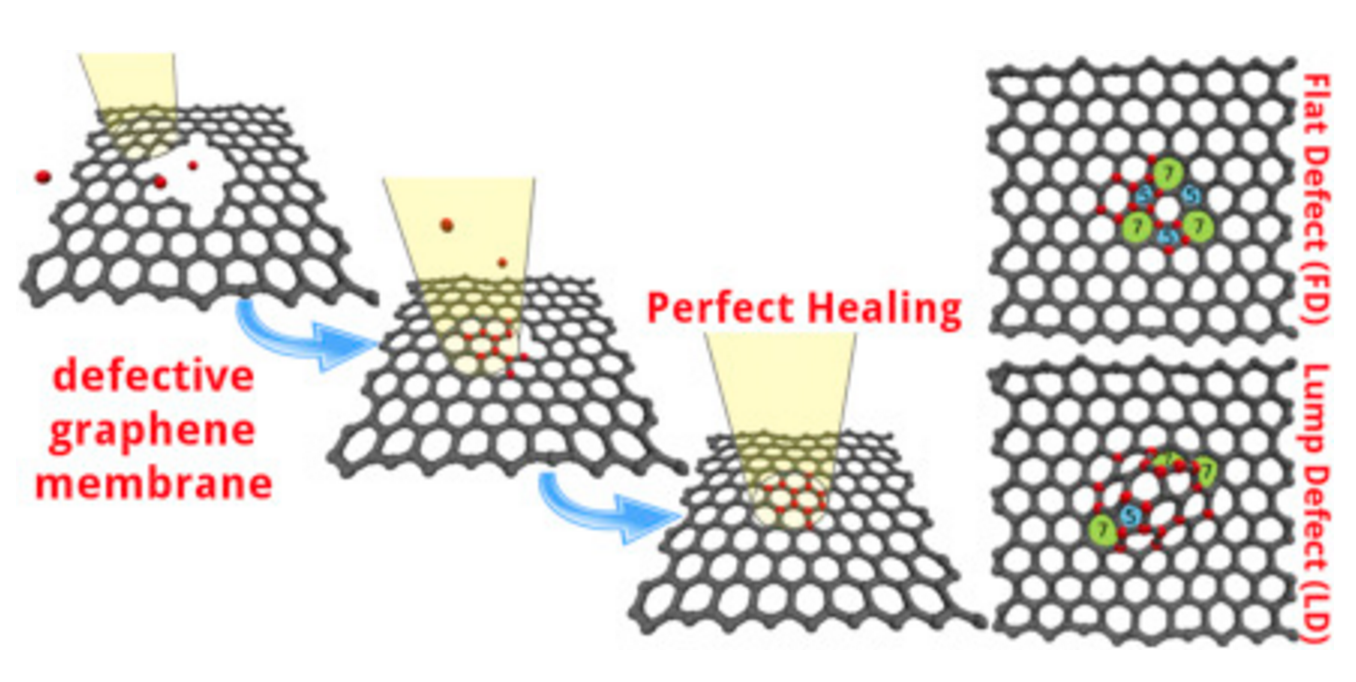
Botari, Tiago; Paupitz, Ricardo; da Silva Autreto, Pedro Alves; Galvao, Douglas S
Graphene healing mechanisms: A theoretical investigation Journal Article
Em: Carbon, vol. 99, pp. 302-309, 2016.
Resumo | Links | BibTeX | Tags: Graphene, healing, Molecular Dynamics
@article{2016Healing,
title = {Graphene healing mechanisms: A theoretical investigation},
author = {Botari, Tiago and Paupitz, Ricardo and da Silva Autreto, Pedro Alves and Galvao, Douglas S},
url = {http://www.sciencedirect.com/science/article/pii/S0008622315304784},
doi = {10.1016/j.carbon.2015.11.070},
year = {2016},
date = {2016-04-30},
journal = {Carbon},
volume = {99},
pages = {302-309},
abstract = {Large holes in graphene membranes were recently shown to heal, either at room temperature during a low energy STEM experiment, or by annealing at high temperatures. However, the details of the healing mechanism remain unclear. We carried out fully atomistic reactive molecular dynamics simulations in order to address these mechanisms under different experimental conditions. Our results show that, if a carbon atom source is present, high temperatures can provide enough energy for the carbon atoms to overcome the potential energy barrier and to produce perfect reconstruction of the graphene hexagonal structure. At room temperature, this perfect healing is only possible if the heat effects of the electron beam from STEM experiment are explicitly taken into account. The reconstruction process of a perfect or near perfect graphene structure involves the formation of linear carbon chains, as well as rings containing 5, 6, 7 and 8 atoms with planar (Stone-Wales like) and non-planar (lump like) structures. These results shed light on the healing mechanism of graphene when subjected to different experimental conditions. Additionally, the methodology presented here can be useful for investigating the tailoring and manipulations of other nano-structures.},
keywords = {Graphene, healing, Molecular Dynamics},
pubstate = {published},
tppubtype = {article}
}
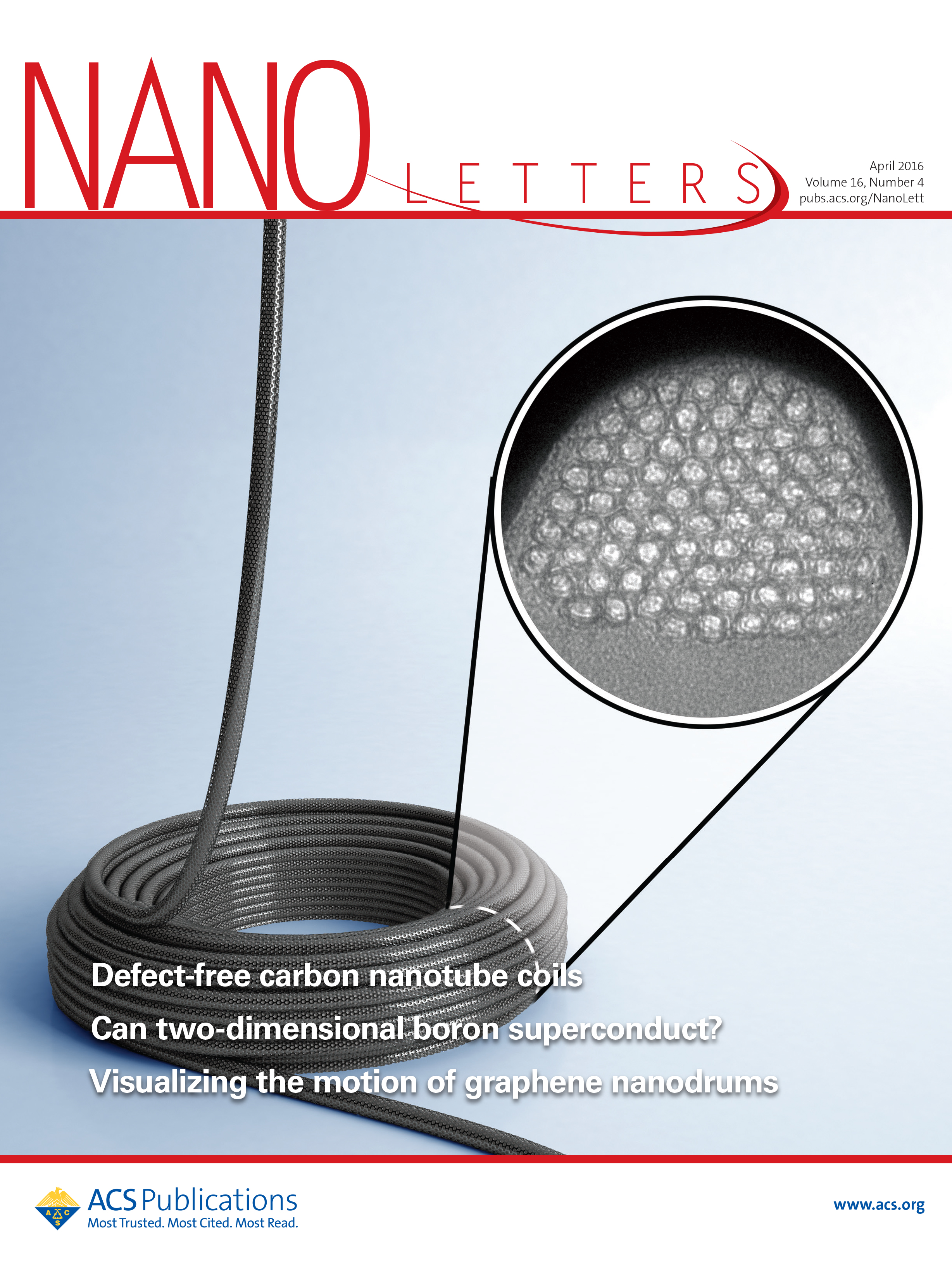
Anna Kremen Nitzan Shadmi, Yiftach Frenkel; Joselevich, Ernesto
Defect-Free Carbon Nanotube Coils Journal Article
Em: Nano Letters, vol. 16, não 4, pp. 2152–2158, 2016.
Resumo | Links | BibTeX | Tags: CNT, Coils, Molecular Dynamics, Synthesis, TEM
@article{Shadmi2016,
title = {Defect-Free Carbon Nanotube Coils},
author = {Nitzan Shadmi, Anna Kremen, Yiftach Frenkel, Zachary J. Lapin, Leonardo D. Machado, Sergio B. Legoas, Ora Bitton, Katya Rechav, Ronit Popovitz-Biro, Douglas S. Galvão, Ado Jorio, Lukas Novotny, Beena Kalisky, and Ernesto Joselevich},
url = {http://pubs.acs.org/doi/abs/10.1021/acs.nanolett.5b03417},
doi = {10.1021/acs.nanolett.5b03417},
year = {2016},
date = {2016-04-01},
journal = {Nano Letters},
volume = {16},
number = {4},
pages = {2152–2158},
abstract = {Carbon nanotubes are promising building blocks for various nanoelectronic components. A highly desirable geometry for such applications is a coil. However, coiled nanotube structures reported so far were inherently defective or had no free ends accessible for contacting. Here we demonstrate the spontaneous self-coiling of single-wall carbon nanotubes into defect-free coils of up to more than 70 turns with identical diameter and chirality, and free ends. We characterize the structure, formation mechanism, and electrical properties of these coils by different microscopies, molecular dynamics simulations, Raman spectroscopy, and electrical and magnetic measurements. The coils are highly conductive, as expected for defect-free carbon nanotubes, but adjacent nanotube segments in the coil are more highly coupled than in regular bundles of single-wall carbon nanotubes, owing to their perfect crystal momentum matching, which enables tunneling between the turns. Although this behavior does not yet enable the performance of these nanotube coils as inductive devices, it does point a clear path for their realization. Hence, this study represents a major step toward the production of many different nanotube coil devices, including inductors, electromagnets, transformers, and dynamos.},
keywords = {CNT, Coils, Molecular Dynamics, Synthesis, TEM},
pubstate = {published},
tppubtype = {article}
}

Gustavo Brunetto Sehmus Ozden, N. S. Karthiselva
Controlled 3D Carbon Nanotube Structures by Plasma Welding Journal Article
Em: Advanced Materials Interfaces, vol. 2016, pp. 1500755, 2016.
Resumo | Links | BibTeX | Tags: 3D networks, Carbon Nanotubes, Elasticity, Molecular Dynamics
@article{Ozden2016,
title = {Controlled 3D Carbon Nanotube Structures by Plasma Welding},
author = {Sehmus Ozden, Gustavo Brunetto, N. S. Karthiselva, Douglas S. Galvão, Ajit Roy, Srinivasa R. Bakshi, Chandra S. Tiwary, andPulickel M. Ajayan},
url = {http://onlinelibrary.wiley.com/doi/10.1002/admi.201500755/abstract?campaign=wolearlyview},
doi = {10.1002/admi.201500755},
year = {2016},
date = {2016-03-17},
journal = {Advanced Materials Interfaces},
volume = {2016},
pages = {1500755},
abstract = {3D interconnected carbon nanotubes (CNTs) are synthesized using an industrially scalable spark plasma technique. At high electric field and elevated temperature under sufficient stress the nanotubes are welded together to form a solid block. The detailed spectroscopic and microscopic analyses show successful welding of the CNTs and formation of interconnected networks. The mechanical characteristics of the 3D CNT block show a high stiffness and yield strength. A full atomistic molecular dynamics simulation elucidates the CNT welding mechanism.},
keywords = {3D networks, Carbon Nanotubes, Elasticity, Molecular Dynamics},
pubstate = {published},
tppubtype = {article}
}
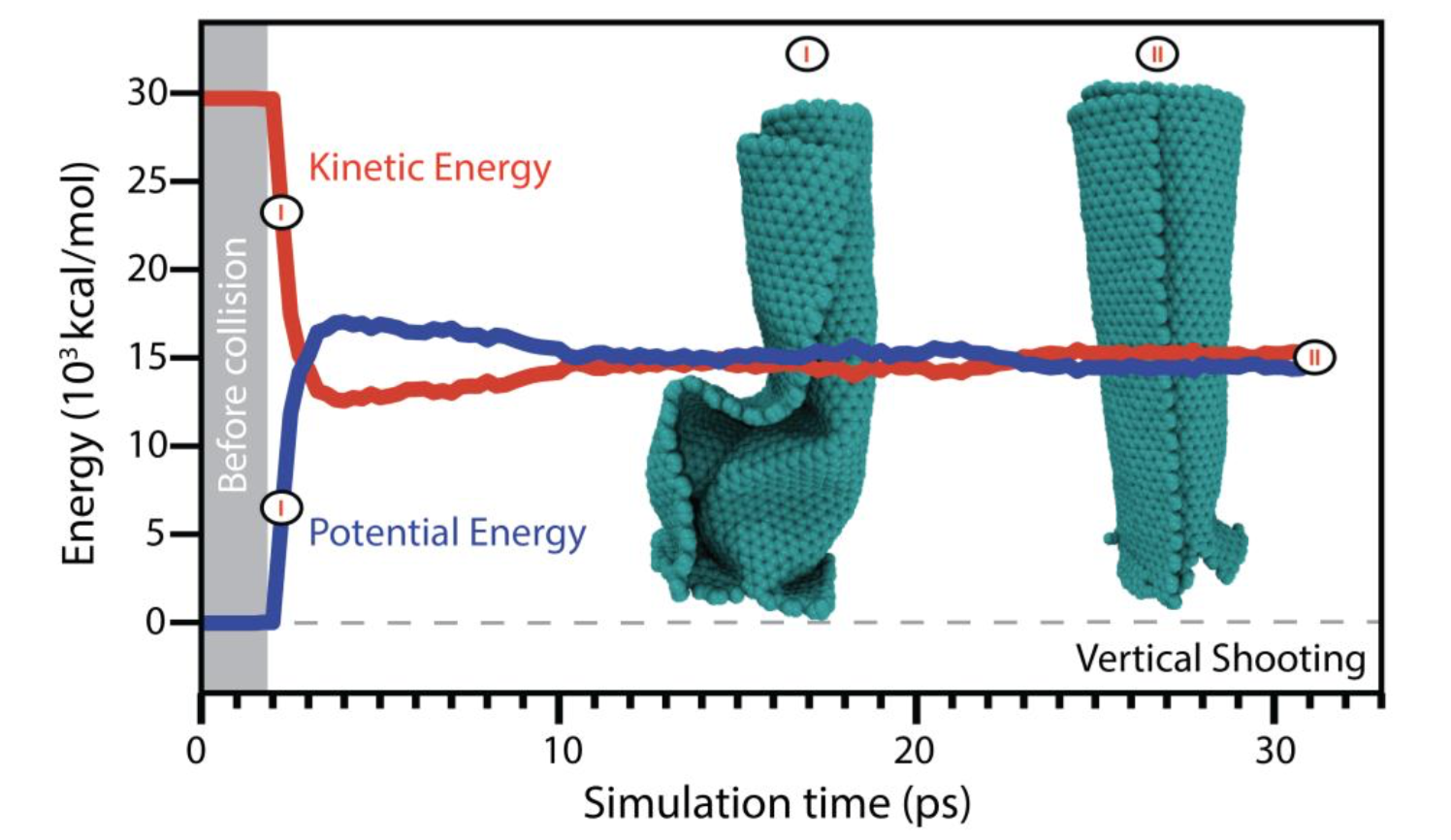
Leonardo Dantas Machado José Moreira de Sousa, Cristiano Francisco Woellner; Galvao, Douglas S.
Carbon Nanoscrolls at High Impacts: A Molecular Dynamics Investigation Journal Article
Em: MRS Advances, vol. 2016, 2016.
Resumo | Links | BibTeX | Tags: Impact Molecular Dynamics, nanoscrolls
@article{deSousa2016b,
title = {Carbon Nanoscrolls at High Impacts: A Molecular Dynamics Investigation},
author = {José Moreira de Sousa, Leonardo Dantas Machado, Cristiano Francisco Woellner, Pedro Alves da Silva Autreto and Douglas S. Galvao},
url = {http://journals.cambridge.org/action/displayAbstract?fromPage=online&aid=10242265&fulltextType=RA&fileId=S2059852116002000},
doi = {10.1557/adv.2016.200},
year = {2016},
date = {2016-03-01},
journal = {MRS Advances},
volume = {2016},
abstract = {The behavior of nanostructures under high strain-rate conditions has been object of interest in recent years. For instance, recent experimental investigations showed that at high velocity impacts carbon nanotubes can unzip resulting into graphene nanoribbons. Carbon nanoscrolls (CNS) are among the structures whose high impact behavior has not yet been investigated. CNS are graphene membranes rolled up into papyrus-like structures. Their unique open-ended topology leads to properties not found in close-ended structures, such as nanotubes. Here we report a fully atomistic reactive molecular dynamics study on the behavior of CNS colliding at high velocities against solid targets. Our results show that the velocity and scroll axis orientation are key parameters to determine the resulting formed nanostructures after impact. The relative orientation of the scroll open ends and the substrate is also very important. We observed that for appropriate velocities and orientations, the nanoscrolls can experience large structural deformations and large-scale fractures. We have also observed unscrolling (scrolls going back to planar or quasi-planar graphene membranes), unzip resulting into nanoribbons, and significant reconstructions from breaking and/or formation of new chemical bonds. Another interesting result was that if the CNS impact the substrate with their open ends, for certain velocities, fused scroll walls were observed.},
keywords = {Impact Molecular Dynamics, nanoscrolls},
pubstate = {published},
tppubtype = {article}
}
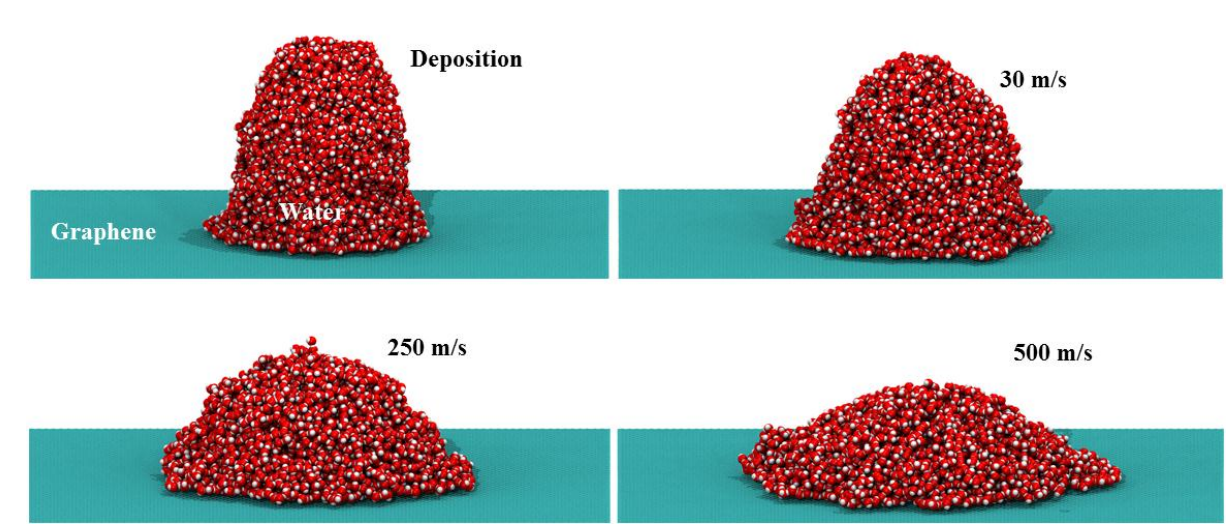
Ygor M. Jaques, Gustavo Brunetto; Galvão, Douglas S.
Nanodroplets Impacting on Graphene Journal Article
Em: MRS Advances, vol. 2016, 2016.
Resumo | Links | BibTeX | Tags: Graphene, Impact Molecular Dynamics, nanodroplet
@article{Jaques2016b,
title = {Nanodroplets Impacting on Graphene},
author = {Ygor M. Jaques, Gustavo Brunetto and Douglas S. Galvão},
url = {http://journals.cambridge.org/action/displayAbstract?fromPage=online&aid=10253580&fulltextType=RA&fileId=S2059852116002218},
doi = {DOI: 10.1557/adv.2016.221},
year = {2016},
date = {2016-03-01},
journal = {MRS Advances},
volume = {2016},
abstract = {The unique and remarkable properties of graphene can be exploited as the basis to a wide
range of applications. However, in spite of years of investigations there are some important
graphene properties that are not still fully understood, as for example, its wettability. There are
controversial reported results whether graphene is really hydrophobic or hydrophilic. In order to
address this problem we have carried out classical molecular dynamics simulations of water
nanodroplets shot against graphene surface. Our results show that the contact angle values
between the nanodroplets and graphene surfaces depend on the initial droplet velocity value and
these angles can change from 86º (hydrophobic) to 35º (hydrophilic). Our preliminary results
indicate that the graphene wettability can be dependent on spreading liquid dynamics and which
can explain some of the apparent inconsistencies reported in the literature.},
keywords = {Graphene, Impact Molecular Dynamics, nanodroplet},
pubstate = {published},
tppubtype = {article}
}
range of applications. However, in spite of years of investigations there are some important
graphene properties that are not still fully understood, as for example, its wettability. There are
controversial reported results whether graphene is really hydrophobic or hydrophilic. In order to
address this problem we have carried out classical molecular dynamics simulations of water
nanodroplets shot against graphene surface. Our results show that the contact angle values
between the nanodroplets and graphene surfaces depend on the initial droplet velocity value and
these angles can change from 86º (hydrophobic) to 35º (hydrophilic). Our preliminary results
indicate that the graphene wettability can be dependent on spreading liquid dynamics and which
can explain some of the apparent inconsistencies reported in the literature.
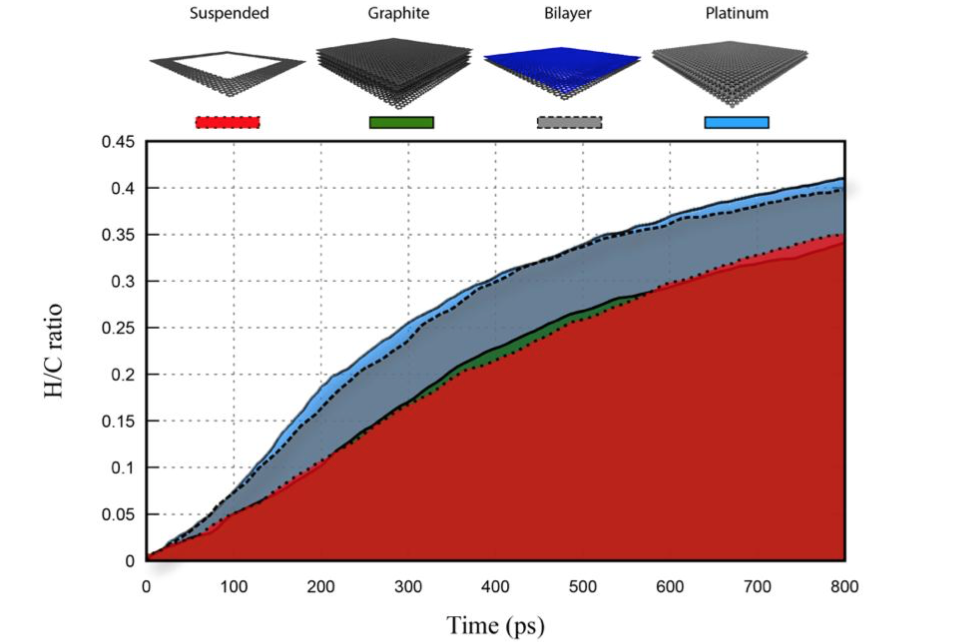
Pedro Alves da Silva Autreto Cristiano Francisco Woellner, Douglas S. Galvao
One Side-Graphene Hydrogenation (Graphone): Substrate Effects Journal Article
Em: MRS Advances, vol. 2016, 2016.
Resumo | Links | BibTeX | Tags: Graphane, Graphene, graphone, Molecular Dynamics
@article{Woellner2016b,
title = {One Side-Graphene Hydrogenation (Graphone): Substrate Effects},
author = {Cristiano Francisco Woellner, Pedro Alves da Silva Autreto, Douglas S. Galvao},
url = {http://journals.cambridge.org/action/displayAbstract?fromPage=online&aid=10234793&fulltextType=RA&fileId=S2059852116001961},
doi = {DOI: 10.1557/adv.2016.196},
year = {2016},
date = {2016-03-01},
journal = {MRS Advances},
volume = {2016},
abstract = {Recent studies on graphene hydrogenation processes showed that hydrogenation occurs via island growing domains, however how the substrate can affect the hydrogenation dynamics and/or pattern formation has not been yet properly investigated. In this work we have addressed these issues through fully atomistic reactive molecular dynamics simulations. We investigated the structural and dynamical aspects of the hydrogenation of graphene membranes (one-side hydrogenation, the so called graphone structure) on different substrates (graphene, few-layers graphene, graphite and platinum). Our results also show that the observed hydrogenation rates are very sensitive to the substrate type. For all investigated cases, the largest fraction of hydrogenated carbon atoms was for platinum substrates. Our results also show that a significant number of randomly distributed H clusters are formed during the early stages of the hydrogenation process, regardless of the type of substrate. These results suggest that, similarly to graphane formation, large perfect graphone-like domains are unlikely to be formed. These findings are especially important since experiments have showed that cluster formation influences the electronic transport properties in hydrogenated graphene.
},
keywords = {Graphane, Graphene, graphone, Molecular Dynamics},
pubstate = {published},
tppubtype = {article}
}
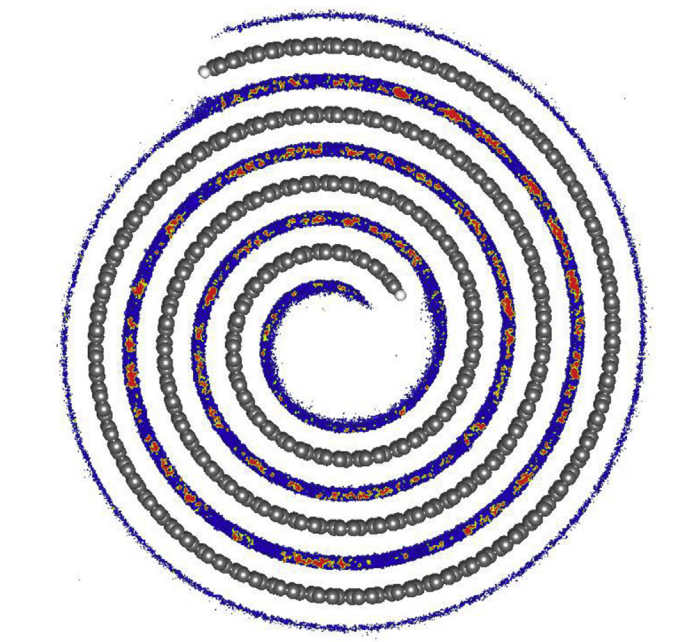
Daff, Thomas D; Collins, Sean P; Durekova, Hana; Perim, E; Skaf, Munir S; Galvão, Douglas S; Woo, Tom K
Evaluation of carbon nanoscroll materials for post-combustion CO2 capture Journal Article
Em: Carbon, vol. 101, pp. 218–225, 2016.
Resumo | Links | BibTeX | Tags: CO2 capture, Molecular Dynamics, Scrolls
@article{Daff2016,
title = {Evaluation of carbon nanoscroll materials for post-combustion CO2 capture},
author = {Daff, Thomas D and Collins, Sean P and Durekova, Hana and Perim, E and Skaf, Munir S and Galvão, Douglas S and Woo, Tom K},
url = {http://www.sciencedirect.com/science/article/pii/S0008622316300604},
doi = {10.1016/j.carbon.2016.01.072},
year = {2016},
date = {2016-02-11},
journal = {Carbon},
volume = {101},
pages = {218–225},
abstract = {Carbon nanoscrolls are similar to multi-walled carbon nanotubes but constructed from rolled graphene sheets into papyrus-like structures. In this work, molecular simulations are used to evaluate the post-combustion CO2 capture properties of nanoscrolls made of graphene, α-, β-, and γ-graphyne, boron nitride, and three types of carbon nitride. The CO2 uptake capacity, CO2/N2 selectivity and CO2 working capacity were computed with grand canonical Monte Carlo simulations at conditions relevant to post-combustion CO2 capture. The interlayer spacing of the nanoscrolls was optimized for each property and sheet material. For graphene nanoscrolls, the optimal interlayer spacing of 7.3 Å was identified for both the CO2 uptake and selectivity, while for working capacity the optimal interlayer spacing was determined to be 8.6 Å. It was found that the CO2 uptake capacity of the materials correlated to the density of the sheets from which they were formed. Nanoscrolls made from graphene and boron nitride, which have the highest number of atoms per unit area, also showed the highest CO2 uptakes. At 0.15 bar CO2, 313 K, graphene and boron nitride nanoscrolls exhibited exceptional CO2 uptake capacities of 7.7 and 8.2 mmol/g, respectively, while also exhibiting high CO2/N2 selectivities of 135 and 153, respectively. Molecular dynamics simulations were used to examine the adsorption kinetics. The simulations showed that an empty graphene nanoscroll with a roll length of 200 Å could adsorb CO2 into the center of the roll within 10 ns. Materials with pores that can allow CO2 to pass through, such as graphynes, showed much faster adsorption times.},
keywords = {CO2 capture, Molecular Dynamics, Scrolls},
pubstate = {published},
tppubtype = {article}
}
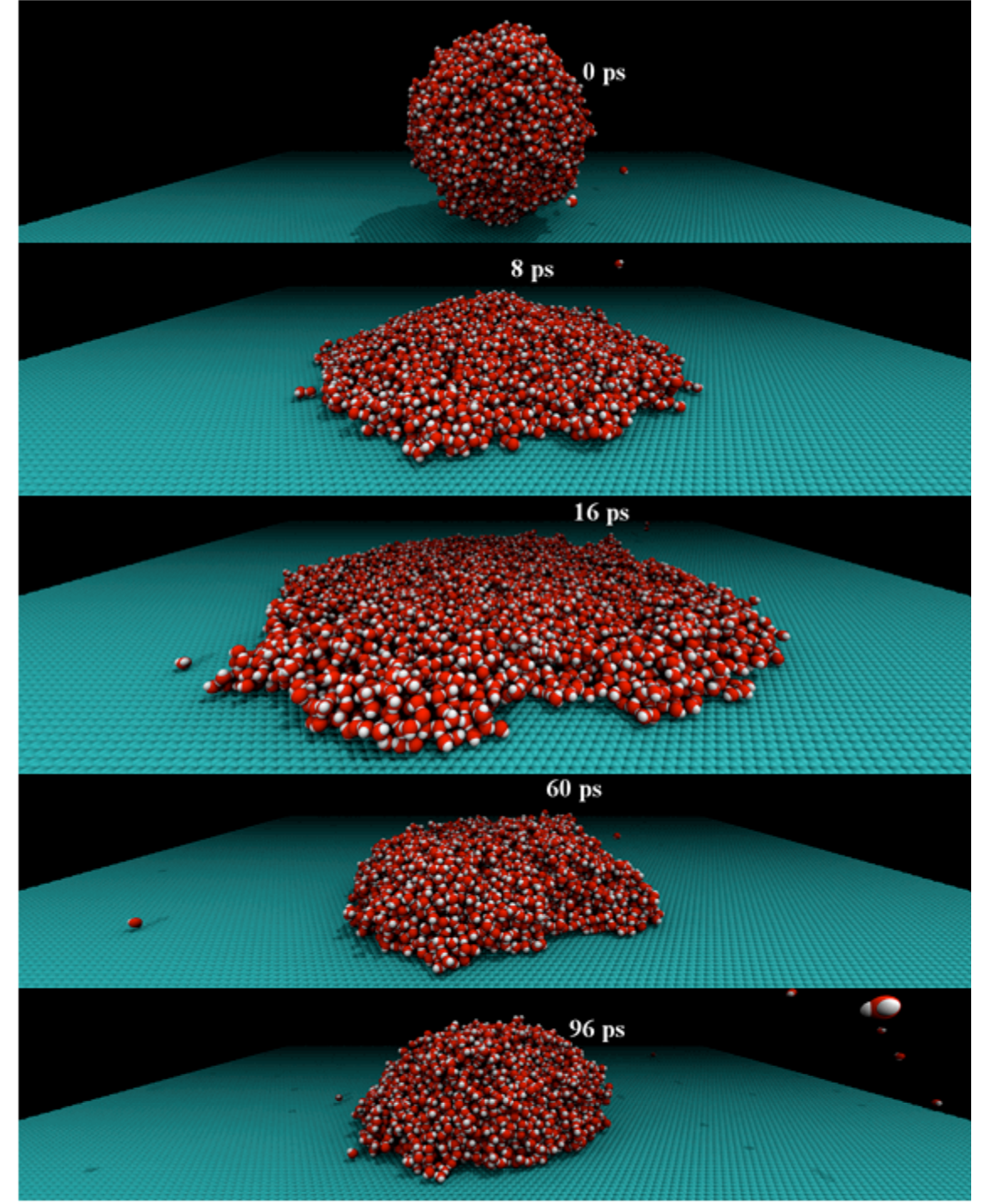
Jaques, Ygor M.; Brunetto, Gustavo; Galvao, Douglas S.
Nanodroplets Impacting on Graphene Online
2016, ((ArXiv preprint)).
Resumo | Links | BibTeX | Tags: Droplet, Graphene, Molecular Dynamics
@online{Jaques2016,
title = {Nanodroplets Impacting on Graphene},
author = {Jaques, Ygor M. and Brunetto, Gustavo and Galvao, Douglas S.},
url = {http://arxiv.org/abs/1602.02013},
year = {2016},
date = {2016-02-05},
abstract = {The unique and remarkable properties of graphene can be exploited as the basis to a wide
range of applications. However, in spite of years of investigations there are some important
graphene properties that are not still fully understood, as for example, its wettability. There are
controversial reported results whether graphene is really hydrophobic or hydrophilic. In order to
address this problem we have carried out classical molecular dynamics simulations of water
nanodroplets shot against graphene surface. Our results show that the contact angle values
between the nanodroplets and graphene surfaces depend on the initial droplet velocity value and
these angles can change from 86º (hydrophobic) to 35º (hydrophilic). Our preliminary results
indicate that the graphene wettability can be dependent on spreading liquid dynamics and which
can explain some of the apparent inconsistencies reported in the literature.},
note = {(ArXiv preprint)},
keywords = {Droplet, Graphene, Molecular Dynamics},
pubstate = {published},
tppubtype = {online}
}
range of applications. However, in spite of years of investigations there are some important
graphene properties that are not still fully understood, as for example, its wettability. There are
controversial reported results whether graphene is really hydrophobic or hydrophilic. In order to
address this problem we have carried out classical molecular dynamics simulations of water
nanodroplets shot against graphene surface. Our results show that the contact angle values
between the nanodroplets and graphene surfaces depend on the initial droplet velocity value and
these angles can change from 86º (hydrophobic) to 35º (hydrophilic). Our preliminary results
indicate that the graphene wettability can be dependent on spreading liquid dynamics and which
can explain some of the apparent inconsistencies reported in the literature.
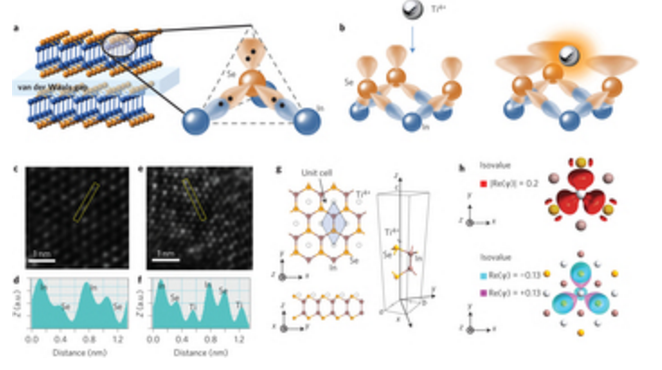
Xifan Wang Sidong Lei, Bo Li
Surface functionalization of two-dimensional metal chalcogenides by Lewis acid–base chemistry Journal Article
Em: Nature Nanotechnology, vol. 11, pp. 465–471, 2016.
Resumo | Links | BibTeX | Tags: Chalcogenides, Modelling, Synthesis, top20
@article{Lei2016,
title = {Surface functionalization of two-dimensional metal chalcogenides by Lewis acid–base chemistry},
author = {Sidong Lei, Xifan Wang, Bo Li, Jiahao Kang, Yongmin He, Antony George, Liehui Ge, Yongji Gong, Pei Dong, Zehua Jin, Gustavo Brunetto, Weibing Chen, Zuan-Tao Lin, Robert Baines, Douglas S. Galvão, Jun Lou, Enrique Barrera, Kaustav Banerjee, Robert Vajtai & Pulickel Ajayan},
url = {http://www.nature.com/nnano/journal/vaop/ncurrent/full/nnano.2015.323.html},
doi = {10.1038/nnano.2015.323},
year = {2016},
date = {2016-02-01},
journal = {Nature Nanotechnology},
volume = {11},
pages = {465–471},
abstract = {Precise control of the electronic surface states of two-dimensional (2D) materials could improve their versatility and widen their applicability in electronics and sensing. To this end, chemical surface functionalization has been used to adjust the electronic properties of 2D materials. So far, however, chemical functionalization has relied on lattice defects and physisorption methods that inevitably modify the topological characteristics of the atomic layers. Here we make use of the lone pair electrons found in most of 2D metal chalcogenides and report a functionalization method via a Lewis acid–base reaction that does not alter the host structure. Atomic layers of n-type InSe react with Ti4+ to form planar p-type [Ti4+n(InSe)] coordination complexes. Using this strategy, we fabricate planar p–n junctions on 2D InSe with improved rectification and photovoltaic properties, without requiring heterostructure growth procedures or device fabrication processes. We also show that this functionalization approach works with other Lewis acids (such as B3+, Al3+ and Sn4+) and can be applied to other 2D materials (for example MoS2, MoSe2). Finally, we show that it is possible to use Lewis acid–base chemistry as a bridge to connect molecules to 2D atomic layers and fabricate a proof-of-principle dye-sensitized photosensing device.
},
keywords = {Chalcogenides, Modelling, Synthesis, top20},
pubstate = {published},
tppubtype = {article}
}
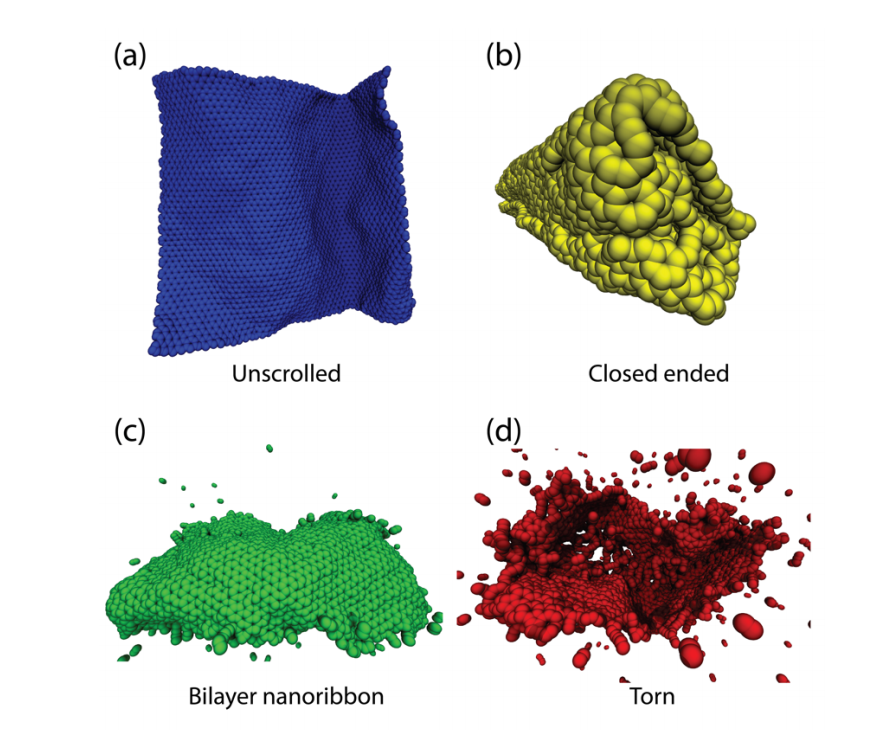
de Sousa, Jose Moreira; Machado, Leonardo Dantas; Woellner, Cristiano Francisco; Autreto, Pedro Alves da Silva; Galvao, Douglas S
Carbon Nanoscrolls at High Impacts: A Molecular Dynamics Investigation Online
2016, ((ArXiv Preprint)).
Resumo | Links | BibTeX | Tags: Ballistic Impact, Molecular Dynamics, Scrolls
@online{deSousa2016b,
title = {Carbon Nanoscrolls at High Impacts: A Molecular Dynamics Investigation},
author = {de Sousa, Jose Moreira and Machado, Leonardo Dantas and Woellner, Cristiano Francisco and Autreto, Pedro Alves da Silva and Galvao, Douglas S},
url = {http://arxiv.org/abs/1601.04875},
year = {2016},
date = {2016-01-19},
abstract = {The behavior of nanostructures under high strain-rate conditions has been object of interest in recent years. For instance, recent experimental investigations showed that at high velocity impacts carbon nanotubes can unzip resulting into graphene nanoribbons. Carbon nanoscrolls (CNS) are among the structures whose high impact behavior has not yet been investigated. CNS are graphene membranes rolled up into papyrus-like structures. Their unique open-ended topology leads to properties not found in close-ended structures, such as nanotubes. Here we report a fully atomistic reactive molecular dynamics study on the behavior of CNS colliding at high velocities against solid targets. Our results show that the velocity and scroll axis orientation are key parameters to determine the resulting formed nanostructures after impact. The relative orientation of the scroll open ends and the substrate is also very important. We observed that for appropriate velocities and orientations, the nanoscrolls can experience large structural deformations and large-scale fractures. We have also observed unscrolling (scrolls going back to planar or quasi-planar graphene membranes), unzip resulting into nanoribbons, and significant reconstructions from breaking and/or formation of new chemical bonds. Another interesting result was that if the CNS impact the substrate with their open ends, for certain velocities, fused scroll walls were observed.},
note = {(ArXiv Preprint)},
keywords = {Ballistic Impact, Molecular Dynamics, Scrolls},
pubstate = {published},
tppubtype = {online}
}
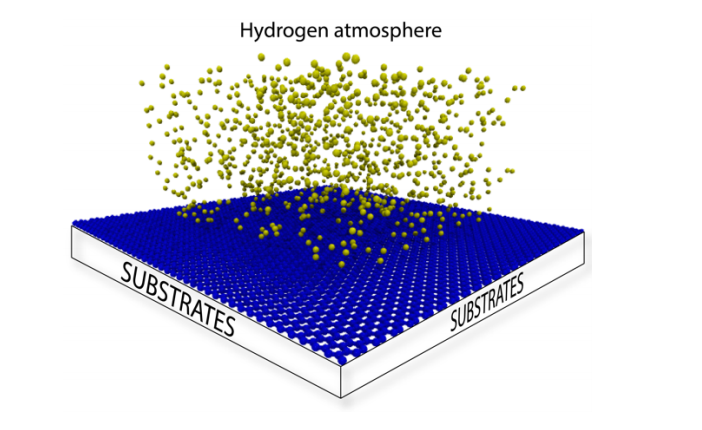
Woellner, Cristiano Francisco; Autreto, Pedro Alves da Silva; Galvao, Douglas S
One Side-Graphene Hydrogenation (Graphone): Substrate Effects Online
2016, visited: 18.01.2016, ((ArXiv preprint)).
Resumo | Links | BibTeX | Tags: Graphane, Graphene, graphone, Molecular Dynamics
@online{Woellner2016,
title = {One Side-Graphene Hydrogenation (Graphone): Substrate Effects},
author = {Woellner, Cristiano Francisco and Autreto, Pedro Alves da Silva and Galvao, Douglas S},
url = {http://arxiv.org/abs/1601.04484},
year = {2016},
date = {2016-01-18},
urldate = {2016-01-18},
abstract = {Recent studies on graphene hydrogenation processes showed that hydrogenation occurs
via island growing domains, however how the substrate can affect the hydrogenation dynamics
and/or pattern formation has not been yet properly investigated. In this work we have addressed
these issues through fully atomistic reactive molecular dynamics simulations. We investigated
the structural and dynamical aspects of the hydrogenation of graphene membranes (one-side
hydrogenation, the so called graphone structure) on different substrates (graphene, few-layers
graphene, graphite and platinum). Our results also show that the observed hydrogenation rates
are very sensitive to the substrate type. For all investigated cases, the largest fraction of
hydrogenated carbon atoms was for platinum substrates. Our results also show that a significant
number of randomly distributed H clusters are formed during the early stages of the
hydrogenation process, regardless of the type of substrate and temperature. These results suggest
that, similarly to graphane formation, large perfect graphone-like domains are unlikely to be
formed. These findings are especially important since experiments have showed that cluster
formation influences the electronic transport properties in hydrogenated graphene.},
note = {(ArXiv preprint)},
keywords = {Graphane, Graphene, graphone, Molecular Dynamics},
pubstate = {published},
tppubtype = {online}
}
via island growing domains, however how the substrate can affect the hydrogenation dynamics
and/or pattern formation has not been yet properly investigated. In this work we have addressed
these issues through fully atomistic reactive molecular dynamics simulations. We investigated
the structural and dynamical aspects of the hydrogenation of graphene membranes (one-side
hydrogenation, the so called graphone structure) on different substrates (graphene, few-layers
graphene, graphite and platinum). Our results also show that the observed hydrogenation rates
are very sensitive to the substrate type. For all investigated cases, the largest fraction of
hydrogenated carbon atoms was for platinum substrates. Our results also show that a significant
number of randomly distributed H clusters are formed during the early stages of the
hydrogenation process, regardless of the type of substrate and temperature. These results suggest
that, similarly to graphane formation, large perfect graphone-like domains are unlikely to be
formed. These findings are especially important since experiments have showed that cluster
formation influences the electronic transport properties in hydrogenated graphene.
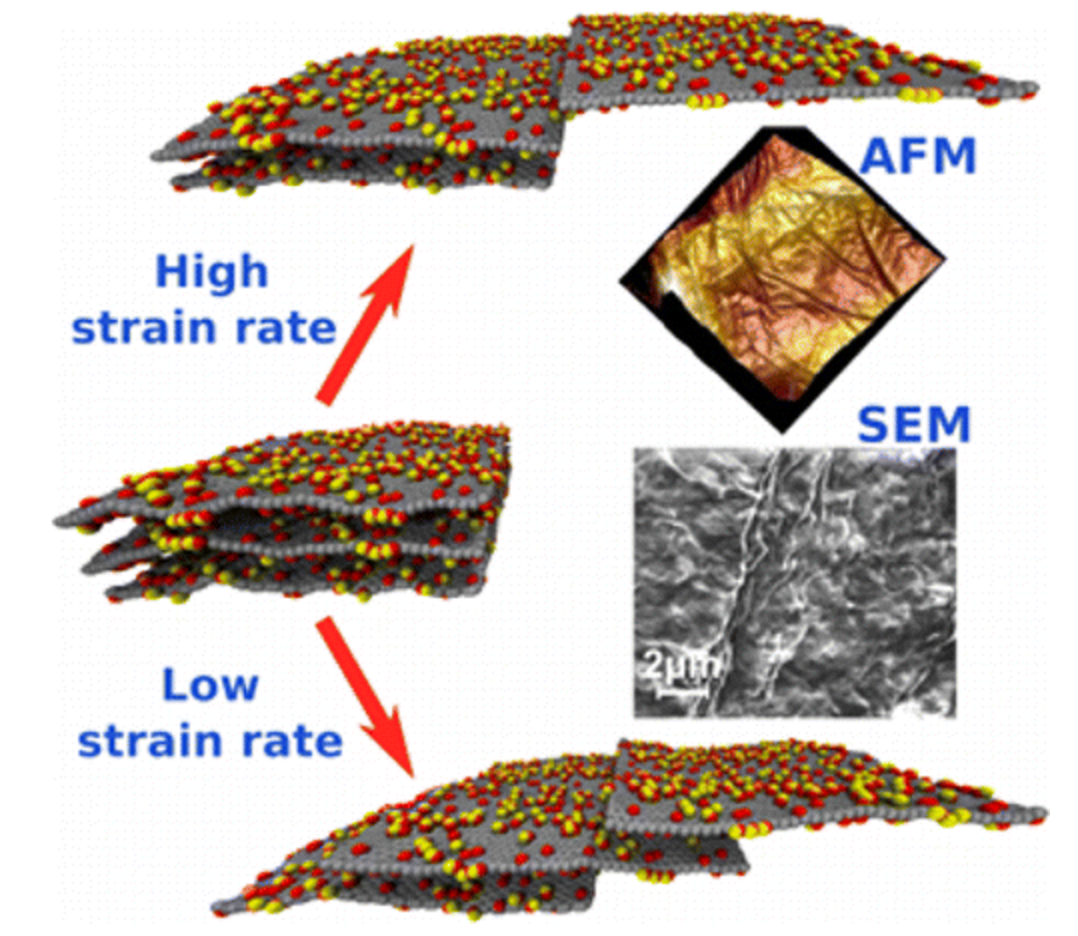
Vinod, Soumya; Tiwary, Chandra Sekhar; Machado, Leonardo Dantas; Ozden, Sehmus; Shaw, Preston; Cho, Juny; Vajtai, Robert; Galvao, Douglas Soares; Ajayan, Pulickel M
Strain Rate Dependent Shear Plasticity in Graphite Oxide Journal Article
Em: Nano Letters, vol. 16, não 2, pp. 1127–1131, 2016.
Resumo | Links | BibTeX | Tags: graphene oxide, Molecular Dynamics, plasticity
@article{Vinod2016,
title = {Strain Rate Dependent Shear Plasticity in Graphite Oxide},
author = {Vinod, Soumya and Tiwary, Chandra Sekhar and Machado, Leonardo Dantas and Ozden, Sehmus and Shaw, Preston and Cho, Juny and Vajtai, Robert and Galvao, Douglas Soares and Ajayan, Pulickel M},
url = {http://pubs.acs.org/doi/abs/10.1021/acs.nanolett.5b04346},
doi = {10.1021/acs.nanolett.5b04346},
year = {2016},
date = {2016-01-16},
journal = {Nano Letters},
volume = {16},
number = {2},
pages = {1127–1131},
abstract = {Graphene oxide film is made of stacked graphene layers with chemical functionalities, and we report that plasticity in the film can be engineered by strain rate tuning. The deformation behavior and plasticity of such functionalized layered systems is dominated by shear slip between individual layers and interaction between functional groups. Stress–strain behavior and theoretical models suggest that the deformation is strongly strain rate dependent and undergoes brittle to ductile transition with decreasing strain rate.},
keywords = {graphene oxide, Molecular Dynamics, plasticity},
pubstate = {published},
tppubtype = {article}
}
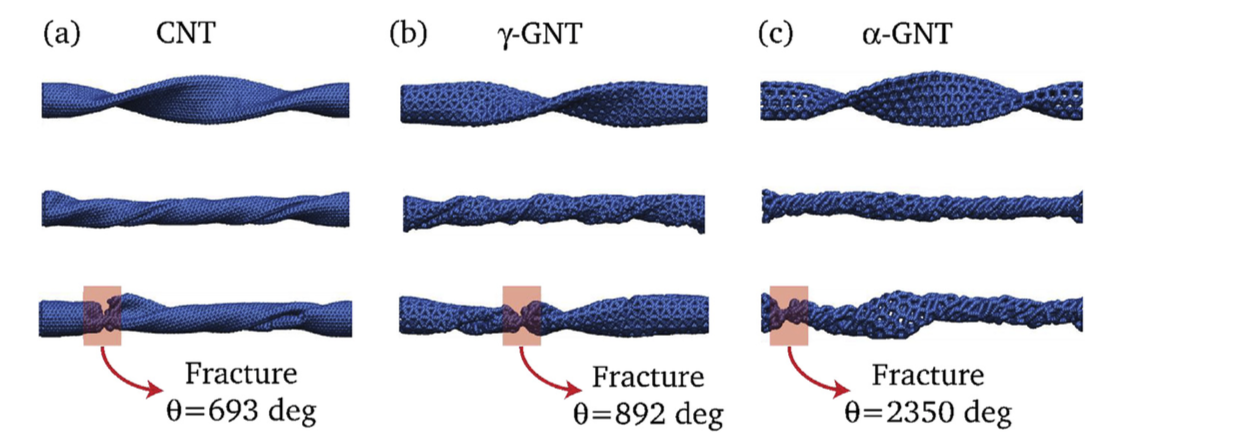
G. Brunetto J.M. de Sousa, V. R. Coluci
Torsional “superplasticity” of graphyne nanotubes Journal Article
Em: Carbon, vol. 96, pp. 14-19, 2016.
Resumo | Links | BibTeX | Tags: Fracture, Graphynes, Mechanical Properties, Nanotubes
@article{deSousa2016,
title = {Torsional “superplasticity” of graphyne nanotubes},
author = {J.M. de Sousa, G. Brunetto, V.R. Coluci, D.S. Galvao },
url = {http://www.sciencedirect.com/science/article/pii/S000862231530258X},
doi = { http://dx.doi.org/10.1016/j.carbon.2015.09.039},
year = {2016},
date = {2016-01-01},
journal = {Carbon},
volume = {96},
pages = {14-19},
abstract = {Graphyne is a planar two-dimensional carbon allotrope formed by atoms in sp, sp2, and sp3 hybridized states. Topologically graphyne nanotubes (GNTs) can be considered as cylindrically rolled up graphyne sheets, similarly as carbon nanotubes (CNTs) can be considered rolled up graphene sheets. Due to the presence of single, double, and triple bonds, GNTs exhibit porous sidewalls that can be exploited in many diverse applications. In this work, we investigated the mechanical behavior of GNTs under torsional strains through reactive molecular dynamics simulations. Our results show that GNTs are more flexible than CNTs and exhibit “superplasticit”, with fracture angles that are up to 35 times higher than the ones reported to CNTs. This GNT “superplastic” behavior can be explained in terms of irreversible recon- struction processes (mainly associated with the triple bonds) that occur during torsional strains.},
keywords = {Fracture, Graphynes, Mechanical Properties, Nanotubes},
pubstate = {published},
tppubtype = {article}
}

Dong, Pei; Chipara, Alin Cristian; Loya, Phillip; Yang, Yingchao; Ge, Liehui; Lei, Sidong; Li, Bo; Brunetto, Gustavo; Machado, Leonardo Dantas; Hong, Liang; others,
A Solid-liquid Self-adaptive Polymeric Composite Journal Article
Em: ACS Applied Materials & Interfaces, vol. 8, não 3, pp. 2142–2147, 2016.
Resumo | Links | BibTeX | Tags: Adhesives, Modelling, Polymers
@article{Dong2016,
title = {A Solid-liquid Self-adaptive Polymeric Composite},
author = {Dong, Pei and Chipara, Alin Cristian and Loya, Phillip and Yang, Yingchao and Ge, Liehui and Lei, Sidong and Li, Bo and Brunetto, Gustavo and Machado, Leonardo Dantas and Hong, Liang and others},
url = {http://pubs.acs.org/doi/abs/10.1021/acsami.5b10667},
doi = {10.1021/acsami.5b10667},
year = {2016},
date = {2016-01-01},
journal = {ACS Applied Materials & Interfaces},
volume = {8},
number = {3},
pages = {2142–2147},
abstract = {A solid–liquid self-adaptive composite (SAC) is synthesized using a simple mixing–evaporation protocol, with poly(dimethylsiloxane) (PDMS) and poly(vinylidene fluoride) (PVDF) as active constituents. SAC exists as a porous solid containing a near equivalent distribution of the solid (PVDF)–liquid (PDMS) phases, with the liquid encapsulated and stabilized within a continuous solid network percolating throughout the structure. The pores, liquid, and solid phases form a complex hierarchical structure, which offers both mechanical robustness and a significant structural adaptability under external forces. SAC exhibits attractive self-healing properties during tension, and demonstrates reversible self-stiffening properties under compression with a maximum of 7-fold increase seen in the storage modulus. In a comparison to existing self-healing and self-stiffening materials, SAC offers distinct advantages in the ease of fabrication, high achievable storage modulus, and reversibility. Such materials could provide a new class of adaptive materials system with multifunctionality, tunability, and scale-up potentials.
},
keywords = {Adhesives, Modelling, Polymers},
pubstate = {published},
tppubtype = {article}
}
2015
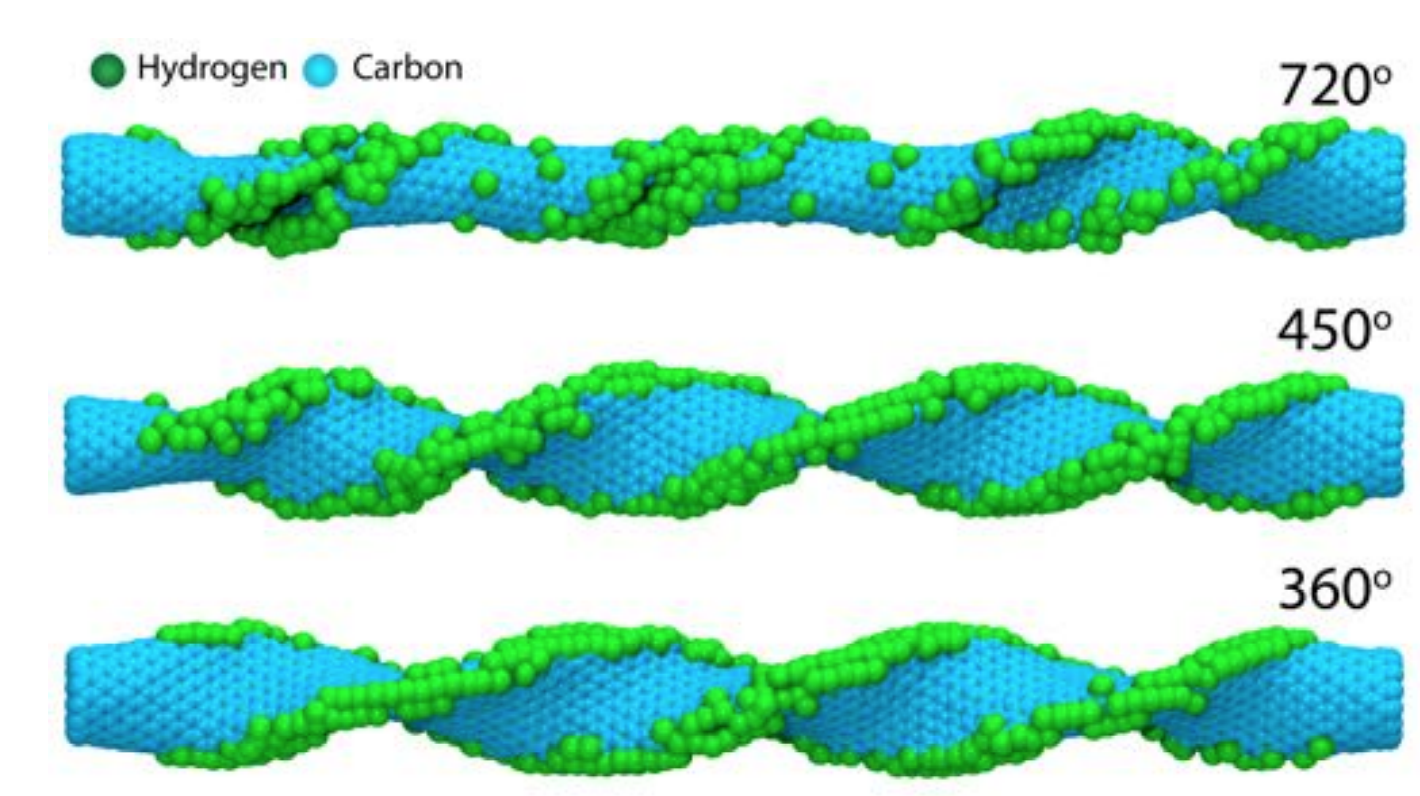
de Sousa, Jose M.; Autreto, Pedro A. S.; Galvao, Douglas S.
Hydrogenation Dynamics of Twisted Carbon Nanotubes Online
2015, (ArXiv preprint).
Resumo | Links | BibTeX | Tags: Carbon Nanotubes, Hydrogenation, Mechanical Properties, Molecular Dynamics
@online{deSousa2015,
title = {Hydrogenation Dynamics of Twisted Carbon Nanotubes},
author = {Jose M. de Sousa and Pedro A. S. Autreto and Douglas S. Galvao},
url = {http://arxiv.org/abs/1510.00265},
year = {2015},
date = {2015-10-01},
abstract = {Carbon Nanotubes (CNTs) are one of the most important materials in nanotechnology. In some of their technological applications (electromechanical oscillators and mechanical actuators for artificial muscles, for instance), it is necessary to subject them to large deformations. Although this frequently happens in air, there are only few studies about the interaction of deformed CNTs with the atmosphere and the dynamics of these processes has not yet been addressed. In this work, we have investigated, through fully atomistic reactive molecular dynamics simulations, the process of hydrogenation of highly twisted CNTs. Our results show that hydrogenation effective ratio is directly related to the tube twist angle values and can lead to twisted tube fractures with well defined patterns (unzip-like). Our results also show that these fracture processes can be exploited to controllably produce graphene nanoribbons.},
note = {ArXiv preprint},
keywords = {Carbon Nanotubes, Hydrogenation, Mechanical Properties, Molecular Dynamics},
pubstate = {published},
tppubtype = {online}
}
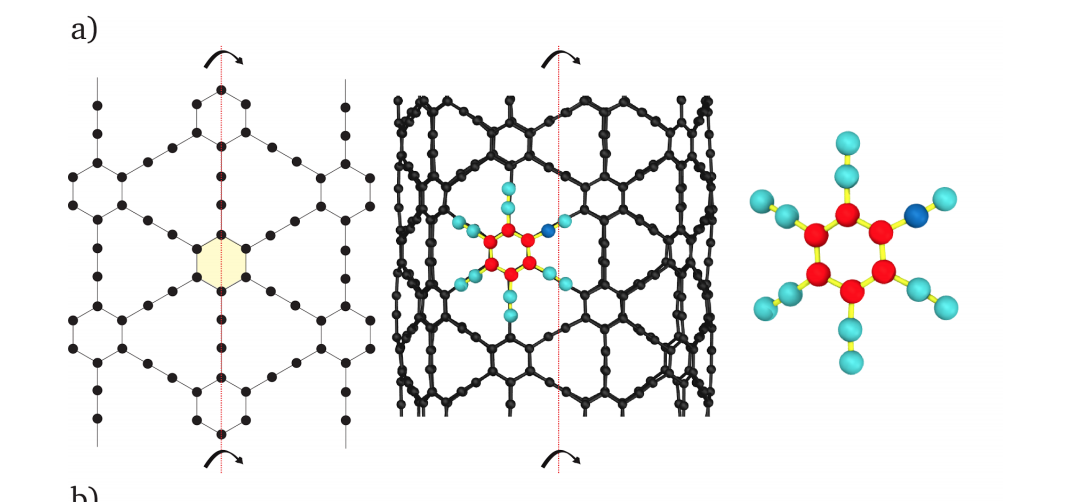
Gustavo Brunetto Jose M. de Sousa, Vitor R. Coluci
Torsional "Superplasticity" of Graphyne Nanotubes Online
2015, (ArXiv reprint of Torsional "Superplasticity" of Graphyne Nanotubes, published in Carbon 96, 14 (2016).).
Resumo | Links | BibTeX | Tags: Allotropes, Graphynes, Mechanical Properties, Nanotubes
@online{deSousa2015b,
title = {Torsional "Superplasticity" of Graphyne Nanotubes},
author = {Jose M. de Sousa, Gustavo Brunetto, Vitor R. Coluci, Douglas S. Galvao},
url = {http://arxiv.org/abs/1509.08746},
year = {2015},
date = {2015-09-29},
abstract = {Graphyne is a planar two-dimensional carbon allotrope formed by atoms in sp, sp2, and sp3 hybridized states. Topologically graphyne nanotubes (GNTs) can be considered as cylindrically rolled up graphyne sheets, similarly as carbon nanotubes (CNTs) can be considered rolled up graphene sheets. Due to the presence of single, double, and triple bonds, GNTs exhibit porous sidewalls that can be exploited in many diverse applications. In this work, we investigated the mechanical behavior of GNTs under torsional strains through reactive molecular dynamics simulations. Our results show that GNTs are more flexible than CNTs and exhibit 'superplasticity', with fracture angles that are up to 35 times higher than the ones reported to CNTs. This GNT 'superplastic' behavior can be explained in terms of irreversible reconstruction processes (mainly associated with the triple bonds) that occur during torsional strains.},
note = {ArXiv reprint of Torsional "Superplasticity" of Graphyne Nanotubes, published in Carbon 96, 14 (2016).},
keywords = {Allotropes, Graphynes, Mechanical Properties, Nanotubes},
pubstate = {published},
tppubtype = {online}
}
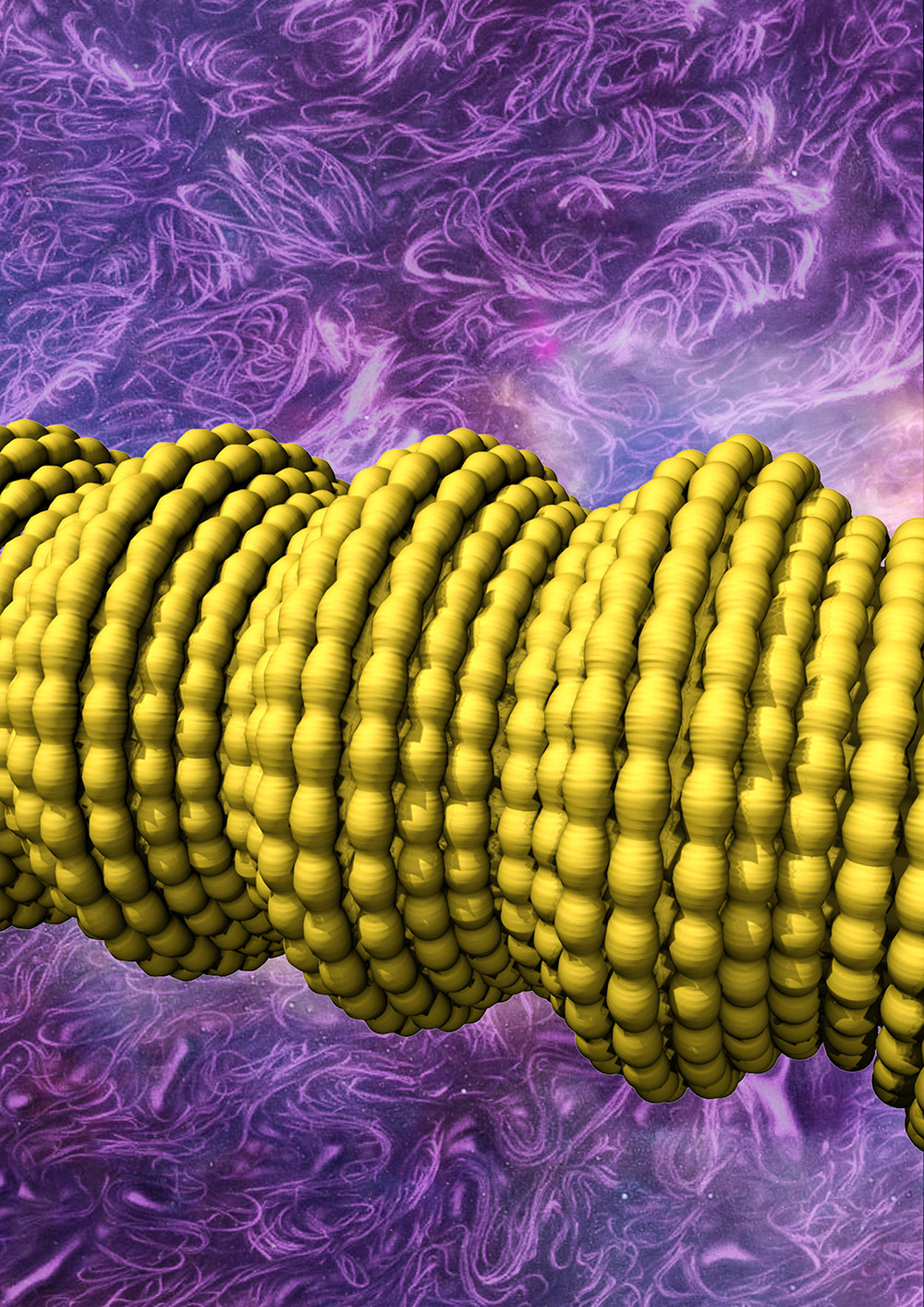
S Fang ZF Liu, FA Moura
Hierarchically buckled sheath-core fibers for superelastic electronics, sensors, and muscles Journal Article
Em: Science, vol. 349, não 6246, pp. 404-404, 2015.
Resumo | Links | BibTeX | Tags: Carbon Nanotube Forests, Finite Elements, Superelastic, top20
@article{Liu2015,
title = {Hierarchically buckled sheath-core fibers for superelastic electronics, sensors, and muscles},
author = {ZF Liu, S Fang, FA Moura, JN Ding, N Jiang, J Di, M Zhang, X Lepró, DS Galvão, CS Haines, NY Yuan, SG Yin, DW Lee, R Wang, HY Wang, W Lv, C Dong, RC Zhang, MJ Chen, Q Yin, YT Chong, R Zhang, X Wang, MD Lima, R Ovalle-Robles, D Qian, H Lu, RH Baughman},
url = {http://www.sciencemag.org/content/349/6246/400.full.pdf},
doi = {10.1126/science.aaa7952},
year = {2015},
date = {2015-07-24},
journal = {Science},
volume = {349},
number = {6246},
pages = {404-404},
abstract = {Superelastic conducting fibers with improved properties and functionalities are needed
for diverse applications. Here we report the fabrication of highly stretchable (up to 1320%)
sheath-core conducting fibers created by wrapping carbon nanotube sheets oriented in
the fiber direction on stretched rubber fiber cores. The resulting structure exhibited
distinct short- and long-period sheath buckling that occurred reversibly out of phase
in the axial and belt directions, enabling a resistance change of less than 5% for a
1000% stretch. By including other rubber and carbon nanotube sheath layers, we
demonstrated strain sensors generating an 860% capacitance change and electrically
powered torsional muscles operating reversibly by a coupled tension-to-torsion
actuation mechanism. Using theory, we quantitatively explain the complementary effects
of an increase in muscle length and a large positive Poisson’s ratio on torsional actuation
and electronic properties.},
keywords = {Carbon Nanotube Forests, Finite Elements, Superelastic, top20},
pubstate = {published},
tppubtype = {article}
}
for diverse applications. Here we report the fabrication of highly stretchable (up to 1320%)
sheath-core conducting fibers created by wrapping carbon nanotube sheets oriented in
the fiber direction on stretched rubber fiber cores. The resulting structure exhibited
distinct short- and long-period sheath buckling that occurred reversibly out of phase
in the axial and belt directions, enabling a resistance change of less than 5% for a
1000% stretch. By including other rubber and carbon nanotube sheath layers, we
demonstrated strain sensors generating an 860% capacitance change and electrically
powered torsional muscles operating reversibly by a coupled tension-to-torsion
actuation mechanism. Using theory, we quantitatively explain the complementary effects
of an increase in muscle length and a large positive Poisson’s ratio on torsional actuation
and electronic properties.
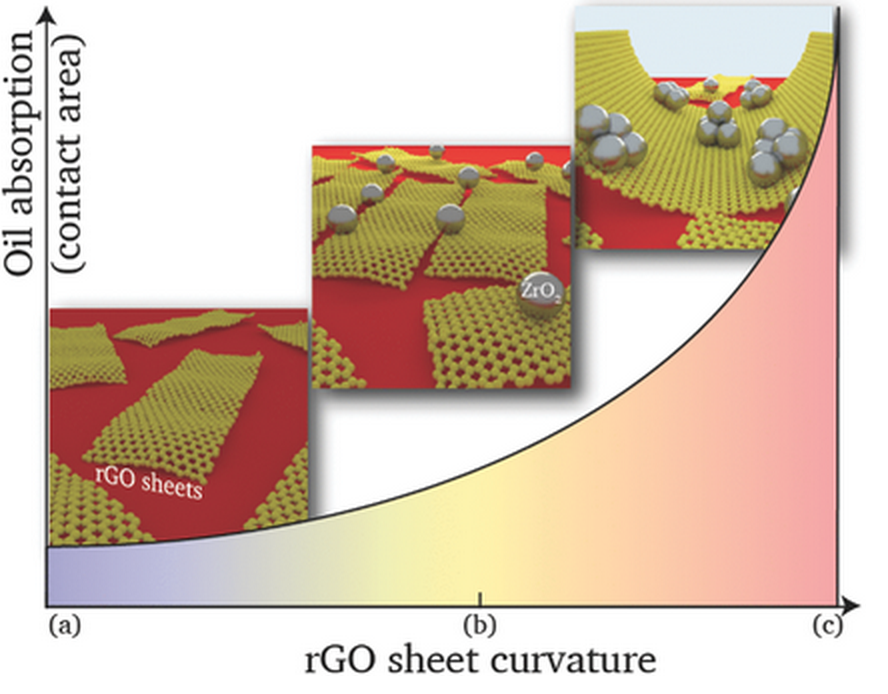
Chandra Sekhar Tiwary Dibyendu Chakravarty, Leonardo Dantas Machado
Zirconia-Nanoparticle-Reinforced Morphology-Engineered Graphene-Based Foams Journal Article
Em: Advanced Materials, vol. 27, não 31, pp. 4534–4543, 2015.
Resumo | Links | BibTeX | Tags: Electronic Structure, Mechanical Properties, Mole, Molecular Dynamics, Nanoparticles, Zirconia
@article{Chakravarty2015,
title = {Zirconia-Nanoparticle-Reinforced Morphology-Engineered Graphene-Based Foams},
author = { Dibyendu Chakravarty , Chandra Sekhar Tiwary , Leonardo Dantas Machado ,
Gustavo Brunetto , Soumya Vinod , Ram Manohar Yadav , Douglas S. Galvao ,
Shrikant V. Joshi , Govindan Sundararajan, Pulickel M. Ajayan },
url = {http://onlinelibrary.wiley.com/doi/10.1002/adma.201502409/full},
doi = {10.1002/adma.201502409},
year = {2015},
date = {2015-07-15},
journal = {Advanced Materials},
volume = {27},
number = {31},
pages = {4534–4543},
abstract = {The morphology of graphene-based foams can be engineered by reinforcing them with nanocrystalline zirconia, thus improving their oil-adsorption capacity; This can be observed experimentally and explained theoretically. Low zirconia fractions yield flaky microstructures where zirconia nanoparticles arrest propagating cracks. Higher zirconia concentrations possess a mesh-like interconnected structure where the degree of coiling is dependant on the local zirconia content.},
keywords = {Electronic Structure, Mechanical Properties, Mole, Molecular Dynamics, Nanoparticles, Zirconia},
pubstate = {published},
tppubtype = {article}
}
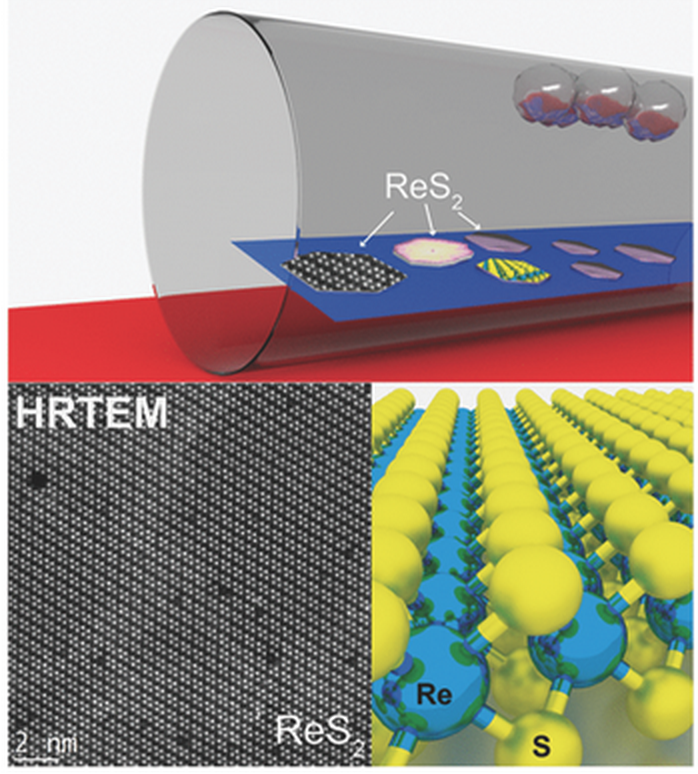
Yongji Gong Kunttal Keyshar, Gonglan Ye
Chemical Vapor Deposition of Monolayer Rhenium Disulfide (ReS2) Journal Article
Em: Advanced Materials, vol. 27, não 31, pp. 4640–4648, 2015.
Resumo | Links | BibTeX | Tags: Electronic Structure, Rhenium Disulfide, Synthesis
@article{Keyshar2015,
title = {Chemical Vapor Deposition of Monolayer Rhenium Disulfide (ReS2)},
author = {Kunttal Keyshar , Yongji Gong , Gonglan Ye , Gustavo Brunetto , Wu Zhou ,
Daniel P. Cole , Ken Hackenberg , Yongmin He , Leonardo Machado , Mohamad Kabbani ,
Amelia H. C. Hart , Bo Li , Douglas S. Galvao , Antony George , Robert Vajtai ,
Chandra Sekhar Tiwary , Pulickel M. Ajayan},
url = {http://onlinelibrary.wiley.com/doi/10.1002/adma.201501795/full},
doi = {10.1002/adma.201501795},
year = {2015},
date = {2015-07-03},
journal = {Advanced Materials},
volume = {27},
number = {31},
pages = {4640–4648},
abstract = {The direct synthesis of monolayer and multilayer ReS2 by chemical vapor deposition at a low temperature of 450 °C is reported. Detailed characterization of this material is performed using various spectroscopy and microscopy methods. Furthermore initial field-effect transistor characteristics are evaluated, which highlight the potential in being used as an n-type semiconductor.},
keywords = {Electronic Structure, Rhenium Disulfide, Synthesis},
pubstate = {published},
tppubtype = {article}
}
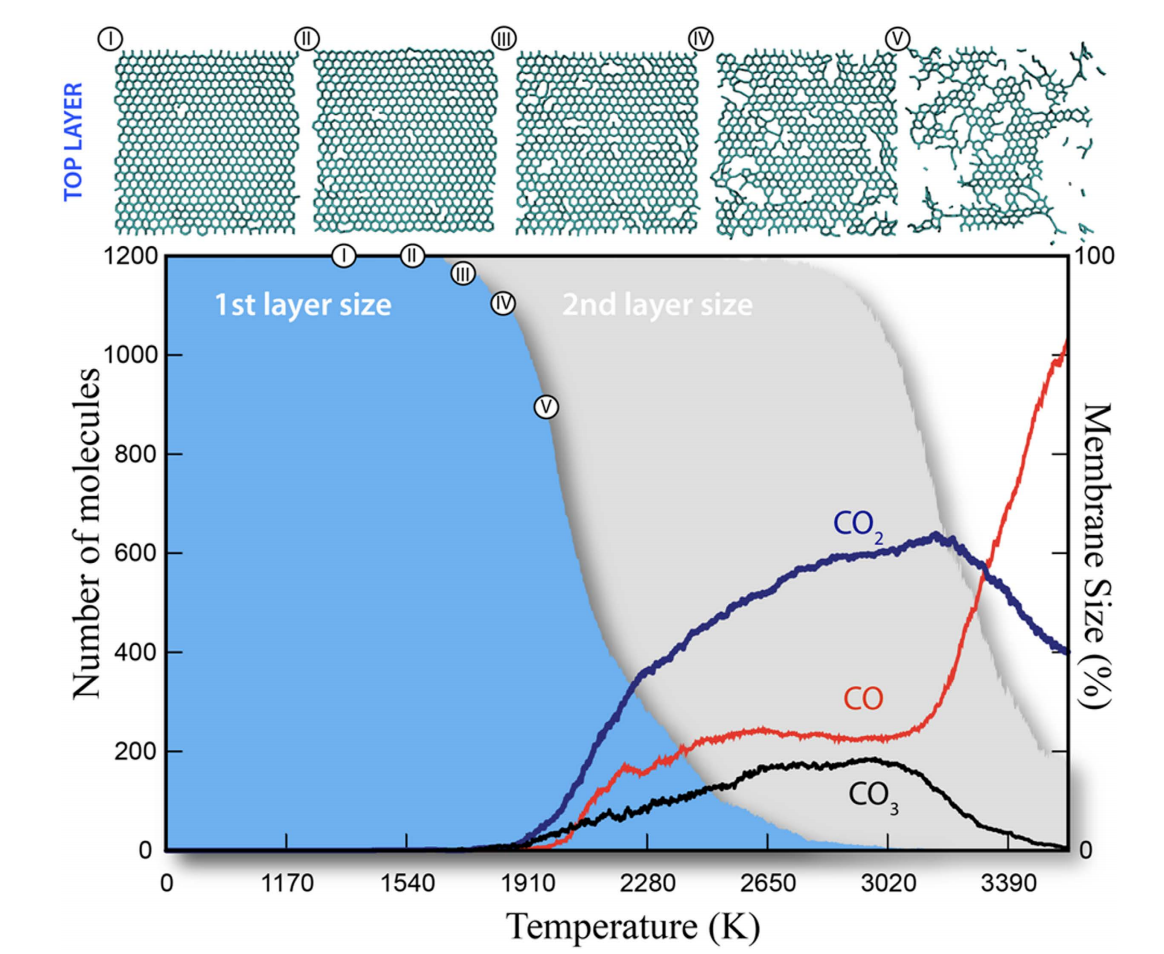
Andrei V Alaferdov Victor A Ermakov, Alfredo R Vaz
Burning Graphene Layer-by-Layer Journal Article
Em: Nature Scientific Reports, vol. 5, pp. 11546, 2015.
Resumo | Links | BibTeX | Tags: Burning, Graphene, Molecular Dynamics, TEM
@article{Ermakov2015,
title = {Burning Graphene Layer-by-Layer},
author = {Victor A Ermakov, Andrei V Alaferdov, Alfredo R Vaz, Eric Perim, Pedro AS Autreto, Ricardo Paupitz, Douglas S Galvao, Stanislav A Moshkalev},
url = {http://www.nature.com/articles/srep11546?WT.ec_id=SREP-639-20150630},
doi = {10.1038/srep11546},
year = {2015},
date = {2015-06-23},
journal = {Nature Scientific Reports},
volume = {5},
pages = {11546},
abstract = {Graphene, in single layer or multi-layer forms, holds great promise for future electronics and high-temperature applications. Resistance to oxidation, an important property for high-temperature applications, has not yet been extensively investigated. Controlled thinning of multi-layer graphene (MLG), e.g., by plasma or laser processing is another challenge, since the existing methods produce non-uniform thinning or introduce undesirable defects in the basal plane. We report here that heating to extremely high temperatures (exceeding 2000 K) and controllable layer-by-layer burning (thinning) can be achieved by low-power laser processing of suspended high-quality MLG in air in “cold-wall” reactor configuration. In contrast, localized laser heating of supported samples results in non-uniform graphene burning at much higher rates. Fully atomistic molecular dynamics simulations were also performed to reveal details of oxidation mechanisms leading to uniform layer-by-layer graphene gasification. The extraordinary resistance of MLG to oxidation paves the way to novel high-temperature applications as continuum light source or scaffolding material.},
keywords = {Burning, Graphene, Molecular Dynamics, TEM},
pubstate = {published},
tppubtype = {article}
}
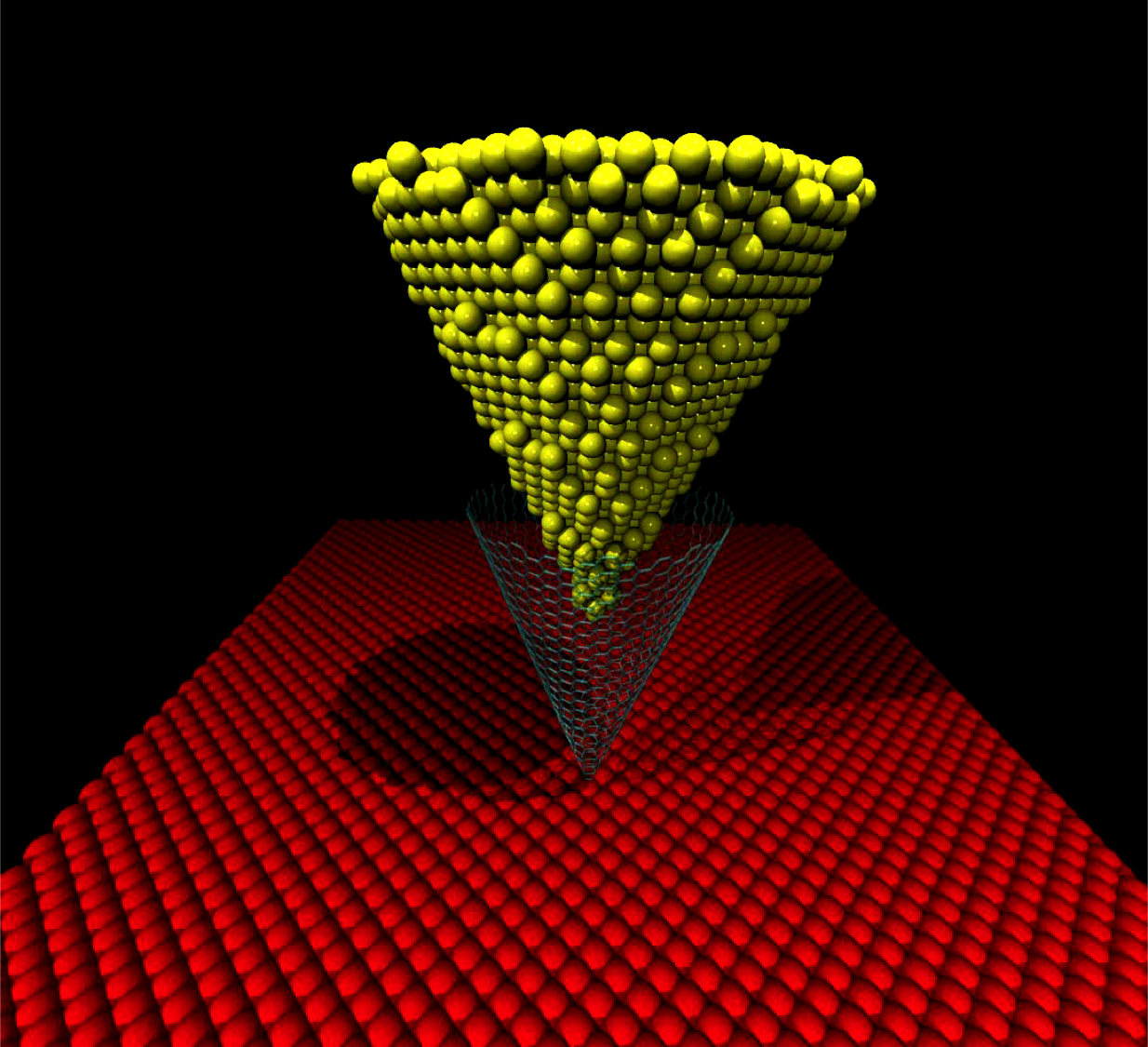
Wesller G Schmidt Abraham G Cano-Marquez, Jenaina Ribeiro-Soares
Enhanced Mechanical Stability of Gold Nanotips through Carbon Nanocone Encapsulation Journal Article
Em: Nature Scientific Reports, vol. 5, pp. 10408, 2015.
Resumo | Links | BibTeX | Tags: Gold Nanotips, Molecular Dynamics, Nanocones
@article{Cano-Marquez2015,
title = {Enhanced Mechanical Stability of Gold Nanotips through Carbon Nanocone Encapsulation},
author = {Abraham G Cano-Marquez, Wesller G Schmidt, Jenaina Ribeiro-Soares, Luiz Gustavo Cançado, Wagner N Rodrigues, Adelina P Santos, Clascidia A Furtado, Pedro AS Autreto, Ricardo Paupitz, Douglas S Galvão, Ado Jorio},
url = {http://www.nature.com/articles/srep10408},
doi = {10.1038/srep10408},
year = {2015},
date = {2015-06-17},
journal = {Nature Scientific Reports},
volume = {5},
pages = {10408},
abstract = {Gold is a noble metal that, in comparison with silver and copper, has the advantage of corrosion resistance. Despite its high conductivity, chemical stability and biocompatibility, gold exhibits high plasticity, which limits its applications in some nanodevices. Here, we report an experimental and theoretical study on how to attain enhanced mechanical stability of gold nanotips. The gold tips were fabricated by chemical etching and further encapsulated with carbon nanocones via nanomanipulation. Atomic force microscopy experiments were carried out to test their mechanical stability. Molecular dynamics simulations show that the encapsulated nanocone changes the strain release mechanisms at the nanoscale by blocking gold atomic sliding, redistributing the strain along the whole nanostructure. The carbon nanocones are conducting and can induce magnetism, thus opening new avenues on the exploitation of transport, mechanical and magnetic properties of gold covered by sp2 carbon at the nanoscale.},
keywords = {Gold Nanotips, Molecular Dynamics, Nanocones},
pubstate = {published},
tppubtype = {article}
}
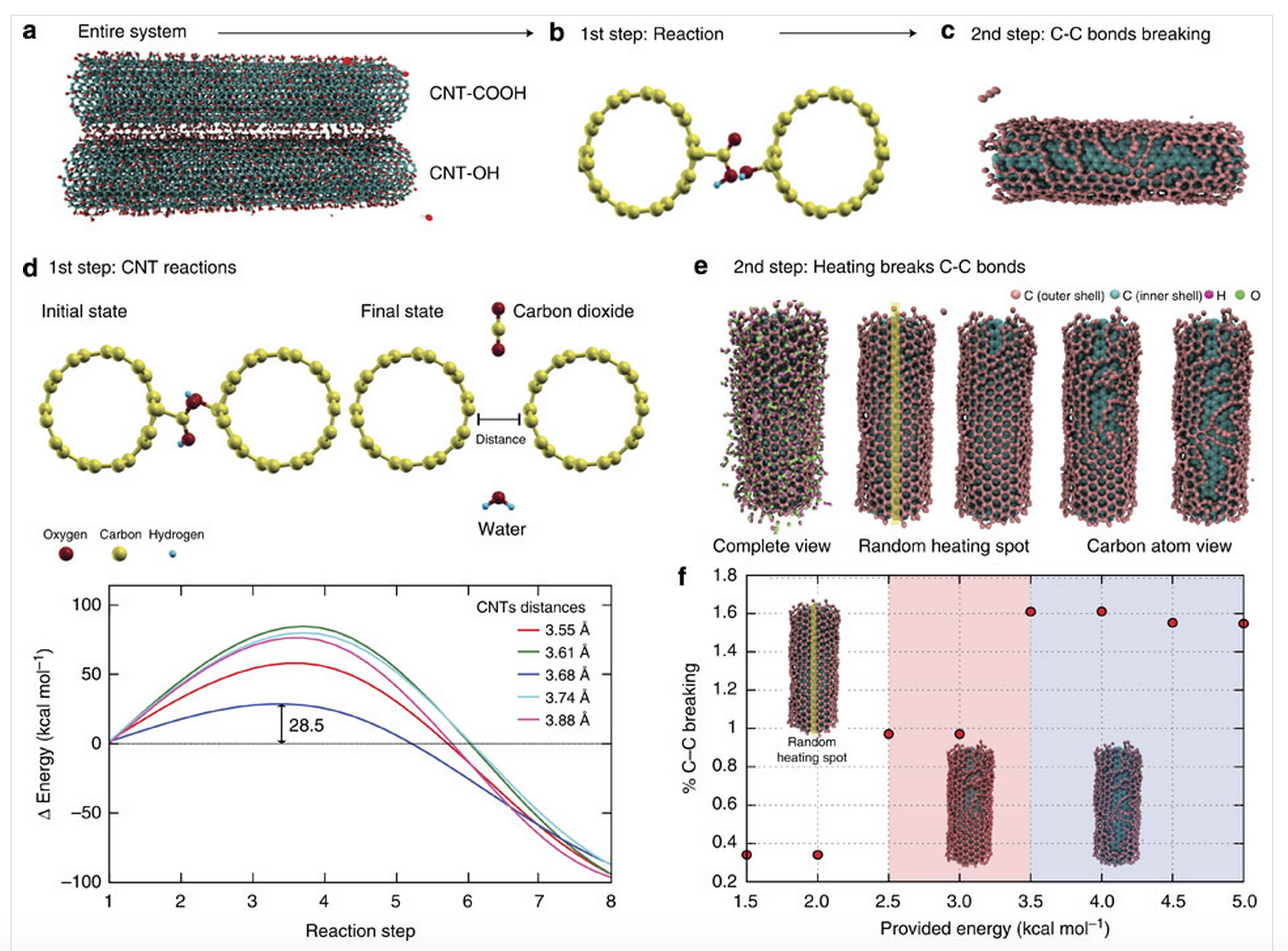
Chandra Sekhar Tiwary Mohamad A Kabbani, Pedro AS Autreto
Ambient solid-state mechano-chemical reactions between functionalized carbon nanotubes Journal Article
Em: Nature Communications, vol. 6, pp. 7291, 2015.
Resumo | Links | BibTeX | Tags: Carbon Nanotubes, Chemical Reactions, Electronic Structure, Molecular Dynamics, top20
@article{Kabbani2015,
title = {Ambient solid-state mechano-chemical reactions between functionalized carbon nanotubes},
author = {Mohamad A Kabbani, Chandra Sekhar Tiwary, Pedro AS Autreto, Gustavo Brunetto, Anirban Som, KR Krishnadas, Sehmus Ozden, Ken P Hackenberg, Yongi Gong, Douglas S Galvao, Robert Vajtai, Ahmad T Kabbani, Thalappil Pradeep, Pulickel M Ajayan},
url = {http://www.nature.com/ncomms/2015/150615/ncomms8291/full/ncomms8291.html},
doi = {10.1038/ncomms8291},
year = {2015},
date = {2015-06-15},
journal = {Nature Communications},
volume = {6},
pages = {7291},
abstract = {Carbon nanotubes can be chemically modified by attaching various functionalities to their surfaces, although harsh chemical treatments can lead to their break-up into graphene nanostructures. On the other hand, direct coupling between functionalities bound on individual nanotubes could lead to, as yet unexplored, spontaneous chemical reactions. Here we report an ambient mechano-chemical reaction between two varieties of nanotubes, carrying predominantly carboxyl and hydroxyl functionalities, respectively, facilitated by simple mechanical grinding of the reactants. The purely solid-state reaction between the chemically differentiated nanotube species produces condensation products and unzipping of nanotubes due to local energy release, as confirmed by spectroscopic measurements, thermal analysis and molecular dynamic simulations.},
keywords = {Carbon Nanotubes, Chemical Reactions, Electronic Structure, Molecular Dynamics, top20},
pubstate = {published},
tppubtype = {article}
}
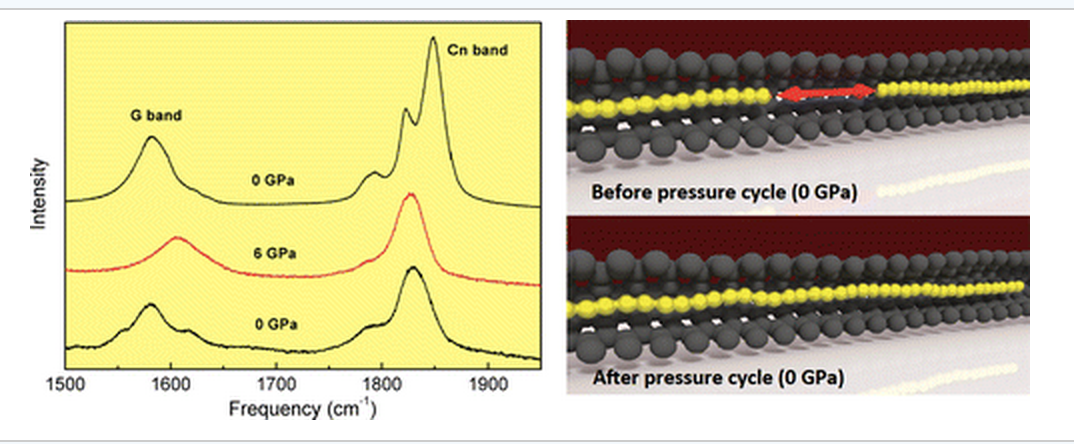
Acrísio L Aguiar Nadia Ferreira Andrade, Yoong Ahm Kim
Linear Carbon Chains Under High Pressure Conditions Journal Article
Em: The Journal of Physical Chemistry C, vol. 119, não 19, pp. 10669–10676, 2015.
Resumo | Links | BibTeX | Tags: Atomic Chains, Carbon Nanotubes, Electronic Structure, Molecular Dynamics, Raman
@article{Andrade2015,
title = {Linear Carbon Chains Under High Pressure Conditions},
author = {Nadia Ferreira Andrade, Acrísio L Aguiar, Yoong Ahm Kim, Morinobu Endo, Paulo TC Freire, Gustavo Bruneto, Douglas Soares Galvao, Mildred S Dresselhaus, Antonio Gomes Souza Filho},
url = {http://pubs.acs.org/doi/abs/10.1021/acs.jpcc.5b00902},
doi = {10.1021/acs.jpcc.5b00902},
year = {2015},
date = {2015-04-23},
journal = {The Journal of Physical Chemistry C},
volume = {119},
number = {19},
pages = {10669–10676},
abstract = {A high-pressure resonance Raman spectroscopy study of linear carbon chains encapsulated inside multiwalled carbon nanotubes (MWCNTs) is reported. While the frequencies of the tangential modes of carbon nanotubes (G band) harden as the pressure increases, the vibrational frequencies of the chain modes (around 1850 cm–1) decrease, thus indicating a softening of the carbon–carbon bonds in this 1D solid. Pressure-induced irreversible structural changes in the linear carbon chains are unveiled by the red shift in the vibrational modes when pressure is released. These results have been interpreted as being due to a coalescence of carbon chains, and this hypothesis is supported by state-of-the-art atomistic reactive molecular dynamics simulations.},
keywords = {Atomic Chains, Carbon Nanotubes, Electronic Structure, Molecular Dynamics, Raman},
pubstate = {published},
tppubtype = {article}
}
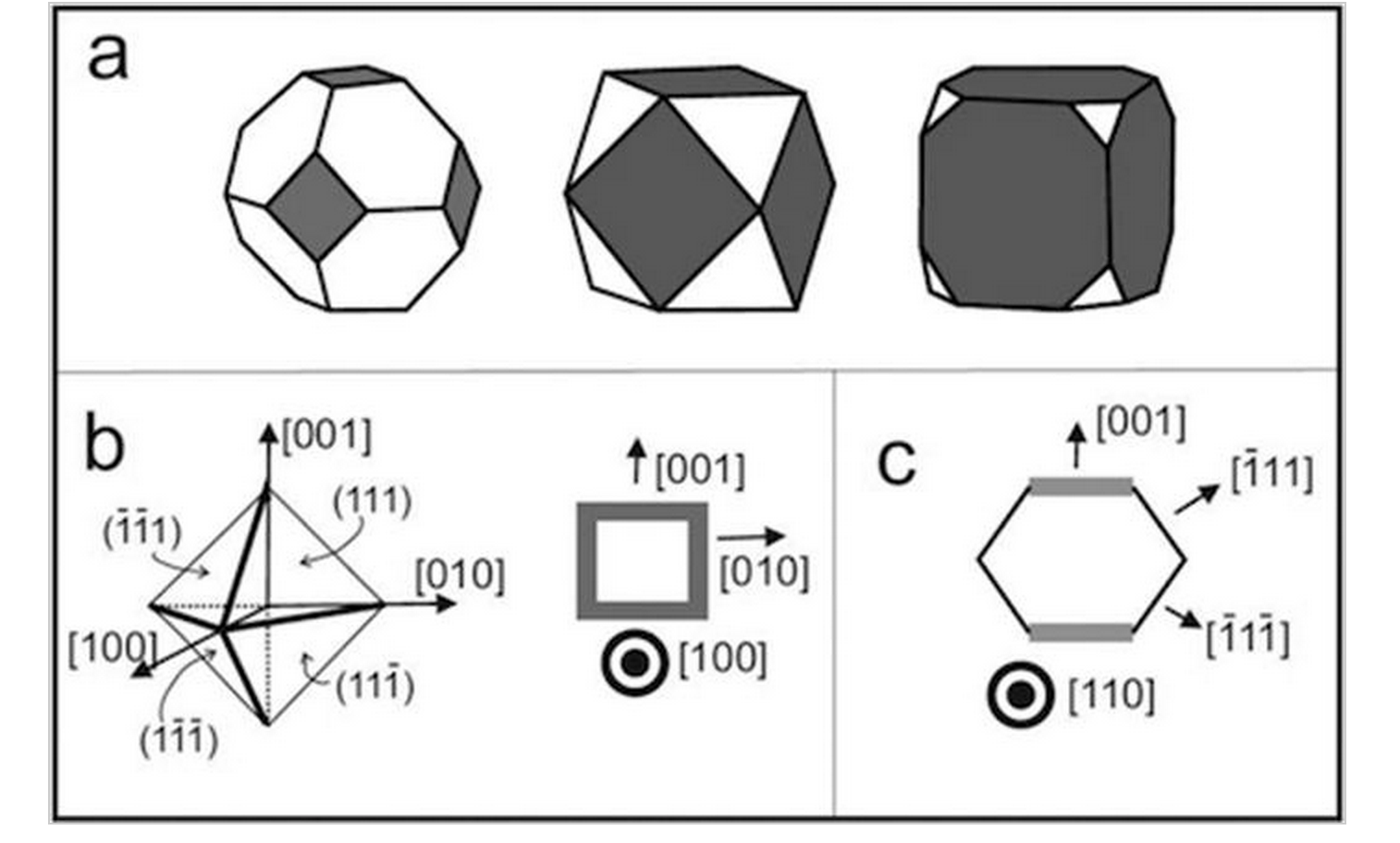
PAS Autreto MJ Lagos, J Bettini
Surface effects on the mechanical elongation of AuCu nanowires: De-alloying and the formation of mixed suspended atomic chains Journal Article
Em: Journal of Applied Physics, vol. 117, não 9, pp. 094301, 2015.
Resumo | Links | BibTeX | Tags: Metallic Nanowires, Molecular Dynamics, TEM, Theory of Electronic Indices
@article{Lagos2015,
title = {Surface effects on the mechanical elongation of AuCu nanowires: De-alloying and the formation of mixed suspended atomic chains},
author = {MJ Lagos, PAS Autreto, J Bettini, F Sato, SO Dantas, DS Galvao, D Ugarte},
url = {http://scitation.aip.org/content/aip/journal/jap/117/9/10.1063/1.4913625},
doi = {10.1063/1.4913625},
year = {2015},
date = {2015-03-07},
journal = {Journal of Applied Physics},
volume = {117},
number = {9},
pages = {094301},
abstract = {We report here an atomistic study of the mechanical deformation of Au x Cu (1− x ) atomic-size wires (nanowires (NWs)) by means of high resolution transmission electron microscopy experiments. Molecular dynamics simulations were also carried out in order to obtain deeper insights on the dynamical properties of stretched NWs. The mechanical properties are significantly dependent on the chemical composition that evolves in time at the junction; some structures exhibit a remarkable de-alloying behavior. Also, our results represent the first experimental realization of mixed linear atomic chains (LACs) among transition and noble metals; in particular, surface energies induce chemical gradients on NW surfaces that can be exploited to control the relative LAC compositions (different number of gold and copper atoms). The implications of these results for nanocatalysis and spin transport of one-atom-thick metal wires are addressed.},
keywords = {Metallic Nanowires, Molecular Dynamics, TEM, Theory of Electronic Indices},
pubstate = {published},
tppubtype = {article}
}
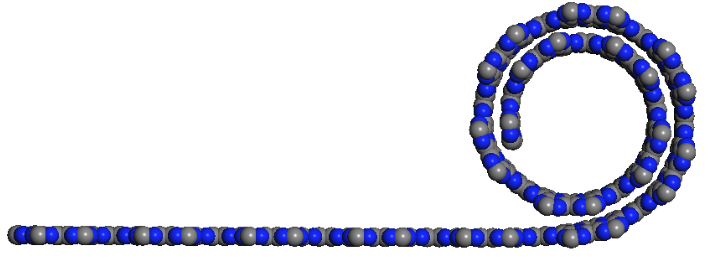
Eric Perim, Douglas S. Galvao
Novel Nanoscroll Structures from Carbon Nitride Layers Online
2015, (ArXiv Draft MRS Proceedings, 1726, mrsf14-1726-j05-02 (2015)).
Resumo | Links | BibTeX | Tags: carbon nitride, Molecular Dynamics, Scrolls
@online{Perim2015,
title = {Novel Nanoscroll Structures from Carbon Nitride Layers},
author = {Eric Perim, Douglas S. Galvao},
url = {http://arxiv.org/abs/1502.00260},
year = {2015},
date = {2015-02-02},
abstract = {Nanoscrolls consist of sheets rolled up into a papyrus-like form. Their open ends produce great radial flexibility, which can be exploited for a large variety of applications, from actuators to hydrogen storage. They have been successfully synthesized from different materials, including carbon and boron nitride. In this work we have investigated, through fully atomistic molecular dynamics simulations, the dynamics of scroll formation for a series of graphene-like carbon nitride (CN) two-dimensional systems: g-CN, triazine-based (g-C3N4), and heptazine-based (g-C3N4). Carbon nitride (CN) structures have been attracting great attention since their prediction as super hard materials. Recently, graphene-like carbon nitride (g-CN) structures have been synthesized with distinct stoichiometry and morphologies. By combining these unique CN characteristics with the structural properties inherent to nanoscrolls new nanostructures with very attractive mechanical and electronic properties could be formed. Our results show that stable nanoscrolls can be formed for all of CN structures we have investigated here. As the CN sheets have been already synthesized, these new scrolled structures are perfectly feasible and within our present-day technology.},
note = {ArXiv Draft MRS Proceedings, 1726, mrsf14-1726-j05-02 (2015)},
keywords = {carbon nitride, Molecular Dynamics, Scrolls},
pubstate = {published},
tppubtype = {online}
}
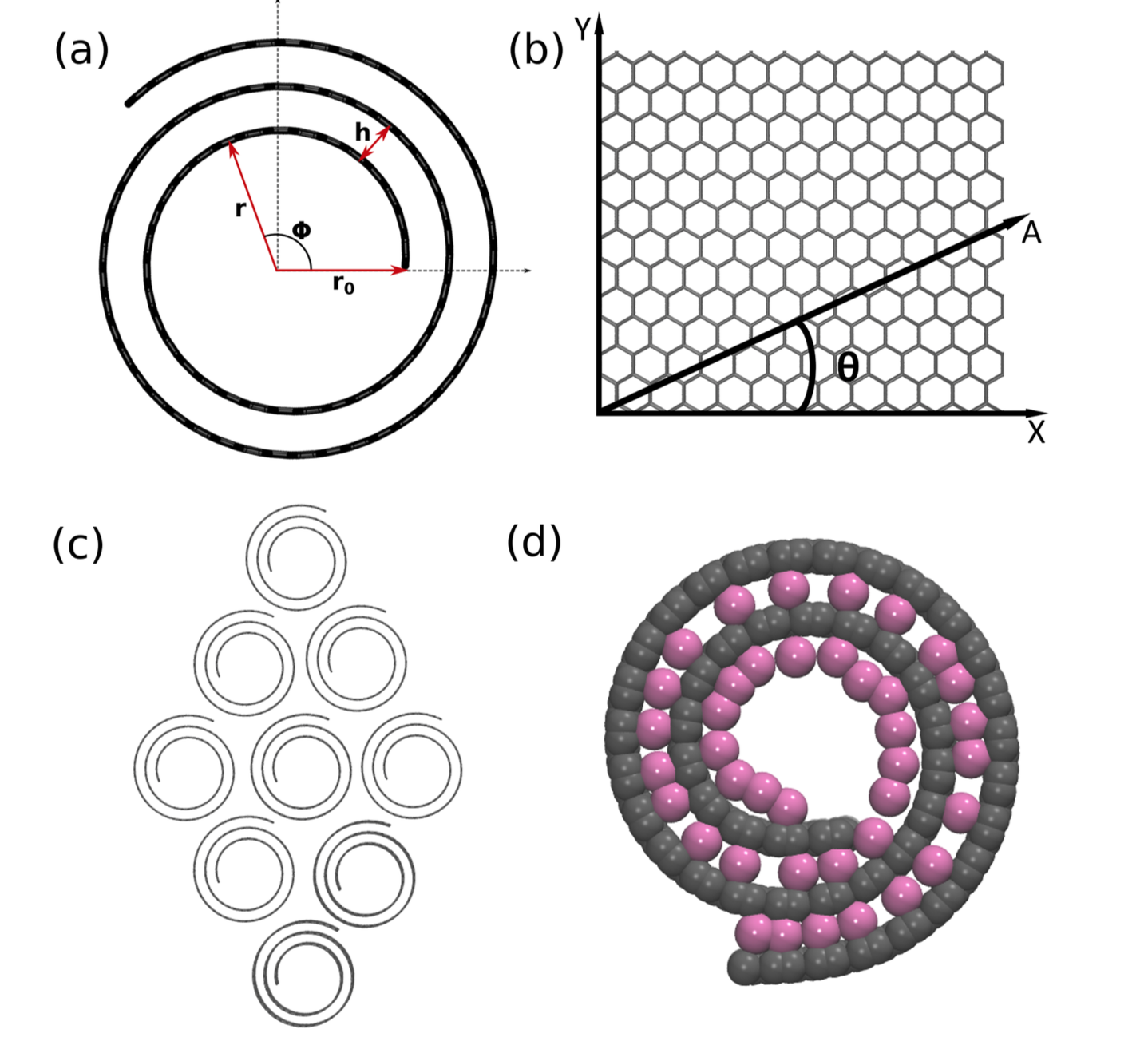
L. D. Machado E. Perim, D. S. Galvao
A Brief Review on Syntheses, Structures and Applications of Nanoscrolls Online
2015, (ArXiv draft of Frontiers in Materials, 1 pp. 31, 2014).
Resumo | Links | BibTeX | Tags: Molecular Dynamics, Scrolls
@online{Perim2015b,
title = {A Brief Review on Syntheses, Structures and Applications of Nanoscrolls},
author = {E. Perim, L. D. Machado, D. S. Galvao},
url = {http://arxiv.org/abs/1501.05711 },
year = {2015},
date = {2015-01-21},
journal = {arXiv preprint 1501.05711v1},
abstract = {Nanoscrolls are papyrus-like nanostructures which present unique properties due to their open ended morphology. These properties can be exploited in a plethora of technological applications, leading to the design of novel and interesting devices. During the past decade, significant advances in the synthesis and characterization of these structures have been made, but many challenges still remain. In this mini review we provide an overview on their history, experimental synthesis methods, basic properties and application perspectives.},
note = {ArXiv draft of Frontiers in Materials, 1 pp. 31, 2014},
keywords = {Molecular Dynamics, Scrolls},
pubstate = {published},
tppubtype = {online}
}
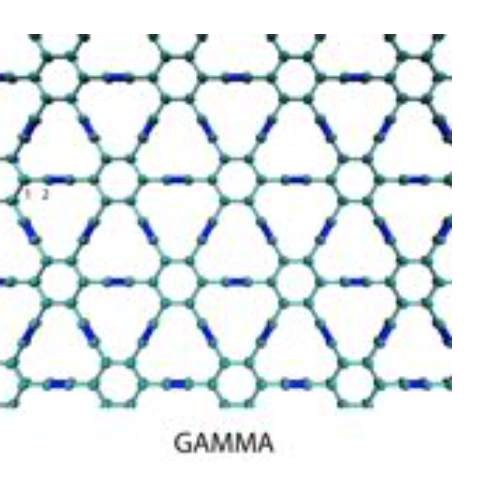
Pedro A. S. Autreto, Douglas S. Galvao
Site dependent hydrogenation in Graphynes: A Fully Atomistic Molecular Dynamics Investigation Online
2015, (ArXiv draft of MRS Proceedings, 1726, mrsf14-1726-j02-02 (2015)).
Resumo | Links | BibTeX | Tags: Graphynes, Hydrogenation, Molecular Dynamics
@online{Autreto2015,
title = {Site dependent hydrogenation in Graphynes: A Fully Atomistic Molecular Dynamics Investigation},
author = {Pedro A. S. Autreto, Douglas S. Galvao},
url = {http://arxiv.org/abs/1501.04521},
year = {2015},
date = {2015-01-19},
journal = {arXiv preprint 1501.04521},
abstract = {Graphyne is a generic name for a carbon allotrope family of 2D structures, where acetylenic groups connect benzenoid rings, with the coexistence of sp and sp2 hybridized carbon atoms. In this work we have investigated, through fully atomistic reactive molecular dynamics simulations, the dynamics and structural changes of the hydrogenation of ALPHA, BETA, GAMMA graphyne forms. Our results showed that the existence of different sites for hydrogen bonding, related to single and triple bonds, makes the process of incorporating hydrogen atoms into graphyne membranes much more complex than the graphene ones. Our results also show that hydrogenation reactions are strongly site dependent and that the sp-hybridized carbon atoms are the preferential sites to chemical attacks. In our cases, the effectiveness of the hydrogenation (estimated from the number of hydrogen atoms covalently bonded to carbon atoms) follows the ALPHA, BETA, GAMMA graphyne structure ordering.},
note = {ArXiv draft of MRS Proceedings, 1726, mrsf14-1726-j02-02 (2015)},
keywords = {Graphynes, Hydrogenation, Molecular Dynamics},
pubstate = {published},
tppubtype = {online}
}

Leonardo D. Machado Cristiano F. Woellner, Pedro A. S. Autreto
The Influence of Morphology on the Charge Transport in Two-Phase Disordered Organic Systems Online
2015, (ArXiv draft of MRS Proceedings, 1737, mrsf14-1737-u18-21 (2015)).
Resumo | Links | BibTeX | Tags: Conducting Polymers, Monte Carlo, Transport
@online{Woellner2015,
title = {The Influence of Morphology on the Charge Transport in Two-Phase Disordered Organic Systems},
author = {Cristiano F. Woellner, Leonardo D. Machado, Pedro A. S. Autreto, Jose A. Freire, Douglas S. Galvao},
url = {http://arxiv.org/abs/1501.01343},
year = {2015},
date = {2015-01-01},
booktitle = {MRS Proceedings},
volume = {1737},
pages = {mrsf14-1737-u18-21},
abstract = {In this work we use a three-dimensional Pauli master equation to investigate the charge carrier mobility of a two-phase system, which can mimic donor-acceptor and amorphous- crystalline bulk heterojunctions. Our approach can be separated into two parts: the morphology generation and the charge transport modeling in the generated blend. The morphology part is based on a Monte Carlo simulation of binary mixtures (donor/acceptor). The second part is carried out by numerically solving the steady-state Pauli master equation. By taking the energetic disorder of each phase, their energy offset and domain morphology into consideration, we show that the carrier mobility can have a significant different behavior when compared to a one-phase system. When the energy offset is non-zero, we show that the mobility electric field dependence switches from negative to positive at a threshold field proportional to the energy offset. Additionally, the influence of morphology, through the domain size and the interfacial roughness parameters, on the transport was also investigated.},
note = {ArXiv draft of MRS Proceedings, 1737, mrsf14-1737-u18-21 (2015)},
keywords = {Conducting Polymers, Monte Carlo, Transport},
pubstate = {published},
tppubtype = {online}
}
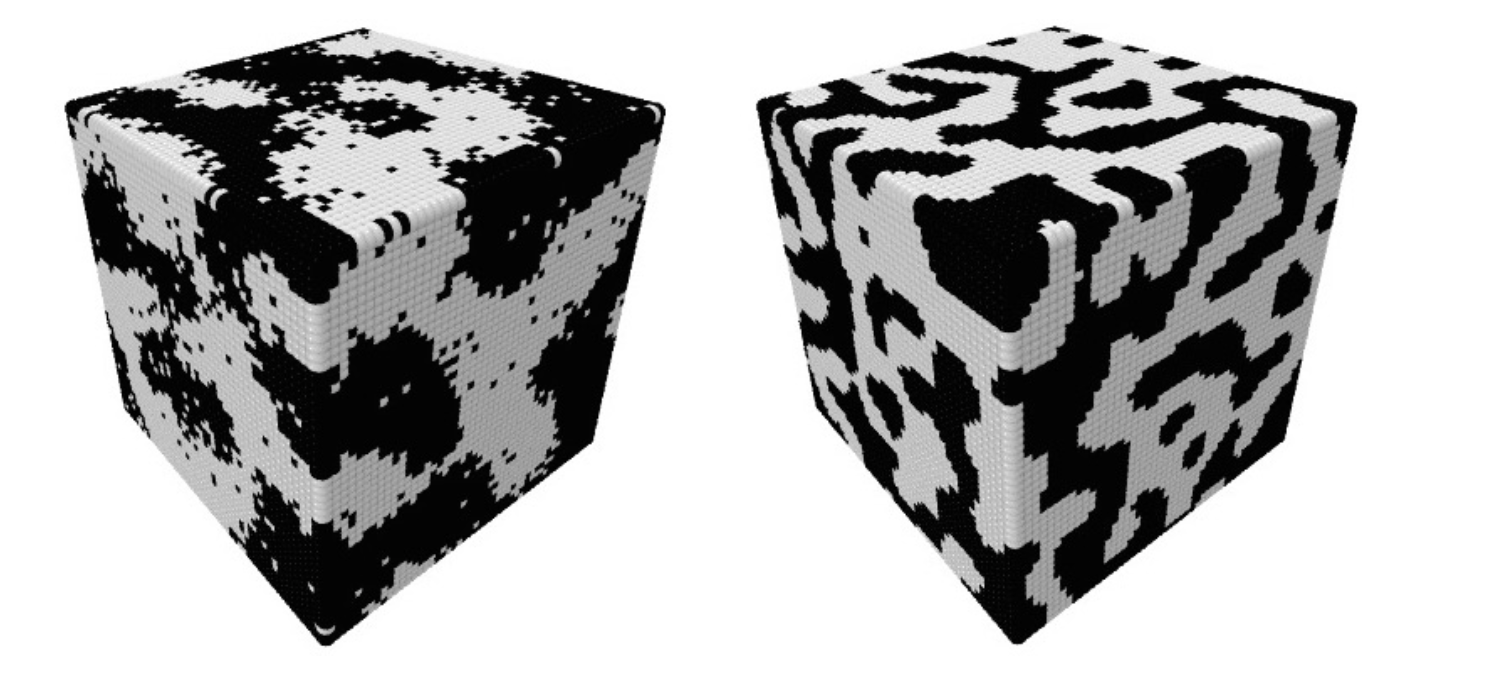
Leonardo D Machado Cristiano F Woellner, Pedro AS Autreto
The Influence of Morphology on the Charge Transport in Two-Phase Disordered Organic Systems Proceedings
vol. 1737, não mrsf14-1737-u18-21, 2015, (MRS Proceedings, 1737, mrsf14-1737-u18-21).
Resumo | Links | BibTeX | Tags: Conducting Polymers, Monte Carlo, Solar Cells
@proceedings{Woellner2015b,
title = {The Influence of Morphology on the Charge Transport in Two-Phase Disordered Organic Systems},
author = {Cristiano F Woellner, Leonardo D Machado, Pedro AS Autreto, José A Freire, Douglas S Galvão},
url = {http://journals.cambridge.org/action/displayAbstract?fromPage=online&aid=9707375&fileId=S1946427415005023},
doi = {10.1557/opl.2015.502},
year = {2015},
date = {2015-01-01},
booktitle = {MRS Proceedings},
volume = {1737},
number = {mrsf14-1737-u18-21},
pages = {mrsf14-1737-u18-21},
abstract = {In this work we use a three-dimensional Pauli master equation to investigate the charge carrier mobility of a two-phase system, which can mimic donor-acceptor and amorphous-crystalline bulk heterojunctions. Our approach can be separated into two parts: the morphology generation and the charge transport modeling in the generated blend. The morphology part is based on a Monte Carlo simulation of binary mixtures (donor/acceptor). The second part is carried out by numerically solving the steady-state Pauli master equation. By taking the energetic disorder of each phase, their energy offset and domain morphology into consideration, we show that the carrier mobility can have a significant different behavior when compared to a one-phase system. When the energy offset is non-zero, we show that the mobility electric field dependence switches from negative to positive at a threshold field proportional to the energy offset. Additionally, the influence of morphology, through the domain size and the interfacial roughness parameters, on the transport was also investigated.
},
note = {MRS Proceedings, 1737, mrsf14-1737-u18-21},
keywords = {Conducting Polymers, Monte Carlo, Solar Cells},
pubstate = {published},
tppubtype = {proceedings}
}
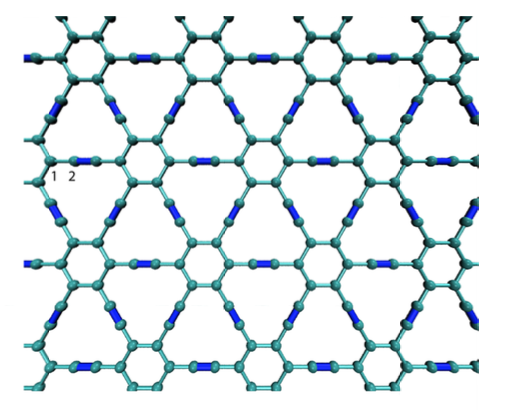
Pedro A. S. Autreto, Douglas S. Galvao
Site Dependent Hydrogenation in Graphynes: A Fully Atomistic Molecular Dynamics Investigation Proceedings
vol. 1726, não mrsf14-1726-j02-02, 2015, (MRS Proceedings, 1726, mrsf14-1726-j02-02 ).
Resumo | Links | BibTeX | Tags: Graphynes, Hydrogenation, Molecular Dynamics
@proceedings{Autreto2015b,
title = {Site Dependent Hydrogenation in Graphynes: A Fully Atomistic Molecular Dynamics Investigation},
author = {Pedro A. S. Autreto, Douglas S. Galvao},
url = {http://journals.cambridge.org/action/displayAbstract?fromPage=online&aid=9702693&fulltextType=RA&fileId=S1946427415004649},
doi = {10.1557/opl.2015.464},
year = {2015},
date = {2015-01-01},
journal = {Mater. Res. Soc. Symp. Proc. },
volume = {1726},
number = {mrsf14-1726-j02-02},
abstract = {Graphyne is a generic name for a carbon allotrope family of 2D structures, where acetylenic groups connect benzenoid rings, with the coexistence of sp and sp2 hybridized carbon atoms. In this work we have investigated, through fully atomistic reactive molecular dynamics simulations, the dynamics and structural changes of the hydrogenation of α, β, and γ graphyne forms. Our results showed that the existence of different sites for hydrogen bonding, related to single and triple bonds, makes the process of incorporating hydrogen atoms into graphyne membranes much more complex than the graphene ones. Our results also show that hydrogenation reactions are strongly site dependent and that the sp-hybridized carbon atoms are the preferential sites to chemical attacks. In our cases, the effectiveness of the hydrogenation (estimated from the number of hydrogen atoms covalently bonded to carbon atoms) follows the α, β, γ-graphyne structure ordering.},
note = {MRS Proceedings, 1726, mrsf14-1726-j02-02 },
keywords = {Graphynes, Hydrogenation, Molecular Dynamics},
pubstate = {published},
tppubtype = {proceedings}
}
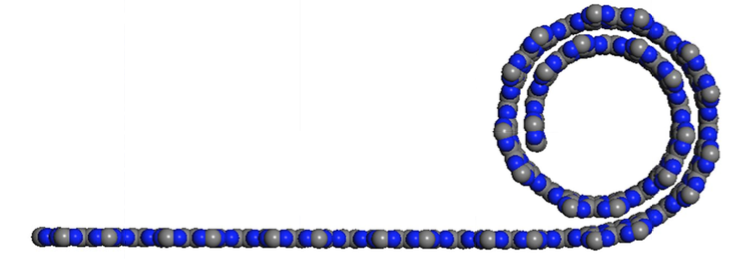
Eric Perim, Douglas S. Galvao
Novel Nanoscroll Structures from Carbon Nitride Layers Proceedings
vol. 1726, não mrsf14-1726-j05-02, 2015, (MRS Proceedings, 1726, mrsf14-1726-j05-02 ).
Resumo | Links | BibTeX | Tags: carbon nitride, Molecular Dynamics, nanoscrolls
@proceedings{Perim2015b,
title = {Novel Nanoscroll Structures from Carbon Nitride Layers},
author = {Eric Perim, Douglas S. Galvao},
url = {http://journals.cambridge.org/action/displayAbstract?fromPage=online&aid=9700860&fileId=S1946427415004650},
doi = {DOI: 10.1557/opl.2015.465},
year = {2015},
date = {2015-01-01},
volume = {1726},
number = {mrsf14-1726-j05-02},
abstract = {Nanoscrolls consist of sheets rolled up into a papyrus-like form. Their open ends produce great radial flexibility, which can be exploited for a large variety of applications, from actuators to hydrogen storage. They have been successfully synthesized from different materials, including carbon and boron nitride. In this work we have investigated, through fully atomistic molecular dynamics simulations, the dynamics of scroll formation for a series of graphene-like carbon nitride (CN) two-dimensional systems: g-CN, triazine-based (g-C3N4), and heptazine-based (g-C3N4). Carbon nitride (CN) structures have been attracting great attention since their prediction as super hard materials. Recently, graphene-like carbon nitride (g-CN) structures have been synthesized with distinct stoichiometry and morphologies. By combining these unique CN characteristics with the structural properties inherent to nanoscrolls new nanostructures with very attractive mechanical and electronic properties could be formed. Our results show that stable nanoscrolls can be formed for all of CN structures we have investigated here. As the CN sheets have been already synthesized, these new scrolled structures are perfectly feasible and within our present-day technology.},
note = {MRS Proceedings, 1726, mrsf14-1726-j05-02 },
keywords = {carbon nitride, Molecular Dynamics, nanoscrolls},
pubstate = {published},
tppubtype = {proceedings}
}

Nadia F. Andradea Gustavo Brunettoa, Douglas S. Galvao
High Pressure Induced Binding Between Linear Carbon Chains and Nanotubes Proceedings
vol. 1752, não 53-58, 2015, (MRS Proceedings, 1752, pp 53-58).
Resumo | Links | BibTeX | Tags: CNT encapsulation, Electronic Structure, Linear Chains, Molecular Dynamics
@proceedings{Brunettoa2015,
title = {High Pressure Induced Binding Between Linear Carbon Chains and Nanotubes},
author = {Gustavo Brunettoa, Nadia F. Andradea, Douglas S. Galvao, Antonio G. Souza Filho},
url = {http://journals.cambridge.org/action/displayAbstract?fromPage=online&aid=9553206&fileId=S1946427415000913},
doi = {10.1557/opl.2015.91},
year = {2015},
date = {2015-01-01},
volume = {1752},
number = {53-58},
abstract = {Recent studies of single-walled carbon nanotubes (CNTs) in aqueous media have showed that water can significantly affect the tube mechanical properties. CNTs under hydrostatic compression can preserve their elastic properties up to large pressure values, while exhibiting exceptional resistance to mechanical loadings. It was experimentally observed that CNTs with encapsulated linear carbon chains (LCCs), when subjected to high hydrostatic pressure values, present irreversible red shifts in some of their vibrational frequencies. In order to address the cause of this phenomenon, we have carried out fully atomistic reactive (ReaxFF) molecular dynamics (MD) simulations for model structures mimicking the experimental conditions. We have considered the cases of finite and infinite (cyclic boundary conditions) CNTs filled with LCCs (LCC@CNTs) of different lengths (from 9 up to 40 atoms). Our results show that increasing the hydrostatic pressure causes the CNT to be deformed in an inhomogeneous way due to the LCC presence. The LCC/CNT interface regions exhibit convex curvatures, which results in more reactive sites, thus favoring the formation of covalent chemical bonds between the chain and the nanotube. This process is irreversible with the newly formed bonds continuing to exist even after releasing the external pressure and causing an irreversibly red shift in the chain vibrational modes from 1850 to 1500 cm−1.},
note = {MRS Proceedings, 1752, pp 53-58},
keywords = {CNT encapsulation, Electronic Structure, Linear Chains, Molecular Dynamics},
pubstate = {published},
tppubtype = {proceedings}
}
2014
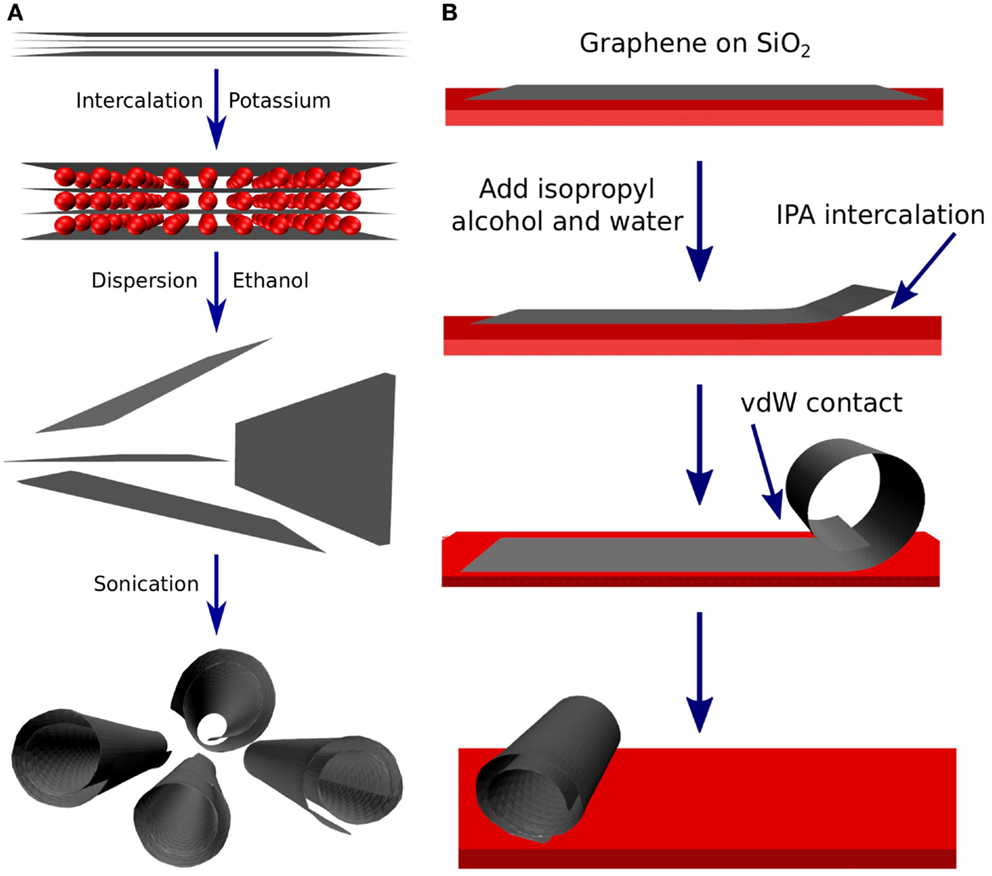
Perim, Eric; Machado, Leonardo Dantas; Galvao, Douglas Soares
A Brief Review on Syntheses, Structures, and Applications of Nanoscrolls Journal Article
Em: Frontiers in Materials, vol. 1, pp. 31, 2014, (Invited Review Paper).
Resumo | Links | BibTeX | Tags: Molecular Dynamics, Scrolls
@article{perim2014brief,
title = {A Brief Review on Syntheses, Structures, and Applications of Nanoscrolls},
author = {Perim, Eric and Machado, Leonardo Dantas and Galvao, Douglas Soares},
url = {http://journal.frontiersin.org/Journal/10.3389/fmats.2014.00031/abstract},
year = {2014},
date = {2014-12-01},
journal = {Frontiers in Materials},
volume = {1},
pages = {31},
publisher = {Frontiers},
abstract = {Nanoscrolls are papyrus-like nanostructures, which present unique properties due to their open ended morphology. These properties can be exploited in a plethora of technological applications, leading to the design of novel and interesting devices. During the past decade, significant advances in the synthesis and characterization of these structures have been made, but many challenges still remain. In this mini review, we provide an overview on their history, experimental synthesis methods, basic properties, and application perspectives.},
note = {Invited Review Paper},
keywords = {Molecular Dynamics, Scrolls},
pubstate = {published},
tppubtype = {article}
}

Perim, E; Paupitz, R; Botari, T; Galvao, DS
One-dimensional silicon and germanium nanostructures with no carbon analogues Journal Article
Em: Physical Chemistry Chemical Physics, vol. 16, não 44, pp. 24570–24574, 2014.
Resumo | Links | BibTeX | Tags: DFT, Germanium, Nanotubes, Silicon
@article{perim2014one,
title = {One-dimensional silicon and germanium nanostructures with no carbon analogues},
author = {Perim, E and Paupitz, R and Botari, T and Galvao, DS},
url = {http://pubs.rsc.org/en/content/articlehtml/2014/cp/c4cp03708a},
year = {2014},
date = {2014-01-01},
journal = {Physical Chemistry Chemical Physics},
volume = {16},
number = {44},
pages = {24570--24574},
publisher = {Royal Society of Chemistry},
abstract = {In this work we report new silicon and germanium tubular nanostructures with no corresponding stable carbon analogues. The electronic and mechanical properties of these new tubes were investigated through ab initio methods. Our results show that these structures have lower energy than their corresponding nanoribbon structures and are stable up to high temperatures (500 and 1000 K, for silicon and germanium tubes, respectively). Both tubes are semiconducting with small indirect band gaps, which can be significantly altered by both compressive and tensile strains. Large bandgap variations of almost 50% were observed for strain rates as small as 3%, suggesting their possible applications in sensor devices. They also present high Young's modulus values (0.25 and 0.15 TPa, respectively). TEM images were simulated to help in the identification of these new structures.},
keywords = {DFT, Germanium, Nanotubes, Silicon},
pubstate = {published},
tppubtype = {article}
}
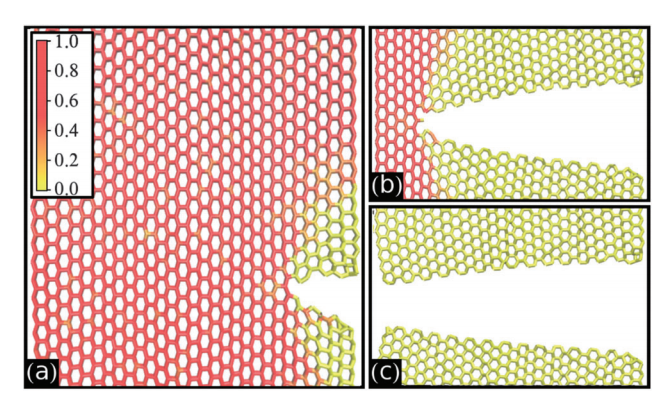
Botari, T; Perim, E; Autreto, PAS; van Duin, ACT; Paupitz, R; Galvao, DS
Mechanical properties and fracture dynamics of silicene membranes Journal Article
Em: PHYSICAL CHEMISTRY CHEMICAL PHYSICS, vol. 16, não 36, pp. 19417–19423, 2014.
Resumo | Links | BibTeX | Tags: Fracture, Germanene, Graphene, Mechanical Properties, Silicene
@article{botari2014mechanical,
title = {Mechanical properties and fracture dynamics of silicene membranes},
author = {Botari, T and Perim, E and Autreto, PAS and van Duin, ACT and Paupitz, R and Galvao, DS},
url = {http://pubs.rsc.org/en/content/articlehtml/2014/cp/c4cp02902j},
year = {2014},
date = {2014-01-01},
journal = {PHYSICAL CHEMISTRY CHEMICAL PHYSICS},
volume = {16},
number = {36},
pages = {19417--19423},
publisher = {ROYAL SOC CHEMISTRY},
abstract = {As graphene has become one of the most important materials, there is renewed interest in other similar structures. One example is silicene, the silicon analogue of graphene. It shares some of the remarkable graphene properties, such as the Dirac cone, but presents some distinct ones, such as a pronounced structural buckling. We have investigated, through density functional based tight-binding (DFTB), as well as reactive molecular dynamics (using ReaxFF), the mechanical properties of suspended single-layer silicene. We calculated the elastic constants, analyzed the fracture patterns and edge reconstructions. We also addressed the stress distributions, unbuckling mechanisms and the fracture dependence on the temperature. We analysed the differences due to distinct edge morphologies, namely zigzag and armchair.},
keywords = {Fracture, Germanene, Graphene, Mechanical Properties, Silicene},
pubstate = {published},
tppubtype = {article}
}

Brunetto, Gustavo; Andrade, Nadia F.; Galvao, Douglas S; Antonio Filho, G Souza
High Pressure Induced Binding Between Linear Carbon Chains and Nanotubes Proceedings
2014.
Resumo | Links | BibTeX | Tags: Atomic Chains, Carbon Nanotubes, Molecular Dynamics
@proceedings{brunetto2014high,
title = {High Pressure Induced Binding Between Linear Carbon Chains and Nanotubes},
author = {Brunetto, Gustavo and Andrade, Nadia F. and Galvao, Douglas S and Antonio Filho, G Souza},
url = {http://arxiv.org/abs/1412.7966},
year = {2014},
date = {2014-01-01},
journal = {arXiv preprint arXiv:1412.7966},
abstract = {Recent studies of single-walled carbon nanotubes (CNTs) in aqueous media have showed that water can significantly affect the tube mechanical properties. CNTs under hydrostatic compression can preserve their elastic properties up to large pressure values, while exhibiting exceptional resistance to mechanical loadings. It was experimentally observed that CNTs with encapsulated linear carbon chains (LCCs), when subjected to high hydrostatic pressure values, present irreversible red shifts in some of their vibrational frequencies. In order to address the cause of this phenomenon, we have carried out fully atomistic reactive (ReaxFF) molecular dynamics (MD) simulations for model structures mimicking the experimental conditions. We have considered the cases of finite and infinite (cyclic boundary conditions) CNTs filled with LCCs (LCC inside CNTs) of different lengths (from 9 up to 40 atoms). Our results show that increasing the hydrostatic pressure causes the CNT to be deformed in an inhomogeneous way due to the LCC presence. The LCC-CNT interface regions exhibit convex curvatures, which results in more reactive sites, thus favoring the formation of covalent chemical bonds between the chain and the nanotube. This process is irreversible with the newly formed bonds continuing to exist even after releasing the external pressure and causing an irreversibly red shift in the chain vibrational modes from 1850 to 1500 cm−1.},
keywords = {Atomic Chains, Carbon Nanotubes, Molecular Dynamics},
pubstate = {published},
tppubtype = {proceedings}
}
da Silva Autreto, Pedro Alves; Galvao, Douglas S.; Artacho, Emilio
Species fractionation in atomic chains from mechanically stretched alloys Journal Article
Em: JOURNAL OF PHYSICS-CONDENSED MATTER, vol. 26, não 43, 2014, ISSN: 0953-8984.
@article{daAutreto2014,
title = {Species fractionation in atomic chains from mechanically stretched alloys},
author = {da Silva Autreto, Pedro Alves and Galvao, Douglas S. and Artacho, Emilio},
issn = {0953-8984},
year = {2014},
date = {2014-01-01},
journal = {JOURNAL OF PHYSICS-CONDENSED MATTER},
volume = {26},
number = {43},
abstract = {Bettini et al (2006 Nat. Nanotechnol. 1 182-5) reported the first experimental realization of linear atomic chains (LACs) composed of different atoms (Au and Ag). The different contents of Au and Ag were observed in the chains from what was found in the bulk alloys, which raises the question of what the wire composition is, if it is in equilibrium with a bulk alloy. In this work we address the thermodynamic driving force for species fractionation in LACs under tension, and we present the density-functional theory results for Ag-Au chain alloys. A pronounced stabilization of the wires with an alternating Ag-Au sequence is observed, which could be behind the experimentally observed Au enrichment in LACs from alloys with high Ag content.},
keywords = {},
pubstate = {published},
tppubtype = {article}
}

Gao, Guanhui; Mathkar, Akshay; Martins, Eric Perim; Galvao, Douglas S; Gao, Duyang; da Silva Autreto, Pedro Alves; Sun, Chengjun; Cai, Lintao; Ajayan, Pulickel M
Designing nanoscaled hybrids from atomic layered boron nitride with silver nanoparticle deposition Journal Article
Em: Journal of Materials Chemistry A, vol. 2, não 9, pp. 3148–3154, 2014.
Resumo | Links | BibTeX | Tags: DFT, nano particles
@article{gao2014designing,
title = {Designing nanoscaled hybrids from atomic layered boron nitride with silver nanoparticle deposition},
author = {Gao, Guanhui and Mathkar, Akshay and Martins, Eric Perim and Galvao, Douglas S and Gao, Duyang and da Silva Autreto, Pedro Alves and Sun, Chengjun and Cai, Lintao and Ajayan, Pulickel M},
url = {http://pubs.rsc.org/en/Content/ArticleLanding/2014/TA/c3ta12892j#!divAbstract},
year = {2014},
date = {2014-01-01},
journal = {Journal of Materials Chemistry A},
volume = {2},
number = {9},
pages = {3148--3154},
publisher = {Royal Society of Chemistry},
abstract = {We have developed a microwave assisted one-pot approach to fabricate a novel hybrid nano-composite composed of two-dimensional chemically exfoliated layered hexagonal boron nitride (h-BN) and embedded silver nanoparticles (SNP). Atomic layered h-BN exfoliated using chemical liquid showed strong in-plane bonding and weak van der Waals interplanar interactions, which is utilized for chemically interfacing SNP, indicating their ability to act as excellent nano-scaffolds. The SNP/h-BN optical response, in particular band gap, is strongly dependent on the concentration of the metallic particles. In order to gain further insight into this behavior we have also carried out ab initio density functional theory (DFT) calculations on modeled structures, demonstrating that the bandgap value of SNP/h-BN hybrids could be significantly altered by a small percentage of OH− groups located at dangling B and N atoms. Our results showed that these novel SNP/h-BN nanohybrid structures exhibited excellent thermal stability and they are expected to be applied as devices for thermal oxidation-resistant surface enhanced Raman spectroscopy (SERS). The SNP/h-BN membrane showed remarkable antibacterial activity, suggesting their potential use in water disinfection and food packaging.
},
keywords = {DFT, nano particles},
pubstate = {published},
tppubtype = {article}
}

Perim, E; Fonseca, AF; Pugno, NM; Galvao, DS
Violation of the universal behavior of membranes inside cylindrical tubes at nanoscale Journal Article
Em: EPL (Europhysics Letters), vol. 105, não 5, pp. 56002, 2014.
Resumo | Links | BibTeX | Tags: Graphene, Nanoscale Effects, Scrolls
@article{perim2014violation,
title = {Violation of the universal behavior of membranes inside cylindrical tubes at nanoscale},
author = {Perim, E and Fonseca, AF and Pugno, NM and Galvao, DS},
url = {http://iopscience.iop.org/0295-5075/105/5/56002},
year = {2014},
date = {2014-01-01},
journal = {EPL (Europhysics Letters)},
volume = {105},
number = {5},
pages = {56002},
publisher = {IOP Publishing},
abstract = {Recently, it was proposed based on classical elasticity theory and experiments at macroscale, that the conformations of sheets inside cylindrical tubes present a universal behavior. A natural question is whether this behavior still holds at nanoscale. Based on molecular-dynamics simulations and analytical modeling for graphene and boron nitride membranes confined inside carbon nanotubes, we show that the class of universality observed at macroscale is violated at nanoscale. The precise origin of these discrepancies is addressed and proven to be related to both surface and atomistic effects.
},
keywords = {Graphene, Nanoscale Effects, Scrolls},
pubstate = {published},
tppubtype = {article}
}
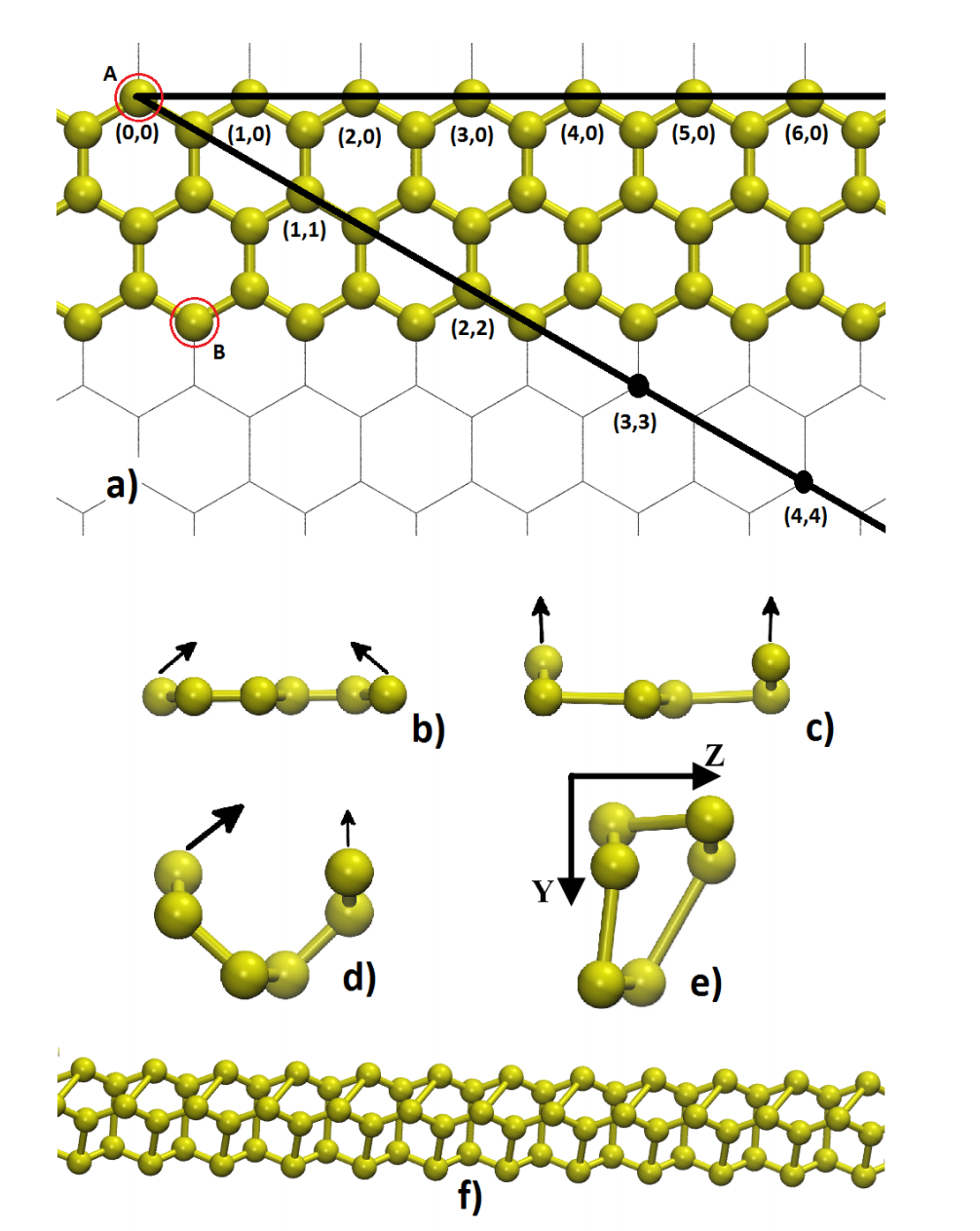
Perim, Eric; Paupitz, Ricardo; Botari, Tiago; Galvao, Douglas S
Novel Semiconducting Silicon and Germanium Nanotubes Journal Article
Em: arXiv preprint arXiv:1403.2061, 2014.
Resumo | Links | BibTeX | Tags: DFT, Germanium, Nanotubes, Silicon
@article{perim2014novel,
title = {Novel Semiconducting Silicon and Germanium Nanotubes},
author = {Perim, Eric and Paupitz, Ricardo and Botari, Tiago and Galvao, Douglas S},
url = {http://arxiv.org/abs/1403.2061},
year = {2014},
date = {2014-01-01},
journal = {arXiv preprint arXiv:1403.2061},
abstract = {In this work we report new silicon and germanium nanotube structures, with no corresponding
stable carbon analogues and which cannot be described by integer chiral indices. The electronic
and mechanical properties of these new tubes were investigated through ab initio methods. Our
results show that the structures are stable up to high temperatures (500 and 1000 K, for silicon and
germanium tubes, respectively). Both tubes are semiconducting with small indirect band gaps,
which can be significantly altered by both compressive and tensile strains. They also present high
Young modulus values (0.25 and 0.15 TPa, respectively).},
keywords = {DFT, Germanium, Nanotubes, Silicon},
pubstate = {published},
tppubtype = {article}
}
stable carbon analogues and which cannot be described by integer chiral indices. The electronic
and mechanical properties of these new tubes were investigated through ab initio methods. Our
results show that the structures are stable up to high temperatures (500 and 1000 K, for silicon and
germanium tubes, respectively). Both tubes are semiconducting with small indirect band gaps,
which can be significantly altered by both compressive and tensile strains. They also present high
Young modulus values (0.25 and 0.15 TPa, respectively).

Brunetto, G; Galvao, DS
Graphene-like Membranes: From Impermeable to Selective Sieves Proceedings
Cambridge University Press, vol. 1658, 2014.
Resumo | Links | BibTeX | Tags: Graphene, Membranes, Porous Graphene, Sieves
@proceedings{brunetto2014graphene,
title = {Graphene-like Membranes: From Impermeable to Selective Sieves},
author = {Brunetto, G and Galvao, DS},
url = {http://journals.cambridge.org/action/displayAbstract?fromPage=online&aid=9248039&fileId=S1946427414004011},
year = {2014},
date = {2014-01-01},
journal = {MRS Proceedings},
volume = {1658},
pages = {mrsf13--1658},
publisher = {Cambridge University Press},
abstract = {Recently, it was proposed that graphene membranes could act as impermeable atomic
structures to standard gases. For some other applications, a higher level of porosity is needed,
and the so-called Porous Graphene (PG) and Biphenylene Carbon (BPC) membranes are good
candidates to effectively work as selective sieves. In this work we have used classical molecular
dynamics simulations to study the dynamics of membrane permeation of He and Ar atoms and
possible selectivity effects. For the graphene membranes we did not observe any leakage
through the membrane and/or membrane/substrate interface until a critical pressure limit, then a
sudden membrane detachment occurs. PG and BPC membranes are not impermeable as
graphene ones, but there are significant energy barriers to diffusion depending on the atom type.
Our results show that this kind of porous membranes can be effectively used as selective sieves
for pure and mixtures of gases.},
keywords = {Graphene, Membranes, Porous Graphene, Sieves},
pubstate = {published},
tppubtype = {proceedings}
}
structures to standard gases. For some other applications, a higher level of porosity is needed,
and the so-called Porous Graphene (PG) and Biphenylene Carbon (BPC) membranes are good
candidates to effectively work as selective sieves. In this work we have used classical molecular
dynamics simulations to study the dynamics of membrane permeation of He and Ar atoms and
possible selectivity effects. For the graphene membranes we did not observe any leakage
through the membrane and/or membrane/substrate interface until a critical pressure limit, then a
sudden membrane detachment occurs. PG and BPC membranes are not impermeable as
graphene ones, but there are significant energy barriers to diffusion depending on the atom type.
Our results show that this kind of porous membranes can be effectively used as selective sieves
for pure and mixtures of gases.
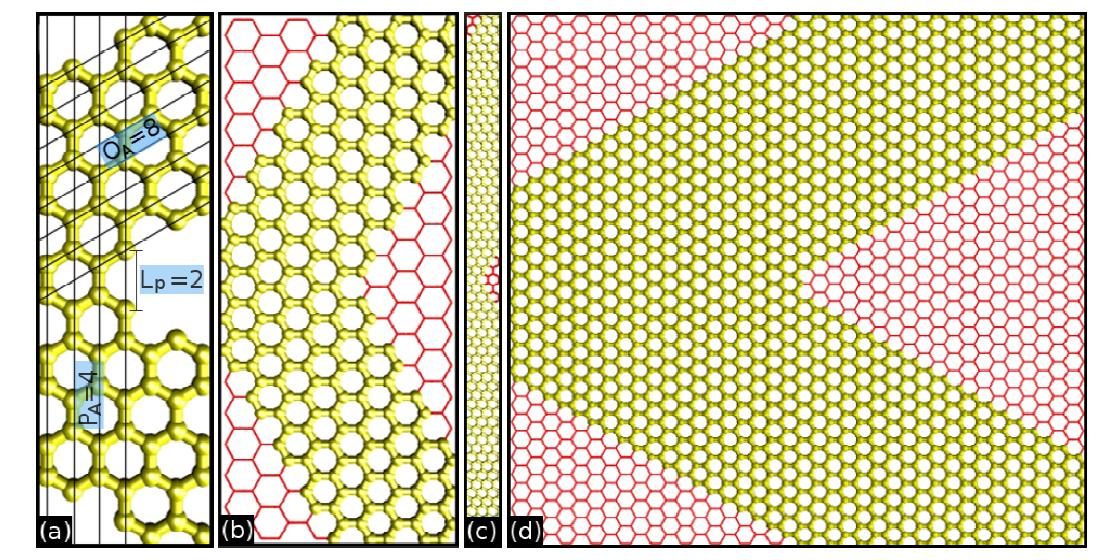
Bizao, RA; Botari, T; Galvao, DS
Mechanical Properties of Graphene Nanowiggles Proceedings
Cambridge University Press, vol. 1658, 2014.
Resumo | Links | BibTeX | Tags: Graphene, Molecular Dynamics, NanoRibbons, Nanowiggles
@proceedings{bizao2014mechanical,
title = {Mechanical Properties of Graphene Nanowiggles},
author = {Bizao, RA and Botari, T and Galvao, DS},
url = {http://journals.cambridge.org/action/displayAbstract?fromPage=online&aid=9248042&fileId=S1946427414004023},
year = {2014},
date = {2014-01-01},
journal = {MRS Proceedings},
volume = {1658},
pages = {mrsf13--1658},
publisher = {Cambridge University Press},
abstract = {In this work we have investigated the mechanical properties and fracture patterns of some graphene nanowiggles (GNWs). Graphene nanoribbons are finite graphene segments with a large aspect ratio, while GNWs are nonaligned periodic repetitions of graphene nanoribbons. We have carried out fully atomistic molecular dynamics simulations using a reactive force field (ReaxFF), as implemented in the LAMPPS (Large-scale Atomic/Molecular Massively Parallel Simulator) code. Our results showed that the GNW fracture patterns are strongly dependent on the nanoribbon topology and present an interesting behavior, since some narrow sheets have larger ultimate failure strain values. This can be explained by the fact that narrow nanoribbons have more angular freedom when compared to wider ones, which can create a more efficient way to accumulate and to dissipate strain/stress. We have also observed the formation of linear atomic chains (LACs) and some structural defect reconstructions during the material rupture. The reported graphene failure patterns, where zigzag/armchair edge terminated graphene structures are fractured along armchair/zigzag lines, were not observed in the GNW analyzed cases.},
keywords = {Graphene, Molecular Dynamics, NanoRibbons, Nanowiggles},
pubstate = {published},
tppubtype = {proceedings}
}
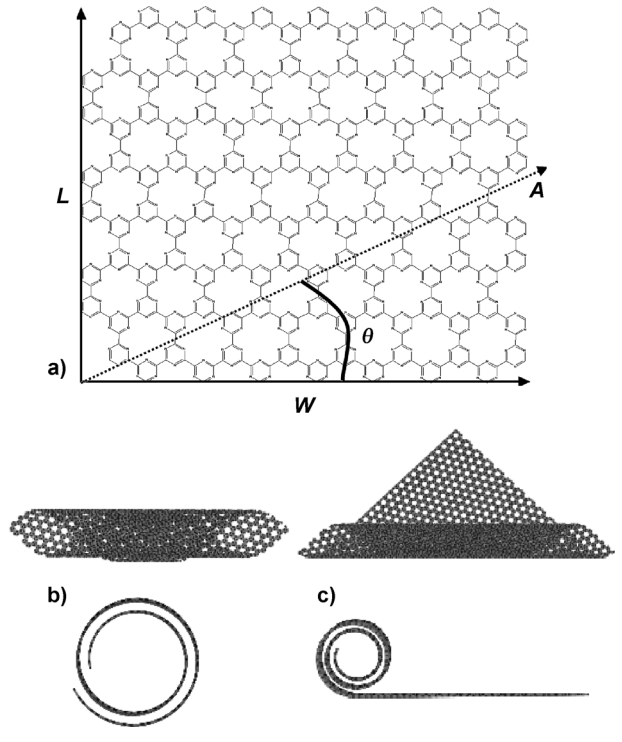
Perim, Eric; Galvao, Douglas S
Novel Nanoscroll Structures from Carbon Nitride Layers Journal Article
Em: ChemPhysChem, vol. 15, não 11, pp. 2367–2371, 2014.
Resumo | Links | BibTeX | Tags: carbon nitride, Molecular Dynamics, Scrolls
@article{perim2014novelb,
title = {Novel Nanoscroll Structures from Carbon Nitride Layers},
author = {Perim, Eric and Galvao, Douglas S},
url = {http://onlinelibrary.wiley.com/doi/10.1002/cphc.201402059/full},
year = {2014},
date = {2014-01-01},
journal = {ChemPhysChem},
volume = {15},
number = {11},
pages = {2367--2371},
publisher = {WILEY-VCH Verlag},
abstract = {Nanoscrolls (papyrus-like nanostructures) are very attractive structures for a variety of applications, owing to their tunable diameter and large accessible surface area. They have been successfully synthesized from different materials. In this work, we investigate, through fully atomistic molecular dynamics simulations, the dynamics of scroll formation for a series of graphene-like carbon nitride (CN) two-dimensional systems: g-CN, triazine-based g-C3N4, and heptazine-based g-C3N4. Our results show that stable nanoscrolls can be formed for each of these structures. Possible synthetic routes to produce these nanostructures are also addressed.},
keywords = {carbon nitride, Molecular Dynamics, Scrolls},
pubstate = {published},
tppubtype = {article}
}
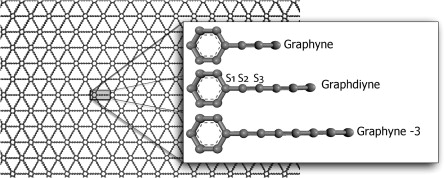
Autreto, PAS; de Sousa, JM; Galvao, DS
Site-dependent hydrogenation on graphdiyne Journal Article
Em: Carbon, vol. 77, pp. 829–834, 2014.
Resumo | Links | BibTeX | Tags: Functionalization, Graphdyine, Graphene, Graphynes
@article{autreto2014site,
title = {Site-dependent hydrogenation on graphdiyne},
author = {Autreto, PAS and de Sousa, JM and Galvao, DS},
url = {http://www.sciencedirect.com/science/article/pii/S0008622314005429},
year = {2014},
date = {2014-01-01},
journal = {Carbon},
volume = {77},
pages = {829--834},
publisher = {Pergamon},
abstract = {Graphene is one of the most important materials in science today due to its unique and remarkable electronic, thermal and mechanical properties. However in its pristine state, graphene is a gapless semiconductor, what limits its use in transistor electronics. In part due to the revolution created by graphene in materials science, there is a renewed interest in other possible graphene-like two-dimensional structures. Examples of these structures are graphynes and graphdiynes, which are two-dimensional structures, composed of carbon atoms in sp2 and sp-hybridized states. Graphdiynes (benzenoid rings connecting two acetylenic groups) were recently synthesized and some of them are intrinsically nonzero gap systems. These systems can be easily hydrogenated and the relative level of hydrogenation can be used to tune the band gap values. We have investigated, using fully reactive molecular dynamics (ReaxFF), the structural and dynamics aspects of the hydrogenation mechanisms of graphdiyne membranes. Our results showed that the hydrogen bindings have different atom incorporation rates and that the hydrogenation patterns change in time in a very complex way. The formation of correlated domains reported to hydrogenated graphene is no longer observed in graphdiyne cases.},
keywords = {Functionalization, Graphdyine, Graphene, Graphynes},
pubstate = {published},
tppubtype = {article}
}
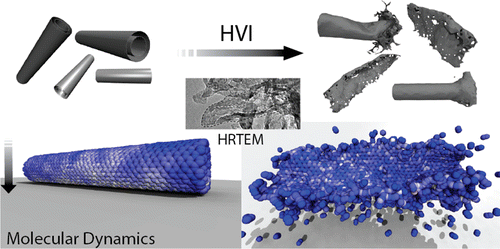
Ozden, Sehmus; Autreto, Pedro AS; Tiwary, Chandra Sekhar; Khatiwada, Suman; Machado, Leonardo; Galvao, Douglas S; Vajtai, Robert; Barrera, Enrique V; M. Ajayan, Pulickel
Unzipping Carbon Nanotubes at High Impact Journal Article
Em: Nano letters, vol. 14, não 7, pp. 4131–4137, 2014.
Resumo | Links | BibTeX | Tags: Carbon Nanotubes, Fracture, Unzipping
@article{ozden2014unzipping,
title = {Unzipping Carbon Nanotubes at High Impact},
author = {Ozden, Sehmus and Autreto, Pedro AS and Tiwary, Chandra Sekhar and Khatiwada, Suman and Machado, Leonardo and Galvao, Douglas S and Vajtai, Robert and Barrera, Enrique V and M. Ajayan, Pulickel},
url = {http://pubs.acs.org/doi/abs/10.1021/nl501753n},
year = {2014},
date = {2014-01-01},
journal = {Nano letters},
volume = {14},
number = {7},
pages = {4131--4137},
publisher = {American Chemical Society},
abstract = {The way nanostructures behave and mechanically respond to high impact collision is a topic of intrigue. For anisotropic nanostructures, such as carbon nanotubes, this response will be complicated based on the impact geometry. Here we report the result of hypervelocity impact of nanotubes against solid targets and show that impact produces a large number of defects in the nanotubes, as well as rapid atom evaporation, leading to their unzipping along the nanotube axis. Fully atomistic reactive molecular dynamics simulations are used to gain further insights of the pathways and deformation and fracture mechanisms of nanotubes under high energy mechanical impact. Carbon nanotubes have been unzipped into graphene nanoribbons before using chemical treatments but here the instability of nanotubes against defect formation, fracture, and unzipping is revealed purely through mechanical impact.},
keywords = {Carbon Nanotubes, Fracture, Unzipping},
pubstate = {published},
tppubtype = {article}
}

Vinod, Soumya; Tiwary, Chandra Sekhar; da Silva Autreto, Pedro Alves; Taha-Tijerina, Jaime; Ozden, Sehmus; Chipara, Alin Cristian; Vajtai, Robert; Galvao, Douglas S; Narayanan, Tharangattu N; Ajayan, Pulickel M
Low-density three-dimensional foam using self-reinforced hybrid two-dimensional atomic layers Journal Article
Em: Nature Communications, vol. 5, 2014.
Links | BibTeX | Tags: foams, Fracture, Graphene, Mechanical Properties, top20
@article{vinod2014low,
title = {Low-density three-dimensional foam using self-reinforced hybrid two-dimensional atomic layers},
author = {Vinod, Soumya and Tiwary, Chandra Sekhar and da Silva Autreto, Pedro Alves and Taha-Tijerina, Jaime and Ozden, Sehmus and Chipara, Alin Cristian and Vajtai, Robert and Galvao, Douglas S and Narayanan, Tharangattu N and Ajayan, Pulickel M},
url = {http://www.nature.com/ncomms/2014/140729/ncomms5541/full/ncomms5541.html},
year = {2014},
date = {2014-01-01},
journal = {Nature Communications},
volume = {5},
publisher = {Nature Publishing Group},
keywords = {foams, Fracture, Graphene, Mechanical Properties, top20},
pubstate = {published},
tppubtype = {article}
}

Perim, Eric; Paupitz, Ricardo; Autreto, PAS; Galvao, Douglas Soares
Inorganic Graphenylene: A Porous Two-Dimensional Material With Tunable Band Gap Journal Article
Em: The Journal of Physical Chemistry C, vol. 118, não 41, pp. 23670–23674, 2014.
Resumo | Links | BibTeX | Tags: BPC, Graphenylene, Porous Graphene
@article{perim2014inorganic,
title = {Inorganic Graphenylene: A Porous Two-Dimensional Material With Tunable Band Gap},
author = {Perim, Eric and Paupitz, Ricardo and Autreto, PAS and Galvao, Douglas Soares},
url = {http://pubs.acs.org/doi/abs/10.1021/jp502119y},
year = {2014},
date = {2014-01-01},
journal = {The Journal of Physical Chemistry C},
volume = {118},
number = {41},
pages = {23670--23674},
publisher = {American Chemical Society},
abstract = {By means of ab initio calculations, we investigate the possibility of existence of a boron nitride (BN) porous two-dimensional nanosheet, which is geometrically similar to the carbon allotrope known as biphenylene carbon. The proposed structure, which we called inorganic graphenylene (IGP), is formed spontaneously after selective dehydrogenation of the porous boron nitride (BN) structure proposed by Ding et al. We study the structural and electronic properties of both porous BN and IGP, and it is shown that, by selective substitution of B and N atoms with carbon atoms in these structures, the band gap can be significantly reduced, changing their behavior from insulators to semiconductors, thus opening the possibility of band gap engineering for this class of two-dimensional materials.},
keywords = {BPC, Graphenylene, Porous Graphene},
pubstate = {published},
tppubtype = {article}
}
2013
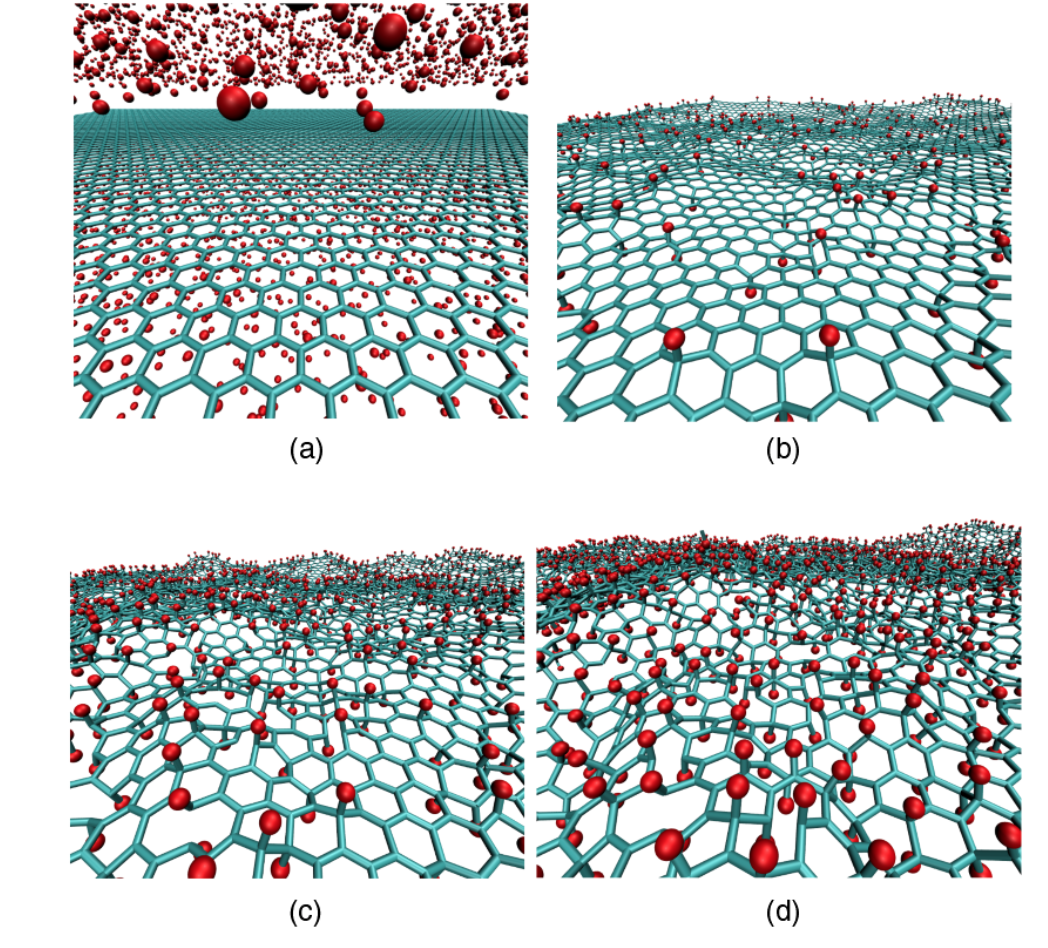
Paupitz, R; Autreto, Pedro AS; Legoas, SB; Srinivasan, S Goverapet; van Duin, Adri CT; Galvao, DS
Graphene to fluorographene and fluorographane: a theoretical study Journal Article
Em: Nanotechnology, vol. 24, não 3, pp. 035706, 2013.
Resumo | Links | BibTeX | Tags: Fluorographene, Graphane, Graphene
@article{paupitz2013graphene,
title = {Graphene to fluorographene and fluorographane: a theoretical study},
author = {Paupitz, R and Autreto, Pedro AS and Legoas, SB and Srinivasan, S Goverapet and van Duin, Adri CT and Galvao, DS},
url = {http://iopscience.iop.org/0957-4484/24/3/035706},
year = {2013},
date = {2013-01-01},
journal = {Nanotechnology},
volume = {24},
number = {3},
pages = {035706},
publisher = {IOP Publishing},
abstract = {We report here a fully reactive molecular dynamics study on the structural and dynamical aspects of the fluorination of graphene membranes (fluorographene). Our results show that fluorination tends to produce defective areas on the graphene membranes with significant distortions of carbon–carbon bonds. Depending on the amount of incorporated fluorine atoms, large membrane holes were observed due to carbon atom losses. These results may explain the broad distribution of the structural lattice parameter values experimentally observed. We have also investigated the effects of mixing hydrogen and fluorine atoms on the graphene functionalization. Our results show that, when in small amounts, the presence of hydrogen atoms produces a significant decrease in the rate of fluorine incorporation onto the membrane. On the other hand, when fluorine is the minority element, it produces a significant catalytic effect on the rate of hydrogen incorporation. We have also observed the spontaneous formation of new hybrid structures with different stable configurations (chair-like, zigzag-like and boat-like) which we named fluorographane.},
keywords = {Fluorographene, Graphane, Graphene},
pubstate = {published},
tppubtype = {article}
}
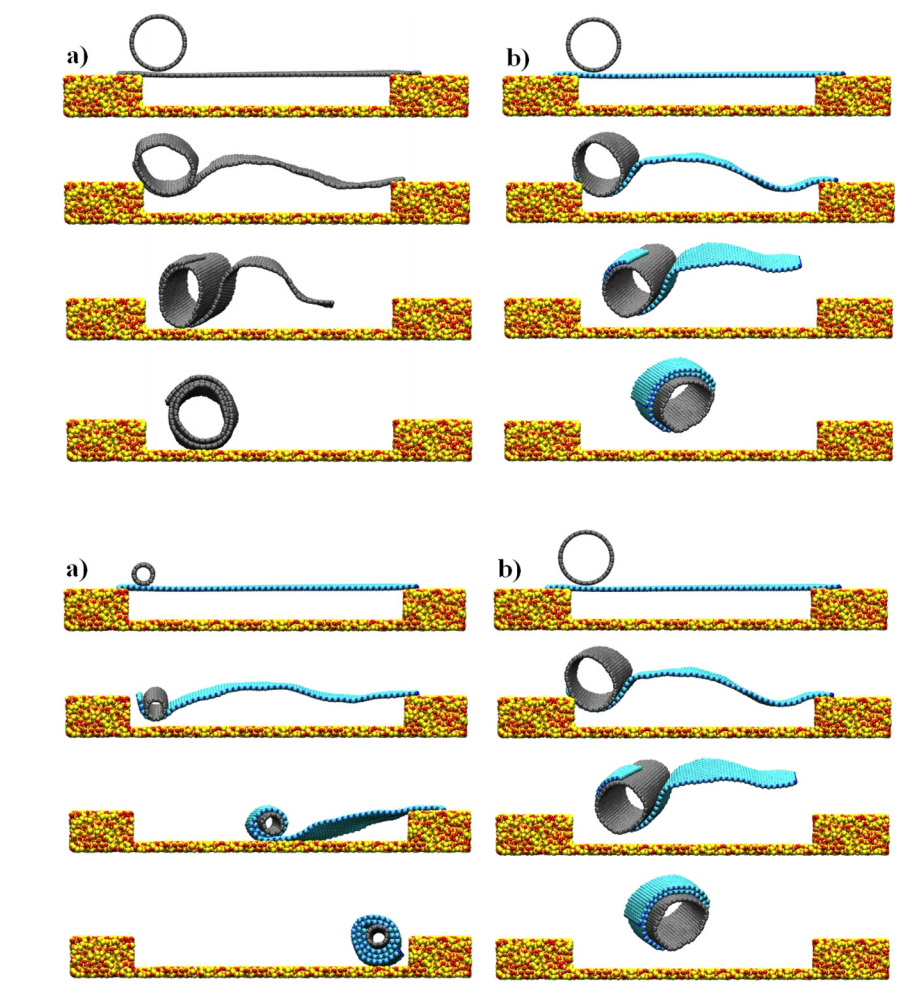
Perim, Eric; Paupitz, Ricardo; Galvao, Douglas S
Controlled route to the fabrication of carbon and boron nitride nanoscrolls: A molecular dynamics investigation Journal Article
Em: Journal of Applied Physics, vol. 113, não 5, pp. 054306, 2013.
Resumo | Links | BibTeX | Tags: Boron Nitride, Carbon Nanotubes, Graphene, Molecular Dynamics, Scrolls
@article{perim2013controlled,
title = {Controlled route to the fabrication of carbon and boron nitride nanoscrolls: A molecular dynamics investigation},
author = {Perim, Eric and Paupitz, Ricardo and Galvao, Douglas S},
url = {http://scitation.aip.org/content/aip/journal/jap/113/5/10.1063/1.4790304},
year = {2013},
date = {2013-01-01},
journal = {Journal of Applied Physics},
volume = {113},
number = {5},
pages = {054306},
publisher = {AIP Publishing},
abstract = {Carbon nanoscrolls (graphene layers rolled up into papyrus-like tubular structures) are nanostructures with unique and interesting characteristics that could be exploited to build several new nanodevices. However, an efficient and controlled synthesis of these structures was not achieved yet, making its large scale production a challenge to materials scientists. Also, the formation process and detailed mechanisms that occur during its synthesis are not completely known. In this work, using fully atomistic molecular dynamics simulations, we discuss a possible route to nanoscrolls made from graphene layers deposited over silicon oxide substrates containing chambers/pits. The scrolling mechanism is triggered by carbon nanotubes deposited on the layers. The process is completely general and can be used to produce scrolls from other lamellar materials, like boron nitride, for instance.},
keywords = {Boron Nitride, Carbon Nanotubes, Graphene, Molecular Dynamics, Scrolls},
pubstate = {published},
tppubtype = {article}
}
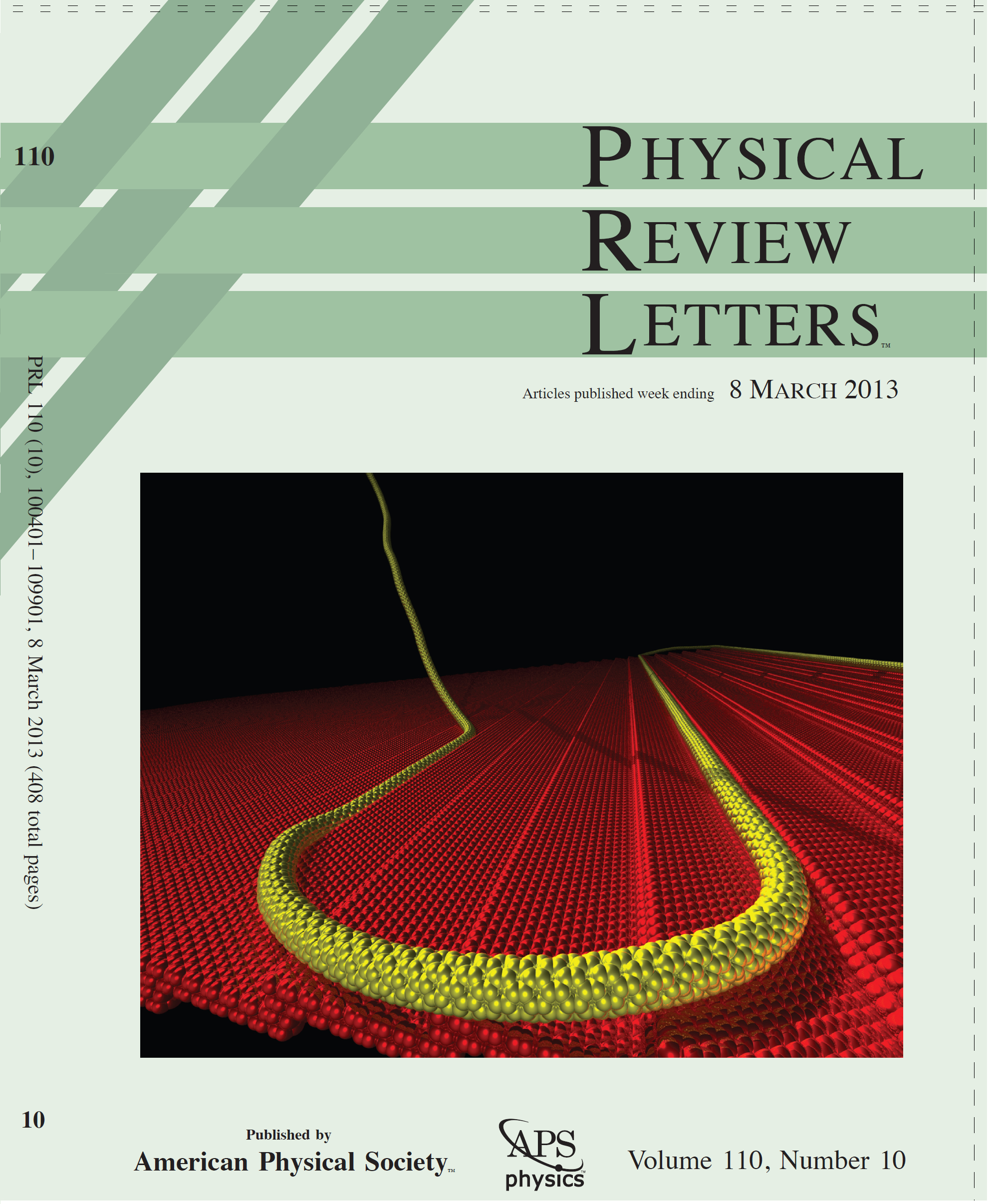
SB Legoas LD Machado, JS Soares
Dynamics of the formation of carbon nanotube serpentines Journal Article
Em: Physical Review Letters, vol. 110, não 10, pp. 105502, 2013.
Resumo | Links | BibTeX | Tags: Carbon Nanotubes, Molecular Dynamics, Serpentines, top20
@article{machado2013dynamics,
title = {Dynamics of the formation of carbon nanotube serpentines},
author = {LD Machado, SB Legoas, JS Soares, N Shadmi, A Jorio, E Joselevich, DS Galvão},
url = {http://journals.aps.org/prl/abstract/10.1103/PhysRevLett.110.105502},
year = {2013},
date = {2013-01-01},
journal = {Physical Review Letters},
volume = {110},
number = {10},
pages = {105502},
publisher = {American Physical Society},
abstract = {Recently, Geblinger et al. [Nat. Nanotechnol. 3, 195 (2008)] reported the experimental realization of carbon nanotube S-like shaped nanostructures, the so-called carbon nanotube serpentines. We report here results from multimillion fully atomistic molecular dynamics simulations of their formation. We consider one-μm-long carbon nanotubes placed on stepped substrates with and without a catalyst nanoparticle on the top free end of the tube. A force is applied to the upper part of the tube during a short period of time and turned off; then the system is set free to evolve in time. Our results show that these conditions are sufficient to form robust serpentines and validates the general features of the “falling spaghetti model” proposed to explain their formation.
},
keywords = {Carbon Nanotubes, Molecular Dynamics, Serpentines, top20},
pubstate = {published},
tppubtype = {article}
}
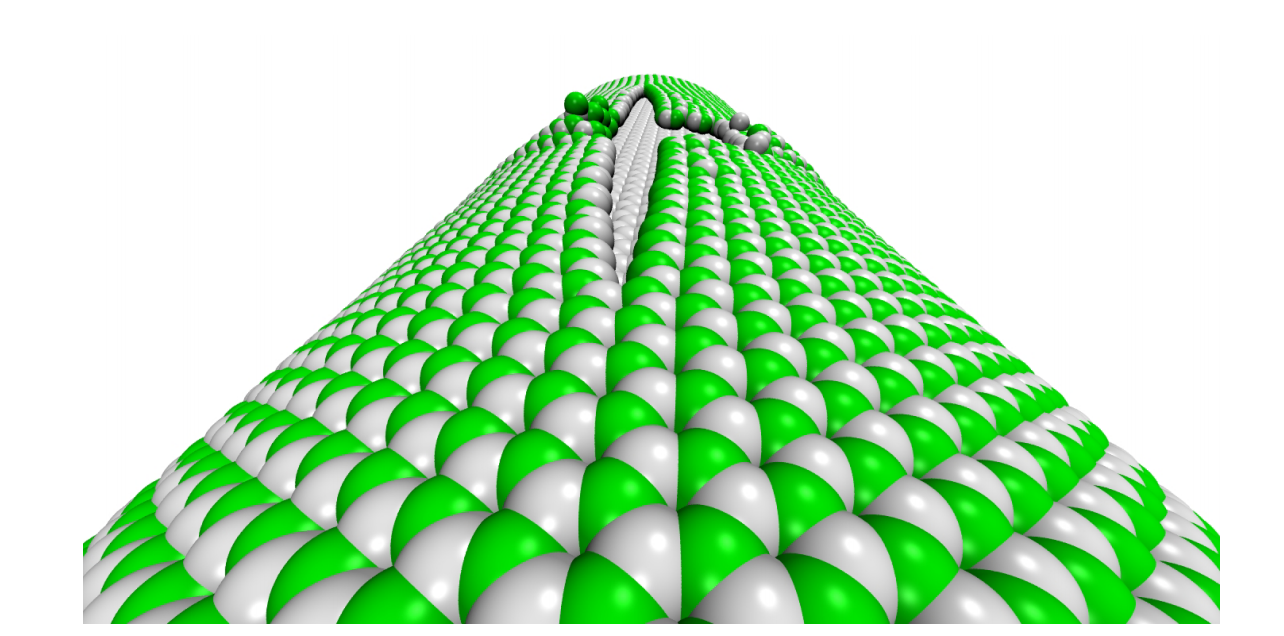
Perim, Eric; Santos, Ricardo Paupitz; Autreto, Pedro Alves da Silva; Galvao, Douglas S
Fracture Patterns of Boron Nitride Nanotubes Proceedings
Cambridge University Press, vol. 1526, 2013.
Resumo | Links | BibTeX | Tags: Boron Nitride, Fracture, Mechanical Properties, Unzipping
@proceedings{perim2013fracture,
title = {Fracture Patterns of Boron Nitride Nanotubes},
author = {Perim, Eric and Santos, Ricardo Paupitz and Autreto, Pedro Alves da Silva and Galvao, Douglas S},
url = {http://journals.cambridge.org/action/displayAbstract?fromPage=online&aid=8883390&fileId=S1946427413004946},
year = {2013},
date = {2013-01-01},
journal = {MRS Proceedings},
volume = {1526},
pages = {mrsf12--1526},
publisher = {Cambridge University Press},
abstract = {During the last years carbon-based nanostructures (such as, fullerenes, carbon nanotubes and graphene) have been object of intense investigations. The great interest in these nanostructures can be attributed to their remarkable electrical and mechanical properties. Their inorganic equivalent structures do exist and are based on boron nitride (BN) motifs. BN fullerenes, nanotubes and single layers have been already synthesized. Recently, the fracture patterns of single layer graphene and multi-walled carbon nanotubes under stress have been studied by theoretical and experimental methods. In this work we investigated the fracturing process of defective carbon and boron nitride nanotubes under similar stress conditions. We have carried out fully atomistic molecular reactive molecular dynamics simulations using the ReaxFF force field. The similarities and differences between carbon and boron nitride fracture patterns are addressed.},
keywords = {Boron Nitride, Fracture, Mechanical Properties, Unzipping},
pubstate = {published},
tppubtype = {proceedings}
}
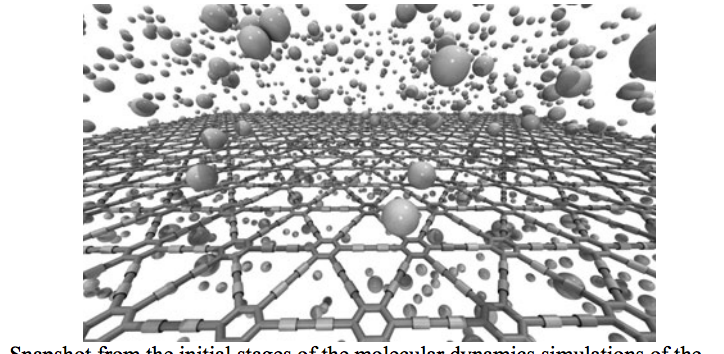
Autreto, PA; de Sousa, JM; Galvao, DS
On the Dynamics of Graphdiyne Hydrogenation Proceedings
Cambridge University Press, vol. 1549, 2013.
Resumo | Links | BibTeX | Tags: Graphdyine, Graphynes, Hydrogenation, Molecular Dynamics
@proceedings{autreto2013dynamics,
title = {On the Dynamics of Graphdiyne Hydrogenation},
author = {Autreto, PA and de Sousa, JM and Galvao, DS},
url = {http://journals.cambridge.org/action/displayAbstract?fromPage=online&aid=8915680&fileId=S1946427413006088},
year = {2013},
date = {2013-01-01},
journal = {MRS Proceedings},
volume = {1549},
pages = {59--64},
publisher = {Cambridge University Press},
abstract = {Graphene is a two-dimensional (2D) hexagonal array of carbon atoms in sp2-hybridized states. Graphene presents unique and exceptional electronic, thermal and mechanical properties. However, in its pristine state graphene is a gapless semiconductor, which poses some limitations to its use in some transistor electronics. Because of this there is a renewed interest in other possible two-dimensional carbon-based structures similar to graphene. Examples of this are graphynes and graphdiynes, which are two-dimensional structures, composed of carbon atoms in sp2 and sp-hybridized states. Graphdiynes (benzenoid rings connecting two acetylenic groups) were recently synthesized and they can be intrinsically nonzero gap systems. These systems can be easily hydrogenated and the amount of hydrogenation can be used to tune the band gap value. In this work we have investigated, through fully atomistic molecular dynamics simulations with reactive force field (ReaxFF), the structural and dynamics aspects of the hydrogenation mechanisms of graphdiyne membranes. Our results showed that depending on whether the atoms are in the benzenoid rings or as part of the acetylenic groups, the rates of hydrogenation are quite distinct and change in time in a very complex pattern. Initially, the most probable sites to be hydrogenated are the carbon atoms forming the triple bonds, as expected. But as the amount of hydrogenation increases in time this changes and then the carbon atoms forming single bonds become the preferential sites. The formation of correlated domains observed in hydrogenated graphene is no longer observed in the case of graphdiynes. We have also carried out ab initio DFT calculations for model structures in order to test the reliability of ReaxFF calculations.},
keywords = {Graphdyine, Graphynes, Hydrogenation, Molecular Dynamics},
pubstate = {published},
tppubtype = {proceedings}
}
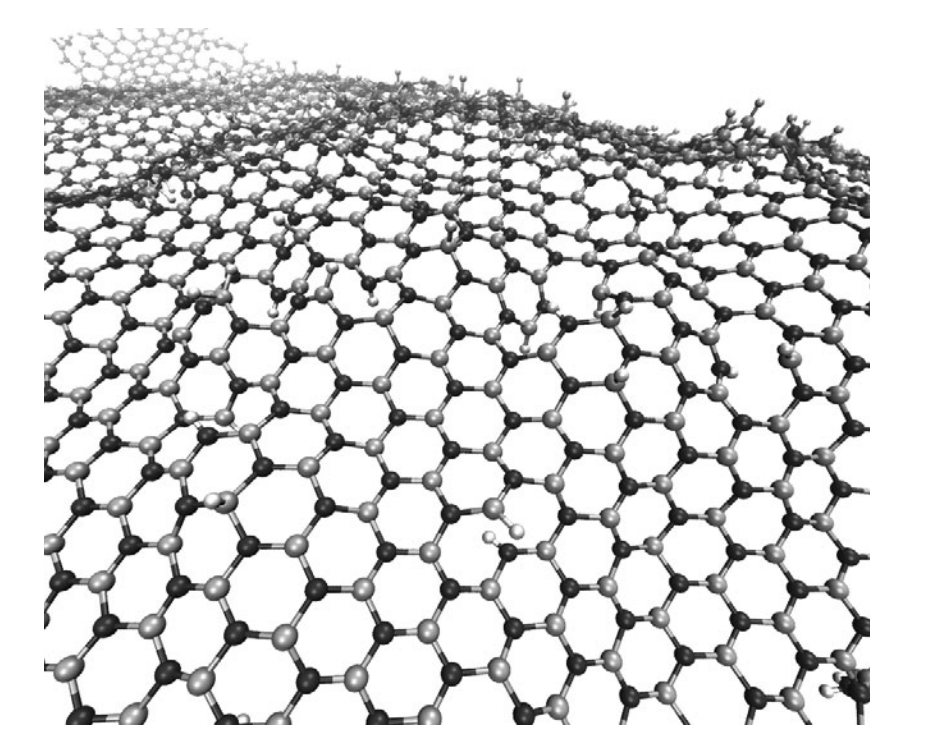
Perim, Eric; Paupitz, Ricardo; Autreto, PAS; Galvao, DS
The Hydrogenation Dynamics of h-BN Sheets Proceedings
Cambridge University Press, vol. 1549, 2013.
Resumo | Links | BibTeX | Tags: Boron Nitride, Hydrogenation, Molecular Dynamics, Nanotubes
@proceedings{perim2013hydrogenation,
title = {The Hydrogenation Dynamics of h-BN Sheets},
author = {Perim, Eric and Paupitz, Ricardo and Autreto, PAS and Galvao, DS},
url = {http://journals.cambridge.org/action/displayAbstract?fromPage=online&aid=8943477&fileId=S1946427413007938},
year = {2013},
date = {2013-01-01},
journal = {MRS Proceedings},
volume = {1549},
pages = {91--98},
publisher = {Cambridge University Press},
abstract = {Hexagonal boron nitride (h-BN), also known as white graphite, is the inorganic analogue of graphite. Single layers of both structures have been already experimentally realized.
In this work we have investigated, through fully atomistic reactive molecular dynamics simulations, the dynamics of hydrogenation of h-BN single-layers membranes.
Our results show that the rate of hydrogenation atoms bonded to the membrane is highly dependent on the temperature and that only at low temperatures there is a preferential bond to boron atoms. Unlike graphanes (hydrogenated graphene), hydrogenated h-BN membranes do not exhibit the formation of correlated domains. Also, the out-of-plane deformations are more pronounced in comparison with the graphene case. After a critical number of incorporated hydrogen atoms the membrane become increasingly defective, lost its two-dimensional character and collapses. The hydrogen radial pair distribution and second-nearest neighbor correlations were also analyzed.},
keywords = {Boron Nitride, Hydrogenation, Molecular Dynamics, Nanotubes},
pubstate = {published},
tppubtype = {proceedings}
}
In this work we have investigated, through fully atomistic reactive molecular dynamics simulations, the dynamics of hydrogenation of h-BN single-layers membranes.
Our results show that the rate of hydrogenation atoms bonded to the membrane is highly dependent on the temperature and that only at low temperatures there is a preferential bond to boron atoms. Unlike graphanes (hydrogenated graphene), hydrogenated h-BN membranes do not exhibit the formation of correlated domains. Also, the out-of-plane deformations are more pronounced in comparison with the graphene case. After a critical number of incorporated hydrogen atoms the membrane become increasingly defective, lost its two-dimensional character and collapses. The hydrogen radial pair distribution and second-nearest neighbor correlations were also analyzed.
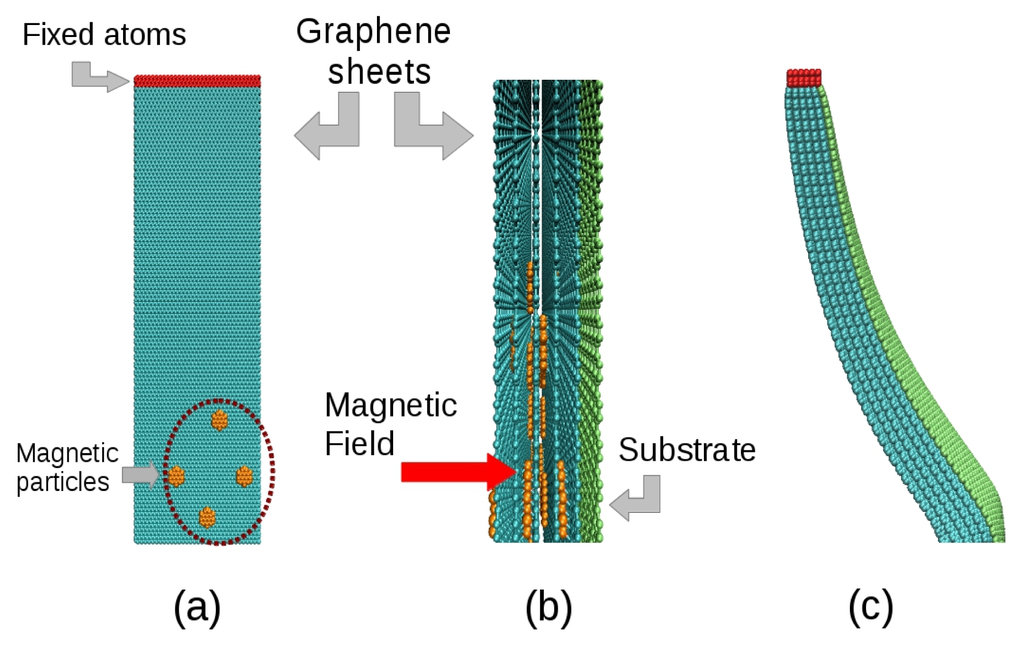
Miyazaki, Celina M; Riul, Antonio; Dos Santos, David S; Ferreira, Mariselma; Constantino, Carlos JL; Pereira-da-Silva, Marcelo A; Paupitz, Ricardo; Galvao, Douglas S; others,
Bending of Layer-by-Layer Films Driven by an External Magnetic Field Journal Article
Em: International journal of molecular sciences, vol. 14, não 7, pp. 12953–12969, 2013.
Resumo | Links | BibTeX | Tags: LB films, Nanoscale Effects
@article{miyazaki2013bending,
title = {Bending of Layer-by-Layer Films Driven by an External Magnetic Field},
author = {Miyazaki, Celina M and Riul, Antonio and Dos Santos, David S and Ferreira, Mariselma and Constantino, Carlos JL and Pereira-da-Silva, Marcelo A and Paupitz, Ricardo and Galvao, Douglas S and others},
url = {http://www.mdpi.com/1422-0067/14/7/12953/htm},
year = {2013},
date = {2013-01-01},
journal = {International journal of molecular sciences},
volume = {14},
number = {7},
pages = {12953--12969},
publisher = {Multidisciplinary Digital Publishing Institute},
abstract = {We report on optimized architectures containing layer-by-layer (LbL) films of natural rubber latex (NRL), carboxymethyl-chitosan (CMC) and magnetite (Fe3O4) nanoparticles (MNPs) deposited on flexible substrates, which could be easily bent by an external magnetic field. The mechanical response depended on the number of deposited layers and was explained semi-quantitatively with a fully atomistic model, where the LbL film was represented as superposing layers of hexagonal graphene-like atomic arrangements deposited on a stiffer substrate. The bending with no direct current or voltage being applied to a supramolecular structure containing biocompatible and antimicrobial materials represents a proof-of-principle experiment that is promising for tissue engineering applications in biomedicine. - See more at: http://www.mdpi.com/1422-0067/14/7/12953/htm#sthash.cSUOvaot.dpuf},
keywords = {LB films, Nanoscale Effects},
pubstate = {published},
tppubtype = {article}
}

Machado, LD; Autreto, PAS; Galvao, DS
Graphyne Oxidation: Insights From a Reactive Molecular Dynamics Investigation Proceedings
Cambridge University Press, vol. 1549, 2013.
Resumo | Links | BibTeX | Tags: Graphdyine, Graphyne, Molecular Dynamics, Oxidation
@proceedings{machado2013graphyne,
title = {Graphyne Oxidation: Insights From a Reactive Molecular Dynamics Investigation},
author = {Machado, LD and Autreto, PAS and Galvao, DS},
url = {http://journals.cambridge.org/action/displayAbstract?fromPage=online&aid=8963025&fileId=S194642741300941X},
year = {2013},
date = {2013-01-01},
journal = {MRS Proceedings},
volume = {1549},
pages = {53--58},
publisher = {Cambridge University Press},
abstract = {Graphyne is a generic name for a family of carbon allotrope two-dimensional structures where sp2 (single and double bonds) and sp (triple bonds) hybridized states coexists. They exhibit very interesting electronic and mechanical properties sharing some of the unique graphene characteristics. Similarly to graphene, the graphyne electronic properties can be modified by chemical functionalization, such as; hydrogenation, fluorination and oxidation. Oxidation is of particular interest since it can produce significant structural damages.
In this work we have investigated, through fully atomistic reactive molecular dynamics simulations, the dynamics and structural changes of the oxidation of single-layer graphyne membranes at room temperature. We have considered α, β, and γ-graphyne structures. Our results showed that the oxidation reactions are strongly site dependent and that the sp-hybridized carbon atoms are the preferential sites to chemical attacks. Our results also showed that the effectiveness of the oxidation (estimated from the number of oxygen atoms covalently bonded to carbon atoms) follows the α, β, γ-graphyne structure ordering. These differences can be explained by the fact that for α-graphyne structures the oxidation reactions occur in two steps: first, the oxygen atoms are trapped at the center of the large polygonal rings and then they react with the carbon atoms composing of the triple bonds. The small rings of γ-graphyne structures prevent these reactions to occur. The effectiveness of β-graphyne oxidation is between the α- and γ-graphynes.},
keywords = {Graphdyine, Graphyne, Molecular Dynamics, Oxidation},
pubstate = {published},
tppubtype = {proceedings}
}
In this work we have investigated, through fully atomistic reactive molecular dynamics simulations, the dynamics and structural changes of the oxidation of single-layer graphyne membranes at room temperature. We have considered α, β, and γ-graphyne structures. Our results showed that the oxidation reactions are strongly site dependent and that the sp-hybridized carbon atoms are the preferential sites to chemical attacks. Our results also showed that the effectiveness of the oxidation (estimated from the number of oxygen atoms covalently bonded to carbon atoms) follows the α, β, γ-graphyne structure ordering. These differences can be explained by the fact that for α-graphyne structures the oxidation reactions occur in two steps: first, the oxygen atoms are trapped at the center of the large polygonal rings and then they react with the carbon atoms composing of the triple bonds. The small rings of γ-graphyne structures prevent these reactions to occur. The effectiveness of β-graphyne oxidation is between the α- and γ-graphynes.
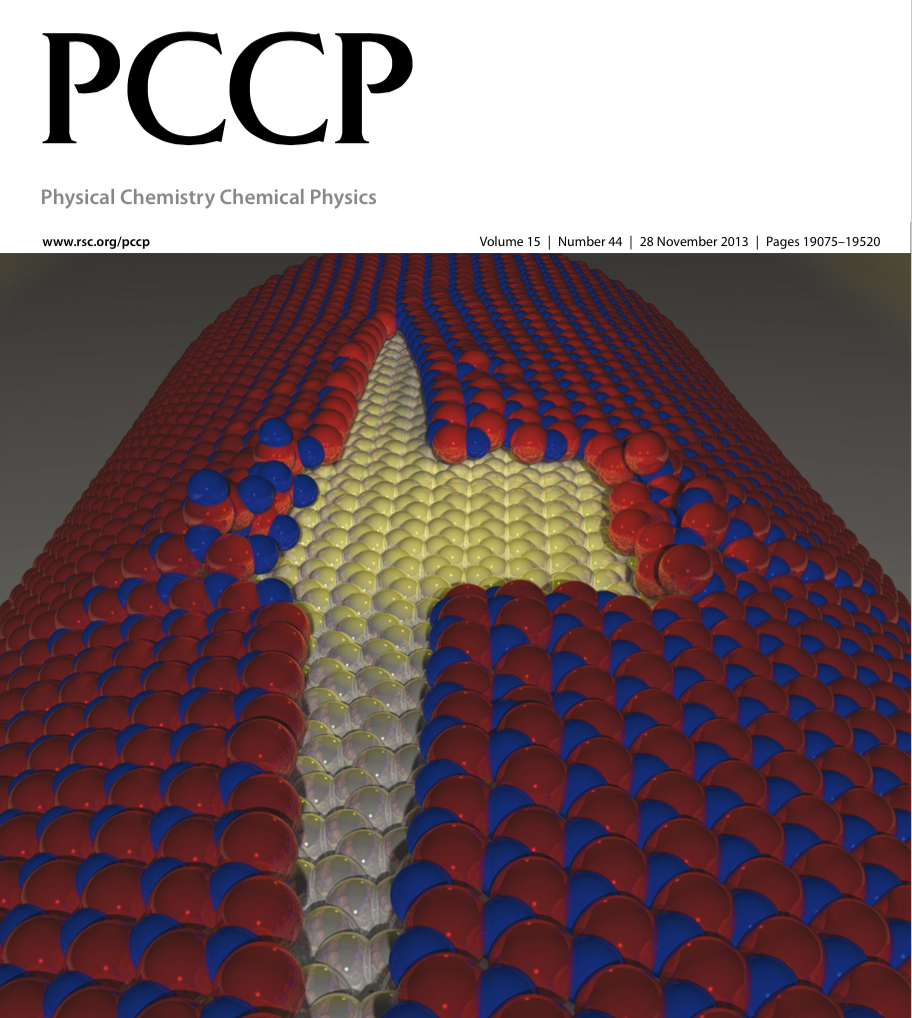
Perim, E; Autreto, PAS; Paupitz, R; Galvao, DS
Dynamical aspects of the unzipping of multiwalled boron nitride nanotubes Journal Article
Em: Physical Chemistry Chemical Physics, vol. 15, não 44, pp. 19147–19150, 2013.
Resumo | Links | BibTeX | Tags: Boron Nitride, Mechanical Properties, Molecular Dynamics, Unzipping
@article{perim2013dynamical,
title = {Dynamical aspects of the unzipping of multiwalled boron nitride nanotubes},
author = {Perim, E and Autreto, PAS and Paupitz, R and Galvao, DS},
url = {http://pubs.rsc.org/EN/content/articlehtml/2013/cp/c3cp52701h},
year = {2013},
date = {2013-01-01},
journal = {Physical Chemistry Chemical Physics},
volume = {15},
number = {44},
pages = {19147--19150},
publisher = {Royal Society of Chemistry},
abstract = {Boron nitride nanoribbons (BNNRs) exhibit very interesting magnetic properties, which could be very useful in the development of spintronic based devices. One possible route to obtain BNNRs is through the unzipping of boron nitride nanotubes (BNNTs), which have been already experimentally realized. In this work, different aspects of the unzipping process of BNNTs were investigated through fully atomistic molecular dynamics simulations using a classical reactive force field (ReaxFF). We investigated multiwalled BNNTs of different diameters and chiralities. Our results show that chirality plays a very important role in the unzipping process, as well as the interlayer coupling. These combined aspects significantly change the fracturing patterns and several other features of the unzipping processes in comparison to the ones observed for carbon nanotubes. Also, similar to carbon nanotubes, defective BNNTs can create regions of very high curvature which can act as a path to the unzipping process.
},
keywords = {Boron Nitride, Mechanical Properties, Molecular Dynamics, Unzipping},
pubstate = {published},
tppubtype = {article}
}
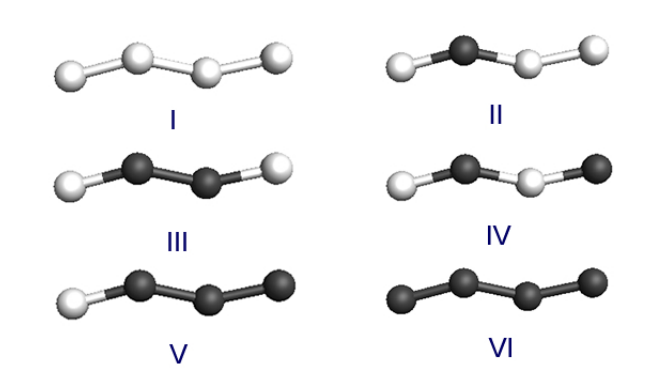
Autreto, Pedro Alves da Silva; Galvao, Douglas S; Artacho, Emilio
Species Fractionation in Atomic Chains from Mechanically Stretched Alloys Journal Article
Em: arXiv preprint arXiv:1312.1285, 2013.
Resumo | Links | BibTeX | Tags: Atomic Chains, DFT, Mech, Mechanical Properties, Metallic Nanowires
@article{autreto2013species,
title = {Species Fractionation in Atomic Chains from Mechanically Stretched Alloys},
author = {Autreto, Pedro Alves da Silva and Galvao, Douglas S and Artacho, Emilio},
url = {http://arxiv.org/abs/1312.1285},
year = {2013},
date = {2013-01-01},
journal = {arXiv preprint arXiv:1312.1285},
abstract = {Bettini et al. [Nature Nanotech 1, 182 (2006)] reported the first experimental realization of linear
atomic chains (LACs) composed of different atoms (Au and Ag). Different contents of Au and Ag
were observed in the chains from what found in the bulk alloys, which rises the question of what is the
wire composition if in equilibrium with a bulk alloy. In this work we address the thermodynamic
driving force for species fractionation in LACs under tension, and we present density-functional
theory results for Ag-Au chain alloys. A pronounced stabilization of wires with an alternating
Ag-Au sequence is observed, which could be behind the experimentally observed Au enrichment in
LACs from alloys of high Ag content.},
keywords = {Atomic Chains, DFT, Mech, Mechanical Properties, Metallic Nanowires},
pubstate = {published},
tppubtype = {article}
}
atomic chains (LACs) composed of different atoms (Au and Ag). Different contents of Au and Ag
were observed in the chains from what found in the bulk alloys, which rises the question of what is the
wire composition if in equilibrium with a bulk alloy. In this work we address the thermodynamic
driving force for species fractionation in LACs under tension, and we present density-functional
theory results for Ag-Au chain alloys. A pronounced stabilization of wires with an alternating
Ag-Au sequence is observed, which could be behind the experimentally observed Au enrichment in
LACs from alloys of high Ag content.
2012
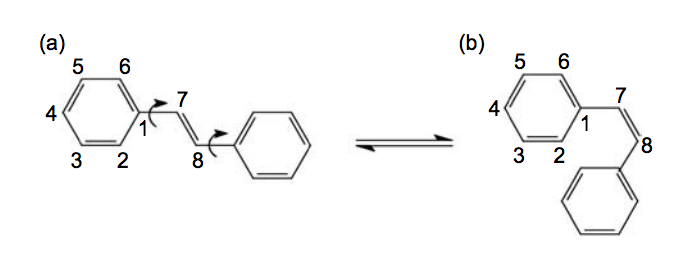
Camilo Jr, A; dos Santos, RPB; Coluci, VR; Galvao, DS
Comparative parametric method 6 (PM6) and Recife model 1 (RM1) study of trans-stilbene Journal Article
Em: Molecular Simulation, vol. 38, não 1, pp. 1–7, 2012.
Resumo | Links | BibTeX | Tags: AM1, MOPAC, PM3, PM6, PPV, RM1, Stilbene
@article{camilo2012comparative,
title = {Comparative parametric method 6 (PM6) and Recife model 1 (RM1) study of trans-stilbene},
author = {Camilo Jr, A and dos Santos, RPB and Coluci, VR and Galvao, DS},
url = {http://www.tandfonline.com/doi/abs/10.1080/08927022.2011.597392#.VLZyQ4rF-2o},
year = {2012},
date = {2012-01-01},
journal = {Molecular Simulation},
volume = {38},
number = {1},
pages = {1--7},
publisher = {Taylor & Francis Group},
abstract = {In this paper, we report a comparative parametric method 6 (PM6) and Recife model 1 (RM1) study of trans-stilbene in its ground and (excited) singlet, triplet and ionic (positive and negative polarons and bipolarons) states. We evaluated the accuracy of the recently developed PM6 and RM1 comparing the obtained results with other semi-empirical, ab initio methods and available experimental data. PM6 and RM1 predict non-planar ground and singlet states for trans-stilbene, in agreement with the PM5 and the Austin model 1. On the other hand, the PM3 predicts planar configurations, which is in agreement with the available experimental data. PM6 and RM1 overestimate the cis–trans isomerisation energy as well as the ionisation potential of both cis- and trans-stilbene. In spite of the developments of these new methods, PM3 continues to be the only one of these methods to correctly predict the conformation of stilbene.},
keywords = {AM1, MOPAC, PM3, PM6, PPV, RM1, Stilbene},
pubstate = {published},
tppubtype = {article}
}
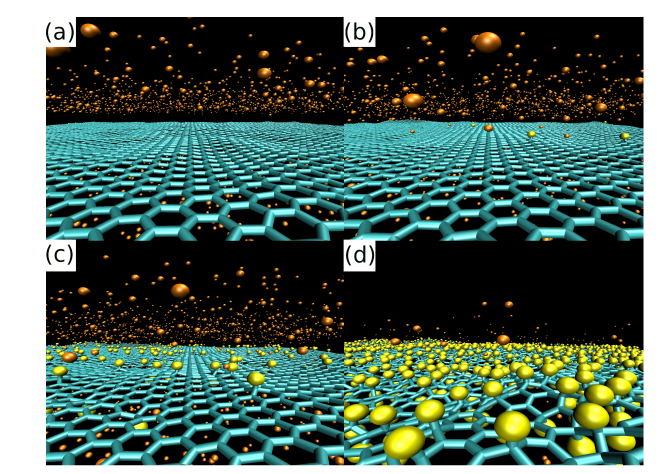
Autreto, PAS; Galvao, Douglas S; Santos, Ricardo PB; Legoas, SB
Graphene to Fluorographene: A Reactive Molecular Dynamics Study Journal Article
Em: Physicæ Proceedings, vol. 1, não 1, pp. 3, 2012.
Resumo | Links | BibTeX | Tags: Graphanes, Graphene, Molecular Dynamics
@article{autreto2012graphene,
title = {Graphene to Fluorographene: A Reactive Molecular Dynamics Study},
author = {Autreto, PAS and Galvao, Douglas S and Santos, Ricardo PB and Legoas, SB},
url = {http://physicae.ifi.unicamp.br/phyproceedings/article/view/physicae.proceedings.XIYRM.11},
year = {2012},
date = {2012-01-01},
journal = {Physicæ Proceedings},
volume = {1},
number = {1},
pages = {3},
abstract = {We have investigated, using fully reactive molecular dynamics methodology, the structural and dynamical aspects of the fluorination of graphene membranes leading to fluographene formation. The strong and fast chemical reactivity processes involving fluorine produce distinct aspects of the observed in the case of the hydrogenation of graphene (the so called graphane formation). Fluorination tends to produce significant defective areas on the graphene membrane with alteration on the typical carbon-carbon distances, sometimes with the presence of large holes due to carbon losses. This may explain the broad distribution of values of lattice parameter experimentally observed.
},
keywords = {Graphanes, Graphene, Molecular Dynamics},
pubstate = {published},
tppubtype = {article}
}
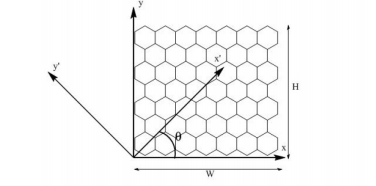
Perim, E; Galvao, DS
Boron Nitride Nanoscrolls Journal Article
Em: Physicæ Proceedings, vol. 1, não 1, pp. 2, 2012.
Resumo | Links | BibTeX | Tags: Boron Nitride, Molecular Dynamics, Scrolls
@article{perim2012boron,
title = {Boron Nitride Nanoscrolls},
author = {Perim, E and Galvao, DS},
url = {http://physicae.ifi.unicamp.br/phyproceedings/article/view/269},
year = {2012},
date = {2012-01-01},
journal = {Physicæ Proceedings},
volume = {1},
number = {1},
pages = {2},
abstract = {Recently, based on computer simulations, it has been proposed that stable boron nitride nanoscrolls (BNNSs) can exist. In this work we show that the BNNSs stability mechanisms follow the same simple physical principles proposed for carbon nanoscrolls (CNSs). For both classes of scrolls, the mechanical stability arises as the result of the interplay between attractive van der Waals forces and the elastic (bending) deformations. The topology (chirality) of the scrolled single-layer membranes plays an important role defining BNNS stability. A controled way to produce BNNSs is also addressed.},
keywords = {Boron Nitride, Molecular Dynamics, Scrolls},
pubstate = {published},
tppubtype = {article}
}
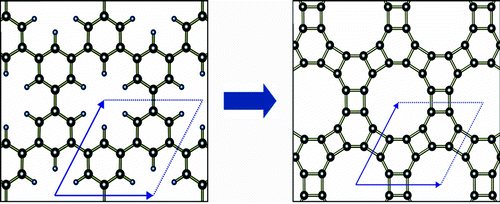
Brunetto, Gustavo; Autreto, PAS; Machado, Leonardo Dantas; Santos, BI; dos Santos, Ricardo PB; Galvao, Douglas S
Nonzero gap two-dimensional carbon allotrope from porous graphene Journal Article
Em: The Journal of Physical Chemistry C, vol. 116, não 23, pp. 12810–12813, 2012.
Resumo | Links | BibTeX | Tags: BPC, DFT, Graphene, Porous Graphene
@article{brunetto2012nonzero,
title = {Nonzero gap two-dimensional carbon allotrope from porous graphene},
author = {Brunetto, Gustavo and Autreto, PAS and Machado, Leonardo Dantas and Santos, BI and dos Santos, Ricardo PB and Galvao, Douglas S},
url = {http://pubs.acs.org/doi/abs/10.1021/jp211300n},
year = {2012},
date = {2012-01-01},
journal = {The Journal of Physical Chemistry C},
volume = {116},
number = {23},
pages = {12810--12813},
publisher = {American Chemical Society},
abstract = {Graphene is considered one of the most promising materials for future electronics. However, in its pristine form, graphene is a gapless material, which imposes limitations to its use in some electronic applications. To solve this problem, many approaches have been tried, such as physical and chemical functionalizations. These processes compromise some of the desirable graphene properties. In this work, based on ab initio quantum molecular dynamics, we showed that a two-dimensional carbon allotrope, named biphenylene carbon (BPC), can be obtained from selective dehydrogenation of porous graphene. BPC presents a nonzero bandgap and well-delocalized frontier orbitals. Synthetic routes to BPC are also addressed.},
keywords = {BPC, DFT, Graphene, Porous Graphene},
pubstate = {published},
tppubtype = {article}
}
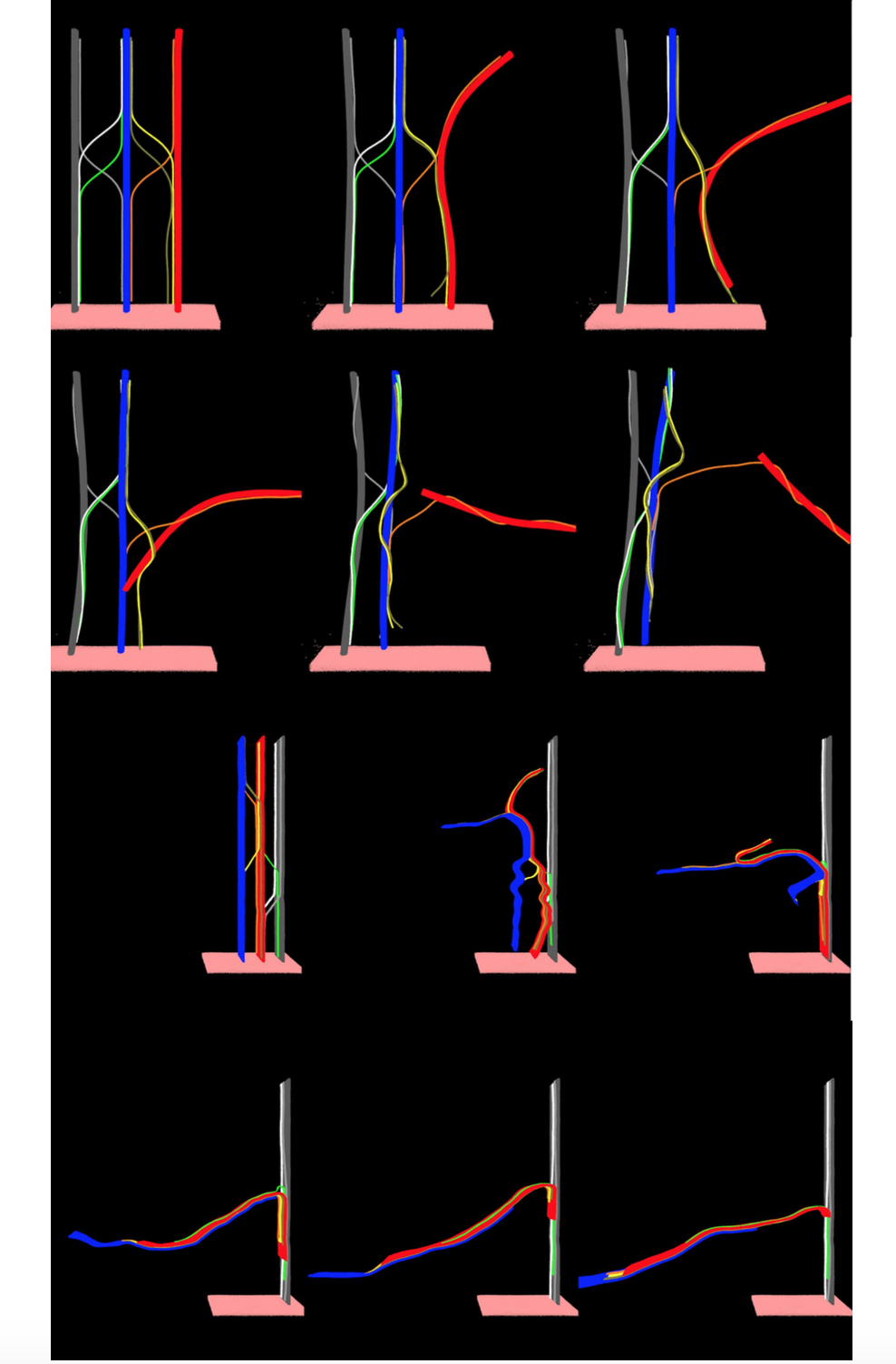
Machado, Leonardo D; Legoas, Sergio B; Galvao, Douglas S
Multi-Million Fully Atomistic Molecular Dynamics Simulations of Yarn Formation from Carbon Nanotube Forests Proceedings
Cambridge University Press, vol. 1407, 2012.
Resumo | Links | BibTeX | Tags: Carbon Nanotube Forests, Carbon Nanotubes, Molecular Dynamics, Yarns
@proceedings{machado2012multi,
title = {Multi-Million Fully Atomistic Molecular Dynamics Simulations of Yarn Formation from Carbon Nanotube Forests},
author = {Machado, Leonardo D and Legoas, Sergio B and Galvao, Douglas S},
url = {http://journals.cambridge.org/action/displayAbstract?fromPage=online&aid=8537115&fulltextType=RA&fileId=S1946427412007105},
year = {2012},
date = {2012-01-01},
journal = {MRS Proceedings},
volume = {1407},
pages = {mrsf11--1407},
publisher = {Cambridge University Press},
abstract = {In this work we present preliminary results from multi-million fully atomistic classical molecular dynamics simulations carried out to test different existing mechanisms that have been proposed in the literature to explain the drawing of yarns from carbon nanotube forests. Despite the fact that it has been almost ten years since yarns were first drawn, there are still controversies on the mechanisms and necessary conditions that can produce yarns and sheets drawn from carbon nanotube forests. Moreover, few works have tried to understand at atomistic level the details of yarn drawing mechanisms, and no fully atomistic simulations have been carried out so far on this particular subject. Our preliminary results suggest that only direct van der Waals interactions among large bundles seem not to be enough to explain the yarn drawing process. Bundle interconnectors (such as small bundles connecting large bundles) were observed to play a critical role in our simulations. Depending on the topology of these interconnectors it was possible to observe from the simulations fibers/yarn formation from proposed structural models. These models were built based on structural information inferred from scanning electron microscopy data.},
keywords = {Carbon Nanotube Forests, Carbon Nanotubes, Molecular Dynamics, Yarns},
pubstate = {published},
tppubtype = {proceedings}
}
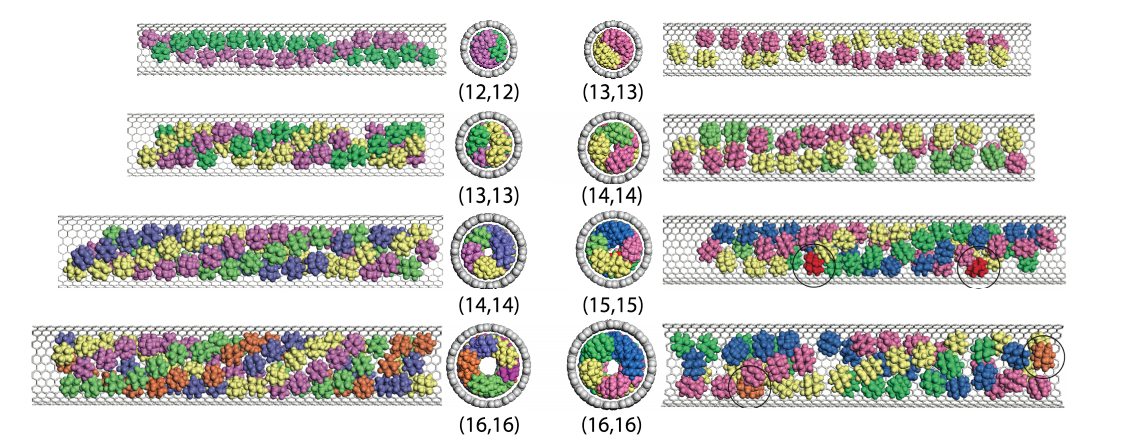
Legoas, SB; dos Santos, RPB; Troche, KS; Coluci, VR; Galvao, Douglas S
On the Existence of Ordered Phases of Encapsulated Diamondoids into Carbon Nanotubes Proceedings
Cambridge University Press, vol. 1407, 2012.
Resumo | Links | BibTeX | Tags: Carbon Nanotubes, Diamondoids, Encapsulation
@proceedings{legoas2012existence,
title = {On the Existence of Ordered Phases of Encapsulated Diamondoids into Carbon Nanotubes},
author = {Legoas, SB and dos Santos, RPB and Troche, KS and Coluci, VR and Galvao, Douglas S},
url = {http://journals.cambridge.org/action/displayAbstract?fromPage=online&aid=8539583&fileId=S194642741200704X},
year = {2012},
date = {2012-01-01},
journal = {MRS Proceedings},
volume = {1407},
pages = {mrsf11--1407},
publisher = {Cambridge University Press},
abstract = {We have investigated some diamondoids encapsulation into single walled carbon nanotubes (with diameters ranging from1.0 up to 2.2 nm) using fully atomistic molecular dynamics simulations. Diamondoids are the smallest hydrogen-terminated nanosized diamond-like molecules. Diamondois have been investigated for a large class of applications, ranging from oil industry to pharmaceuticals. Molecular ordered phases were observed for the encapsulation of adamantane, diamantane, and dihydroxy diamantanes. Chiral ordered phases, such as; double, triple, 4- and 5-stranded helices were also observed for those diamondoids. Our results also indicate that the modification of diamondoids through chemical functionalization with hydroxyl groups can lead to an enhancement of the molecular packing inside the carbon nanotubes in comparison to non-functionalized molecules. For larger diamondoids (such as, adamantane tetramers), we have not observed long-range ordering, but only a tendency of incomplete helical structural formation.},
keywords = {Carbon Nanotubes, Diamondoids, Encapsulation},
pubstate = {published},
tppubtype = {proceedings}
}
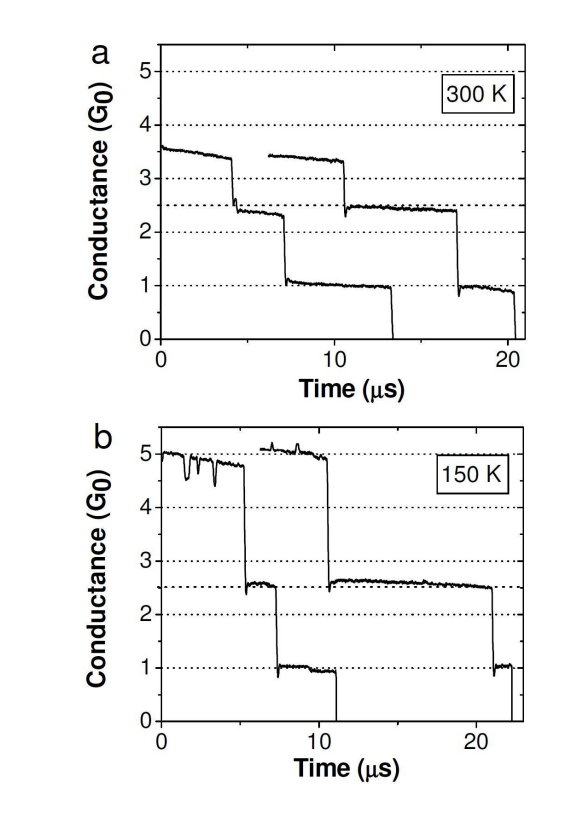
Lagos, MJ; Autreto, PAS; Galvao, DS; Ugarte, D
Correlation between Quantum Conductance and Atomic Arrangement of Silver Atomic-Size Nanowires Journal Article
Em: arXiv preprint arXiv:1206.2551, 2012, (Draft version of: Correlation between quantum conductance and atomic arrangement of atomic-size silver nanowires Journal of Applied Physics, 111 (12), pp. 124316, 2012.).
Resumo | Links | BibTeX | Tags: Metallic Nanowires, Quantum Transport, TEM
@article{lagos2012correlation,
title = {Correlation between Quantum Conductance and Atomic Arrangement of Silver Atomic-Size Nanowires},
author = {Lagos, MJ and Autreto, PAS and Galvao, DS and Ugarte, D},
url = {http://arxiv.org/abs/1206.2551},
year = {2012},
date = {2012-01-01},
journal = {arXiv preprint arXiv:1206.2551},
abstract = {We have studied the effect of thermal effects on the structural and transport response of Ag atomic-size nanowires generated by mechanical elongation. Our study involves both time-resolved atomic resolution transmission electron microscopy imaging and quantum conductance measurement using an ultra-high-vacuum mechanically controllable break junction. We have observed drastic changes in conductance and structural properties of Ag nanowires generated at different temperatures (150 and 300 K). By combining electron microscopy images, electronic transport measurements and quantum transport calculations, we have been able to obtain a consistent correlation between the conductance and structural properties of Ag NWs. In particular, our study has revealed the formation of metastable rectangular rod-like Ag wire (3/3) along the (001) crystallographic direction, whose formation is enhanced. These results illustrate the high complexity of analyzing structural and quantum conductance behaviour of metal atomic-size wires; also, they reveal that it is extremely difficult to compare NW conductance experiments performed at different temperatures due to the fundamental modifications of the mechanical behavior.},
note = {Draft version of:
Correlation between quantum conductance and atomic arrangement of atomic-size silver nanowires
Journal of Applied Physics, 111 (12), pp. 124316, 2012.},
keywords = {Metallic Nanowires, Quantum Transport, TEM},
pubstate = {published},
tppubtype = {article}
}
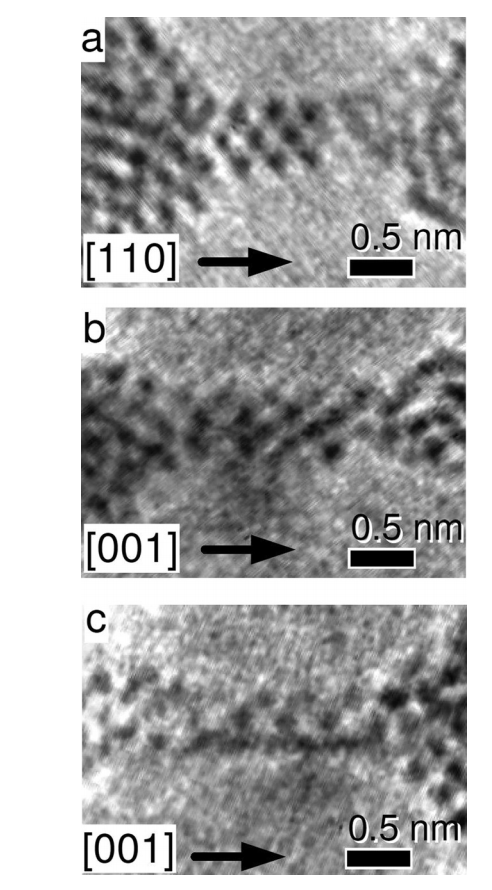
Lagos, MJ; Autreto, PAS; Galvao, DS; Ugarte, D
Correlation between quantum conductance and atomic arrangement of atomic-size silver nanowires Journal Article
Em: Journal of Applied Physics, vol. 111, não 12, pp. 124316, 2012.
Resumo | Links | BibTeX | Tags: Metallic Nanowires, Quantum Transport, TEM
@article{lagos2012correlationb,
title = {Correlation between quantum conductance and atomic arrangement of atomic-size silver nanowires},
author = {Lagos, MJ and Autreto, PAS and Galvao, DS and Ugarte, D},
url = {http://scitation.aip.org/content/aip/journal/jap/111/12/10.1063/1.4729805},
year = {2012},
date = {2012-01-01},
journal = {Journal of Applied Physics},
volume = {111},
number = {12},
pages = {124316},
publisher = {AIP Publishing},
abstract = {We have studied the effect of thermal effects on the structural and transport response of Ag atomic-size nanowires (NWs) generated by mechanical elongation. Our study involves both time-resolved atomic resolution transmission electron microscopy imaging and quantum conductance measurement using an ultra-high-vacuum mechanically controllable break junction. We have observed drastic changes in conductance and structuralproperties of Agnanowires generated at different temperatures (150 and 300 K). By combining electron microscopy images, electronic transport measurements, and quantum transport calculations, we have been able to obtain a consistent correlation between the conductance and structuralproperties of Ag NWs. In particular, our study has revealed the formation of metastable rectangular rod-like Agwire (3/3) along the [001] crystallographic direction, whose formation is enhanced. These results illustrate the high complexity of analyzing structural and quantum conductance behaviour of metal atomic-size wires; also, they reveal that it is extremely difficult to compare NW conductance experiments performed at different temperatures due to the fundamental modifications of the mechanical behavior.
},
keywords = {Metallic Nanowires, Quantum Transport, TEM},
pubstate = {published},
tppubtype = {article}
}
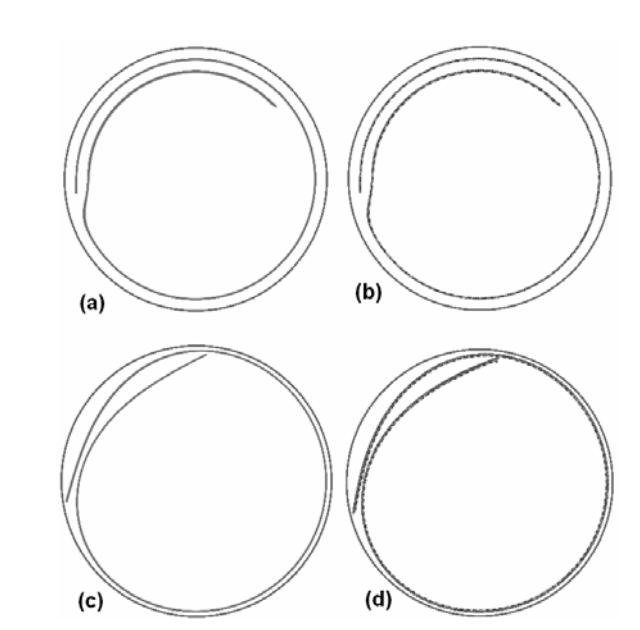
Perim, Eric; Fonseca, Alexandre F; Galvao, Douglas S
When Small is Different: The Case of Membranes Inside Tubes Proceedings
Cambridge University Press, vol. 1451, 2012.
Resumo | Links | BibTeX | Tags: Mechanical Properties, Membranes, Nanoscale Effects, Scrolls
@proceedings{perim2012small,
title = {When Small is Different: The Case of Membranes Inside Tubes},
author = {Perim, Eric and Fonseca, Alexandre F and Galvao, Douglas S},
url = {http://journals.cambridge.org/action/displayAbstract?fromPage=online&aid=8637821&fileId=S1946427412012523},
year = {2012},
date = {2012-01-01},
journal = {MRS Proceedings},
volume = {1451},
pages = {15--20},
publisher = {Cambridge University Press},
abstract = {Recently, classical elasticity theory for thin sheets was used to demonstrate the existence of a universal structural behavior describing the confinement of sheets inside cylindrical tubes. However, this kind of formalism was derived to describe macroscopic systems. A natural question is whether this behavior still holds at nanoscale. In this work, we have investigated through molecular dynamics simulations the structural behavior of graphene and boron nitride single layers confined into nanotubes. Our results show that the class of universality observed at macroscale is no longer observed at nanoscale. The origin of this discrepancy is addressed in terms of the relative importance of forces and energies at macro and nano scales.},
keywords = {Mechanical Properties, Membranes, Nanoscale Effects, Scrolls},
pubstate = {published},
tppubtype = {proceedings}
}
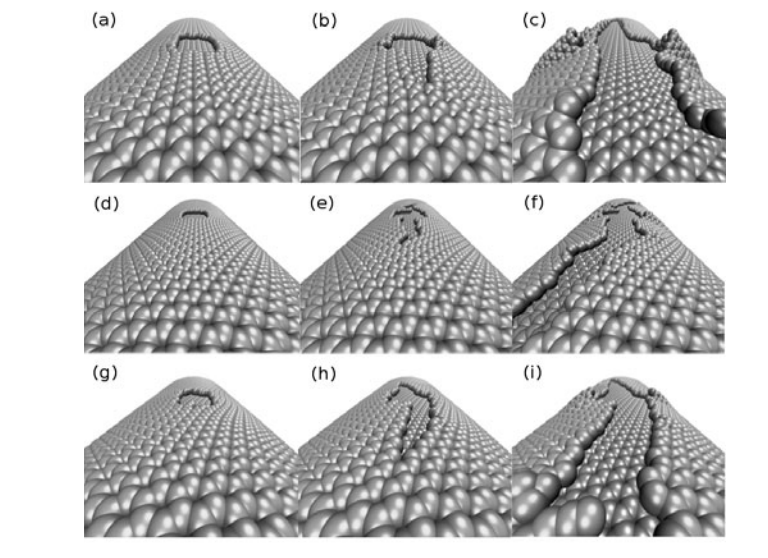
dos Santos, Ricardo P; Autreto, Pedro A; Perim, Eric; Brunetto, Gustavo; Galvao, Douglas S
On the Unzipping Mechanisms of Carbon Nanotubes: Insights from Reactive Molecular Dynamics Simulations Proceedings
Cambridge University Press, vol. 1451, 2012.
Resumo | Links | BibTeX | Tags: Carbon Nanotubes, Molecular Dynamics, Unzipping
@proceedings{dos2012unzipping,
title = {On the Unzipping Mechanisms of Carbon Nanotubes: Insights from Reactive Molecular Dynamics Simulations},
author = {dos Santos, Ricardo P and Autreto, Pedro A and Perim, Eric and Brunetto, Gustavo and Galvao, Douglas S},
url = {http://journals.cambridge.org/action/displayAbstract?fromPage=online&aid=8652294&fileId=S1946427412013292},
year = {2012},
date = {2012-01-01},
journal = {MRS Proceedings},
volume = {1451},
pages = {3--8},
publisher = {Cambridge University Press},
abstract = {Unzipping carbon nanotubes (CNTs) is considered one of the most promising approaches for the controlled and large-scale production of graphene nanoribbons (GNR). These structures are considered of great importance for the development of nanoelectronics because of its dimensions and intrinsic nonzero band gap value. Despite many years of investigations some details on the dynamics of the CNT fracture/unzipping processes remain unclear. In this work we have investigated some of these process through molecular dynamics simulations using reactive force fields (ReaxFF), as implemented in the Large-scale Atomic/Molecular Massively Parallel Simulator (LAMMPS) code. We considered multi-walled CNTs of different dimensions and chiralities and under induced mechanical stretching. Our preliminary results show that the unzipping mechanisms are highly dependent on CNT chirality. Well-defined and distinct fracture patterns were observed for the different chiralities. Armchair CNTs favor the creation of GNRs with well-defined armchair edges, while zigzag and chiral ones produce GNRs with less defined and defective edges.},
keywords = {Carbon Nanotubes, Molecular Dynamics, Unzipping},
pubstate = {published},
tppubtype = {proceedings}
}
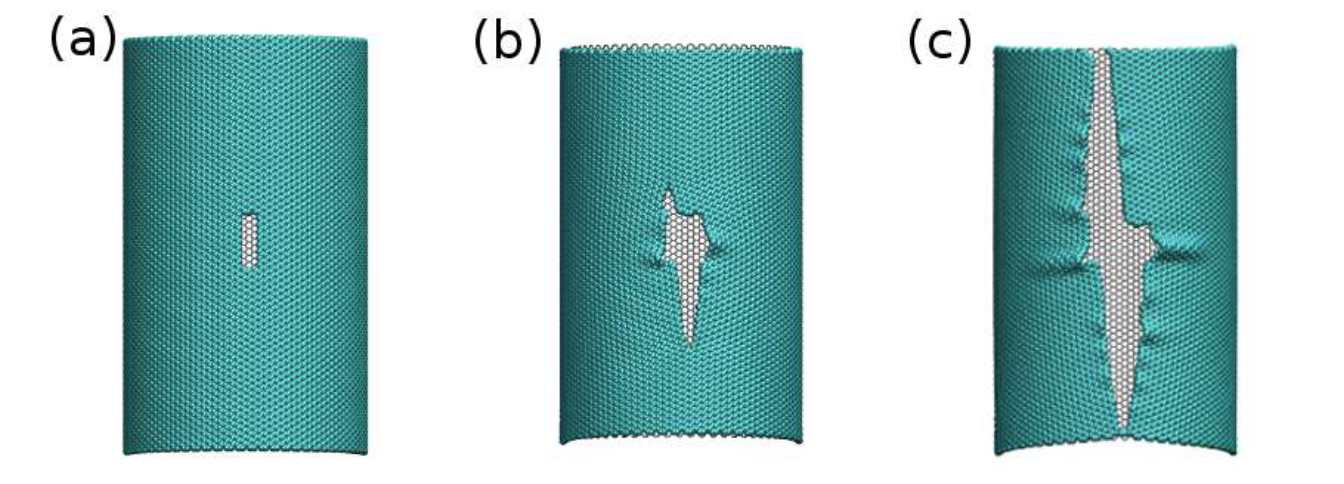
Dos Santos, RPB; Perim, E; Autreto, PAS; Brunetto, Gustavo; Galvao, DS
On the unzipping of multiwalled carbon nanotubes Journal Article
Em: Nanotechnology, vol. 23, não 46, pp. 465702, 2012.
Resumo | Links | BibTeX | Tags: Carbon Nanotubes, Fracture, Molecular Dynamics, Unzipping
@article{dos2012unzippingb,
title = {On the unzipping of multiwalled carbon nanotubes},
author = {Dos Santos, RPB and Perim, E and Autreto, PAS and Brunetto, Gustavo and Galvao, DS},
url = {http://iopscience.iop.org/0957-4484/23/46/465702},
year = {2012},
date = {2012-01-01},
journal = {Nanotechnology},
volume = {23},
number = {46},
pages = {465702},
publisher = {IOP Publishing},
abstract = {Graphene nanoribbons (GNRs) are very interesting structures which can retain graphene's high carrier mobility while presenting a finite bandgap. These properties make GNRs very valuable materials for the building of nanodevices. Unzipping carbon nanotubes (CNTs) is considered one of the most promising approaches for GNR controlled and large-scale production, although some of the details of the CNT unzipping processes are not completely known. In this work we have investigated CNT unzipping processes through fully atomistic molecular dynamics simulations using reactive force fields (ReaxFF). Multiwalled CNTs of different dimensions and chiralities under induced mechanical stretching were considered. Our results show that fracture patterns and stress profiles are highly CNT chirality dependent. Our results also show that the 'crests' (partially unzipped CNT regions presenting high curvature), originating from defective CNT areas, can act as a guide for the unzipping processes, which can explain the almost perfectly linear cuts frequently observed in unzipped CNTs.
},
keywords = {Carbon Nanotubes, Fracture, Molecular Dynamics, Unzipping},
pubstate = {published},
tppubtype = {article}
}

Lima, Marcio D; Li, Na; De Andrade, Monica Jung; Fang, Shaoli; Oh, Jiyoung; Spinks, Geoffrey M; Kozlov, Mikhail E; Haines, Carter S; Suh, Dongseok; Foroughi, Javad; Kim, Seon Jeong; Chen, Yongsheng; Ware, Taylor; Shin, Min Kyoon; Machado, Leonardo D; Fonseca, Alexandre F; Madden, John DW; Voit, Walter E; Galvao, Douglas S; Baughman, Ray H
Electrically, chemically, and photonically powered torsional and tensile actuation of hybrid carbon nanotube yarn muscles Journal Article
Em: Science, vol. 338, não 6109, pp. 928–932, 2012.
Resumo | Links | BibTeX | Tags: Actuation, Artificial Muscles, Carbon Nanotubes, top20, Yarns
@article{lima2012electrically,
title = {Electrically, chemically, and photonically powered torsional and tensile actuation of hybrid carbon nanotube yarn muscles},
author = {Lima, Marcio D and Li, Na and De Andrade, Monica Jung and Fang, Shaoli and Oh, Jiyoung and Spinks, Geoffrey M and Kozlov, Mikhail E and Haines, Carter S and Suh, Dongseok and Foroughi, Javad and Kim, Seon Jeong and Chen, Yongsheng and Ware, Taylor and Shin, Min Kyoon and Machado, Leonardo D and Fonseca, Alexandre F and Madden, John DW and Voit, Walter E and Galvao, Douglas S and Baughman, Ray H
},
url = {http://www.sciencemag.org/content/338/6109/928.short},
year = {2012},
date = {2012-01-01},
journal = {Science},
volume = {338},
number = {6109},
pages = {928--932},
publisher = {American Association for the Advancement of Science},
abstract = {Artificial muscles are of practical interest, but few types have been commercially exploited. Typical problems include slow response, low strain and force generation, short cycle life, use of electrolytes, and low energy efficiency. We have designed guest-filled, twist-spun carbon nanotube yarns as electrolyte-free muscles that provide fast, high-force, large-stroke torsional and tensile actuation. More than a million torsional and tensile actuation cycles are demonstrated, wherein a muscle spins a rotor at an average 11,500 revolutions/minute or delivers 3% tensile contraction at 1200 cycles/minute. Electrical, chemical, or photonic excitation of hybrid yarns changes guest dimensions and generates torsional rotation and contraction of the yarn host. Demonstrations include torsional motors, contractile muscles, and sensors that capture the energy of the sensing process to mechanically actuate.},
keywords = {Actuation, Artificial Muscles, Carbon Nanotubes, top20, Yarns},
pubstate = {published},
tppubtype = {article}
}
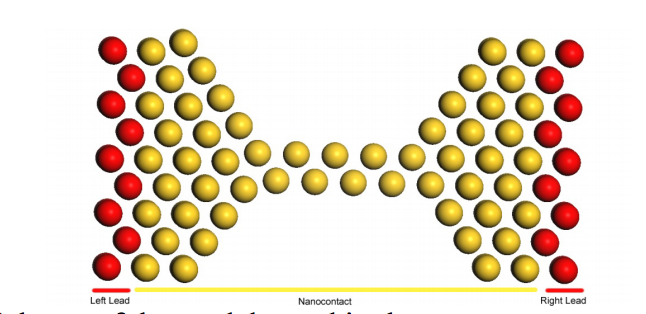
Autreto, Pedro A; Lagos, Maureen J; Ugarte, Daniel; Galvao, Douglas S
Correlation Between Quantum Conductance and Atomic Arrangement of Silver Atomic-Size Nanocontacts Proceedings
Cambridge University Press, vol. 1429, 2012.
Resumo | Links | BibTeX | Tags: Metallic Nanowires, Quantum Transport, TEM
@proceedings{autreto2012correlation,
title = {Correlation Between Quantum Conductance and Atomic Arrangement of Silver Atomic-Size Nanocontacts},
author = {Autreto, Pedro A and Lagos, Maureen J and Ugarte, Daniel and Galvao, Douglas S},
url = {http://journals.cambridge.org/action/displayAbstract?fromPage=online&aid=8717061&fileId=S1946427412015011},
year = {2012},
date = {2012-01-01},
journal = {MRS Proceedings},
volume = {1429},
pages = {mrss12--1429},
publisher = {Cambridge University Press},
abstract = {In this work we have studied the importance of thermal effects on the structural and transport properties of Ag atomic-size nanowires (NWs) generated by mechanical stretching. Our study involve time-resolved atomic high resolution transmission electron microscopy imaging and quantum conductance measurement using an ultra-high-vacuum mechanically controllable break junction combined with quantum transport calculations. We have observed drastic changes in conductance and structural properties of Ag NWs generated at different temperatures (150 and 300 K). By combining electron microscopy images, electronic transport measurements and theoretical modeling, we have been able to establish a consistent correlation between the conductance and structural properties of Ag NWs. In particular, our study has revealed the formation of metastable rectangular rod-like Ag wires along the [001] crystallographic direction.},
keywords = {Metallic Nanowires, Quantum Transport, TEM},
pubstate = {published},
tppubtype = {proceedings}
}
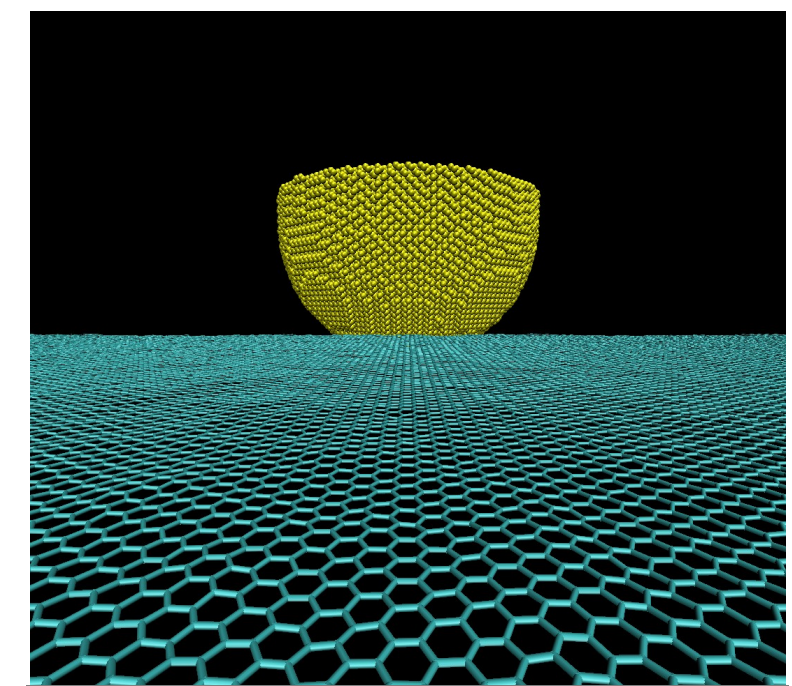
dos Santos, Ricardo P; Machado, Leonardo D; Legoas, Sergio B; Galvao, Douglas S
Tribological Properties of Graphene and Boron-Nitride Layers: A Fully Atomistic Molecular Dynamics Study Proceedings
Cambridge University Press, vol. 1407, 2012.
Resumo | Links | BibTeX | Tags: Boron Nitride, Graphene, Molecular Dynamics, Tribology
@proceedings{dos2012tribological,
title = {Tribological Properties of Graphene and Boron-Nitride Layers: A Fully Atomistic Molecular Dynamics Study},
author = {dos Santos, Ricardo P and Machado, Leonardo D and Legoas, Sergio B and Galvao, Douglas S},
url = {http://journals.cambridge.org/action/displayAbstract?fromPage=online&aid=8537106&fileId=S1946427412007063},
year = {2012},
date = {2012-01-01},
journal = {MRS Proceedings},
volume = {1407},
pages = {mrsf11--1407},
publisher = {Cambridge University Press},
abstract = {Graphene has been one of the most important subjects in materials science in the last years. Recently, the frictional characteristics of atomically thin sheets were experimentally investigated using atomic force microscopy (AFM). A new mechanism to explain the enhanced friction for these materials, based on elastic compliance has been proposed. Here, we have investigated the tribological properties of graphene and boron-nitride (single and multi-layers) membranes using fully atomistic molecular dynamics simulations. These simulations were carried out using classical force fields, as implemented in the Large-scale Atomic/Molecular Massively Parallel Simulator (LAMMPS) code. The used structural models contain typically hundreds of thousands of atoms. In order to mimic the experimental conditions, an artificial AFM tip was moved over the membranes and the tribological characteristics determined in terms of forces and energies. Our results are in good agreement with the available experimental data. They show that the observed enhanced tribological properties can be explained in terms of out-of-plane geometrical distortions and elastic waves propagation. They validate the general features of the model proposed by Lee et al. (Science 328, 76 (2010).},
keywords = {Boron Nitride, Graphene, Molecular Dynamics, Tribology},
pubstate = {published},
tppubtype = {proceedings}
}
2011
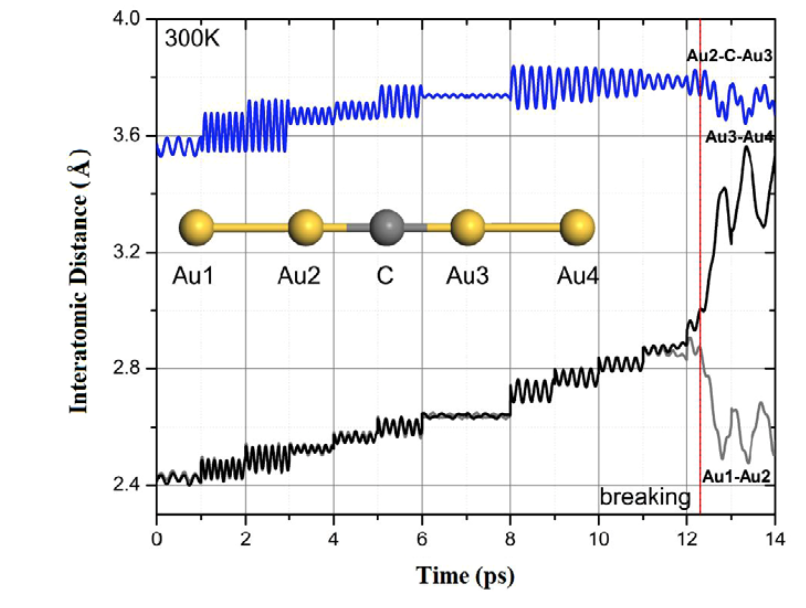
PAS Autreto MJ Lagos, SB Legoas
Temperature effects on the occurrence of long interatomic distances in atomic chains formed from stretched gold nanowires Journal Article
Em: Nanotechnology, vol. 22, não 9, pp. 095705, 2011.
Resumo | Links | BibTeX | Tags: DFT, Gold, Metallic Nanowires, TEM
@article{Lagos2011,
title = {Temperature effects on the occurrence of long interatomic distances in atomic chains formed from stretched gold nanowires},
author = {MJ Lagos, PAS Autreto, SB Legoas, F Sato, V Rodrigues, DS Galvao, D Ugarte},
url = {http://iopscience.iop.org/0957-4484/22/9/095705},
year = {2011},
date = {2011-03-04},
journal = {Nanotechnology},
volume = {22},
number = {9},
pages = {095705},
abstract = {The origin of long interatomic distances in suspended gold atomic chains formed from stretched nanowires remains the object of debate despite the large amount of theoretical and experimental work. Here, we report new atomic resolution electron microscopy observations acquired at room and liquid-nitrogen temperatures and theoretical results from ab initio quantum molecular dynamics on chain formation and stability. These new data are suggestive that the long distances are due to contamination by carbon atoms originating from the decomposition of adsorbed hydrocarbon molecules.
},
keywords = {DFT, Gold, Metallic Nanowires, TEM},
pubstate = {published},
tppubtype = {article}
}
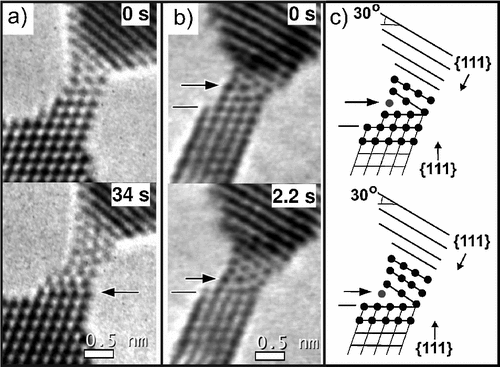
Lagos, Maureen J; Sato, Fernando; Galvao, Douglas S; Ugarte, Daniel
Mechanical deformation of nanoscale metal rods: when size and shape matter Journal Article
Em: Physical Review Letters, vol. 106, não 5, pp. 055501, 2011.
Resumo | Links | BibTeX | Tags: Defects, DFT, Mechanical Properties, Metallic Nanowires
@article{lagos2011mechanical,
title = {Mechanical deformation of nanoscale metal rods: when size and shape matter},
author = {Lagos, Maureen J and Sato, Fernando and Galvao, Douglas S and Ugarte, Daniel},
url = {http://journals.aps.org/prl/abstract/10.1103/PhysRevLett.106.055501},
year = {2011},
date = {2011-01-01},
journal = {Physical Review Letters},
volume = {106},
number = {5},
pages = {055501},
publisher = {American Physical Society},
abstract = {Face centered cubic metals deform mainly by propagating partial dislocations generating planar fault ribbons. How do metals deform if the size is smaller than the fault ribbons? We studied the elongation of Au and Pt nanorods by in situ electron microscopy and ab initio calculations. Planar fault activation barriers are so low that, for each temperature, a minimal rod size is required to become active for releasing elastic energy. Surface effects dominate deformation energetics; system size and shape determine the preferred fault gliding directions which induce different tensile and compressive behavior.
},
keywords = {Defects, DFT, Mechanical Properties, Metallic Nanowires},
pubstate = {published},
tppubtype = {article}
}
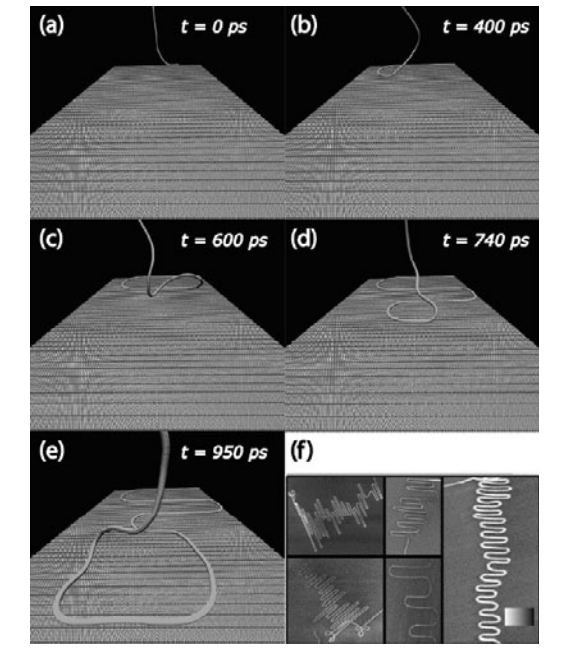
Machado, Leonardo D; Legoas, Sergio B; Soares, Jaqueline S; Shadmi, Nitzan; Jorio, Ado; Joselevich, Ernesto; Galvao, Douglas S
Cambridge University Press, vol. 1284, 2011.
Resumo | Links | BibTeX | Tags: Mechanical Properties, Molecular Dynamics, Serpentines
@proceedings{machado2011formation,
title = {On the formation of carbon nanotube serpentines: insights from multi-million atom molecular dynamics simulation},
author = {Machado, Leonardo D and Legoas, Sergio B and Soares, Jaqueline S and Shadmi, Nitzan and Jorio, Ado and Joselevich, Ernesto and Galvao, Douglas S},
url = {http://journals.cambridge.org/action/displayAbstract?fromPage=online&aid=8194288&fileId=S194642741100220X},
year = {2011},
date = {2011-01-01},
journal = {MRS Proceedings},
volume = {1284},
pages = {mrsf10--1284},
publisher = {Cambridge University Press},
abstract = {In this work we present preliminary results from molecular dynamics simulations for carbon nanotubes serpentine dynamics formation. These S-like nanostructures consist of a series of parallel and straight nanotube segments connected by alternating U-turn shaped curves. Nanotube serpentines were experimentally synthesized and reported in recent years, but up to now no atomistic simulations have been carried out to address the dynamics of formation of these structures. We have carried out fully atomistic molecular dynamics simulations in the framework of classical mechanics with a standard molecular force field. Multi-million atoms structures formed by stepped substrates with a carbon nanotube (about 1 micron in length) placed on top of them have been considered in our simulations. A force is applied to the upper part of the tube during a short period of time and then turned off and the system set free to evolve in time. Our results showed that these conditions are sufficient to form robust serpentines and validate the general features of the ‘falling spaghetti mechanism’ previously proposed to explain their formation.},
keywords = {Mechanical Properties, Molecular Dynamics, Serpentines},
pubstate = {published},
tppubtype = {proceedings}
}

Autreto, PAS; Lagos, MJ; Sato, F; Bettini, J; Rocha, AR; Rodrigues, V; Ugarte, D; Galvao, DS
Intrinsic Stability of the Smallest Possible Silver Nanotube Journal Article
Em: Physical Review Letters, vol. 106, não 6, pp. 065501, 2011.
Resumo | Links | BibTeX | Tags: DFT, Mechanical Properties, Metallic Nanowires, New Structures, top20
@article{autreto2011intrinsic,
title = {Intrinsic Stability of the Smallest Possible Silver Nanotube},
author = {Autreto, PAS and Lagos, MJ and Sato, F and Bettini, J and Rocha, AR and Rodrigues, V and Ugarte, D and Galvao, DS},
url = {http://journals.aps.org/prl/abstract/10.1103/PhysRevLett.106.065501},
year = {2011},
date = {2011-01-01},
journal = {Physical Review Letters},
volume = {106},
number = {6},
pages = {065501},
publisher = {American Physical Society},
abstract = {Recently, Lagos et al. [Nature Nanotech. 4, 149 (2009)] reported the discovery of the smallest possible Ag nanotube with a square cross section. Ab initio density functional theory calculations strongly support that the stability of these hollow structures is structurally intrinsic and not the result of contamination by light atoms. We also report the first experimental observation of the theoretically predicted corrugation of the hollow structure. Quantum conductance calculations predict a unique signature of 3.6G0 for this new family of nanotubes.},
keywords = {DFT, Mechanical Properties, Metallic Nanowires, New Structures, top20},
pubstate = {published},
tppubtype = {article}
}
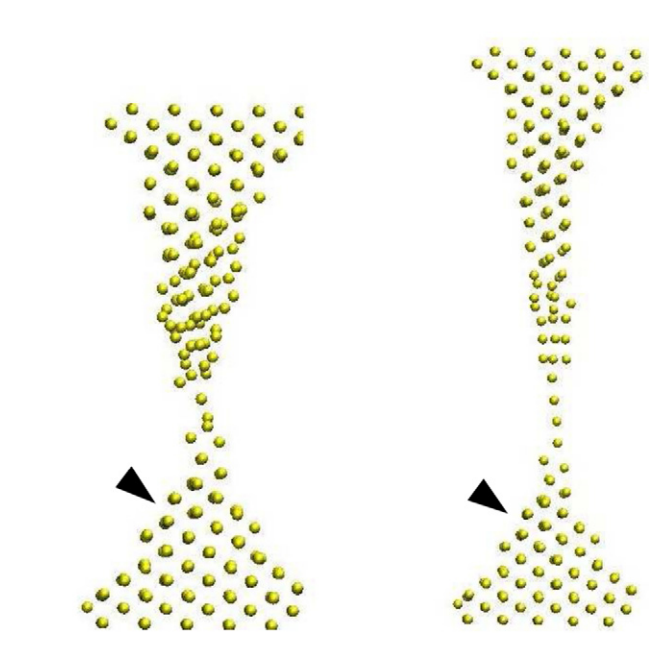
Lagos, MJ; Autreto, PAS; Legoas, SB; Sato, F; Rodrigues, V; Galvao, DS; Ugarte, D
Temperature effects on the occurrence of long interatomic distances in atomic chains formed from stretched gold nanowires Journal Article
Em: Nanotechnology, vol. 22, não 9, pp. 095705, 2011.
Resumo | Links | BibTeX | Tags: Gold, Mechanical Properties, Metallic Nanowires
@article{lagos2011temperature,
title = {Temperature effects on the occurrence of long interatomic distances in atomic chains formed from stretched gold nanowires},
author = {Lagos, MJ and Autreto, PAS and Legoas, SB and Sato, F and Rodrigues, V and Galvao, DS and Ugarte, D},
url = {http://iopscience.iop.org/0957-4484/21/48/485702},
year = {2011},
date = {2011-01-01},
journal = {Nanotechnology},
volume = {22},
number = {9},
pages = {095705},
publisher = {IOP Publishing},
abstract = {We have studied the changes induced by thermal effects in the structural and transport response of Au nanowires generated by mechanical elongation. We have used time-resolved atomic resolution transmission electron microscopy imaging and quantum conductance measurement using a mechanically controllable break junction. Our results showed remarkable differences in the NW evolution for experiments realized at 150 and 300 K, which modifies drastically the conductance response during elongation. Molecular dynamics and electronic transport calculations were used to consistently correlate the observed structural and conductance behavior. These results emphasize that it is essential to take into account the precise atomic arrangement of nanocontacts generated by mechanical stretching to understand electrical transport properties. Also, our study shows that much care must be taken when comparing results obtained in different experimental conditions, mainly different temperatures.
},
keywords = {Gold, Mechanical Properties, Metallic Nanowires},
pubstate = {published},
tppubtype = {article}
}
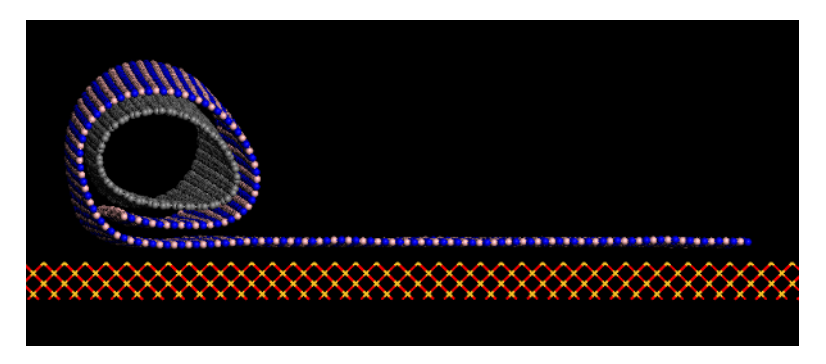
Perim, Eric; Galvao, Douglas S
Stability and Dynamics of Boron Nitride Nanoscrolls Proceedings
Cambridge University Press, vol. 1307, 2011.
Resumo | Links | BibTeX | Tags: Boron Nitride, Molecular Dynamics, Scrolls
@proceedings{perim2011stability,
title = {Stability and Dynamics of Boron Nitride Nanoscrolls},
author = {Perim, Eric and Galvao, Douglas S},
url = {http://journals.cambridge.org/action/displayFulltext?type=1&fid=8200678&jid=OPL&volumeId=1307&issueId=-1&aid=8200676},
year = {2011},
date = {2011-01-01},
journal = {MRS Proceedings},
volume = {1307},
pages = {mrsf10--1307},
publisher = {Cambridge University Press},
abstract = {We report here molecular dynamics results for boron nitride nanoscroll structures
(BNNSs) with relation to their stability and formation mechanisms. We show that, similarly to
carbon nanoscrolls, BNNSs are stable due to van der Waals interactions among overlapping
layers. The energy balance between losses and gains (due to elastic deformations and van der
Waals interactions, respectively) when the structure is rolled up leads to the existence of a
critical value of the internal scroll diameter where stable or metastable structures can be formed.
The mechanisms of scroll formation and stability as a function of their chirality were also
investigated.},
keywords = {Boron Nitride, Molecular Dynamics, Scrolls},
pubstate = {published},
tppubtype = {proceedings}
}
(BNNSs) with relation to their stability and formation mechanisms. We show that, similarly to
carbon nanoscrolls, BNNSs are stable due to van der Waals interactions among overlapping
layers. The energy balance between losses and gains (due to elastic deformations and van der
Waals interactions, respectively) when the structure is rolled up leads to the existence of a
critical value of the internal scroll diameter where stable or metastable structures can be formed.
The mechanisms of scroll formation and stability as a function of their chirality were also
investigated.
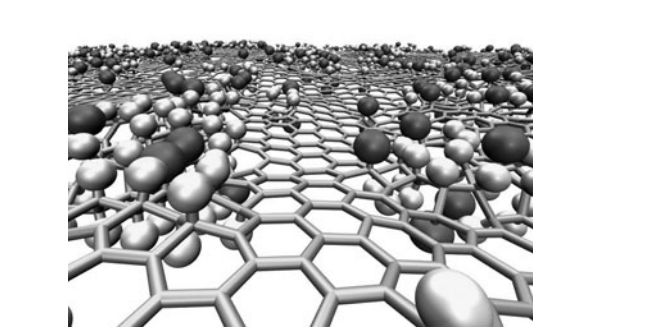
Autreto, Pedro AS; Flores, Marcelo Z; Legoas, Sergio B; Santos, Ricardo PB; Galvao, Douglas S
Cambridge University Press, vol. 1284, 2011.
Resumo | Links | BibTeX | Tags: Graphane, Graphene, Hydrogenation, Molecular Dynamics
@proceedings{autreto2011fully,
title = {A Fully Atomistic Reactive Molecular Dynamics Study on the Formation of Graphane from Graphene Hydrogenated Membranes.},
author = {Autreto, Pedro AS and Flores, Marcelo Z and Legoas, Sergio B and Santos, Ricardo PB and Galvao, Douglas S},
url = {http://journals.cambridge.org/action/displayAbstract?fromPage=online&aid=8364784&fileId=S1946427411013583},
year = {2011},
date = {2011-01-01},
journal = {MRS Proceedings},
volume = {1284},
pages = {mrsf10--1284},
publisher = {Cambridge University Press},
abstract = {Using fully reactive molecular dynamics methodologies we investigated the structural and dynamical aspects of the fluorination mechanism leading to fluorographene formation from graphene membranes. Fluorination tends to produce significant defective areas on the membranes with variation on the typical carbon-carbon distances, sometimes with the presence of large holes due to carbon losses. The results obtained in our simulations are in good agreement with the broad distribution of values for the lattice parameter experimentally observed. We have also investigated mixed atmospheres composed by H and F atoms. When H is present in small quantities an expressive reduction on the rate of incorporation of fluorine was observed. On the other hand when fluorine atoms are present in small quantities in a hydrogen atmosphere, they induce an increasing on the hydrogen incorporation and the formation of locally self-organized structure of adsorbed H and F atoms.},
keywords = {Graphane, Graphene, Hydrogenation, Molecular Dynamics},
pubstate = {published},
tppubtype = {proceedings}
}
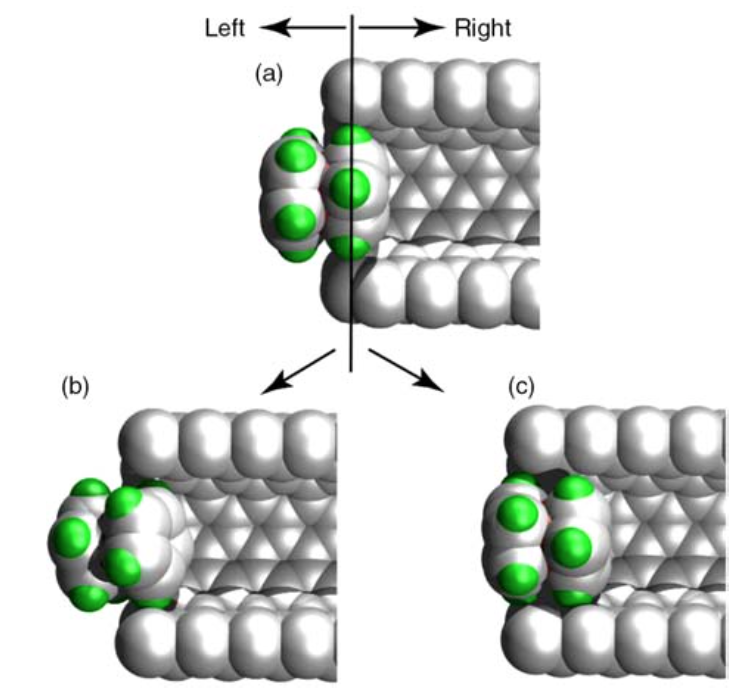
Azevedo, David L; Sato, Fernando; Gomes de Sousa Filho, Antonio; Galvao, Douglas S
Em: Molecular Simulation, vol. 37, não 9, pp. 746–751, 2011.
Resumo | Links | BibTeX | Tags: CNT encapsulation, Cobaltocene, Molecular Dynamics
@article{azevedo2011van,
title = {van der Waals potential barrier for cobaltocene encapsulation into single-walled carbon nanotubes: classical molecular dynamics and ab initio study},
author = {Azevedo, David L and Sato, Fernando and Gomes de Sousa Filho, Antonio and Galvao, Douglas S},
url = {http://www.tandfonline.com/doi/abs/10.1080/08927022.2010.537093#.VLfBForF-2o},
year = {2011},
date = {2011-01-01},
journal = {Molecular Simulation},
volume = {37},
number = {9},
pages = {746--751},
publisher = {Taylor & Francis Group},
abstract = {In this work, we carried out geometry optimisations and classical molecular dynamics for the problem of cobaltocene (CC) encapsulation into different carbon nanotubes (CNTs) ((7,7), (8,8), (13,0) and (14,0) tubes were used). CCs are molecules composed of two aromatic pentagonal rings (C5H5) sandwiching one cobalt atom. From our simulation results, we observed that CC was encapsulated into CNTs (8,8), (13,0) and (14,0). However, for CNT (7,7), the encapsulation could not occur, in disaggrement with some previous works in the literature. Our results show that the encapsulation process is mainly governed by van der Waals potential barriers.},
keywords = {CNT encapsulation, Cobaltocene, Molecular Dynamics},
pubstate = {published},
tppubtype = {article}
}
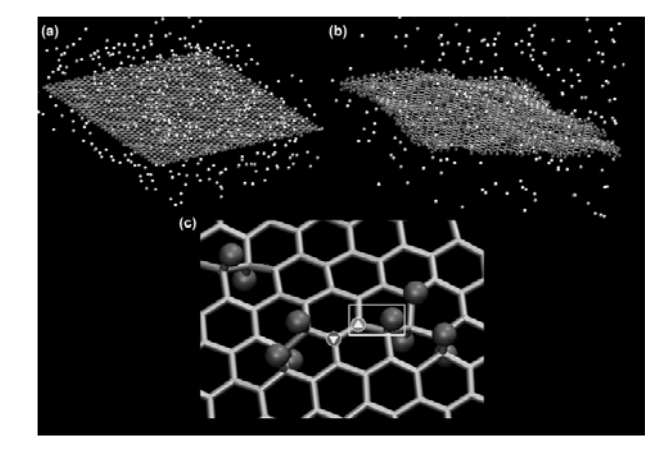
Santos, Ricardo PB; Autreto, Pedro AS; Legoas, Sergio B; Galvao, Douglas S
Cambridge University Press, vol. 1344, 2011.
Resumo | Links | BibTeX | Tags: Fluorographene, Functionalization, Graphane, Graphene
@proceedings{santos2011dynamics,
title = {The Dynamics of Formation of Graphane-like Fluorinated Graphene Membranes (Fluorographene): A Reactive Molecular Dynamics Study},
author = {Santos, Ricardo PB and Autreto, Pedro AS and Legoas, Sergio B and Galvao, Douglas S},
url = {http://journals.cambridge.org/action/displayFulltext?type=1&fid=8237871&jid=OPL&volumeId=1284&issueId=-1&aid=8237869},
year = {2011},
date = {2011-01-01},
journal = {MRS Proceedings},
volume = {1344},
pages = {mrss11--1344},
publisher = {Cambridge University Press},
abstract = {Recently, Elias et al. (Science 323, 610 (2009).) reported the experimental realization of
the formation of graphane from hydrogenation of graphene membranes under cold plasma
exposure. In graphane, the carbon-carbon bonds are in sp3
configuration, as opposed to the sp2
hybridization of graphene, and the C–H bonds exhibit an alternating pattern (up and down with
relation to the plane defined by the carbon atoms). In this work we have investigated, using
reactive molecular dynamics simulations, the role of H frustration (breaking the H atoms up and
down alternating pattern) in graphane-like structures. Our results show that a significant
percentage of uncorrelated H frustrated domains are formed in the early stages of the
hydrogenation process, leading to membrane shrinkage and extensive membrane corrugations.
This might explain the significant broad distribution of values of lattice parameter
experimentally observed. For comparison purposes we have also analyzed fluorinated graphanelike
structures. Our results show that similarly to H, F atoms also create significant uncorrelated
frustrated domains on graphene membranes. },
keywords = {Fluorographene, Functionalization, Graphane, Graphene},
pubstate = {published},
tppubtype = {proceedings}
}
the formation of graphane from hydrogenation of graphene membranes under cold plasma
exposure. In graphane, the carbon-carbon bonds are in sp3
configuration, as opposed to the sp2
hybridization of graphene, and the C–H bonds exhibit an alternating pattern (up and down with
relation to the plane defined by the carbon atoms). In this work we have investigated, using
reactive molecular dynamics simulations, the role of H frustration (breaking the H atoms up and
down alternating pattern) in graphane-like structures. Our results show that a significant
percentage of uncorrelated H frustrated domains are formed in the early stages of the
hydrogenation process, leading to membrane shrinkage and extensive membrane corrugations.
This might explain the significant broad distribution of values of lattice parameter
experimentally observed. For comparison purposes we have also analyzed fluorinated graphanelike
structures. Our results show that similarly to H, F atoms also create significant uncorrelated
frustrated domains on graphene membranes.
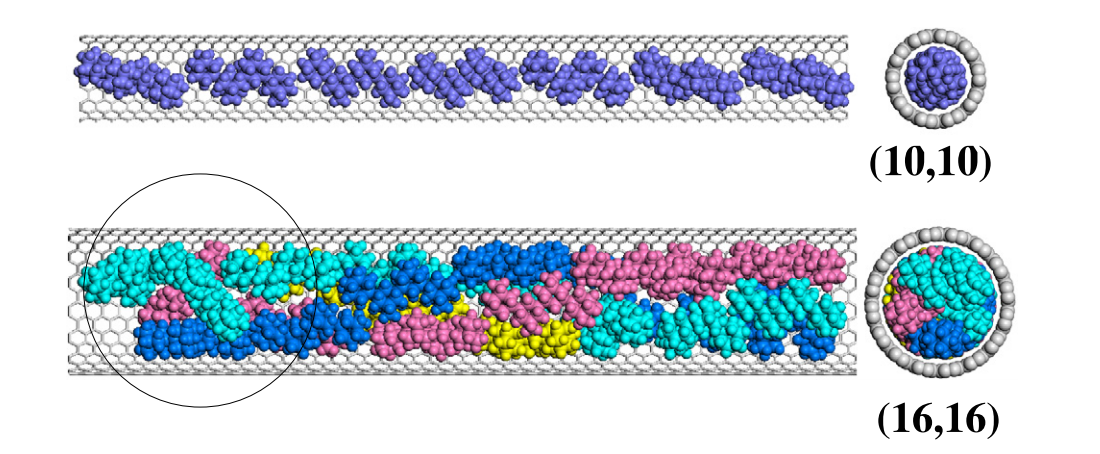
Legoas, SB; Dos Santos, RPB; Troche, KS; Coluci, VR; Galvao, DS
Ordered phases of encapsulated diamondoids into carbon nanotubes Journal Article
Em: Nanotechnology, vol. 22, não 31, pp. 315708, 2011.
Resumo | Links | BibTeX | Tags: CNT encapsulation, Diamondoids, Molecular Dynamics
@article{legoas2011ordered,
title = {Ordered phases of encapsulated diamondoids into carbon nanotubes},
author = {Legoas, SB and Dos Santos, RPB and Troche, KS and Coluci, VR and Galvao, DS},
url = {http://iopscience.iop.org/0957-4484/22/31/315708},
year = {2011},
date = {2011-01-01},
journal = {Nanotechnology},
volume = {22},
number = {31},
pages = {315708},
publisher = {IOP Publishing},
abstract = {Diamondoids are hydrogen-terminated nanosized diamond fragments that are present in petroleum crude oil at low concentrations. These fragments are found as oligomers of the smallest diamondoid, adamantane (C10H16). Due to their small size, diamondoids can be encapsulated into carbon nanotubes to form linear arrangements. We have investigated the encapsulation of diamondoids into single walled carbon nanotubes with diameters between 1.0 and 2.2 nm using fully atomistic simulations. We performed classical molecular dynamics and energy minimizations calculations to determine the most stable configurations. We observed molecular ordered phases (e.g. double, triple, 4- and 5-stranded helices) for the encapsulation of adamantane, diamantane, and dihydroxy diamantane. Our results also indicate that the functionalization of diamantane with hydroxyl groups can lead to an improvement on the molecular packing factor when compared to non-functionalized compounds. Comparisons to hard-sphere models revealed differences, especially when more asymmetrical diamondoids were considered. For larger diamondoids (i.e., adamantane tetramers), we have not observed long-range ordering but only a tendency to form incomplete helical structures. Our calculations predict that thermally stable (at least up to room temperature) complex ordered phases of diamondoids can be formed through encapsulation into carbon nanotubes.},
keywords = {CNT encapsulation, Diamondoids, Molecular Dynamics},
pubstate = {published},
tppubtype = {article}
}
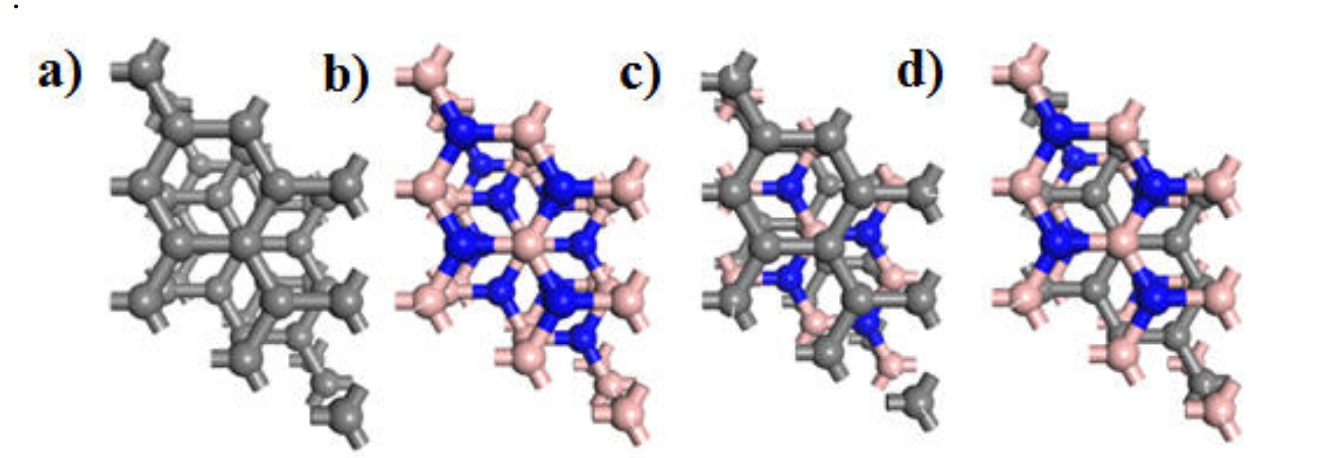
Coutinho, Samir S; Azevedo, David L; Galvao, Douglas S
Tuning Electronic and Structural Properties of Triple Layers of Intercalated Graphene and Hexagonal Boron Nitride: An Ab-initio Study. Journal Article
Em: MRS Proceedings, vol. 1307, pp. mrsf10–1307, 2011.
Resumo | Links | BibTeX | Tags: BN, DFT, Graphene, Heterostructures
@article{coutinho2011tuning,
title = {Tuning Electronic and Structural Properties of Triple Layers of Intercalated Graphene and Hexagonal Boron Nitride: An Ab-initio Study.},
author = {Coutinho, Samir S and Azevedo, David L and Galvao, Douglas S},
url = {http://journals.cambridge.org/action/displayAbstract?fromPage=online&aid=8330317&fileId=S1946427411003642},
year = {2011},
date = {2011-01-01},
journal = {MRS Proceedings},
volume = {1307},
pages = {mrsf10--1307},
publisher = {Cambridge University Press},
abstract = {Recently, several experiments and theoretical studies demonstrated the possibility of tuning or modulating band gap values of nanostructures composed of bi-layer graphene, bi-layer hexagonal boron-nitride (BN) and hetero-layer combinations. These triple layers systems present several possibilities of stacking. In this work we report an ab initio (within the formalism of density functional theory (DFT)) study of structural and electronic properties of some of these stacked configurations. We observe that an applied external electric field can alter the electronic and structural properties of these systems. With the same value of the applied electric field the band gap values can be increased or decreased, depending on the layer stacking sequences. Strong geometrical deformations were observed. These results show that the application of an external electric field perpendicular to the stacked layers can effectively be used to modulate their inter-layer distances and/or their band gap values.},
keywords = {BN, DFT, Graphene, Heterostructures},
pubstate = {published},
tppubtype = {article}
}
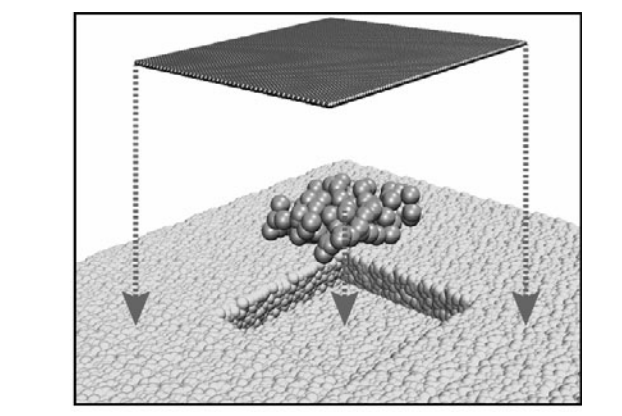
Brunetto, Gustavo; Legoas, Sergio B; Coluci, Vitor R; Lucena, Liacir S; Galvao, Douglas S
Dynamics of Graphene Nanodrums Proceedings
Cambridge University Press, vol. 1284, 2011.
Resumo | Links | BibTeX | Tags: Graphene Membranes, Mechanical Properties, Nanodrum
@proceedings{brunetto2011dynamics,
title = {Dynamics of Graphene Nanodrums},
author = {Brunetto, Gustavo and Legoas, Sergio B and Coluci, Vitor R and Lucena, Liacir S and Galvao, Douglas S},
url = {http://journals.cambridge.org/action/displayAbstract?fromPage=online&aid=8195889&fileId=S1946427411002272},
year = {2011},
date = {2011-01-01},
journal = {MRS Proceedings},
volume = {1284},
pages = {mrsf10--1284},
publisher = {Cambridge University Press},
abstract = {Recently, it was proposed that graphene sheets deposited on silicon oxide can act as impermeable atomic membranes to standard gases, such as helium, argon, and nitrogen. It is assumed that graphene membrane is clamped over the surface due only to van der Waals forces. The leakage mechanism can be experimentally addressed only indirectly. In this work we have carried out molecular dynamics simulations to study this problem. We have considered nano-containers composed of a chamber of silicon oxide filled with gas and sealed by single and multi-layer graphene membranes. The obtained results are in good qualitative agreement with the experimental data. We observed that the graphene membranes remain attached to the substrate for pressure values up to two times the largest value experimentally investigated. We did not observe any gas leakage through the membrane/substrate interface until the critical limit is reached and then a sudden membrane detachment occurs.},
keywords = {Graphene Membranes, Mechanical Properties, Nanodrum},
pubstate = {published},
tppubtype = {proceedings}
}

Vasconcelos, MS; Azevedo, David L; Hadad, A; Galvao, DS
Electronic properties of Fibonacci and random Si--Ge chains Journal Article
Em: Journal of Physics: Condensed Matter, vol. 23, não 40, pp. 405501, 2011.
Resumo | Links | BibTeX | Tags: Electronic Structure, Fibonacci, Si-Ge chains
@article{vasconcelos2011electronic,
title = {Electronic properties of Fibonacci and random Si--Ge chains},
author = {Vasconcelos, MS and Azevedo, David L and Hadad, A and Galvao, DS},
url = {http://iopscience.iop.org/0953-8984/23/40/405501},
year = {2011},
date = {2011-01-01},
journal = {Journal of Physics: Condensed Matter},
volume = {23},
number = {40},
pages = {405501},
publisher = {IOP Publishing},
abstract = {In this paper we address a theoretical calculation of the electronic spectra of an Si–Ge atomic chain that is arranged in a Fibonacci quasi-periodic sequence, by using a semi-empirical quantum method based on the Hückel extended model. We apply the Fibonacci substitutional sequences in the atomic building blocks A(Si) and B(Ge) through the inflation rule or a recursion relation. In our ab initio calculations we use only a single point, which is sufficient for considering all the orbitals and charge distribution across the entire system. Although the calculations presented here are more complete than the models adopted in the literature which take into account the electronic interaction only up to the second and third neighbors, an interesting property remains in their electronic spectra: the fractality (which is the main signature of this kind of system). We discuss this fractality of the spectra and we compare them with the random arrangement of the Si–Ge atomic chain, and with previous results based on the tight-binding approximation of the Schrödinger equation considering up to the nearest neighbor.
},
keywords = {Electronic Structure, Fibonacci, Si-Ge chains},
pubstate = {published},
tppubtype = {article}
}
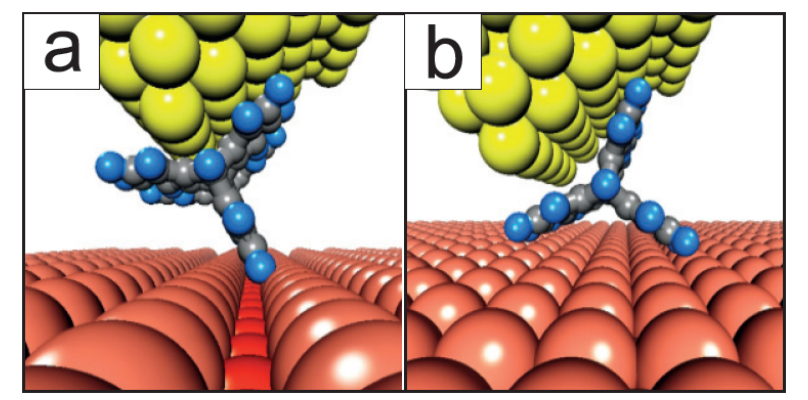
Brunetto, Gustavo; Sato, Fernando; Bouju, Xavier; Galvao, Douglas S
The First Molecular Wheel: A Theoretical Investigation Proceedings
Cambridge University Press, vol. 1286, 2011.
Resumo | Links | BibTeX | Tags: Molecular Dynamics, Molecular Electronics, Nanowheel
@proceedings{brunetto2011first,
title = {The First Molecular Wheel: A Theoretical Investigation},
author = {Brunetto, Gustavo and Sato, Fernando and Bouju, Xavier and Galvao, Douglas S},
url = {http://journals.cambridge.org/action/displayAbstract?fromPage=online&aid=7975705&fileId=S1946427411000133},
year = {2011},
date = {2011-01-01},
journal = {MRS Proceedings},
volume = {1286},
pages = {mrsf10--1286},
publisher = {Cambridge University Press},
abstract = {Recently, the first molecular nanowheel was synthesized and characterized from Scanning Tunneling Microscope (STM) experiments. It was demonstrated that a specifically designed hydrocarbon molecule (C44H24) could roll on a copper substrate along the [110] surface direction. In this work we report a preliminary theoretical analysis of the isolated molecule and of its rolling processes on different Cu surfaces. We have used ab initio and classical molecular dynamics methods. The simulations showed that the rolling mechanism is only possible for the [110] surface. In this case, the spatial separation among rows of copper atoms is enough to ‘trap’ the molecule and to create the necessary torque to roll it. Other surface orientations ([111] and [100]) are too smooth and cannot provide the necessary torque for the rolling process.},
keywords = {Molecular Dynamics, Molecular Electronics, Nanowheel},
pubstate = {published},
tppubtype = {proceedings}
}
2010
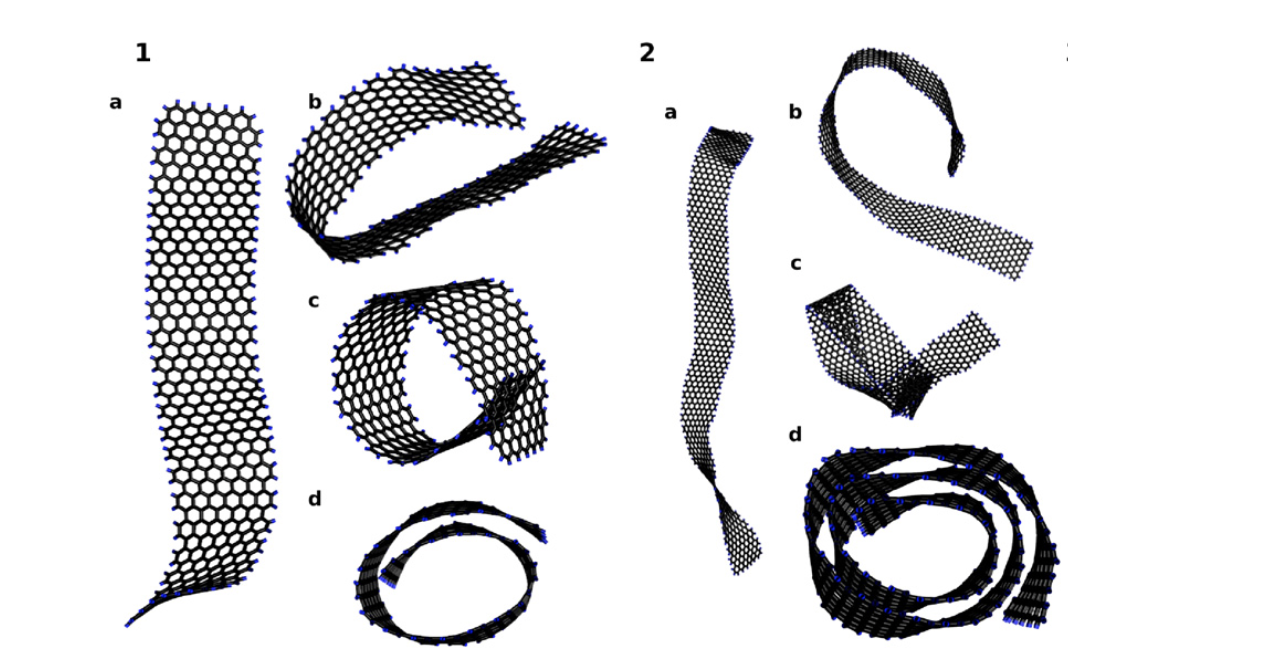
Martins, BVC; Galvao, DS
Curved graphene nanoribbons: structure and dynamics of carbon nanobelts Journal Article
Em: Nanotechnology, vol. 21, não 7, pp. 075710, 2010.
Resumo | Links | BibTeX | Tags: Folding, Graphene, Mechanical Properties, Nanobelts, NanoRibbons
@article{martins2010curved,
title = {Curved graphene nanoribbons: structure and dynamics of carbon nanobelts},
author = {Martins, BVC and Galvao, DS},
url = {http://iopscience.iop.org/0957-4484/21/7/075710},
year = {2010},
date = {2010-01-01},
journal = {Nanotechnology},
volume = {21},
number = {7},
pages = {075710},
publisher = {IOP Publishing},
abstract = {Carbon nanoribbons (CNRs) are graphene (planar) structures with a large aspect ratio. Carbon nanobelts (CNBs) are small graphene nanoribbons rolled up into spiral-like structures, i.e. carbon nanoscrolls (CNSs) with a large aspect ratio. In this work we investigated the energetics and dynamical aspects of CNBs formed from rolling up CNRs. We have carried out molecular dynamics simulations using reactive empirical bond-order potentials. Our results show that, similarly to CNSs, CNB formation is dominated by two major energy contributions, the increase in the elastic energy due to the bending of the initial planar configuration (decreasing structural stability) and the energetic gain due to van der Waals interactions of the overlapping surface of the rolled layers (increasing structural stability). Beyond a critical diameter value these scrolled structures can be even more stable (in terms of energy) than their equivalent planar configurations. In contrast to CNSs that require energy-assisted processes (sonication, chemical reactions, etc) to be formed, CNBs can be spontaneously formed from low temperature driven processes. Long CNBs (length of ~30.0 nm) tend to exhibit self-folded racket-like conformations with formation dynamics very similar to the one observed for long carbon nanotubes. Shorter CNBs will be more likely to form perfect scrolled structures. Possible synthetic routes to fabricate CNBs from graphene membranes are also addressed.
},
keywords = {Folding, Graphene, Mechanical Properties, Nanobelts, NanoRibbons},
pubstate = {published},
tppubtype = {article}
}
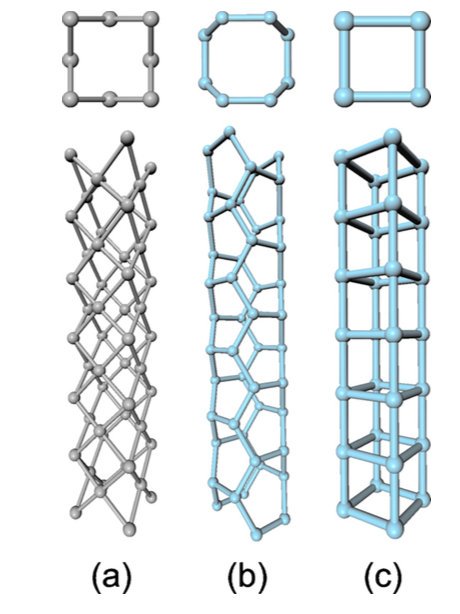
Autreto, PAS; Legoas, SB; Flores, MZS; Galvao, DS
Carbon nanotube with square cross-section: An ab initio investigation Journal Article
Em: The Journal of chemical physics, vol. 133, não 12, pp. 124513, 2010.
Resumo | Links | BibTeX | Tags: Carbon Nanotubes, DFT, New Structures, square tubes
@article{autreto2010carbon,
title = {Carbon nanotube with square cross-section: An ab initio investigation},
author = {Autreto, PAS and Legoas, SB and Flores, MZS and Galvao, DS},
url = {http://scitation.aip.org/content/aip/journal/jcp/133/12/10.1063/1.3483237},
year = {2010},
date = {2010-01-01},
journal = {The Journal of chemical physics},
volume = {133},
number = {12},
pages = {124513},
publisher = {AIP Publishing},
abstract = {Recently, Lagos et al. [Nat. Nanotechnol.4, 149 (2009)] reported the discovery of the smallest possible silver square cross-section nanotube. A natural question is whether similar carbon nanotubes can exist. In this work we report ab initio results for the structural, stability, and electronic properties for such hypothetical structures. Our results show that stable (or at least metastable) structures are possible with metallic properties. They also show that these structures can be obtained by a direct interconversion from SWNT(2,2). Large finite cubanelike oligomers, topologically related to these new tubes, were also investigated.
},
keywords = {Carbon Nanotubes, DFT, New Structures, square tubes},
pubstate = {published},
tppubtype = {article}
}
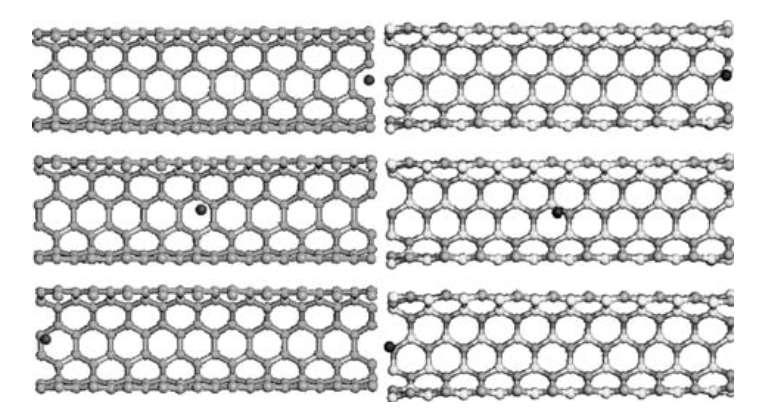
Garcez, Karl M; Moreira, Edvan; Azevedo, David L; Galvao, Douglas S
Neon atoms oscillating inside carbon and boron nitride nanotubes: a fully atomistic molecular dynamics investigation Journal Article
Em: Molecular Simulation, vol. 36, não 9, pp. 639–643, 2010.
Resumo | Links | BibTeX | Tags: Boron Nitride, Encapsulation, Molecular Dynamics, Nanotubes
@article{garcez2010neon,
title = {Neon atoms oscillating inside carbon and boron nitride nanotubes: a fully atomistic molecular dynamics investigation},
author = {Garcez, Karl M and Moreira, Edvan and Azevedo, David L and Galvao, Douglas S},
url = {http://www.tandfonline.com/doi/abs/10.1080/08927020903463926#.VLfp54rF-2o},
year = {2010},
date = {2010-01-01},
journal = {Molecular Simulation},
volume = {36},
number = {9},
pages = {639--643},
publisher = {Taylor & Francis Group},
abstract = {In the present work, based on extensive fully atomistic molecular dynamics simulations, we discuss the dynamics of neon atoms oscillating inside (5,5) single-walled carbon nanotubes (CNTs) and boron nitride nanotubes (BNNTs). Our results show that sustained high-frequency oscillatory regimes are possible for a large range of temperatures. Our results also show that the general features of the oscillations are quite similar to those observed in CNT and BNNT, in contrast with some speculations in previous works in the literature about the importance of broken symmetry and chirality exhibited by BNNTs.},
keywords = {Boron Nitride, Encapsulation, Molecular Dynamics, Nanotubes},
pubstate = {published},
tppubtype = {article}
}
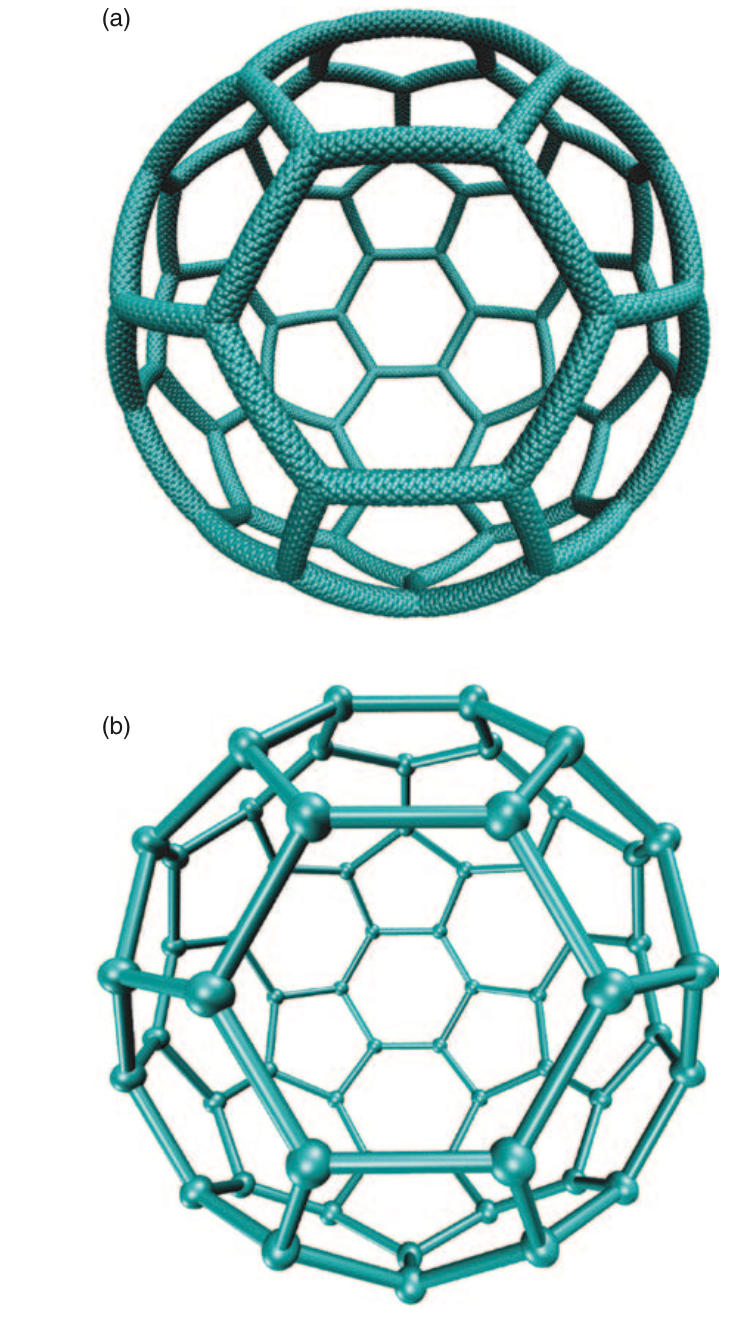
Coluci, VR; dos Santos, RPB; Galvao, DS
Topologically Closed Macromolecules Made of Single Walled Carbon Nanotubes—'Super'-Fullerenes Journal Article
Em: Journal of Nanoscience and Nanotechnology, vol. 10, não 7, pp. 4378–4383, 2010.
Resumo | Links | BibTeX | Tags: Fullerenes, New Structures, Super Carbons, Super Fullerenes
@article{coluci2010topologically,
title = {Topologically Closed Macromolecules Made of Single Walled Carbon Nanotubes—'Super'-Fullerenes},
author = {Coluci, VR and dos Santos, RPB and Galvao, DS},
url = {http://www.ingentaconnect.com/content/asp/jnn/2010/00000010/00000007/art00040},
year = {2010},
date = {2010-01-01},
journal = {Journal of Nanoscience and Nanotechnology},
volume = {10},
number = {7},
pages = {4378--4383},
publisher = {American Scientific Publishers},
abstract = {We propose and theoretically investigated a new class of topologically closed macromolecules built using single walled carbon nanotubes. These macromolecules are based on the fullerene architecture. Classical molecular dynamics simulations were used to predict their stability, thermal, vibrational, and mechanical properties. These macromolecules, named 'super'-fullerenes, present high porosity, low density (∼1 g/cm3), and high surface area (≅2500 m2/g). Our results predict gas phase specific heat of about 0.4 Jg−1K−1 at room temperature and high flexibility under compressive strains. These properties make these hypothetical macromolecules good candidates for gas storage material and biomolecular sieves.},
keywords = {Fullerenes, New Structures, Super Carbons, Super Fullerenes},
pubstate = {published},
tppubtype = {article}
}

Lagos, MJ; Sato, F; Autreto, PAS; Galvao, DS; Rodrigues, V; Ugarte, D
Temperature effects on the atomic arrangement and conductance of atomic-size gold nanowires generated by mechanical stretching Journal Article
Em: Nanotechnology, vol. 21, não 48, pp. 485702, 2010.
Resumo | Links | BibTeX | Tags: DFT, Mechanical Properties, Metallic Nanowires, Quantum Transport, TEM
@article{lagos2010temperature,
title = {Temperature effects on the atomic arrangement and conductance of atomic-size gold nanowires generated by mechanical stretching},
author = {Lagos, MJ and Sato, F and Autreto, PAS and Galvao, DS and Rodrigues, V and Ugarte, D},
url = {http://iopscience.iop.org/0957-4484/21/48/485702},
year = {2010},
date = {2010-01-01},
journal = {Nanotechnology},
volume = {21},
number = {48},
pages = {485702},
publisher = {IOP Publishing},
abstract = {We have studied the changes induced by thermal effects in the structural and transport response of Au nanowires generated by mechanical elongation. We have used time-resolved atomic resolution transmission electron microscopy imaging and quantum conductance measurement using a mechanically controllable break junction. Our results showed remarkable differences in the NW evolution for experiments realized at 150 and 300 K, which modifies drastically the conductance response during elongation. Molecular dynamics and electronic transport calculations were used to consistently correlate the observed structural and conductance behavior. These results emphasize that it is essential to take into account the precise atomic arrangement of nanocontacts generated by mechanical stretching to understand electrical transport properties. Also, our study shows that much care must be taken when comparing results obtained in different experimental conditions, mainly different temperatures.
},
keywords = {DFT, Mechanical Properties, Metallic Nanowires, Quantum Transport, TEM},
pubstate = {published},
tppubtype = {article}
}
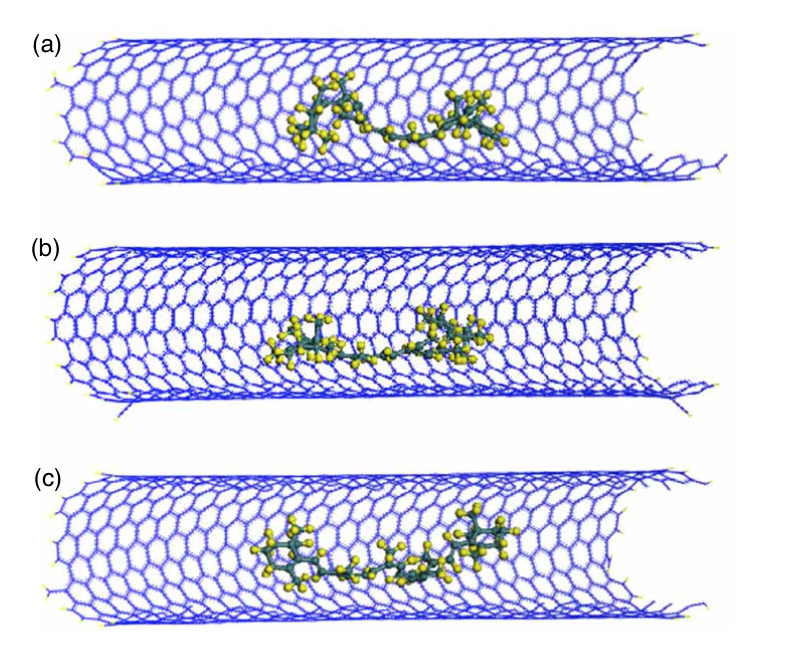
Moreira, E; Lemos, V; Galvao, DS; Azevedo, DL
$beta$-Carotene encapsulation into single-walled carbon nanotubes: a theoretical study Journal Article
Em: Molecular Simulation, vol. 36, não 13, pp. 1031–1034, 2010.
Resumo | Links | BibTeX | Tags: Beta-carotene, CNT encapsulation, Molecular Dynamics
@article{moreira2010beta,
title = {$beta$-Carotene encapsulation into single-walled carbon nanotubes: a theoretical study},
author = {Moreira, E and Lemos, V and Galvao, DS and Azevedo, DL},
url = {http://www.tandfonline.com/doi/abs/10.1080/08927022.2010.501519#.VLfmM4rF-2o},
year = {2010},
date = {2010-01-01},
journal = {Molecular Simulation},
volume = {36},
number = {13},
pages = {1031--1034},
publisher = {Taylor & Francis},
abstract = {Recently, the encapsulation of β-carotene molecules into carbon nanotubes has been achieved. In this work, we report molecular dynamics simulations and tight-binding density functional-based results for a theoretical study of the encapsulation processes. Our results show that the molecules undergo geometrical deformations when encapsulated with significant changes in their electronic structure. Based on these results, we propose a new interpretation to the changes associated with the β-carotene absorption bands experimentally observed.},
keywords = {Beta-carotene, CNT encapsulation, Molecular Dynamics},
pubstate = {published},
tppubtype = {article}
}
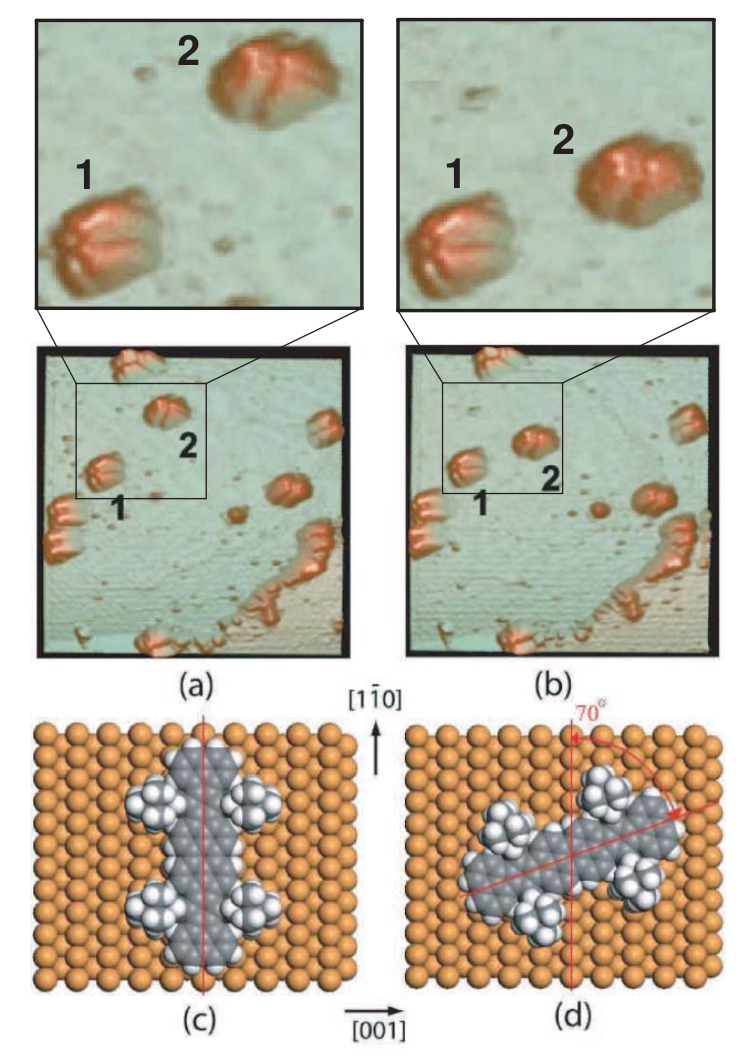
Sato, F; Legoas, SB; Otero, R; Hummelink, F; Thostrup, P; Lægsgaard, E; Stensgaard, I; Besenbacher, F; Galvao, DS
Adsorption configuration effects on the surface diffusion of large organic molecules: The case of Violet Lander Journal Article
Em: The Journal of chemical physics, vol. 133, não 22, pp. 224702, 2010.
Resumo | Links | BibTeX | Tags: DFT, Diffusion, Molecular Electronics, STM, Violet Lander
@article{sato2010adsorption,
title = {Adsorption configuration effects on the surface diffusion of large organic molecules: The case of Violet Lander},
author = {Sato, F and Legoas, SB and Otero, R and Hummelink, F and Thostrup, P and Lægsgaard, E and Stensgaard, I and Besenbacher, F and Galvao, DS},
url = {http://scitation.aip.org/content/aip/journal/jcp/133/22/10.1063/1.3512623},
year = {2010},
date = {2010-01-01},
journal = {The Journal of chemical physics},
volume = {133},
number = {22},
pages = {224702},
publisher = {AIP Publishing},
abstract = {Violet Lander (C108H104) is a large organic molecule that when deposited on Cu(110) surface exhibits lock-and-key like behavior [Otero et al., Nature Mater. 3, 779 (2004)]. In this work, we report a detailed fully atomistic molecular mechanics and molecular dynamics study of this phenomenon. Our results show that it has its physical basis on the interplay of the molecular hydrogens and the Cu(110) atomic spacing, which is a direct consequence of the matching between molecule and surface dimensions. This information could be used to find new molecules capable of displaying lock-and-key behavior with new potential applications in nanotechnology.},
keywords = {DFT, Diffusion, Molecular Electronics, STM, Violet Lander},
pubstate = {published},
tppubtype = {article}
}
2009
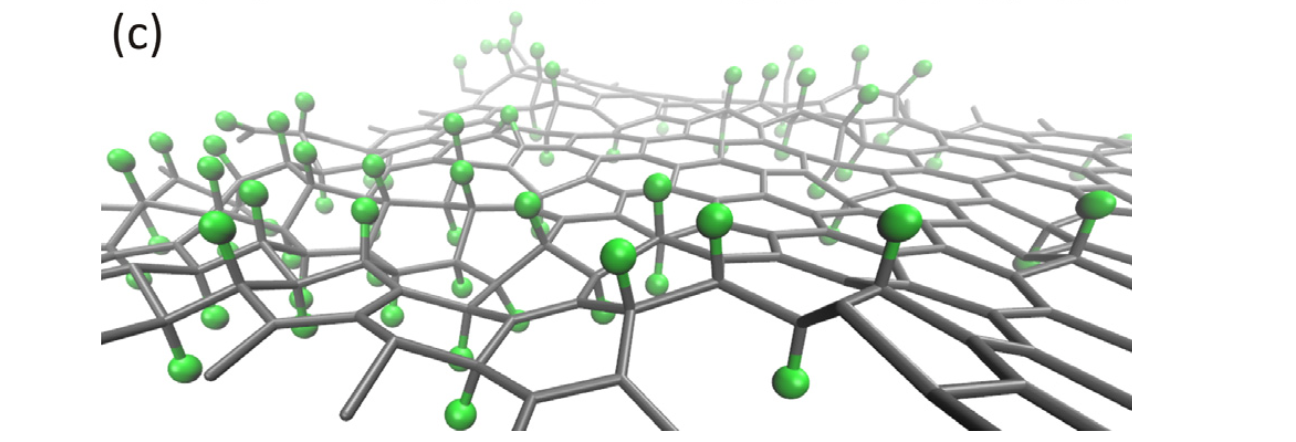
Flores, Marcelo ZS; Autreto, Pedro AS; Legoas, Sergio B; Galvao, Douglas S
Graphene to graphane: a theoretical study Journal Article
Em: Nanotechnology, vol. 20, não 46, pp. 465704, 2009.
Resumo | Links | BibTeX | Tags: Functionalization, Graphanes, Graphene, Hydrogenation
@article{flores2009graphene,
title = {Graphene to graphane: a theoretical study},
author = {Flores, Marcelo ZS and Autreto, Pedro AS and Legoas, Sergio B and Galvao, Douglas S},
url = {http://iopscience.iop.org/0957-4484/20/46/465704},
year = {2009},
date = {2009-01-01},
journal = {Nanotechnology},
volume = {20},
number = {46},
pages = {465704},
publisher = {IOP Publishing},
abstract = {Graphane is a two-dimensional system consisting of a single layer of fully saturated (sp3 hybridization) carbon atoms. In an ideal graphane structure C–H bonds exhibit an alternating pattern (up and down with relation to the plane defined by the carbon atoms). In this work we have investigated, using ab initio and reactive molecular dynamics simulations, the role of H frustration (breaking the H atoms' up and down alternating pattern) in graphane-like structures. Our results show that a significant percentage of uncorrelated H frustrated domains are formed in the early stages of the hydrogenation process leading to membrane shrinkage and extensive membrane corrugations. These results also suggest that large domains of perfect graphane-like structures are unlikely to be formed, as H frustrated domains are always present.
},
keywords = {Functionalization, Graphanes, Graphene, Hydrogenation},
pubstate = {published},
tppubtype = {article}
}
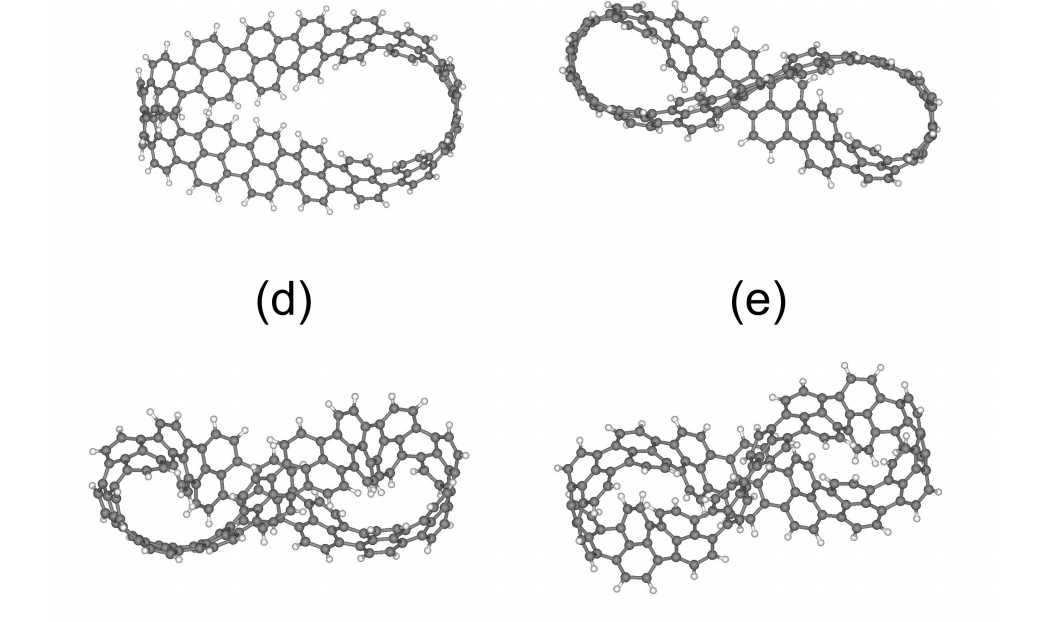
Caetano, Ewerton WS; Freire, Valder N; Santos, Sergio G dos; Galvao, Douglas S; Sato, Fernando
Mobius and twisted graphene nanoribbons: stability, geometry and electronic properties Journal Article
Em: arXiv preprint arXiv:0903.2080, 2009.
Resumo | Links | BibTeX | Tags: Graphene, Mobius, NanoRibbons, Structure
@article{caetano2009m,
title = {Mobius and twisted graphene nanoribbons: stability, geometry and electronic properties},
author = {Caetano, Ewerton WS and Freire, Valder N and Santos, Sergio G dos and Galvao, Douglas S and Sato, Fernando},
url = {http://arxiv.org/abs/0903.2080},
year = {2009},
date = {2009-01-01},
journal = {arXiv preprint arXiv:0903.2080},
abstract = {Results of classical force field geometry optimizations for twisted graphene nanoribbons with a number of twists Nt varying from 0 to 7 (the case Nt=1 corresponds to a half-twist M"obius nanoribbon) are presented in this work. Their structural stability was investigated using the Brenner reactive force field. The best classical molecular geometries were used as input for semiempirical calculations, from which the electronic properties (energy levels, HOMO, LUMO orbitals) were computed for each structure. CI wavefunctions were also calculated in the complete active space framework taking into account eigenstates from HOMO-4 to LUMO+4, as well as the oscillator strengths corresponding to the first optical transitions in the UV-VIS range. The lowest energy molecules were found less symmetric than initial configurations, and the HOMO-LUMO energy gaps are larger than the value found for the nanographene used to build them due to electronic localization effects created by the twisting. A high number of twists leads to a sharp increase of the HOMO → LUMO transition energy. We suggest that some twisted nanoribbons could form crystals stabilized by dipolar interactions.},
keywords = {Graphene, Mobius, NanoRibbons, Structure},
pubstate = {published},
tppubtype = {article}
}
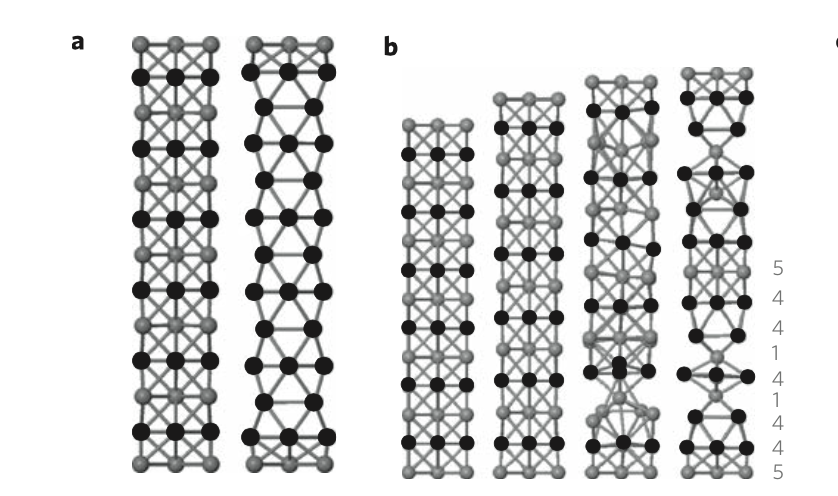
Lagos, MJ; Sato, Fernando; Bettini, Jeferson; Rodrigues, Varlei; Galvao, Douglas S; Ugarte, Daniel
Observation of the smallest metal nanotube with a square cross-section Journal Article
Em: Nature Nanotechnology, vol. 4, não 3, pp. 149–152, 2009.
Resumo | Links | BibTeX | Tags: Metallic Nanowires, New Structures, Smallest nanotube, TEM, top20
@article{lagos2009observation,
title = {Observation of the smallest metal nanotube with a square cross-section},
author = {Lagos, MJ and Sato, Fernando and Bettini, Jeferson and Rodrigues, Varlei and Galvao, Douglas S and Ugarte, Daniel},
url = {http://www.nature.com/nnano/journal/v4/n3/abs/nnano.2008.414.html},
year = {2009},
date = {2009-01-01},
journal = {Nature Nanotechnology},
volume = {4},
number = {3},
pages = {149--152},
publisher = {Nature Publishing Group},
abstract = {Understanding the mechanical properties of nanoscale systems requires a range of measurement techniques and theoretical approaches to gather the relevant physical and chemical information. The arrangements of atoms in nanostructures and macroscopic matter can be different, principally due to the role of surface energy, but the interplay between atomic and electronic structure in association with applied mechanical stress can also lead to surprising differences. For example, metastable structures such as suspended chains of atoms1, 2, 3 and helical wires4, 5 have been produced by stretching metal junctions. Here, we report the spontaneous formation of the smallest possible metal nanotube with a square cross-section during the elongation of silver nanocontacts. Ab initio calculations and molecular simulations indicate that the hollow wire forms because this configuration allows the surface energy to be minimized, and also generates a soft structure capable of absorbing a huge tensile deformation.},
keywords = {Metallic Nanowires, New Structures, Smallest nanotube, TEM, top20},
pubstate = {published},
tppubtype = {article}
}
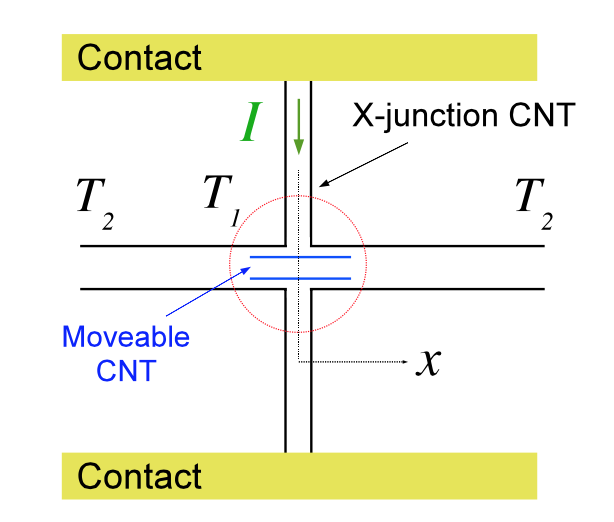
Coluci, VR; Timoteo, VS; Galvao, DS
Thermophoretically driven carbon nanotube oscillators Journal Article
Em: Applied Physics Letters, vol. 95, não 25, pp. 253103, 2009.
Resumo | Links | BibTeX | Tags: Carbon Nanotubes, Chaos, Oscillators, Thermophoretical
@article{coluci2009thermophoretically,
title = {Thermophoretically driven carbon nanotube oscillators},
author = {Coluci, VR and Timoteo, VS and Galvao, DS},
url = {http://scitation.aip.org/content/aip/journal/apl/95/25/10.1063/1.3276546},
year = {2009},
date = {2009-01-01},
journal = {Applied Physics Letters},
volume = {95},
number = {25},
pages = {253103},
publisher = {AIP Publishing},
abstract = {The behavior of a nanodevice based upon double-walled carbon nanotubeoscillators driven by periodically applied thermal gradients (7 and 17 K/nm) is investigated by numerical calculations and classical molecular dynamics simulations. Our results indicate that thermophoresis can be effective to initiate the oscillator and that suitable heat pulses may provide an appropriate way to tune its behavior. Sustained regular oscillatory as well as chaotic motions were observed for the systems investigated in this work.},
keywords = {Carbon Nanotubes, Chaos, Oscillators, Thermophoretical},
pubstate = {published},
tppubtype = {article}
}
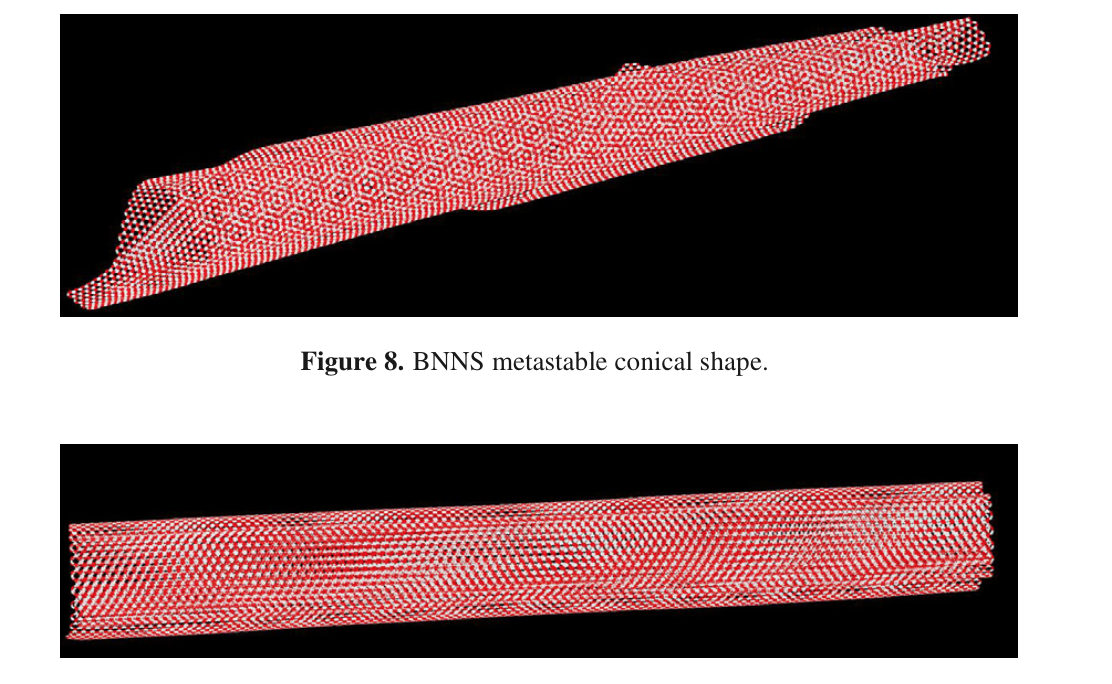
Perim, Eric; Galvao, Douglas S
The structure and dynamics of boron nitride nanoscrolls Journal Article
Em: Nanotechnology, vol. 20, não 33, pp. 335702, 2009.
Resumo | Links | BibTeX | Tags: Boron Nitride, Molecular Dynamics, Scrolls
@article{perim2009structure,
title = {The structure and dynamics of boron nitride nanoscrolls},
author = {Perim, Eric and Galvao, Douglas S},
url = {http://iopscience.iop.org/0957-4484/20/33/335702},
year = {2009},
date = {2009-01-01},
journal = {Nanotechnology},
volume = {20},
number = {33},
pages = {335702},
publisher = {IOP Publishing},
abstract = {Carbon nanoscrolls (CNSs) are structures formed by rolling up graphene layers into a scroll-like shape. CNNs have been experimentally produced by different groups. Boron nitride nanoscrolls (BNNSs) are similar structures using boron nitride instead of graphene layers. In this paper we report molecular mechanics and molecular dynamics results for the structural and dynamical aspects of BNNS formation. Similarly to CNS, BNNS formation is dominated by two major energy contributions, the increase in the elastic energy and the energetic gain due to van der Waals interactions of the overlapping surface of the rolled layers. The armchair scrolls are the most stable configuration while zigzag scrolls are metastable structures which can be thermally converted to armchairs. Chiral scrolls are unstable and tend to evolve into zigzag or armchair configurations depending on their initial geometries. The possible experimental routes to produce BNNSs are also addressed.
},
keywords = {Boron Nitride, Molecular Dynamics, Scrolls},
pubstate = {published},
tppubtype = {article}
}
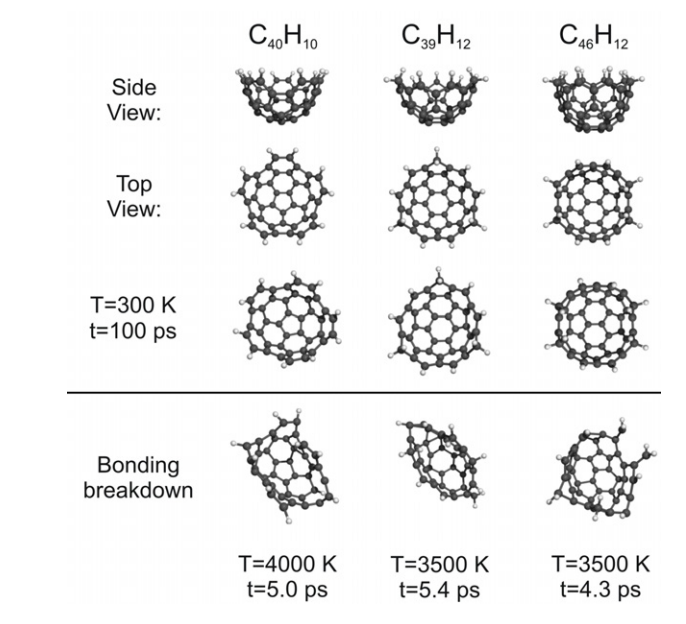
Dos Santos, SG; Pires, MS; Lemos, V; Freire, VN; Caetano, EWS; Galvao, DS; Sato, F; Albuquerque, EL
C60-derived nanobaskets: stability, vibrational signatures, and molecular trapping Journal Article
Em: Nanotechnology, vol. 20, não 39, pp. 395701, 2009.
Resumo | Links | BibTeX | Tags: Fullerenes, Molecular Dynamics, nanobaskets, nanobowls
@article{dos2009c60,
title = {C60-derived nanobaskets: stability, vibrational signatures, and molecular trapping},
author = {Dos Santos, SG and Pires, MS and Lemos, V and Freire, VN and Caetano, EWS and Galvao, DS and Sato, F and Albuquerque, EL},
url = {http://iopscience.iop.org/0957-4484/20/39/395701},
year = {2009},
date = {2009-01-01},
journal = {Nanotechnology},
volume = {20},
number = {39},
pages = {395701},
publisher = {IOP Publishing},
abstract = {C60-derived nanobaskets, with chemical formulae (symmetry point group) C40H10 (C5v), C39H12 (C3v), C46H12 (C2v), were investigated. Molecular dynamic simulations (MDSs) indicate that the molecules preserve their bonding frame for temperatures up to 300 K (simulation time 100 ps), and maintain atomic cohesion for at least 4 ps at temperatures up to 3500 K. The infrared spectra of the C60-derived nanobaskets were simulated through density functional theory (DFT) calculations, allowing for the attribution of infrared signatures specific to each carbon nanobasket. The possibility of using C60-derived nanobaskets as molecular containers is demonstrated by performing a DFT study of their bonding to hydrogen, water, and L-alanine. The carbon nanostructures presented here show a higher bonding energy (~1.0 eV), suggesting that a family of nanostructures, Cn-derived (n = 60,70,76,80, etc) nanobaskets, could work as molecular containers, paving the way for future developments such as tunable traps for complex molecular systems.},
keywords = {Fullerenes, Molecular Dynamics, nanobaskets, nanobowls},
pubstate = {published},
tppubtype = {article}
}
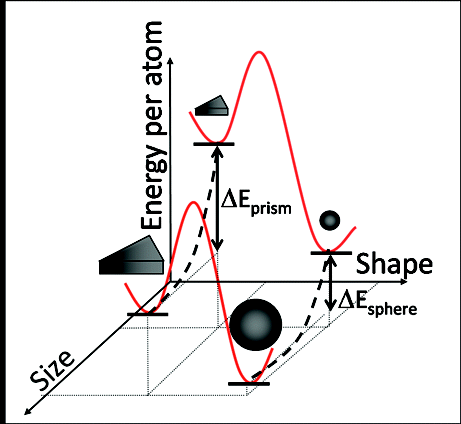
Rocha, Tulio CR; Sato, Fernando; Dantas, Socrates O; Galvao, Douglas S; Zanchet, Daniela
New Insights on the Growth of Anisotropic Nanoparticles from Total Energy Calculations Journal Article
Em: The Journal of Physical Chemistry C, vol. 113, não 28, pp. 11976–11979, 2009.
Resumo | Links | BibTeX | Tags: growth, Nanoparticles, Structure
@article{rocha2009new,
title = {New Insights on the Growth of Anisotropic Nanoparticles from Total Energy Calculations},
author = {Rocha, Tulio CR and Sato, Fernando and Dantas, Socrates O and Galvao, Douglas S and Zanchet, Daniela},
url = {http://pubs.acs.org/doi/abs/10.1021/jp903794y},
year = {2009},
date = {2009-01-01},
journal = {The Journal of Physical Chemistry C},
volume = {113},
number = {28},
pages = {11976--11979},
publisher = {American Chemical Society},
abstract = {The growth mechanism of anisotropic metallic nanoparticles is still an open and polemical question. The common observation of the existence of nonspherical (not the most stable) shapes in varied experimental conditions is not fully understood. In this work, based on results from total energy calculations for different shapes and sizes of Ag nanoparticles, we provide new insights of why anisotropic structures are commonly found in different preparation conditions. We show that, assuming the presence of a particle shape distribution in the beginning of the growth process, anisotropic nanoparticles can preferentially grow over spherical ones due to the fact that the energy required to build larger anisotropic structures could be less than the one required to build isotropic structures. These results suggest that many previous works in literature shall be revisited accordingly to these new finds.},
keywords = {growth, Nanoparticles, Structure},
pubstate = {published},
tppubtype = {article}
}
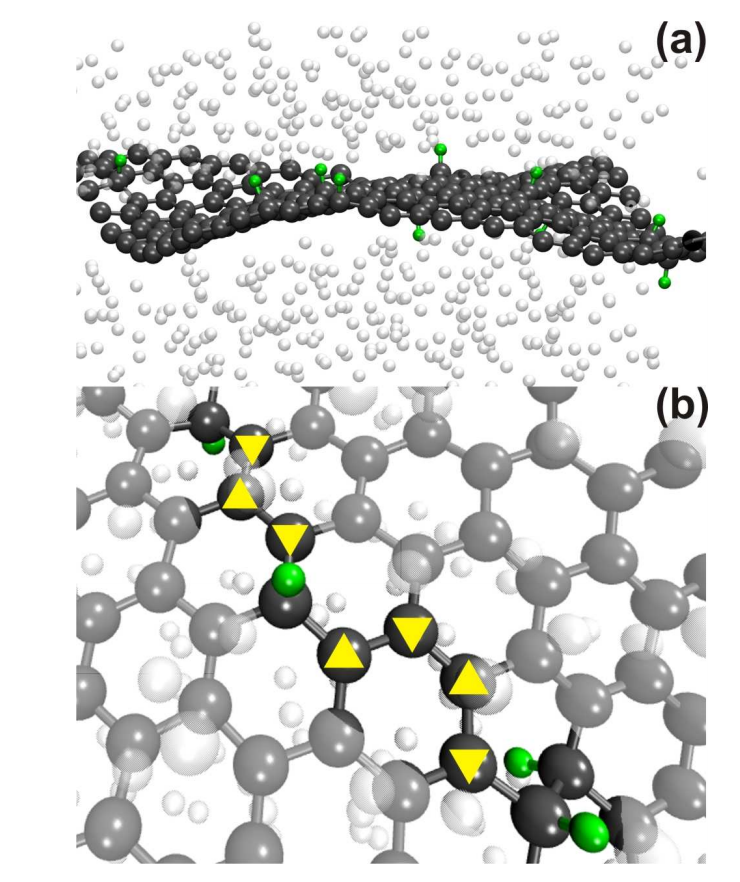
Legoas, Sergio B; Autreto, Pedro AS; Flores, Marcelo ZS; Galvao, Douglas S
Graphene to graphane: the role of H frustration in lattice contraction Journal Article
Em: arXiv preprint arXiv:0903.0278, 2009.
Resumo | Links | BibTeX | Tags: Functionalization, Graphane, Graphene, Hydrogenation
@article{legoas2009graphene,
title = {Graphene to graphane: the role of H frustration in lattice contraction},
author = {Legoas, Sergio B and Autreto, Pedro AS and Flores, Marcelo ZS and Galvao, Douglas S},
url = {http://arxiv.org/abs/0903.0278},
year = {2009},
date = {2009-01-01},
journal = {arXiv preprint arXiv:0903.0278},
abstract = {Graphane is a two-dimensional system consisting of a single planar layer of fully saturated (sp3 hybridization) carbon atoms with H atoms attached to them in an alternating pattern (up and down with relation to the plane defined by the carbon atoms). Stable graphane structures were theoretically predicted to exist some years ago and just experimentally realized through hydrogenation of graphene membranes. In this work we have investigated using textit{ab initio} and reactive molecular dynamics the role of H frustration (breaking the H atoms up and down alternating pattern) in graphane-like structures. Our results show that H frustration significantly contributes to lattice contraction. The dynamical aspects of converting graphene to graphane is also addressed.},
keywords = {Functionalization, Graphane, Graphene, Hydrogenation},
pubstate = {published},
tppubtype = {article}
}
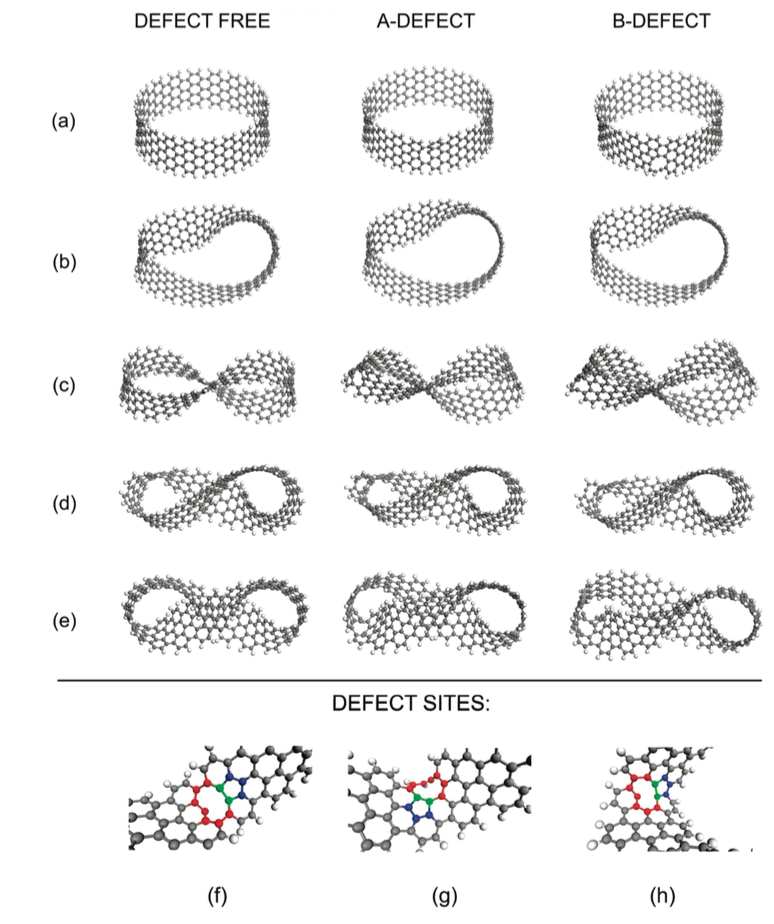
Caetano, Ewerton WS; Freire, Valder N; dos Santos, Sergio G; Albuquerque, EL; Galvao, Douglas S; Sato, Fernando
Defects in Graphene-Based Twisted Nanoribbons: Structural, Electronic, and Optical Properties Journal Article
Em: Langmuir, vol. 25, não 8, pp. 4751–4759, 2009.
Resumo | Links | BibTeX | Tags: Defects, Mobius, NanoRibbons, Twisting
@article{caetano2009defects,
title = {Defects in Graphene-Based Twisted Nanoribbons: Structural, Electronic, and Optical Properties},
author = {Caetano, Ewerton WS and Freire, Valder N and dos Santos, Sergio G and Albuquerque, EL and Galvao, Douglas S and Sato, Fernando},
url = {http://pubs.acs.org/doi/abs/10.1021/la803929f},
year = {2009},
date = {2009-01-01},
journal = {Langmuir},
volume = {25},
number = {8},
pages = {4751--4759},
publisher = {ACS Publications},
abstract = {We present some computational simulations of graphene-based nanoribbons with a number of half-twists varying from 0 to 4 and two types of defects obtained by removing a single carbon atom from two different sites. Optimized geometries are found by using a mix of classical quantum semiempirical computations. According with the simulations results, the local curvature of the nanoribbons increases at the defect sites, especially for a higher number of half-twists. The HOMO−LUMO energy gap of the nanostructures has significant variation when the number of half-twists increases for the defective nanoribbons. At the quantum semiempirical level, the first optically active transitions and oscillator strengths are calculated using the full configuration interaction (CI) framework, and the optical absorption in the UV/vis range (electronic transitions) and in the infrared (vibrational transitions) are achieved. Distinct nanoribbons show unique spectral signatures in the UV/vis range, with the first absorption peaks in wavelengths ranging from the orange to the violet. Strong absorption is observed in the ultraviolet region, although differences in their infrared spectra are hardly discernible.},
keywords = {Defects, Mobius, NanoRibbons, Twisting},
pubstate = {published},
tppubtype = {article}
}
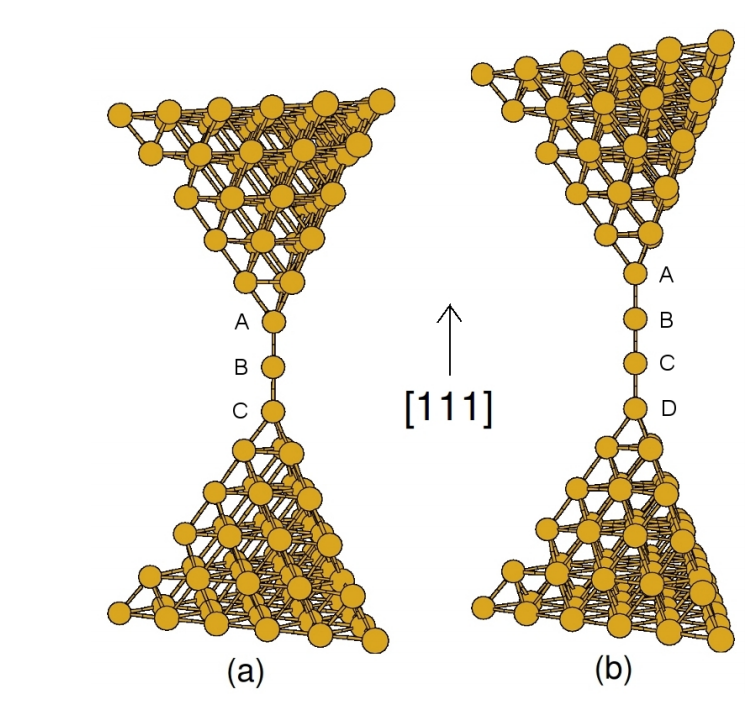
Sato, Fernando; Lagos, Maureen; Autreto, Pedro; Ugarte, Daniel; Galvao, Douglas
On the Lifetime of Suspended Atomic Chains Formed from Stretched Metallic Gold Nanowires Journal Article
Em: Physicae, vol. 8, não 8, 2009, (Invited Paper).
Resumo | Links | BibTeX | Tags: Atomic Chains, Gold, Metallic Nanowires, TEM
@article{sato2009lifetime,
title = {On the Lifetime of Suspended Atomic Chains Formed from Stretched Metallic Gold Nanowires},
author = {Sato, Fernando and Lagos, Maureen and Autreto, Pedro and Ugarte, Daniel and Galvao, Douglas},
url = {http://physicae.ifi.unicamp.br/physicae/article/viewArticle/109},
year = {2009},
date = {2009-01-01},
journal = {Physicae},
volume = {8},
number = {8},
abstract = {Metallic nanowires have been object of intense theoretical and experimental works in the lastyears. In spite of the large number of studies for such systems some fundamental aspects remain open and polemical questions. In this work we report preliminary results for the study of the final steps of Au suspended atomic chains (LACs) with different number of atoms as a function of tem-perature. We have carried out classical molecular dynamics simulations using tight-binding models with a second moment approximations. Our results suggest a more complex phenomenon than previously anticipated. The dynamics of chain rupture seems to be determined beyond thermodynamics contributions and the bond breaking patterns were observed to be chain-length dependent.
},
note = {Invited Paper},
keywords = {Atomic Chains, Gold, Metallic Nanowires, TEM},
pubstate = {published},
tppubtype = {article}
}
Torriani, IL; Silva, JC; Autreto, PAS; Galvao, DS; Caldas, MJ; Graeff, CFO
Low resolution structure of synthetic melanin aggregates in aqueous solutions and organic solvents Journal Article
Em: Acta Crystalographica A, vol. 64, pp. C552, 2009.
Resumo | Links | BibTeX | Tags: Melanin, Structure
@article{torriani2009low,
title = {Low resolution structure of synthetic melanin aggregates in aqueous solutions and organic solvents},
author = {Torriani, IL and Silva, JC and Autreto, PAS and Galvao, DS and Caldas, MJ and Graeff, CFO},
url = {http://journals.iucr.org/a/issues/2008/a1/00/a39972/a39972.pdf},
year = {2009},
date = {2009-01-01},
journal = {Acta Crystalographica A},
volume = {64},
pages = {C552},
abstract = {In an effort to find out details of the melanin fundamental structural
unit, a great amount of information has been gathered using
several techniques. The local short range order of the melanin
molecular clusters has been described as consisting of five to seven
5,6-indolequinone units, arranged in planes which are pi-stacked
with a spacing of 0.34 nm. Typical cluster size is 1.5-2.0 nm in
lateral dimensions and 1.0 nm; in height. Nonetheless, structural
details and dimensions of the aggregates are still not clearly defined
and experiments did not answer the key question concerning the
identification of the fundamental melanin protomolecule. More
recently, small angle scattering of X-rays (SAXS) and neutrons
(SANS) were performed. Several authors used these techniques,
which are well designed to study macromolecules in solution to
find details of melanin-copper ions interaction as well as chemical
bleaching effects. A diversity of aggregated structures were proposed
for these nanoscaled particles based on size and apparent shape.
In this presentation we report the results of SAXS experiments
performed with melanin synthetized from L-dopa and L-tyrosine in
organic solvents, which were reported to be very effective for thin
film formation. Water-based synthetic melanin was also studied
for comparison purposes, since molecular aggregation behavior is
known to vary with the route used for the synthesis. Reliable data
was obtained for the water-based and DMSO dispersions. Data
analysis was performed by conventional IFT methods and the overall
shape and dimensional parameters of the melanin particles were
obtained. Using ab-initio calculations, a low resolution 3D model is
proposed for the basic melanin particle in aqueous media and DMSO.},
keywords = {Melanin, Structure},
pubstate = {published},
tppubtype = {article}
}
unit, a great amount of information has been gathered using
several techniques. The local short range order of the melanin
molecular clusters has been described as consisting of five to seven
5,6-indolequinone units, arranged in planes which are pi-stacked
with a spacing of 0.34 nm. Typical cluster size is 1.5-2.0 nm in
lateral dimensions and 1.0 nm; in height. Nonetheless, structural
details and dimensions of the aggregates are still not clearly defined
and experiments did not answer the key question concerning the
identification of the fundamental melanin protomolecule. More
recently, small angle scattering of X-rays (SAXS) and neutrons
(SANS) were performed. Several authors used these techniques,
which are well designed to study macromolecules in solution to
find details of melanin-copper ions interaction as well as chemical
bleaching effects. A diversity of aggregated structures were proposed
for these nanoscaled particles based on size and apparent shape.
In this presentation we report the results of SAXS experiments
performed with melanin synthetized from L-dopa and L-tyrosine in
organic solvents, which were reported to be very effective for thin
film formation. Water-based synthetic melanin was also studied
for comparison purposes, since molecular aggregation behavior is
known to vary with the route used for the synthesis. Reliable data
was obtained for the water-based and DMSO dispersions. Data
analysis was performed by conventional IFT methods and the overall
shape and dimensional parameters of the melanin particles were
obtained. Using ab-initio calculations, a low resolution 3D model is
proposed for the basic melanin particle in aqueous media and DMSO.
2008
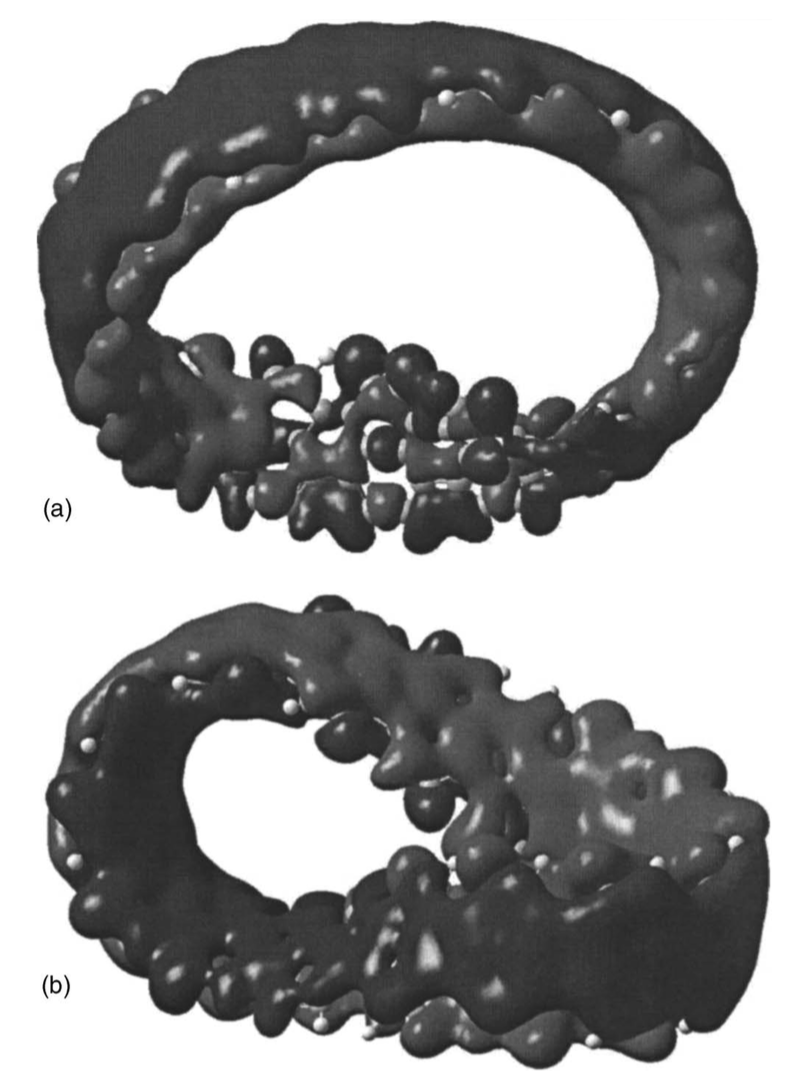
E. W. S.; Freire Caetano, V. N. ; dos Santos
Mobius and twisted graphene nanoribbons: Stability, geometry, and electronic properties Journal Article
Em: THE JOURNAL OF CHEMICAL PHYSICS, vol. 128, pp. 164719, 2008.
Resumo | Links | BibTeX | Tags: DFT, Graphene, Mobis, NanoRibbons, Structure
@article{Caetano2008,
title = {Mobius and twisted graphene nanoribbons: Stability, geometry, and electronic properties},
author = {Caetano, E. W. S.; Freire, V. N.; dos Santos, S. G.; Galvao, D. S.,and Sato, F.},
url = {http://scitation.aip.org/content/aip/journal/jcp/128/16/10.1063/1.2908739},
year = {2008},
date = {2008-04-29},
journal = {THE JOURNAL OF CHEMICAL PHYSICS},
volume = {128},
pages = {164719},
abstract = {Results of classical force field geometry optimizations for twisted graphenenanoribbons with a number of twists Nt varying from 0 to 7 (the case Nt=1 corresponds to a half-twist Möbius nanoribbon) are presented in this work. Their structural stability was investigated using the Brenner reactive force field. The best classical molecular geometries were used as input for semiempirical calculations, from which the electronic properties (energy levels, HOMO, LUMO orbitals) were computed for each structure. CI wavefunctions were also calculated in the complete active space framework taking into account eigenstates from HOMO−4 to LUMO+4, as well as the oscillator strengths corresponding to the first optical transitions in the UV-VIS range. The lowest energy molecules were found less symmetric than initial configurations, and the HOMO-LUMO energy gaps are larger than the value found for the nanographene used to build them due to electronic localization effects created by the twisting. A high number of twists leads to a sharp increase of the HOMO→LUMO transition energy. We suggest that some twisted nanoribbons could form crystals stabilized by dipolar interactions.},
keywords = {DFT, Graphene, Mobis, NanoRibbons, Structure},
pubstate = {published},
tppubtype = {article}
}
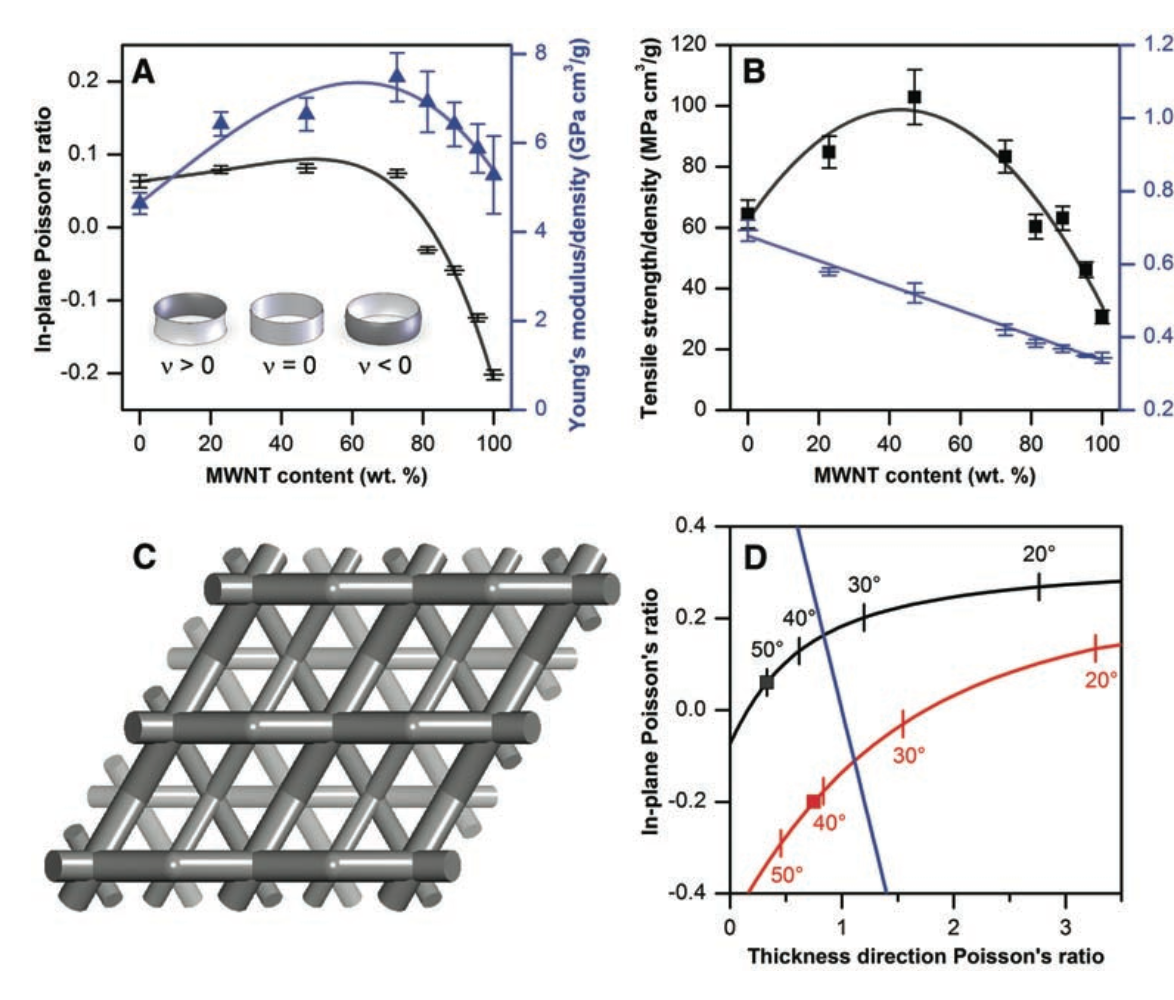
Hall, Lee J; Coluci, Vitor R; Galvao, Douglas S; Kozlov, Mikhail E; Zhang, Mei; Dantas, Socrates O; Baughman, Ray H
Sign change of Poisson's ratio for carbon nanotube sheets Journal Article
Em: Science, vol. 320, não 5875, pp. 504–507, 2008.
Resumo | Links | BibTeX | Tags: Artificial Muscles, Auxetics, Carbon Nanotube Forests, sheets, top20
@article{hall2008sign,
title = {Sign change of Poisson's ratio for carbon nanotube sheets},
author = {Hall, Lee J and Coluci, Vitor R and Galvao, Douglas S and Kozlov, Mikhail E and Zhang, Mei and Dantas, Socrates O and Baughman, Ray H},
url = {http://www.sciencemag.org/content/320/5875/504.short},
year = {2008},
date = {2008-01-01},
journal = {Science},
volume = {320},
number = {5875},
pages = {504--507},
publisher = {American Association for the Advancement of Science},
abstract = {Most materials shrink laterally like a rubber band when stretched, so their Poisson's ratios are positive. Likewise, most materials contract in all directions when hydrostatically compressed and decrease density when stretched, so they have positive linear compressibilities. We found that the in-plane Poisson's ratio of carbon nanotube sheets (buckypaper) can be tuned from positive to negative by mixing single-walled and multiwalled nanotubes. Density-normalized sheet toughness, strength, and modulus were substantially increased by this mixing. A simple model predicts the sign and magnitude of Poisson's ratio for buckypaper from the relative ease of nanofiber bending and stretch, and explains why the Poisson's ratios of ordinary writing paper are positive and much larger. Theory also explains why the negative in-plane Poisson's ratio is associated with a large positive Poisson's ratio for the sheet thickness, and predicts that hydrostatic compression can produce biaxial sheet expansion. This tunability of Poisson's ratio can be exploited in the design of sheet-derived composites, artificial muscles, gaskets, and chemical and mechanical sensors.},
keywords = {Artificial Muscles, Auxetics, Carbon Nanotube Forests, sheets, top20},
pubstate = {published},
tppubtype = {article}
}
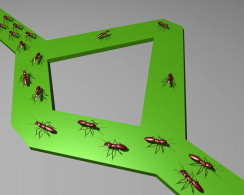
Martins, Bruno VC; Brunetto, Gustavo; Sato, Fernando; Coluci, Vitor R; Galvao, Douglas S
Designing conducting polymers using bioinspired ant algorithms Journal Article
Em: Chemical Physics Letters, vol. 453, não 4, pp. 290–295, 2008.
Resumo | Links | BibTeX | Tags: ANTS algorithms, Artificial Intelligence, Conducting Polymer, Design of Materials
@article{martins2008designing,
title = {Designing conducting polymers using bioinspired ant algorithms},
author = {Martins, Bruno VC and Brunetto, Gustavo and Sato, Fernando and Coluci, Vitor R and Galvao, Douglas S},
url = {http://www.sciencedirect.com/science/article/pii/S0009261408000845},
year = {2008},
date = {2008-01-01},
journal = {Chemical Physics Letters},
volume = {453},
number = {4},
pages = {290--295},
publisher = {Elsevier},
abstract = {Ant algorithms are inspired in real ants and the main idea is to create virtual ants that travel into the space of possible solutions depositing virtual pheromone proportional to how good a specific solution is. This creates an autocatalytic (positive feedback) process that can be used to generate automatic solutions to very difficult problems. In the present work we show that these algorithms can be used coupled to tight-binding Hamiltonians to design conducting polymers with pre-specified properties. The methodology is completely general and can be used for a large number of optimizations problems in materials science.},
keywords = {ANTS algorithms, Artificial Intelligence, Conducting Polymer, Design of Materials},
pubstate = {published},
tppubtype = {article}
}
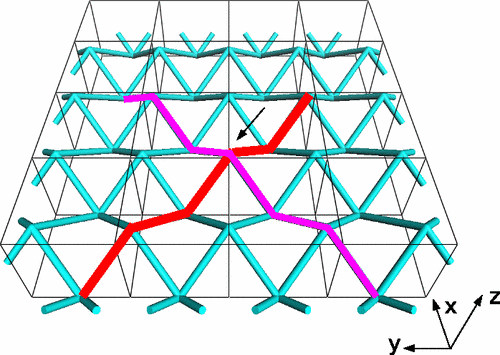
Coluci, Vitor R; Hall, Lee J; Kozlov, Mikhail E; Zhang, Mei; Dantas, Socrates O; Galvao, Douglas S; Baughman, Ray H
Modeling the auxetic transition for carbon nanotube sheets Journal Article
Em: Physical Review B, vol. 78, não 11, pp. 115408, 2008.
Resumo | Links | BibTeX | Tags: Auxetics, Carbon Nanotube Forests, Carbon Nanotubes, CNT sheets
@article{coluci2008modeling,
title = {Modeling the auxetic transition for carbon nanotube sheets},
author = {Coluci, Vitor R and Hall, Lee J and Kozlov, Mikhail E and Zhang, Mei and Dantas, Socrates O and Galvao, Douglas S and Baughman, Ray H},
url = {http://journals.aps.org/prb/abstract/10.1103/PhysRevB.78.115408},
year = {2008},
date = {2008-01-01},
journal = {Physical Review B},
volume = {78},
number = {11},
pages = {115408},
publisher = {APS},
abstract = {A simple model is developed to predict the complex mechanical properties of carbon nanotube sheets (buckypaper) [L. J. Hall et al., Science 320, 504 (2008)]. Fabricated using a similar method to that deployed for making writing paper, these buckypapers can have in-plane Poisson’s ratios changed from positive to negative, becoming auxetic, as multiwalled carbon nanotubes are increasingly mixed with single-walled carbon nanotubes. Essential structural features of the buckypapers are incorporated into the model: isotropic in-plane mechanical properties, nanotubes preferentially oriented in the sheet plane, and freedom to undergo stress-induced elongation by both angle and length changes. The expressions derived for the Poisson’s ratios enabled quantitative prediction of both observed properties and remarkable new properties obtainable by structural modification.},
keywords = {Auxetics, Carbon Nanotube Forests, Carbon Nanotubes, CNT sheets},
pubstate = {published},
tppubtype = {article}
}
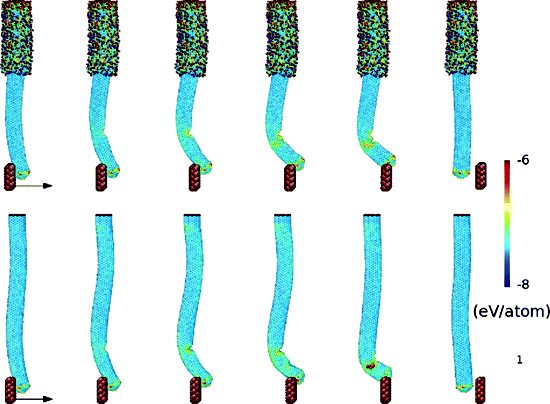
Nakabayashi, D; Moreau, ALD; Coluci, VR; Galvao, DS; Cotta, MA; Ugarte, D
Carbon nanotubes as reinforcement elements of composite nanotools Journal Article
Em: Nano letters, vol. 8, não 3, pp. 842–847, 2008.
Resumo | Links | BibTeX | Tags: AFM tips, Carbon Nanotubes, Molecular Dynamics, Nanocomposites, Tribology
@article{nakabayashi2008carbon,
title = {Carbon nanotubes as reinforcement elements of composite nanotools},
author = {Nakabayashi, D and Moreau, ALD and Coluci, VR and Galvao, DS and Cotta, MA and Ugarte, D},
url = {http://pubs.acs.org/doi/abs/10.1021/nl0729633},
year = {2008},
date = {2008-01-01},
journal = {Nano letters},
volume = {8},
number = {3},
pages = {842--847},
publisher = {American Chemical Society},
abstract = {Nanotechnology is stimulating the development of nanomanipulators, including tips to interact with individual nanosystems. Fabricating nanotips fulfilling the requirements of shape (size, aspect ratio), mechanical, magnetic, and electrical properties is a material science challenge. Here, we report the generation of reinforced carbon−carbon composite nanotools using a nanotube (CNTs) covered by an amorphous carbon matrix (shell); the CNT tip protruded and remained uncoated to preserve apex size. Unsuitable properties such as flexibility and vibration could be controlled without deteriorating the CNT size, strength, and resilience. Nanomanipulation experiments and molecular dynamics simulations have been used to study the mechanical response of these composite beams under bending efforts. AFM probes based on these C−C composite high aspect ratio tips generated excellent image resolution and showed no degradation after acquiring several hundred (400) images.},
keywords = {AFM tips, Carbon Nanotubes, Molecular Dynamics, Nanocomposites, Tribology},
pubstate = {published},
tppubtype = {article}
}
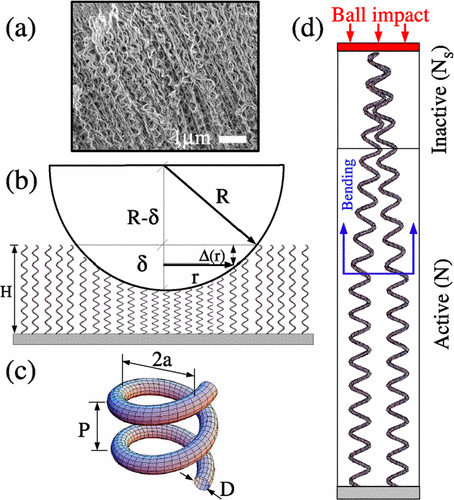
Coluci, Vitor R; Fonseca, Alexandre F; Galvao, Douglas S; Daraio, Chiara
Entanglement and the nonlinear elastic behavior of forests of coiled carbon nanotubes Journal Article
Em: Physical Review Letters, vol. 100, não 8, pp. 086807, 2008.
Resumo | Links | BibTeX | Tags: Carbon Nanotube Forests, Entanglement, Mechanical Properties, top20
@article{coluci2008entanglement,
title = {Entanglement and the nonlinear elastic behavior of forests of coiled carbon nanotubes},
author = {Coluci, Vitor R and Fonseca, Alexandre F and Galvao, Douglas S and Daraio, Chiara},
url = {http://journals.aps.org/prl/abstract/10.1103/PhysRevLett.100.086807},
year = {2008},
date = {2008-01-01},
journal = {Physical Review Letters},
volume = {100},
number = {8},
pages = {086807},
publisher = {American Physical Society},
abstract = {Helical or coiled nanostructures have been objects of intense experimental and theoretical studies due to their special electronic and mechanical properties. Recently, it was experimentally reported that the dynamical response of a foamlike forest of coiled carbon nanotubes under mechanical impact exhibits a nonlinear, non-Hertzian behavior, with no trace of plastic deformation. The physical origin of this unusual behavior is not yet fully understood. In this Letter, based on analytical models, we show that the entanglement among neighboring coils in the superior part of the forest surface must be taken into account for a full description of the strongly nonlinear behavior of the impact response of a drop ball onto a forest of coiled carbon nanotubes.},
keywords = {Carbon Nanotube Forests, Entanglement, Mechanical Properties, top20},
pubstate = {published},
tppubtype = {article}
}
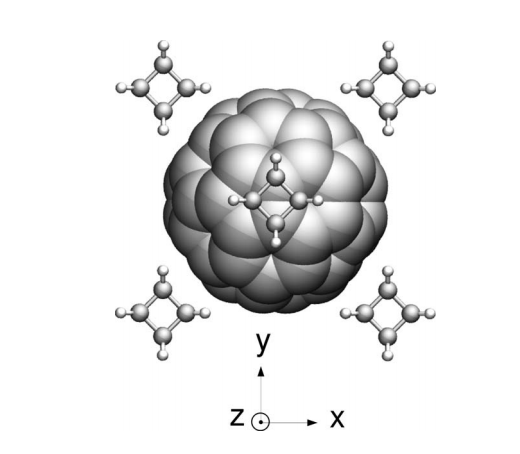
Coluci, Vitor R; Sato, Fernando; Braga, Scheila F; Skaf, Munir S; Galvao, Douglas S
Rotational dynamics and polymerization of C60 in C60-cubane crystals: A molecular dynamics study Journal Article
Em: The Journal of Chemical Physics, vol. 129, não 6, pp. 064506, 2008.
Resumo | Links | BibTeX | Tags: C60, C70, Cubanes, Fullerenes, Molecular Dynamics, Rotor-Stator
@article{coluci2008rotational,
title = {Rotational dynamics and polymerization of C60 in C60-cubane crystals: A molecular dynamics study},
author = {Coluci, Vitor R and Sato, Fernando and Braga, Scheila F and Skaf, Munir S and Galvao, Douglas S},
url = {http://scitation.aip.org/content/aip/journal/jcp/129/6/10.1063/1.2965885},
year = {2008},
date = {2008-01-01},
journal = {The Journal of Chemical Physics},
volume = {129},
number = {6},
pages = {064506},
publisher = {AIP Publishing},
abstract = {We report classical and tight-binding molecular dynamics simulations of the C60fullerene and cubane molecular crystal in order to investigate the intermolecular dynamics and polymerization processes. Our results show that, for 200 and 400 K, cubane molecules remain basically fixed, presenting only thermal vibrations, while C60fullerenes show rotational motions. Fullerenes perform “free” rotational motions at short times (≲1 ps), small amplitude hindered rotational motions (librations) at intermediate times, and rotational diffusive dynamics at long times (≳10 ps). The mechanisms underlying these dynamics are presented. Random copolymerizations among cubanes and fullerenes were observed when temperature is increased, leading to the formation of a disordered structure. Changes in the radial distribution function and electronic density of states indicate the coexistence of amorphous and crystalline phases. The different conformational phases that cubanes and fullerenes undergo during the copolymerization process are discussed.},
keywords = {C60, C70, Cubanes, Fullerenes, Molecular Dynamics, Rotor-Stator},
pubstate = {published},
tppubtype = {article}
}
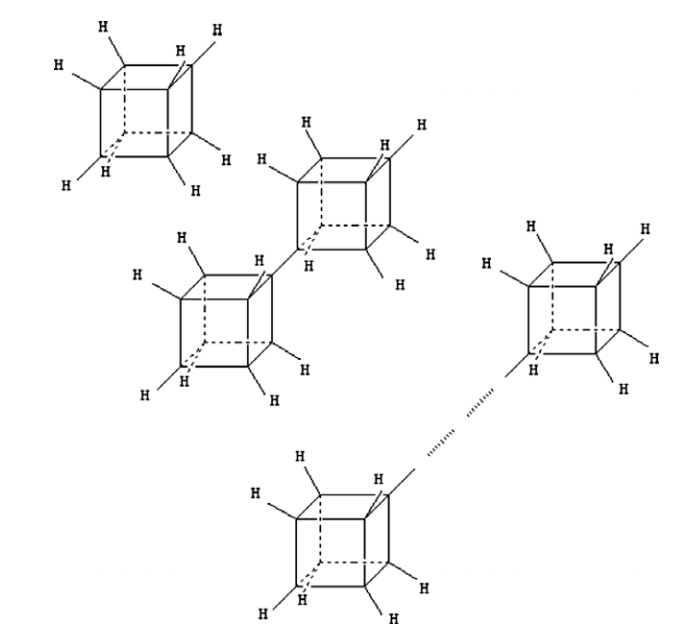
Konstantinova, Elena; Camilo Jr, Alexandre; Barone, Paulo MVB; Dantas, Socrates O; Galvao, Douglas S
Some electronic properties of saturated and unsaturated cubane oligomers using DFT-based calculations Journal Article
Em: Journal of Molecular Structure: THEOCHEM, vol. 868, não 1, pp. 37–41, 2008.
Resumo | Links | BibTeX | Tags: Cubanes, DFT, Polymer
@article{konstantinova2008some,
title = {Some electronic properties of saturated and unsaturated cubane oligomers using DFT-based calculations},
author = {Konstantinova, Elena and Camilo Jr, Alexandre and Barone, Paulo MVB and Dantas, Socrates O and Galvao, Douglas S},
url = {http://www.sciencedirect.com/science/article/pii/S016612800800448X},
year = {2008},
date = {2008-01-01},
journal = {Journal of Molecular Structure: THEOCHEM},
volume = {868},
number = {1},
pages = {37--41},
publisher = {Elsevier},
abstract = {Cubanes and cubane-based molecular structures attract considerable interest as structural units which represent a new class of materials with remarkable properties. These structures are potentially useful for a variety of industrial applications and, for this reason, deserve detailed study. One of the options is to use cubane-based structures to synthesize a new class of conducting polymers with small energy band gap. In the present work we use the DFT-based methods to perform geometrical optimization and obtain some electronic properties for cubane, cubatriene, saturated and unsaturated oligomers containing different number of cubane and cubatriene building units. Our results indicate that the energy difference between the lowest unoccupied molecular orbital (LUMO) and the highest occupied molecular orbital (HOMO) manifests a small decrease with the growing units number for saturated or unsaturated oligomers. This energy difference is strongly dependent on the presence of hydrogen atoms and is greater for unsaturated structures.},
keywords = {Cubanes, DFT, Polymer},
pubstate = {published},
tppubtype = {article}
}
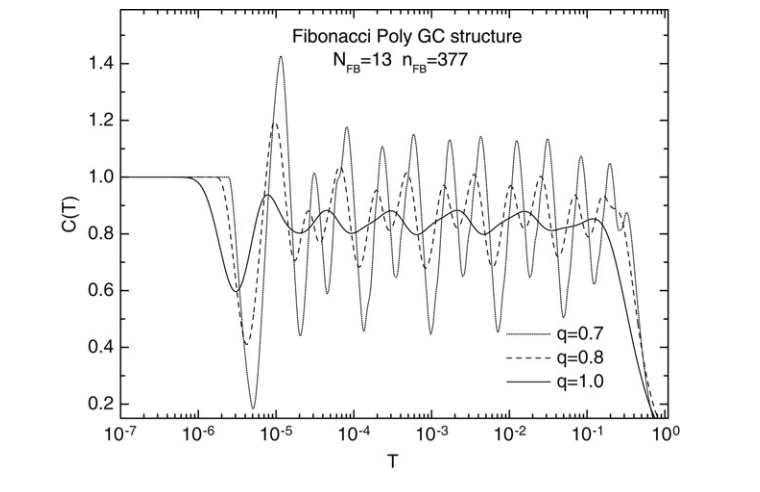
Moreira, DA; Albuquerque, EL; da Silva, LR; Galvao, DS
Low-temperature specific heat spectra considering nonextensive long-range correlated quasiperiodic DNA molecules Journal Article
Em: Physica A: Statistical Mechanics and its Applications, vol. 387, não 22, pp. 5477–5482, 2008.
Resumo | Links | BibTeX | Tags: DNA sequences, Fibonacci, nonextensive
@article{moreira2008low,
title = {Low-temperature specific heat spectra considering nonextensive long-range correlated quasiperiodic DNA molecules},
author = {Moreira, DA and Albuquerque, EL and da Silva, LR and Galvao, DS},
url = {http://www.sciencedirect.com/science/article/pii/S0378437108005347},
year = {2008},
date = {2008-01-01},
journal = {Physica A: Statistical Mechanics and its Applications},
volume = {387},
number = {22},
pages = {5477--5482},
publisher = {North-Holland},
abstract = {We consider the low-temperature specific heat spectra of long-range correlated quasiperiodic DNA molecules using a q-gaussian distribution, and compare them with those considering the Boltzmann-Gibbs distribution. The energy spectra are calculated using the one-dimensional Schrödinger equation in a tight-binding approximation with the on-site energy exhibiting long-range disorder and non-random hopping amplitudes. We focus our attention at the low temperature region, where the specific heat spectra presents a logarithmic-periodic oscillations as a function of the temperature T around a mean value given by a characteristic dimension of the energy spectrum.},
keywords = {DNA sequences, Fibonacci, nonextensive},
pubstate = {published},
tppubtype = {article}
}
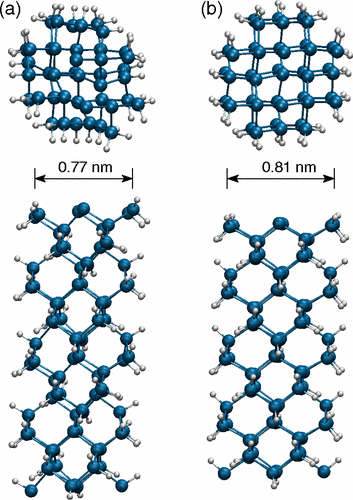
Rurali, R; Cartoixa, X; Galvao, DS
Large electromechanical response in silicon nanowires predicted from first-principles electronic structure calculations Journal Article
Em: Physical Review B, vol. 77, não 7, pp. 073403, 2008.
Resumo | Links | BibTeX | Tags: DFT, Eletroactuation, Nanowires, Silicon
@article{rurali2008large,
title = {Large electromechanical response in silicon nanowires predicted from first-principles electronic structure calculations},
author = {Rurali, R and Cartoixa, X and Galvao, DS},
url = {http://journals.aps.org/prb/abstract/10.1103/PhysRevB.77.073403},
year = {2008},
date = {2008-01-01},
journal = {Physical Review B},
volume = {77},
number = {7},
pages = {073403},
publisher = {American Physical Society},
abstract = {We study by means of first-principles electronic structure calculations the electromechanical response, i.e., the structural modifications upon charge injection, of ⟨100⟩ silicon nanowires. We show that, at variance with sp2 carbon nanostructures, the response is remarkably linear, discriminates between injected charge of different signs, and is up to one order of magnitude larger than in carbon nanotubes.
},
keywords = {DFT, Eletroactuation, Nanowires, Silicon},
pubstate = {published},
tppubtype = {article}
}
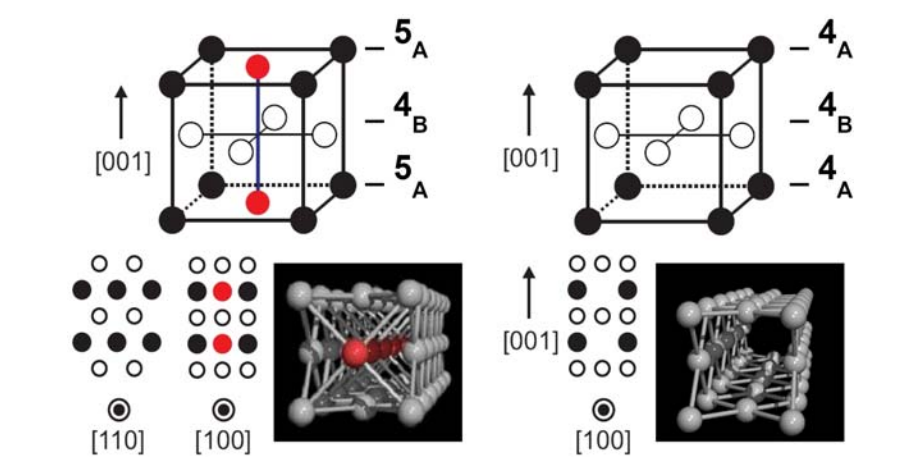
Lagos, M; Sato, F; Bettini, J; Rdrigues, V; Galvao, D; Ugarte, D
Atomic-size Silver Nanotube Book Section
Em: EMC 2008 14th European Microscopy Congress 1--5 September 2008, Aachen, Germany, pp. 493–494, Springer Berlin Heidelberg, 2008, (Book Chapter).
Resumo | Links | BibTeX | Tags: Metallic Nanowires, New Structures, Silver Nanotubes, TEM
@incollection{lagos2008atomic,
title = {Atomic-size Silver Nanotube},
author = {Lagos, M and Sato, F and Bettini, J and Rdrigues, V and Galvao, D and Ugarte, D},
url = {http://link.springer.com/chapter/10.1007%2F978-3-540-85156-1_247},
year = {2008},
date = {2008-01-01},
booktitle = {EMC 2008 14th European Microscopy Congress 1--5 September 2008, Aachen, Germany},
pages = {493--494},
publisher = {Springer Berlin Heidelberg},
abstract = {The atomic arrangement of nanosystems may be quite different from the traditional materials; surface energy minimization plays a dominant role in this size range, and accounts for many of these new structures. Graphitic nanotubes [1] represent the best example, being fromed by a rolled the graphitic layer, which is tradionally flat. Subsequently the rolling of the compact (111) atomic planes was reported for gold nanowires (NW) generated by mechanical stretching [2]. But, we may expect many more surprises from the interplay between atomic and electronic structure.},
note = {Book Chapter},
keywords = {Metallic Nanowires, New Structures, Silver Nanotubes, TEM},
pubstate = {published},
tppubtype = {incollection}
}
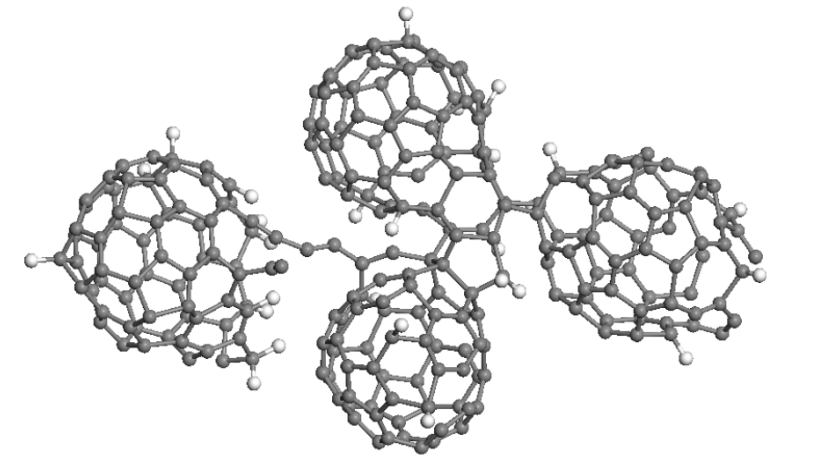
Coluci, Vitor; Sato, Fernando; Braga, Scheila F; Skaf, Munir S; Galvao, Douglas S
A molecular dynamics study of the rotational dynamics and polymerization of C60 in C60-cubane crystals Journal Article
Em: MRS Proceedings, vol. 1130, pp. 1130–W06, 2008.
Resumo | Links | BibTeX | Tags: Cubanes, Molecular Dynamics, Molecular Machines, Rotor-Stator
@article{coluci2008molecular,
title = {A molecular dynamics study of the rotational dynamics and polymerization of C60 in C60-cubane crystals},
author = {Coluci, Vitor and Sato, Fernando and Braga, Scheila F and Skaf, Munir S and Galvao, Douglas S},
url = {http://journals.cambridge.org/action/displayAbstract?fromPage=online&aid=7973166&fileId=S1946427400024088},
year = {2008},
date = {2008-01-01},
journal = {MRS Proceedings},
volume = {1130},
pages = {1130--W06},
publisher = {Cambridge University Press},
abstract = {Recently, heteromolecular crystals of fullerene C60 and cubane (C8H8) have been synthesized. For some temperatures the C60 molecules are free to rotate whereas cubanes behave like a static bearing in a so-called rotor-stator phases. In this work we report classical and tight-binding molecular dynamics simulations in order to investigate the rotor-stator dynamics and polymerization processes. Our results show that, for 200 K and 400 K, cubane molecules remain basically fixed, presenting only thermal vibrations within the timescale of our simulations, while C60 fullerenes show rotational motions. Fullerenes perform “free” rotational motions at short times (< 1 ps), small amplitude hindered rotational motions (librations) at intermediate times, and rotational diffusive dynamics at long times (> 10 ps). Random copolymerization among cubanes and fullerenes were observed when temperature is increased, leading to the formation of a disordered structure.},
keywords = {Cubanes, Molecular Dynamics, Molecular Machines, Rotor-Stator},
pubstate = {published},
tppubtype = {article}
}
Nakabayashi, D; Ugarte, D; Moreau, ALD; Coluci, VR; Galvao, DS; Cotta, MA
Carbon nanotubes as R-bars of high aspect ratio composite nanotools Technical Report
2008.
Resumo | Links | BibTeX | Tags: AFM tips, Carbon Nanotubes, Nanocomposites, Tribology
@techreport{nakabayashi2008carbonb,
title = {Carbon nanotubes as R-bars of high aspect ratio composite nanotools},
author = {Nakabayashi, D and Ugarte, D and Moreau, ALD and Coluci, VR and Galvao, DS and Cotta, MA},
url = {http://lnls.cnpem.br/ar2008/},
year = {2008},
date = {2008-01-01},
abstract = {Nano technology requires the development of nano scale tools to manipulate nano systems. From the point of view of materials science, this represents a serious challenge, because nano tools must meet a series of stringent requirements of shape (size, aspect ratio), mechanical, magnetic and electrical properties. We have developed long and narrow carbon-carbon composite nano tips using carbon nanotubes covered by an amorphous carbon shell; the very small nano tube tip remained uncoated to preserve apex size. This configuration renders the system stiffer and allows for the control of flexibility and vibrations. In addition, we have maintained the important nano tube properties of size, strength and resilience. Nano manipulation experiments in situ in a high resolution scanning electron microscope were used to optimize the tips behavior and molecular dynamics simulations were used to study the mechanical response. Finally, we performed a practical application in atomic force microscopy. Composite tips yielded excellent image resolution and showed remarkable wear resistance (no degradation of image quality after acquiring several hundred images). },
keywords = {AFM tips, Carbon Nanotubes, Nanocomposites, Tribology},
pubstate = {published},
tppubtype = {techreport}
}
2007
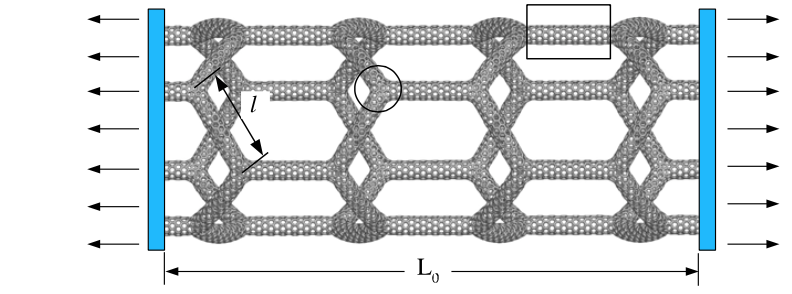
Coluci, Vitor R; Pugno, Nicola M; Dantas, Socrates O; Galvao, Douglas S; Jorio, Ado
Atomistic simulations of the mechanical properties of'super'carbon nanotubes Journal Article
Em: Nanotechnology, vol. 18, não 33, pp. 335702, 2007.
Resumo | Links | BibTeX | Tags: Fracture, Mechanical Properties, Molecular Dynamics, Super Carbons
@article{coluci2007atomistic,
title = {Atomistic simulations of the mechanical properties of'super'carbon nanotubes},
author = {Coluci, Vitor R and Pugno, Nicola M and Dantas, Socrates O and Galvao, Douglas S and Jorio, Ado},
url = {http://iopscience.iop.org/0957-4484/18/33/335702
},
year = {2007},
date = {2007-01-01},
journal = {Nanotechnology},
volume = {18},
number = {33},
pages = {335702},
publisher = {IOP Publishing},
abstract = {The mechanical properties of the so-called 'super' carbon nanotubes (STs) are investigated using classical molecular dynamics simulations. The STs are built from single-walled carbon nanotubes (SWCNTs) connected by Y-like junctions forming an ordered carbon nanotube network that is then rolled into a seamless cylinder. We observed that the ST behaviour under tensile tests is similar to the one presented by fishing nets. This interesting behaviour provides a way to vary the accessible channels to the inner parts of STs by applying an external mechanical load. The Young's modulus is dependent on the ST chirality and it inversely varies with the ST radius. Smaller reduction of breaking strain values due to temperature increase is predicted for zigzag STs compared to SWCNTs. The results show that, for STs with radius ~5 nm, the junctions between the constituent SWCNTs play an important role in the fracture process. The Young's modulus and tensile strength were estimated for hierarchical higher-order STs using scaling laws related to the ST fractal dimension. The obtained mechanical properties suggest that STs may be used in the development of new porous, flexible, and high-strength materials.},
keywords = {Fracture, Mechanical Properties, Molecular Dynamics, Super Carbons},
pubstate = {published},
tppubtype = {article}
}
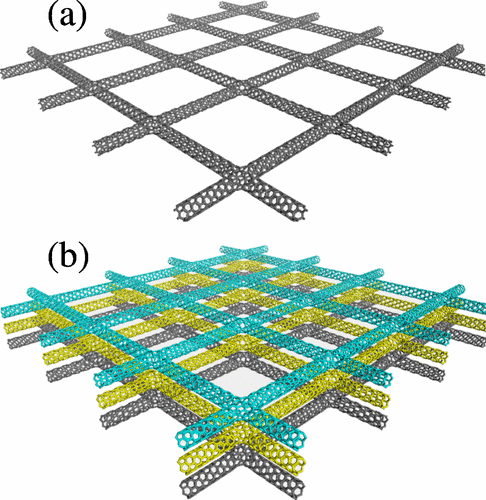
Coluci, VR; Dantas, SO; Jorio, A; Galvao, DS
Mechanical properties of carbon nanotube networks by molecular mechanics and impact molecular dynamics calculations Journal Article
Em: Physical Review B, vol. 75, não 7, pp. 075417, 2007.
Resumo | Links | BibTeX | Tags: Fracture, Mechanical Properties, Molecular Dynamics, Super Carbons
@article{coluci2007mechanical,
title = {Mechanical properties of carbon nanotube networks by molecular mechanics and impact molecular dynamics calculations},
author = {Coluci, VR and Dantas, SO and Jorio, A and Galvao, DS},
url = {http://journals.aps.org/prb/abstract/10.1103/PhysRevB.75.075417},
year = {2007},
date = {2007-01-01},
journal = {Physical Review B},
volume = {75},
number = {7},
pages = {075417},
publisher = {APS},
abstract = {We report a theoretical investigation of the mechanical properties of idealized networks formed by single-walled carbon nanotubes showing crossbar and hexagonal architectures. The study was performed by using molecular mechanics calculations and impact dynamics simulations based on bond-order empirical potential. The studied networks were predicted to have elasticity modulus of ∼10–100GPa and bulk modulus of ∼10GPa. The results show a transition from high to moderate flexibility during the deformation stages. This behavior was associated with the existence of two deformation mechanisms presented by the network related to the nanotube stretching and junction bending processes.},
keywords = {Fracture, Mechanical Properties, Molecular Dynamics, Super Carbons},
pubstate = {published},
tppubtype = {article}
}
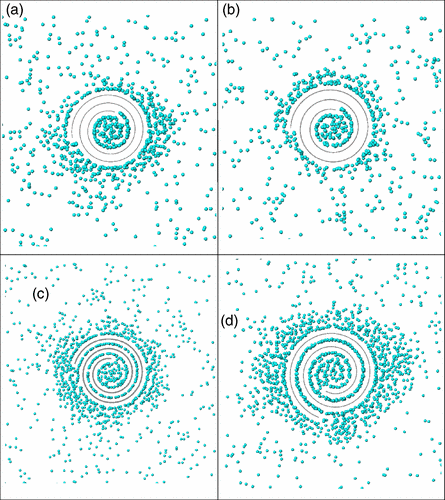
Coluci, VR; Braga, SF; Baughman, RH; Galvao, DS
Prediction of the hydrogen storage capacity of carbon nanoscrolls Journal Article
Em: Physical Review B, vol. 75, não 12, pp. 125404, 2007.
Resumo | Links | BibTeX | Tags: Hydrogen Storage, Molecular Dynamics, Monte Carlo, Scrolls
@article{coluci2007prediction,
title = {Prediction of the hydrogen storage capacity of carbon nanoscrolls},
author = {Coluci, VR and Braga, SF and Baughman, RH and Galvao, DS},
url = {http://journals.aps.org/prb/abstract/10.1103/PhysRevB.75.125404},
year = {2007},
date = {2007-01-01},
journal = {Physical Review B},
volume = {75},
number = {12},
pages = {125404},
publisher = {APS},
abstract = {Classical grand-canonical Monte Carlo simulations were performed to investigate the equilibrium hydrogen storage capacity of carbon nanoscrolls. The results show that hydrogen molecules can be absorbed in the internal cavity as well as on the external surface of the scroll when the interlayer spacing is less than 4.4Å. When the interlayer spacing is increased to 6.4Å, by assuming spacing increase due to intercalation of other species, the hydrogen molecules can also be incorporated in the interlayer galleries, doubling the gravimetric storage capacity and reaching 5.5wt% hydrogen per weight carbon at 150K and 1MPa. Our results showed that intercalated carbon nanoscrolls may be a promissing material for hydrogen storage.},
keywords = {Hydrogen Storage, Molecular Dynamics, Monte Carlo, Scrolls},
pubstate = {published},
tppubtype = {article}
}

Braga, SF; Coluci, VR; Baughman, RH; Galvao, DS
Hydrogen storage in carbon nanoscrolls: An atomistic molecular dynamics study Journal Article
Em: Chemical Physics Letters, vol. 441, não 1, pp. 78–82, 2007.
Resumo | Links | BibTeX | Tags: Hydrogen Storage, Molecular Dynamics, Scrolls
@article{braga2007hydrogen,
title = {Hydrogen storage in carbon nanoscrolls: An atomistic molecular dynamics study},
author = {Braga, SF and Coluci, VR and Baughman, RH and Galvao, DS},
url = {http://www.sciencedirect.com/science/article/pii/S0009261407005209},
year = {2007},
date = {2007-01-01},
journal = {Chemical Physics Letters},
volume = {441},
number = {1},
pages = {78--82},
publisher = {North-Holland},
abstract = {We report molecular dynamics results on the hydrogen uptake in carbon nanoscrolls (CNs). CNs are formed from helically wrapped graphite layers. We observed that at low temperatures significant H2 storage is possible, but at higher temperatures thermal energies drastically reduce this capacity. Only a small fraction of hydrogen is adsorbed between scroll layers. Using temperature as the sorption/desorption variable we have observed that hydrogen can be released from the CN by temperature increase and can be readsorbed when the system is cooled. Higher capacities are expected if the CNs interlayer spacings are increased, making them an attractive nanostructure for H2 storage having fast kinetics for charge/discharge.},
keywords = {Hydrogen Storage, Molecular Dynamics, Scrolls},
pubstate = {published},
tppubtype = {article}
}
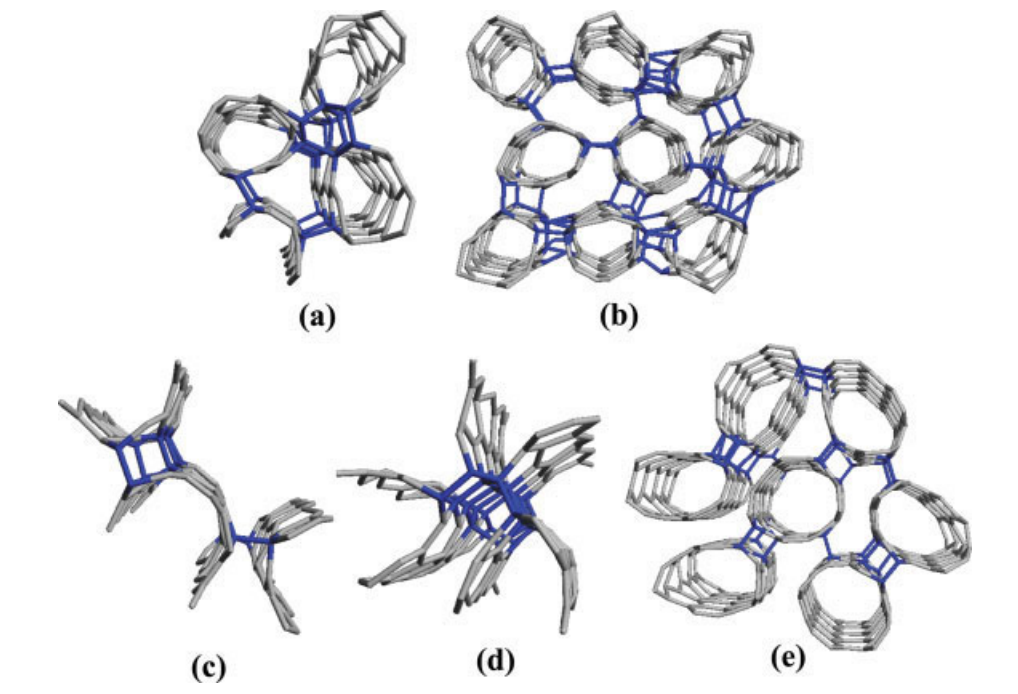
Braga, Scheila Furtado; Galvao, Douglas Soares
Molecular dynamics simulation of single wall carbon nanotubes polymerization under compression Journal Article
Em: Journal of Computational Chemistry, vol. 28, não 10, pp. 1724–1734, 2007.
Resumo | Links | BibTeX | Tags: Carbon Nanotubes, Mechanical Properties, Molecular Dynamics, New Structures, Polymerization
@article{braga2007molecular,
title = {Molecular dynamics simulation of single wall carbon nanotubes polymerization under compression},
author = {Braga, Scheila Furtado and Galvao, Douglas Soares},
url = {http://onlinelibrary.wiley.com/store/10.1002/jcc.20684/asset/20684_ftp.pdf?v=1&t=i52l5iyb&s=94cda082eed01cd61890fffe50aad5e26cdda7d1},
year = {2007},
date = {2007-01-01},
journal = {Journal of Computational Chemistry},
volume = {28},
number = {10},
pages = {1724--1734},
publisher = {Wiley Subscription Services, Inc., A Wiley Company},
abstract = {Single wall carbon nanotubes (SWCNTs) often aggregate into bundles of hundreds of weakly interacting
tubes. Their cross-polymerization opens new possibilities for the creation of new super-hard materials. New mechanical
and electronic properties are expected from these condensed structures, as well as novel potential applications. Previous
theoretical results presented geometric modifications involving changes in the radial section of the compressed tubes
as the explanation to the experimental measurements of structural changes during tube compression. We report here
results from molecular dynamics simulations of the SWCNTs polymerization for small diameter arm chair tubes under
compression. Hydrostatic and piston-type compression of SWCNTs have been simulated for different temperatures and
rates of compression. Our results indicate that large diameter tubes (10,10) are unlike to polymerize while small diameter
ones (around 5 Å) polymerize even at room temperature. Other interesting results are the observation of the appearance
of spontaneous scroll-like structures and also the so-called tubulane motifs, which were predicted in the literature more
than a decade ago},
keywords = {Carbon Nanotubes, Mechanical Properties, Molecular Dynamics, New Structures, Polymerization},
pubstate = {published},
tppubtype = {article}
}
tubes. Their cross-polymerization opens new possibilities for the creation of new super-hard materials. New mechanical
and electronic properties are expected from these condensed structures, as well as novel potential applications. Previous
theoretical results presented geometric modifications involving changes in the radial section of the compressed tubes
as the explanation to the experimental measurements of structural changes during tube compression. We report here
results from molecular dynamics simulations of the SWCNTs polymerization for small diameter arm chair tubes under
compression. Hydrostatic and piston-type compression of SWCNTs have been simulated for different temperatures and
rates of compression. Our results indicate that large diameter tubes (10,10) are unlike to polymerize while small diameter
ones (around 5 Å) polymerize even at room temperature. Other interesting results are the observation of the appearance
of spontaneous scroll-like structures and also the so-called tubulane motifs, which were predicted in the literature more
than a decade ago
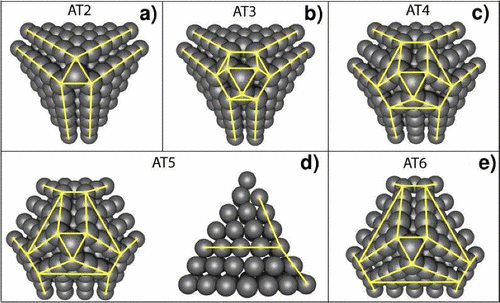
Rodrigues, V; Sato, F; Galvao, DS; Ugarte, D
Size limit of defect formation in pyramidal Pt nanocontacts Journal Article
Em: Physical Review Letters, vol. 99, não 25, pp. 255501, 2007.
Resumo | Links | BibTeX | Tags: DFT, Metallic Nanowires, Platinum, Structure, TEM, top20
@article{rodrigues2007size,
title = {Size limit of defect formation in pyramidal Pt nanocontacts},
author = {Rodrigues, V and Sato, F and Galvao, DS and Ugarte, D},
url = {http://journals.aps.org/prl/abstract/10.1103/PhysRevLett.99.255501},
year = {2007},
date = {2007-01-01},
journal = {Physical Review Letters},
volume = {99},
number = {25},
pages = {255501},
publisher = {American Physical Society},
abstract = {We report high resolution transmission electron microscopy and ab initio calculation results for defect formation in sharp pyramidal Pt nanocontacts. Our results show that there is a size limit to the existence of twins (extended structural defects). These defects are always present but blocked away from the tip axes. They may act as scattering planes, influencing the electron conductance for Pt nanocontacts at room temperature and Ag/Au nanocontacts at low temperature (<150 K).},
keywords = {DFT, Metallic Nanowires, Platinum, Structure, TEM, top20},
pubstate = {published},
tppubtype = {article}
}
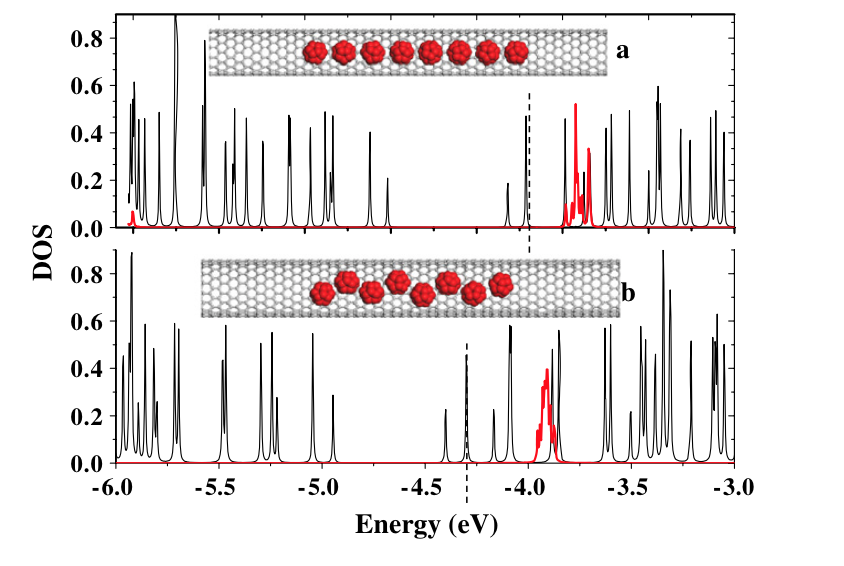
Troche, KS; Coluci, VR; Rurali, R; Galvao, DS
Structural and electronic properties of zigzag carbon nanotubes filled with small fullerenes Journal Article
Em: Journal of Physics: Condensed Matter, vol. 19, não 23, pp. 236222, 2007.
Resumo | Links | BibTeX | Tags: Carbon Nanotubes, CNT encapsulation, Electronic Structure, Fullerenes, Peapods
@article{troche2007structural,
title = {Structural and electronic properties of zigzag carbon nanotubes filled with small fullerenes},
author = {Troche, KS and Coluci, VR and Rurali, R and Galvao, DS},
url = {http://iopscience.iop.org/0953-8984/19/23/236222},
year = {2007},
date = {2007-01-01},
journal = {Journal of Physics: Condensed Matter},
volume = {19},
number = {23},
pages = {236222},
publisher = {IOP Publishing},
abstract = {In this work we investigated the encapsulation of C20 and C30 fullerenes into semiconducting carbon nanotubes to study the possibility of bandgap engineering in such systems. Classical molecular dynamics simulations coupled to tight-binding calculations were used to determine the conformational and electronic properties of carbon nanotubes with an increasing fullerene concentration. We have observed that C20 fullerenes behave similarly to a n-type dopant while C30 can provide p-type doping in some cases. The combined incorporation of both types of fullerenes (hybrid encapsulation) into the same nanotube leads to a behaviour similar to that found in electronic pn-junctions. These aspects can be exploited in the design of nanoelectronic devices using semiconducting carbon nanotubes.
},
keywords = {Carbon Nanotubes, CNT encapsulation, Electronic Structure, Fullerenes, Peapods},
pubstate = {published},
tppubtype = {article}
}
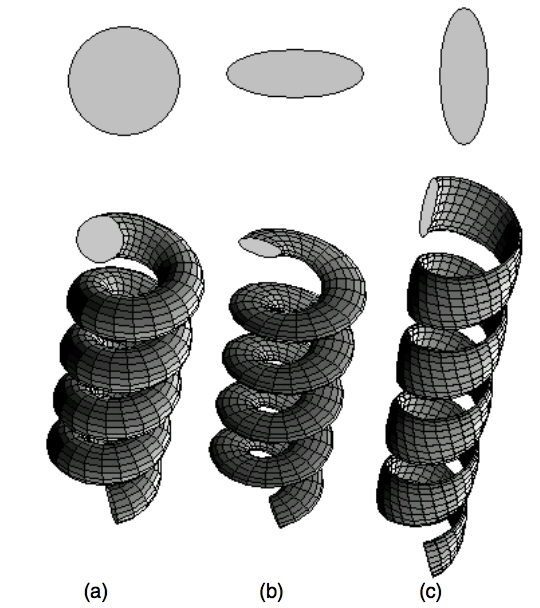
Fonseca, Alexandre F; Malta, CP; Galvao, DS
Is it possible to grow amorphous normal nanosprings? Journal Article
Em: Nanotechnology, vol. 18, não 43, pp. 435606, 2007.
Resumo | Links | BibTeX | Tags: Elasticity, Helical Structures, Mechanical Properties, Nanowires
@article{fonseca2007possible,
title = {Is it possible to grow amorphous normal nanosprings?},
author = {Fonseca, Alexandre F and Malta, CP and Galvao, DS},
url = {http://iopscience.iop.org/0957-4484/18/43/435606},
year = {2007},
date = {2007-01-01},
journal = {Nanotechnology},
volume = {18},
number = {43},
pages = {435606},
publisher = {IOP Publishing},
abstract = {Nanosprings have been objects of intense investigations in recent years. They can be classified as normal or binormal depending on the geometry of their cross-section. As normal amorphous nanosprings have not yet been observed experimentally, we have decided to investigate this matter. We discuss the shape of the catalyst in terms of the cross-sectional shape of the nanospring and show that, within the vapor–liquid–solid model, the growth of amorphous binormal nanosprings is energetically favored.},
keywords = {Elasticity, Helical Structures, Mechanical Properties, Nanowires},
pubstate = {published},
tppubtype = {article}
}
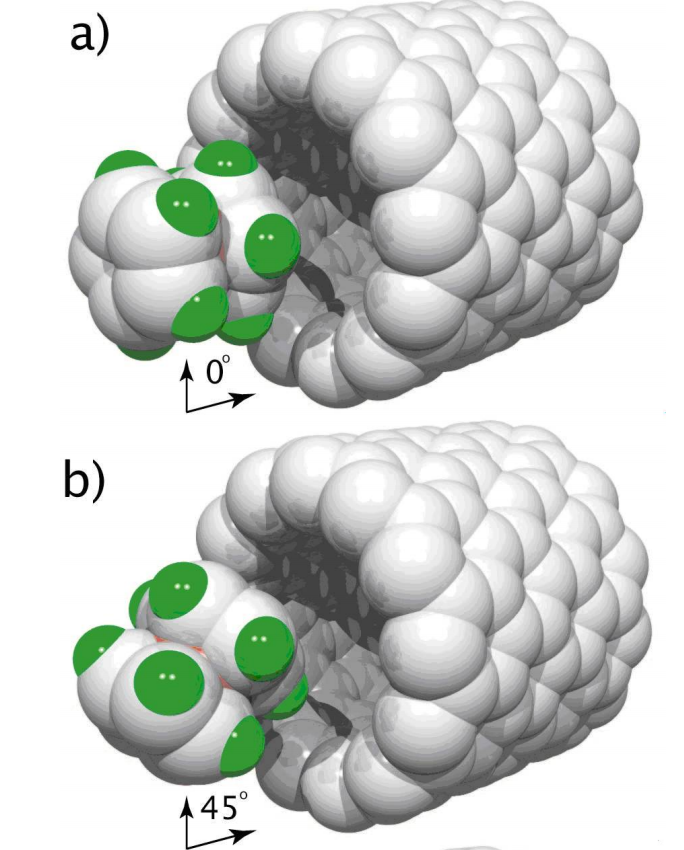
Azevedo, David L; Sato, Fernando; Galvao, Douglas S; others,
Cobaltocene encapsulation into single-walled carbon nanotubes: A molecular dynamics investigation Journal Article
Em: arXiv preprint arXiv:0707.3831, 2007.
Resumo | Links | BibTeX | Tags: CNT encapsulation, Cobaltocene, Molecular Dynamics
@article{azevedo2007cobaltocene,
title = {Cobaltocene encapsulation into single-walled carbon nanotubes: A molecular dynamics investigation},
author = {Azevedo, David L and Sato, Fernando and Galvao, Douglas S and others},
url = {http://arxiv.org/abs/0707.3831},
year = {2007},
date = {2007-01-01},
journal = {arXiv preprint arXiv:0707.3831},
abstract = {Recently (PRL 96, 106804 (2006)) it was suggested that cobaltocene(CC) molecules encapsulated into (7,7) carbon nanotubes (CNT@(7,7)) could be the basis for new spintronic devices. We show here based on impact molecular dynamics and DFT calculations that when dynamical aspects are explicitly considered the CC encapsulation into CNT@(7,7) does not occur, it is prevented by a dynamic barrier mainly due to van der Waals interactions. Our results show that CNT@(13,0) having enough axial space for encapsulation but no enough one to allow freely rotation of the cobaltocene molecule would be a feasible candidate to such application.
},
keywords = {CNT encapsulation, Cobaltocene, Molecular Dynamics},
pubstate = {published},
tppubtype = {article}
}
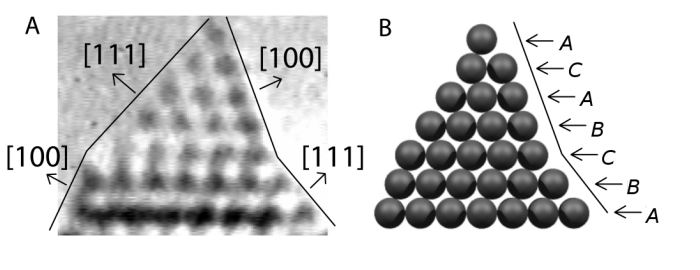
Rodrigues, Varlei; Sato, Fernando; Galvao, Douglas S; Ugarte, Daniel
Is Small Perfect? Size Limit to Defect Formation in Pyramidal Pt Nanocontacts Journal Article
Em: arXiv preprint arXiv:0707.4187, 2007.
Resumo | Links | BibTeX | Tags: Defects, DFT, Metallic Nanowires, Structure, TEM
@article{rodrigues2007small,
title = {Is Small Perfect? Size Limit to Defect Formation in Pyramidal Pt Nanocontacts},
author = {Rodrigues, Varlei and Sato, Fernando and Galvao, Douglas S and Ugarte, Daniel},
url = {http://xxx.tau.ac.il/abs/0707.4187},
year = {2007},
date = {2007-01-01},
journal = {arXiv preprint arXiv:0707.4187},
abstract = {We report high resolution transmission electron microscopy and ab initio calculation results for the defect formation in Pt nanocontacts (NCs). Our results show that there is a size limit to the existence of twins (extended structural defects). Defects are always present but blocked away from the tip axes. The twins may act as scattering plane, influencing contact electron transmission for Pt NC at room temperature and Ag/Au NC at low temperature.},
keywords = {Defects, DFT, Metallic Nanowires, Structure, TEM},
pubstate = {published},
tppubtype = {article}
}
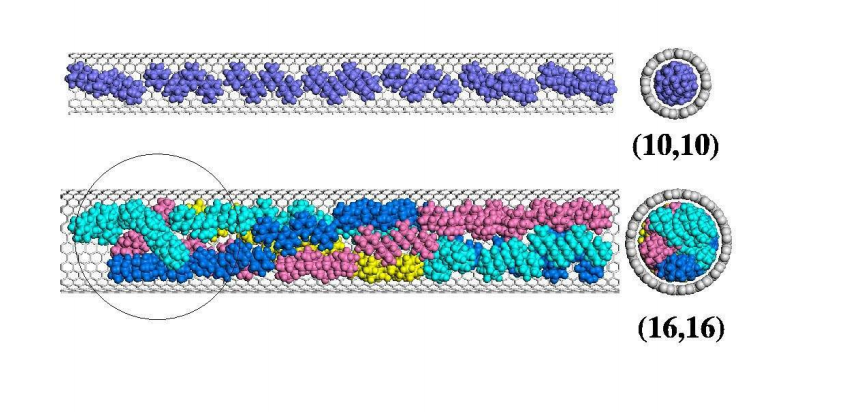
Troche, Karla S; Coluci, Vitor R; Galvao, Douglas S
Atomistic study of the encapsulation of diamondoids inside carbon nanotubes Journal Article
Em: arXiv preprint arXiv:0707.1777, 2007.
Resumo | Links | BibTeX | Tags: CNT encapsulation, Diamondoids, Molecular Dynamics
@article{troche2007atomistic,
title = {Atomistic study of the encapsulation of diamondoids inside carbon nanotubes},
author = {Troche, Karla S and Coluci, Vitor R and Galvao, Douglas S},
url = {http://arxiv.org/abs/0707.1777},
year = {2007},
date = {2007-01-01},
journal = {arXiv preprint arXiv:0707.1777},
abstract = {The encapsulation of hydrogen-terminated nanosized diamond fragments (the so-called diamondoids) into armchair single walled carbon nanotubes with diameters in the range of 1.0 up to 2.2 nm has been investigated using classical molecular dynamics simulations. Diameter dependent molecular ordered phases were found for the encapsulation of adamantane (C10H16), diamantane (C14H20), and dihydroxy diamantane (C14H20O2). The same types of chiral ordered phases (double, triple, 4- and 5-stranded helices) observed for the encapsulation of C60 molecules were also observed for diamondoids. On the other hand, some achiral phases comprising layered structures were not observed. Our results also indicate that the modification of diamantane through functionalization with hydroxyl groups can lead to an enhancement of the packing of molecules inside the nanotubes compared to nonfunctionalized compounds. Comparisons to hard-sphere models are also presented revealing differences, specially when more asymmetrical diamondoids are considered. For larger structures (adamantane tetramers) we have not observed long-range ordering for nanotubes with diameters in the range of 1.49 to 2.17 nm but only a tendency to form incomplete helical structures.},
keywords = {CNT encapsulation, Diamondoids, Molecular Dynamics},
pubstate = {published},
tppubtype = {article}
}
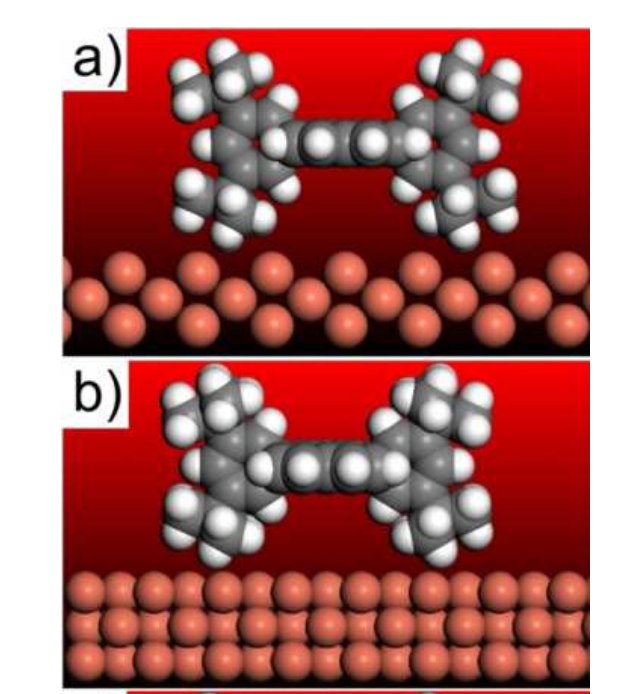
Sato, F; Legoas, SB; Otero, R; Hummelink, F; Thostrup, P; Lægsgaard, E; Stensgaard, I; Besenbacher, F; Galvao, DS
Molecular Recognition Effects in the Surface Diffusion of Large Organic Molecules: The Case of Violet Lander Journal Article
Em: arXiv preprint arXiv:0708.2915, 2007.
Resumo | Links | BibTeX | Tags: Molecular Dynamics, Molecular Machines, Organic-Inorganic Interfaces, Violet Landers
@article{sato2007molecular,
title = {Molecular Recognition Effects in the Surface Diffusion of Large Organic Molecules: The Case of Violet Lander},
author = {Sato, F and Legoas, SB and Otero, R and Hummelink, F and Thostrup, P and Lægsgaard, E and Stensgaard, I and Besenbacher, F and Galvao, DS},
url = {http://xxx.tau.ac.il/pdf/0708.2915.pdf},
year = {2007},
date = {2007-01-01},
journal = {arXiv preprint arXiv:0708.2915},
abstract = {Violet Lander (VL) (C108H104) is a large organic molecule that when deposited on Cu (110)
exhibited lock-and-key like behavior (Otero et al., Nature Mater. 3, 779 (2004)). In this work we
report on a detailed fully atomistic molecular dynamics study of this phenomenon. Our results show
that it has its physical basis in the interplay of the molecular hydrogens and the Cu(110) atomic
spacing, which is a direct consequence of an accidental commensurability between molecule and
surface dimensions. This knowledge could be used to engineer new molecules capable of displaying
lock-and-key behavior with new potential applications in nanotechology},
keywords = {Molecular Dynamics, Molecular Machines, Organic-Inorganic Interfaces, Violet Landers},
pubstate = {published},
tppubtype = {article}
}
exhibited lock-and-key like behavior (Otero et al., Nature Mater. 3, 779 (2004)). In this work we
report on a detailed fully atomistic molecular dynamics study of this phenomenon. Our results show
that it has its physical basis in the interplay of the molecular hydrogens and the Cu(110) atomic
spacing, which is a direct consequence of an accidental commensurability between molecule and
surface dimensions. This knowledge could be used to engineer new molecules capable of displaying
lock-and-key behavior with new potential applications in nanotechology
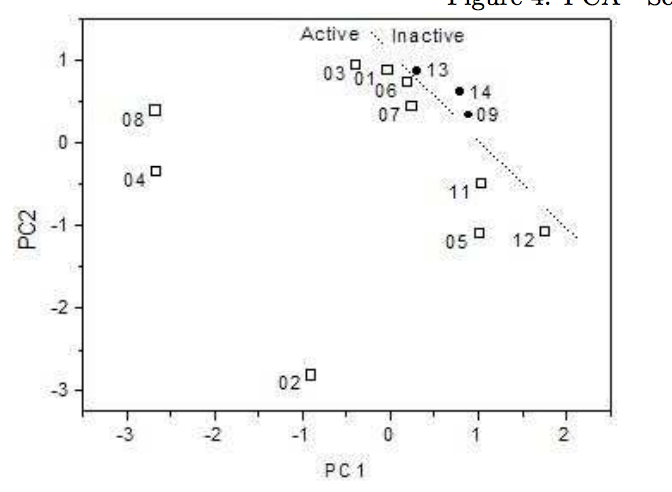
Sato, Fernando; Braga, Scheila F; Santos, Helio F dos; Galvao, Douglas S
Structure-Activity Relationship Investigation of Some New Tetracyclines by Electronic Index Methodology Journal Article
Em: arXiv preprint arXiv:0708.2931, 2007.
Resumo | Links | BibTeX | Tags: Drug Design, Electronic Structure, Neural Networks, PCA/HCA, Tetracyclines, Theory of Electronic Indices
@article{sato2007structure,
title = {Structure-Activity Relationship Investigation of Some New Tetracyclines by Electronic Index Methodology},
author = {Sato, Fernando and Braga, Scheila F and Santos, Helio F dos and Galvao, Douglas S},
url = {http://arxiv.org/abs/0708.2931},
year = {2007},
date = {2007-01-01},
journal = {arXiv preprint arXiv:0708.2931},
abstract = {Tetracyclines are an old class of molecules that constitute a broad-spectrum antibiotics. Since the first member of tetracycline family were isolated, the clinical importance of these compounds as therapeutic and prophylactic agents against a wide range of infections has stimulated efforts to define their mode of action as inhibitors of bacterial reproduction. We used three SAR methodologies for the analysis of biological activity of a set of 104 tetracycline compounds. Our calculation were carried out using the semi-empirical Austin Method One (AM1) and Parametric Method 3 (PM3). Electronic Indices Methodology (EIM), Principal Component Analysis (PCA) and Artificial Neural Networks (ANN) were applied to the classification of 14 old and 90 new proposed derivatives of tetracyclines. Our results make evident the importance of EIM descriptors in pattern recognition and also show that the EIM can be effectively used to predict the biological activity of Tetracyclines.},
keywords = {Drug Design, Electronic Structure, Neural Networks, PCA/HCA, Tetracyclines, Theory of Electronic Indices},
pubstate = {published},
tppubtype = {article}
}
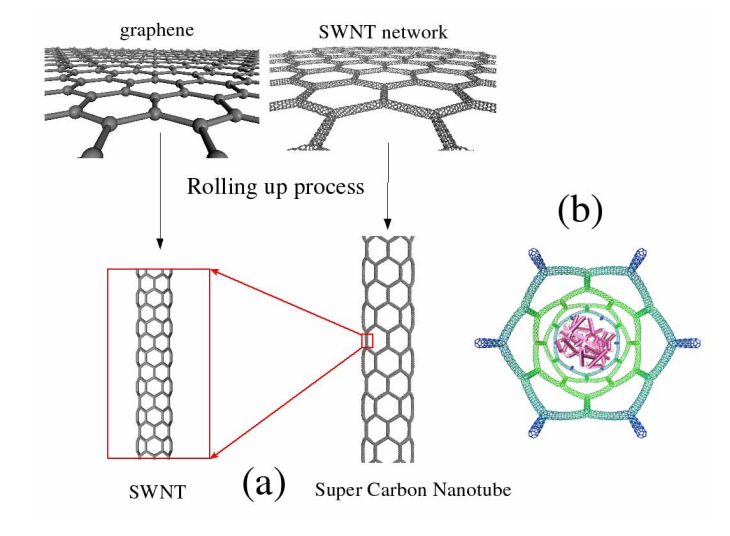
Coluci, VR; Dantas, SO; Jorio, A; Galvao, DS
Electronic and Mechanical Properties of Super Carbon Nanotube Networks Proceedings
Warrendale, Pa.; Materials Research Society; 1999, vol. 963, 2007.
Resumo | Links | BibTeX | Tags: Fracture, Mechanical Properties, Molecular Dynamics, Super Carbons
@proceedings{coluci2007electronic,
title = {Electronic and Mechanical Properties of Super Carbon Nanotube Networks},
author = {Coluci, VR and Dantas, SO and Jorio, A and Galvao, DS},
url = {http://journals.cambridge.org/action/displayAbstract?fromPage=online&aid=8026810&fulltextType=RA&fileId=S1946427400054014},
year = {2007},
date = {2007-01-01},
journal = {MATERIALS RESEARCH SOCIETY SYMPOSIUM PROCEEDINGS},
volume = {963},
pages = {1},
publisher = {Warrendale, Pa.; Materials Research Society; 1999},
abstract = {Eletronic and mechanical properties of ordered carbon nanotube networks are studied using molecular dynamics simulations and tight-binding calculations. These networks are formed by single walled carbon nanotubes (SWNT) regularly connected by junctions. The use of different types of junctions (“Y”-, “X”-like junctions, for example) allows the construction of networks with different symmetries. These networks can be very flexible and the elastic deformation was associated with two main deformation mechanisms (bending and stretching ) of the constituents SWNTs. Rolling up the networks, “super” carbon nanotubes can be constructed. These super-tubes share some of the main electronic features of the SWNT which form them but important changes are predicted (e.g. reduction of bandgap value). Simulations of their deformations under tensile stress have revealed that the super-tubes are softer than the corresponding SWNT and that their rupture occur in higher strain values.},
keywords = {Fracture, Mechanical Properties, Molecular Dynamics, Super Carbons},
pubstate = {published},
tppubtype = {proceedings}
}
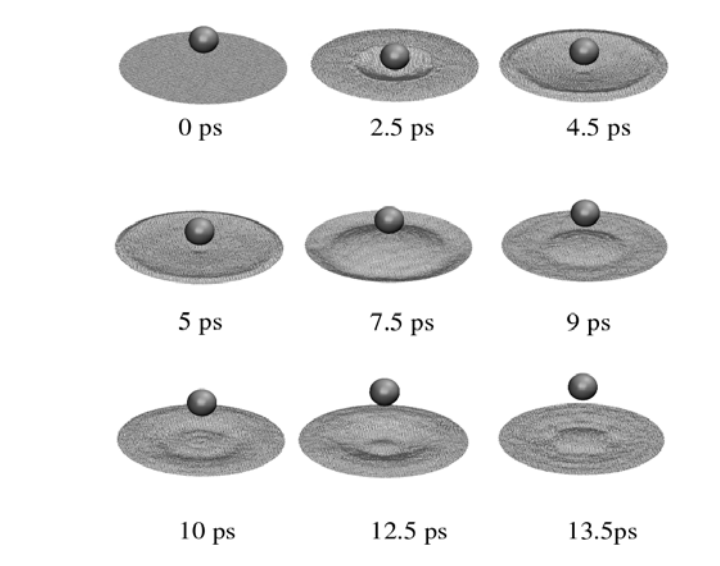
Pugno, Nicola; Coluci, V; Galvao, DS
Nanotube-or graphene-based nanoarmors Book Chapter
Em: Computational & Experimental Analysis of Damaged Materials, pp. 145-154 , 2007.
Resumo | Links | BibTeX | Tags: Elasticity, Mechanical Properties, Molecular Dynamics, Super Carbons
@inbook{pugno2007nanotube,
title = {Nanotube-or graphene-based nanoarmors},
author = {Pugno, Nicola and Coluci, V and Galvao, DS},
url = {http://www.ing.unitn.it/~pugno/NP_PDF/IV/5-COLUCI07.pdf},
year = {2007},
date = {2007-01-01},
booktitle = {Computational & Experimental Analysis of Damaged Materials},
pages = {145-154 },
abstract = { In this paper, nanoimpacts on hexagonal or
crossbar nanotube networks as well as on graphene
sheets are investigated by elasticity and finite
kinematics or impact molecular dynamic simulations.
A transition from bending to stretching by increasing
the impact kinetic energy of the nanoprojectile is
clearly observed. The analysis suggests that the
investigated nanotextures are ideal for designing
futuristic nanoarmors. },
keywords = {Elasticity, Mechanical Properties, Molecular Dynamics, Super Carbons},
pubstate = {published},
tppubtype = {inbook}
}
crossbar nanotube networks as well as on graphene
sheets are investigated by elasticity and finite
kinematics or impact molecular dynamic simulations.
A transition from bending to stretching by increasing
the impact kinetic energy of the nanoprojectile is
clearly observed. The analysis suggests that the
investigated nanotextures are ideal for designing
futuristic nanoarmors.

Fonseca, AD; Malta, CP; Galvao, DS
Elastic Properties of Normal and Binormal Helical Nanowires Proceedings
Warrendale, Pa.; Materials Research Society; 1999, vol. 963, 2007.
Resumo | Links | BibTeX | Tags: Elasticity, Helical Structures, Mechanical Properties, Nanowires
@proceedings{fonseca2007elastic,
title = {Elastic Properties of Normal and Binormal Helical Nanowires},
author = {Fonseca, AD and Malta, CP and Galvao, DS},
url = {http://journals.cambridge.org/action/displayAbstract?fromPage=online&aid=8026852},
year = {2007},
date = {2007-01-01},
journal = {MATERIALS RESEARCH SOCIETY SYMPOSIUM PROCEEDINGS},
volume = {963},
pages = {88},
publisher = {Warrendale, Pa.; Materials Research Society; 1999},
abstract = {A helical nanowire can be defined as being a nanoscopic rod whose axis follows a helical curve in space. In the case of a nanowire with asymmetric cross section, the helical nanostructure can be classified as normal or binormal helix, according to the orientation of the cross section with respect to the helical axis of the structure. In this work, we present a simple model to study the elastic properties of a helical nanowire with asymmetric cross section. We use the framework of the Kirchhoff rod model to obtain an expression relating the Hooke's constant, h, of normal and binormal nanohelices to their geometric features. We also obtain the Young's modulus values. These relations can be used by experimentalists to evaluate the elastic properties of helical nanostructures. We showed that the Hooke's constant of a normal nanohelix is higher than that of a binormal one. We illustrate our results using experimentally obtained nanohelices reported in the literature.},
keywords = {Elasticity, Helical Structures, Mechanical Properties, Nanowires},
pubstate = {published},
tppubtype = {proceedings}
}
2006
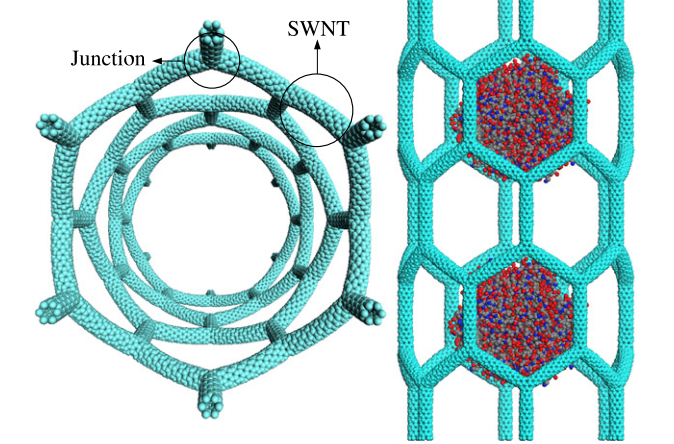
Coluci, Vitor R; Galvao, Douglas S; Jorio, A
Geometric and electronic structure of carbon nanotube networks:'super'-carbon nanotubes Journal Article
Em: Nanotechnology, vol. 17, não 3, pp. 617, 2006.
Resumo | Links | BibTeX | Tags: DFT, Mechanical Properties, Molecular Dynamics, Super Carbons
@article{coluci2006geometric,
title = {Geometric and electronic structure of carbon nanotube networks:'super'-carbon nanotubes},
author = {Coluci, Vitor R and Galvao, Douglas S and Jorio, A},
url = {http://iopscience.iop.org/0957-4484/17/3/001},
year = {2006},
date = {2006-01-01},
journal = {Nanotechnology},
volume = {17},
number = {3},
pages = {617},
publisher = {IoP Publishing},
abstract = {Structures of the so-called super-carbon nanotubes are proposed. These structures are built from single walled carbon nanotubes connected by Y-like junctions forming a 'super'-sheet that is then rolled into a seamless cylinder. Such a procedure can be repeated several times, generating a fractal structure. This procedure is not limited to carbon nanotubes, and can be easily modified for application to other systems. Tight binding total energy and density of states calculations showed that the 'super'-sheets and tubes are stable and predicted to present metallic and semiconducting behaviour.},
keywords = {DFT, Mechanical Properties, Molecular Dynamics, Super Carbons},
pubstate = {published},
tppubtype = {article}
}

Bettini, Jefferson; Sato, Fernando; Coura, Pablo Zimmerman; Dantas, SO; Galvao, Douglas Soares; Ugarte, Daniel
Experimental realization of suspended atomic chains composed of different atomic species Journal Article
Em: Nature Nanotechnology, vol. 1, não 3, pp. 182–185, 2006.
Resumo | Links | BibTeX | Tags: Metallic Nanowires, Molecular Dynamics, TEM, top20
@article{bettini2006experimental,
title = {Experimental realization of suspended atomic chains composed of different atomic species},
author = {Bettini, Jefferson and Sato, Fernando and Coura, Pablo Zimmerman and Dantas, SO and Galvao, Douglas Soares and Ugarte, Daniel},
url = {http://www.nature.com/nnano/journal/v1/n3/full/nnano.2006.132.html},
year = {2006},
date = {2006-01-01},
journal = {Nature Nanotechnology},
volume = {1},
number = {3},
pages = {182--185},
publisher = {Nature Publishing Group},
abstract = {Research into nanostructured materials frequently relates to pure substances. This contrasts with industrial applications, where chemical doping or alloying is often used to enhance the electrical or mechanical properties of materials1. However, the controlled preparation of doped nanomaterials has been much more difficult than expected because the increased surface-area-to-volume ratio can, for instance, lead to the expulsion of impurities (self-purification)2. For nanostructured alloys, the influence of growth methods and the atomic structure on self-purification is still open to investigation2, 3. Here, we explore, experimentally and with molecular dynamics simulations, to what extent alloying persists in the limit that a binary metal is mechanically stretched to a linear chain of atoms. Our results reveal a gradual evolution of the arrangement of the different atomic elements in the narrowest region of the chain, where impurities may be expelled to the surface or enclosed during elongation.
},
keywords = {Metallic Nanowires, Molecular Dynamics, TEM, top20},
pubstate = {published},
tppubtype = {article}
}
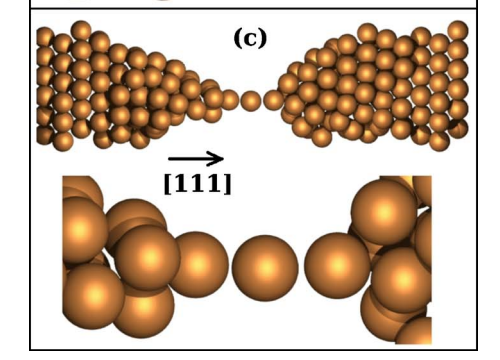
Sato, F; Moreira, AS; Bettini, J; Coura, PZ; Dantas, SO; Ugarte, D; Galvao, DS
Transmission electron microscopy and molecular dynamics study of the formation of suspended copper linear atomic chains Journal Article
Em: Physical Review-Section B-Condensed Matter, vol. 74, não 19, pp. 193401–193401, 2006.
Resumo | Links | BibTeX | Tags: Linear Atomic Chains, Metallic Nanowires, Molecular Dynamics, TEM
@article{sato2006surface,
title = {Transmission electron microscopy and molecular dynamics study of the formation of suspended copper linear atomic chains},
author = {Sato, F and Moreira, AS and Bettini, J and Coura, PZ and Dantas, SO and Ugarte, D and Galvao, DS},
url = {http://journals.aps.org/prb/abstract/10.1103/PhysRevB.74.193401},
year = {2006},
date = {2006-01-01},
journal = {Physical Review-Section B-Condensed Matter},
volume = {74},
number = {19},
pages = {193401--193401},
publisher = {Woodbury, NY: published by the American Physical Society through the American Institute of Physics, c1998-},
abstract = {We report high-resolution transmission electron microscopy and molecular dynamics simulation results of mechanically stretching nanowires leading to linear atomic suspended chain (LAC) formation. In contrast with some previous experimental and theoretical works in the literature that stated that the formation of LAC’s for copper should be unlikely our results showed the existence of LAC’s for the [111], [110], and [100] crystallographic directions, being thus the sequence of most probable occurrence. Our results clearly indicate that temperture and pulling velocity, associated with internal stress, are fundamental aspects to determine LAC formation.},
keywords = {Linear Atomic Chains, Metallic Nanowires, Molecular Dynamics, TEM},
pubstate = {published},
tppubtype = {article}
}
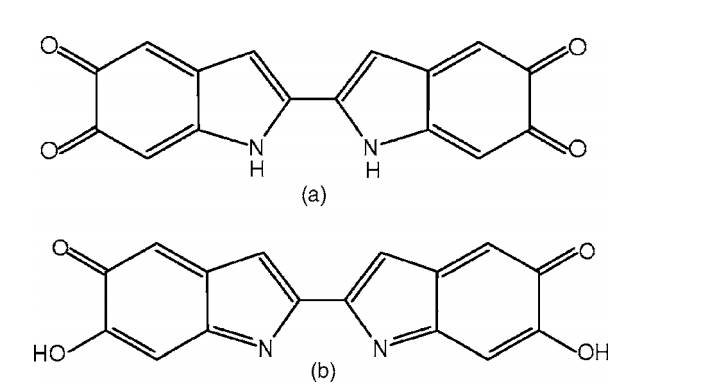
Lorite, Gabriela S; Coluci, Vitor R; da Silva, Maria Ivonete N; Deziderio, Shirlei N; Graeff, Carlos Frederico O; Galvao, Douglas S; Cotta, Monica A
Synthetic melanin films: Assembling mechanisms, scaling behavior, and structural properties Journal Article
Em: Journal of Applied Physics, vol. 99, não 11, pp. 113511, 2006.
Resumo | Links | BibTeX | Tags: Electronic Structure, Melanin, Structure
@article{lorite2006synthetic,
title = {Synthetic melanin films: Assembling mechanisms, scaling behavior, and structural properties},
author = {Lorite, Gabriela S and Coluci, Vitor R and da Silva, Maria Ivonete N and Deziderio, Shirlei N and Graeff, Carlos Frederico O and Galvao, Douglas S and Cotta, Monica A},
url = {http://scitation.aip.org/content/aip/journal/jap/99/11/10.1063/1.2200401},
year = {2006},
date = {2006-01-01},
journal = {Journal of Applied Physics},
volume = {99},
number = {11},
pages = {113511},
publisher = {AIP Publishing},
abstract = {In this work we report on the surface characterization of melanin thin films prepared using both water-based and organic solvent-based melanin syntheses. Atomic force microscopy(AFM) analysis of these films suggests that the organic solvent synthesis provides relatively planar basic melanin structures; these basic structures generate surface steps with height in the range of 2–3nm and small tendency to form larger aggregates. The scaling properties obtained from the AFM data were used to infer the assembling mechanisms of these thin films which depend on the solvent used for melanin synthesis. The behavior observed in organic solvent-based melanin suggests a diffusion-limited aggregation process. Thus films with good adhesion to the substrate and smoother morphologies than water-prepared melanin films are obtained. Electronic structure calculations using a conductorlike screening model were also performed in order to elucidate the microscopic processes of thin film formation. Our results suggest that the agglomerates observed in hydrated samples originate from reaction with water at specific locations on the surface most likely defects on the planar structure.},
keywords = {Electronic Structure, Melanin, Structure},
pubstate = {published},
tppubtype = {article}
}
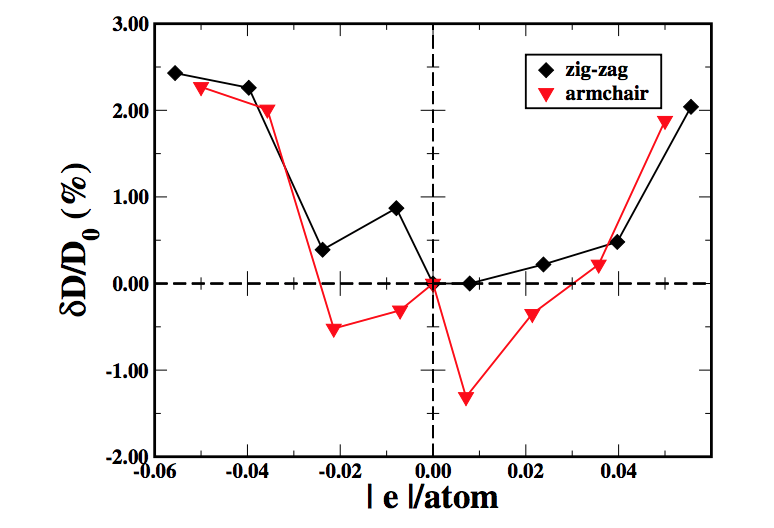
Rurali, R; Coluci, VR; Galvao, DS
Prediction of giant electroactuation for papyruslike carbon nanoscroll structures: first-principles calculations Journal Article
Em: Physical Review B, vol. 74, não 8, pp. 085414, 2006.
Resumo | Links | BibTeX | Tags: DFT, Electronic Structure, Eletroactuation, Scrolls
@article{rurali2006prediction,
title = {Prediction of giant electroactuation for papyruslike carbon nanoscroll structures: first-principles calculations},
author = {Rurali, R and Coluci, VR and Galvao, DS},
url = {http://journals.aps.org/prb/abstract/10.1103/PhysRevB.74.085414},
year = {2006},
date = {2006-01-01},
journal = {Physical Review B},
volume = {74},
number = {8},
pages = {085414},
publisher = {American Physical Society},
abstract = {We study by first-principles calculations the electromechanical response of carbon nanoscroll structures. We show that although they present a very similar behavior to carbon nanotubes in their axial deformation sensitivity, they exhibit a radial response upon charge injection which is up to one order of magnitude larger. In association with their high stability, this behavior makes them a natural choice for a new class of very efficient nanoactuators.},
keywords = {DFT, Electronic Structure, Eletroactuation, Scrolls},
pubstate = {published},
tppubtype = {article}
}
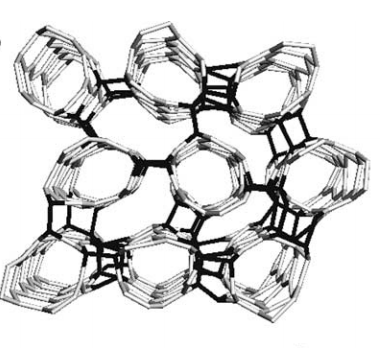
Braga, SF; Galvao, DS
Single wall carbon nanotubes polymerization under compression: An atomistic molecular dynamics study Journal Article
Em: Chemical physics letters, vol. 419, não 4, pp. 394–399, 2006.
Resumo | Links | BibTeX | Tags: Carbon Nanotubes, Molecular Dynamics, Polymerization
@article{braga2006single,
title = {Single wall carbon nanotubes polymerization under compression: An atomistic molecular dynamics study},
author = {Braga, SF and Galvao, DS},
url = {http://www.sciencedirect.com/science/article/pii/S0009261405018592},
year = {2006},
date = {2006-01-01},
journal = {Chemical physics letters},
volume = {419},
number = {4},
pages = {394--399},
publisher = {Elsevier},
abstract = {Recently, it was reported experimental observations of crosslinking between carbon nanotubes (CNTs) under pressure. Similarly to CNT growth formation the details of these polymerization processes are still unclear. In this work, we report a molecular dynamics simulation of the polymerization of a bundle of single-wall carbon nanotubes under compression using Brenner reactive potentials. Our results show that for small tube diameters extensive crosslinking formation can occur. For larger tube diameter, we obtained the first theoretical evidences that scroll-like structures (recently experimentally obtained) can be formed from SWCNTs.
},
keywords = {Carbon Nanotubes, Molecular Dynamics, Polymerization},
pubstate = {published},
tppubtype = {article}
}
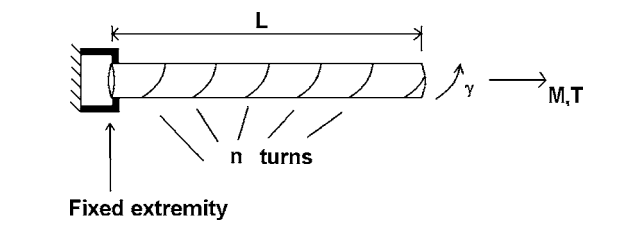
da Fonseca, Alexandre F; Malta, CP; Galvao, Douglas S
Elastic properties of nanowires Journal Article
Em: Journal of Applied Physics, vol. 99, não 9, pp. 094310, 2006.
Resumo | Links | BibTeX | Tags: Elasticity, Filaments, Nanowires
@article{da2006elastic,
title = {Elastic properties of nanowires},
author = {da Fonseca, Alexandre F and Malta, CP and Galvao, Douglas S},
url = {http://scitation.aip.org/content/aip/journal/jap/99/9/10.1063/1.2194309},
year = {2006},
date = {2006-01-01},
journal = {Journal of Applied Physics},
volume = {99},
number = {9},
pages = {094310},
publisher = {AIP Publishing},
abstract = {We present a model to study Young’s modulus and Poisson’s ratio of the composite material of amorphous nanowires. It is an extension of the model derived by two of us [da Fonseca and Galvão, Phys. Rev. Lett.92, 175502 (2004)] to study the elastic properties of amorphous nanosprings. The model is based on twisting and tensioning a straight nanowire and we propose an experimental setup to obtain the elastic parameters of the nanowire. We used the Kirchhoff rod model to obtain the expressions for the elastic constants of the nanowire.
},
keywords = {Elasticity, Filaments, Nanowires},
pubstate = {published},
tppubtype = {article}
}
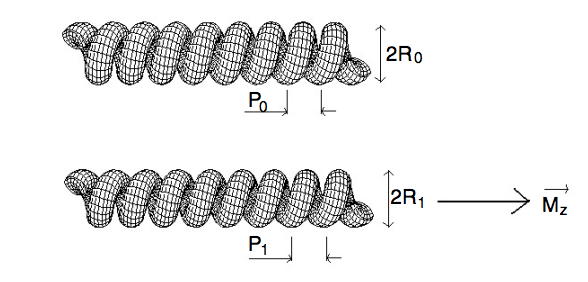
da Fonseca, Alexandre F; Malta, CP; Galvao, DS
Mechanical properties of amorphous nanosprings Journal Article
Em: Nanotechnology, vol. 17, não 22, pp. 5620, 2006.
Resumo | Links | BibTeX | Tags: Elasticity, Filaments, Nanowires
@article{da2006mechanical,
title = {Mechanical properties of amorphous nanosprings},
author = {da Fonseca, Alexandre F and Malta, CP and Galvao, DS},
url = {http://iopscience.iop.org/0957-4484/17/22/015},
year = {2006},
date = {2006-01-01},
journal = {Nanotechnology},
volume = {17},
number = {22},
pages = {5620},
publisher = {IOP Publishing},
abstract = {Helical amorphous nanosprings have attracted particular interest due to their special mechanical properties. In this work we present a simple model, within the framework of the Kirchhoff rod model, for investigating the structural properties of nanosprings having asymmetric cross section. We have derived expressions that can be used to obtain the Young's modulus and Poisson's ratio of the nanospring material composite. We also address the importance of the presence of a catalyst in the growth process of amorphous nanosprings in terms of the stability of helical rods.
},
keywords = {Elasticity, Filaments, Nanowires},
pubstate = {published},
tppubtype = {article}
}
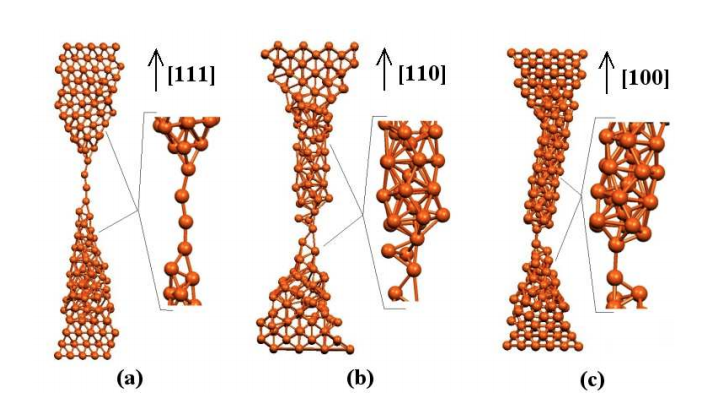
Sato, F; Moreira, AS; Bettini, J; Coura, PZ; Dantas, SO; Ugarte, D; Galvao, DS
On the Formation of Copper Linear Atomic Suspended Chains Journal Article
Em: arXiv preprint cond-mat/0602092, 2006.
Resumo | Links | BibTeX | Tags: Copper, Linear Atomic Chains, Metallic Nanowires, Molecular Dynamics, TEM
@article{sato2006formation,
title = {On the Formation of Copper Linear Atomic Suspended Chains},
author = {Sato, F and Moreira, AS and Bettini, J and Coura, PZ and Dantas, SO and Ugarte, D and Galvao, DS},
url = {http://arxiv.org/abs/cond-mat/0602092},
year = {2006},
date = {2006-01-01},
journal = {arXiv preprint cond-mat/0602092},
abstract = {We report high resolution transmission electron microscopy and classical molecular dynamics simulation results of mechanically stretching copper nanowires conducting to linear atomic suspended chains (LACs) formation. In contrast with some previous experimental and theoretical work in literature that stated that the formation of LACs for copper should not exist our results showed the existence of LAC for the [111], [110], and [100] crystallographic directions, being thus the sequence of most probable occurence.},
keywords = {Copper, Linear Atomic Chains, Metallic Nanowires, Molecular Dynamics, TEM},
pubstate = {published},
tppubtype = {article}
}
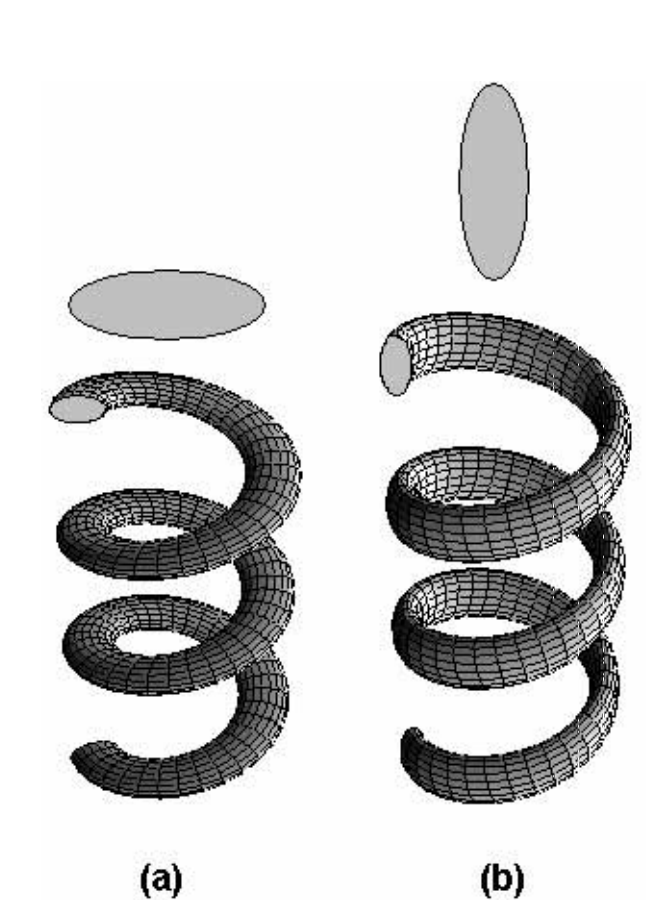
da Fonseca, Alexandre Fontes; Malta, CP; Galvao, Douglas S
Elastic Properties of Normal and Binormal Helical Nanowires Proceedings
Cambridge University Press, vol. 963, 2006.
Resumo | Links | BibTeX | Tags: Elasticity, Filaments, Metallic Nanowires
@proceedings{da2006elasticb,
title = {Elastic Properties of Normal and Binormal Helical Nanowires},
author = {da Fonseca, Alexandre Fontes and Malta, CP and Galvao, Douglas S},
url = {http://journals.cambridge.org/action/displayAbstract?fromPage=online&aid=8026852},
year = {2006},
date = {2006-01-01},
journal = {MRS Proceedings},
volume = {963},
pages = {0963--Q20},
publisher = {Cambridge University Press},
abstract = {A helical nanowire can be defined as being a nanoscopic rod whose axis follows a helical curve in space. In the case of a nanowire with asymmetric cross section, the helical nanostructure can be classified as normal or binormal helix, according to the orientation of the cross section with respect to the helical axis of the structure. In this work, we present a simple model to study the elastic properties of a helical nanowire with asymmetric cross section. We use the framework of the Kirchhoff rod model to obtain an expression relating the Hooke's constant, h, of normal and binormal nanohelices to their geometric features. We also obtain the Young's modulus values. These relations can be used by experimentalists to evaluate the elastic properties of helical nanostructures. We showed that the Hooke's constant of a normal nanohelix is higher than that of a binormal one. We illustrate our results using experimentally obtained nanohelices reported in the literature.},
keywords = {Elasticity, Filaments, Metallic Nanowires},
pubstate = {published},
tppubtype = {proceedings}
}
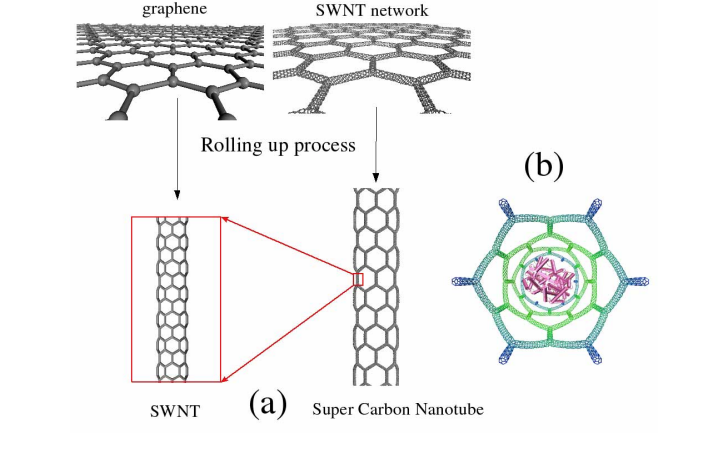
Coluci, Vitor R; Dantas, Socrates O; Jorio, Ado; Galvao, Douglas S.
Electronic and Mechanical Properties of Super Carbon Nanotube Networks Proceedings
Cambridge University Press, vol. 963, 2006.
Resumo | Links | BibTeX | Tags: Mechanical Properties, Molecular Dynamics, Super Carbons
@proceedings{coluci2006electronic,
title = {Electronic and Mechanical Properties of Super Carbon Nanotube Networks},
author = {Coluci, Vitor R and Dantas, Socrates O and Jorio, Ado and Galvao, Douglas S.},
url = {http://journals.cambridge.org/action/displayAbstract?fromPage=online&aid=8026810&fileId=S1946427400054014},
year = {2006},
date = {2006-01-01},
journal = {MRS Proceedings},
volume = {963},
pages = {0963--Q15},
publisher = {Cambridge University Press},
abstract = {Eletronic and mechanical properties of ordered carbon nanotube networks are studied using molecular dynamics simulations and tight-binding calculations. These networks are formed by single walled carbon nanotubes (SWNT) regularly connected by junctions. The use of different types of junctions (“Y”-, “X”-like junctions, for example) allows the construction of networks with different symmetries. These networks can be very flexible and the elastic deformation was associated with two main deformation mechanisms (bending and stretching ) of the constituents SWNTs. Rolling up the networks, “super” carbon nanotubes can be constructed. These super-tubes share some of the main electronic features of the SWNT which form them but important changes are predicted (e.g. reduction of bandgap value). Simulations of their deformations under tensile stress have revealed that the super-tubes are softer than the corresponding SWNT and that their rupture occur in higher strain values.},
keywords = {Mechanical Properties, Molecular Dynamics, Super Carbons},
pubstate = {published},
tppubtype = {proceedings}
}
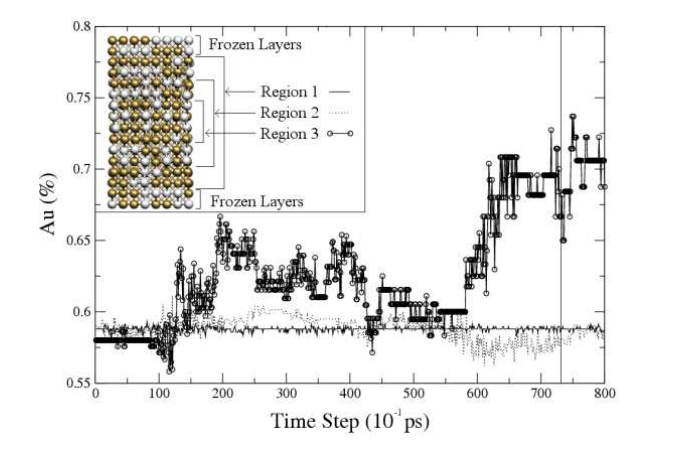
Bettini, J; Sato, F; Coura, PZ; Dantas, SO; Galvao, DS; Ugarte, D
Nanowires and Suspended Atom Chains from Metal alloys Journal Article
Em: arXiv preprint cond-mat/0601617, 2006.
Resumo | Links | BibTeX | Tags: Molecular Dynamics, TEM
@article{bettini2006nanowires,
title = {Nanowires and Suspended Atom Chains from Metal alloys},
author = {Bettini, J and Sato, F and Coura, PZ and Dantas, SO and Galvao, DS and Ugarte, D},
url = {http://arxiv.org/abs/cond-mat/0601617},
year = {2006},
date = {2006-01-01},
journal = {arXiv preprint cond-mat/0601617},
abstract = {We present a study of the elongation and rupture of gold-silver alloy nanowires. Atomistic details of the evolution were derived from time-resolved atomic resolution transmission electron microscopy and molecular dynamics simulations. The results show the occurrence of gold enrichment at the nanojunction region, leading to a gold-like structural behavior even for alloys with minor gold content. Our observations have also revealed the formation of mixed (Au and Ag) linear atomic chains.},
keywords = {Molecular Dynamics, TEM},
pubstate = {published},
tppubtype = {article}
}
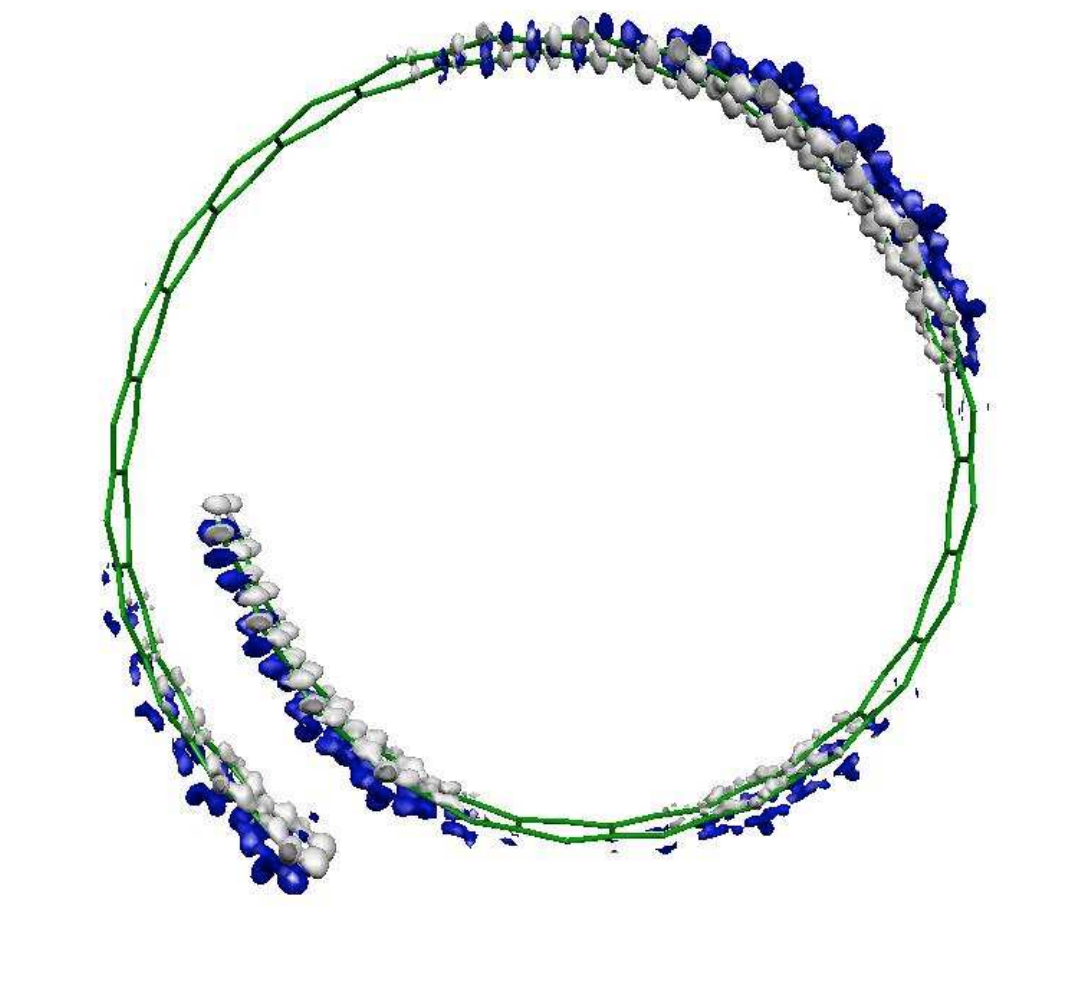
Rurali, R; Coluci, VR; Galvao, DS
Prediction of Giant Electro-actuation for Carbon Nanoscrolls Journal Article
Em: arXiv preprint cond-mat/0603239, 2006.
Resumo | Links | BibTeX | Tags: DFT, Electroactuation, Electronic Structure, Scrolls
@article{rurali2006predictionb,
title = {Prediction of Giant Electro-actuation for Carbon Nanoscrolls},
author = {Rurali, R and Coluci, VR and Galvao, DS},
url = {http://arxiv.org/abs/cond-mat/0603239},
year = {2006},
date = {2006-01-01},
journal = {arXiv preprint cond-mat/0603239},
abstract = {We study by first-principles calculations the electro-mechanical response of carbon nanoscrolls. We show that although they present a very similar behavior to carbon nanotubes for what concerns the axial deformation sensitivity, they exhibit a radial response upon charge injection which is up to one order of magnitude larger. In association with their high stability, this behavior make them a natural choice for a new class of very efficient nano-actuators.},
keywords = {DFT, Electroactuation, Electronic Structure, Scrolls},
pubstate = {published},
tppubtype = {article}
}
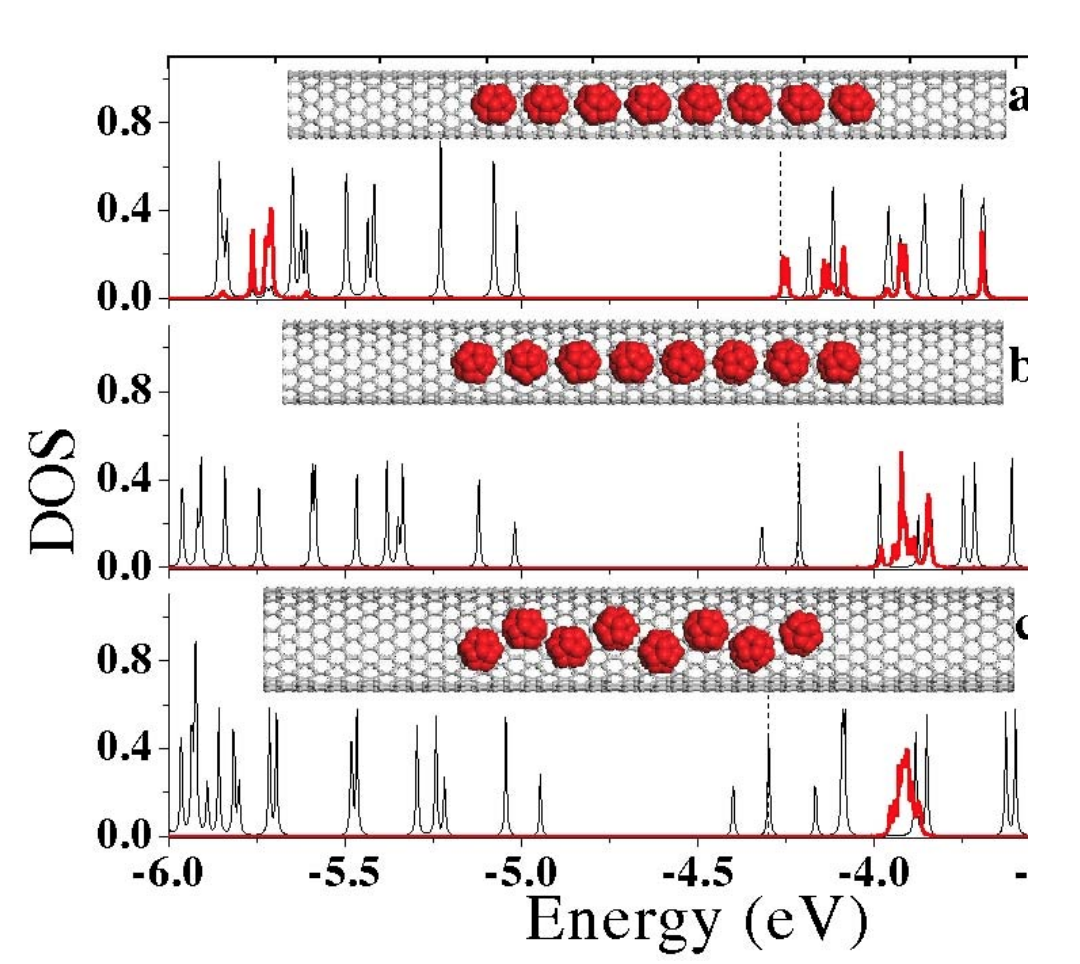
Troche, KS; Coluci, VR; Rurali, R; Galvao, DS
Doping of zigzag carbon nanotubes through the encapsulation of small fullerenes Journal Article
Em: arXiv preprint cond-mat/0607197, 2006.
Resumo | Links | BibTeX | Tags: CNT encapsulation, DFT, Molecular Dynamics
@article{troche2006doping,
title = {Doping of zigzag carbon nanotubes through the encapsulation of small fullerenes},
author = {Troche, KS and Coluci, VR and Rurali, R and Galvao, DS},
url = {http://arxiv.org/abs/cond-mat/0607197},
year = {2006},
date = {2006-01-01},
journal = {arXiv preprint cond-mat/0607197},
abstract = {In this work we investigated the encapsulation of C20 and C30 fullerenes into semiconducting carbon nanotubes to study the possibility of bandgap engineering in such systems. Classical molecular dynamics simulations coupled to tight-binding calculations were used to determine the conformational and electronic properties of carbon nanotube supercells containing up to 12 fullerenes. We have observed that C20 fullerenes behave similarly to a p-type dopant while C30 ones work as n-type ones. For larger diameter nanotubes, where fullerene patterns start to differ from the linear arrangements (peapods), the doping features are preserved for both fullerenes, but local disorder plays an important role and significantly alters the electronic structure. The combined incorporation of both fullerene types (hybrid encapsulation) into the same nanotube leads to a behavior similar to that found in electronic junctions in Silicon-based electronic devices. These aspects can be exploited in the design of nanoelectronic devices using semiconducting carbon nanotubes.},
keywords = {CNT encapsulation, DFT, Molecular Dynamics},
pubstate = {published},
tppubtype = {article}
}
2005
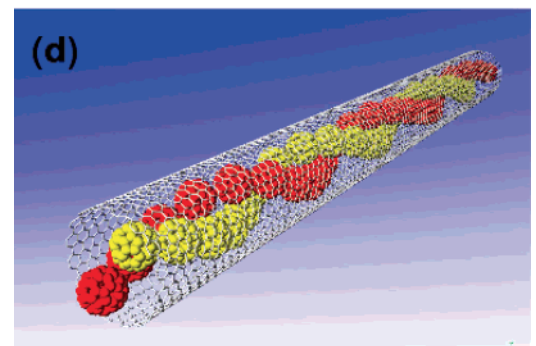
Troche, Karla S; Coluci, Vitor R; Braga, Scheila F; Chinellato, David D; Sato, Fernando; Legoas, Sergio B; Rurali, Riccardo; Galvao, Douglas S
Prediction of ordered phases of encapsulated C60, C70, and C78 inside carbon nanotubes Journal Article
Em: Nano letters, vol. 5, não 2, pp. 349–355, 2005.
Resumo | Links | BibTeX | Tags: Molecular Dynamics, Scrolls
@article{troche2005prediction,
title = {Prediction of ordered phases of encapsulated C60, C70, and C78 inside carbon nanotubes},
author = {Troche, Karla S and Coluci, Vitor R and Braga, Scheila F and Chinellato, David D and Sato, Fernando and Legoas, Sergio B and Rurali, Riccardo and Galvao, Douglas S},
url = {http://pubs.acs.org/doi/abs/10.1021/nl047930r},
year = {2005},
date = {2005-01-01},
journal = {Nano letters},
volume = {5},
number = {2},
pages = {349--355},
publisher = {ACS Publications},
abstract = {arbon nanotube scrolls (CNSs) provide an interesting form of carbon that ideally consists of a single sheet of graphite that is spiral wrapped to form a nanotube. We here use molecular dynamics simulations to investigate CNS formation, stability, and the structural effects due to charge injection. CNS formation is seen to automatically occur when a critical overlap between sheet layers is achieved for the partially curled sheet. We find that charge injection causes unwinding of the CNSs, which might be important for the application of CNSs as nanomechanical
actuators.
},
keywords = {Molecular Dynamics, Scrolls},
pubstate = {published},
tppubtype = {article}
}
actuators.
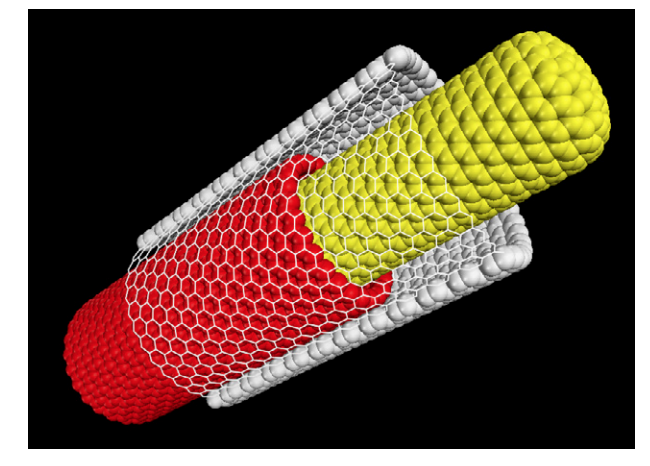
Coluci, VR; Legoas, SB; de Aguiar, MAM; Galvao, DS
Chaotic signature in the motion of coupled carbon nanotube oscillators Journal Article
Em: Nanotechnology, vol. 16, não 4, pp. 583, 2005.
Resumo | Links | BibTeX | Tags: Carbon Nanotubes, Chaos, Oscillators
@article{coluci2005chaotic,
title = {Chaotic signature in the motion of coupled carbon nanotube oscillators},
author = {Coluci, VR and Legoas, SB and de Aguiar, MAM and Galvao, DS},
url = {http://iopscience.iop.org/0957-4484/16/4/041},
year = {2005},
date = {2005-01-01},
journal = {Nanotechnology},
volume = {16},
number = {4},
pages = {583},
publisher = {IOP Publishing},
abstract = {The motion of coupled oscillators based on multiwalled carbon nanotubes is studied using rigid-body dynamics simulations. The results show the existence of chaotic and regular behaviours for a given total energy, indicating the manifestation of chaos in nanoscaled mechanical systems based on carbon nanotube oscillators. Different regular motions are observed for different total energies, and they can be obtained by appropriately choosing the initial conditions. This possibility can allow the construction of multi-functional nano-devices based on multiwalled carbon nanotube oscillators.},
keywords = {Carbon Nanotubes, Chaos, Oscillators},
pubstate = {published},
tppubtype = {article}
}
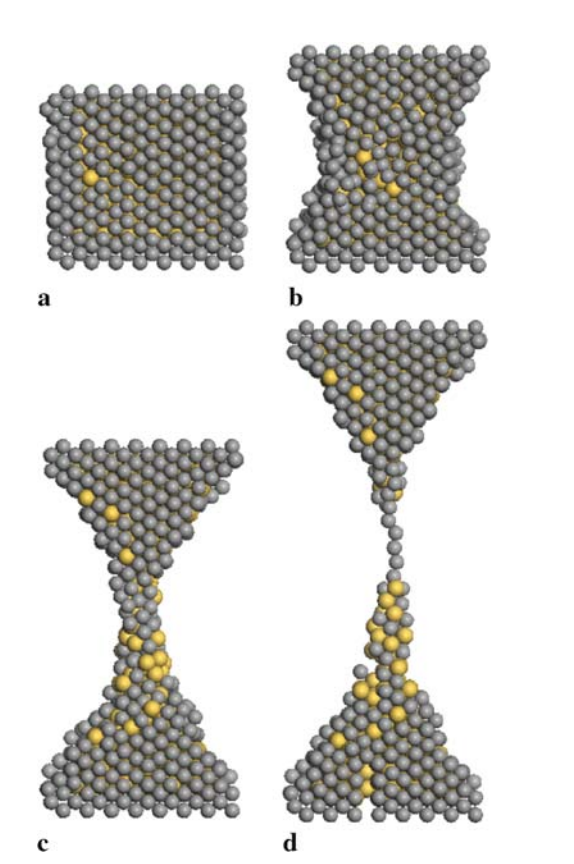
Sato, F; Moreira, AS; Coura, PZ; Dantas, SO; Legoas, SB; Ugarte, D; Galvao, DS
Computer simulations of gold nanowire formation: the role of outlayer atoms Journal Article
Em: Applied Physics A (invited paper), vol. 81, não 8, pp. 1527–1531, 2005.
Resumo | Links | BibTeX | Tags: Linear Atomic Chains, Metallic Nanowires, Molecular Dynamics, TEM
@article{sato2005computer,
title = {Computer simulations of gold nanowire formation: the role of outlayer atoms},
author = {Sato, F and Moreira, AS and Coura, PZ and Dantas, SO and Legoas, SB and Ugarte, D and Galvao, DS},
url = {http://link.springer.com/article/10.1007/s00339-005-3390-2},
year = {2005},
date = {2005-01-01},
journal = {Applied Physics A (invited paper)},
volume = {81},
number = {8},
pages = {1527--1531},
publisher = {Springer-Verlag},
abstract = {Metallic nanowires (NWs) have been the object of intense theoretical and experimental investigations in the last years. In this work we present and review a new methodology we developed to study NW formation from mechanical stretching. This methodology is based on tight-binding molecular dynamics techniques using second-moment approximations. This methodology had been proven to be very effective in the study of NWs, reliably reproducing the main experimentally observed structural features. We have also investigated the problem of determining from what regions the atoms composing the linear atomic chains come. Our results show that ∼90% of these atoms come from outmost external layers.
},
keywords = {Linear Atomic Chains, Metallic Nanowires, Molecular Dynamics, TEM},
pubstate = {published},
tppubtype = {article}
}
Legoas, SB; Rodrigues, V; Ugarte, D; Galvao, DS
Legoas et al. Reply Journal Article
Em: Physical Review Letters, vol. 95, não 16, pp. 169602, 2005.
Links | BibTeX | Tags: Linear Atomic Chains, Metallic Nanowires, Molecular Dynamics
@article{legoas2005legoas,
title = {Legoas et al. Reply},
author = {Legoas, SB and Rodrigues, V and Ugarte, D and Galvao, DS},
url = {http://journals.aps.org/prl/abstract/10.1103/PhysRevLett.95.169602},
year = {2005},
date = {2005-01-01},
journal = {Physical Review Letters},
volume = {95},
number = {16},
pages = {169602},
keywords = {Linear Atomic Chains, Metallic Nanowires, Molecular Dynamics},
pubstate = {published},
tppubtype = {article}
}
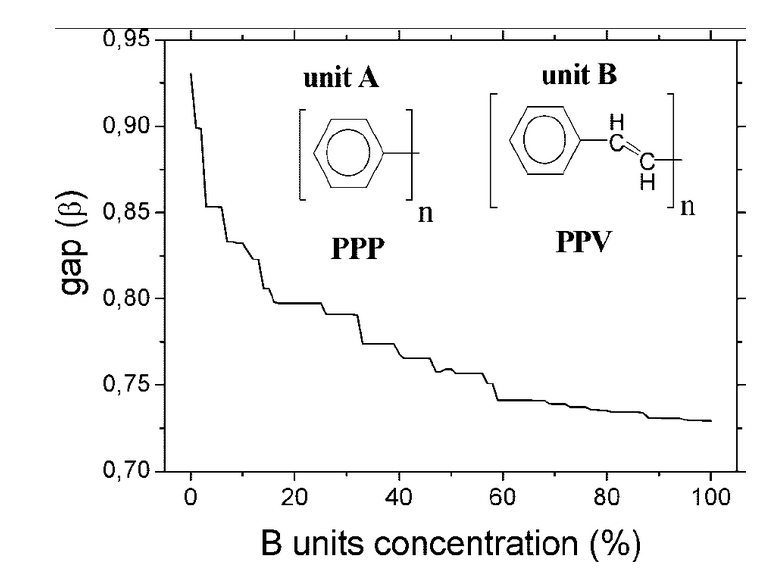
Giro, Ronaldo; Caldas, Mar'ilia Junqueira; Galvao, Douglas Soares
Band gap engineering for poly (p-phenylene) and poly (p-phenylene vinylene) copolymers using the tight-binding approach Journal Article
Em: International Journal of Quantum Chemistry, vol. 103, não 5, pp. 588–596, 2005.
Resumo | Links | BibTeX | Tags: Conducting Polymers, Electronic Structure, PPP, PPV
@article{giro2005band,
title = {Band gap engineering for poly (p-phenylene) and poly (p-phenylene vinylene) copolymers using the tight-binding approach},
author = {Giro, Ronaldo and Caldas, Mar'ilia Junqueira and Galvao, Douglas Soares},
url = {http://onlinelibrary.wiley.com/doi/10.1002/qua.20551/full},
year = {2005},
date = {2005-01-01},
journal = {International Journal of Quantum Chemistry},
volume = {103},
number = {5},
pages = {588--596},
publisher = {Wiley Online Library},
abstract = {The interest in poly(p-phenylene) (PPP) and poly(p-phenylene vinylene) (PPV) copolymers stems from the fact that these homopolymers present interesting optical and electronic properties that allow a great variety of technological applications. Combining different numbers of PPP and PPV units it is possible, in principle, to obtain new structures presenting intermediate gap values (2.8 eV and 2.4 eV for PPP and PPV, respectively). For this study we used a Hückel Hamiltonian tight-binding coupled to the negative factor counting (NFC) technique. We carried out a systematic search to determine optimum relative concentrations for disordered binary polymeric alloys with predefined gap values. Once these structures were obtained, we used the semiempirical methods AM1/PM3 and ZINDO/S-CI for geometrical and optical studies, respectively. Our theoretical results show that it is possible to obtain copolymers of PPP and PPV with intermediate gap values of their parent structures. © 2005 Wiley Periodicals, Inc. Int J Quantum Chem, 2005},
keywords = {Conducting Polymers, Electronic Structure, PPP, PPV},
pubstate = {published},
tppubtype = {article}
}
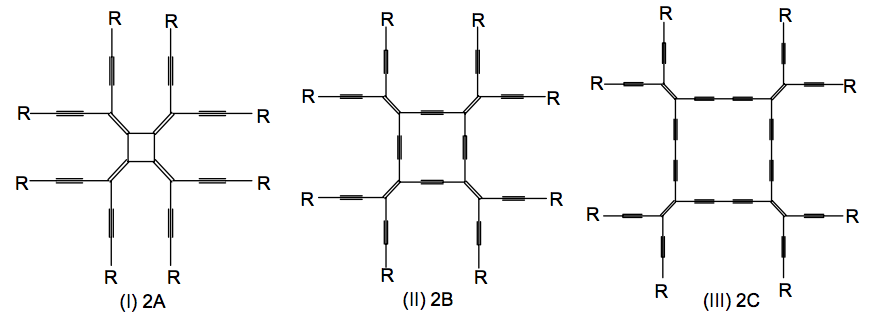
Konstantinova, Elena; Galvao, Douglas S; Barone, Paulo MVB; Dantas, Socrates O
Structural and electronic properties of radialenes and related systems Journal Article
Em: Journal of Molecular Structure: THEOCHEM, vol. 729, não 3, pp. 203–210, 2005.
Resumo | Links | BibTeX | Tags: DFT, Electronic Structure, Radialenes
@article{konstantinova2005structural,
title = {Structural and electronic properties of radialenes and related systems},
author = {Konstantinova, Elena and Galvao, Douglas S and Barone, Paulo MVB and Dantas, Socrates O},
url = {http://www.sciencedirect.com/science/article/pii/S016612800500480X},
year = {2005},
date = {2005-01-01},
journal = {Journal of Molecular Structure: THEOCHEM},
volume = {729},
number = {3},
pages = {203--210},
publisher = {Elsevier},
abstract = {The discovery of new allotropic forms of carbon gives rise to a great interest in carbon compounds as building blocks for novel nanostructure materials. Radialenes are homologous series of compounds with a cycloalkane nucleus bound to methylene side groups, with molecular formula CnHn. The series of expanded radialenes of molecular formulae C2nHn and C3nHn are obtained by inserting acetylene or diacetylene groups between each pair of methylene units. This paper is a report on the theoretical study of structural, electronic and spectroscopic properties of radialenes, expanded radialenes and related molecular systems. Using semiempirical methods we explore the behavior of π-electrons along the carbon-rich skeleton. The results for structural parameters are in a good agreement with the available experimental data. The calculated electronic gaps and spatial distribution of frontier orbitals indicate to interesting electrical and nonlinear optical properties of the explored compounds, which may be useful for technological applications.},
keywords = {DFT, Electronic Structure, Radialenes},
pubstate = {published},
tppubtype = {article}
}
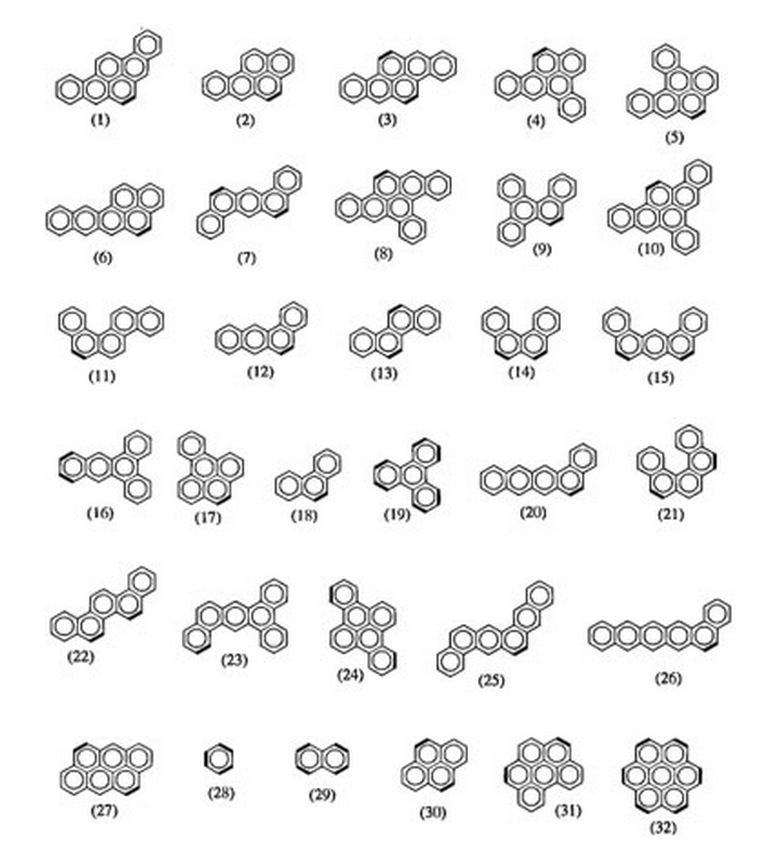
Troche, Karla S; Braga, Scheila F; Coluci, Vitor R; Galvao, Douglas S
Carcinogenic classification of polycyclic aromatic hydrocarbons through theoretical descriptors Journal Article
Em: International journal of quantum chemistry, vol. 103, não 5, pp. 718–730, 2005.
Resumo | Links | BibTeX | Tags: Carcinogenesis, HCA, Neural Networks, PCA, Polycyclic Aromatic Hydrocarbons (PAHs), Theory of Electronic Indices
@article{troche2005carcinogenic,
title = {Carcinogenic classification of polycyclic aromatic hydrocarbons through theoretical descriptors},
author = {Troche, Karla S and Braga, Scheila F and Coluci, Vitor R and Galvao, Douglas S},
url = {http://onlinelibrary.wiley.com/doi/10.1002/qua.20529/full},
year = {2005},
date = {2005-01-01},
journal = {International journal of quantum chemistry},
volume = {103},
number = {5},
pages = {718--730},
publisher = {Wiley Online Library},
abstract = {Polycyclic aromatic hydrocarbons (PAHs) constitute an importantfamily of molecules capable of inducing chemical carcinogenesis. In this work we reporta comparative structure–activity relationship (SAR) study for 81 PAHs using differentmethodologies. The recently developed electronic indices methodology (EIM) withquantum descriptors obtained from different semiempirical methods (AM1, PM3, andPM5) was contrasted against more standard pattern recognition methods (PRMs),principal component analysis (PCA), hierarchical cluster analysis (HCA), Kth nearestneighbor (KNN), soft independent modeling of class analogies (SIMCA), and neuralnetworks (NN). Our results show that PRMs validate the statistical value of electronicparameters derived from EIM analysis and their ability to identify active compounds.EIM outperformed more standard SAR methodologies and does not appear to besignificantly Hamiltonian-dependent.},
keywords = {Carcinogenesis, HCA, Neural Networks, PCA, Polycyclic Aromatic Hydrocarbons (PAHs), Theory of Electronic Indices},
pubstate = {published},
tppubtype = {article}
}
Campos, Paulo RA; de Oliveira, Viviane M; Giro, Ronaldo; Galvao, Douglas S
Campos et al. Reply Journal Article
Em: Physical Review Letters, vol. 95, não 22, pp. 229802, 2005.
Links | BibTeX | Tags: Cellular Automata, Cicadas, Prime Numbers
@article{campos2005campos,
title = {Campos et al. Reply},
author = {Campos, Paulo RA and de Oliveira, Viviane M and Giro, Ronaldo and Galvao, Douglas S},
url = {http://journals.aps.org/prl/abstract/10.1103/PhysRevLett.95.229802},
year = {2005},
date = {2005-01-01},
journal = {Physical Review Letters},
volume = {95},
number = {22},
pages = {229802},
publisher = {APS},
keywords = {Cellular Automata, Cicadas, Prime Numbers},
pubstate = {published},
tppubtype = {article}
}
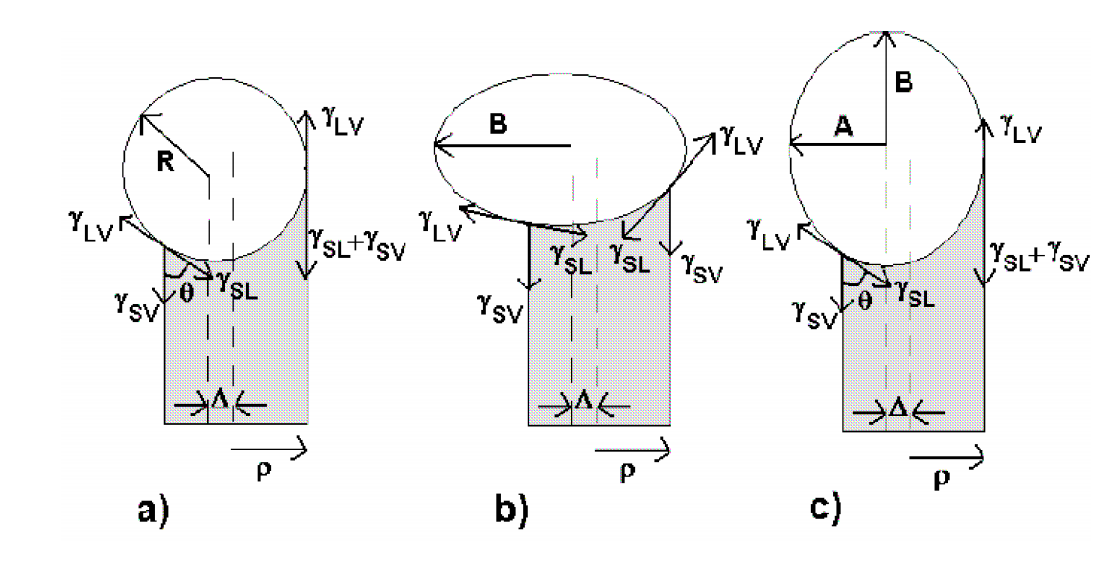
da Fonseca, Alexandre F; Galvao, Douglas S; Malta, Coraci P
Binormal nanohelices Proceedings
Cambridge University Press, vol. 903, 2005.
Resumo | Links | BibTeX | Tags: Elasticity, Filaments, Nanowires
@proceedings{da2005binormal,
title = {Binormal nanohelices},
author = {da Fonseca, Alexandre F and Galvao, Douglas S and Malta, Coraci P},
url = {http://journals.cambridge.org/action/displayAbstract?fromPage=online&aid=8108794&fileId=S1946427400047680},
year = {2005},
date = {2005-01-01},
journal = {MRS Proceedings},
volume = {903},
pages = {0903--Z14},
publisher = {Cambridge University Press},
abstract = {Helical structures can be classified in accordance with the orientation of its cross-section with respect to the normal or binormal vectors. We investigate the geometric features of several nanosprings verifying the non-existence of normal nanohelices. In this work, using the VLS growth model, we explain not only the absence of normal nanosprings but also the growing process of binormal nanosprings. The dynamical stability of crystalline ZnO binormal nanohelices is also addressed.},
keywords = {Elasticity, Filaments, Nanowires},
pubstate = {published},
tppubtype = {proceedings}
}
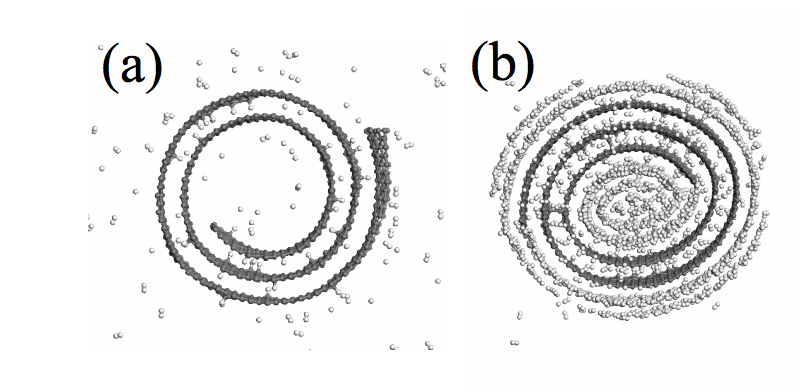
Coluci, Vitor; Braga, Scheila F; Baughman, Ray H; Galvao, Douglas S
Hydrogen Storage in Carbon Nanoscrolls: A Molecular Dynamics Study Proceedings
Cambridge University Press, vol. 885, 2005.
Resumo | Links | BibTeX | Tags: Hydrogen Storage, Molecular Dynamics, Monte Carlo, Scrolls
@proceedings{coluci2005hydrogen,
title = {Hydrogen Storage in Carbon Nanoscrolls: A Molecular Dynamics Study},
author = {Coluci, Vitor and Braga, Scheila F and Baughman, Ray H and Galvao, Douglas S},
url = {http://journals.cambridge.org/action/displayAbstract?fromPage=online&aid=8012272&fileId=S1946427400039816},
year = {2005},
date = {2005-01-01},
journal = {MRS Proceedings},
volume = {885},
pages = {0885--A06},
publisher = {Cambridge University Press},
abstract = {We carried out molecular dynamics simulations with Tersoff-Brenner potentials in order to investigate the hydrogen uptake mechanisms and storage capacity of carbon nanoscrolls (CNSs). CNSs are jelly roll-like structures formed by wrapping graphene layers. Interlayer adsorption is an option for this material, which does not exist for single and multiwalled carbon nanotubes. We analyzed the processes of hydrogen physisorption and uptake mechanisms. We observed incorporation of hydrogen molecules in both external and internal scroll surfaces. Insertion in the internal cavity and between the scroll layers is responsible for 40% of the total hydrogen adsorption at 77 K.},
keywords = {Hydrogen Storage, Molecular Dynamics, Monte Carlo, Scrolls},
pubstate = {published},
tppubtype = {proceedings}
}
2004
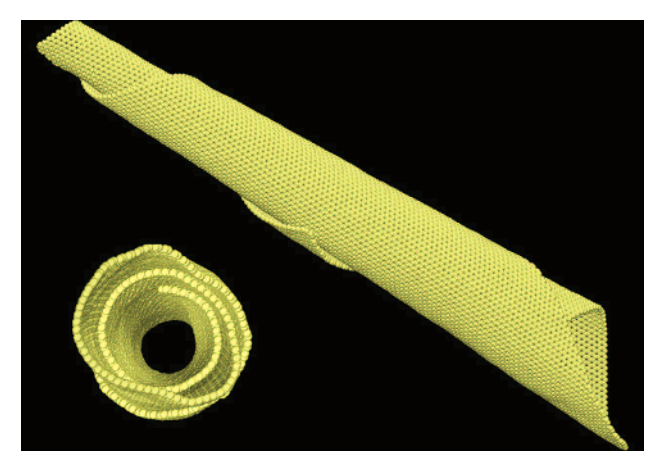
Braga, Scheila F; Coluci, Vitor R; Legoas, Sergio B; Giro, Ronaldo; Galvao, Douglas S; Baughman, Ray H
Structure and dynamics of carbon nanoscrolls Journal Article
Em: Nano Letters, vol. 4, não 5, pp. 881–884, 2004.
Resumo | Links | BibTeX | Tags: Molecular Dynamics, Scrolls, Structure
@article{braga2004structure,
title = {Structure and dynamics of carbon nanoscrolls},
author = {Braga, Scheila F and Coluci, Vitor R and Legoas, Sergio B and Giro, Ronaldo and Galvao, Douglas S and Baughman, Ray H},
url = {http://pubs.acs.org/doi/abs/10.1021/nl0497272},
year = {2004},
date = {2004-01-01},
journal = {Nano Letters},
volume = {4},
number = {5},
pages = {881--884},
publisher = {American Chemical Society},
abstract = {Carbon nanotube scrolls (CNSs) provide an interesting form of carbon that ideally consists of a single sheet of graphite that is spiral wrapped
to form a nanotube. We here use molecular dynamics simulations to investigate CNS formation, stability, and the structural effects due to
charge injection. CNS formation is seen to automatically occur when a critical overlap between sheet layers is achieved for the partially curled
sheet. We find that charge injection causes unwinding of the CNSs, which might be important for the application of CNSs as nanomechanical
actuators},
keywords = {Molecular Dynamics, Scrolls, Structure},
pubstate = {published},
tppubtype = {article}
}
to form a nanotube. We here use molecular dynamics simulations to investigate CNS formation, stability, and the structural effects due to
charge injection. CNS formation is seen to automatically occur when a critical overlap between sheet layers is achieved for the partially curled
sheet. We find that charge injection causes unwinding of the CNSs, which might be important for the application of CNSs as nanomechanical
actuators
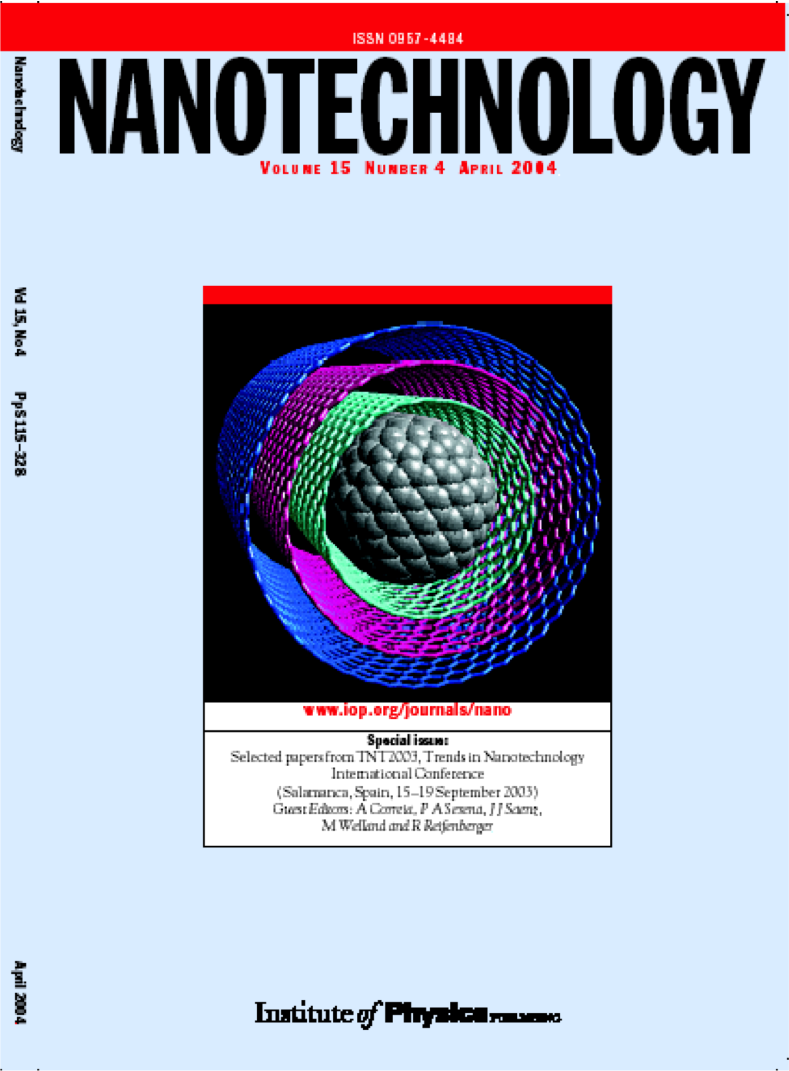
Legoas, SB; Coluci, VR; Braga, SF; Coura, PZ; Dantas, SO; Galvao, DS
Gigahertz nanomechanical oscillators based on carbon nanotubes Journal Article
Em: Nanotechnology, vol. 15, não 4, pp. S184, 2004.
Resumo | Links | BibTeX | Tags: Carbon Nanotubes, Molecular Dynamics, Oscillators
@article{legoas2004gigahertz,
title = {Gigahertz nanomechanical oscillators based on carbon nanotubes},
author = {Legoas, SB and Coluci, VR and Braga, SF and Coura, PZ and Dantas, SO and Galvao, DS},
url = {http://iopscience.iop.org/0957-4484/15/4/012},
year = {2004},
date = {2004-01-01},
journal = {Nanotechnology},
volume = {15},
number = {4},
pages = {S184},
publisher = {IOP Publishing},
abstract = {We report molecular dynamics studies of carbon nanotubes as mechanical gigahertz oscillators. Our results show that different oscillatory regimes exist but that sustained oscillations are possible only when the radii difference values of the inner and outer tubes are {sim }3.4~AA . Frequencies as large as 87 GHz were obtained. Calculated force and frequency values are in good agreement with estimated data from recent experimental investigations.},
keywords = {Carbon Nanotubes, Molecular Dynamics, Oscillators},
pubstate = {published},
tppubtype = {article}
}
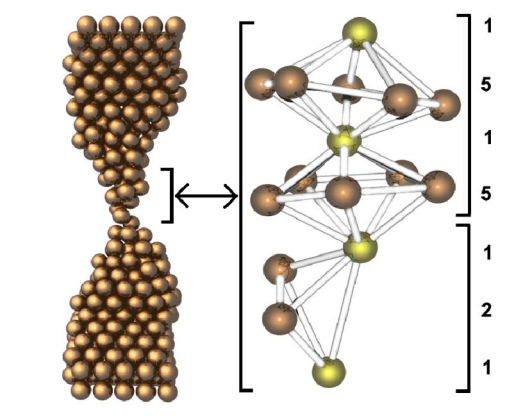
Gonzalez, JC; Rodrigues, V; Bettini, J; Rego, LGC; Rocha, AR; Coura, PZ; Dantas, SO; Sato, F; Galvao, DS; Ugarte, D
Indication of unusual pentagonal structures in atomic-size Cu nanowires Journal Article
Em: Physical Review Letters, vol. 93, não 12, pp. 126103, 2004.
Resumo | Links | BibTeX | Tags: Copper Nanowires, Linear Atomic Chains, Metallic Nanowires, Molecular Dynamics, TEM, top20
@article{gonzalez2004indication,
title = {Indication of unusual pentagonal structures in atomic-size Cu nanowires},
author = {Gonzalez, JC and Rodrigues, V and Bettini, J and Rego, LGC and Rocha, AR and Coura, PZ and Dantas, SO and Sato, F and Galvao, DS and Ugarte, D},
url = {http://journals.aps.org/prl/abstract/10.1103/PhysRevLett.93.126103},
year = {2004},
date = {2004-01-01},
journal = {Physical Review Letters},
volume = {93},
number = {12},
pages = {126103},
publisher = {APS},
abstract = {We present a study of the structural and quantum conductance properties of atomic-size copper nanowires generated by mechanical stretching. The atomistic evolution was derived from time-resolved electron microscopy observations and molecular dynamics simulations. We have analyzed the quantum transport behavior by means of conductance measurements and theoretical calculations. The results suggest the formation of an unusual and highly stable pentagonal Cu nanowire with a diameter of ∼0.45 nm and ∼4.5 conductance quanta.
},
keywords = {Copper Nanowires, Linear Atomic Chains, Metallic Nanowires, Molecular Dynamics, TEM, top20},
pubstate = {published},
tppubtype = {article}
}
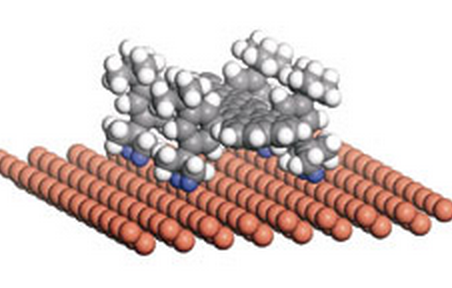
Otero, Roberto; Hummelink, Frauke; Sato, Fernando; Legoas, Sergio B; Thostrup, Peter; Lægsgaard, Erik; Stensgaard, Ivan; Galvao, Douglas S; Besenbacher, Flemming
Lock-and-key effect in the surface diffusion of large organic molecules probed by STM Journal Article
Em: Nature Materials, vol. 3, não 11, pp. 779–782, 2004.
Resumo | Links | BibTeX | Tags: Landers, Molecular Dynamics, Molecular Electronics, STM, top20
@article{otero2004lock,
title = {Lock-and-key effect in the surface diffusion of large organic molecules probed by STM},
author = {Otero, Roberto and Hummelink, Frauke and Sato, Fernando and Legoas, Sergio B and Thostrup, Peter and Lægsgaard, Erik and Stensgaard, Ivan and Galvao, Douglas S and Besenbacher, Flemming},
url = {http://www.nature.com/nmat/journal/v3/n11/full/nmat1243.html},
year = {2004},
date = {2004-01-01},
journal = {Nature Materials},
volume = {3},
number = {11},
pages = {779--782},
publisher = {Nature Publishing Group},
abstract = {A nanoscale understanding of the complex dynamics of large molecules at surfaces is essential for the bottom-up design of molecular nanostructures1, 2, 3, 4, 5, 6, 7, 8. Here we show that we can change the diffusion coefficient of the complex organic molecule known as Violet Lander (VL, C108H104) on Cu(110) by two orders of magnitude by using the STM at low temperatures to switch between two adsorption configurations that differ only in the molecular orientation with respect to the substrate lattice. From an interplay with molecular dynamics simulations, we interpret the results within a lock-and-key model similar to the one driving the recognition between biomolecules: the molecule (key) is immobilized only when its orientation is such that the molecular shape fits the atomic lattice of the surface (lock); otherwise the molecule is highly mobile.
Introduction
},
keywords = {Landers, Molecular Dynamics, Molecular Electronics, STM, top20},
pubstate = {published},
tppubtype = {article}
}
Introduction
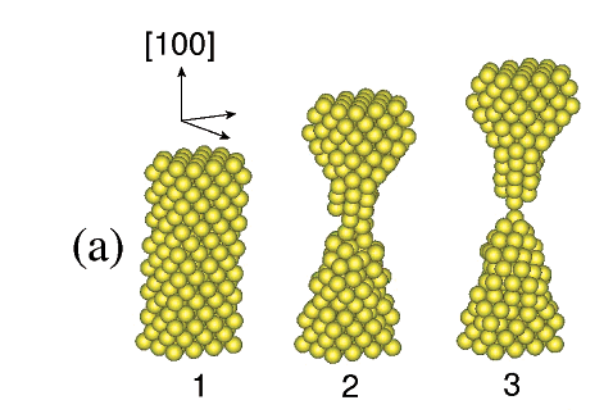
Coura, Pablo Z; Legoas, Sergio B; Moreira, Anderson S; Sato, Fernando; Rodrigues, Varlei; Dantas, Socrates O; Ugarte, Daniel; Galvao, Douglas S
On the structural and stability features of linear atomic suspended chains formed from gold nanowires stretching Journal Article
Em: Nano Letters, vol. 4, não 7, pp. 1187–1191, 2004.
Resumo | Links | BibTeX | Tags: Liinear Atomic Chains, Metallic Nanowires, Molecular Dynamics, Structure, TEM
@article{coura2004structural,
title = {On the structural and stability features of linear atomic suspended chains formed from gold nanowires stretching},
author = {Coura, Pablo Z and Legoas, Sergio B and Moreira, Anderson S and Sato, Fernando and Rodrigues, Varlei and Dantas, Socrates O and Ugarte, Daniel and Galvao, Douglas S},
url = {http://pubs.acs.org/doi/abs/10.1021/nl049725h},
year = {2004},
date = {2004-01-01},
journal = {Nano Letters},
volume = {4},
number = {7},
pages = {1187--1191},
publisher = {American Chemical Society},
abstract = {Metallic nanowires (NWs) have been intensily investigated in the past years, but details on
their formation are still not completely understood. In this work we report high resolution
transmission electron microscopy data and molecular dynamics simulation results for gold
NW elongation. Our results show that different initial crystallographic orientations lead to
very differentiated linear atomic suspended chain (LAC) formations and strongly support that
kinetic aspects are the dominant mechanisms determining the LAC morphologies.},
keywords = {Liinear Atomic Chains, Metallic Nanowires, Molecular Dynamics, Structure, TEM},
pubstate = {published},
tppubtype = {article}
}
their formation are still not completely understood. In this work we report high resolution
transmission electron microscopy data and molecular dynamics simulation results for gold
NW elongation. Our results show that different initial crystallographic orientations lead to
very differentiated linear atomic suspended chain (LAC) formations and strongly support that
kinetic aspects are the dominant mechanisms determining the LAC morphologies.
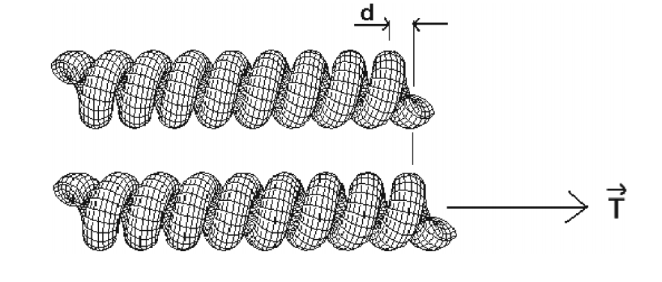
da Fonseca, Alexandre F; Galvao, Douglas S
Mechanical properties of nanosprings Journal Article
Em: Physical review letters, vol. 92, não 17, pp. 175502, 2004.
Resumo | Links | BibTeX | Tags: Elasticity, Filaments, Nanowires
@article{da2004mechanical,
title = {Mechanical properties of nanosprings},
author = {da Fonseca, Alexandre F and Galvao, Douglas S},
url = {http://journals.aps.org/prl/abstract/10.1103/PhysRevLett.92.175502},
year = {2004},
date = {2004-01-01},
journal = {Physical review letters},
volume = {92},
number = {17},
pages = {175502},
publisher = {APS},
abstract = {Nanostructures (nanotubes, nanowires, etc.) have been the object of intense theoretical and experimental investigations in recent years. Among these structures, helical nanosprings or nanocoils have attracted particular interest due to their special mechanical properties. In this work, we investigated structural properties of nanosprings in the Kirchhoff rod model. We derived expressions that can be used experimentally to obtain nanospring Young’s modulus and Poisson’s ratio values. Our results also might explain why the presence of catalytic particles is so important in nanostructure growth.},
keywords = {Elasticity, Filaments, Nanowires},
pubstate = {published},
tppubtype = {article}
}
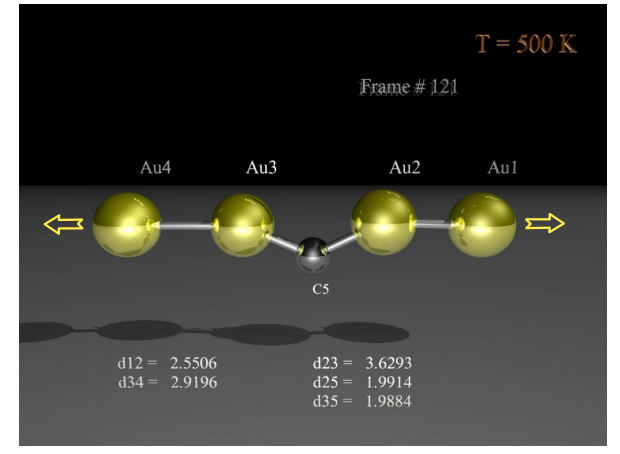
Legoas, Sergio B; Rodrigues, Varlei; Ugarte, Daniel; Galvao, Douglas S
Contaminants in suspended gold chains: An ab initio molecular dynamics study Journal Article
Em: Physical Review Letters, vol. 93, não 21, pp. 216103, 2004.
Resumo | Links | BibTeX | Tags: DFT, Electronic Structure, Linear Atomic Chains, Metallic Nanowires, top20
@article{legoas2004contaminants,
title = {Contaminants in suspended gold chains: An ab initio molecular dynamics study},
author = {Legoas, Sergio B and Rodrigues, Varlei and Ugarte, Daniel and Galvao, Douglas S},
url = {http://journals.aps.org/prl/abstract/10.1103/PhysRevLett.93.216103},
year = {2004},
date = {2004-01-01},
journal = {Physical Review Letters},
volume = {93},
number = {21},
pages = {216103},
publisher = {American Physical Society},
abstract = {Recently, we have proposed that the origin of anomalously long interatomic distances in suspended gold chains could be the result of carbon contamination during sample manipulation [S. B. Legoas et al., Phys. Rev. Lett. 88, 076105 (2002)]. More recently, however, other works have proposed that hydrogen instead of carbon should be the most probable contaminant. We report ab initio molecular dynamics results for different temperatures considering different possible contaminants. Our results show that at nonzero temperatures (more realistic to simulate the experimental conditions) hydrogen may be ruled out and carbon atoms remain the best candidate for contamination.},
keywords = {DFT, Electronic Structure, Linear Atomic Chains, Metallic Nanowires, top20},
pubstate = {published},
tppubtype = {article}
}
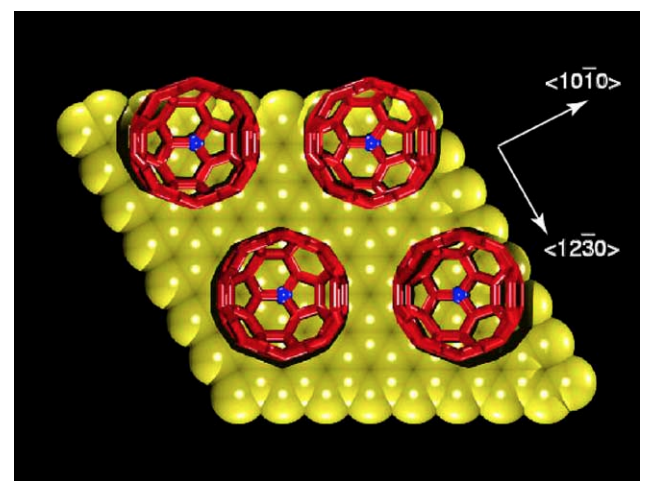
Legoas, Sergio B; Giro, Ronaldo; Galvao, Douglas S
Molecular dynamics simulations of C6) nanobearings Journal Article
Em: Chemical physics letters, vol. 386, não 4, pp. 425–429, 2004.
Resumo | Links | BibTeX | Tags: C60, Fullerenes, Molecular Dynamics, Nanobearing, Tribology
@article{legoas2004molecular,
title = {Molecular dynamics simulations of C6) nanobearings},
author = {Legoas, Sergio B and Giro, Ronaldo and Galvao, Douglas S},
url = {http://www.sciencedirect.com/science/article/pii/S000926140400168X},
year = {2004},
date = {2004-01-01},
journal = {Chemical physics letters},
volume = {386},
number = {4},
pages = {425--429},
publisher = {Elsevier},
abstract = {Recently was reported an ultra-lubricated system based on C60 molecules deposited over graphite layers. In that work a stick-slip rolling model for C60 molecules was proposed to explain the observed ultra-low friction force. In this Letter, we report the first molecular dynamics studies for these systems. Our results show that the AB stacking is not observed and the main experimental features can be explained without invoking stick-slip motions.
},
keywords = {C60, Fullerenes, Molecular Dynamics, Nanobearing, Tribology},
pubstate = {published},
tppubtype = {article}
}
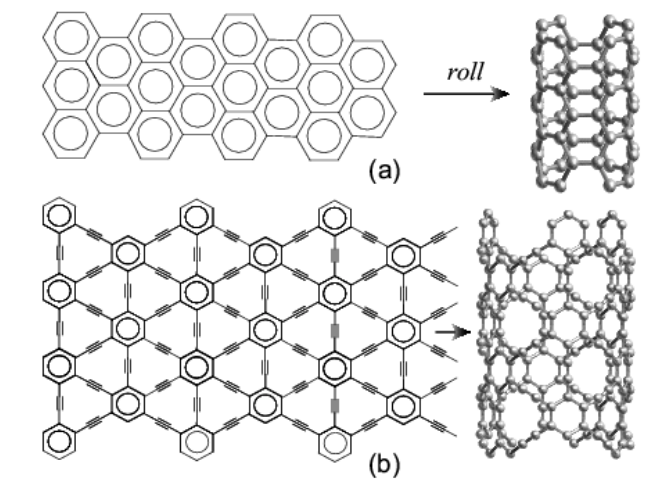
Coluci, VR; Braga, SF; Legoas, SB; Galvao, DS; Baughman, RH
New families of carbon nanotubes based on graphyne motifs Journal Article
Em: Nanotechnology, vol. 15, não 4, pp. S142, 2004.
Resumo | Links | BibTeX | Tags: Allotropes, Electronic Structure, Graphynes, Nanotubes
@article{coluci2004new,
title = {New families of carbon nanotubes based on graphyne motifs},
author = {Coluci, VR and Braga, SF and Legoas, SB and Galvao, DS and Baughman, RH},
url = {http://iopscience.iop.org/0957-4484/15/4/006},
year = {2004},
date = {2004-01-01},
journal = {Nanotechnology},
volume = {15},
number = {4},
pages = {S142},
publisher = {IOP Publishing},
abstract = {Electronic properties of proposed new families of carbon single walled nanotubes are investigated. These nanotubes, called graphynes, result from the elongation of covalent interconnections of graphite-based nanotubes by the introduction of yne groups. Analogous to ordinary nanotubes, armchair, zigzag and chiral graphyne nanotubes are possible. Tight-binding and ab initio density functional methods were used to predict the electronic properties of these unusual nanotubes. Of the three graphyne nanotube families analysed here, two provide metallic behaviour for armchair tubes and either metallic or semiconducting behaviour for zigzag nanotubes. For the other graphyne nanotube family investigated a diameter and chirality independent bandgap is predicted and a bandgap modulation study by structural distortions has been carried out for small longitudinal tube deformations. Interestingly, while the bandgap is insensitive to structure, the stress-induced bandgap changes can strongly depend both on the nanotube type and whether the strain is tensile or compressive.
},
keywords = {Allotropes, Electronic Structure, Graphynes, Nanotubes},
pubstate = {published},
tppubtype = {article}
}
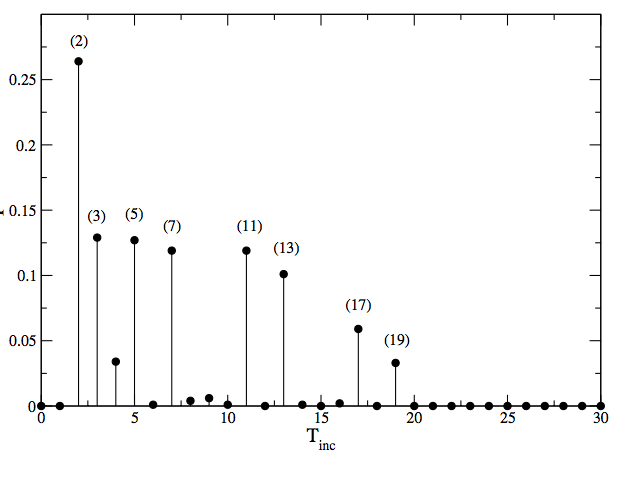
Campos, Paulo RA; de Oliveira, Viviane M; Giro, Ronaldo; Galvao, Douglas S
Emergence of prime numbers as the result of evolutionary strategy Journal Article
Em: Physical Review Letters, vol. 93, não 9, pp. 098107, 2004.
Resumo | Links | BibTeX | Tags: Cellular Automata, Cicadas, Patterns, Prime Numbers, top20
@article{campos2004emergence,
title = {Emergence of prime numbers as the result of evolutionary strategy},
author = {Campos, Paulo RA and de Oliveira, Viviane M and Giro, Ronaldo and Galvao, Douglas S},
url = {http://journals.aps.org/prl/abstract/10.1103/PhysRevLett.93.098107},
year = {2004},
date = {2004-01-01},
journal = {Physical Review Letters},
volume = {93},
number = {9},
pages = {098107},
publisher = {American Physical Society},
abstract = {We investigate by means of a simple theoretical model the emergence of prime numbers as life cycles, as those seen for some species of cicadas. The cicadas, more precisely the Magicicadas, spend most of their lives below the ground and then emerge and die in a short period of time. The Magicicadas display an uncommon behavior: their emergence is synchronized and these periods are usually prime numbers. In the current work, we develop a spatially extended model at which preys and predators coexist and can change their evolutionary dynamics through the occurrence of mutations. We verified that prime numbers as life cycles emerge as a result of the evolution of the population. Our results seem to be a first step in order to prove that the development of such strategy is selectively advantageous, especially for those organisms that are highly vulnerable to attacks of predators.},
keywords = {Cellular Automata, Cicadas, Patterns, Prime Numbers, top20},
pubstate = {published},
tppubtype = {article}
}
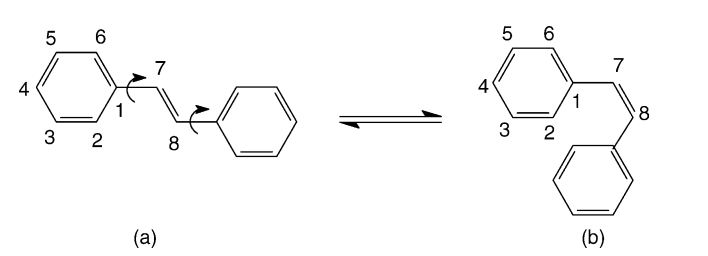
Vendrame, R; Coluci, Vitor Rafael; Galvao, Douglas Soares
Comparative parametric method 5 (PM5) study of trans-stilbene Journal Article
Em: Journal of Molecular Structure: THEOCHEM, vol. 686, não 1, pp. 103–108, 2004.
Resumo | Links | BibTeX | Tags: Electronic Structure, MOPAC, PM3, PM5, Stilbene
@article{vendrame2004comparative,
title = {Comparative parametric method 5 (PM5) study of trans-stilbene},
author = {Vendrame, R and Coluci, Vitor Rafael and Galvao, Douglas Soares},
url = {http://www.sciencedirect.com/science/article/pii/S0166128004005998},
year = {2004},
date = {2004-01-01},
journal = {Journal of Molecular Structure: THEOCHEM},
volume = {686},
number = {1},
pages = {103--108},
publisher = {Elsevier},
abstract = {In this work we report a comparative Austin method 1 (AM1), parametric method 3 (PM3), and parametric method 5 (PM5) studies for trans-stilbene in its ground, excited (singlet and triplet), and ionic (positive and negative polarons and bipolarons) states. We evaluated the accuracy of the recently developed PM5 method. PM5 and AM1 predict a non-planar ground and singlet states for trans-stilbene, while PM3 predicts planar ones, which is in agreement with the available experimental data. In general the PM3 and PM5 bond lengths are superior to AM1 while AM1 bond angles are superior to PM3 and PM5 when compared with available experimental data. The PM5 underestimates the cis–trans isomerization energy and and it is not a quite reliable method for the calculation of relative IP values. The presumed PM5 superior performance against AM1 and PM3 was not observed for the stilbene structures.
},
keywords = {Electronic Structure, MOPAC, PM3, PM5, Stilbene},
pubstate = {published},
tppubtype = {article}
}
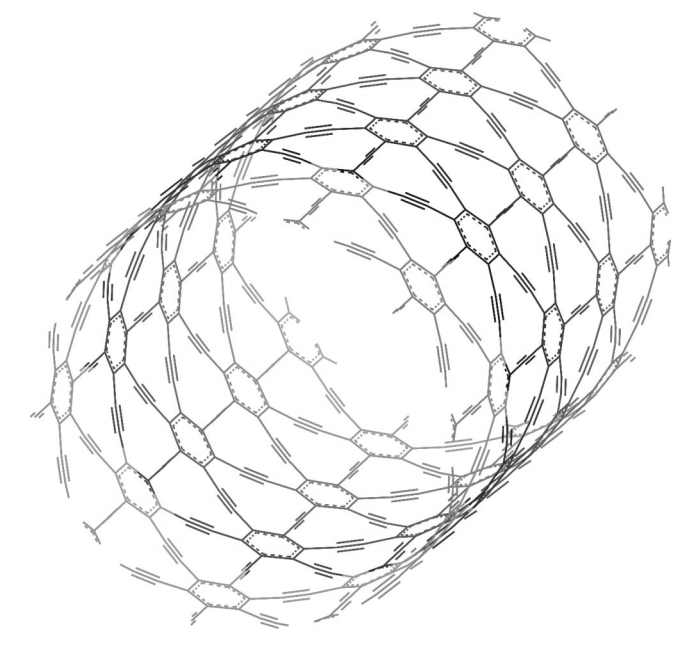
Coluci, VR; Galvao, DS; Baughman, RH
Theoretical investigation of electromechanical effects for graphyne carbon nanotubes Journal Article
Em: The Journal of chemical physics, vol. 121, não 7, pp. 3228–3237, 2004.
Resumo | Links | BibTeX | Tags: Allotropes, Electroactuation, Electronic Structure, Graphynes, Nanotubes
@article{coluci2004theoretical,
title = {Theoretical investigation of electromechanical effects for graphyne carbon nanotubes},
author = {Coluci, VR and Galvao, DS and Baughman, RH},
url = {http://scitation.aip.org/content/aip/journal/jcp/121/7/10.1063/1.1772756},
year = {2004},
date = {2004-01-01},
journal = {The Journal of chemical physics},
volume = {121},
number = {7},
pages = {3228--3237},
publisher = {AIP Publishing},
abstract = {We present a theoretical study of the electronic and mechanical properties of graphyne-based nanotubes (GNTs). These semiconducting nanotubes result from the elongation of one-third of the covalent interconnections of graphite-based nanotubes by the introduction of yne groups. The effect of charge injection on the dimensions of GNTs was investigated using tight-binding calculations. Low amounts of electron injection are predicted to cause qualitatively different responses for armchair and zigzag graphyne nanotubes. Although the behavior is qualitatively similar to the usual carbon nanotubes, the charge-induced strains are predicted to be smaller for the GNTs than for ordinary single walled carbon nanotubes.},
keywords = {Allotropes, Electroactuation, Electronic Structure, Graphynes, Nanotubes},
pubstate = {published},
tppubtype = {article}
}
![Benzo [c] quinolizin-3-ones theoretical investigation: SAR analysis and application to nontested compounds](https://sites.ifi.unicamp.br/galvao/files/2015/02/Screen-Shot-2015-02-26-at-12.21.40-PM.png)
Braga, Scheila Furtado; Galvao, Douglas Soares
Benzo [c] quinolizin-3-ones theoretical investigation: SAR analysis and application to nontested compounds Journal Article
Em: Journal of chemical information and computer sciences, vol. 44, não 6, pp. 1987–1997, 2004.
Resumo | Links | BibTeX | Tags: Drug Design, Electronic Structure, PCA/HCA, Theory of Electronic Indices
@article{braga2004benzo,
title = {Benzo [c] quinolizin-3-ones theoretical investigation: SAR analysis and application to nontested compounds},
author = {Braga, Scheila Furtado and Galvao, Douglas Soares},
url = {http://pubs.acs.org/doi/abs/10.1021/ci049837u},
year = {2004},
date = {2004-01-01},
journal = {Journal of chemical information and computer sciences},
volume = {44},
number = {6},
pages = {1987--1997},
publisher = {American Chemical Society},
abstract = {We investigate with the use of theoretical methodologies the activity of a set of 41 benzo[c]quinolizin-3-
ones (BC3), some of them explored as selective inhibitors of the human 5R-reductase steroid. For the
structure-activity study we have considered dividing the molecules into groups of tested and nontested
compounds. Semiempirical calculations and pattern recognition methods such as Electronic Indices
Methodology (EIM), Principal Components Analysis (PCA), Hierarchical Cluster Analysis (HCA), and
K-Nearest Neighbors (KNN) have been applied to search for a correlation between experimental activity
and theoretical descriptors. Our results show that it is possible to directly correlate some molecular quantum
descriptors with BC3 biological activity. This information can be used in principle to identify active/inactive
untested compounds and/or to design new active compounds.},
keywords = {Drug Design, Electronic Structure, PCA/HCA, Theory of Electronic Indices},
pubstate = {published},
tppubtype = {article}
}
ones (BC3), some of them explored as selective inhibitors of the human 5R-reductase steroid. For the
structure-activity study we have considered dividing the molecules into groups of tested and nontested
compounds. Semiempirical calculations and pattern recognition methods such as Electronic Indices
Methodology (EIM), Principal Components Analysis (PCA), Hierarchical Cluster Analysis (HCA), and
K-Nearest Neighbors (KNN) have been applied to search for a correlation between experimental activity
and theoretical descriptors. Our results show that it is possible to directly correlate some molecular quantum
descriptors with BC3 biological activity. This information can be used in principle to identify active/inactive
untested compounds and/or to design new active compounds.
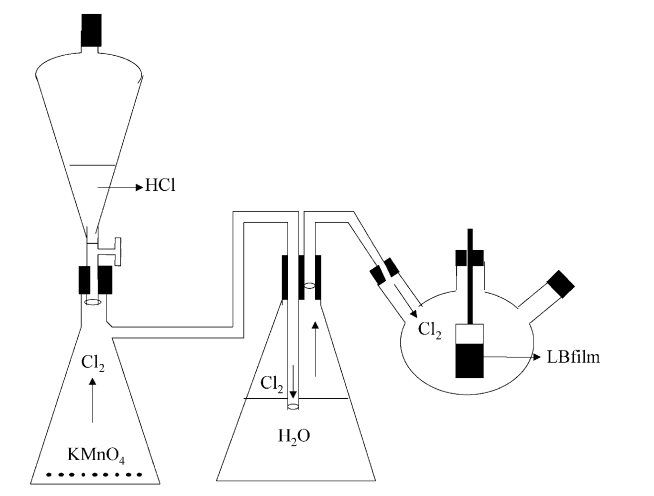
Gaffo, Luciana; Couto Jr, Odilon DD; Giro, Ronaldo; Brasil, Maria JSP; Galvao, Douglas S; Cerdeira, Fernando; de Oliveira Jr, Osvaldo N; Wohnrath, Karen
Effects of chlorine gas exposure on the optical properties of rhodium phthalocyanine films Journal Article
Em: Solid state communications, vol. 131, não 1, pp. 53–56, 2004.
Resumo | Links | BibTeX | Tags: Films, Phthalocyanine, Sensors
@article{gaffo2004effects,
title = {Effects of chlorine gas exposure on the optical properties of rhodium phthalocyanine films},
author = {Gaffo, Luciana and Couto Jr, Odilon DD and Giro, Ronaldo and Brasil, Maria JSP and Galvao, Douglas S and Cerdeira, Fernando and de Oliveira Jr, Osvaldo N and Wohnrath, Karen},
url = {http://www.sciencedirect.com/science/article/pii/S0038109804002996},
year = {2004},
date = {2004-01-01},
journal = {Solid state communications},
volume = {131},
number = {1},
pages = {53--56},
publisher = {Pergamon},
abstract = {We investigated the effects of exposing rhodium phthalocyanine films deposited on glass substrates by the Lagmuir–Blodgett technique to chlorine gas. The visual aspect of the films is altered upon chlorination, changing in color from blue to transparent. We performed optical absorption and Raman Scattering measurements on our films prior to and after exposing it to chlorine gas. We observed a pronounced quenching of the characteristic triplet centered around the Q-absorption band at 662 nm as a result of chlorine incorporation. Another absorption band, in the near UV part of the spectrum, is not greatly affected by the process. No new optical structures appear as a consequence of chlorination. Equivalent effects were observed in the Raman spectra. Leaving the previously exposed films in air for several hours results in a slow partial recovery of the optical spectra. This recovery, as well as the amount of original quenching, depends on the amount of time during which the film was exposed to chlorine.},
keywords = {Films, Phthalocyanine, Sensors},
pubstate = {published},
tppubtype = {article}
}
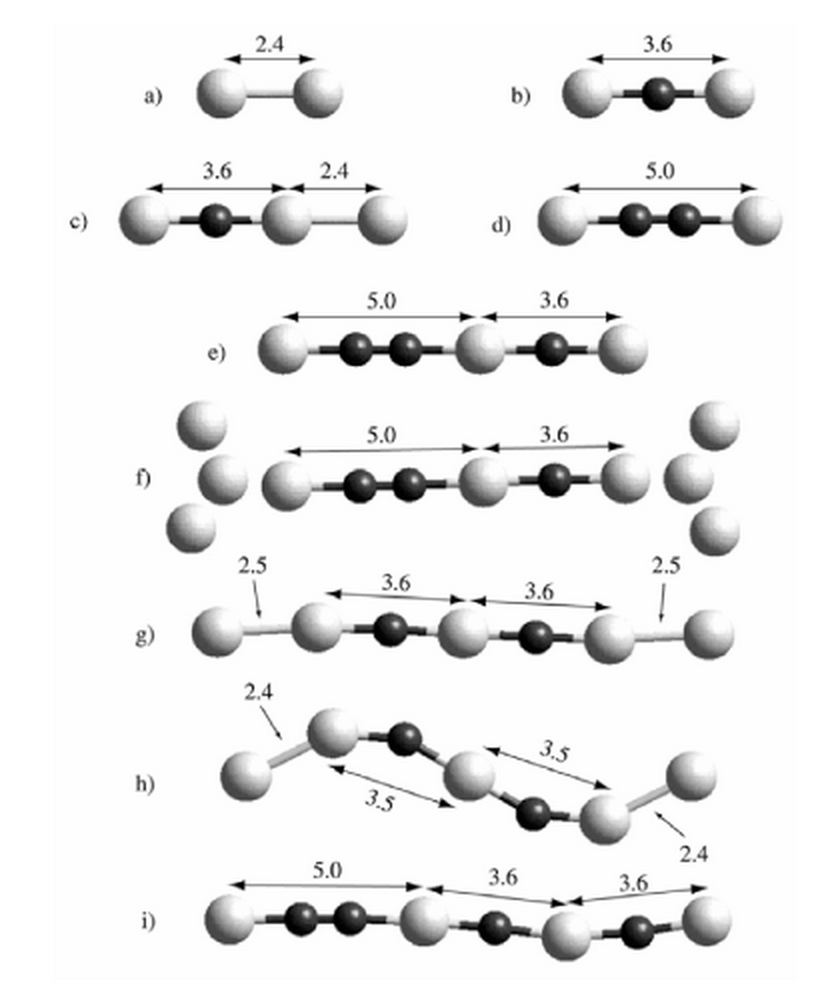
Galvao, Douglas Soares; Rodrigues, Varlei; Ugarte, Daniel; Legoas, Sergio Benites
The role of carbon contamination in metallic nanowires Journal Article
Em: Materials Research, vol. 7, não 2, pp. 339–342, 2004.
Resumo | Links | BibTeX | Tags: Contaminantes, Electronic Structure, Linear Atomic Chains, Metallic Nanowires, Structure
@article{galvao2004role,
title = {The role of carbon contamination in metallic nanowires},
author = {Galvao, Douglas Soares and Rodrigues, Varlei and Ugarte, Daniel and Legoas, Sergio Benites},
url = {http://www.scielo.br/scielo.php?pid=S1516-14392004000200020&script=sci_arttext},
year = {2004},
date = {2004-01-01},
journal = {Materials Research},
volume = {7},
number = {2},
pages = {339--342},
publisher = {SciELO Brasil},
abstract = {Metallic nanowires have attracted much attention in the last years due to new phenomena such as quantum conductance and the existence of unexpected long interatomic distances attaining 0.3-0.5 nm. These large distances represented a challenge for physical interpretation. In this work we present experimental data from high-resolution transmission electron microscopy and results from ab initio calculations for suspended gold chains and show that these large distances can be easily explained by the presence of carbon atoms as contaminants. In principle the present conclusions can be also applied to other metallic nanowires (such as Ag and Pt) whose structures also present large interatomic distances.},
keywords = {Contaminantes, Electronic Structure, Linear Atomic Chains, Metallic Nanowires, Structure},
pubstate = {published},
tppubtype = {article}
}
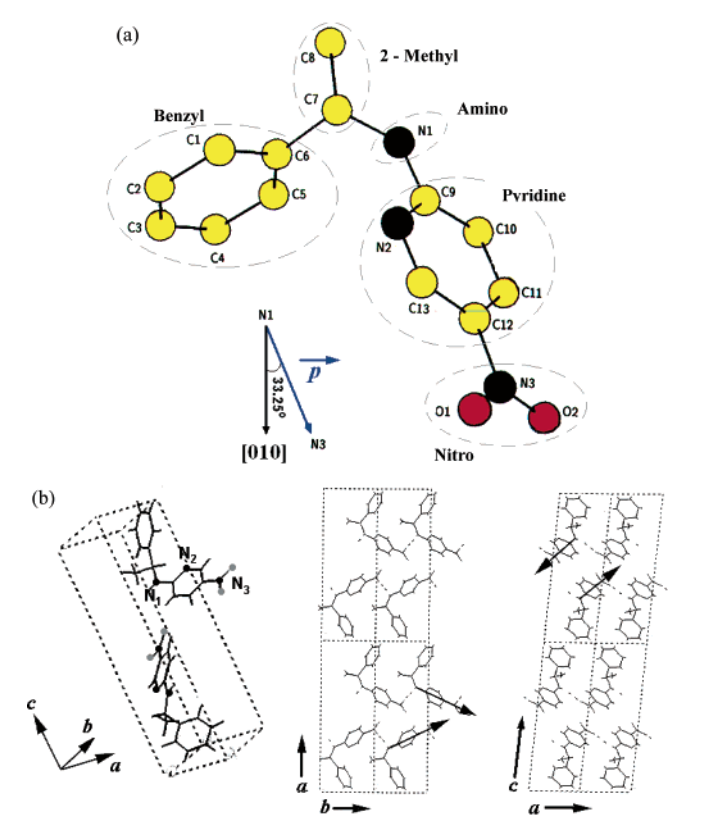
dos Santos, Adenilson O; Avanci, Luis H; Cardoso, Lisandro P; Giro, Ronaldo; Legoas, Sergio B; Galvao, Douglas S; Sherwood, John N
Hysteresis-like behavior in MBANP crystals Journal Article
Em: Crystal growth & design, vol. 4, não 5, pp. 1079–1081, 2004.
Resumo | Links | BibTeX | Tags: Crystallographic Structure, Electronic Structure, Molecular Crystals
@article{dos2004hysteresis,
title = {Hysteresis-like behavior in MBANP crystals},
author = {dos Santos, Adenilson O and Avanci, Luis H and Cardoso, Lisandro P and Giro, Ronaldo and Legoas, Sergio B and Galvao, Douglas S and Sherwood, John N},
url = {http://pubs.acs.org/doi/abs/10.1021/cg0341860},
year = {2004},
date = {2004-01-01},
journal = {Crystal growth & design},
volume = {4},
number = {5},
pages = {1079--1081},
publisher = {ACS Publications},
abstract = {he measured strain versus E-cycle in a MBANP organic single crystal showed interesting butterfly wing shape hysteresis behavior. Quantum mechanical calculations on isolated MBANP molecules have shown that the main features of the hysteresis shape can be explained in terms of field induced changes in the charge profiles and geometry of isolated MBANP molecules.},
keywords = {Crystallographic Structure, Electronic Structure, Molecular Crystals},
pubstate = {published},
tppubtype = {article}
}
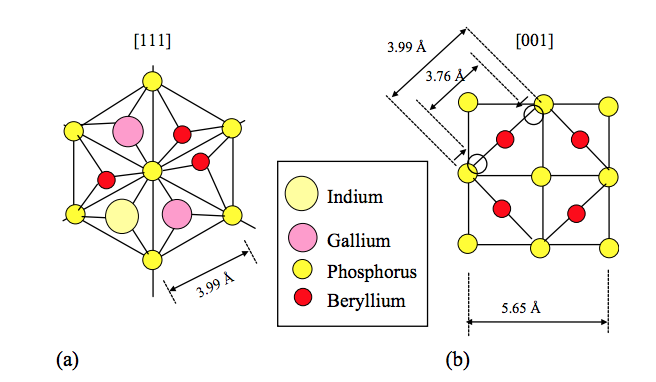
De Castro, MPP; Von Zuben, AA; Frateschi, NC; Santo, LLE; Galvao, DS; Bettini, J; De Carvalho, MMG
Strong spatial beryllium doping selectivity on InGaP layers grown on pre-patterned GaAs substrates by chemical beam epitaxy Journal Article
Em: Journal of crystal growth, vol. 266, não 4, pp. 429–434, 2004.
Resumo | Links | BibTeX | Tags: Crystal Growth, Doping, Electronic Structure
@article{de2004strong,
title = {Strong spatial beryllium doping selectivity on InGaP layers grown on pre-patterned GaAs substrates by chemical beam epitaxy},
author = {De Castro, MPP and Von Zuben, AA and Frateschi, NC and Santo, LLE and Galvao, DS and Bettini, J and De Carvalho, MMG},
url = {http://www.sciencedirect.com/science/article/pii/S0022024804002829},
year = {2004},
date = {2004-01-01},
journal = {Journal of crystal growth},
volume = {266},
number = {4},
pages = {429--434},
publisher = {North-Holland},
abstract = {We present an investigation of beryllium doping selectivity in InGaP layers grown by chemical beam epitaxy on pre-patterned substrates. We observed a resistivity of 3.1×10−2 and 4.5×10−2 Ω cm for (1 1 1)A planes with the growth at 500°C and 540°C, respectively. The layers on (0 0 1) planes show a resistivity of 8.9×10−1 Ω cm with the growth at 500°C, being essentially undoped with the growth at 540°C ⋅ We show how this strong doping selectivity can be explained by Be3P2 cluster formation growth, which depends on growth temperature and planar crystalline structure.},
keywords = {Crystal Growth, Doping, Electronic Structure},
pubstate = {published},
tppubtype = {article}
}
2003
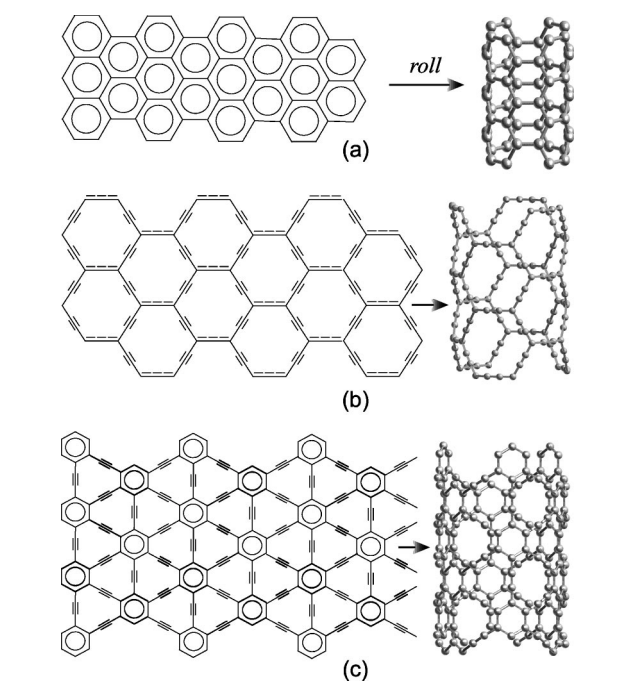
Coluci, VR; Braga, SF; Legoas, SB; Galvao, DS; Baughman, RH
Families of carbon nanotubes: Graphyne-based nanotubes Journal Article
Em: Physical Review B, vol. 68, não 3, pp. 035430, 2003.
Resumo | Links | BibTeX | Tags: Allotropes, Electronic Structure, Graphynes, Nanotubes
@article{coluci2003families,
title = {Families of carbon nanotubes: Graphyne-based nanotubes},
author = {Coluci, VR and Braga, SF and Legoas, SB and Galvao, DS and Baughman, RH},
url = {http://journals.aps.org/prb/abstract/10.1103/PhysRevB.68.035430},
year = {2003},
date = {2003-01-01},
journal = {Physical Review B},
volume = {68},
number = {3},
pages = {035430},
publisher = {APS},
abstract = {New families of carbon single-walled nanotubes are proposed and their electronic structures are investigated. These nanotubes, called graphynes, result from the elongation of covalent interconnections of graphite-based nanotubes by the introduction of yne groups. Analogously to ordinary nanotubes, armchair, zigzag, and chiral graphyne nanotubes are possible. We here predict the electronic properties of these unusual nanotubes using tight-binding and ab initio density functional methods. Of the three graphyne nanotube families analyzed here, two provide metallic behavior for armchair tubes and either metallic or semiconducting behavior for zigzag nanotubes. A diameter- and chirality-independent band gap is predicted for the other investigated graphyne family, as well as an oscillatory dependence of the effective mass on nanotube diameter.},
keywords = {Allotropes, Electronic Structure, Graphynes, Nanotubes},
pubstate = {published},
tppubtype = {article}
}
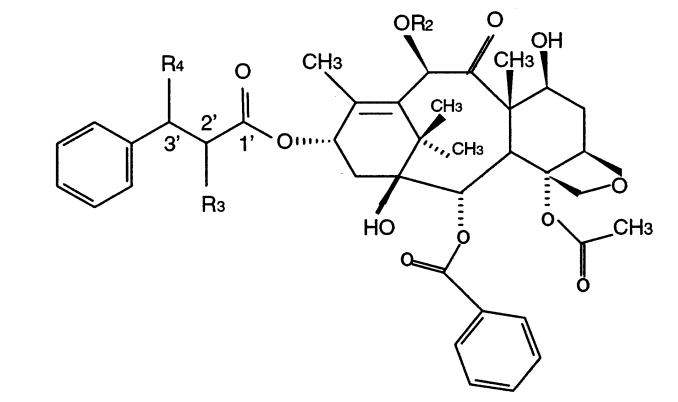
Braga, Scheila Furtado; Galvao, Douglas Soares
A structure-activity study of taxol, taxotere, and derivatives using the electronic indices methodology (EIM) Journal Article
Em: Journal of chemical information and computer sciences, vol. 43, não 2, pp. 699–706, 2003.
Resumo | Links | BibTeX | Tags: Drug Design, Electronic Structure, Taxol, Taxotere, Theory of Electronic Indices
@article{braga2003structure,
title = {A structure-activity study of taxol, taxotere, and derivatives using the electronic indices methodology (EIM)},
author = {Braga, Scheila Furtado and Galvao, Douglas Soares},
url = {http://pubs.acs.org/doi/abs/10.1021/ci025640v},
year = {2003},
date = {2003-01-01},
journal = {Journal of chemical information and computer sciences},
volume = {43},
number = {2},
pages = {699--706},
publisher = {American Chemical Society},
abstract = {Among the new families of effective anticancer drugs, the natural product paclitaxel (Taxol/Bristol-MyersSquibb)
and its semisynthetic derivative docetaxel (Taxotere/Rhone-Poulenc Rorer) are probably the most
promising agents under investigation. Surprisingly considering their importance no detailed quantum
mechanical studies have been carried out for these drugs. In this work we report the first structure-activity
relationship (SAR) studies for 20 taxoid structures using molecular descriptors from all-electron quantum
methods. The used methods were the pattern-recognition Principal Component Analysis (PCA), Hierarchical
Clustering Analysis (HCA), and the recently developed Electronic Indices Methodology (EIM). The combined
use of EIM with PCA/HCA methodologies was able to correctly classify active and inactive taxoids with
100% of accuracy using only a few “universal” quantum molecular descriptors. It was possible to identify
the electronic features defining active molecules. This information can be used to select and design new
active compounds. The combined use of EIM with PCA/HCA can be a new and very efficient tool in the
field of computer assisted drug design.},
keywords = {Drug Design, Electronic Structure, Taxol, Taxotere, Theory of Electronic Indices},
pubstate = {published},
tppubtype = {article}
}
and its semisynthetic derivative docetaxel (Taxotere/Rhone-Poulenc Rorer) are probably the most
promising agents under investigation. Surprisingly considering their importance no detailed quantum
mechanical studies have been carried out for these drugs. In this work we report the first structure-activity
relationship (SAR) studies for 20 taxoid structures using molecular descriptors from all-electron quantum
methods. The used methods were the pattern-recognition Principal Component Analysis (PCA), Hierarchical
Clustering Analysis (HCA), and the recently developed Electronic Indices Methodology (EIM). The combined
use of EIM with PCA/HCA methodologies was able to correctly classify active and inactive taxoids with
100% of accuracy using only a few “universal” quantum molecular descriptors. It was possible to identify
the electronic features defining active molecules. This information can be used to select and design new
active compounds. The combined use of EIM with PCA/HCA can be a new and very efficient tool in the
field of computer assisted drug design.
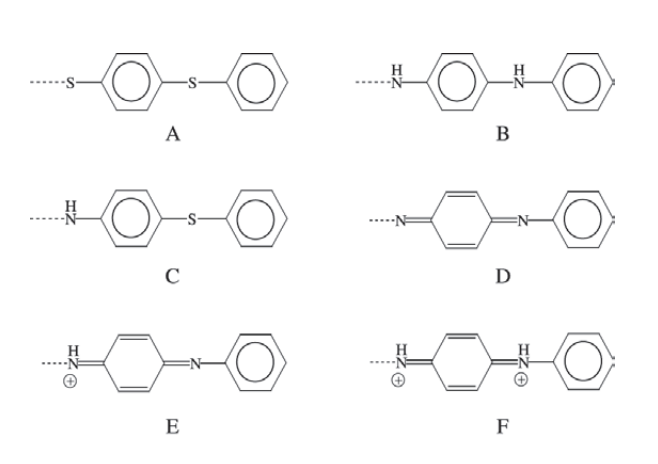
Giro, Ronaldo; Cyrillo, Marcio; Galvao, Douglas Soares
Using artificial intelligence methods to design new conducting polymers Journal Article
Em: Materials Research, vol. 6, não 4, pp. 523–528, 2003.
Resumo | Links | BibTeX | Tags: Artificial Intelligence, Conducting Polymers, Genetic Algorithms, Material Design
@article{giro2003using,
title = {Using artificial intelligence methods to design new conducting polymers},
author = {Giro, Ronaldo and Cyrillo, Marcio and Galvao, Douglas Soares},
url = {http://www.scielo.br/scielo.php?pid=S1516-14392003000400017&script=sci_arttext},
year = {2003},
date = {2003-01-01},
journal = {Materials Research},
volume = {6},
number = {4},
pages = {523--528},
publisher = {SciELO Brasil},
abstract = {In the last years the possibility of creating new conducting polymers exploring the concept of copolymerization (different structural monomeric units) has attracted much attention from experimental and theoretical points of view. Due to the rich carbon reactivity an almost infinite number of new structures is possible and the procedure of trial and error has been the rule. In this work we have used a methodology able of generating new structures with pre-specified properties. It combines the use of negative factor counting (NFC) technique with artificial intelligence methods (genetic algorithms - GAs). We present the results for a case study for poly(phenylenesulfide phenyleneamine) (PPSA), a copolymer formed by combination of homopolymers: polyaniline (PANI) and polyphenylenesulfide (PPS). The methodology was successfully applied to the problem of obtaining binary up to quinternary disordered polymeric alloys with a pre-specific gap value or exhibiting metallic properties. It is completely general and can be in principle adapted to the design of new classes of materials with pre-specified properties},
keywords = {Artificial Intelligence, Conducting Polymers, Genetic Algorithms, Material Design},
pubstate = {published},
tppubtype = {article}
}
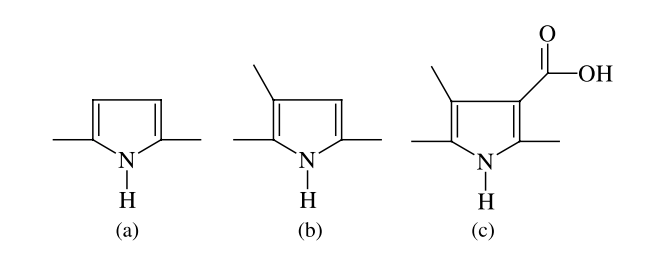
Del Nero, J; Galvao, DS; Laks, B
Electronic structure investigation of biosensor polymer Journal Article
Em: Optical Materials, vol. 21, não 1, pp. 461–466, 2003.
Resumo | Links | BibTeX | Tags: Conducting Polymers, Electronic Structure, Sensors
@article{del2003electronic,
title = {Electronic structure investigation of biosensor polymer},
author = {Del Nero, J and Galvao, DS and Laks, B},
url = {http://www.sciencedirect.com/science/article/pii/S0925346702001830},
year = {2003},
date = {2003-01-01},
journal = {Optical Materials},
volume = {21},
number = {1},
pages = {461--466},
publisher = {Elsevier},
abstract = {We report a theoretical study of the ground, excited and ionic states of 3-methyl pyrrole-4-carboxilic acid (MPC) oligomers and related compounds which present conformational defects. Our results reveal the existence of differentiated electronic behavior for MPC with relation to oligopyrrole derivatives. These electronic features might explain why MPC works properly as a biosensor for cytochrome C while no voltametric response is observed for unsubstituted poly(pyrrole).},
keywords = {Conducting Polymers, Electronic Structure, Sensors},
pubstate = {published},
tppubtype = {article}
}
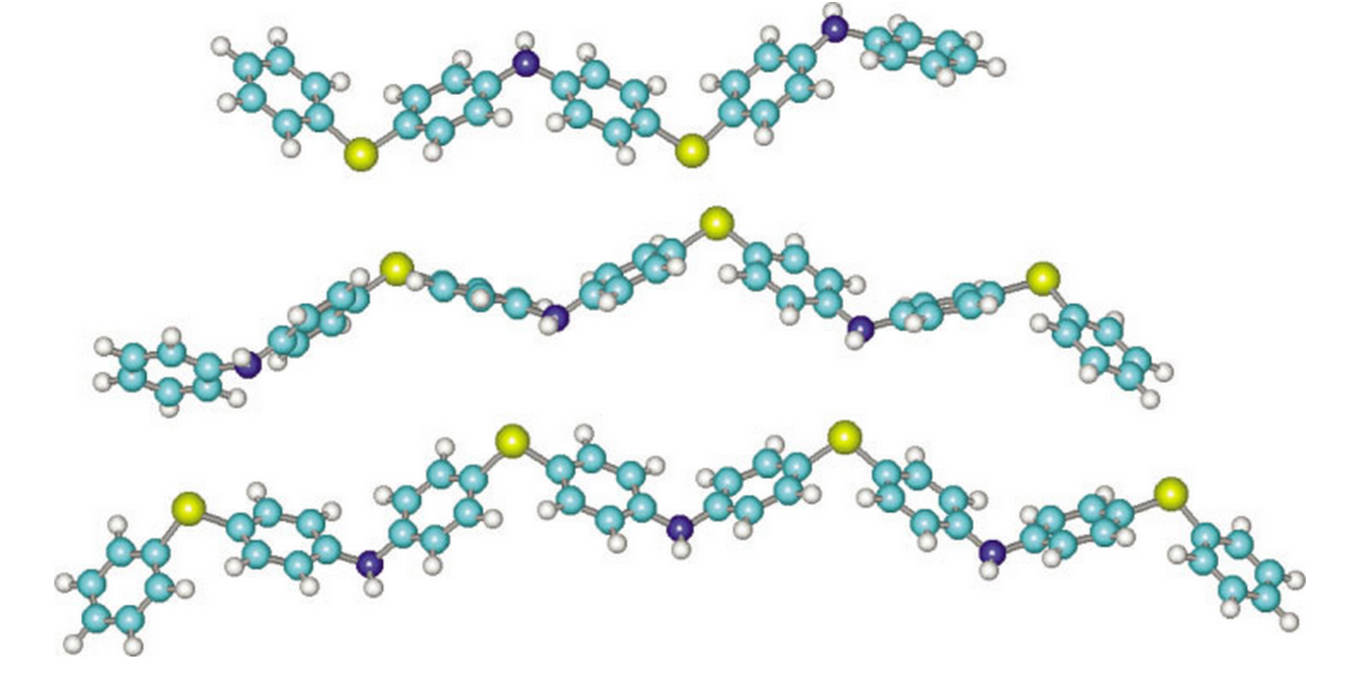
Giro, R; Galvao, DS
Semiempirical studies of the electronic structure of polyphenylene sulfide phenyleneamine Journal Article
Em: International journal of quantum chemistry, vol. 95, não 3, pp. 252–259, 2003.
Resumo | Links | BibTeX | Tags: co-polymers, Conducting Polymers, Electronic Structure, PANi, PPS, PPSA
@article{giro2003semiempirical,
title = {Semiempirical studies of the electronic structure of polyphenylene sulfide phenyleneamine},
author = {Giro, R and Galvao, DS},
url = {http://onlinelibrary.wiley.com/doi/10.1002/qua.10722/full},
year = {2003},
date = {2003-01-01},
journal = {International journal of quantum chemistry},
volume = {95},
number = {3},
pages = {252--259},
publisher = {Wiley Subscription Services, Inc., A Wiley Company},
abstract = {Polyphenylene sulfide (PPS) and polyaniline (PANI) are heteroatom-containing polymers with unique properties. While PPS provides a good level of chemical and thermal stability, PANI is important due to its ability to form electrically conducting films. A combination of PPS and PANI, with alternating phenyleneamine and phenylene sulfide blocks, resulted in a new material combining the structural features of PPS and PANI. This copolymer is known as polyphenylene sulfide–phenyleneamine (PPSA). In this work we present geometric and spectroscopic studies on PPSA oligomers using the well-known semiempirical methods PM3 (parametric method 3) and ZINDO-S/CI (Zerner's intermediate neglect of differential overlap/spectroscopic-configuration interaction). PM3 results show that long PPSA oligomers present alternating in- and out-of-plane rings with torsion angles about 60°. The ZINDO-simulated spectra compare well with the available experimental data. The origin of the low PPSA conductivity is addressed in terms of electronic features presented by isolated polymeric chains. © 2003 Wiley Periodicals, Inc. Int J Quantum Chem 95: 252–259, 2003},
keywords = {co-polymers, Conducting Polymers, Electronic Structure, PANi, PPS, PPSA},
pubstate = {published},
tppubtype = {article}
}
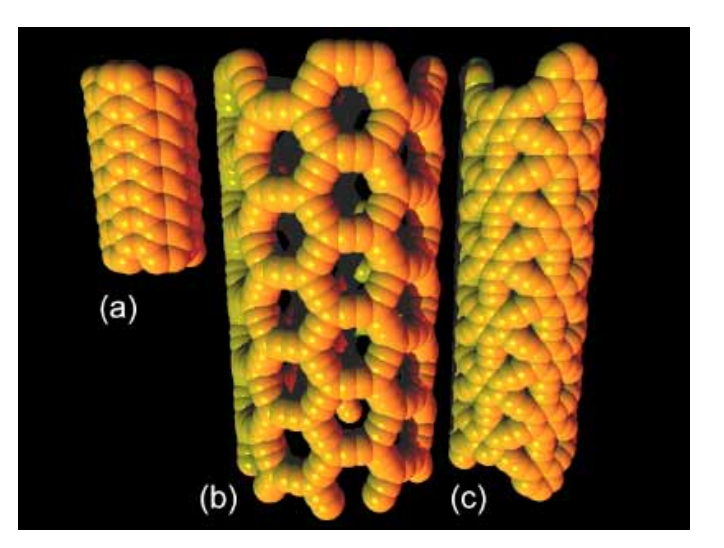
Coluci, VR; Braga, SF; Legoas, SB; Galvao, DS; Baughman, RH
Graphyne Nanotubes: New Families of Carbon Nanotubes Proceedings
Warrendale, Pa.; Materials Research Society; 1999, vol. 739, 2003.
Resumo | Links | BibTeX | Tags: Allotropes, Electronic Structure, Graphynes, Nanotubes
@proceedings{coluci2003graphyne,
title = {Graphyne Nanotubes: New Families of Carbon Nanotubes},
author = {Coluci, VR and Braga, SF and Legoas, SB and Galvao, DS and Baughman, RH},
url = {http://journals.cambridge.org/action/displayAbstract?fromPage=online&aid=8031794},
year = {2003},
date = {2003-01-01},
journal = {MATERIALS RESEARCH SOCIETY SYMPOSIUM PROCEEDINGS},
volume = {739},
pages = {175--180},
publisher = {Warrendale, Pa.; Materials Research Society; 1999},
abstract = {Fundamentally new families of carbon single walled nanotubes are proposed. These nanotubes, called graphynes, result from the elongation of covalent interconnections of graphite-based nanotubes by the introduction of yne groups. Similarly to ordinary nanotubes, armchair, zig-zag, and chiral graphyne nanotubes are possible. We present here results for the electronic properties of graphyne based tubes obtained from tight-binding and ab initio density functional methods.},
keywords = {Allotropes, Electronic Structure, Graphynes, Nanotubes},
pubstate = {published},
tppubtype = {proceedings}
}
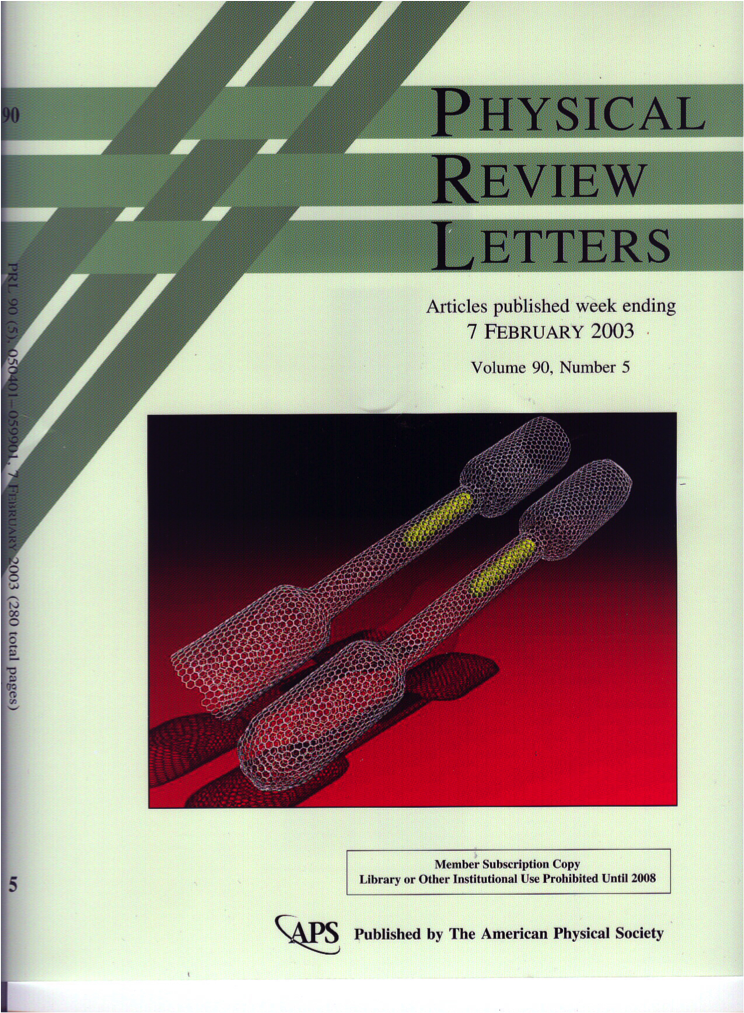
VR Coluci SB Legoas, SF Braga
Molecular-dynamics simulations of carbon nanotubes as gigahertz oscillators Journal Article
Em: Physical Review Letters, vol. 90, não 5, pp. 055504, 2003.
Resumo | BibTeX | Tags: Carbon Nanotubes, Molecular Dynamics, Oscillators, top20
@article{legoas2003molecularb,
title = {Molecular-dynamics simulations of carbon nanotubes as gigahertz oscillators},
author = {SB Legoas, VR Coluci, SF Braga, PZ Coura, SO Dantas, DS Galvao},
year = {2003},
date = {2003-01-01},
journal = {Physical Review Letters},
volume = {90},
number = {5},
pages = {055504},
abstract = {Recently, Zheng and Jiang [Phys. Rev. Lett. 88, 045503 (2002)] have proposed that multiwalled carbon nanotubes could be the basis for a new generation of nano-oscillators in the several gigahertz range. In this Letter, we present the first molecular dynamics simulation for these systems. Different nanotube types were considered in order to verify the reliability of such devices as gigahertz oscillators. Our results show that these nano-oscillators are dynamically stable when the radii difference values between inner and outer tubes are of ∼3.4 Å. Frequencies as large as 38 GHz were observed, and the calculated force values are in good agreement with recent experimental investigations.},
keywords = {Carbon Nanotubes, Molecular Dynamics, Oscillators, top20},
pubstate = {published},
tppubtype = {article}
}
2002
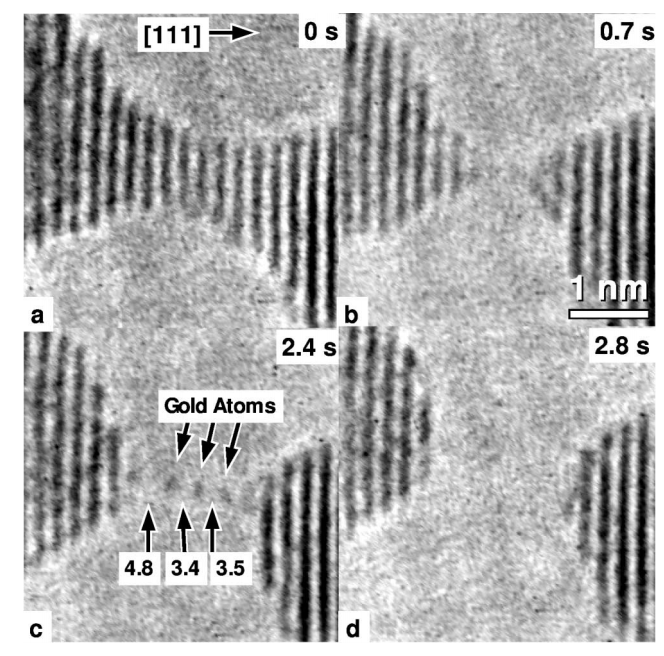
Legoas, Sergio B; Galvao, Douglas S; Rodrigues, Varlei; Ugarte, Daniel
Origin of anomalously long interatomic distances in suspended gold chains Journal Article
Em: Physical Review Letters, vol. 88, não 7, pp. 076105, 2002.
Resumo | Links | BibTeX | Tags: DFT, Electronic Structure, Linear Atomic Chains, Metallic Nanowires, TEM, top20
@article{legoas2002origin,
title = {Origin of anomalously long interatomic distances in suspended gold chains},
author = {Legoas, Sergio B and Galvao, Douglas S and Rodrigues, Varlei and Ugarte, Daniel},
url = {http://journals.aps.org/prl/abstract/10.1103/PhysRevLett.88.076105},
year = {2002},
date = {2002-01-01},
journal = {Physical Review Letters},
volume = {88},
number = {7},
pages = {076105},
publisher = {American Physical Society},
abstract = {The discovery of long bonds in gold atom chains has represented a challenge for physical interpretation. In fact, interatomic distances frequently attain 3.0–3.6 Å values, and distances as large as 5.0 Å may be occasionally observed. Here we studied gold chains by transmission electron microscopy and performed theoretical calculations using cluster ab initio density functional formalism. We show that the insertion of two carbon atoms is required to account for the longest bonds, while distances above 3 Å may be due to a mixture of clean and one C atom contaminated bonds.},
keywords = {DFT, Electronic Structure, Linear Atomic Chains, Metallic Nanowires, TEM, top20},
pubstate = {published},
tppubtype = {article}
}
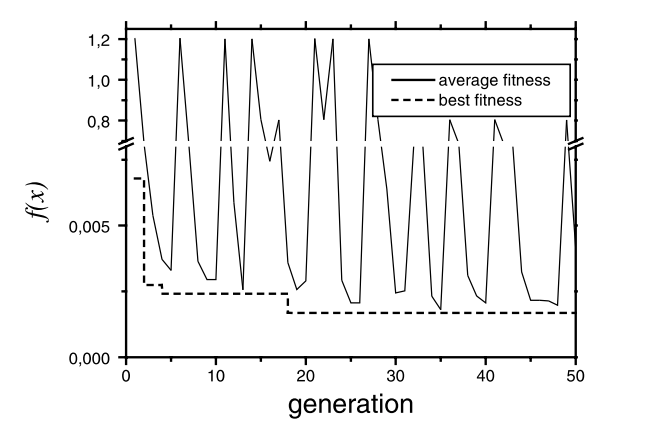
Giro, R; Cyrillo, M; Galvao, DS
Designing conducting polymers using genetic algorithms Journal Article
Em: Chemical Physics Letters, vol. 366, não 1, pp. 170–175, 2002.
Resumo | Links | BibTeX | Tags: Conducting Polymers, Electronic Structure, Genetic Algorithms, Material Design
@article{giro2002designing,
title = {Designing conducting polymers using genetic algorithms},
author = {Giro, R and Cyrillo, M and Galvao, DS},
url = {http://www.sciencedirect.com/science/article/pii/S0009261402015476},
year = {2002},
date = {2002-01-01},
journal = {Chemical Physics Letters},
volume = {366},
number = {1},
pages = {170--175},
publisher = {North-Holland},
abstract = {We have developed a new methodology to design conducting polymers with pre-specified properties. The methodology is based on the use of genetic algorithms (GAs) coupled to Negative Factor Counting technique. We present the results for a case study of polyanilines, one of the most important families of conducting polymers. The methodology proved to be able of generating automatic solutions for the problem of determining the optimum relative concentration for binary and ternary disordered polyaniline alloys exhibiting metallic properties. The methodology is completely general and can be used to design new classes of materials.},
keywords = {Conducting Polymers, Electronic Structure, Genetic Algorithms, Material Design},
pubstate = {published},
tppubtype = {article}
}
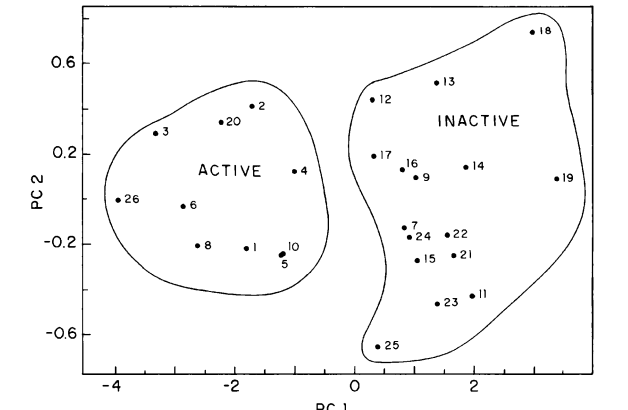
Coluci, Vitor Rafael; Vendrame, Rosana; Braga, RS; Galvao, DS
Em: Journal of chemical information and computer sciences, vol. 42, não 6, pp. 1479–1489, 2002.
Resumo | Links | BibTeX | Tags: Carcinogenesis, Neural Networks, PCA/HCA, Polycyclic Aromatic Hydrocarbons (PAHs), Theory of Electronic Indices
@article{coluci2002identifying,
title = {Identifying relevant molecular descriptors related to carcinogenic activity of polycyclic aromatic hydrocarbons (PAHs) using pattern recognition methods},
author = {Coluci, Vitor Rafael and Vendrame, Rosana and Braga, RS and Galvao, DS},
url = {http://pubs.acs.org/doi/abs/10.1021/ci025577%2B},
year = {2002},
date = {2002-01-01},
journal = {Journal of chemical information and computer sciences},
volume = {42},
number = {6},
pages = {1479--1489},
publisher = {American Chemical Society},
abstract = {Polycyclic Aromatic Hydrocarbons (PAHs) constitute an important family of molecules capable of inducing
chemical carcinogenesis. In this work we report structure-activity relationship (SAR) studies for 81 PAHs
using the pattern-recognition methods Principal Component Analysis (PCA), Hierarchical Clustering Analysis
(HCA) and Neural Networks (NN). The used molecular descriptors were obtained from the semiempirical
Parametric Method 3 (PM3) calculations. We have developed a new procedure that is capable of identifying
the PAHs’ carcinogenic activity with an accuracy higher than 80%. PCA selected molecular descriptors
that can be directly correlated with some models proposed to PAHs’ metabolic activation mechanism leading
to the formation of PAHs-DNA adducts. PCA, HCA and NN validate the energy separation between the
highest occupied molecular orbital and its next lower level as a major descriptor defining the carcinogenic
activity. This descriptor has been only recently discussed in the literature as one new possible universal
parameter for defining the biological activity of several classes of compounds.},
keywords = {Carcinogenesis, Neural Networks, PCA/HCA, Polycyclic Aromatic Hydrocarbons (PAHs), Theory of Electronic Indices},
pubstate = {published},
tppubtype = {article}
}
chemical carcinogenesis. In this work we report structure-activity relationship (SAR) studies for 81 PAHs
using the pattern-recognition methods Principal Component Analysis (PCA), Hierarchical Clustering Analysis
(HCA) and Neural Networks (NN). The used molecular descriptors were obtained from the semiempirical
Parametric Method 3 (PM3) calculations. We have developed a new procedure that is capable of identifying
the PAHs’ carcinogenic activity with an accuracy higher than 80%. PCA selected molecular descriptors
that can be directly correlated with some models proposed to PAHs’ metabolic activation mechanism leading
to the formation of PAHs-DNA adducts. PCA, HCA and NN validate the energy separation between the
highest occupied molecular orbital and its next lower level as a major descriptor defining the carcinogenic
activity. This descriptor has been only recently discussed in the literature as one new possible universal
parameter for defining the biological activity of several classes of compounds.
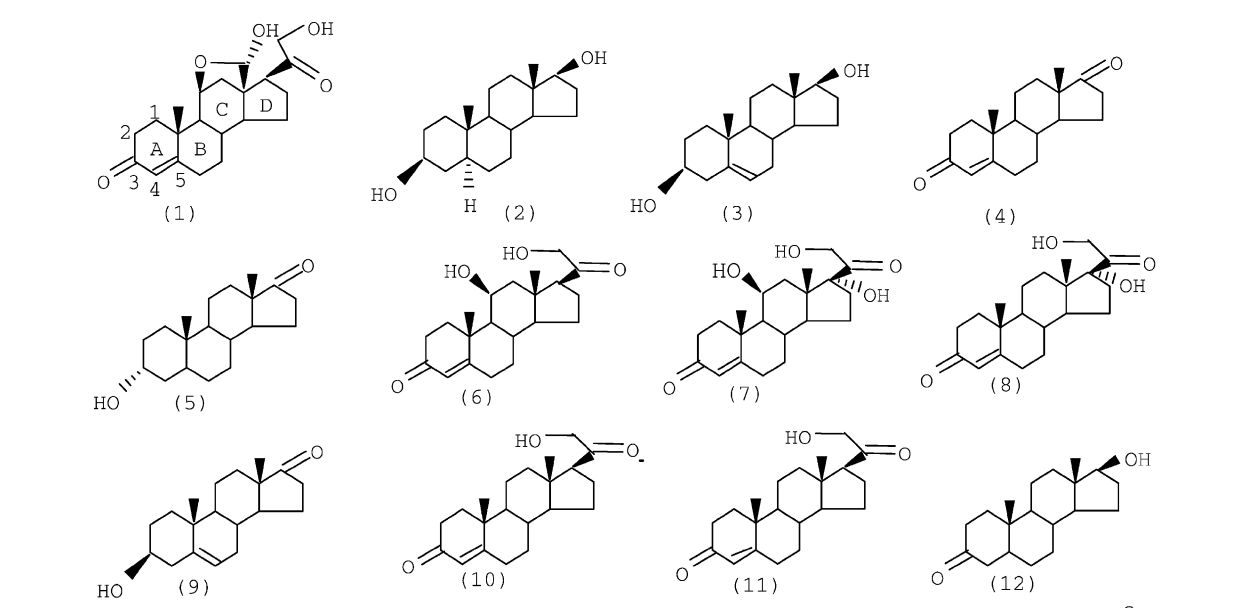
Vendrame, R; Coluci, VR; Braga, RS; Galvao, DS
Structure--activity relationship (SAR) studies of the tripos benchmark steroids Journal Article
Em: Journal of Molecular Structure: THEOCHEM, vol. 619, não 1, pp. 195–205, 2002.
Resumo | Links | BibTeX | Tags: Drug Design, Electronic Structure, HCA/PCA, Neural Networks, Tripos
@article{vendrame2002structure,
title = {Structure--activity relationship (SAR) studies of the tripos benchmark steroids},
author = {Vendrame, R and Coluci, VR and Braga, RS and Galvao, DS},
url = {http://www.sciencedirect.com/science/article/pii/S016612800200578X},
year = {2002},
date = {2002-01-01},
journal = {Journal of Molecular Structure: THEOCHEM},
volume = {619},
number = {1},
pages = {195--205},
publisher = {Elsevier},
abstract = {We report here qualitative structure–activity relationship (SAR) studies for the molecular set called Tripos or Cramer steroid data set. These compounds are known to bind to corticosteroid binding globulin (CBG). In the present work we have used the electronic indices methodology (EIM). The EIM is based on Boolean relational rules exploring the concepts of local density of states and critical values for energy separation involving frontier orbitals. We have also carried out comparative principal component analysis (PCA) and hierarchical clustering analysis (HCA) studies with molecular descriptors obtained from EIM calculations. EIM, PCA and HCA correctly predict (100% accuracy) the steroid's biological activity. The present studies reinforce the universal applicability of the EIM descriptors and show that the combined use of EIM coupled to PCA can be a new efficient and powerful SAR tool.
},
keywords = {Drug Design, Electronic Structure, HCA/PCA, Neural Networks, Tripos},
pubstate = {published},
tppubtype = {article}
}
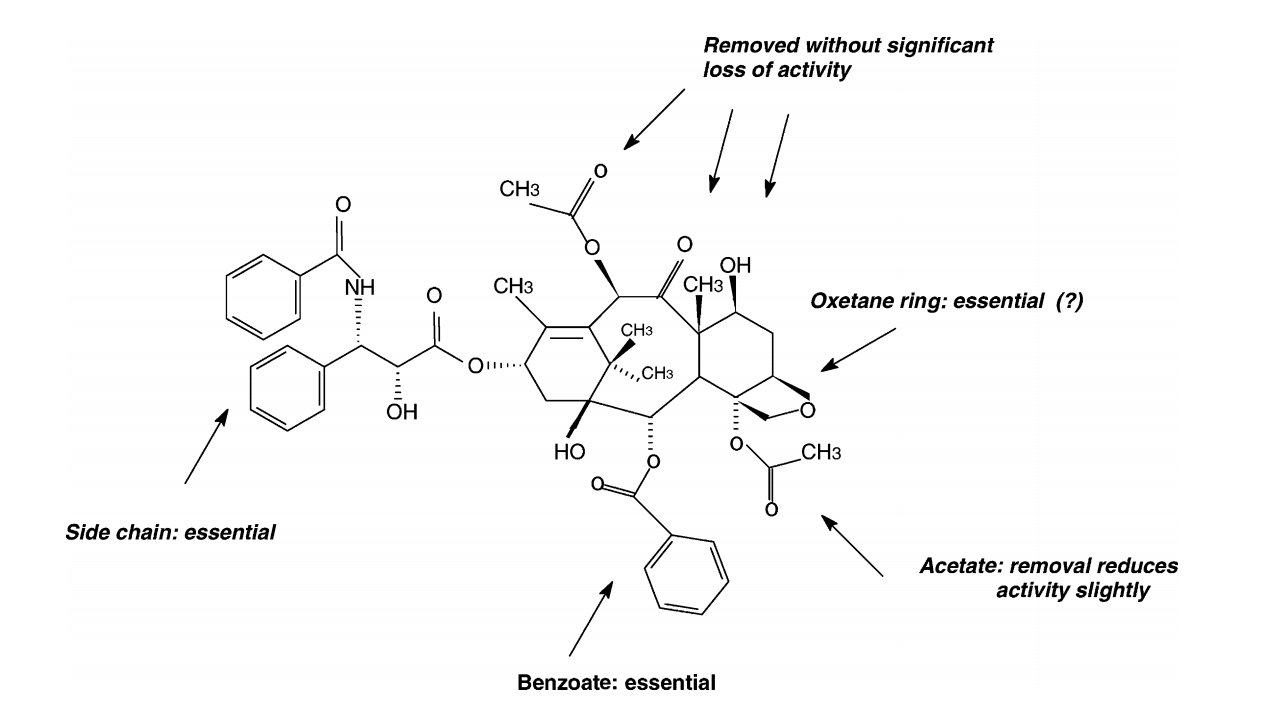
Braga, SF; Galvao, DS
A semiempirical study on the electronic structure of 10-deacetylbaccatin-III Journal Article
Em: Journal of Molecular Graphics and Modelling, vol. 21, não 1, pp. 57–70, 2002.
Resumo | Links | BibTeX | Tags: Baccatin, Drug Design, Electronic Structure, Taxol, Taxotere, Theory of Electronic Indices
@article{braga2002semiempirical,
title = {A semiempirical study on the electronic structure of 10-deacetylbaccatin-III},
author = {Braga, SF and Galvao, DS},
url = {http://www.sciencedirect.com/science/article/pii/S1093326302001213},
year = {2002},
date = {2002-01-01},
journal = {Journal of Molecular Graphics and Modelling},
volume = {21},
number = {1},
pages = {57--70},
publisher = {Elsevier},
abstract = {We performed a conformational and electronic analysis for 10-deacetylbaccatin-III (DBAC) using well-known semiempirical methods (parametric method 3 (PM3) and Zerner’s intermediate neglect of differential overlap (ZINDO)) coupled to the concepts of total and local density of states (LDOS). Our results indicate that regions presented by paclitaxel (Taxol®) as important for the biological activity can be traced out by the electronic features present in DBAC. These molecules differ only by a phenylisoserine side chain. Compared to paclitaxel, DBAC has a simpler structure in terms of molecular size and number of degrees of freedom (d.f.). This makes DBAC a good candidate for a preliminary investigation of the taxoid family. Our results question the importance of the oxetane group, which seems to be consistent with recent experimental data.
},
keywords = {Baccatin, Drug Design, Electronic Structure, Taxol, Taxotere, Theory of Electronic Indices},
pubstate = {published},
tppubtype = {article}
}
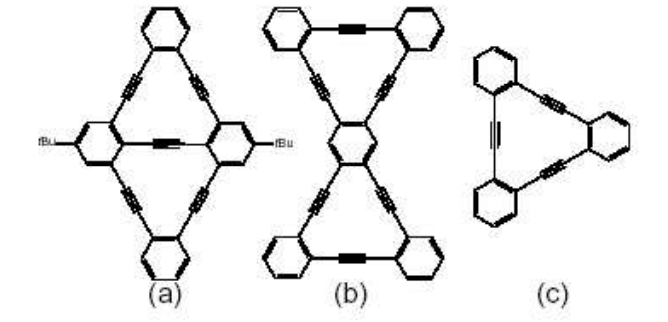
Coluci, V R; Braga, SF; Legoas, Sergio B; Galvao, Douglas S; Baughman, RH
New families of carbon nanotubes Journal Article
Em: arXiv preprint cond-mat/0207085, 2002.
Resumo | Links | BibTeX | Tags: Allotropes, Electronic Structure, Graphynes, Nanotubes
@article{coluci2002new,
title = {New families of carbon nanotubes},
author = {Coluci, V R and Braga, SF and Legoas, Sergio B and Galvao, Douglas S and Baughman, RH},
url = {http://arxiv.org/abs/cond-mat/0207085},
year = {2002},
date = {2002-01-01},
journal = {arXiv preprint cond-mat/0207085},
abstract = {Fundamentally new families of carbon single walled nanotubes are proposed. These nanotubes, called graphynes, result from the elongation of covalent interconnections of graphite-based nanotubes by the introduction of yne groups. Similarly to ordinary nanotubes, arm-chair, zig-zag, and chiral graphyne nanotubes are possible. Electronic properties, predicted using tight-binding and ab initio density functional methods, show a rich variety of metallic and semiconducting behaviors.},
keywords = {Allotropes, Electronic Structure, Graphynes, Nanotubes},
pubstate = {published},
tppubtype = {article}
}

Legoas, Sergio B; Galvao, Douglas S; Rodrigues, Varlei; Ugarte, Daniel
The Role of Carbon Contamination in Suspended Gold Nanowires Journal Article
Em: MRS Proceedings, vol. 738, pp. G14–6, 2002.
Resumo | Links | BibTeX | Tags: DFT, Electronic Structure, Linear Atomic Chains, Metallic Nanowires, TEM
@article{legoas2002role,
title = {The Role of Carbon Contamination in Suspended Gold Nanowires},
author = {Legoas, Sergio B and Galvao, Douglas S and Rodrigues, Varlei and Ugarte, Daniel},
url = {http://journals.cambridge.org/action/displayAbstract?fromPage=online&aid=8031754&fileId=S1946427400148249},
year = {2002},
date = {2002-01-01},
journal = {MRS Proceedings},
volume = {738},
pages = {G14--6},
publisher = {Cambridge University Press},
abstract = {Metallic nanowires represent very interesting systems due to new phenomena such as quantum conductance and unexpected long interatomic distances attaining 0.3–0.5 nm. These large distances represent a challenge for physical interpretation. In this work we present experimental data from transmission electron microscopy and results from ab initio density functional calculations for suspended gold chains. We show that large distances as 0.5 nm can be easily explained by the presence of carbon atoms as contaminants, while distances ranging from 0.29 up to 0.36 nm might be explained as resulting of a mixture of clean stressed and contaminated linear chains.},
keywords = {DFT, Electronic Structure, Linear Atomic Chains, Metallic Nanowires, TEM},
pubstate = {published},
tppubtype = {article}
}
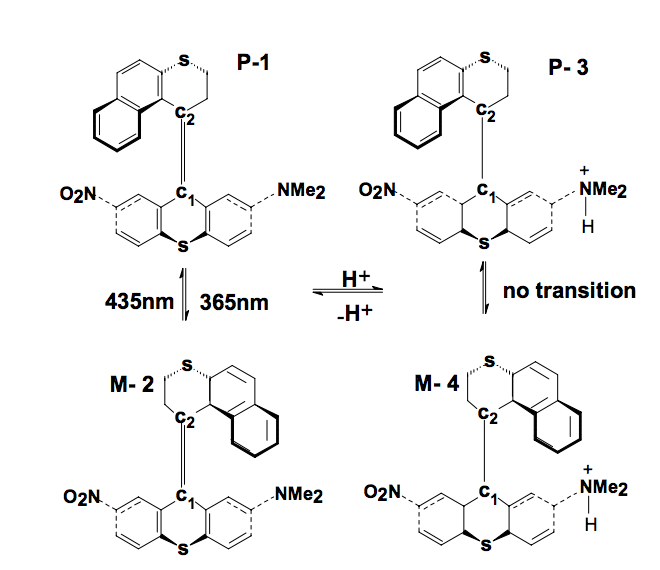
Galvao, DS; Braga, SF; Barone, PMVB; Dantas, SO
Dual-Mode Optical Molecular Switching Systems for Organic Memories Proceedings
Cambridge Univ Press, vol. 708, 2002.
Resumo | Links | BibTeX | Tags: Electronic Structure, Molecular Electronics
@proceedings{galvao2002dual,
title = {Dual-Mode Optical Molecular Switching Systems for Organic Memories},
author = {Galvao, DS and Braga, SF and Barone, PMVB and Dantas, SO},
url = {http://journals.cambridge.org/action/displayAbstract?fromPage=online&aid=8214320},
year = {2002},
date = {2002-01-01},
journal = {MATERIALS RESEARCH SOCIETY SYMPOSIUM PROCEEDINGS},
volume = {708},
pages = {335--340},
publisher = {Cambridge Univ Press},
abstract = {The synthesis of dual-mode optical molecular switching systems has been recently achieved. These systems were based on chiral helical-shaped alkenes in which the chirality can be reversibly modulated by light. In this work we report a theoretical study on the geometric and spectroscopic properties of these structures using the well-known semi-empirical methods PM3 (Parametric Method 3) and ZINDO/S-CI (Zerner's Intermediate Neglect of Differential Overlap -Spectroscopic - Configuration Interaction). Our results show that there are two stable conformers very close in energy for each possible molecular helicity presenting a barrier of ∼40 kcal/mol for bond rotation along the main molecular axis. Under protonation these barriers increase significantly and might explain why the protonation leads to the blocking of the switching process. We propose a scheme for the switching mechanism based on charge transfer and conformational changes during the isomer interconversion.},
keywords = {Electronic Structure, Molecular Electronics},
pubstate = {published},
tppubtype = {proceedings}
}
2001
Vendrame, R; Braga, RS; Takahata, Y; Galvao, DS
Structure--carcinogenic activity relationship studies of polycyclic aromatic hydrocarbons (PAHs) with pattern-recognition methods Journal Article
Em: Journal of Molecular Structure: THEOCHEM, vol. 539, não 1, pp. 253–265, 2001.
BibTeX | Tags:
@article{vendrame2001structure,
title = {Structure--carcinogenic activity relationship studies of polycyclic aromatic hydrocarbons (PAHs) with pattern-recognition methods},
author = {Vendrame, R and Braga, RS and Takahata, Y and Galvao, DS},
year = {2001},
date = {2001-01-01},
journal = {Journal of Molecular Structure: THEOCHEM},
volume = {539},
number = {1},
pages = {253--265},
publisher = {Elsevier},
keywords = {},
pubstate = {published},
tppubtype = {article}
}
Braga, SF; Galv ao, DS; Barone, PMVB; Dantas, SO
A theoretical investigation on the dual-mode photoswitching mechanism of some chiroptical systems Journal Article
Em: The Journal of Physical Chemistry B, vol. 105, não 35, pp. 8334–8338, 2001.
BibTeX | Tags:
@article{braga2001theoretical,
title = {A theoretical investigation on the dual-mode photoswitching mechanism of some chiroptical systems},
author = {Braga, SF and Galv~ao, DS and Barone, PMVB and Dantas, SO},
year = {2001},
date = {2001-01-01},
journal = {The Journal of Physical Chemistry B},
volume = {105},
number = {35},
pages = {8334--8338},
publisher = {American Chemical Society},
keywords = {},
pubstate = {published},
tppubtype = {article}
}
Lavarda, FC; Galv ao, DS; Laks, B
Soliton clusters inducing insulator-to-metal transition in polyacetylene: a Su--Schrieffer--Heeger model study Journal Article
Em: Synthetic metals, vol. 123, não 2, pp. 211–215, 2001.
BibTeX | Tags:
@article{lavarda2001soliton,
title = {Soliton clusters inducing insulator-to-metal transition in polyacetylene: a Su--Schrieffer--Heeger model study},
author = {Lavarda, FC and Galv~ao, DS and Laks, B},
year = {2001},
date = {2001-01-01},
journal = {Synthetic metals},
volume = {123},
number = {2},
pages = {211--215},
publisher = {Elsevier},
keywords = {},
pubstate = {published},
tppubtype = {article}
}
Galv ao, DS; Laks, B; da Silva, RR; Torres, JHS; Kopelevich, Y
High-Temperature Superconductivity in Graphite-Sulfur Composites: Theoretical Analysis Journal Article
Em: MRS Proceedings, vol. 689, pp. E5–2, 2001.
BibTeX | Tags:
@article{galvao2001high,
title = {High-Temperature Superconductivity in Graphite-Sulfur Composites: Theoretical Analysis},
author = {Galv~ao, DS and Laks, B and da Silva, RR and Torres, JHS and Kopelevich, Y},
year = {2001},
date = {2001-01-01},
journal = {MRS Proceedings},
volume = {689},
pages = {E5--2},
publisher = {Cambridge University Press},
keywords = {},
pubstate = {published},
tppubtype = {article}
}
Dantas, S'ocrates de O; Barone, Paulo MVB; Braga, Scheila F; Galv ao, Douglas S
A dual-mode photoswitching mechanism and charge transfer on chiroptical systems—theoretical study Journal Article
Em: Synthetic metals, vol. 116, não 1, pp. 275–279, 2001.
BibTeX | Tags:
@article{dantas2001dual,
title = {A dual-mode photoswitching mechanism and charge transfer on chiroptical systems—theoretical study},
author = {Dantas, S'ocrates de O and Barone, Paulo MVB and Braga, Scheila F and Galv~ao, Douglas S},
year = {2001},
date = {2001-01-01},
journal = {Synthetic metals},
volume = {116},
number = {1},
pages = {275--279},
publisher = {Elsevier},
keywords = {},
pubstate = {published},
tppubtype = {article}
}
Galv ao, DS; Braga, SF; Barone, PMVB; Dantas, SO
Dual-Mode Optical Molecular Switching Systems for Organic Memories Journal Article
Em: MRS Proceedings, vol. 708, pp. BB10–27, 2001.
BibTeX | Tags:
@article{galvao2001dual,
title = {Dual-Mode Optical Molecular Switching Systems for Organic Memories},
author = {Galv~ao, DS and Braga, SF and Barone, PMVB and Dantas, SO},
year = {2001},
date = {2001-01-01},
journal = {MRS Proceedings},
volume = {708},
pages = {BB10--27},
publisher = {Cambridge University Press},
keywords = {},
pubstate = {published},
tppubtype = {article}
}
2000
Braga, RS; Barone, PMVB; Galv ao, DS
La identificaci'on de la actividad cancer'igena de metilado y no metilado, hidrocarburos arom'aticos polic'iclicos (HAP) a trav'es de 'indices electr'onicos y topol'ogicos Journal Article
Em: Brazilian Journal of Physics, vol. 30, não 3, pp. 560–568, 2000.
BibTeX | Tags:
@article{braga2000identificacion,
title = {La identificaci'on de la actividad cancer'igena de metilado y no metilado, hidrocarburos arom'aticos polic'iclicos (HAP) a trav'es de 'indices electr'onicos y topol'ogicos},
author = {Braga, RS and Barone, PMVB and Galv~ao, DS},
year = {2000},
date = {2000-01-01},
journal = {Brazilian Journal of Physics},
volume = {30},
number = {3},
pages = {560--568},
keywords = {},
pubstate = {published},
tppubtype = {article}
}
Barone, PMVB; Braga, RS; Camilo Jr, A; Galvao, DS
Electronic indices from semi-empirical calculations to identify carcinogenic activity of polycyclic aromatic hydrocarbons Journal Article
Em: Journal of Molecular Structure: THEOCHEM, vol. 505, não 1, pp. 55–66, 2000.
BibTeX | Tags:
@article{barone2000electronic,
title = {Electronic indices from semi-empirical calculations to identify carcinogenic activity of polycyclic aromatic hydrocarbons},
author = {Barone, PMVB and Braga, RS and Camilo Jr, A and Galvao, DS},
year = {2000},
date = {2000-01-01},
journal = {Journal of Molecular Structure: THEOCHEM},
volume = {505},
number = {1},
pages = {55--66},
publisher = {Elsevier},
keywords = {},
pubstate = {published},
tppubtype = {article}
}
Braga, RS; Vendrame, Rosana; Galv ao, DS
Structure-Activity Relationship Studies of Substituted 17$alpha$-Acetoxyprogesterone Hormones Journal Article
Em: Journal of chemical information and computer sciences, vol. 40, não 6, pp. 1377–1385, 2000.
BibTeX | Tags:
@article{braga2000structure,
title = {Structure-Activity Relationship Studies of Substituted 17$alpha$-Acetoxyprogesterone Hormones},
author = {Braga, RS and Vendrame, Rosana and Galv~ao, DS},
year = {2000},
date = {2000-01-01},
journal = {Journal of chemical information and computer sciences},
volume = {40},
number = {6},
pages = {1377--1385},
publisher = {American Chemical Society},
keywords = {},
pubstate = {published},
tppubtype = {article}
}
Santo, Larissa LE; Durrant, Steven F; Rangel, Elidiane C; Galv ao, Douglas S; de Moraes, M'ario A Bica
Semi-empirical modeling of the optical gap of amorphous hydrogenated nitrogenated carbon films Journal Article
Em: Journal of Vacuum Science & Technology A, vol. 18, não 5, pp. 2466–2471, 2000.
BibTeX | Tags:
@article{santo2000semi,
title = {Semi-empirical modeling of the optical gap of amorphous hydrogenated nitrogenated carbon films},
author = {Santo, Larissa LE and Durrant, Steven F and Rangel, Elidiane C and Galv~ao, Douglas S and de Moraes, M'ario A Bica},
year = {2000},
date = {2000-01-01},
journal = {Journal of Vacuum Science & Technology A},
volume = {18},
number = {5},
pages = {2466--2471},
publisher = {AVS: Science & Technology of Materials, Interfaces, and Processing},
keywords = {},
pubstate = {published},
tppubtype = {article}
}
Braga, RS; Barone, PMVB; Galvao, DS
Identifying carcinogenic activity of methylated and non-methylated polycyclic aromatic hydrocarbons (PAHs) through electronic and topological indices Journal Article
Em: Brazilian Journal of Physics, vol. 30, não 3, pp. 560–568, 2000.
BibTeX | Tags:
@article{braga2000identifying,
title = {Identifying carcinogenic activity of methylated and non-methylated polycyclic aromatic hydrocarbons (PAHs) through electronic and topological indices},
author = {Braga, RS and Barone, PMVB and Galvao, DS},
year = {2000},
date = {2000-01-01},
journal = {Brazilian Journal of Physics},
volume = {30},
number = {3},
pages = {560--568},
publisher = {Sociedade Brasileira de F'isica},
keywords = {},
pubstate = {published},
tppubtype = {article}
}
Barone, PMVB; Braga, RS; Galv ao, DS
Identifying Carcinogenic Actividade of Methylated and non-Methylated Polycyclic Aromatic Hydrocarbons (PAHs) Through Eletronic and Topological Indices Journal Article
Em: Brazilian Journal of Physics, vol. 30, pp. 560–568, 2000.
BibTeX | Tags:
@article{barone2000identifying,
title = {Identifying Carcinogenic Actividade of Methylated and non-Methylated Polycyclic Aromatic Hydrocarbons (PAHs) Through Eletronic and Topological Indices},
author = {Barone, PMVB and Braga, RS and Galv~ao, DS},
year = {2000},
date = {2000-01-01},
journal = {Brazilian Journal of Physics},
volume = {30},
pages = {560--568},
keywords = {},
pubstate = {published},
tppubtype = {article}
}
Braga, RS; Cardoso, LP; Galvao, DS; Avanci, LH
Deformation in meta-nitroaniline organic crystals through hipocycloidal anisotropy Journal Article
Em: 2000.
BibTeX | Tags:
@article{braga2000deformation,
title = {Deformation in meta-nitroaniline organic crystals through hipocycloidal anisotropy},
author = {Braga, RS and Cardoso, LP and Galvao, DS and Avanci, LH},
year = {2000},
date = {2000-01-01},
keywords = {},
pubstate = {published},
tppubtype = {article}
}
1999
Vendrame, Rosana; Braga, RS; Takahata, Y; Galvao, DS
Structure-activity relationship studies of carcinogenic activity of polycyclic aromatic hydrocarbons using calculated molecular descriptors with principal component analysis and neural network methods Journal Article
Em: Journal of chemical information and computer sciences, vol. 39, não 6, pp. 1094–1104, 1999.
BibTeX | Tags:
@article{vendrame1999structure,
title = {Structure-activity relationship studies of carcinogenic activity of polycyclic aromatic hydrocarbons using calculated molecular descriptors with principal component analysis and neural network methods},
author = {Vendrame, Rosana and Braga, RS and Takahata, Y and Galvao, DS},
year = {1999},
date = {1999-01-01},
journal = {Journal of chemical information and computer sciences},
volume = {39},
number = {6},
pages = {1094--1104},
publisher = {American Chemical Society},
keywords = {},
pubstate = {published},
tppubtype = {article}
}
Braga, RS; Barone, PMVB; Galvao, DS
Identifying carcinogenic activity of methylated polycyclic aromatic hydrocarbons (PAHs) Journal Article
Em: Journal of Molecular Structure: THEOCHEM, vol. 464, não 1, pp. 257–266, 1999.
BibTeX | Tags:
@article{braga1999identifying,
title = {Identifying carcinogenic activity of methylated polycyclic aromatic hydrocarbons (PAHs)},
author = {Braga, RS and Barone, PMVB and Galvao, DS},
year = {1999},
date = {1999-01-01},
journal = {Journal of Molecular Structure: THEOCHEM},
volume = {464},
number = {1},
pages = {257--266},
publisher = {Elsevier},
keywords = {},
pubstate = {published},
tppubtype = {article}
}
Bolivar-Marinez, LE; Galvao, DS; Caldas, MJ
Geometric and spectroscopic study of some molecules related to eumelanins. 1. Monomers Journal Article
Em: The Journal of Physical Chemistry B, vol. 103, não 15, pp. 2993–3000, 1999.
BibTeX | Tags:
@article{bolivar1999geometric,
title = {Geometric and spectroscopic study of some molecules related to eumelanins. 1. Monomers},
author = {Bolivar-Marinez, LE and Galvao, DS and Caldas, MJ},
year = {1999},
date = {1999-01-01},
journal = {The Journal of Physical Chemistry B},
volume = {103},
number = {15},
pages = {2993--3000},
publisher = {ACS Publications},
keywords = {},
pubstate = {published},
tppubtype = {article}
}
Monomers, I; Bolivar-Marinez, LE; Galvao, DS; Caldas, MJ
Geometric and Spectroscopic Study of Some Molecules Related to Eumelanins Journal Article
Em: JOURNAL OF PHYSICAL CHEMISTRY B, vol. 103, pp. 2993–3000, 1999.
BibTeX | Tags:
@article{monomers1999geometric,
title = {Geometric and Spectroscopic Study of Some Molecules Related to Eumelanins},
author = {Monomers, I and Bolivar-Marinez, LE and Galvao, DS and Caldas, MJ},
year = {1999},
date = {1999-01-01},
journal = {JOURNAL OF PHYSICAL CHEMISTRY B},
volume = {103},
pages = {2993--3000},
keywords = {},
pubstate = {published},
tppubtype = {article}
}
Cyrillo, M; Galv ao, DS
Structure--activity relationship study of some inhibitors of HIV-1 integrase Journal Article
Em: Journal of Molecular Structure: THEOCHEM, vol. 464, não 1, pp. 267–272, 1999.
BibTeX | Tags:
@article{cyrillo1999structure,
title = {Structure--activity relationship study of some inhibitors of HIV-1 integrase},
author = {Cyrillo, M and Galv~ao, DS},
year = {1999},
date = {1999-01-01},
journal = {Journal of Molecular Structure: THEOCHEM},
volume = {464},
number = {1},
pages = {267--272},
publisher = {Elsevier},
keywords = {},
pubstate = {published},
tppubtype = {article}
}
Barone, PMVB; Dantas, SO; Galv ao, DS
A semi--empirical study on the electronic structure of ellipticines Journal Article
Em: Journal of Molecular Structure: THEOCHEM, vol. 465, não 2, pp. 219–229, 1999.
BibTeX | Tags:
@article{barone1999semi,
title = {A semi--empirical study on the electronic structure of ellipticines},
author = {Barone, PMVB and Dantas, SO and Galv~ao, DS},
year = {1999},
date = {1999-01-01},
journal = {Journal of Molecular Structure: THEOCHEM},
volume = {465},
number = {2},
pages = {219--229},
publisher = {Elsevier},
keywords = {},
pubstate = {published},
tppubtype = {article}
}
Cyrillo, M; Galv ao, DS
Chem2Pac: A Computational Chemistry Integrator for Windows. Journal Article
Em: EPA NEWSLETTER-EUROPEAN PHOTOCHEMISTRY ASSOCIATION, pp. 31–34, 1999.
BibTeX | Tags:
@article{cyrillo1999chem2pac,
title = {Chem2Pac: A Computational Chemistry Integrator for Windows.},
author = {Cyrillo, M and Galv~ao, DS},
year = {1999},
date = {1999-01-01},
journal = {EPA NEWSLETTER-EUROPEAN PHOTOCHEMISTRY ASSOCIATION},
pages = {31--34},
publisher = {EUROPEAN PHOTOCHEMISTRY ASSOCIATION},
keywords = {},
pubstate = {published},
tppubtype = {article}
}
Avanci, LH; Braga, RS; Cardoso, LP; Galvao, DS; Sherwood, JN
Hysteresislike Behavior in Meta-Nitroaniline Crystals Journal Article
Em: Physical Review Letters, vol. 83, não 24, pp. 5146, 1999.
BibTeX | Tags:
@article{avanci1999hysteresislike,
title = {Hysteresislike Behavior in Meta-Nitroaniline Crystals},
author = {Avanci, LH and Braga, RS and Cardoso, LP and Galvao, DS and Sherwood, JN},
year = {1999},
date = {1999-01-01},
journal = {Physical Review Letters},
volume = {83},
number = {24},
pages = {5146},
publisher = {American Physical Society},
keywords = {},
pubstate = {published},
tppubtype = {article}
}
Barone, PMVB; Dantas, SO; Galv ao, DS
A dual-mode photoswitching investigation Journal Article
Em: Synthetic metals, vol. 102, não 1, pp. 1454–1455, 1999.
BibTeX | Tags:
@article{barone1999dual,
title = {A dual-mode photoswitching investigation},
author = {Barone, PMVB and Dantas, SO and Galv~ao, DS},
year = {1999},
date = {1999-01-01},
journal = {Synthetic metals},
volume = {102},
number = {1},
pages = {1454--1455},
publisher = {Elsevier},
keywords = {},
pubstate = {published},
tppubtype = {article}
}
Barone, PMVB; Camilo Jr, A; Galv ao, DS
Theoretical characterization of oligocubanes Journal Article
Em: Synthetic metals, vol. 102, não 1, pp. 1410, 1999.
BibTeX | Tags:
@article{barone1999theoretical,
title = {Theoretical characterization of oligocubanes},
author = {Barone, PMVB and Camilo Jr, A and Galv~ao, DS},
year = {1999},
date = {1999-01-01},
journal = {Synthetic metals},
volume = {102},
number = {1},
pages = {1410},
publisher = {Elsevier},
keywords = {},
pubstate = {published},
tppubtype = {article}
}
Cyrillo, M; Galvao, DS
HyperSpin: Conformational Search Add-on to HyperChem^ T^ M. Journal Article
Em: EPA NEWSLETTER-EUROPEAN PHOTOCHEMISTRY ASSOCIATION, pp. 34–38, 1999.
BibTeX | Tags:
@article{cyrillo1999hyperspin,
title = {HyperSpin: Conformational Search Add-on to HyperChem^ T^ M.},
author = {Cyrillo, M and Galvao, DS},
year = {1999},
date = {1999-01-01},
journal = {EPA NEWSLETTER-EUROPEAN PHOTOCHEMISTRY ASSOCIATION},
pages = {34--38},
publisher = {EUROPEAN PHOTOCHEMISTRY ASSOCIATION},
keywords = {},
pubstate = {published},
tppubtype = {article}
}
Santo, LL do E; Galv ao, DS
Structure--activity study of indolequinones bioreductive alkylating agents Journal Article
Em: Journal of Molecular Structure: THEOCHEM, vol. 464, não 1, pp. 273–279, 1999.
BibTeX | Tags:
@article{santo1999structure,
title = {Structure--activity study of indolequinones bioreductive alkylating agents},
author = {Santo, LL do E and Galv~ao, DS},
year = {1999},
date = {1999-01-01},
journal = {Journal of Molecular Structure: THEOCHEM},
volume = {464},
number = {1},
pages = {273--279},
publisher = {Elsevier},
keywords = {},
pubstate = {published},
tppubtype = {article}
}
PMVB, Barone; Galvao, DS
IDENTIFYING CARCINOGENIC ACTIVITY OF METHYLATED POLYCYCLIC AROMATIC HYDROCARBONS (PAHS) Journal Article
Em: Computational and Theoretical Chemistry, vol. 464, 1999.
BibTeX | Tags:
@article{pmvb1999identifying,
title = {IDENTIFYING CARCINOGENIC ACTIVITY OF METHYLATED POLYCYCLIC AROMATIC HYDROCARBONS (PAHS)},
author = {PMVB, Barone and Galvao, DS},
year = {1999},
date = {1999-01-01},
journal = {Computational and Theoretical Chemistry},
volume = {464},
publisher = {Elsevier Science Publishing Company, Inc.},
keywords = {},
pubstate = {published},
tppubtype = {article}
}
1997
Durrant, Steven F; Castro, Sandra GC; Bol'ivar-Marinez, Luz Elena; Galv ao, Douglas S; Bica de Moraes, M'ario A
Structural and optical properties of amorphous hydrogenated fluorinated carbon films produced by PECVD Journal Article
Em: Thin Solid Films, vol. 304, não 1, pp. 149–156, 1997.
BibTeX | Tags:
@article{durrant1997structural,
title = {Structural and optical properties of amorphous hydrogenated fluorinated carbon films produced by PECVD},
author = {Durrant, Steven F and Castro, Sandra GC and Bol'ivar-Marinez, Luz Elena and Galv~ao, Douglas S and Bica de Moraes, M'ario A},
year = {1997},
date = {1997-01-01},
journal = {Thin Solid Films},
volume = {304},
number = {1},
pages = {149--156},
publisher = {Elsevier},
keywords = {},
pubstate = {published},
tppubtype = {article}
}
Baughman, RH; Galvao, DS; Cui, C; Dantas, SO
Hinged and chiral polydiacetylene carbon crystals Journal Article
Em: Chemical physics letters, vol. 269, não 3, pp. 356–364, 1997.
BibTeX | Tags:
@article{baughman1997hinged,
title = {Hinged and chiral polydiacetylene carbon crystals},
author = {Baughman, RH and Galvao, DS and Cui, C and Dantas, SO},
year = {1997},
date = {1997-01-01},
journal = {Chemical physics letters},
volume = {269},
number = {3},
pages = {356--364},
publisher = {Elsevier},
keywords = {},
pubstate = {published},
tppubtype = {article}
}
Laks, B; Galv ao, DS
Extended states in interacting disordered polyacetylenelike chains Journal Article
Em: Physical Review B, vol. 56, não 3, pp. 967, 1997.
BibTeX | Tags:
@article{laks1997extended,
title = {Extended states in interacting disordered polyacetylenelike chains},
author = {Laks, B and Galv~ao, DS},
year = {1997},
date = {1997-01-01},
journal = {Physical Review B},
volume = {56},
number = {3},
pages = {967},
publisher = {APS},
keywords = {},
pubstate = {published},
tppubtype = {article}
}
Durrant, Steven F; de Oliveira, Ricardo T; Castro, Sandra GC; Galvao, Douglas S; Bica de Moraes, Mario A; others,
Structural and optical properties of plasma-deposited amorphous hydrogenated oxygenated carbon films Journal Article
Em: Journal of Vacuum Science & Technology A: Vacuum, Surfaces, and Films, vol. 15, não 3, pp. 1334–1339, 1997.
BibTeX | Tags:
@article{durrant1997structuralb,
title = {Structural and optical properties of plasma-deposited amorphous hydrogenated oxygenated carbon films},
author = {Durrant, Steven F and de Oliveira, Ricardo T and Castro, Sandra GC and Galvao, Douglas S and Bica de Moraes, Mario A and others},
year = {1997},
date = {1997-01-01},
journal = {Journal of Vacuum Science & Technology A: Vacuum, Surfaces, and Films},
volume = {15},
number = {3},
pages = {1334--1339},
publisher = {AVS},
keywords = {},
pubstate = {published},
tppubtype = {article}
}
Dantas, SO; Dos Santos, MC; Galvao, DS
Theoretical investigation of an all-organic molecular transistor Journal Article
Em: Synthetic metals, vol. 85, não 1, pp. 1143–1144, 1997.
BibTeX | Tags:
@article{dantas1997theoretical,
title = {Theoretical investigation of an all-organic molecular transistor},
author = {Dantas, SO and Dos Santos, MC and Galvao, DS},
year = {1997},
date = {1997-01-01},
journal = {Synthetic metals},
volume = {85},
number = {1},
pages = {1143--1144},
publisher = {Elsevier},
keywords = {},
pubstate = {published},
tppubtype = {article}
}
Bolivar-Marinez, LE; Dos Santos, MC; Galvao, DS
On the fluorescence of substituted oligothiophenes Journal Article
Em: Synthetic metals, vol. 85, não 1, pp. 1117–1118, 1997.
BibTeX | Tags:
@article{bolivar1997fluorescence,
title = {On the fluorescence of substituted oligothiophenes},
author = {Bolivar-Marinez, LE and Dos Santos, MC and Galvao, DS},
year = {1997},
date = {1997-01-01},
journal = {Synthetic metals},
volume = {85},
number = {1},
pages = {1117--1118},
publisher = {Elsevier},
keywords = {},
pubstate = {published},
tppubtype = {article}
}
Laks, B; Galv ao, DS
Extended states in interacting one-dimensional disordered polymeric chains Journal Article
Em: Synthetic metals, vol. 85, não 1, pp. 1125–1126, 1997.
BibTeX | Tags:
@article{laks1997extendedb,
title = {Extended states in interacting one-dimensional disordered polymeric chains},
author = {Laks, B and Galv~ao, DS},
year = {1997},
date = {1997-01-01},
journal = {Synthetic metals},
volume = {85},
number = {1},
pages = {1125--1126},
publisher = {Elsevier},
keywords = {},
pubstate = {published},
tppubtype = {article}
}
1996
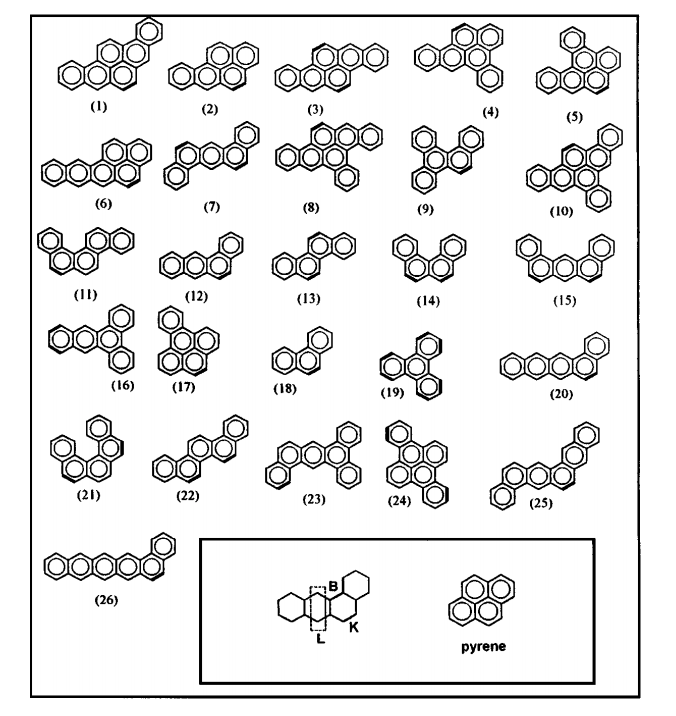
A Camilo Jr PMVB Barone, DS Galvao
Theoretical approach to identify carcinogenic activity of polycyclic aromatic hydrocarbons Journal Article
Em: Physical Review Letters, vol. 77, não 6, pp. 1186, 1996.
Resumo | Links | BibTeX | Tags: top20
@article{barone1996theoretical,
title = {Theoretical approach to identify carcinogenic activity of polycyclic aromatic hydrocarbons},
author = {PMVB Barone, A Camilo Jr, DS Galvao},
url = {http://journals.aps.org/prl/abstract/10.1103/PhysRevLett.77.1186},
doi = {10.1103/PhysRevLett.77.1186},
year = {1996},
date = {1996-01-01},
journal = {Physical Review Letters},
volume = {77},
number = {6},
pages = {1186},
publisher = {American Physical Society},
abstract = {Polycyclic aromatic hydrocarbons (PAHs) are a class of planar molecules that can induce chemical carcinogenesis. Their carcinogenic powers vary in a large range, from the very strong carcinogens to the inactive ones. Many models have been proposed to explain the PAHs' carcinogenic activity, but all of them present some failures. Here we introduce a new methodology to identify PAHs' carcinogenic activity based on the concept of electronic local density of states (LDOS). We show that the analysis of the molecular energy levels in association with the LDOS calculated over the ring which contains the highest bond order of the molecule allows simple rules to identify whether a specific PAH molecule will present (or not) carcinogenic activity.},
keywords = {top20},
pubstate = {published},
tppubtype = {article}
}
Bolivar-Marinez, LE; Dos Santos, MC; Galv ao, DS
Electronic structure of push-pull molecules based on thiophene oligomers Journal Article
Em: The Journal of Physical Chemistry, vol. 100, não 26, pp. 11029–11032, 1996.
BibTeX | Tags:
@article{bolivar1996electronic,
title = {Electronic structure of push-pull molecules based on thiophene oligomers},
author = {Bolivar-Marinez, LE and Dos Santos, MC and Galv~ao, DS},
year = {1996},
date = {1996-01-01},
journal = {The Journal of Physical Chemistry},
volume = {100},
number = {26},
pages = {11029--11032},
publisher = {American Chemical Society},
keywords = {},
pubstate = {published},
tppubtype = {article}
}
Dantas, SO; dos Santos, MC; Galvao, DS
Theoretical characterization of an all-organic molecular transistor Journal Article
Em: Chemical physics letters, vol. 256, não 1, pp. 207–212, 1996.
BibTeX | Tags:
@article{dantas1996theoretical,
title = {Theoretical characterization of an all-organic molecular transistor},
author = {Dantas, SO and dos Santos, MC and Galvao, DS},
year = {1996},
date = {1996-01-01},
journal = {Chemical physics letters},
volume = {256},
number = {1},
pages = {207--212},
publisher = {Elsevier},
keywords = {},
pubstate = {published},
tppubtype = {article}
}
1995
dos Santos, Maria C; Galvao, Douglas S; Teschke, O; Soares, DM
Spatially variable reaction in the formation of anodically grown porous silicon structure Proceedings Article
Em: SPIE's 1995 International Symposium on Optical Science, Engineering, and Instrumentation, pp. 228–235, International Society for Optics and Photonics 1995.
BibTeX | Tags:
@inproceedings{dos1995spatially,
title = {Spatially variable reaction in the formation of anodically grown porous silicon structure},
author = {dos Santos, Maria C and Galvao, Douglas S and Teschke, O and Soares, DM},
year = {1995},
date = {1995-01-01},
booktitle = {SPIE's 1995 International Symposium on Optical Science, Engineering, and Instrumentation},
pages = {228--235},
organization = {International Society for Optics and Photonics},
keywords = {},
pubstate = {published},
tppubtype = {inproceedings}
}
dos Santos, Maria C; Bolivar-Marinez, LE; Galvao, Douglas S
Theoretical study of push-pull molecules based on thiophene oligomers Proceedings Article
Em: SPIE's 1995 International Symposium on Optical Science, Engineering, and Instrumentation, pp. 135–142, International Society for Optics and Photonics 1995.
BibTeX | Tags:
@inproceedings{dos1995theoreticalb,
title = {Theoretical study of push-pull molecules based on thiophene oligomers},
author = {dos Santos, Maria C and Bolivar-Marinez, LE and Galvao, Douglas S},
year = {1995},
date = {1995-01-01},
booktitle = {SPIE's 1995 International Symposium on Optical Science, Engineering, and Instrumentation},
pages = {135--142},
organization = {International Society for Optics and Photonics},
keywords = {},
pubstate = {published},
tppubtype = {inproceedings}
}
Mota, Rog'erio Pinto; Galv ao, Douglas; Durrant, Steven F; De Moraes, M'ario A Bica; de Oliveira Dantas, Socrates; Cant ao, Mauricio
HMDSO plasma polymerization and thin film optical properties Journal Article
Em: Thin Solid Films, vol. 270, não 1, pp. 109–113, 1995.
BibTeX | Tags:
@article{mota1995hmdso,
title = {HMDSO plasma polymerization and thin film optical properties},
author = {Mota, Rog'erio Pinto and Galv~ao, Douglas and Durrant, Steven F and De Moraes, M'ario A Bica and de Oliveira Dantas, Socrates and Cant~ao, Mauricio},
year = {1995},
date = {1995-01-01},
journal = {Thin Solid Films},
volume = {270},
number = {1},
pages = {109--113},
publisher = {Elsevier},
keywords = {},
pubstate = {published},
tppubtype = {article}
}
Teschke, O; Dos Santos, MC; Kleinke, MU; Soares, DM; Galvao, DS
Spatially variable reaction in the formation of anodically grown porous silicon structures Journal Article
Em: Journal of applied physics, vol. 78, não 1, pp. 590–592, 1995.
BibTeX | Tags:
@article{teschke1995spatially,
title = {Spatially variable reaction in the formation of anodically grown porous silicon structures},
author = {Teschke, O and Dos Santos, MC and Kleinke, MU and Soares, DM and Galvao, DS},
year = {1995},
date = {1995-01-01},
journal = {Journal of applied physics},
volume = {78},
number = {1},
pages = {590--592},
publisher = {AIP Publishing},
keywords = {},
pubstate = {published},
tppubtype = {article}
}
Baughman, RH; Galvao, DS
Negative volumetric thermal expansion for proposed hinged phases Journal Article
Em: Chemical Physics Letters, vol. 240, não 1, pp. 180–184, 1995.
BibTeX | Tags:
@article{baughman1995negative,
title = {Negative volumetric thermal expansion for proposed hinged phases},
author = {RH Baughman and DS Galvao},
year = {1995},
date = {1995-01-01},
journal = {Chemical Physics Letters},
volume = {240},
number = {1},
pages = {180--184},
publisher = {North-Holland},
keywords = {},
pubstate = {published},
tppubtype = {article}
}
Dos Santos, MC; Bolivar-Martinez, LE; Galvao, DS
Theoretical Study of Push-Pull Molecules Based on Thiophene Oligomers [2528-30] Journal Article
Em: PROCEEDINGS-SPIE THE INTERNATIONAL SOCIETY FOR OPTICAL ENGINEERING, pp. 135–135, 1995.
BibTeX | Tags:
@article{dos1995theoretical,
title = {Theoretical Study of Push-Pull Molecules Based on Thiophene Oligomers [2528-30]},
author = {Dos Santos, MC and Bolivar-Martinez, LE and Galvao, DS},
year = {1995},
date = {1995-01-01},
journal = {PROCEEDINGS-SPIE THE INTERNATIONAL SOCIETY FOR OPTICAL ENGINEERING},
pages = {135--135},
publisher = {SPIE INTERNATIONAL SOCIETY FOR OPTICAL},
keywords = {},
pubstate = {published},
tppubtype = {article}
}
1994
Soos, Zolt'an G; Galv ao, Douglas S; Etemad, Shahab
Fluorescence and excited-state structure of conjugated polymers Journal Article
Em: Advanced materials, vol. 6, não 4, pp. 280–287, 1994.
BibTeX | Tags:
@article{soos1994fluorescence,
title = {Fluorescence and excited-state structure of conjugated polymers},
author = {Soos, Zolt'an G and Galv~ao, Douglas S and Etemad, Shahab},
year = {1994},
date = {1994-01-01},
journal = {Advanced materials},
volume = {6},
number = {4},
pages = {280--287},
publisher = {WILEY-VCH Verlag GmbH},
keywords = {},
pubstate = {published},
tppubtype = {article}
}
Lavarda, FC; Dos Santos, MC; Galv ao, DS; Laks, B
Near resonant scattering from nonsymmetric dimers: Applications to substituted polyanilines Journal Article
Em: Physical review letters, vol. 73, não 9, pp. 1267, 1994.
BibTeX | Tags:
@article{lavarda1994near,
title = {Near resonant scattering from nonsymmetric dimers: Applications to substituted polyanilines},
author = {Lavarda, FC and Dos Santos, MC and Galv~ao, DS and Laks, B},
year = {1994},
date = {1994-01-01},
journal = {Physical review letters},
volume = {73},
number = {9},
pages = {1267},
publisher = {American Physical Society},
keywords = {},
pubstate = {published},
tppubtype = {article}
}
Baughman, RH; Galvao, DS; Cui, C
Novel structures and properties of conjugated carbon phases with three-dimensional connectivity Proceedings Article
Em: Science and Technology of Synthetic Metals, 1994. ICSM'94. International Conference on, pp. 446–446, IEEE 1994.
BibTeX | Tags:
@inproceedings{baughman1994novel,
title = {Novel structures and properties of conjugated carbon phases with three-dimensional connectivity},
author = {Baughman, RH and Galvao, DS and Cui, C},
year = {1994},
date = {1994-01-01},
booktitle = {Science and Technology of Synthetic Metals, 1994. ICSM'94. International Conference on},
pages = {446--446},
organization = {IEEE},
keywords = {},
pubstate = {published},
tppubtype = {inproceedings}
}
Soos, ZG; Galvao, DS
One-and two-photon excitations of polythiophene: role of nonconjugated heteroatoms Journal Article
Em: The Journal of Physical Chemistry, vol. 98, não 3, pp. 1029–1033, 1994.
BibTeX | Tags:
@article{soos1994one,
title = {One-and two-photon excitations of polythiophene: role of nonconjugated heteroatoms},
author = {Soos, ZG and Galvao, DS},
year = {1994},
date = {1994-01-01},
journal = {The Journal of Physical Chemistry},
volume = {98},
number = {3},
pages = {1029--1033},
publisher = {ACS Publications},
keywords = {},
pubstate = {published},
tppubtype = {article}
}
Lavarda, FC; Dos Santos, MC; Galvao, DS; Laks, B
Insulator-to-metal transition in polythiophene Journal Article
Em: Physical Review B, vol. 49, não 2, pp. 979, 1994.
BibTeX | Tags:
@article{lavarda1994insulator,
title = {Insulator-to-metal transition in polythiophene},
author = {Lavarda, FC and Dos Santos, MC and Galvao, DS and Laks, B},
year = {1994},
date = {1994-01-01},
journal = {Physical Review B},
volume = {49},
number = {2},
pages = {979},
publisher = {APS},
keywords = {},
pubstate = {published},
tppubtype = {article}
}
Soos, Zoltan G; Galvao, Douglas S; Etemad, Shahab
Polymer fluorescence: even-parity states, alternation, and heteroatoms Proceedings Article
Em: OE/LASE'94, pp. 115–126, International Society for Optics and Photonics 1994.
BibTeX | Tags:
@inproceedings{soos1994polymer,
title = {Polymer fluorescence: even-parity states, alternation, and heteroatoms},
author = {Soos, Zoltan G and Galvao, Douglas S and Etemad, Shahab},
year = {1994},
date = {1994-01-01},
booktitle = {OE/LASE'94},
pages = {115--126},
organization = {International Society for Optics and Photonics},
keywords = {},
pubstate = {published},
tppubtype = {inproceedings}
}
1993
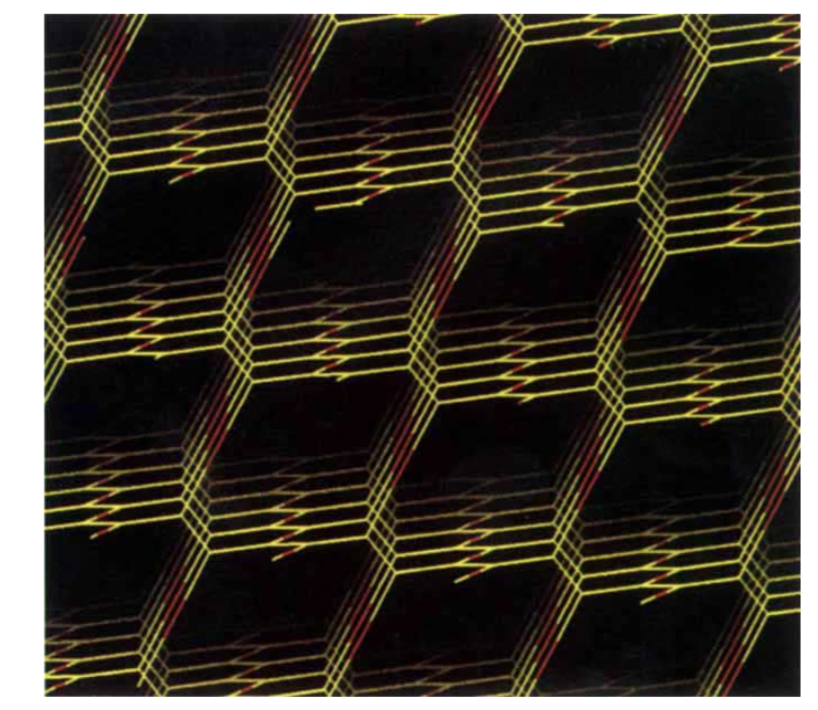
Baughman, RH; Galvao, DS
Crystalline networks with unusual predicted mechanical and thermal properties Journal Article
Em: Nature, vol. 365, não 6448, pp. 735–737, 1993.
Resumo | Links | BibTeX | Tags: top20
@article{baughman1993crystalline,
title = {Crystalline networks with unusual predicted mechanical and thermal properties},
author = {RH Baughman and DS Galvao},
url = {http://www.nature.com/nature/journal/v365/n6448/abs/365735a0.html},
doi = {10.1038/365735a0},
year = {1993},
date = {1993-01-01},
journal = {Nature},
volume = {365},
number = {6448},
pages = {735--737},
publisher = {Nature Publishing Group},
abstract = {Most materials shrink laterally and become less dense when stretched. Materials that both expand laterally (that is, have negative Poisson's ratio) and densify when stretched are of interest both from the fundamental and the practical points of view1–5. A few monocrystalline phases with negative Poisson's ratio are known3,4, but these do not densify when stretched. Here we present molecular-mechanics calculations for some hypothetical phases of carbon which exhibit both kinds of behaviour. The properties derive from the presence of bonds that act as hinges in extended helical chains. Other unusual properties of these phases include negative thermal expansion, dopant-controlled porosity and low-temperature polymorphism. Such structures can be envisaged for polyacetylene, polydiacetylene, polyphenylene and (BN)x phases, as well as for variants of some known, structurally related inorganic phases.},
keywords = {top20},
pubstate = {published},
tppubtype = {article}
}
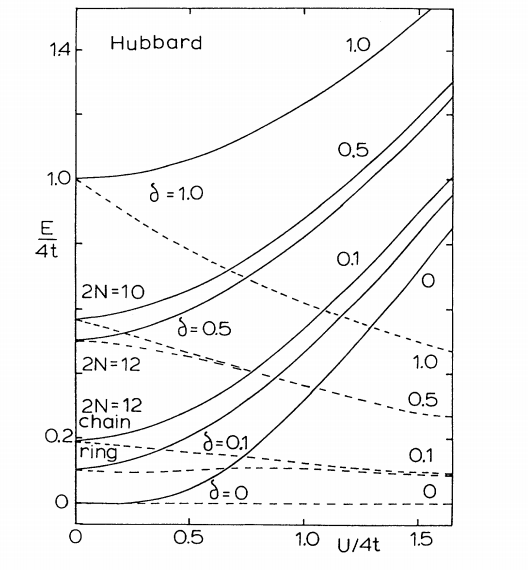
S Ramasesha ZG Soos, DS Galvao
Em: Physical Review Letters, vol. 71, não 10, pp. 1609, 1993.
Resumo | Links | BibTeX | Tags: Molecular Dynamics
@article{soos1993band,
title = {Band to correlated crossover in alternating Hubbard and Pariser-Parr-Pople chains: Nature of the lowest singlet excitation of conjugated polymers},
author = {ZG Soos, S Ramasesha, DS Galvao},
url = {http://journals.aps.org/prl/abstract/10.1103/PhysRevLett.71.1609},
doi = {10.1103/PhysRevLett.71.1609},
year = {1993},
date = {1993-01-01},
journal = {Physical Review Letters},
volume = {71},
number = {10},
pages = {1609},
publisher = {American Physical Society},
abstract = {The evolution with increasing Coulomb correlations of a semiconductor to a magnetic insulator is related to an excited-state crossover in π-electron models for conjugated polymers. We associate strong fluorescence with a lowest singlet excitation S1 that is dipole allowed, on the band side, while S1 becomes two-photon allowed on the correlated side. S1/S2 crossovers in Hubbard, Pariser-Parr-Pople, or other chains with electron-hole symmetry and alternating transfer integrals t(1±δ) are based on exact results at δ=0 and 1, on molecular exciton theory at large δ, and on oligomer calculations up to twelve sites.},
keywords = {Molecular Dynamics},
pubstate = {published},
tppubtype = {article}
}
Soos, ZG; Ramasesha, S; Galvao, DS; Etemad, S
Excitation and relaxation energies of trans-stilbene: Confined singlet, triplet, and charged bipolarons Journal Article
Em: Physical Review B, vol. 47, não 4, pp. 1742, 1993.
BibTeX | Tags:
@article{soos1993excitation,
title = {Excitation and relaxation energies of trans-stilbene: Confined singlet, triplet, and charged bipolarons},
author = {Soos, ZG and Ramasesha, S and Galvao, DS and Etemad, S},
year = {1993},
date = {1993-01-01},
journal = {Physical Review B},
volume = {47},
number = {4},
pages = {1742},
publisher = {APS},
keywords = {},
pubstate = {published},
tppubtype = {article}
}
Galvao, DS; Soos, ZG; Ramasesha, S; Etemad, S
A parametric method 3 (PM3) study of trans-stilbene Journal Article
Em: The Journal of chemical physics, vol. 98, não 4, pp. 3016–3021, 1993.
BibTeX | Tags:
@article{galvao1993parametric,
title = {A parametric method 3 (PM3) study of trans-stilbene},
author = {Galvao, DS and Soos, ZG and Ramasesha, S and Etemad, S},
year = {1993},
date = {1993-01-01},
journal = {The Journal of chemical physics},
volume = {98},
number = {4},
pages = {3016--3021},
publisher = {AIP Publishing},
keywords = {},
pubstate = {published},
tppubtype = {article}
}
Soos, Zoltan G; Galvao, Douglas S; Ramasesha, S; Etemad, Shahab
Photophysics of light-emitting conjugated polymers Proceedings Article
Em: OE/LASE'93: Optics, Electro-Optics, & Laser Applications in Science& Engineering, pp. 274–284, International Society for Optics and Photonics 1993.
BibTeX | Tags:
@inproceedings{soos1993photophysicsb,
title = {Photophysics of light-emitting conjugated polymers},
author = {Soos, Zoltan G and Galvao, Douglas S and Ramasesha, S and Etemad, Shahab},
year = {1993},
date = {1993-01-01},
booktitle = {OE/LASE'93: Optics, Electro-Optics, & Laser Applications in Science& Engineering},
pages = {274--284},
organization = {International Society for Optics and Photonics},
keywords = {},
pubstate = {published},
tppubtype = {inproceedings}
}
Baughman, Ray H; Galv ao, Douglas S; Cui, Changxing; Wang, Yang; Tom'anek, David
Fullereneynes: a new family of porous fullerenes Journal Article
Em: Chemical physics letters, vol. 204, não 1, pp. 8–14, 1993.
BibTeX | Tags:
@article{baughman1993fullereneynes,
title = {Fullereneynes: a new family of porous fullerenes},
author = {Baughman, Ray H and Galv~ao, Douglas S and Cui, Changxing and Wang, Yang and Tom'anek, David},
year = {1993},
date = {1993-01-01},
journal = {Chemical physics letters},
volume = {204},
number = {1},
pages = {8--14},
publisher = {North-Holland},
keywords = {},
pubstate = {published},
tppubtype = {article}
}
Soos, ZG; Ramasesha, S; Galvao, DS; Kepler, RG; Etemad, S
Electronic excitations and alternation of conjugated polymers Journal Article
Em: Synthetic metals, vol. 54, não 1, pp. 35–47, 1993.
BibTeX | Tags:
@article{soos1993electronic,
title = {Electronic excitations and alternation of conjugated polymers},
author = {Soos, ZG and Ramasesha, S and Galvao, DS and Kepler, RG and Etemad, S},
year = {1993},
date = {1993-01-01},
journal = {Synthetic metals},
volume = {54},
number = {1},
pages = {35--47},
publisher = {Elsevier},
keywords = {},
pubstate = {published},
tppubtype = {article}
}
Ramasesha, S; Galvao, DS; Soos, ZG
Exact eigenstates of the Pariser-Parr-Pople model for anthracene Journal Article
Em: The Journal of Physical Chemistry, vol. 97, não 12, pp. 2823–2829, 1993.
BibTeX | Tags:
@article{ramasesha1993exact,
title = {Exact eigenstates of the Pariser-Parr-Pople model for anthracene},
author = {Ramasesha, S and Galvao, DS and Soos, ZG},
year = {1993},
date = {1993-01-01},
journal = {The Journal of Physical Chemistry},
volume = {97},
number = {12},
pages = {2823--2829},
publisher = {ACS Publications},
keywords = {},
pubstate = {published},
tppubtype = {article}
}
Baughman, RH; Galvao, DS
Tubulanes: carbon phases based on cross-linked fullerene tubules Journal Article
Em: Chemical physics letters, vol. 211, não 1, pp. 110–118, 1993.
BibTeX | Tags:
@article{baughman1993tubulanes,
title = {Tubulanes: carbon phases based on cross-linked fullerene tubules},
author = {Baughman, RH and Galvao, DS},
year = {1993},
date = {1993-01-01},
journal = {Chemical physics letters},
volume = {211},
number = {1},
pages = {110--118},
publisher = {North-Holland},
keywords = {},
pubstate = {published},
tppubtype = {article}
}
Lavarda, FC; Dos Santos, MC; Galv ao, DS; Laks, B
Disordered distribution of defects in polythiophene Journal Article
Em: Synthetic metals, vol. 57, não 2, pp. 4499–4506, 1993.
BibTeX | Tags:
@article{lavarda1993disordered,
title = {Disordered distribution of defects in polythiophene},
author = {Lavarda, FC and Dos Santos, MC and Galv~ao, DS and Laks, B},
year = {1993},
date = {1993-01-01},
journal = {Synthetic metals},
volume = {57},
number = {2},
pages = {4499--4506},
publisher = {Elsevier},
keywords = {},
pubstate = {published},
tppubtype = {article}
}
Soos, ZG; Galvao, DS; Ramasesha, S; Etemad, S
Photophysics of light-emitting conjugated polymers (Invited Paper)[1852-33] Journal Article
Em: PROCEEDINGS-SPIE THE INTERNATIONAL SOCIETY FOR OPTICAL ENGINEERING, pp. 274–274, 1993.
BibTeX | Tags:
@article{soos1993photophysics,
title = {Photophysics of light-emitting conjugated polymers (Invited Paper)[1852-33]},
author = {Soos, ZG and Galvao, DS and Ramasesha, S and Etemad, S},
year = {1993},
date = {1993-01-01},
journal = {PROCEEDINGS-SPIE THE INTERNATIONAL SOCIETY FOR OPTICAL ENGINEERING},
pages = {274--274},
publisher = {SPIE INTERNATIONAL SOCIETY FOR OPTICAL},
keywords = {},
pubstate = {published},
tppubtype = {article}
}
Soos, ZG; Galvao, DS; Etemad, S; Keplero, RG
Conjugated polymer fluorescence: Interplay of correlations and alternation Journal Article
Em: MRS Proceedings, vol. 328, pp. 383, 1993.
BibTeX | Tags:
@article{soos1993conjugated,
title = {Conjugated polymer fluorescence: Interplay of correlations and alternation},
author = {Soos, ZG and Galvao, DS and Etemad, S and Keplero, RG},
year = {1993},
date = {1993-01-01},
journal = {MRS Proceedings},
volume = {328},
pages = {383},
publisher = {Cambridge University Press},
keywords = {},
pubstate = {published},
tppubtype = {article}
}
Laks, B; Dos Santos, DA; Galv ao, DS
Clustering effects in polyaniline chains Journal Article
Em: Synthetic metals, vol. 57, não 2, pp. 4507–4512, 1993.
BibTeX | Tags:
@article{laks1993clustering,
title = {Clustering effects in polyaniline chains},
author = {Laks, B and Dos Santos, DA and Galv~ao, DS},
year = {1993},
date = {1993-01-01},
journal = {Synthetic metals},
volume = {57},
number = {2},
pages = {4507--4512},
publisher = {Elsevier},
keywords = {},
pubstate = {published},
tppubtype = {article}
}
1992
Soos, ZG; Etemad, S; Galvao, DS; Ramasesha, S
Fluorescence and topological gap of conjugated phenylene polymers Journal Article
Em: Chemical physics letters, vol. 194, não 4, pp. 341–346, 1992.
BibTeX | Tags:
@article{soos1992fluorescence,
title = {Fluorescence and topological gap of conjugated phenylene polymers},
author = {Soos, ZG and Etemad, S and Galvao, DS and Ramasesha, S},
year = {1992},
date = {1992-01-01},
journal = {Chemical physics letters},
volume = {194},
number = {4},
pages = {341--346},
publisher = {North-Holland},
keywords = {},
pubstate = {published},
tppubtype = {article}
}
Dos Santos, DA; Galvao, DS; Laks, B; Dos Santos, MC
Poly (alkylthiophenes): chain conformation and thermochromism Journal Article
Em: Synthetic metals, vol. 51, não 1, pp. 203–209, 1992.
BibTeX | Tags:
@article{dos1992poly,
title = {Poly (alkylthiophenes): chain conformation and thermochromism},
author = {Dos Santos, DA and Galvao, DS and Laks, B and Dos Santos, MC},
year = {1992},
date = {1992-01-01},
journal = {Synthetic metals},
volume = {51},
number = {1},
pages = {203--209},
publisher = {Elsevier},
keywords = {},
pubstate = {published},
tppubtype = {article}
}
Dantas, SO; Lavarda, FC; Galv ao, DS; Laks, B
An investigation of the electronic structure of the antitumor drug ellipticine and its derivatives: Part I. Geometrical AM1 study Journal Article
Em: Journal of Molecular Structure: THEOCHEM, vol. 253, pp. 319–332, 1992.
BibTeX | Tags:
@article{dantas1992investigation,
title = {An investigation of the electronic structure of the antitumor drug ellipticine and its derivatives: Part I. Geometrical AM1 study},
author = {Dantas, SO and Lavarda, FC and Galv~ao, DS and Laks, B},
year = {1992},
date = {1992-01-01},
journal = {Journal of Molecular Structure: THEOCHEM},
volume = {253},
pages = {319--332},
publisher = {Elsevier},
keywords = {},
pubstate = {published},
tppubtype = {article}
}
Dantas, SO; Galv ao, DS
An investigation of the electronic structure of the antitumour drug ellipticine and its derivatives: Part II. Spectroscopic INDO/CI study Journal Article
Em: Journal of Molecular Structure: THEOCHEM, vol. 257, não 3, pp. 437–449, 1992.
BibTeX | Tags:
@article{dantas1992investigationb,
title = {An investigation of the electronic structure of the antitumour drug ellipticine and its derivatives: Part II. Spectroscopic INDO/CI study},
author = {Dantas, SO and Galv~ao, DS},
year = {1992},
date = {1992-01-01},
journal = {Journal of Molecular Structure: THEOCHEM},
volume = {257},
number = {3},
pages = {437--449},
publisher = {Elsevier},
keywords = {},
pubstate = {published},
tppubtype = {article}
}
dos Santos, Maria Cristina; Dantas, S'ocrates O; Galv ao, Douglas S
Theoretical studies on Carter's soliton switch Journal Article
Em: Synthetic metals, vol. 51, não 1, pp. 179–186, 1992.
BibTeX | Tags:
@article{dos1992theoretical,
title = {Theoretical studies on Carter's soliton switch},
author = {dos Santos, Maria Cristina and Dantas, S'ocrates O and Galv~ao, Douglas S},
year = {1992},
date = {1992-01-01},
journal = {Synthetic metals},
volume = {51},
number = {1},
pages = {179--186},
publisher = {Elsevier},
keywords = {},
pubstate = {published},
tppubtype = {article}
}
Lavarda, FC; Galvao, DS; Laks, B
Extended states in disordered doped polyacetylene chains Journal Article
Em: Synthetic metals, vol. 51, não 1, pp. 169–173, 1992.
BibTeX | Tags:
@article{lavarda1992extended,
title = {Extended states in disordered doped polyacetylene chains},
author = {Lavarda, FC and Galvao, DS and Laks, B},
year = {1992},
date = {1992-01-01},
journal = {Synthetic metals},
volume = {51},
number = {1},
pages = {169--173},
publisher = {Elsevier},
keywords = {},
pubstate = {published},
tppubtype = {article}
}
Lavarda, Francisco C; Galv ao, Douglas S; Laks, Bernardo
Electronic structure of polyacetylene with bonded oxygen Journal Article
Em: Synthetic metals, vol. 51, não 1, pp. 175–178, 1992.
BibTeX | Tags:
@article{lavarda1992electronic,
title = {Electronic structure of polyacetylene with bonded oxygen},
author = {Lavarda, Francisco C and Galv~ao, Douglas S and Laks, Bernardo},
year = {1992},
date = {1992-01-01},
journal = {Synthetic metals},
volume = {51},
number = {1},
pages = {175--178},
publisher = {Elsevier},
keywords = {},
pubstate = {published},
tppubtype = {article}
}
Lavarda, FC; Galvo, DS; Laks, B
Extended states in finite one-dimensional, disordered, highly doped, ItransR-polyacetylene chains Journal Article
Em: Physical Review B, vol. 45, não 6, pp. 3107, 1992.
BibTeX | Tags:
@article{lavarda1992extendedb,
title = {Extended states in finite one-dimensional, disordered, highly doped, ItransR-polyacetylene chains},
author = {Lavarda, FC and Galvo, DS and Laks, B},
year = {1992},
date = {1992-01-01},
journal = {Physical Review B},
volume = {45},
number = {6},
pages = {3107},
publisher = {APS},
keywords = {},
pubstate = {published},
tppubtype = {article}
}
Barone, PMVB; Smith, C Morais; Galvo, DS
Numerical study of transport in a dissipative medium Journal Article
Em: Physical Review A, vol. 45, não 6, pp. 3592, 1992.
BibTeX | Tags:
@article{barone1992numerical,
title = {Numerical study of transport in a dissipative medium},
author = {Barone, PMVB and Smith, C Morais and Galvo, DS},
year = {1992},
date = {1992-01-01},
journal = {Physical Review A},
volume = {45},
number = {6},
pages = {3592},
publisher = {APS},
keywords = {},
pubstate = {published},
tppubtype = {article}
}
Dantas, S'ecrates O; Galvao, Douglas S
Theoretical studies on Carter’s soliton switch Journal Article
Em: Polyconjugated Materials, pp. 179, 1992.
BibTeX | Tags:
@article{dantas1992theoretical,
title = {Theoretical studies on Carter’s soliton switch},
author = {Dantas, S'ecrates O and Galvao, Douglas S},
year = {1992},
date = {1992-01-01},
journal = {Polyconjugated Materials},
pages = {179},
publisher = {Elsevier},
keywords = {},
pubstate = {published},
tppubtype = {article}
}
Dantas, SO; Lavarda, FC; Galvao, DS; Laks, B
AN INVESTIGATION OF THE ELECTRONIC-STRUCTURE OF THE ANTITUMOR DRUG ELLIPTICINE AND ITS DERIVATIVES. 1. GEOMETRICAL AM1 STUDY Journal Article
Em: Theochem-Journal of Molecular Structure, pp. 319–332, 1992.
BibTeX | Tags:
@article{dantas1992investigationb,
title = {AN INVESTIGATION OF THE ELECTRONIC-STRUCTURE OF THE ANTITUMOR DRUG ELLIPTICINE AND ITS DERIVATIVES. 1. GEOMETRICAL AM1 STUDY},
author = {Dantas, SO and Lavarda, FC and Galvao, DS and Laks, B},
year = {1992},
date = {1992-01-01},
journal = {Theochem-Journal of Molecular Structure},
pages = {319--332},
publisher = {Elsevier BV},
keywords = {},
pubstate = {published},
tppubtype = {article}
}
1991
Dos Santos, DA; Galvao, DS; Laks, B; Dos Santos, MC
Conformational study on alkyl-substituted thiophene oligomers Journal Article
Em: Chemical physics letters, vol. 184, não 5, pp. 579–583, 1991.
BibTeX | Tags:
@article{dos1991conformational,
title = {Conformational study on alkyl-substituted thiophene oligomers},
author = {Dos Santos, DA and Galvao, DS and Laks, B and Dos Santos, MC},
year = {1991},
date = {1991-01-01},
journal = {Chemical physics letters},
volume = {184},
number = {5},
pages = {579--583},
publisher = {North-Holland},
keywords = {},
pubstate = {published},
tppubtype = {article}
}
Lavarda, FC; dos Santos, DA; Galv ao, DS; Laks, B
On the disordered distribution of defects in transpolyacetylene Journal Article
Em: Chemical physics, vol. 155, não 1, pp. 1–5, 1991.
BibTeX | Tags:
@article{lavarda1991disordered,
title = {On the disordered distribution of defects in transpolyacetylene},
author = {Lavarda, FC and dos Santos, DA and Galv~ao, DS and Laks, B},
year = {1991},
date = {1991-01-01},
journal = {Chemical physics},
volume = {155},
number = {1},
pages = {1--5},
publisher = {Elsevier},
keywords = {},
pubstate = {published},
tppubtype = {article}
}
Galvao, DS; Dos Santos, DA; Laks, B; Dos Santos, MC
Effects of geometrical disorder on the electronic structure of alkyl-substituted polythiophenes Journal Article
Em: Synthetic metals, vol. 43, não 1, pp. 3521–3526, 1991.
BibTeX | Tags:
@article{galvao1991effects,
title = {Effects of geometrical disorder on the electronic structure of alkyl-substituted polythiophenes},
author = {Galvao, DS and Dos Santos, DA and Laks, B and Dos Santos, MC},
year = {1991},
date = {1991-01-01},
journal = {Synthetic metals},
volume = {43},
number = {1},
pages = {3521--3526},
publisher = {Elsevier},
keywords = {},
pubstate = {published},
tppubtype = {article}
}
Schulz, PA; Galvo, DS; Caldas, MJ
Conductivity of polymer chains: A tunneling approach Journal Article
Em: Physical Review B, vol. 44, não 12, pp. 6073, 1991.
BibTeX | Tags:
@article{schulz1991conductivity,
title = {Conductivity of polymer chains: A tunneling approach},
author = {Schulz, PA and Galvo, DS and Caldas, MJ},
year = {1991},
date = {1991-01-01},
journal = {Physical Review B},
volume = {44},
number = {12},
pages = {6073},
publisher = {APS},
keywords = {},
pubstate = {published},
tppubtype = {article}
}
Galvao, DS; dos Santos, MC
Disordered bipolaron lattices Journal Article
Em: 1991.
BibTeX | Tags:
@article{galvao1991disordered,
title = {Disordered bipolaron lattices},
author = {Galvao, DS and dos Santos, MC},
year = {1991},
date = {1991-01-01},
keywords = {},
pubstate = {published},
tppubtype = {article}
}
Oliveira Dantas, S de; Galvao, DS
The electronic study of mislinked disordered poly-furan Journal Article
Em: 1991.
BibTeX | Tags:
@article{oliveira1991electronic,
title = {The electronic study of mislinked disordered poly-furan},
author = {Oliveira Dantas, S de and Galvao, DS},
year = {1991},
date = {1991-01-01},
keywords = {},
pubstate = {published},
tppubtype = {article}
}
Lavarda, FC; Galvao, DS; Laks, B
Disordered distribution of defects and extended states in polyacetylene Journal Article
Em: 1991.
BibTeX | Tags:
@article{lavarda1991disorderedb,
title = {Disordered distribution of defects and extended states in polyacetylene},
author = {Lavarda, FC and Galvao, DS and Laks, B},
year = {1991},
date = {1991-01-01},
keywords = {},
pubstate = {published},
tppubtype = {article}
}
1990
Galvao, DS; Caldas, Mar'ilia Junqueira
Theoretical investigation of model polymers for eumelanins. I. Finite and infinite polymers Journal Article
Em: The Journal of Chemical Physics, vol. 92, não 4, pp. 2630–2636, 1990.
BibTeX | Tags:
@article{galvao1990theoretical,
title = {Theoretical investigation of model polymers for eumelanins. I. Finite and infinite polymers},
author = {Galvao, DS and Caldas, Mar'ilia Junqueira},
year = {1990},
date = {1990-01-01},
journal = {The Journal of Chemical Physics},
volume = {92},
number = {4},
pages = {2630--2636},
publisher = {AIP Publishing},
keywords = {},
pubstate = {published},
tppubtype = {article}
}
Galvao, DS; Caldas, MJ
Theoretical investigation of model polymers for eumelanins. II. Isolated defects Journal Article
Em: The Journal of Chemical Physics, vol. 93, não 4, pp. 2848–2853, 1990.
BibTeX | Tags:
@article{galvao1990theoreticalb,
title = {Theoretical investigation of model polymers for eumelanins. II. Isolated defects},
author = {Galvao, DS and Caldas, MJ},
year = {1990},
date = {1990-01-01},
journal = {The Journal of Chemical Physics},
volume = {93},
number = {4},
pages = {2848--2853},
publisher = {AIP Publishing},
keywords = {},
pubstate = {published},
tppubtype = {article}
}
dos Santos, DA; Galv ao, DS; Laks, B
Protonic doping effects on the electronic behavior of poly (p-phenylene-co-2, 5-pyrazine) Journal Article
Em: Solid State Communications, vol. 74, não 4, pp. 215–217, 1990.
BibTeX | Tags:
@article{dos1990protonic,
title = {Protonic doping effects on the electronic behavior of poly (p-phenylene-co-2, 5-pyrazine)},
author = {dos Santos, DA and Galv~ao, DS and Laks, B},
year = {1990},
date = {1990-01-01},
journal = {Solid State Communications},
volume = {74},
number = {4},
pages = {215--217},
publisher = {Elsevier},
keywords = {},
pubstate = {published},
tppubtype = {article}
}
dos Santos, DA; Galv ao, DS; Laks, B; Dezotti, MWC; De Paoli, MA
Poly (< i> p-phenylene-co-2, 5-pyrazine): An AM1 investigation Journal Article
Em: Chemical physics, vol. 144, não 1, pp. 103–106, 1990.
BibTeX | Tags:
@article{dos1990poly,
title = {Poly (< i> p}-phenylene-co-2, 5-pyrazine): An AM1 investigation},
author = {dos Santos, DA and Galv~ao, DS and Laks, B and Dezotti, MWC and De Paoli, MA},
year = {1990},
date = {1990-01-01},
journal = {Chemical physics},
volume = {144},
number = {1},
pages = {103--106},
publisher = {North-Holland},
keywords = {},
pubstate = {published},
tppubtype = {article}
}
GALVAO, DS; DOSSANTOS, DA; LAKS, B; DEMELO, CP; CALDAS,
ROLE OF DISORDER IN THE CONDUCTION MECHANISM OF POLYANILINES - REPLY Journal Article
Em: Physical Review Letters, vol. 65, não 4, pp. 527, 1990.
BibTeX | Tags:
@article{galvao1990role,
title = {ROLE OF DISORDER IN THE CONDUCTION MECHANISM OF POLYANILINES - REPLY},
author = {GALVAO, DS and DOSSANTOS, DA and LAKS, B and DEMELO, CP and CALDAS},
year = {1990},
date = {1990-01-01},
journal = {Physical Review Letters},
volume = {65},
number = {4},
pages = {527},
publisher = {AMERICAN PHYSICAL SOCIETY},
keywords = {},
pubstate = {published},
tppubtype = {article}
}
Galvo, DS; Dos Santos, DA; Laks, B; de Melo, CP; Caldas, MJ
Galv~ao et al. reply Journal Article
Em: Physical review letters, vol. 65, pp. 527, 1990.
BibTeX | Tags:
@article{galvo1990galvao,
title = {Galv~ao et al. reply},
author = {Galvo, DS and Dos Santos, DA and Laks, B and de Melo, CP and Caldas, MJ},
year = {1990},
date = {1990-01-01},
journal = {Physical review letters},
volume = {65},
pages = {527},
keywords = {},
pubstate = {published},
tppubtype = {article}
}
Shulz, PAB; Galvao, DS; Caldas, MJ
On the conductivity of poly anilines: a tunneling approach Journal Article
Em: 1990.
BibTeX | Tags:
@article{shulz1990conductivity,
title = {On the conductivity of poly anilines: a tunneling approach},
author = {Shulz, PAB and Galvao, DS and Caldas, MJ},
year = {1990},
date = {1990-01-01},
keywords = {},
pubstate = {published},
tppubtype = {article}
}
Galvao, DS; Santos, DA; Laks, B; Rios, JM; Vicentin, FC; Pudensi, MA; Cantao, MP; Cisneros, JI
A preliminary study of optical characterization in PTCDA Journal Article
Em: 1990.
BibTeX | Tags:
@article{galvao1990preliminary,
title = {A preliminary study of optical characterization in PTCDA},
author = {Galvao, DS and Santos, DA and Laks, B and Rios, JM and Vicentin, FC and Pudensi, MA and Cantao, MP and Cisneros, JI},
year = {1990},
date = {1990-01-01},
keywords = {},
pubstate = {published},
tppubtype = {article}
}
Lavarda, FC; dos Santos, DA; Galvao, DS; Laks, B
Study of electronic properties of the anti-cancer drug elipticin and its derivatives Journal Article
Em: 1990.
BibTeX | Tags:
@article{lavarda1990study,
title = {Study of electronic properties of the anti-cancer drug elipticin and its derivatives},
author = {Lavarda, FC and dos Santos, DA and Galvao, DS and Laks, B},
year = {1990},
date = {1990-01-01},
keywords = {},
pubstate = {published},
tppubtype = {article}
}
dos Santos, DA; Galvao, DS; Laks, B
Protonic doping effects on the electronic behavior of poly-(P-phenylene-CO-2, 5-pyrazine) PPPz Journal Article
Em: 1990.
BibTeX | Tags:
@article{dos1990protonicb,
title = {Protonic doping effects on the electronic behavior of poly-(P-phenylene-CO-2, 5-pyrazine) PPPz},
author = {dos Santos, DA and Galvao, DS and Laks, B},
year = {1990},
date = {1990-01-01},
keywords = {},
pubstate = {published},
tppubtype = {article}
}
Smith, CM; Barone, PMV; Galvao, DS
Particle propagation in a dissipative medium: poly anilines Journal Article
Em: 1990.
BibTeX | Tags:
@article{smith1990particle,
title = {Particle propagation in a dissipative medium: poly anilines},
author = {Smith, CM and Barone, PMV and Galvao, DS},
year = {1990},
date = {1990-01-01},
keywords = {},
pubstate = {published},
tppubtype = {article}
}
dos Santos, DA; Galvao, DS; Laks, B; dos Santos, MC
Effects of geometrical disorder on the electronic structure of alkyl-substituted poly thiophenes Journal Article
Em: 1990.
BibTeX | Tags:
@article{dos1990effects,
title = {Effects of geometrical disorder on the electronic structure of alkyl-substituted poly thiophenes},
author = {dos Santos, DA and Galvao, DS and Laks, B and dos Santos, MC},
year = {1990},
date = {1990-01-01},
keywords = {},
pubstate = {published},
tppubtype = {article}
}
Lavarda, FC; dos Santos, DA; Galvao, DS; Laks, B
Modifications on the electronic structure of polyacetylene induced by molecular oxygen attachment Journal Article
Em: 1990.
BibTeX | Tags:
@article{lavarda1990modifications,
title = {Modifications on the electronic structure of polyacetylene induced by molecular oxygen attachment},
author = {Lavarda, FC and dos Santos, DA and Galvao, DS and Laks, B},
year = {1990},
date = {1990-01-01},
keywords = {},
pubstate = {published},
tppubtype = {article}
}
Lavarda, FC; dos Santos, DA; Galvao, DS; Laks, B
Disorder effects on conformal defects distribution on polyacetylene Journal Article
Em: 1990.
BibTeX | Tags:
@article{lavarda1990disorder,
title = {Disorder effects on conformal defects distribution on polyacetylene},
author = {Lavarda, FC and dos Santos, DA and Galvao, DS and Laks, B},
year = {1990},
date = {1990-01-01},
keywords = {},
pubstate = {published},
tppubtype = {article}
}
dos Santos, DA; Galvao, DS; Laks, B; Caldas, MJ
Electronic structure of poly anilines: short range order effects Journal Article
Em: 1990.
BibTeX | Tags:
@article{dos1990electronic,
title = {Electronic structure of poly anilines: short range order effects},
author = {dos Santos, DA and Galvao, DS and Laks, B and Caldas, MJ},
year = {1990},
date = {1990-01-01},
keywords = {},
pubstate = {published},
tppubtype = {article}
}
1989
Galvao, DS; Dos Santos, DA; Laks, B; de Melo, CP; Caldas, MJ
Role of disorder in the conduction mechanism in polyanilines Journal Article
Em: Physical review letters, vol. 63, não 7, pp. 786, 1989.
BibTeX | Tags:
@article{galvo1989role,
title = {Role of disorder in the conduction mechanism in polyanilines},
author = {Galvao, DS and Dos Santos, DA and Laks, B and de Melo, CP and Caldas, MJ},
year = {1989},
date = {1989-01-01},
journal = {Physical review letters},
volume = {63},
number = {7},
pages = {786},
publisher = {American Physical Society},
keywords = {},
pubstate = {published},
tppubtype = {article}
}
Galv ao, Douglas S; Caldas, Mar'ilia Junqueira
Semicondutores amorfos da natureza: melaninas Journal Article
Em: 1989.
BibTeX | Tags:
@article{galvao1989semicondutores,
title = {Semicondutores amorfos da natureza: melaninas},
author = {Galv~ao, Douglas S and Caldas, Mar'ilia Junqueira},
year = {1989},
date = {1989-01-01},
publisher = {Sociedade Brasileira de Fisica},
keywords = {},
pubstate = {published},
tppubtype = {article}
}
Galvao, Douglas S; Dos Santos, DA; Laks, Bernardo; De Melo, CP; Caldas, Marilia Junqueira
Role of disorder in the conduction mechanism of polyanilines Journal Article
Em: Physical review letters, vol. 63, não 7, pp. 786–789, 1989.
BibTeX | Tags:
@article{galvao1989role,
title = {Role of disorder in the conduction mechanism of polyanilines},
author = {Galvao, Douglas S and Dos Santos, DA and Laks, Bernardo and De Melo, CP and Caldas, Marilia Junqueira},
year = {1989},
date = {1989-01-01},
journal = {Physical review letters},
volume = {63},
number = {7},
pages = {786--789},
publisher = {American Physical Society},
keywords = {},
pubstate = {published},
tppubtype = {article}
}
1988
Galvao, DS; Caldas, MJ
Polymerization of 5, 6-indolequinone: A view into the band structure of melanins Journal Article
Em: The Journal of chemical physics, vol. 88, não 6, pp. 4088–4091, 1988.
BibTeX | Tags:
@article{galvao1988polymerization,
title = {Polymerization of 5, 6-indolequinone: A view into the band structure of melanins},
author = {Galvao, DS and Caldas, MJ},
year = {1988},
date = {1988-01-01},
journal = {The Journal of chemical physics},
volume = {88},
number = {6},
pages = {4088--4091},
publisher = {AIP Publishing},
keywords = {},
pubstate = {published},
tppubtype = {article}
}
Galv ao, Douglas S; Caldas, Mar'ilia Junqueira
Estrutura eletr^onica de monometros da eumelanina. Journal Article
Em: 1988.
BibTeX | Tags:
@article{galvao1988estrutura,
title = {Estrutura eletr^onica de monometros da eumelanina.},
author = {Galv~ao, Douglas S and Caldas, Mar'ilia Junqueira},
year = {1988},
date = {1988-01-01},
publisher = {Sociedade Brasileira de F'isica},
keywords = {},
pubstate = {published},
tppubtype = {article}
}


